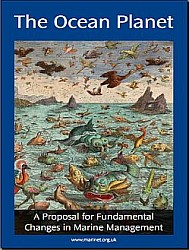Latest News Archive 2011
 Radioactivity MA Marine Aggregates ML Marine Legislation BW Bathing Water MR Marine Reserves RE Renewable Energy OA Ocean Acidification PO Pollution FI Fisheries GW Global Warming CE Coastal Erosion
Radioactivity MA Marine Aggregates ML Marine Legislation BW Bathing Water MR Marine Reserves RE Renewable Energy OA Ocean Acidification PO Pollution FI Fisheries GW Global Warming CE Coastal Erosion
December 2011
GW The Arctic's near-record 2011 sea ice low — big picture
 Fukushima : fishermen halt discharges of cooling water to sea
Fukushima : fishermen halt discharges of cooling water to sea
FI Global Tuna stocks have halved, and could be fully extinct within 50 years
ML Scottish fishermen win concessions and increased quotas for 2012 at CFP meeting in Brussels
FI All Norwegian cod and haddock fishing certified sustainable by Marine Stewardship Council
MR Exceptional marine features highlighted in the North Devon Biosphere Reserve
 Will Fukushima's emergency cooling water end up in the sea?
Will Fukushima's emergency cooling water end up in the sea?
 Fukushima's radioactive cooling water leaks into the sea and remains a formidable problem
Fukushima's radioactive cooling water leaks into the sea and remains a formidable problem
ML Deeper CFP reform necessary, says Ocean2012
FI Sainsbury's no longer claim their Scottish West Coast prawns are "sustainably sourced"
FI An estimated 100,000 salmon die in disease outbreak at Scottish West Coast fish farm
MR FI Government report states that inshore habitats are vital for Scotland's West Coast fishery
FI Eco-label farmed fish "not better for environment" it is claimed
CE Government Big Society 'Concern' over Flood Victims
Misc Dead Whale washed up at Old Hunstanton Beach, West Norfolk
ML Marine NGOs express caution over new EU Maritime and Fisheries Fund
ML EU creates €6.5 billion fund in subsidy and support for fishing industry
RE UK Government expects marine renewable energy to deliver 200/300 MW by 2020
MR MA Plans to dredge Falmouth harbour likely to proceed
PO Shipping CO2 emissions should be included in UK carbon reduction targets
FI PO Gulf of Mexico Bluefin tuna "probably okay after BP oil spill"
MR Marine Conservation Society questions the Government's commitment to protect UK seas
MR Australia announces plan for world's biggest marine reserve
ML EU Parliament rejects Western Sahara offshore fisheries agreement
FI GW Evidence from S. Africa on how climate change affects fishing
Misc Japanese tsunami fund "used for whaling programme"
FI Campaign to make London a "sustainable fish city"
FI Sustainable fish marketing undermined by confusing labelling
GW Polar oceanographer explains the science behind climate change
MR UK government says more time is needed to identify MCZs, but NGOs express concern
MR Call to protect 25% of our seas by marine reserves
Misc Sea Shepherd commences new campaign in the Southern Ocean
GW Whales, dolphins and seals now visiting British seas due to ocean warming
Misc MARINET launches new "Planet Ocean" page on its website
Misc Duchy of Cornwall to contest legal ruling over oyster bed in Fal estuary
FI PO Health warning after norovirus found in 78% of British oysters
Misc Scientists ask the public to help decode whale "songs"
PO Cairn Energy fails to find oil off Greenland
November 2011
FI £2.4m funding secured for Norfolk fishing heritage
Misc Government confirms Coastguard Centres closure
PO UN investment fund considering investment opportunities in the Arctic region
PO Exploiting Lancashire's coastal shale gas would "wreck climate change targets"
FI Atlantic sharks are heading for extinction, but only 1% are protected
PO New Zealand's marine oil spill disaster averted
FI EU proposes to forbid EU vessels from removing shark's fins at sea
Misc Seal Laceration Deaths — further input
PO Russia and China want to start exploring for minerals in Antarctica
Misc EDF, owner of British Energy, found guilty of spying
FI Five of the Eight Bluefin tuna species are "threatened"
GW New Carbon Capture and Storage scheme proposed for Peterhead, Aberdeen
MR The Wildlife Trusts fear that the number of Marine Conservation Zones may be drastically reduced
BW PO Government claims that 88% of UK bathing waters now meet EU Guideline standard
GW Record level of global greenhouse gas emissions in 2010
PO Pollution can make storms at sea, such as cyclones, more likely
FI Whale meat on sale at Icelandic airport
BW PO New MCS research shows 31,000 raw sewage discharges in England and Wales!
PO Fracking for gas did likely cause two minor earthquakes, but reserves of frackable gas are vast
CE Waveney District Council capitulates to SMP
PO EU plans for stronger regulation of offshore oil and gas activities
Misc UK and Norway sign North Sea energy agreement
PO Shale gas reserves in Lancashire said to be "vast"
 Radioactive pollution from Dounreay "will never be completely cleaned up"
Radioactive pollution from Dounreay "will never be completely cleaned up"
GW Has "The Times Atlas" overstated ice loss in Greenland?
PO FI GW Is there a jellyfish plague in UK seas? If so, why?
FI North Pacific and Alaska Humpback Whale population recovering from near extinction
FI Safety concerns over cockle harvesting in Ribble estuary
FI Duchy of Cornwall ordered to reveal oyster farm data
FI EU Fisheries Commissioner suggests fish "discards" could be food for the poor
PO New EU rules to reduce risk of oil spills
GW PO UK scraps key "carbon capture and storage" project
FI UK calls for Iceland and the Faroe Islands to reduce their mackerel quotas
FI UK pressure forces EU to abandon automatic fish quota reductions
FI "Boost for North Norfolk Fisheries?
MR Would MCZ RAs boost tourism?
OA GW OSPAR countries agree carbon capture and storage measures
Misc BBC "Frozen Planet" in pictures
GW Can US law and the Endangered Species Act protect the polar bear?
FI "Atlantic Bluefin tuna being harvested at twice the official quota level
 Highly radioactive metal found at Dalgety Bay in Fife, Scotland
Highly radioactive metal found at Dalgety Bay in Fife, Scotland
FI "Whale war" kicks off in the Antarctic Ocean
CE SMP denies self-help for threatened Suffolk village
PO BP prepares oil-spill contingency plan for for North Uist prospecting area
FI All fish sold by McDonald's UK restaurants now have MSC "sustainable fishery" label
FI Deep-sea fisheries require careful management to be sustainable, says IUCN
FI Long-line fishing causes huge seabird losses
MA CE USA Video on coastal erosion and dredging
PO Whale and Dolphin deaths twice normal rate in Gulf of Mexico
PO Is your washing machine causing plastic pollution of the oceans?
Misc "Giant" single celled organisms discovered in the ocean
PO Millions of tonnes of debris from Japan's tsunami afloat in the Pacific Ocean
CE Suffolk: Coastal erosion scheme set for approval
FI GW Sampling O2 levels in the North Sea
PO The ongoing saga of oil transfers off Southwold
PO Is BP risking worst ever oil spill in Shetlands?
MR Purple sponge sea creature found off Cromer is brand-new species
FI Suffolk aims to be first "sustainable fish county"
October 2011
FI 168 organisations sign Ocean2012 Brussels Declaration in support of artisanal fishermen
FI Spain's fishing fleet gets nearly €6 billion in national subsidies since 2000
PO BP to expand North Sea oil fields
GW Antarctic lake could predict the Earth's future
PO Stricken New Zealand oil tanker threatens serious pollution problems
PO Is China interested in Blackpool's shale gas deposits?
GW PO Melting Arctic ice clears the way for supertankers
FI Arran Seabed Trust (C.O.A.S.T.) report on "Sainsbury's Prawn Cock-Tale"
Misc World's oceans originated from comets, study suggests
Misc Severe criticism of Thames estuary site for new London airport
MR Dogger Bank to get special marine protection
FI Japan to go ahead with Whale hunting in the Antarctic Ocean
GW European poll of public perception of climate change in the marine environment
RE Bristol Channel's Atlantic Array offshore windfarm commences public consultation
<>GW Arctic summer sea ice melting in 2011 exceeds all previous records
FI Oceana report shows that EU fishing subsidies equal half the value of the annual catch
September 2011
MR Natural England explains the way forward on Marine Conservation Zones
MR 127 sites go forward for consideration as Marine Conservation Zones in English seas
PO Southwold: New delay in oil tanker saga
FI MR New Arran proposed marine reserve to be centred on habitats that assist herring spawning
FI MR Success of California MPA due to the involvement of fishermen
FI Marine Management Organisation publishes 2010 UK fishing industry data
FI COAST disputes Clyde fishery management plan
PO Pollution disaster fears as rescue tugs are ditched
FI MARINET makes submission to UK Parliament's EFRA committee about CFP reform
MR Protection of Norfolk's Sheringham reef and seven other Norfolk coastal gems in the balance
Misc Severely sick seal pups washed up along the north Norfolk coast
Misc New Finding — Giant Underwater Waves
Misc The Encyclopedia of Life publishes its first pages
FI MARINET identifies "food security" as the key objective of CFP Reform
 The lessons of Fukushima for our nuclear programme and its coastal sites
The lessons of Fukushima for our nuclear programme and its coastal sites
RE World's largest tidal energy array commences trials off French coast
PO Commercial agreement reached to exploit oil and gas in Russia's Arctic seas
MR Consultation on SAC status for marine reefs from Studland to Portland, Dorset
FI Shark Trust launches Petition to EU to prohibit "finning" of sharks
PO New calls for EU freeze on deep water oil drilling
PO Arctic oil-spill contingency plan heavily criticised
BW PO Surfing in Gaza, despite all the obstacles
BW PO New sewage monitoring scheme trialled in Devon and Cornwall
FI Sea Shepherd Prevents Pilot Whale Bloodshed in the Faeroe Islands
August 2011
PO RSPB concerned about oil exploration near important seabird colonies
PO FI Mekong River dolphin species threatened with extinction
PO North Sea oil spill exposes Shell's ticking timebomb
RE If UK offshore wind turbines are confirmed, Vestas will invest in UK
FI Iceland claims to want proper regulation of NE Atlantic mackerel fishery
FI NFFO asks for balanced argument over CFP "rights based management" approach to fisheries
FI Defra to publish who owns UK fishing quota "rights"
FI Sea Shepherd writes an Open Letter to the people of the Faeroe Islands
FI Mackerel is the last great fishery in the NE Atlantic, and its survival is threatened
FI We need to eat less fish — not more "sustainable" fish
FI FishFight campaign resulting in consumption of more fish, not less
MR Wildlife Trusts launch UK petition for creation of Marine Protected Areas
PO More details needed on oil incidents, says Scottish Government
PO Shell admits 'Significant Oil Spill'
PO RE Germany to "bubble-wrap" marine industrial sites to protect the hearing of cetaceans
PO UK shipping industry rejects EU carbon reduction programme
Misc UK beachgoers urged to report sightings of leatherback turtles
PO How to rescue penguins from oil spills
RE Offshore windfarms are good for wildlife
 Sellafield Mox plant closes, but Irish fears remain
Sellafield Mox plant closes, but Irish fears remain
FI Secrecy surrounds the question: who owns UK fishing rights?
RE Offshore wind turbines in "conflict" with a golf course
PO New deep sea exploration vehicles are under development
FI Ecologist attacks lobbyist system for fisheries 'mess'
PO GW The ocean depths are in urgent need of protection, say marine scientists
FI 2.1 million tonnes of North Sea cod thrown overboard between 1963 and 2008
RE How an offshore wind turbine is assembled — in pictures
PO World War II unexploded mine closes North Sea pipeline
PO Scientists identify 20 most important places in the oceans for marine mammals
FI Glimmer of a suggestion that the Newfoundland ecosystem is recovering
FI Sea Shepherd finds the cash
FI Sea Shepherd beset by financial problems following court decision
GW PO Leading US Arctic wildlife scientist "suspended"
PO Can the oceans be cleared of waste plastic?
Misc Rodent threat to seabirds and marine life in Scilly Isles
PO Algal pollution of Brittany's coastline worsens
Misc Census of Marine Life project wins international prize
RE UK leads in offshore wind turbine installation.
MA Gt Yarmouth Outer Harbour beach erosion study under fire
PO Chinese submarine breaks depth record in effort to "claim" the ocean seabed
PO Cautious welcome from NGOs to IMO decision to ban dumping of ship waste at sea
PO GW Concern that ice melting in the Arctic is releasing historic inventory of toxic pollutants
July 2011
PO Is sonar or oil drilling affecting Scottish whales?
Misc Can seaside towns, like Morecambe, regenerate themselves?
MR Isle of Man adds final details to its Ramsey Marine Nature Reserve
FI International Whaling Commission reforms its rules and tackles corruption
PO Plans to make new cargo ships 10% more energy efficient
PO EU plans to set stricter sulphur emissions from ships
FI Cefas publishes guide to choosing sustainable fish
FI Number of UK fishermen shows substantial decline over last 10 years
RE "Make or Break" time for offshore wind industry
RE Parliament to investigate the future of marine renewables in the UK
FI Coalition of UK NGOs launches CFP Reform statement
MR Project Ocean raises over £96,000 for marine reserves
GW FI Surprising number of whales seen off the Welsh coast
FI July 16th marks "Fish Dependence Day" in the UK
FI MARINET tells EU Commission how to eliminate over-fishing and achieve sustainable fishing quotas
FI EU Commission announces its CFP Reform proposals, and MARINET comments
FI German North Sea brown shrimp fishery seeks MSC certification
MA Deja-vu — can sand pumped from the sea solve Italy's disappearing beaches?
FI Whaling conference ends in chaos or compromise?
FI Cromer surfers clash with fishermen
Misc Closure of East Anglian Coastguard stations
PO Major Chinese oil spill goes unreported for 1 month
Misc Polar bears originated in Ireland
FI Are there any mackerel left in Cardigan Bay?
GW PO Norway searches for buried treasure in the Arctic
FI Half of bluefin tuna species threatened with extinction
PO Serious North Sea oil and gas spills at rate of "one a week"
MR JNCC announces consultation on 3 new marine SACs
FI Fish scales reveal where salmon spend their time at sea
GW PO New shipping routes opening up in the Arctic
PO The Arctic is the new hydrocarbon frontier
RE Marine Energy Budget cut to £20m
PO Plans to solve R. Thames' sewage discharges encounter problems
PO Melting Arctic causes a "white gold rush"
PO Large iron ore mine is planned in the Canadian Arctic
FI EU Ministers back out of international commitment on fisheries
Misc Puffins, seals and jellyfish of the Farne Islands — in pictures
Misc Mild tsunami hits Cornish coast
Misc Jellyfish shut down nuclear power station
Misc PO OSPAR acts to protect seven sea bird species
June 2011
FI Unexpected rise in wild salmon numbers
Misc MPs critical of plans to reform the Coastguard Service
Misc Maersk's "Triple E" ships promote a sustainability revolution in shipping
GW PO Planet's oceans face "inevitable mass extinction" says IUCN/IPSO Report
FI Shetlands' shellfishery gains a Marine Stewardship Council's sustainability certificate
GW Climate change solutions based on technology rather than restraint gain advocacy
FI NGO Report suggests fish farming is preferable to livestock farming
FI Report claims subsidies to the fishing industry is damaging fish stocks
FI UK supermarkets seek to promote "sustainable fish"
Misc Greenpeace launches new purpose-built protest ship
FI MEPs vote to increase fuel subsidy for fishing fleet
OA GW Huge increase in jellyfish populations creating "ecological stress"
PO Massive fish kill in tidal reaches of R. Thames due to sewerage overflow
FI Ocean 2012 EU fisheries exhibition — in pictures
CE Questions raised over H R Wallingford study at Great Yarmouth
CE Disappearing Hopton — Gt.Yarmouth Outer Harbour suspected
FI Are there plenty more fish in the sea?
FI MARINET defines the terms of compliance of Common Fisheries Policy reform with EU law
FI MARINET publishes Briefing on North Sea fish stocks in 1880 compared to 2010
CE The Value of our Natural Environment
PO Paraffin Wax beach pollution update
PO Earthquake questions safety of UK shale oil extraction
Misc Beached Sperm whale in North East England dies
GW Carbon emissions "highest ever" in 2010
PO The Irish consider whether to give Shell access to their offshore gas
OA Ocean acidification is global warming's "equally evil twin"
BW PO 461 out of 758 UK sea bathing waters are claimed to have met the top quality standard in 2010
May 2011
CE New Government Documents on Flooding and Erosion Strategy
PO Paraffin Wax — the latest sea and shoreline pollutant
BW UK Bathing Water Conformity
Misc New hope for threatened coastguard?
CE Flood defence funding : now you can buy your own
PO Danish commandos protect Cairn Energy's Arctic exploration rigs
Misc "Sociability" behind an explanation of beached Pilot whales in the Outer Hebrides
PO MPs support shale gas exploration in the UK
FI London fashion designers support the "stop over-fishing" campaign
Misc CPRE and NT demand 'Seascape' protection
RE Vestas ready to invest in North Sea wind turbine production
RE Innovative Marine Power projects in Scotland win DECC support
MA Australian Report mirrors UK failings in properly assessing marine aggregate dredging
MA Misc New base mapping of the North Sea
PO Shell and Cairn Energy announce plans to drill in the Arctic
RE UK marine energy industry could be worth £76 billion and 68,000 jobs
FI Supermarkets challenged on their fish labelling information
FI Wild Atlantic salmon under severe threat
FI Sustainable Seafood Coalition seeks to find a retail market for discards
FI PO EU unveils plans to pay fishermen to catch plastic
FI Fishing industry expresses concern to the EU about the proposal to end discards
FI Seal cull deaths blamed on salmon fish-farms
PO Plastic found in the stomachs of Scampi, causing a concern about "poisonous food contamination"
CE Saving our precious Coastline
April 2011
MA Forthcoming Yorkshire sand mapping survey
MR Marine life flourishing in Scotland's Lamlash Bay marine reserve
PO Huge rise in sewage debris on UK beaches
 Radioactive spills and breakdowns revealed at UK nuclear power plants
Radioactive spills and breakdowns revealed at UK nuclear power plants
MR PISCO publishes booklet on the Science of Marine Reserves
PO Report calls for a halt to shale gas exploration in the UK
PO Tristan da Cunha's islanders rescue the Rockhopper penguin
ML UK Marine Management Organisation launches new marine licensing system
MR Portugal is being urged to protect its seamounts
RE New undersea electricity cable between UK and Holland goes "live"
Misc Scientists believe humpback whales compose "songs"
MA Sustainable environmental alternative to offshore sand
PO European Commission to investigate sea disposal
CE EA Chairman speaks to SCAR AGM
MR Angler-friendly Marine Protected Area network proposed for Arran
FI PO Western Isles fish farm plan rejected
FI Ross and Skye Council approve a large new smolt rearing facility for seawater fish farms
 The lesson of Fukushima: gamble with safety, and you almost certainly lose
The lesson of Fukushima: gamble with safety, and you almost certainly lose
GW Marine Climate Change Impacts Partnership (MCCIP) website update
GW Claim that Arctic Ocean freshwater will cause "unpredictable changes in climate"
 Japan to dump Fukushima's radioactivity in the ocean as levels in the plant become "immeasurable"
Japan to dump Fukushima's radioactivity in the ocean as levels in the plant become "immeasurable"
FI Anger at Faroes' decision to massively increase mackerel quota
ML UK Government publishes its Marine Policy Statement
PO BP expects to resume normal operations soon in the Gulf of Mexico
Misc Is 'Jaws' patrolling Great Yarmouth?
FI The Scottish Government asks: Is fish farming the way forward? MARINET answers: No
 New report on "Thermal standards for cooling water from new build nuclear power stations"
New report on "Thermal standards for cooling water from new build nuclear power stations"
 Are we evaluating the risk from failure of our nuclear power stations?
Are we evaluating the risk from failure of our nuclear power stations?
March 2011
RE Proposals submitted for 10MW tidal energy array off Welsh coast
CE Family home to be bulldozed before it crumbles into sea
CE Saving our valuable Coastline
MA MARINET's video on The Impact of Offshore Aggregate Dredging
CE Holiday Park owners spend £190,000 protecting their business
PO U-turn over oil tanker transfer plan?
RE Major tidal energy scheme set for waters off Islay
PO European Commission loses Urban Waste Water Directive (UWWD) UK case
RE Largest kite-powered vessel to be operational next year
GW Climate change threatens a 'militarisation' of the Arctic, warns US Navy
GW Melting of ice sheets threaten to raise sea level 1ft by 2050
RE Underwater kite-turbine may turn tides into green electricity
February 2011
PO Petition against Oil transfers off the Suffolk Coast
CE Community partnerships and coastal defence
PO Greenland oil exploration to proceed, but latest Falklands' exploration well is 'dry'
PO "Shale gas" found near Blackpool, Lancashire
FI Sales of sustainable seafood soar in UK supermarkets
CE Coastal erosion discussion in parliament
PO Oil Tanker collision casualty
CE Plan for local fund to help those made homeless by ongoing erosion
CE Agreement reached at disappearing Happisburgh
PO Oil transfer off Southwold — the latest outcome
CE Norfolk's local hero fighting coastal erosion
RE Great Yarmouth tidal energy plan unveiled
CE Council back plan to lose Suffolk village
CE Grave Concerns of Gt. Yarmouth Harbour
Misc More Seal Mutilations — can you help?
MA Marine Management Organisation oppose a dredging
RE Funding for sustainable energy scheme cut
January 2011
PO Whitburn Waste War escalates
PO Ship-to-Ship Oil transfers given go ahead
CE Waveney District Council promises relocation for people in Corton and Easton Bavents
CE Great Yarmouth Coastal System evolution report from Crown Estate
RE Siemens chooses Hull for wind turbine plant generating 700 jobs
RE India plans Asian tidal power first
PO British claims to Rockall to be examined by UN court in battle over oil and gas fields
GW Arctic warming at twice global average rate thought to be behind unprecedented Walrus migration
FI New claims that the public is being "duped" by the Marine Stewardship Council
FI Illegal fishing in EU seas can be eradicated, MARINET report explains
MR UK Foreign Office accused of subterfuge in the designation of Chagos Islands marine reserve
CE Great Yarmouth coastal system is the subject of a Crown Estate report
RE Offshore windfarms could transform the UK's economy along the East coast
 Life of coastal nuclear power plants at Hartlepool and Heysham extended
Life of coastal nuclear power plants at Hartlepool and Heysham extended
FI EU cuts CFP Atlantic cod quota, but is it enough?
ML Ecological Impact Assessment guidelines published for marine and coastal environments
ML EU Commission publishes Decision guidance on MSFD Good Environmental Status criteria
The Arctic's near-record 2011 sea ice low — big picture
A view from space of Arctic sea ice at a near record low this month. Scientists in Germany, who use a different methodology, said 2011 was a record low.
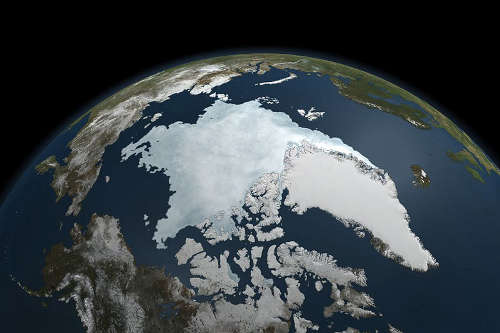
By early September, the area covered by sea ice in the Arctic Ocean was approaching a record low. On 9th September, sea ice covered 4.33 million square kilometres (1.67 million square miles), US National Snow and Ice Data Centre reported. The 2011 low is 2.38 million square kilometres (919,000 square miles) below the average minimum extent measured between 1979 and 2000. Late season melt or a shift in wind patterns could still decrease the sea ice extent before the winter freeze-up begins. Photographer: AMSR-E/Aqua/NASA
Fukushima : fishermen halt discharges of cooling water to sea
Tepco (Tokyo Electric Power), the operator of Japan's Fukushima nuclear power plant, has said it is scrapping a plan to dump water it treated for radiation contamination into the sea. The climbdown was forced by fierce protests from fishing groups.
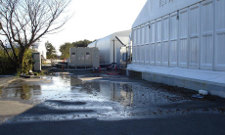
A Fukushima water purification building: the company had wanted to release water treated for radioactive contamination into the sea. Photograph: AP
Tokyo Electric Power had said it was considering discharging some treated water into the sea because it was running out of storage space. That caused an uproar among Japanese fishing co-operatives."Treated" means once-high radioactive content has been reduced considerably but not completely.
The Fukushima plant was struck by a devastating quake and tsunami in March and has released radiation into the atmosphere carried by winds, rain and snow ever since.
"The decision not to include the plan was made after talks on Thursday with the federation of fishing co-operatives and opposition from the government's fisheries agency," a Tepco spokeswoman said. The Tepco general manager, Junichi Matsumoto, told reporters on Friday the company would try to build more tanks and recycle more of the treated water for cooling purposes.
Tens of thousands of tonnes of water contaminated with radiation have accumulated at the plant, 150 miles north-east of Tokyo, after Tepco early in the crisis tried to cool reactors that went into nuclear meltdowns by pouring in water, much of it from the sea.
Tepco estimates the amount of treated water requiring storage is increasing by 200 to 500 tonnes every day. It says the plant is likely to reach its storage capacity of about 155,000 tonnes around March.
The utility released more than 10,000 tonnes of water tainted with low levels of radiation in April to free up space for water with much higher levels of radioactivity, drawing sharp criticism from neighbours including South Korea and China.
Global Tuna stocks have halved, and could be fully extinct within 50 years
Tuna stocks in the world's seas have more than halved in the past 50 years, with overfishing pushing many exotic varieties to dangerously low levels.
The rising popularity of sushi has been cited as one of the factors for declining numbers, with many tuna species now listed as either endangered or critically endangered. Over-fishing of the fish, especially of the rare bluefin, bigeye and yellowfin varieties — which are prized as delicacies — is now 'jeopardising their long-term sustainability'.
Researchers studied tuna and mackerel levels in the Atlantic, Pacific and Indian oceans between 1954 and 2006. Maria Juan-Jorda, from A Coruna University in Spain, said: "Populations have declined, on average, by 60 per cent over the past half century, but the decline in the total adult biomass is lower (52 per cent), driven by a few abundant populations. The steepest declines are exhibited by two distinct groups: the largest, longest lived, highest value temperate tunas and the smaller, short-lived mackerels, both with most of their populations being over-exploited. The remaining populations, mostly tropical tunas, have been fished down to approximately maximum sustainable yield levels, preventing further expansion of catches in these fisheries.'"
Around 12.5 per cent of the tunas and their relatives are now caught each year globally, according to the findings, published in Proceedings of the National Academy of Sciences.
Wild tuna are captured and kept in floating cages where they are fed with fresh fish, and with farming unregulated the amount caught and exported is unknown.
Tuna provides a critical part of the diet for millions of poor people as well as being at the core of the world's luxury sushi markets. But many tuna species are now listed as either endangered or critically endangered.
Over the past few decades the world's appetite for tuna has spurred a surge in the number and capacity of tuna-fishing vessels. Industrial tuna fleets from Japan, the European Union (EU), Taiwan, Korea, the US and increasingly China and the Philippines, fishing far from their home ports, are squeezing the last remaining financial benefits out of the planet's tuna stocks.
The researchers said: "Over-capacity of these fisheries is jeopardising their long-term sustainability. To guarantee higher catches, stabilise profits, and reduce collateral impacts on marine ecosystems requires the rebuilding of over-exploited populations and stricter management measures to reduce overcapacity and regulate threatening trade."
Even tuna fisheries that were considered healthy just a few short years ago, such as those of the Western Pacific Ocean, have joined the global depletion trend.
Tuna are highly migratory. Over their life cycles they travel vast distances, crossing the high seas and darting in and out of the waters of many coastal areas on their routes to breed and feed.
The researchers said: "The annual catches of tuna and their relatives have risen continuously since the 1950s, reaching 9.5million tonnes in 2008.
'The global adult biomass of tunas and their relatives has been halved over the past half century but not without yielding considerable catches, income and food for the benefit of humanity."
Demand from Japan has seen the Mediterranean fishing fleet increase over the past decade. Many of these boats use illegal spotter planes to track the tuna. Previous research has shown the average size of mature tuna fish, which can weigh over half a ton, had more than halved since the 1990s. This has had a large impact on the population since bigger fish produced many more offspring.
The study is published in Proceedings of the National Academy of Sciences.
Scottish fishermen win concessions and increased quotas for 2012 at CFP meeting in Brussels
A deal done after two days of frenzied negotiations in Brussels has secured the future of Scotland's fishing fleet — but further improvements could not be implemented because of legal red tape, Scotland's Fishing Minister Richard Lochhead told MSPs.
Mr Lochhead said while it was a tremendous success and testament to the intensive work by the Scottish and UK Government's that the Commissioner confirmed she would adopt the Scottish Government's interpretation of the now infamous 'Article 13' of the cod recovery plan, it was incredibly frustrating that on a separate days at sea issue, Scottish and UK officials looked to have secured a freeze on the cod recovery plan annual reductions right up until the eleventh hour, when the Commission admitted they had been unsuccessful in finding a legal way to deliver it. The Minister highlighted that the Article 13 result was crucially important on two fronts.
Firstly, had the Commission not accepted the interpretation, the cuts to days at sea would have been devastating for Scotland's fleet.
But secondly, in relation to the annual days at sea reductions imposed through the cod recovery plan, this clause is extremely important as it allows Scottish fishermen to top the number of days they can go to sea back up to previous levels, if they take measures to improve stock conservation by avoiding cod and reducing discards.
MSPs were also updated on quota changes. Highlighted in particular were significant increased quotas for west coast haddock (200 per cent), west coast nephrops (3 per cent), north sea haddock (15 per cent), north sea whiting (15 per cent) and north sea herring (94 per cent).
Mr Lochhead said: "Last week's fishing talks delivered increased and sustainable quotas in some of our key stocks as well as a dramatic turnaround on the Article 13 days at sea debacle. Both of these significant wins are really good news for the future of fishing in Scotland. There is no doubt the consequences for Scotland's fishing communities if the Commission had not accepted our interpretation of Article 13 would have been extremely dire. Boats would have been tied up, livelihood's would have been lost and thriving communities would have had the heart ripped out of them. For too long common sense has been replaced by the common fisheries policy (CFP) — next year's reforms can't come soon enough. It is hugely frustrating that we need to spend so much time and energy simply to ensure that such highly damaging and unjustified measures are not applied. Lawyers appear to be running the show to the detriment of conservation and the fishing industry. The Commission admitted the Cod Recovery Plan (CRP) isn't working but a call from many Member States for a pause in the annual automatic cuts in days at sea wasn't possible because they could not find a legal way to implement it.
"It is utterly ridiculous that our fishermen miss out on having the basic number of days they can go to sea in a year maintained simply because of a legal matter. Science and stock levels are the only credible reasons that should prevent this. However, it is important to recognise that the other key benefit to having won the Article 13 debate, is that we can negate the impact of that legal block by using Article 13 to 'buy back' days at sea and top up the number to previous levels through the Conservation Credits Scheme. This means that as long as our fishermen take adequate steps to avoid cod and increase conservation, they can continue to go to sea for as many days as previous years. This should not be unpalatable and is achievable. Our Scottish Conservation Credits Scheme is proof of what can be done, with various methods being used to avoid cod including some vessels also using more selective fishing gear to avoid catching undersized fish. Our catch quota scheme also shows how we can remove less fish from the sea yet land more to market.
"Reducing high discard rates is also very important and we must do more to bring our discard rates down. Scotland has seen the greatest reductions in North Sea cod discards achieved in the EU and while we still have more to do this shows the impact Scottish measures can have on stock conservation.
Scotland has always led the way in putting in place incentive based conservation measures which will protect our fish stocks. However, we cannot rest on our laurels — the buck does not just stop with the Commission when it comes to self-assessing and continuing to make improvements. Scotland has led the way on conservation over the past few years. Now is the time for us all to consider what more we can do. And this will require the continuing co-operation and commitment of our fishermen."
All Norwegian cod and haddock fishing certified sustainable by Marine Stewardship Council
Norway has a long tradition of managing its fisheries in harmony with nature, and is internationally regarded by many organisations as a world leader in sustainable fisheries management. The long term sustainable fishing practices and world-class management of Norwegian North East Arctic cod and haddock fisheries is also recognised by Marine Stewardship Council (MSC) certification as a sustainable and well-managed fishery. This latest MSC certification means that over three quarters of the catches from the entire Norwegian fishing fleet are MSC-certified.
Norway manages the largest sustainable cod stock in the world. For over several decades the Norwegian cod stock in Norway's cold, clear waters has been intensively monitored and pro-actively managed, utilising scientific advice from the country's best experts. The cod stock in the Barents Sea, where Norway captures about 93% of all its cod, is strong and the stock is growing. Following scientific advice through ICES, Norway has been able to increase its cod quota over the last few years. The catch quota for the North East Arctic Cod in the Barents Sea is 751,000 tonnes in 2012, of which 339,857 tonnes is the Norwegian quota. The catch quota for haddock is 318,000 MT, of which 153,235 is the Norwegian quota.
Karin Olsen of the Norwegian Seafood Export Council says: "We are very proud of Norway's sustainability record and the MSC-certification of the whole fisheries of Norwegian North East Arctic cod and haddock is a great way to ensure even more credibility in the market place for Norwegian suppliers, as well as ultimately making it easier for consumers to make a sustainable choice by selecting Norwegian cod and haddock.
"The fishing industry is the backbone of coastal Norway and is of vital importance to settlement and employment. The successful management of fish stocks are an important part of Norway's rolling commitment to a sustainable future, and we will continue to work hard to ensure that future generations will have the pleasure to enjoy Norwegian cod and haddock."
"Norway is a leading supplier of seafood globally, and it's our commitment to manage our resources sustainably" says Ingrid Dahl Skarstein, environmental adviser at NSEC. "The combination of environmental responsibility and economically sustainable fisheries shows that the Norwegian management model is successful. Today this is also recognised by the MSC."
Camiel Derichs, MSC Deputy Director Europe says: "This is a milestone for the MSC program, and a fantastic result for the collective Norwegian Seafood industry. Norwegian cod and haddock fisheries are among the most important white fish fisheries in the world, from a market perspective as well as from a historic perspective.
"The famous Lofoten winter fisheries for cod date back to pre-Viking times, and modern fisheries science and management started in that area over two hundred years ago, when Norwegian scientists searching to explain yearly variation in the catches started to do research on cod in Norwegian waters. From these humble beginnings, fisheries science and management as we know it today branched out."
Exceptional marine features highlighted in the North Devon Biosphere Reserve
Why are North Devon's rocky shores some of the best habitats in the Biosphere Reserve and amongst the richest in the country for their marine life? Grand geology and wild waters provide some of the answers. The Biosphere coastline stretches over 77 miles from Welcombe in the south, with its stunning stratified rocks, to Foreland Point and the towering cliffs of Exmoor in the north.
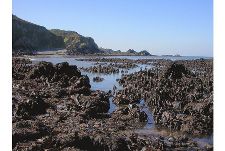
LEE BAY. Picture: Rob Jutsum.
Its mix of shore habitats includes the golden beaches that are so beloved by holiday-makers but that are, from the point of view of marine life, virtual deserts by comparison to our rocky shores.
Rocks may seem inhospitable, but they provide an anchorage for many encrusting plants and animals, like seaweeds, sponges and barnacles, as well as shelter in rock-pools and other nooks and crannies for mobile animals such as crabs and fish. Rocks strike out into the full force of the waves at west-facing Hartland, and the headlands at Croyde and Woolacombe.
These are exposed shores, suited to the toughest animals and the firmly-attached that feed well in rich water.They contrast with the more sheltered Channel coast shores beyond Morte where the animals are often softer-bodied and thrive in the siltier waters. This range of exposure contributes to the biodiversity and conservation importance for which much of our coast has been designated.
The stretch from Combe Martin to Croyde is a Voluntary Marine Conservation Area, and Foreland Point to the Estuary mouth is a candidate for Marine Conservation Zone status, as is part of the Hartland Peninsula. The shore's inhabitants have to adapt to make the most of a complicated jigsaw of factors influencing where they live.
As well as waves, our shores are subject to the Bristol Channel's powerful currents that ensure that our waters are rich in food and can sustain large numbers of marine animals, but perhaps the greatest challenge for marine life is this area's huge tidal range; the second highest in the UK.
Simply staying wet enough to breathe poses problems but then there are the other necessities of life such as eating and avoiding being eaten, sex and reproduction and competition. Rocks might look bare, but this is only because the microscopic seaweeds that coat them are being grazed by limpets and other sea snails before the weed has a chance to grow. Mature limpets have a neat trick that enables them to live on the drier parts of the shore. As the tide recedes, they retrace their route and hunker down on a home scar, an indentation that they have tailored for a snug fit where they can keep moist.
When the tide is out other animals that can withstand considerable fluctuations in temperature and salinity can be found in the rock-pools. Here throughout the day snails graze, mussels and sponges filter water for food, anemones grab passing prey, and small fish and crabs feed, alert for predators.
Many animals have evolved adaptations that help them cope with the ever-changing conditions in the rock pools by sheltering and waiting for the sea to return. For example, sea-snails have trap doors that shut in a little moisture whilst blennies can hide in shady crevices and breathe through their moist skin. The beadlet anemone can close its tentacles and shelter under a protective coat of mucus.
Coastwise North Devon's shore safari organiser, Jim Monroe says: "Understanding how these animals behave helps you to find them. Each has their place on the shore where their chances of survival are best. "Find a good rock-pool and you can watch them close at hand. Many are indifferent to your presence, others may eye you warily, but most will continue about their business. To see them feels like a huge privilege."
When covered by the tide barnacles and mussels, animals that dominate the exposed shore, come to life. Barnacle larvae that have glued themselves to the rocks headfirst when settling as adults, constantly sieve the water for food using their feathery legs, stopping only when a threat looms, such as a young blenny looking for a leggy meal.
Carpets of mussels open to syphon and filter gallons of water for food. Like barnacles they are prey to the dog whelk, which can take a week to drill into a mussel and make a soup of it. The mussel has a surprising defence and can trap the whelk using the threads with which it anchors itself to the rock.
Further down, shore encrusting colonial animals join seaweeds to give a colourful patchwork coating on most surfaces. They provide micro-habitats with good feeding for many small animals including the cowrie which feeds only on star ascidian, in a food chain that runs from microscopic plant and animal material in the plankton to top predators such as seals and dolphins.
Coastwise member Paula Ferris says: "For me the low shore is the most exciting part to explore. It is wetter for longer so there are more animals. Blennies and other shore fish lurk under the weed, crabs tuck into crevices, and every large stone hides tiny scuttling Porcelain crabs and maybe brittlestars or sea urchins. Better still I might find a worm pipefish, a sea slug, or even a squat lobster clumsily backing-off as I draw back the weed. There will always be something new for me, such is the variety of life on our rocky shores."
Learn more about the Biosphere at www.northdevonbiosphere.org.uk or www.coastwisenorthdevon.org.uk.
Ocean2012 highlights overcapacity in the EU fishing fleet, and the failure of several Member countries to record the size of their fleets
Ocean2012 has written to EU Fisheries Commissioner, Mrs. Damanaki, on 19th October 2011. We reproduce here the text of that letter:
Subject: Proposal for a European Maritime Fisheries Fund
Dear Commissioner Damanaki,
We understand that the Commission proposal for the future European Maritime and Fisheries Fund (EMFF) is currently undergoing inter-service consultation. The Commission Green Paper on the reform of the CFP (COM(2009)163 final) acknowledges that the current CFP has led to a number of serious problems including overfishing, fleet overcapacity fuelled by subsidies, low economic resilience and decline in the volume of fish caught by European fishers. The reform of the EMFF in parallel to the basic regulations and the rest of the CFP package provides an opportunity to effectively address these issues, and we would like to bring to your attention essential elements in ensuring that EU funding will no longer contribute to maintaining over-capacities and to overfishing in European waters and by EU fleets globally.
Funds should be provided for sustainably managing and restoring marine ecosystems and biodiversity. The comments below are based on joint NGO submissions already sent to the Commission on the same subject:
- The European Commission has identified over-capacity as the primary cause of the failure of EU fisheries management. It is also estimated that European fishing fleets in many cases exert fishing pressure on stocks which is two to three times the sustainable level. However, there is no detailed assessment of the actual overcapacity of the EU fleet. This is because many Member States choose not to comply with the legal requirement to report their fleet capacity.The most recent report from the Commission identifies Spain, France, Ireland, Cyprus, Poland, and Portugal as not providing an assessment of fleet capacity in relation to fishing opportunities and Sweden, Spain and the United Kingdom as not describing their fleets in relation to fisheries.
Accurate information is essential to ensure that funding allocated for investments on board of vessels or on fishing gear does not benefit vessels which are part of fleets operating at overcapacity. Otherwise counter-productive spending of public aid will continue, with vessels targeting depleted fish stocks, such as the Atlantic bluefin tuna, continuing to receive public aid for modernization measures. We therefore urge you to ensure that the new EMFF includes provisions that explicitly make adequate assessment and reporting of the balance between fishing capacity and fishing opportunities a precondition for Member States to use EU funds for vessel measures.
- The practice of discarding unwanted fish overboard is an appalling example of bad fishing practice and governance in the EU. However, the objective of any policy to tackle discarding should be to avoid unwanted catches in the first place, rather than to make economic use of what has previously been discarded. In that respect, no future marketing measures should apply to unwanted catches. Also, support for marketing measures of surplus or underexploited species runs the risk of contributing to future overfishing. Therefore, marketing aid should be restricted to support the marketing of sustainable fisheries and aquaculture products.
- Regarding aquaculture, indiscriminate promotion and development, e.g. through the promotion of investments in off-shore aquaculture, will invariably entail negative environmental impacts and may result in problems of excessive production and supply and poor profitability. The new EMFF should only direct support to the development of ecologically sustainable or environmentally friendly aquaculture, particularly for small and medium enterprises. The reformed CFP must ensure that, if it is to contribute to future food security, aquaculture becomes a net producer of fish protein. The most crucial means of achieving this is to ensure that European aquaculture does not rely on or lead to the overexploitation of forage fish in order to feed farmed carnivorous fish. Funding schemes for environmentally friendly aquaculture practices should be designed along similar lines as Article 38 (Natura 2000 payments) and Article 39 (agri-environment payments) of Regulation 1698/2005 (Rural development regulation).
- We are in favour of using public funds to support a transition to a new sustainable fisheries management system. Funding should be made available for the design and implementation of stakeholder led or co-management systems, which will provide fishery-specific management plans. We do not, however, consider Transferable Fishing Concessions (TFC), as proposed in the draft Basic Regulation of the CFP, as an adequate fleet management policy. Europe's fisheries are diverse and need more options than the single approach of TFC. While we acknowledge that rights-based management tools, under certain circumstances, can reduce capacity in numerical terms, we do not agree that the current Commission proposal addresses in a sufficient way the different circumstances of fisheries in the EU. We are also concerned that the proposed system may fail to address capacity reduction in a qualitative way, i.e. ensuring that more socially and environmentally responsible operators are supported or prioritized. These concerns have recently been shared by more than 160 fishers, environment and development organisations, which therefore oppose the mandatory introduction of TFCs as proposed by the Commission.
- Data on subsidy spending should be centrally stored and include a broad range of information. In case subsidies continue to be used to fund measures on/for vessels, information about the vessel's name, registration number, port, flag, targeted stock and details on the type of measure(s) should be disclosed. Regrettably, Member States are not required to release any information on the vessels concerned or the stocks targeted by the benefiting operators. Consequently, information relevant to understanding where aid is spent is widely dispersed, difficult to access, in unsuitable formats and therefore of little use to a rigorous, quantitative analysis of the effect of public aid on the state of fish stocks. It is therefore of paramount importance, that the new EMFF should ensure that the public has adequate access to all information about their spending, allowing an easy and user-friendly evaluation of the success of whether funds have met their objectives. This will help to clarify potential misperceptions about the use and impacts of EU aid to the fisheries sector.
Thank you for considering these important issues. Should you wish you to discuss these further or if you have any questions or comments, please do not hesitate to contact me or my colleagues listed below.
Yours sincerely,
Uta Bellion, Director, European Marine Program, Pew Environment Group, and Co-ordinator OCEAN2012
Will Fukushima's emergency cooling water end up in the sea?
The operator of Japan's crippled Fukushima nuclear power plant has said it is considering dumping water treated for radiation contamination into the ocean as early as March, prompting protests from fishing groups.
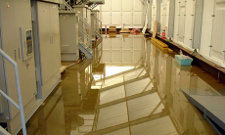
Water on the floor inside Fukushima after a leak in an image released by Tepco. Water has been used to cool reactors at the plant. Photograph: Tepco/AFP/Getty Images
Tokyo Electric Power (Tepco), the utility operating the Fukushima Daiichi plant, which was hit by a powerful tsunami in March that caused the world's worst nuclear accident in 25 years, said it was running out of space to store some of the water it had treated at the plant because of an inflow of groundwater.
"We would like to increase the number of tanks to accommodate the water but it will be difficult to do so indefinitely," a Tepco spokesman, Junichi Matsumoto, told reporters.
He said the plant was likely to reach its storage capacity of about 155,000 tonnes in around March.
Tepco plans to come up with possible ways to handle radioactive waste and present its proposals to the government's nuclear regulatory body for approval. "The government should not, and must not, approve a plan allowing Tepco to dispose of treated water in the ocean," said Kenji Sumita, an emeritus professor at Osaka University who specialises in nuclear engineering. "The reality is that semi-permanent storage is the only solution available under current technological constraints. Tepco may have to find the storage space and look for a technological breakthrough in the coming years that allows it to condense and greatly reduce the volume of tainted water."
The admission is a setback for the utility, which appeared to be making progress in its clean-up after building a cooling system that no longer required pumping in vast amounts of water. It also built a system, drawing on French, US and Japanese technology, that decontaminates the vast pool of tainted run-off to supply the cooling system with water.
The company said representatives of a nationwide federation of fishing co-operatives had visited its Tokyo headquarters to protest.
Tepco said it was still assessing the potential environmental impact of releasing the accumulating water, but that if forced to do so, it would discharge water expected to have the least effect on the environment.
Tens of thousands of tonnes of water contaminated with radiation have accumulated at the plant, 150 miles (240km) north-east of Tokyo, after Tepco, early in the crisis, tried to cool reactors that suffered nuclear fuel meltdowns by pouring in water, much of it from the sea.
"Our priority is also to look for ways to limit the inflow of groundwater into the buildings at the plant," Matsumoto said.
The operator estimates that due to the inflow the amount of water requiring storage is increasing by 200 to 500 tonnes every day.
The utility released more than 10,000 tonnes of water tainted with low levels of radiation in April to free up space for water with much higher levels of radioactivity, drawing criticism from neighbours such as South Korea and China.
Fukushima's radioactive cooling water leaks into the sea and remains a formidable problem
Nine months after Fukushima Daiichi was ravaged by an earthquake and tsunami, the plant continues to pose a major environmental threat. Before the latest leak, the Fukushima accident had been responsible for the largest single release of radioactivity into the ocean, threatening wildlife and fisheries in the region, experts have said.
The new radioactive water leak called into question the progress that the plant's operator, Tokyo Electric Power Company, appeared to have made in bringing its reactors under control. The company, known as Tepco, has said that it hopes to bring the plant to a stable state known as a cold shutdown by the end of the year.
The trouble on Sunday came in two stages, a Tepco statement said. In the morning, utility workers found that radioactive water was pooling in a catchment next to a purification device; the system was switched off, and the leak appeared to stop. But the company said it later discovered that leaked water was escaping, possibly through cracks in the catchment's concrete wall, and was reaching an external gutter.
In all, as much as 220 tons of water may now have leaked from the facility, according to a report in the newspaper Asahi Shimbun that cited Tepco officials.
The company said that the water had about one million times as much radioactive strontium as the maximum safe level set by the government, but appeared to have already been cleaned of radioactive caesium before leaking out. Both elements are readily absorbed by living tissue and can greatly increase the risk of developing cancer.
Since the disaster in March, workers have been struggling to cool the stricken plant's reactors by flooding them with water, which is contaminated with radioactivity in the process and becomes a problem of its own.
Tepco installed a new circulatory cooling system in September with filters that decontaminate and recycle the cooling water. But the company acknowledges that some water has already leaked into the ocean, and thousands of tons of water remain in the flooded basements of the plant's reactor buildings.
The Institute for Radiological Protection and Nuclear Safety in France estimates that between March and mid-July, the amount of radioactive caesium 137 that had leaked into the Pacific from the Fukushima Daiichi plant amounted to 27.1 petabecquerels, the greatest amount known to have been released from a single episode. (A becquerel is a frequently used measure of radiation, and a petabecquerel is a million billion becquerels.)
Deeper CFP reform necessary, says Ocean2012
The EU Commission has announced plans for a 6.5 billion-euro fisheries fund from 2014-2020 as part of a long overdue reform of the Common Fisheries Policy (CFP). Fisheries Commissioner Maria Damanaki announced the plans with a strident message: "No more money will be spent to build bigger vessels… the fund will help small-scale fisheries to become more profitable and more viable. It will reverse the decline of many coastal areas and island communities which are dependent on fishing."
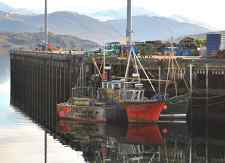
Few boats left in Oban harbour. Much of the West coast became fished by the bigger offhsore boats
Since the EU Commission unveiled the original proposals in July, marine sustainability groups from many sectors have been concerned that the stated plans do not go far enough. UK members of OCEAN2012, a consortium of NGOs and community groups from countries across the EU, have argued that the voice of the small fishing boat sector is still in danger of being sidelined, along with the necessary and radical measures to reverse decades of over-exploitative fishing.
As a member of the coalition, The Community of Arran Seabed Trust (COAST) recently attended a members meeting held at the New Economics Foundation (nef) in London. Members showed broad support for a range of measures outlined in the CFP reform proposals, specifically the clear target to regenerate fish stocks to 'good environmental status' by 2020 and its commitment to adhering to the Maximum Sustainable Yield. It also welcomed the stronger commitment to follow scientific advice, including the ecosystem approach. Crucially it supports the stated intention to minimise bycatch, as a way to tackle the problem of discards, rather than simply landing bycatch.
However, OCEAN2012 members are critical of CFP proposals insofar as they fail to radically prioritise environmental sustainability and the growing privatisation of fish resources. Members attending the meeting such as MARINET, Sustainable Inshore Fisheries Trust (SIFT), New Under Tens Fishermen Association (NUFTA) and the Marine Conservation Society (MCS), are now urging the European Commission to consider deepening the proposals.
Historic levels
The replacement of the CFP, argue marine sustainability campaigners MARINET, must tackle the pressing issue of 'food security,' and restore fish stocks fully to the levels that were present before industrial steam-powered trawling was introduced. To this end, a new CFP must link annual catch quotas and Maximum Sustainable Yield to historic levels of fish stocks.
"The reform proposals of 13th July advanced by the Commission only suggest at such an outcome… an enduring future for our fisheries remains very much in the balance," explains David Levy, Chair of MARINET.
Members at the meeting also discussed the need to structure the fishing industry more fairly. Coalition members believe that small scale, low impact fisheries are in danger of being left behind, with their interests not adequately represented by the well-funded lobbyists of the major producer and fishermen's organisations.
Strong lobby
In Scotland, the SFF (Scottish Fishermen's Federation) and the Producers Organisations (POs) represented by the NFFO (National Federation of Fisheries Organisations) have cornered the lobby on the issues of quotas and discards (bycatch), according to OCEAN2012 members. They also argue that Seafish — technically a governmental advisory body for all sectors of the fishing industry, including aquaculture — represents mainly the interests of the large producer organisations.
This has led to a systemic unfairness, currently not addressed by the CFP reform proposals, say coalition members. This situation was portrayed starkly by a representative from Hastings, where the fishing quota is allocated to big boats and smaller inshore, traditional boats are currently left with just 2 tonnes of Totally Allowable Catch (TAC) per month.
Small boat sector disadvantaged
The vast majority (93% in 2006) of the British fleet comprises vessels under 10m, but this "sub-sector" of the industry sees only a small proportion of the quota. Paul Joy from Hastings and a member of NUTRA (New Under Tens Fishermen's Association) told the members meeting that three-quarters of the Hastings fleet are currently receiving just 7% of the quota allocation. The lion's share is going to large vessels which dominate representation by Producers Organisations.
OCEAN2012 also flagged up major concerns that subsidies are not fairly allocated for some of the same systemic reasons. If you want more information about how you can support the OCEAN2012 campaign locally, please contact the coalition here http://ocean2012.eu/pages/13-contact-us.
For more information about the continued process of European fisheries reform and the planned campaign of OCEAN2012, please download a full and detailed summary of the meeting.
Sainsbury's no longer claim their Scottish West Coast prawns are "sustainably sourced"
In an encouraging piece of consumer power Sainsbury's, the food retailer, have removed all mention of 'sustainability' from the packaging of their prawn products sourced from the Scottish Langoustine Project after The Community of Arran Seabed Trust (COAST) campaigners pointed out the dubious claims via Twitter.
Russell Cheshire and Lucy Wallace both flagged up the inconsistency via their Twitter feeds, prompting a quick response from '@SainsburyPR' — the Twitter address of J Sainsbury plc's marketing department.
In the November issue of their newsletter COAST published an exchange between COAST campaigner Russell Cheshire and the PR department of J Sainsbury plc.
Sainsbury's have since published the following statement on their Twitter feed which would seem to suggest that they no longer view their prawns as sustainably-sourced.
"We implemented our sustainability rating system in 2006 and assess every fishery we source from against that system including bottom trawl fisheries. The system includes an assessment of potential environmental impacts and as such the Scottish langoustine fishery is amber rated. We would only claim a fishery to be sustainable if it is certified by the MSC and we have been in discussion with fishermen in Scotland in respect to potential fishery improvements and MSC assessment."
Marketing literature on the Sainsbury's website, describing their Scottish West coast prawns as sustainably-sourced, has since been removed.
An estimated 100,000 salmon die in disease outbreak at Scottish West Coast fish farm
In late October an estimated 800-900 tonnes of farmed salmon died at The Scottish Salmon Company's St Molios fish farm in Lamlash Bay. Each fish weighed about 1kg, so up to 100,000 fish may have died, although numbers have not been officially disclosed.
The fish have since been removed by tankers off the island to Widnes in Cheshire for incineration and the Marine Science Fish Health Inspectorate in Aberdeen has confirmed the cause of death to be a severe and relatively uncommon outbreak of amoebic gill disease (AGD).
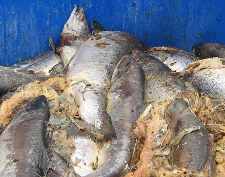
Salmon mortalities at St Molios fish farm in 2008
The Fish Inspectorate has also disclosed that it is tracking two other cases of AGD in fish farms across Scotland, one on the west side of Harris and one near Gigha.
Phil Thomas, chair of the Scottish Salmon Producers Organisation claim the disease outbreak is a naturally occurring event. "That claim is a good example of selective information by the aquaculture industry," explains The Community of Arran Seabed Trust's (COAST) Dr Sally Campbell. "The fact is that over-concentration of animal populations magnifies the infection risk often beyond the ability of humans to control. It is only a 'naturally occurring event' in as much as tuberculosis in humans is a naturally occurring event when pathogen (in that case a bacterium), host, (in that case human beings, often in large numbers), and environment (insanitary conditions, close proximity of people and people already susceptible due to overcrowding, poor diets and so on)."
AGD in fish is caused by an imbalance of host, pathogen (in this case several species of Amoeba) and the environment. There is direct link between the concentration of biomass and the ease of infection.
The Fish Inspectorate has confirmed that although the disease is controlled, the outbreak is not completely resolved. In other words the remaining fish are not in peak condition. Sometimes the gills of the farmed fish can become damaged by an algal bloom, which contains a lot of silicate (sharp edges) phytoplankton. These can damage the gills, which are very fragile and may make them more susceptible to AGD.
The well boat (or should we say sick boat) was in last week dosing the remaining fish to kill sea lice. To do this the remaining fish were pumped into the well boat for dosing with anti sea lice medication and then emptied back into pens, plus the seawater with the dosing chemicals.
Government report states that inshore habitats are vital for Scotland's West Coast fishery
A recent Scottish Government report which reviews the scientific knowledge of the West coast fishery, has lent weight to proposals for a Marine Protected Area (MPA) around the southern coast of Arran. "The West of Scotland Marine Ecosystem: A Review of Scientific Knowledge 2011" carries out a comprehensive review of the West coast. Amongst a range of findings, it describes the importance of the inshore habitat for cod and whiting stocks in the area, by gathering a wide range of data from analogous fisheries in Europe.
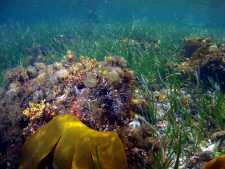
Inshore habitat is vital for West coast fishery. Picture — Howard Wood (Chair Community of Arran Seabed trust)
One study conducted in the Swedish Skagerrak archipelago calculated that the loss of 190 m2 of eelgrass habitat may have resulted in the loss of 6.3 million juvenile cod recruits each year.
The report states that "in Scotland, areas such as maerl and eelgrass beds appear to be important as nursery areas for cod, but such habitats are easily damaged by human activities such as trawling."
The report, however, frequently acknowledges limitations of its findings due to a shortage of available data, "Although damage is known to have occurred around Scotland, we currently lack good data on the extent of habitat loss, and its consequences for cod populations."
The conclusions of the report have boosted the rationale for habitat protection measures in the Clyde. The Commiunity of Arran Seabed Trust (COAST) is proposing an angler and static gear-friendly MPA around its southern shores to protect vital habitat and historic spawning grounds from the damaging effects of dredging and trawling.
"Much of the content of this report is to be welcomed, but we cannot afford to wait for another round of scientific surveys before we take action to halt the damage currently inflicted on vital nursery habitats," said COAST chair Howard Wood. "The precautionary principle should dictate that bottom trawling and dredging should be precluded from large areas of our inshore waters or at the very minimum be subject to an environmental impact assessment. The common-sense principle says our seabed is knackered. And the good fishermen on the West coast know it's in their children's best interests to give it a rest."
Footnote: COAST has observed to us: "Although we welcolme the West of Scotland report, if you read it in its entirety, Marine Scotland Science who published the report has been very selective in the science they have used on prawn trawl, discards and nutrient enrichment from aquaculture — and as we have pointed out to Marine Scotland, there are as many scientific studies that argue the case against a particular conclusion as they are in support. Of course, that kind of selectivity in presenting the evidence was always going to be the problem when Government brought the Fisheries Research Service, directly as a Government Agency, into Marine Scotland Science. As prawn trawling and salmon aquaculture are seen by the Scottish Government as vital parts of the West of Scotland economy, they choose the science that suits their short term economic agenda."
Eco-label farmed fish "not better for environment" it is claimed
Farmed fish sold under the Marks & Spencer eco-label is no better for the environment than conventionally farmed fish, a study on the sustainability claims of major fish producers says. The report from the University of Victoria found that many of the so-called eco-labels were not much better than conventional farmed fish when it came to protecting the oceans, and some — including those produced under the Marks & Spencer brand — were actually worse.
"They have set criteria that currently sit below the normative performance of conventional industry," said lead author John Volpe, who heads the Seafood Ecology Research Group at the University of Victoria in British Columbia, Canada. "What this analysis makes clear is that the criteria a producer might meet to acquire the Marks & Spencer label is already below industry-wide practice."
A spokeswoman for Marks & Spencer said that the company was very disappointed by the report and that its commitment to sustainable fishing went beyond labels. "We have developed an industry leading aquaculture standard that we apply to all the farmed fish we use in our business, including that used as an ingredient in prepared food, which very few other major retailers do," said Emma Johnson.
She criticised the report for including only two retailers — Marks & Spencer and Whole Foods — on its list of 20 standards developed by organic associations, industry groups and supermarkets in the US, UK, Europe and Australia.
'How Green Is Your Eco-Label?' looked at the environmental impacts of farming 11 species of fish, including three varieties of salmon — Atlantic, chinook and coho — as well as Atlantic cod, European seabass, barramundi and turbot. It did not look at farmed freshwater fish such as tilapia.
Overall, most eco-labels for farmed marine fish produced no more than a 10 per cent improvement over conventional varieties. A third of the 20 eco-labels in the study were at the same level as, or below, standard industry practice, Volpe said. "When you start looking into how much time and money has been poured into the development of these labels, which are the banner of the sustainable seafood movement, and just how much return there is on the investment they are receiving, then on the whole it is quite modest," said Volpe. "That was a bit of a shocker to us."
The study, which was reviewed and was supported by the Pew Environment Group, used 10 factors to rate the eco-labels including feeding, antibiotic use and energy use.
Marks & Spencer scored at the bottom, or second from the bottom, on all four sets of rankings. Of any of the labels, it was the furthest from reaching the voluntary standards set by the Monterey Bay Aquarium seafood watch guide and the Blue Ocean Institute seafood guide. Both are seen as the authorities on sustainable farmed and wild caught seafood, and the Monterey Bay guidelines have been adopted by leading chefs and restaurants in the US.
Marks & Spencer described the guidelines used in the report as "niche standards".
"Whilst we believe the report is wrong to compare a standard we apply to all our sourcing with niche standards, it does not remove our commitment to further improve our standards in the future," Johnson said. She said the company had worked closely with the World Wildlife Fund to develop the Salmon Aquaculture Dialogue and that it was aiming to introduce it on a number of its supplier farms next year.
John Volpe said the researchers focused on the major producers, which included organic associations, industry groups and retailers. But he noted that Marks & Spencer faced a much higher bar on eco-label salmon than other producers on other types of fish. Conventional salmon farming had already come some distance to improving its environmental footprint, he said.
"It's like going on a diet," Volpe said. "Losing the first 10lbs is easier than losing the last 10lbs or the last 2lbs."
The study claims to be the first to take an in-depth look at how eco-labels on farmed fish stand up to conventional options in the marketplace. John Volpe said it was aimed at helping consumers find their way through a confusing thicket of claims from the fishing industry and supermarkets about the sustainability of their products.
A number of recent news investigations in America have focused on false labelling of fish, and Volpe argued consumers were more savvy at assessing claims made by beef or poultry farmers than seafood producers. Among the researchers' other main findings, organic labels are ahead of trade associations and retailers in living up to their sustainability claims — although a few do fall short.
The study warns that looking at the environmental footprint of a single fish farm, or group of fish farms, could be misleading. The overall impact of the farmed fish industry could overwhelm any of the efforts to reduce the toll on the environment.
Government Big Society 'Concern' over Flood Victims
Charles Tucker of the National Flood Forum attended the launch of the Ministerial Statement "Progress towards developing future flood risk management arrangements" on Monday 19th December, who issued the following Press Release on 21st December:
No Christmas Present for Flood Victims!
Flood victims and flooded communities will get no relief from insurance worries this Christmas, says the National Flood Forum. Worse, a Ministerial Statement from Defra issued on Monday 19th December suggests that government is set to leave flood insurance to an unregulated free market — a situation that even the Association of British Insurers says poses severe dangers for the most vulnerable.
Defra Minister Richard Benyon was due to announce his proposals on Monday for a new framework of flood insurance to replace the "Statement of Principles" 1. But the Ministerial Statement (described as giving a "direction of travel") included nothing to suggest that government would take any steps to replace the SoP. "It was so vague it was totally unhelpful" said Charles Tucker, Chairman of the NFF.
He added "We feel very let down by this lack of leadership from government — and so will the thousands of communities throughout the country where getting insurance after a flood is becoming more and more expensive. We called on Government to take the lead to ensure that flood insurance was fair and affordable. Now they seem to be walking away."
The National Flood Forum — the UK-wide charity supporting and representing communities at flood risk — has worked closely with Defra, the Treasury, the Environment Agency, the Association of British Insurers, Local Government Association and others over the past 12 months to find a new Framework to replace the Statement of Principles.
Chairman, Charles Tucker said "All this time and effort will have been wasted if government fails to provide the leadership we expect from them. Flood victims will be dismayed and frustrated by the lack of any clear direction from government, after more than a year of discussions and workshops designed to find solutions to the ever-growing difficulty of finding flood insurance once you have been flooded. It's government's job to take the lead here — and we're desperately disappointed and frustrated that they are not doing so."
Fifteen months after the Flood Summit in September 2010, Monday's Ministerial Statement "Progress towards developing future flood risk management arrangements" fails to move any of the key issues forward — and particularly gives no indication of government action to shape the insurance market for communities at high flood risk.
1 The "Statement of Principles" is the gentleman's agreement between the insurance industry and government which gives some assurance to property owners that they will be offered insurance again after a flood. It ends in 2013.
Dead Whale washed up at Old Hunstanton Beach, West Norfolk
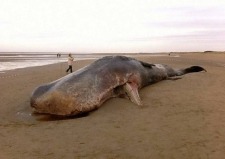
The sperm whale which was found washed up on Old Hunstanton Beach today. Picture: Chris Bishop
A 40ft sperm whale with a large gash to its stomach was found washed up dead on a Norfolk beach on Christmas Eve . A spokesman for the British Divers Marine Life Rescue said it may have been the same whale which had been seen dead on the RAF's bombing range on the other side of the estuary, at Holbeach, Lincolnshire some weeks ago.
The number of injured sea mammals is decidedly on the increase. This past year many Seals, Dolphins and Porpoises have been found with fatal injuries that may or may not have been man-made. Scientists from the Zoological Society have already taken samples from the animal in the hope of identifying the cause of its death.
EU announces 2012 fishing quota scheme whilst Brussels NGO says "it fails the sustainability test"
The Fisheries Council (EU Council of Fisheries Ministers) announced on 16th December 2011 the full list of fishing quotas for 2012 for fish stocks in EU seas, see list for details, www.consilium.europa.eu/uedocs/cms_data/docs/pressdata/en/agricult/127031.pdf.
The Brussels based marine NGO, Seas At Risk commented:
Fisheries Ministers Fail Sustainability Test
Brussels, 19th December 2011. Fisheries Ministers have once again missed their opportunity to place European fisheries on the path to sustainability. Fisheries Council negotiations on fishing limits for 2012 have resulted in a decision to set Total Allowable Catches (TACs) at a level which exceeds scientifically recommended limits.
At the two-day Council meeting European fisheries ministers had the chance to take a big step towards the sustainable exploitation of European fisheries resources — and failed.
While progress has been made, it has been insufficient to achieve the European commitment to manage all fish stocks at Maximum Sustainable Yield (MSY) levels by 2015.
Despite the repeated pleas of Commissioner Maria Damanaki, the December tradition of ignoring scientific advice and setting unsustainably high fishing limits has not been broken. Whereas the proposal of the Commission for fishing limits in 2012 followed scientific advice for the majority of stocks, the Council followed this proposal for only 14 of the 75 decisions regarding stocks in EU waters. For all other cases they have set fishing limits higher than what was proposed, and in 53 instances this difference was more than 10%.
Ministers have also chosen not to follow the long-term management plan for North Sea herring and increased the TAC by more than 100% — whereas the plan foresaw maximum annual increases of 15%. Multi-annual plans make for better management than yearly bargaining. The Council therefore made a real mistake to disregard this long-term management plan, setting a dangerous precedent for other stocks.
According to the European Commission, Ministers' decisions have exceeded scientific recommendations by an average of 47% since 2003. Setting catch limits that do not exceed scientific advice is essential in order to achieve levels that can produce the maximum sustainable yield (MSY) by 2015 — a target that was set at the Johannesburg World Summit on Sustainable Development in 2002 and to which the EU and its Member States have committed themselves.
Dr. Monica Verbeek, Executive Director of Seas At Risk said: "Ministers remain under the illusion that overfishing will somehow save jobs. This disregard for scientific advice and for international commitments will undermine the future of the fishing industry and does not bode well for the ongoing reform of the Common Fisheries Policy."
The European Commission's proposal regarding fishing opportunities for 2012 was based on the goal of managing stocks at MSY levels by 2015, on following scientific advice, and on applying a precautionary approach in the case of data-poor stocks.
By opposing the Commission's proposals, Ministers made a mockery of stated ambitions to reform the CFP so as to achieve economically, socially and environmentally sustainable fisheries.
The outcome of this year's horse-trading regarding fishing opportunities shows once again that the system is flawed — the CFP reform process must put an end to this yearly disgrace if there are to be healthy fish stocks for fishers and the environment in the future.
MARINET observes: The comments expressed by Seas At Risk are accurate. The Fisheries Council (EU Council of Fisheries Ministers) continues to fail to heed scientific advice that the Common Fisheries Policy is permitting fishing at levels which fish stocks are unable to withstand.
The result is that our stocks and fisheries continue on their relentless decline, ultimately to commercial extinction — which some stocks, such as North Sea, Irish Sea and West of Scotland cod stocks, are already confronted by. All this is extraordinarily reminiscent of the total fisheries collapse that happened in the 1990s in the Newfoundland Banks in the North West Atlantic. The North East Atlantic is now confronted by the same grave possibility.
Why can Fisheries Ministers not understand this reality? Why can they not design a Common Fisheries Policy which observes scientific advice (in theory, an actual legal obligation — but no one has challenged them on this) and give support to the fishing industry and its fishermen so that they can build a conservation-based industry, rather than an over extraction-based industry? A conservation-based approach to fisheries will guarantee fish stocks for the future, both for the industry and for the public who rely on the CFP to deliver food security (the ability to meet all our needs for fish for all 12 months of the year, year after year — currently stocks are so depleted, we can only meet our needs for 6 months of the year and have to rely on fish imported from other seas) .
Reform of the Common Fisheries Policy — currently being considered by the EU's governmental institutions (Commission, Parliament and Council of Ministers) — must, MARINET believes, be conservation-based rather than relentlessly extraction-based in terms of the management of fish stocks. The CFP must have, as its overriding objective, the delivery of food security — the continuous ability to meet our needs for fish throughout the whole year from our own seas. To do this, we have to restore fish stocks to historically referenced levels (taking ecological and climatic changes into account) because we know that historic fish stocks (i.e. following World War II, and indeed earlier) were able to deliver food security). This means that we have to set quotas (known these days in scientific terminology as "maximum sustainable yield") at levels which will lead to the restoration of historically referenced levels. In turn, this will require serious restrictions on fishing for a period of time, indeed closure of certain stocks, and the use of closed areas (marine reserves) centred on spawning and nursery grounds so that fish stocks can recover to historically referenced levels and, most importantly, economic support and a new economic role for fishermen who are displaced so that they are offered the opportunity to become the managers of these marine reserves, patrolling them to prevent illegal fishing, and assisting in the management and collection of scientific data about the stocks and their restoration.
A Common Fisheries Policy built on this foundation will be conservation-based, guaranteeing both the fishing industry and the EU public an abundant and sustainable supply of fish into the future — a reality which the current CFP is doing it best to destroy.
The EU governmental institutions (Commission, Parliament and Council of Ministers) are talking about reform, but they have not yet embraced the primary principle that the CFP must deliver food security, and that therefore fish stocks must be restored to historically referenced levels with management being conservation-based, rather than extraction-based, in order to deliver this future.
MARINET is campaigning for precisely this objective — food security and conservation-based fisheries management where fishermen are given a new economic role and security so as to deliver this future. If you believe and support this objective, please contact us via our website.
Marine NGOs express caution over new EU Maritime and Fisheries Fund
In advice to the EU Commission and Parliament, marine NGOs in Brussels (Seas At Risk, WWF, Ocean2012, Bird Life Europe, Greenpeace and Oceana) have responded with support and caveats in connection with the announcement of a new EU Maritime and Fisheries Fund, COM (2011) 804 final. The NGOs' advice states:
"Europe's fishing grounds were once amongst the most productive in the world, but thirty years of the Common Fisheries Policy (CFP) have resulted in serious depletion of fish populations, ecosystem degradation, and damage to species, habitats and sites. Today, 63% of the assessed stocks in the Atlantic are overfished, 82% of the assessed stocks in the Mediterranean and 4 out of 6 assessed stocks in the Baltic.
"The European Commission recognised overcapacity as one of the key drivers of overfishing and estimates that in a number of fisheries, fishing capacity is two to three times the sustainable level. The Commission also acknowledges that subsidies have contributed to this imbalance through artificially maintaining excess fishing capacity. The 2011 European Court of Auditors' report confirms this, stating that fleet overcapacity is driving the depletion of fish stocks, threatening the wellbeing of our seas and the viability of the fishing communities.
"The role of subsidies as a driver for overfishing has been widely recognised, including at the international level. At the 2002 World Summit on Sustainable Development in Johannesburg, the international community committed to eliminate subsidies that contribute to illegal, unregulated, and unreported (IUU) fishing and overcapacity. Also, parties to the World Trade Organisation agreed to strengthen disciplines on fisheries subsidies, including through a prohibition of certain forms of fisheries subsidies that contribute to overcapacity and overfishing. Commitments to phase out environmentally harmful subsidies were also made at the 2010 meeting of the Parties to the Convention on Biological Diversity in Nagoya, and at EU level.
"The reform of the CFP and its financial instrument offers a critical opportunity to eliminate subsidies which contribute to overfishing and use them to support transition towards truly sustainable fisheries and towards achieving healthy marine ecosystems. The following document is an initial reaction by BirdLife Europe, Greenpeace, Oceana, the Pew Environment Group, Seas At Risk, WWF and the OCEAN2012 coalition to the Commission's proposal. In particular, it indicates which parts of the proposal these groups welcome, and where they have concerns and see room for improvement.
What NGOs support:
- The proposal combines financial resources for fisheries and aquaculture measures, as well as for control and enforcement, data collection and the Integrated Maritime Policy. The integration of these formerly individual funding lines into one financial instrument can simplify the administration through unified rules and procedures and contribute to more effective and efficient allocation of available resources.
- The proposal commits to ensure that funding will only be available for Member States compliant with the objectives and rules of the CFP, in particular control obligations, the IUU Regulation and data collection obligations.9 It also makes funding for operators conditional upon compliance with the CFP.
- The proposal contains a large number of measures which can contribute to placing the EU fisheries sector on a more sustainable footing, including measures to promote human capital and social dialogue, to facilitate diversification and job creation, and to establish and manage local bottom up initiatives to support fisheries areas and local partnerships.
- The proposal includes measures to support biodiversity, including through management, restoration and monitoring of Natura 2000 sites as well as aquaculture compatible with specific environment requirements related to the designation of Natura 2000 sites.
- The proposal excludes financial support for the construction of new ports, new landing sites or new auction halls. It also excludes aid for engine replacement, which is a step forward in disentangling fisheries subsidies from overcapacity.
- The proposal contains provisions which would enhance transparency and public information by requiring Member States to publish more regularly detailed information in user friendly format, and to also transfer relevant data to the EU Commission.
Where NGOs have concerns and see room for improvement:
- The proposal fails to make the needed structural shift to ensure that public aid is used exclusively for creating public goods and services. In fact, the vast majority of the available funding will be allocated to measures which often benefit a handful of individual operators rather than the entire fisheries sector or society at large. Conversely financial support for control and enforcement and data collection is too limited. While the earmarking of funds should ensure that a minimum amount of the funding is spent on control and enforcement and data collection, Member States should have the flexibility to shift more EU aid into these types of activities.
- The proposal states that investments on board vessels or for gear modernisation are not meant to increase the vessel capacity. However, the proposal does not address funding contributing to maintaining existing overcapacity. The proposal should make funding for fleets, vessels and gears conditional upon adequate assessment of fishing capacity in relation to available fishing opportunities. At present many Member States fail to comply with the legal requirement to report on their efforts to balance fleet capacity in relation to fishing opportunities. The assessment is the minimum basis to spend modernisation aid in a more targeted manner and to avoid that aid is maintaining excess capacity.
- The proposal allows for a number of capacity enhancing fishing subsidies like payments for processing, marketing measures, port improvements and modernisation. Member States need to ensure that these subsidy payments are time bound, carefully targeted and subject to environmental limits to avoid the unintended consequence of enhancing fishing capacity.
- The proposal includes aid to establish systems of transferable fishing concessions (TFCs) under Article 27 of the proposed CFP basic regulation (COM (2011) 425 final). NGOs oppose mandatory TFCs as a single-option solution, and ask that Member States have the flexibility to choose from a range of options on how to allocate access to fishing resources. Any aid aimed at establishing systems for the management of fishing allocations should be targeted at stakeholder-led / co-management systems at a fishery by fishery level.
- The proposal should also provide support for stakeholder participation to develop and implement multi-annual plans (MAPs).
- The proposal includes aid for investments on board or in ports to make best use of unwanted catches of commercial stocks or their marketing. This type of funding will, however, undermine desired impacts of a landing obligation, to fish in a more targeted and selective way. Funding should be made available to reduce mortality rates of unwanted catch, e.g. through research on more selective and environmentally friendly gear, and not for the marketing of unwanted catches.
- The proposal includes a number of measures which will indiscriminately promote and develop aquaculture without addressing environmental and social considerations, including aid for investments in offshore and non-food aquaculture, setting up aid for aquaculture enterprises and contributions to stock insurances. This may lead to the same problems of over-establishment, negative environmental impacts and poor profitability as are currently found in the catching sector. If aquaculture is to contribute to future food security, the reformed CFP and EMFF must ensure that this industry develops into a net producer of fish protein, based on sustainability and sound environmental processes. Crucially, to achieve this, the CFP must ensure that European aquaculture does not rely on nor lead to the overexploitation of feed fisheries (from lower trophic levels) to feed farmed carnivorous fish.
Conclusions
Faced with concerted pressure from various stakeholders, the Commission has struggled to craft a proposal which responds adequately to the issues outlined in its 2009 Green Paper and to live up to its commitments to reduce overcapacity and provide effective support to promote a healthy and sustainable fisheries sector. We now look to the European Parliament to work with the Council to ensure that public aid will no longer be part of the problem, but will be part of the solution to address the current fisheries crisis.
EU creates €6.5 billion fund in subsidy and support for fishing industry
The European Commission has backed a funding policy that leaves largely intact its substantial support for the fishing industry, despite the Commission's own finding that subsidies were leading to destructive overfishing.
The Commission, the executive arm of the European Union, approved the creation of a €6.5 billion, or $8.8 billion, European Maritime and Fisheries Fund (EMFF) to finance its Common Fisheries Policy (CFP) from 2014 to 2020. Both the revised fisheries policy and its funding are due to be finalised in 2013 by a vote of the 27 E.U. member states.
Maria Damanaki, the Commissioner for maritime affairs and fisheries, said in a statement that the fund would "increase economic growth and create jobs in the sector. No more money will be spent to build big vessels. Small-scale fisheries and aquaculture will benefit of this budgetary greening."
Conservationists said the Commission had made progress in some areas, but expressed disappointment with the details, saying overcapacity, the biggest problem facing fish stocks, was not adequately being addressed and noting that little financing appeared to be set aside for enforcement activities and scientific assessment.
In a working paper in 2008, the Commission noted that subsidies to European fleets contributed to pressure on fish stocks that in some cases "is two to three times the sustainable level." According to commission figures this year, 63 percent of stocks in Europe's Atlantic waters are overfished, as are 82 percent of its Mediterranean stocks and two-thirds of its Baltic stocks.
Some groups assert that without subsidies, a huge swath of the industry would be unprofitable. Oceana, a non-governmental organisation in Brussels, estimated in September that E.U. fishing fleets received total subsidies — mostly for fuel — of €3.3 billion in 2009, equivalent to 50 percent of the value of the total catch. And 13 E.U. countries got more in fishing subsidies than the value of their catch.
Fuel subsidies are important since the cost of diesel is a critical part of the calculus of how long a boat can remain at sea and remain profitable, and boats that remain at sea longer are more likely to overfish.
In one case, the Union spent €33.5 million from 2000 and 2008 helping to modernise the bluefin tuna fleet, money that went largely to the giant purse seiners that are capable of vacuuming up entire schools of the endangered fish.
Conservation groups assert that European fishing subsidies have long been subject to abuse, saying that much of the money ends up in the hands of the largest industrial fisheries. A Greenpeace investigation even found that Spain was subsidising a fleet owner who had been convicted of illegal fishing. The new funding policy would require that subsidies be cut off to anyone found guilty of illegal fishing, a nod to the so-called Johannesburg commitment, an E.U. pledge made in 2002 to phase out destructive fishing practices by 2012.
Markus Knigge, an adviser to the Pew Environment Group and the Ocean2012 coalition of conservation organisations, said Europe did not even know how it was spending its subsidies, because some of the most important fishing states, including Spain and France, had failed to carry out fleet assessments.
According to E.U. rules, "member states are obliged to assess overcapacity and put their efforts into eliminating it," he said. "But if you don't know where the overcapacity is, and you modernise the fleets, you may end up actually increasing overcapacity." Oliver Drewes, a spokesman for Ms. Damanaki, said he did not want to dismiss the concerns of conservationists, but "there are some innovative instruments being introduced here, and this is just the start of it. The way things are going to be designed in practice is what's going to make the music," Mr. Drewes said.
In one of the biggest changes, the fund proposal approved by the Commission would extend financial support for the first time to the growing aquaculture sector.
Funding, which is co-financed by member states, also aims to help fishers and their families diversify their sources of income, and includes a budget for retraining the spouses of fishers whose families depend on the industry for their livelihoods.
The new proposal drops so-called scrapping subsidies, used to decommission boats to reduce overcapacity. The policy has been widely regarded as a failure: the European Union has spent €1.7 billion on scrapping fishing boats since the 1990s, according to the commission, with no effect on the problem of too many boats chasing too few fish. The problem has been partly that as smaller boats are decommissioned, larger, more technologically sophisticated boats have taken their places.
The new proposal instead calls for spending on "economically and socially productive activities," including in fish processing, catering and tourism, as well as aid to small-scale coastal fleets. It will also be used to help fishers adopt improved gear to reduce discards. But even that, conservationists warned, could be used to make existing boats more efficient, further increasing overcapacity in the fleet.
EU Court of Auditors finds that CFP has failed to reduce the over-capacity of European fishing fleet
The EU Court of Auditors, in a report titled Special Report No 12/2011: Have EU Measures Contributed to Adapting the Capacity of the Fishing Fleet to Available Fishing Opportunities?, has found important weaknesses in the design and implementation of measures in the Common Fisheries Policy (CFP) to reduce fishing over-capacity. The following are extracts from this Report:
"The CFP aims to promote sustainable fishing. The CFP thus includes measures to avoid over fishing and to limit the size of the fishing fleet. In its April 2009 Green Paper on the reform of the CFP, the EU Commission recognised that the 2002 CFP reform had not achieved this objective and attributed this to chronic overcapacity of the fishing fleets.
"The Court of Auditors' Special Report in 1993, No 3/1993, showed that fishing over capacity was already a significant problem 20 years ago. Some of the issues raised by the report are still relevant today.
"The Court of Auditors' Special Report in 2007, No 7/2007, concluded that fishing fleet overcapacity was encouraging over-fishing and was not being effectively reduced or accurately reported on by Member States. In addition, improvements in fishing technology were increasing the ability of the fleets to catch fish.
"Fishing is one of the few activities where rights of access are often not formally valued (in contrast to farming or mining, for example). This can encourage fishers to over-exploit resources and imperil their sustainability over the long term. In its April 2009 Green Paper, the EU Commission estimated that 88% of fish stocks were being fished at unsustainable levels and that of these stocks, 30% were outside safe biological limits. The UN's Food and Agricultural Organisation (FAO), the EU Commission, governmental and scientific sources have frequently referred to the inherent risk of over-fishing; and international law requires states to manage fisheries sustainably and reduce fishing overcapacity.
"Recent scientific findings, quoted by the EU Commission in its consultations on fishing opportunities for 2011, showed improvements in the sustainability of fish stocks, while indicating continuing serious problems. Box 1 illustrates that despite some recent improvements, the situation of many fish stocks is still critical.
BOX 1
International Council for the Exploration of the Seas (ICES) Advice on Fish Stocks in the North East Atlantic.
| 2005 | 2010 | |
| Stocks outside safe biological limits | 26 | 22 |
| Stocks overfished | 32 | 28 |
| Excess of total allowable catches (TACs) over levels needed to sustain catches (i.e. TACs set by Council at levels higher than recommended by official scientific advice) | 59% | 34% |
| Excess of total allowable catches (TACs) over levels needed to sustain catches (i.e. TACs set by Council at levels higher than recommended by official scientific advice) | 12 | 14 |
| Stocks where no scientific advice is available | 39 | 42 |
Note: According to Eurostat, catches from the North East Atlantic represent over 70% of all catches by EU fishing fleets.
"The EU Commission's policy is to achieve fishing at 'maximum sustainable yield' levels by 2015 and it has instructed ICES to provide scientific advice on that basis. Since 1995, there is a declining trend for EU fish catches (reduction from over 7 million tonnes to 5 million tonnes in 2009). According to the EU Commission's April 2009 Green Paper this decline is largely due to overfishing and forms part of a vicious circle involving fishing overcapacity and low economic performance of the fishing fleets.
"Despite the reduction in capacity of the fleets in terms of GT (vessel tonnage) and kW (engine capacity) and the efforts made to date to reduce fishing over-capacity, the Commission regards the remaining fishing fleet as still too big in terms of available fish resources. Member States' fishing fleets can catch significantly higher quantities of fish than are consistent with keeping fish stocks at sustainable levels. As a result:
- fishers have the opportunity to catch more than their allocated quotas or rights with an increased risk of illegal, unreported and unregulated (IUU) fishing, and/or
- fishers cannot make full use of their expensive fishing vessels;
- this creates pressure on the Council (Council of Ministers), which often sets annual TAC quotas at levels which are above those proposed by the Commission, or recommended by scientific advice (see Box 1 above);
- monitoring and controlling the complicated rules for quotas and effort restrictions is made more difficult.
"Fishing capacity as defined by GT and kW is a key concept used to monitor the size of Member States' fishing fleets, and implement fishing effort controls and measures to adapt fishing fleets to fishing opportunities. The relative simplicity of the fishing capacity definition facilitates its use for these purposes.
"However, in order to match fleet capacity with fishing opportunities, the real ability of the fleets to catch fish is more important than formal measures of capacity. 'GT and kW' are not reliable indicators of the ability of vessels to catch fish, especially considering the advances in fishing technology. Such advances were estimated by the Commission, in its mid-term review of the CFP of 2008, to increase the ability of fishing vessels to catch fish by around 3% per year.
"This was estimated by the Court of Auditors to result in an overall increase of 60% over the 16-year period 1992 to 2008. While the capacity of the EU fishing fleet in terms of GT and kW decreased by 29% in the same period, the effective capability taking into account the impact of technological improvements, is estimated to have increased by 14%.
"Furthermore, the Commission considers that the engine power expressed in kW is not being properly measured in many cases.
UK Government expects marine renewable energy to deliver 200/300 MW by 2020
In evidence to the house of commons energy and climate Change Committee on 12th December 2011 Greg Barker MP, Minister of State at the Department of Energy and Climate change made the following statement about the forecasted size of the UK marine renewable energy industry:
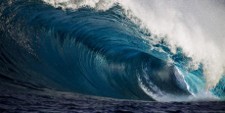
Greg Barker: "When the Coalition came to Government last year there were some very ambitious targets for marine. There were some large pots of money for marine. What is clear is that there was a total absence of delivery: neither were the targets anything close to what was potentially achievable by the industry, nor did they in any way reflect the actual progress that there had been on the ground.
"Basically, what I wanted to do was drive progress on the ground, which meant having a much more realistic strategy for deployment, implementation and funding. Also, we had to have an approach that took more into account than simply carbon abatement, particularly in relation to our 2020 target. Part of the reason for the lack of progress on the ground was that, at DECC, the wider context in which marine operated was very much the imperative of meeting our 2020 renewables targets. With the best will in the world, marine is not going to make a material contribution to meeting that very ambitious target. However, in the 2020s, and indeed in the 2030s and up to 2050, marine can make a very substantial contribution to our renewables portfolio. What is more, marine offers the UK a unique entry point into a global renewables market, in that the UK really is a global leader in this particular technology and there is a huge industrial potential that was not being reflected in the focus on marine.
"What I have endeavoured to do is drive forward the realistic deliverable deployment on the ground by working much more closely with the industry and being much more mindful of what we can help deliver at an industrial level, even if this is a longer timeframe than perhaps we have been used to in the past. If we do not start, we will never deliver that future potential.
"In terms of the roadmap you are right, Chair. The UK renewables roadmap quotes 200 to 300 MW by 2020, when the 2010 Marine Energy Action Plan suggested 1 to 2 GW. Some people have interpreted this as representing in some way a lack of ambition or a rowing back. The fact of the matter is the 200 to 300 MW by 2020 by no means represents a cap on our ambition. Instead, it is meant be a realistic most up-to-date projection, based on independent consultants' reports of what is actually in the pipeline and what is potentially deliverable. We are going to continue to monitor that, however, and if there is the opportunity to upgrade that realistic forecast we will certainly do so. I would be disappointed if the efforts we are making to drive progress in the sector do not result in an upgrade of the potential.
"The fact is that in May 2010, when we came into office, despite the high targets and the high numbers for potential funding, there were only 2 MW of marine energy devices deployed globally and almost all of that was in the UK. We are starting from an incredibly low base of actual deployment-effectively from a standing start-so we are trying to go from 2 MW to 200 to 300 MW. Certainly everyone that we talk to in the industry thinks this more realistic approach is going to actually deliver, and obviously it is delivery that is going to be the benchmark of success."
Plans to dredge Falmouth harbour likely to proceed
The dredging of Falmouth Harbour could begin in early 2013, Chancellor of the Exchequer George Osborne has said.
The £20m dredging plan is part of Falmouth Harbour Commissioners (FHC) master plan to encourage cruise ships to use the port.
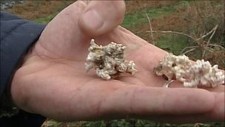
Maerl Dredging will have to be done without damaging calcified seaweed beds
FHC has said the master plan will help create up to 800 jobs for Falmouth. Before the go-ahead is given, a scientific trial will have to establish that dredging will not damage protected seaweed beds.
Earlier this year, the plan had been blocked by the EU over environmental fears for the maerl [calcified seaweed] beds, which act as a nursery for commercial fish stocks. The beds only exists in a few coastal areas and can take thousands of years to form.
But FHC has said less than 2% of the maerl will be affected and it will be lifted before dredging and returned afterwards.
The Chancellor's Autumn Statement said a scientific trial to resolve the environmental issues had been agreed by FHC and the Marine Management Organisation (MMO). "A decision on the developer's marine licence application will follow if the trial succeeds," the chancellor said. "If this application is then successful, it is anticipated that development could proceed in early 2013."
Shipping CO2 emissions should be included in UK carbon reduction targets
Greenhouse gas emissions from shipping should be counted in the UK's carbon targets, the government's chief climate change advisers have urged, because they will imperil efforts to control global warming if left to rise unchecked.
Including emissions from shipping is controversial, however — shipping and aviation were purposely omitted from the United Nations negotiations on emissions reduction, because of the difficulty of apportioning them to particular countries.
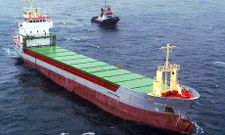
Carbon emissions from shipping should be counted in UK carbon targets, climate advisers warn. Photograph: Peter Maenhoudt/AP
Changing the rules on the UK's targets could mean Britain must cut its overall emissions at a faster rate than other countries, and will mean that other sectors — including road transport, agriculture and industry — have to cut their carbon by more than envisaged, to make up for the increase in emissions when shipping is taken into account.
The call for a rule change came from the Committee on Climate Change, the statutory body set up under the Climate Change Act to advise the government on how to meet the UK's 2050 target of an 80% cut in emissions, compared with 1990 levels.
The body — which some Conservative MPs wanted to axe — can only advise, but its advice is influential. This year, David Cameron was forced to face down opposition from some of his own party and sections of industry, in committing the UK to the stiff carbon budgets for the 2020s recommended by the CCC.
David Kennedy, chief executive of the committee, said: "It is clear that shipping emissions could well be significant, and so cannot be ignored — they should be included under the Climate Change Act. It is also clear that there is scope to reduce emissions, which would reduce costs of inclusion. In order to ensure this, the government should pro-actively support development of new policies aimed at encouraging investment in cleaner shipping technologies and more efficient operational practices."
According to CCC research published on Thursday morning, the UK's share of international shipping is likely to account for about 11% of the total carbon budget permitted under the Climate Change Act by 2050, representing about 18 megatonnes of carbon dioxide out of a total budget of 160 megatonnes, if the UK is to meet its government-set targets.
This would mean that emissions from other sections of the economy would have to be reduced, to compensate. That is likely to be unpopular with some sections of business, and there is likely to be a fierce battle over the CCC proposals, which MPs must decide on by the end of next year.
But the CCC insisted that there were many ways in which the shipping industry could be helped to reduce its greenhouse gas output. For instance, upgrades to engines and propulsion systems will improve efficiency, and new technology used to coat hulls can reduce fiction and cut fuel consumption. Ships can also be encouraged to travel more slowly, which would save fuel, while modern software can calculate more efficient routes, especially when combined with more accurate weather forecasts. Biofuels could also be used, though these are controversial.
Some of the more novel technologies suggested by the CCC include a form of return to the age of sail, using kites or new forms of sail to harness the winds.
One option to encourage the uptake of these technologies would be to include shipping in the European Union's emissions trading scheme, in the same way that international aviation is to be included from next year. However, that option has been put on hold by the European commission at present, in part because of the difficulties of pushing through the inclusion of aviation. The US, China and other governments are threatening a trade war with the EU over the issue, arguing that forcing airlines to buy carbon permits for what they emit amounts to a tax and is therefore illegal under international law.
Environmental groups say that continuing to exclude aviation and shipping emissions from international consideration makes a mockery of efforts to stave off climate change.
Another difficulty still to be resolved is accurately assessing emissions from shipping. The CCC suggested that including shipping in carbon targets could be put off until "progress has been made on a methodology to accurately reflect international shipping emissions." The shipping industry has been promising to co-operate on such an assessment for years, and to introduce voluntary initiatives to cut carbon, but to date these have had little effect.
Gulf of Mexico Bluefin tuna "probably okay after BP oil spill"
Last year's BP oil spill probably won't push the troubled bluefin tuna population in the Gulf of Mexico over the edge as some scientists had worried, a federal analysis shows.
Of all the potential damage from the 172-million-gallon (651-million-litre) spill in April 2010, scientists had been most concerned about how the oil spill would harm an already overfished species of large tuna. That's because about one-fifth of the spawning habitat where the Gulf's baby tuna were living was coated with oil, according to satellite records. Tuna less than a year old are most vulnerable to pollution.
An analysis by the National Oceanic and Atmospheric Administration (NOAA), using two different projections from computer models, says that at most, such a spill probably would result in a 4 percent reduction in future spawning of the fish, but probably far less.
Bluefish tuna is considered one of the Gulf's signature species. A summit that begins Monday in Houston will examine the Gulf's health, including the government's restoration plans and the tuna's fate.
"It appears so far that the impact on the larval population is relatively small," said Clay Porch, director of sustainable fisheries for NOAA's South-east Fisheries Science Centre in Miami.
The agency's analysis, which was mentioned in two pages of a 114-page government update on overall tuna health released in May, is based on an assumption that 1 in 5 baby tuna was killed or unable to reproduce in the future because that's the size of the spill in the spawning area. That 20 percent potential loss of year-old tuna translates to 4 percent of the overall tuna population in the future. Overall population figures also have to factor in the fact that in general many baby tuna at that age die naturally. But that is probably way too high a figure, Porch said in an interview.
Instead of 20 percent of baby tuna being harmed, more recent analysis yet to be published said it should be 11 percent or maybe even 5 percent, he said. Those figures should be reduced even more for the overall future population of tuna, down nearer to 2 percent. At most that number should be 1 in 9 or even in 1 in 20 deaths of baby tuna, and that's only the effect on one year for the long-lived tuna.
Those smaller figures are based on larval surveys that have not been released publicly because of a potential court case with BP over damages from the spill, and more simulations "that are conditioned on real data," Porch said.
Porch said it's unlikely that the effect on tuna stock would hit 4 percent and "it is not an additional major source of stress" on the overall population of the bluefin tuna in the Gulf. Other work on baby tuna health will be published in peer reviewed science journals. But that's only the young. So far NOAA doesn't know how the spill affected adults and whether adults of all ages were killed or made infertile in massive numbers that could have a bigger effect on the overall population than the oiling of one year's worth of young, Porch said.
Boris Worm, a fisheries professor at Dalhousie University in Canada who has warned of problems with tuna populations in the past, said the NOAA figures are within the yearly variations of mortality for tuna. "So it will be a bad year, but not a catastrophic year," Worm said. "This wouldn't push them over the brink."
Former NOAA chief scientist Sylvia Earle, a renowned ocean explorer who has campaigned against overfishing of tuna, isn't convinced that bluefin tuna weathered the oil slick. "I think it's too early to celebrate a possible greater survival than had been predicted. These are, after all, models," Earle said. "The truth is we don't have enough information to be able to clearly say one way or another what happened to the 2010 class of baby tuna."
Gulf scientists have wondered for months about the health of the bluefin tuna, said Larry McKinney, executive director of the Harte Research Institute for Gulf of Mexico Studies at Texas A&M University in Corpus Christi. "They are sentinel species that gives us an idea of the health of the open ocean, where we don't know a lot," McKinney said.
Marine Conservation Society questions the Government's commitment to protect UK seas
The Marine Conservation Society (MCS) is calling into question the Government's promise to protect English seas after Defra admitted it will fail to meet an international commitment of Marine Protected Areas by 2012.
The charity's concern follows a statement by Environment Minister, Richard Benyon, MP, on Tuesday 15th November 2011, of a delay to the public consultation, and therefore the designation, of Marine Conservation Zones (MCZ) around the English coast, because of a lack of evidence from the regional projects involved in the process.
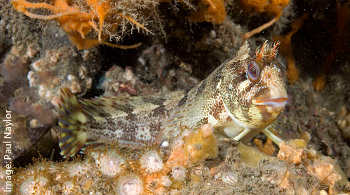
Tompot Blenny. Photograph: Paul Naylor
MCS says the delay in designation of a network of MCZs in England until 2013, will be hugely disappointing to the million people involved in the three year long process, which has cost over eight million pounds. MCS says the written statement, from Environment Minister Richard Benyon, is both encouraging and concerning.
MCS Senior Biodiversity Policy Officer, Dr Jean-Luc Solandt, says the fact that the public consultation at the end of 2012 will include all sites recommended by the Regional Projects is good news, however getting to that point may not be plain sailing, because a new more robust evidence base is required for each site to ensure they are designated.
"Defra says advice from the Science Advisory Panel indicates a number of 'gaps and limitations in the scientific evidence base supporting the MCZ recommendations'. We want to know how many more millions, and how much more time will need to be spent to ensure Defra gets the evidence it is seeking. This is hugely frustrating, as the process has already eliminated some of the best sites for biodiversity protection because of over-riding economic interests of the industry stakeholders in the room."
MCS received over half a million messages of support for marine reserves during 2009. The charity had representatives on all four regional MCZ projects between 2009 and 2011 and provided evidence of wider society support for protection via its Your Seas Your Voice website.
Dr Solandt says that MCS, having been closely involved with the regional projects, believes they have considered all the best available scientific evidence for the sites, but this was not adequately described in the final reports; "We urge Defra to get together with key scientists and conservation agencies involved in the regional processes to review the available evidence used for each draft MCZ so that we can confidently designate key sites. Let's hope this saves the vast majority of UK sites that have been put forward."
MARINET observes: MARINET supports the concern expressed by the Marine Conservation Society.
However the problem arises because the UK Government did not hold true to its commitment, given to Parliament at the time of the Marine and Coastal Access Act legislation in 2009 which creates Marine Conservation Zones (MCZs), that the MCZ identification process would be "led by the science".
What this means is that if the Government's commitment had been honoured, then the Government's statutory nature conservations organisations (Natural England and JNCC) would have been required to state at the very beginning of the identification process where, on the basis of the science, they would have liked the MCZs to be located. Instead, the Government (Defra) allowed the commercial and industrial users of the sea and fishermen to record, before any other process got underway, all those areas where they would not favour MCZs being located.
As a result, only after commercial interests had been given their say, did the identification of MCZs in the remaining areas of the sea proceed. In other words, science and scientific knowledge did not lead the process.
Now, with the a set of MCZs having been submitted to Government (Defra, and Natural England/JNCC) it has become apparent that the scientific basis for the designations is not as robust as it should be. If the Government had led with the science, as it promised Parliament, and had not allowed commercial users of the sea an influential first say in the identification process then this delay, and the possible dilution of the designation of the final set MCZs, would not now be an issue of serious concern to marine conservation organisations.
We must trust that the UK Government will still hold firm to its commitment to be "led by the science". If this is so, confidence will be restored. However, at the present time the final outcome remains disconcertingly unclear.
Australia announces plan for world's biggest marine reserve
Australia has announced plans for the world's biggest marine park, intended to protect vast areas of the Coral Sea off the north-east coast and the site of naval battles during the second world war.
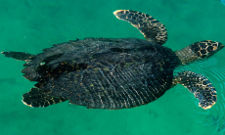
The Australian marine park will protect green turtle nesting sites. Photograph: Getty Images
The environment minister, Tony Burke, said the park would cover an area almost the size of France and Germany combined and would help to protect fish, coral reefs and nesting sites for seabirds and the green turtle.
"The environmental significance of the Coral Sea lies in its diverse array of coral reefs, sandy cays, deep sea plains and canyons," Burke said. "It contains more than 20 outstanding examples of isolated tropical reefs, sandy cays and islands."
The park would also cover ships sunk in the Battle of the Coral Sea, a series of naval engagements between Japanese, US and Australian forces in 1942, considered the world's first aircraft carrier battles. Three US ships were known to have sunk in the north-eastern area of the Coral Sea — the USS Lexington, the USS Sims and the USS Neosho, Burke said.
The government will finalise the limits that will be imposed on the Coral Sea marine park, which will be within Australia's economic zone, in 90 days.
The world's current largest reserve was established by Britain last year around the Chagos Archipelago in the Indian Ocean, which includes coral atoll The Great Chagos Bank.
EU Parliament rejects Western Sahara offshore fisheries agreement
The EU fisheries in Western Sahara has been voted down in the European Parliament.
Reports made for the European Commission have shown that the EU fisheries in Western Sahara are a complete waste of EU taxpayers' money, and contribute to destruction of marine life offshore Western Sahara. EU fleet must now return from Western Sahara.
The plenary vote in the European Parliament over European Union fisheries in Western Sahara took place on 14th December.
The parliament voted over whether to accept the 1 year extension of the EU fisheries in Western Sahara. The agreement is entered into between the EU and Western Sahara's occupying power Morocco. The extension was approved by a tiny minority in the Council of Ministers in June, as the former 2007-2011 agreement expired in March.
Reports done for the European Commission have showed that the EU fisheries in Western Sahara are a complete waste of EU's taxpayers money, and contribute to destruction of marine life offshore Western Sahara. In addition, the Parliament's own legal service had already concluded that the agreement is in violation of international law, since Western Sahara is not part of Morocco, and the people of the territory have never approved the fisheries.
In November, both the parliament's Budget Committee and the Development Committee recommended that the fisheries be stopped. In the Fisheries Committee, the rapporteur Carl Haglund from Finland also recommended a rejection. However, a small minority of the fisheries committee managed to change the conclusion of the Haglund report so it appeared in favour instead of rejecting the agreement.
The vote was over whether to approve or reject the changed and nonsensical Haglund report which had been amended to accept the controversial fisheries.
The result was that 326 voted against the report, thus demanding the fisheries to stop, with 296 parliamentarians, mostly following the Spanish fishing interests, voting in favour of the Haglund report, and 58 abstained.
The consequence is that the EU fleet has to immediately stop fisheries in Western Sahara and return home from the occupied territories of Western Sahara.
"This is a complete victory for the Saharawi people. The parliament has refused to blindly follow the interests of the Spanish fisheries industry. We expect this to have consequences for the Parliament's handling of future agreements with Morocco that involve the territory of Western Sahara. The UN has clearly stated that the Saharawi people has a right to be consulted on such issues", stated Sara Eyckmans of Western Sahara Resource Watch.
Spanish fisheries interests are already pushing for a new and illegal 4 year fisheries agreement in the occupied waters from beginning of 2012. Morocco has lobbied hard for the continuation of the fisheries offshore the territory it illegally occupied in 1975.
Western Sahara Resource Watch has been working since 2006 to stop the EU fisheries in the occupied Western Sahara.
Evidence from S. Africa on how climate change affects fishing
African fishing is almost always done by men, with the women being left on shore to work in the canning and processing factories. Not in Ocean View, near Cape Town in south Africa. Here the South African fisher-women's association, drawn largely from some of the poorest townships, has 75 members aged 28-52. They each own a small 5 metre-long boat and go one mile out in the giant Atlantic swells two or three times a week to catch crayfish, or rock lobsters.
The fish sell in restaurants for a fabulous $60 a kilogram, but these subsistence fishers have strict quotas and see little of that after deductions. The women are allowed to land only 800kg of fish a year and can only go to sea in a short season and when the weather allows.
"That's not so often now," says Sahra Luyt, chair of the group. "The whole marine environment around here has begun to change since we started only about 20 years ago."
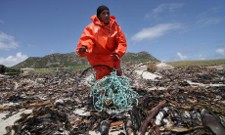
A member of the South African Fisher-women Association on the Kommetjie beach near Cape Town. Photograph: Thys Dullaart/Oxfam
According to the women, the seas have become rougher, the storms now blow up faster and are more intense, the sea water temperature has increased and the winds are stronger. "We are seeing fish that we never saw before, like sharks and octopus," says Luyt.
The women are not scientists and know that fish stocks are affected by quota systems, poaching, over-fishing by big foreign trawlers, and phenomena that effect global sea temperatures, such as El Niño and La Nina. But they are convinced that climate change now plays a part in their work.
"We the fisher people know what we see, and we can see changes. The lobsters are hibernating for longer, and their shells are softer and more fragile than they were. Their breeding cycles are being disrupted. The sea temperature is definitely warmer than it used to be. "The seas are much rougher these days and people are scared to go out. The wind comes up bigger than before. The weather patterns seem to have changed too." All this means there is a decline in the quality of the lobsters — which means there are fewer to catch and harder to sell.
African fishing is particularly vulnerable to climate change but very little work has been done to monitor temperatures, trends or changes, says Tabeth Chiuta, former IUCN director and now regional head of the WorldFish research group supported by the Consultative Group on International Agricultural Research (Cgiar). An international study in 2009, led by Edward Allison identified 33 fish-dependent countries around the world as "highly" vulnerable to the salinisation of freshwater habitats, temperature rises and costal storms. Most were least developed countries, including Bangladesh, Guinea, Malawi, Pakistan, Peru, Senegal, Uganda, and Yemen. Not included were dozens of small island states and people who depend on subsistence fishing.
But with 200 million Africans believed to be dependent on fishing for a large part of their diet, the need for research is imperative, she says. "If sea temperatures increase by just 1.5C, the effect on coral reefs, where many fish breed, could be devastating. Climate change will affect ocean currents with sea levels rising and storms intensifying; it will have an impact on rainfall, river flows, and changing lake levels. It will further lead to the acidification of water sources, calcification and coral bleaching," said Chiuta.
Climate change could lead in some places to benefits, says Chiuta. Flooding can both destroy aquaculture facilities at the same time extend the range of fish breeding grounds. "There has been an over emphasis on looking at the potential effects of climate change on crops. Now it must be a priority to look at climate change and fishing. Most of the information we have is based on people's experiences. There is definitely sense in what local people say, but we really need to isolate the impact of climate change from the natural variability of the climate in Africa. After all, so many lives depend on it."
Japanese tsunami fund "used for whaling programme"
Japan has used funds from its tsunami recovery budget to subsidise its controversial annual whaling programme, environmental activists say. Greenpeace says 2.3bn yen ($30m; £19m) from a budget of 12.1 trillion yen is being used to fund extra security. Japanese officials argued when they applied for extra funding that whaling helped coastal communities.
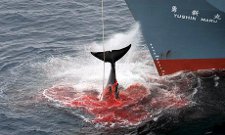
A Japanese ship injures a whale with its first harpoon. Photograph: Kate Davidson/EPA/Corbis
The whaling fleet has reportedly headed for Antarctic waters, though Tokyo has not confirmed the reports.
There has been a ban on commercial whaling for 25 years, but Japan catches about 1,000 whales each year in what it says is a scientific research programme. Critics say those claims are just a cover for a commercial operation, and accuse the Japanese of hunting the animals to the brink of extinction only for food.
Activists from the Sea Shepherd group have attacked the fleet as part of their campaign against whaling. Last year Japanese abandoned its programme before it was completed, citing "harassment" from the group.
Earlier this year, the Japanese Fisheries Agency applied to the government for extra funding for its programme from the emergency budget aimed at helping communities recover from the devastating tsunami and earthquake. The agency argued that some of the towns and villages affected relied on whaling for their livelihoods. Activists say the agency's funding request was approved and it has spent the money on extra security and covering its debts.
Junichi Sato, from Greenpeace Japan, told Australia's ABC that there was no link between the whaling programme and the tsunami recovery. "It is simply used to cover the debts of the whaling programme, because the whaling programme itself has been suffering from big financial problems," he said.
The Australian and New Zealand governments have both criticised Japan's decision to continue whaling. They are both considering sending vessels to monitor the whaling fleet. Sea Shepherd activists have promised to carry on their campaign against the whaling fleet.
Campaign to make London a "sustainable fish city"
Sustainable Fish City reports on its website: "Sustainable Fish City is an initiative conceived and supported by an alliance of not-for-profit organisations already working on sustainable seafood issues. Some also run advisory or support services that can help businesses to develop sustainable seafood policies and practices. We want London to become the first ever Sustainable Fish City, to show what can be done if people and organisations make a concerted effort to change their buying habits. Find out more about the targets we aim to reach before we declare London a Sustainable Fish City."
For further details, visit www.sustainweb.org/sustainablefishcity/about/#working_group
Sustainable fish marketing undermined by confusing labelling
Confusing and meaningless labelling is undermining much of the positive work supermarkets are are doing to source and promote sustainable fish, according to a new survey, which claims some retailers show "a blatant disregard" to where their products come from.
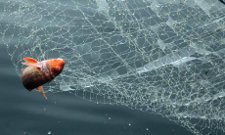
Confusing labelling is undermining positive work done by supermarkets to promote sustainable fish, says the Marine Conservation Society. Photograph: Matt Cardy/Getty Images
The greenest policies also often apply only to own-brand seafood and fish — not everything sold in store, including tinned and frozen fish — according to the latest supermarket seafood survey from the Marine Conservation Society (MCS).
The research sees the Co-operative and Marks & Spencer tying for the top spot, a gold rating, marking continued success for the Co-op, hailed by the MCS for "good" labelling and for selling nothing from the MCS "fish to avoid" list — which includes skate, eel and bluefin tuna.
M&S has the most comprehensive seafood policy of all retailers covering all fish sold in store, not just its own brand. But the MCS notes its labelling policy is still falling short, and needs improving.
Sainsbury's and Waitrose picked up silver, behind M&S and the Co-op. However, none of the other eight supermarkets which took part in the survey reached the bronze criteria, while some retailers refused to take part in the research at all.
Scoring reasonably well were Morrisons, Tesco and Iceland, but they all failed to meet the bronze criteria set by MCS, as many sell either too much fish from the charity's Fish to Avoid list.
The MCS, fisheries officer, David Parker said: "The 2011 survey has thrown up both positives and negatives. Some supermarkets are really working on their seafood polices with a positive attitude towards improvement — although most policies disappointingly only refer to their own brands. Many supermarkets are working hard on their farmed and wild caught fish sourcing. However, labelling continues to be a stumbling block for almost all retailers."
The MCS's complaints about labelling echo the findings of other research by Which? and environmental law group Client Earth.
Channel 4's Fish Fight campaign of this year — led by the food writer Hugh Fearnley-Whittingstall — highlighted the issue of sustainability, prompting a significant increase in sales of "alternative" species of fish and seafood at the end of January.
The Co-operative Ethical Consumerism report — due to published this Thursday — will show that last year, sales of fish from sustainable sources grew by 16.3%, from £178m to £207m. That was twice the rate for total fish sales which increased 8.2% in the same period.
Globally, 85% of fish stocks are fully fished or overfished, while only eight out 47 fish stocks in UK waters are currently in a healthy state.
Polar oceanographer explains the science behind climate change
The Open University reports: "The science of climate change has been much in the headlines again over the last few weeks. COP17 in Durban, climate sceptics questioning the science of global warming and the release of 5,000 further 'Climategate' e-mails have kept the arguments blazing. The Open University asked Dr Mark Brandon, Polar Oceanographer and Senior Lecturer in Environmental Science, to explain what scientists have observed about temperature changes and how it affects the Polar Regions."

Dr Mark Brandon
Question: Satellite observations show the extent of Arctic sea ice has declined over the last 30 years, but that overall Antarctic sea ice has been expanding over the same period. Is there a problem then?
Answer: The changes in the Arctic sea ice are not balanced by the changes in the Antarctic sea ice. It is the volume of Arctic sea ice that is critical. We have extremely good records of the ice thickness and ice extent. It is a fact that the extent of sea ice in the Arctic is decreasing in both thickness and extent — so the volume of Arctic ice is decreasing — and these changes in the Arctic are huge.
In the Antarctic it is true that the extent of ice has increased — but by a relatively small amount and we don't know enough about the thickness to derive the volume. If you combine the Arctic sea ice and the Antarctic sea ice changes to create a record of the total global ice then you get this picture.
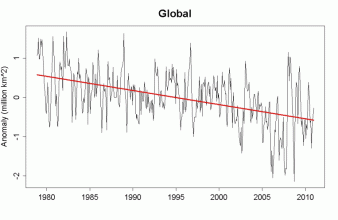
The global trend of sea ice downwards and about 36,000 km2 per year. There has been a net loss of over a million square kilometres of global sea ice extent since satellite records began The mean volume of arctic sea ice has decreased by something around 50% since the start of the satellite record.
A recent publication in Nature described the loss of Arctic sea as: "The duration and magnitude of the current decline in sea ice seem to be unprecedented for the past 1,450 years"
Question: Is it true that polar bear populations are rising, and not falling as reported?
Answer: Many bear populations are dropping, as we say. Longer summers with no ice are probably the main reason why many polar bear populations are dropping. So what is happening to the bears? Different things in different parts of the Arctic, but here is what the Polar Bear Specialist Group of the IUCN Species Survival Commission say about it:
In 2009, of the 19 recognised sub-populations of polar bears, 8 are in decline, 1 is increasing, 3 are stable and 7 don't have enough data to draw any conclusions. Figure 1 below compares the data for 2005 and 2009.
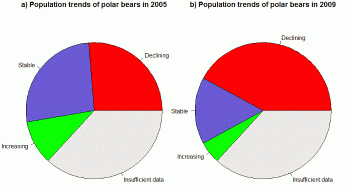
It is clear that the area of red (bear population trend decreasing) has significantly increased from 2005 to 2009 and the area of green (bear population trend increasing).
Question: Recent research findings show that the increased evaporation from the Arctic ocean, as a result of warming, will cause more cloud cover, thus counteracting its adverse effect, so isn't that good news?
Answer: Cloud feedback is not thought to be as strongly negative feedback, so this argument is outdated and fundamentally wrong.
The idea is that clouds reflect the solar radiation from the planet which would mean there would be less reaching the ground to warm up. It is a nice simple idea but this view is outdated and very likely completely wrong.
It depends on where the clouds form. Low altitude clouds will reflect more heat whereas high altitude ones trap it. Overall there is an increasing amount of evidence that increasing the overall cloud cover will actually increase the warming.
Question: There have been reports of a modest increase in mean global temperature (about half a degree Centigrade) during the last quarter of the 20th century. For this century, the UK Met Office and World Meteorological Office said there has been no further global warming. Have we stopped the trend?
Answer: Global mean temperature is not polar mean temperatures and it is inaccurate to quote the former when referring to the latter
The global mean temperature is derived from averaging data from all over the planet. Some parts are warming and some are cooling. Overall the global trend is relentlessly upwards.
Focussing on a very short timescale, e.g. 10 years, would not be an accurate reflection of the global trend which is relentlessly upwards. So let's look at the Arctic. This is the trend of annual average Arctic temperature for a meteorological data set from the National Centre for Atmospheric Research (NCAR) in the range 80-90N over the last 60 years.
The trend is approximately -32C in 1950 to approximately -25C by 2010.
The winter temperature of the Arctic has warmed by a huge amount since 1950.
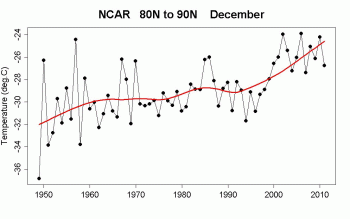
UK government says more time is needed to identify MCZs, but NGOs express concern
Efforts to set up a network of protected areas around the UK's seas have been delayed, the government has admitted. Environment minister, Richard Benyon said the government was still fully committed to creating "marine conservation zones" in UK waters, but there were a "number of gaps and limitations" in the scientific evidence for the 127 proposed areas. But conservationists criticised the delay as "unacceptable" and warned the government was failing to protect important habitats and wildlife.
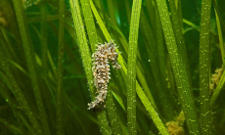
A small spiny seahorse (Hippocampus guttulatus) in a seagrass bed, one of the many species that could protected by the proposed marine conservation zones. Photograph: Lin Baldock/Natural England/PA
In a written ministerial statement, Benyon said that government bodies Natural England and the Joint Nature Conservation Committee (JNCC) would be providing their advice to government on the proposed zones six months later than planned. A public consultation on all the sites would be conducted towards the end of next year, with the first conservation zones designated in 2013, he said.
Some 127 proposed marine conservation zones (MCZs) have been drawn up by four regional groups as part of efforts to develop a network of areas designed to improve the protection of the marine environment. They range from a 2,200 square mile (5,698 sq km) site offshore in the south-west of UK waters which could be designated to protect seabed habitats, to around 100 acres (40.5 hectares) of coastal saltmarsh, saline reedbeds and mud flats in an estuary in the North Sea.
Benyon said that while the regional projects, made up of conservation organisations, fishing and marine industry representatives, leisure groups and other interested parties, had done excellent work, it was clear from the advice of an independent scientific advisory panel that there were gaps in the evidence supporting their recommendations. "It is important that we get this right. It is vital that we have an adequate evidence base for every site if we are to create successful, well-managed marine conservation zones. An adequately robust evidence base will be essential when we come to implement management measures."
He said the Department for Environment, Food and Rural Affairs would be commissioning significant additional work, including an in-depth review of all the recommendations, and that extra resources would go to carry out seabed and habitat monitoring. He said some zones could be designated fairly quickly where there was enough evidence for them but others would need more investigation.
The Wildlife Trusts, which last week raised concerns that the government was set to push ahead with designating just 23 of the proposed areas, welcomed the news that all 127 would be in the consultation. But Joan Edwards, of the Wildlife Trusts, said: "Despite international evidence for the urgent need to protect our seas, the minister's statement will result in further unacceptable delay." She said Defra appeared to be changing the level of evidence required after two years of the process, and that if more data were needed it could be gathered during consultation or after designation. "We are disappointed that we now face a further delay of at least 12 months when more damage to marine habitats will continue to occur."
Kate Sugar, marine policy officer with the RSPB, said: "Two years ago, we were delighted that the importance of marine conservation — the Cinderella of UK wildlife protection — was finally recognised with the introduction of the UK Marine & Coastal Access Act. "However, the latest position looks like Cinderella has returned from riches to rags — as far as English waters are concerned — as the government shows no ambition for providing a comprehensive network of marine protected sites to protect species as diverse as seahorses, corals, seabirds, whales and dolphins in a timely fashion.
Call to protect 25% of our seas by marine reserves
Paul Gompertz, a director at Devon Wildlife Trust, writes in The Guardian, 9th November 2011: "Our marine environment is facing a defining moment. We are an island nation set in the midst of what were once some of the most productive seas on the planet. But a report earlier this year from the Independent Panel on the State of our Oceans (IPSO) warns us that the decline in the vitality of our oceans is in fact worse than our direst predictions. The pressing question is — what are we going to do about it?"
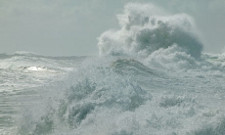
The collapse of our oceans will hurt a great deal more than easing the pressure from fishing and shipping. Photograph: Corbis
"Fishing used to be a battle against the elements in which every success was hard won and most fish escaped. While it can still be a battle against the elements, improved catch techniques and equipment mean that most fish don't escape. We may be getting better and better at catching, but it is taking more and more effort — about 17 times more than at the end of the 19th century, when the downward trend in fish stocks began in earnest.
"But hugely reducing the fish stocks isn't the only thing we have done over the past 100 years. We have also disturbed vast areas of sea bed and destroyed rich habitats which has further reduced the productivity of the seas. We have poured effluents and pesticides and mining residues into the sea via our estuaries. We have removed gravel and oil and sand and gas. We have caused the temperature of our seas to rise, disrupting marine systems. In short, we have exploited the sea mercilessly and everywhere. This once huge larder, climate regulator, heat exchanger and absorber of carbon is stressed beyond endurance.
"There is only one sensible answer for a human race intent on surviving as long as possible. We must nurse it back to health and productivity — we must manage it sustainably.
"One vital step in that management is to create marine sanctuaries, places where damaging human activity is not allowed. Who would argue against the idea that 25% of the sea should largely be left to its own devices, with human beings "only" allowing themselves exploitation of the remaining 75%? We have one last chance to get this right; can't we, in the interests of future generations and the health of our planet, confine ourselves to three-quarters?
"It would seem not. The proposal before the UK government to establish a network of marine protected areas covering 22% of our inshore waters is being undermined from every direction, largely on the grounds that short-term human self-interest is more important than long term sustainability.
"There are two broad threads to this argument. One says that we don't have enough evidence to define protected areas accurately, so until we can we should carry on as before. Damage until you can manage. However, the reverse now needs to be true. If we don't know enough about an area to exploit it without damage, we should keep out. If you can't manage, don't damage. At least one-quarter needs to be protected urgently, to avoid disaster. So let's protect the quarter currently being proposed, and then seek to refine the network of protected areas as more evidence becomes available.
"The other argument — one which is being advanced by some MPs in the south-west — says that some of the sites selected require too much human sacrifice — mainly economic sacrifice — to be realistic. This is perpetuating the very thinking which brought us to our current state of imminent collapse. There must be change, we must exploit less, we must ease the pressure on our seas. This means that some activities will be reduced. Less pressure from fishing, less pressure from shipping, less pressure from extractive industries. There are bound to be places where this will hurt. But it is manageable hurt. Collapse of our oceans is not manageable and will hurt a great deal for a great many people. We must choose the lesser of two evils now, while we still have the chance.
Sea Shepherd commences new campaign in the Southern Ocean
Sea Shepherd is about to commence its eighth campaign to the Southern Ocean this December to defend whales against the Japanese whaling fleet.
Asked in an interview on the Sea Shepherd website as to how many more campaigns Sea Shepherd proposes to undertake in the Southern Ocean to defend whales, Captain Paul Watson says: "That depends on how many times the Japanese whalers intend to return. As long as they attempt to kill whales in the Southern Ocean Whale Sanctuary, we intend to continue returning to oppose them. Every year we have gone down stronger than the year before and every year the whalers have gone down weaker than the year before. Our objective from the beginning was to sink the Japanese whaling fleet economically — to bankrupt them. We have done that. They continue to operate only because of massive Japanese government subsidies. We return every year to save as many whale lives as possible and to negate any profits from whaling by the Japanese. We intend to continue to oppose the Japanese whalers until they permanently depart from the Southern Ocean Whale Sanctuary. I will die a very happy man if I can help make this happen."
Asked about last year's campaign, called Operation No Compromise, in the Southern Ocean, Captain Paul Watson said: " Operation No Compromise was indeed a great success. We found the Japanese fleet early, we were able to block their operations and thus shut down their whaling activities. We chased the Nisshin Maru for over 3,000 miles until they finally gave up and went home six weeks earlier than they planned. Most importantly, the Japanese fleet was only able to take 17% of their kill quota and we saved 870 whales. Negated profits and saving the lives of hundreds of whales is a great victory indeed.
"From the beginning, our objective was to sink the whaling fleet economically by bankrupting the industry. We have accomplished that objective, as the Japanese whaling fleet is now tens of millions of dollars in debt. For all intents and purposes, we defeated the fleet economically. Unfortunately, we have not yet defeated the Japanese whaling fleet politically.
"Although we hoped that the whalers would not return in December 2011, we were prepared for them to do just that, knowing that they could only do so with huge Japanese government subsidies. The whalers have been given their subsidies including the equivalent of $30 million USD specifically budgeted to oppose Sea Shepherd. What does this mean? We shall soon see when we return to the Southern Ocean in December."
Asked about whether Sea Shepherd is alone in the Southern Ocean or receives any other assistance, Captain Paul Watson replied: "Yes we are alone. We have repeatedly requested co-operation from Greenpeace. They refuse to acknowledge us. We have asked for New Zealand and Australia to send ships down to at least observe the situation and to be on hand in the event of a tragedy. After all, many of our crew members are Australians and New Zealanders. But I suppose that if what we do was not dangerous, difficult, or controversial everyone would be down there. Being alone down there is not a problem, it would be nice to get some support but we do what we do with the resources and support base that we have available to us. However, it is irritating that governments obstruct us and that Greenpeace publicly condemns us. It is especially irritating that Greenpeace also raises tens of millions of dollars each year from the public to save the whales of the Southern Ocean and yet they have not sent a ship there for years.
"When I think of the whales that we have saved, and the whales that we will be able to save once again this year, I have no doubt that our strategies and tactics have, and will continue to prove successful. I'm not interested in winning a popularity contest; our concern is to save lives despite the criticisms and the controversy. The bottom line is that we have never injured anyone, we have no intention of injuring anyone, and we operate within the boundaries of the law. Saving lives lawfully without inflicting physical injuries to the whalers is what I think to be a very responsible and effective approach.
"We are also experienced in being self-reliant and safety for our crew is of paramount consideration. We have not suffered any serious injuries despite seven voyages to the most hostile and remote seas in the world."
The full text of the inteview with Captain Paul Watson can be read on the Sea Shepherd website.
Note: For further details about the protection of whales and their survival in the oceans, also visit the MARINET "Planet Ocean" webpage www.marinet.org.uk/planetocean.html.
Whales, dolphins and seals now visiting British seas due to ocean warming
The waters around the British Isles could soon be home to several new species of mammals as a rising number of foreign visitors are being reported around our coasts. Experts believe the rare sightings of cetaceans from tropical climes could mean sea creatures are scouting for new territories to settle as global warming takes effect on sea temperatures.
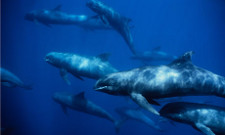
A melon-headed whale, which normally lives in tropical waters and eats squid, was spotted in the English Channel. Photograph: Gerard Soury/Getty Images
Animals from the tropics, including the dwarf sperm whale, the pygmy sperm whale, and the Fraser's dolphin have all made recent appearances here, and the Cuvier's beaked whale, another warm-water species, has been recorded increasingly regularly in the west of Britain. The melon-headed whale, a squid-loving relative of the killer whale, has been seen in the Channel, off the coast of Brittany. Before too long we may see giants such as the 16-metre gray whale nudging into deep water around Cornwall and into the Irish Sea.
"We are now seeing a number of species far from home, and they probably will continue to recur with increasing frequency," said Peter Evans, director of the Sea Watch Foundation. "Several are normally found off west Africa. For the moment they tend to be seen at times of year when our sea temperatures are at their warmest. Whales and dolphins can cope with a wide range of temperatures but their fish and squid prey tend to be more constrained, and their ranges are extending significantly northwards."
He said cetaceans would follow their favourite food, and many species rare in colder waters just a decade ago had moved into British seas. This autumn a dwarf sperm whale was spotted in Mounts Bay, Cornwall, while a pygmy sperm whale, its close relative, was found beached on Seil island, near Oban. "They were both very big surprises: they are rarely seen even where the populations are known to exist," said Evans. "If the fish are extending their range, as we know many are, then the whales and dolphins will follow. Anchovies, for example, were really quite scarce in the North Sea 10-20 years ago. Now they are widespread and may be why the common dolphin is now a regular in the North Sea. The behaviour of different fish, if they shoal or don't shoal, for example, requires a fair bit of understanding, so once a species has learned a feeding strategy they will follow rather than learn a new technique for a new prey."
Evans believes we may soon see a visitor that disappeared from the Atlantic in the 17th century — the grey whale. "They migrate up the west coast of north America, from Mexico and California up to the Arctic and, of course, could go no further. But now the Northwest Passage is open it is very possible they may cross the North Atlantic. "Gray whales were seen last year off the coast of Israel and off Barcelona this year. Such a remarkable appearance in such a strange location reinforces the pattern we are seeing."
Twenty-nine species of dolphin and whale have been recorded this century in British or Irish territorial waters. The common dolphin, striped dolphin, minke whale and humpback whale are among those species where numbers sighted have increased since 1980.
But it is not just the whales moving north into warmer seas; we are also seeing mammals coming down from colder climes. Bearded seals from the Arctic have been seen off the coast of Fife, east Scotland, said Callan Duck, a senior research scientist at the Scottish Oceans Institute at St Andrews University. "The change in climate and the food chains is definitely having an impact in the species we are seeing, but I think you have to remember to factor in how much better we are at spotting and recording these mammals. Good digital cameras are really accessible now, and so everybody has the opportunity to identify what they have seen — so the whole process of reporting sightings is much more accurate and efficient."
MARINET launches new "Planet Ocean" page on its website
The Marine Network of Friends of the Earth, MARINET, has launched a new page, Planet Ocean, on its website which features film, visual material, and key educational information about the range of British marine life and the issues affecting British seas.
The features of this site include:
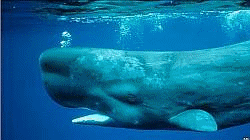
A Guide to Whales and their Survival
The illustrated feature on Whales, courtesy of material from the BBC, Sea Shepherd and elsewhere, explains the conservation status of the main whale species in our oceans, and charts the present situation regarding these mammals' protection and survival.
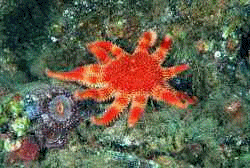
A 'Guide to British Marine Animals'
The Guide to British Marine Animals explains the main types and classes of marine animals to be found in British seas, and is illustrated courtesy of photographs by the marine photographer, Paul Naylor.
The Guide covers:
- Sponges, Cnidarians [including: Sea Anemones, Corals, Hydroids and Jellyfish]
- Worms, Crustaceans [including: Crabs, Lobsters, Shrimps and Barnacles]
- Molluscs [including: Limpets, Sea Slug, Mussel, Scallop and Cuttlefish]
- Bryozoans [including: Sea-mat, Bryozoan Bugula plumosa]
- Echinoderms [including: Starfish, Brittle Stars, Sunstars, Sea Urchin, Sea Cucumber and Feather Stars]
- Sea Squirts, and Fish [including: Fish Fins, Lesser Spotted Dogfish, Thornback Ray, Conger Eel, Angler Fish, Cod, John Dory, Lesser Sand Eel, Shanny, Leopard-Spotted Goby and Flatfish]
The "Ocean Planet" booklet is an original MARINET publication, with simply written text and many illustrations. It outlines the special importance of the seas and oceans to the ecological stability of our planet, the severe pressure that this planetary ecosystem is now under, and recommends radical changes in the perception and management principles for our seas and oceans. The ideas expressed here are fully researched, and are at the cutting edge of new thinking in solving the ecological crisis currently facing The Earth — or, The Ocean Planet.

MARINET video on the Impact of Marine Aggregate Dredging
The video on Marine Aggregate Dredging, courtesy of a range of British television programmes on this subject, is a film record of the evidence and arguments which surround the very controversial practice of supplying our construction aggregate (sand and gravel) by dredging the seabed for this material.
The evidence shows that enormous damage is caused by this activity, both to our coasts via erosion and to the habitats and ecology of our seas. The video's message is clear : this is an unsustainable extractive industry, and we are paying an enormous environmental and ecological price.
The MARINET website www.marinet.org.uk provides a premier news service, and is a marine library of considerable depth available to both students and campaigners, and it is now archived by the British Library. Details of how to join MARINET, free of charge, are on the website.
Duchy of Cornwall to contest legal ruling over oyster bed in Fal estuary
Prince Charles is to challenge a judicial ruling that threatens to expose the environmental impact of the private estate that provides his £17m-a-year income. The Prince's lawyers have sought leave to appeal against a judgement made earlier this month that concluded the Duchy of Cornwall should release environmental information about its operations because it is effectively a public authority.

The Prince of Wales is to challenge a ruling which threatens to expose operations about the environmental impact of his private estate. Photograph: Geoff Moore /Rex Features
The ruling promised to lift the veil of secrecy around the prince's £700m hereditary estate that has been in place for hundreds of years, and allow the public to use environmental freedom of information laws to inquire about its activities. It was handed down by John Angel, principal judge at the information tribunal after a test case brought by an environmental campaigner in Cornwall.
Michael Bruton was concerned about the duchy leasing waters for farming non-native oysters in the Lower Fal and Helford intertidal area. He asked the duchy what assessments it had made of the environmental impact of the lease. The duchy refused to answer, saying it was a private estate.
But the judge said he believed that no assessment had been carried out and ruled the Duchy must release information because it was a public authority. He said a key reason it should be considered was that it provides public funding to the Prince of Wales, it operates as the harbour authority in the Scilly Isles and has the role of dealing with intestacy and company failure in the county of Cornwall, which were effectively public rôles.
Clarence House has confirmed that Jonathan Crow QC, Charles' attorney general, and the duchy "have sought permission to appeal the decision which found that the Duchy is a 'public authority' for the purposes of the Environmental Information Regulations [Act] 2004".
Michael Bruton said he would fight any appeal and has launched a fundraising campaign to meet his legal bills which are likely to run into the tens of thousands of pounds and more if the case reaches the high court. "The duchy should be open about its environmental impact because the Prince of Wales has made his career out of saying environmental protection is key to man's survival on the planet," he said. "It is a great pity that we don't know whether the duchy practices what he preaches."
The latest legal battle over Charles's secrecy comes as the information tribunal deliberates on a separate case in which the Guardian is fighting the information commissioner and government ministries over the refusal to release correspondence from Charles to ministers in seven Whitehall departments under the Freedom of Information Act.
Health warning after norovirus found in 78% of British oysters
Elderly and "vulnerable" people with health problems and pregnant women should avoid eating raw oysters, the government food watchdog has advised after research revealed that 76% of British-grown shellfish are infected with norovirus.
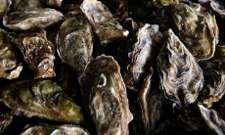
Three out of every four oysters grown in Britain contain traces of norovirus, the study for the Food Standards Agency found. Photograph: Regis Duvignau/Reuters/Corbis
Publishing the research — the first of its kind in the UK — the Food Standards Agency (FSA) urged consumers to be aware of the risks of eating fresh oysters.11The study, conducted on behalf of the FSA, found that 76% of oysters tested from UK oyster-growing beds had traces of the infectious bug, which causes symptoms such as vomiting and diarrhoea that typically last for not more than two days. The FSA said it was "difficult to assess" the potential health impact of the findings because their research was not able to distinguish between infectious and non-infectious viruses in the samples.
The research is part of continuing work by the FSA, and will feed into a study being carried out by the European Food Safety Agency in order to advise the European commission on what a legal safe level for norovirus in oysters should be.
Andrew Wadge, chief scientist at the FSA, said: "This research is the first of its kind in the UK. It will be important to help improve the knowledge of the levels of norovirus found in shellfish at production sites. The results, along with data from other research, will help us work with producers to find ways to reduce the levels of norovirus in shellfish, and work within Europe to establish safe levels."
He went on: "Although oysters are traditionally eaten raw, people should be aware of the risks involved in eating them in this way. The agency advises that older people, pregnant women, very young children and people who are unwell should avoid eating raw or lightly cooked shellfish to reduce their risk of getting food poisoning."
As part of the study, scientists from the Centre for Environment, Fisheries and Aquaculture Science (Cefas) took samples from 39 oyster-harvesting areas across the UK over two years. They tested 844 samples in total for norovirus DNA. Every harvesting area had at least one norovirus-positive oyster. Of the 643 samples that tested positive, 335 had low levels of the virus (less than 100 virus copies per gram). The other 308 samples had medium or high levels of the virus. Nine samples registered virus levels of over 10,000 virus copies per gram.
David Lees, the lead investigator at Cefas, said: "Norovirus is a recognised problem for the sector, and this study provides important baseline data to help the industry and regulators to focus on the key risks."
In 2009, the Michelin-starred Fat Duck restaurant, owned by Heston Blumenthal, was forced to close after more than 500 people fell ill with norovirus. Raw oysters and clams were later identified in a damning report by the Health Protection Agency as the main source of the contamination.
Oysters filter large volumes of water to get their food, and any bacteria and viruses in the water can build up within them. They are subject to "purification" controls before and after harvesting which help remove these.
Demand for British-grown oysters has soared in the last couple of years, driven by issues around sustainability and ethical sourcing and after serious shortages in France. Retailers have sought to reassure consumers after the latest findings from the FSA.Waitrose said in a statement: "Food safety is our absolute priority and we're in full support of this research. All our oysters are from a co-operative of known farms in Scotland who follow strict industry guidelines, and it is important to note that the FSA research looks at oysters from oyster beds, not those on sale ready for eating. Government advice hasn't changed, and we would support the recommendation that the young, elderly, unwell and pregnant should avoid eating raw or lightly cooked shellfish."
Between 600,000 and one million people in the UK catch norovirus every year. It is the most common viral cause of diarrhoea and vomiting in the UK, according to recent agency research. It is highly infectious, but the illness is generally mild and people usually recover fully within two to three days. There are no known long-term effects.
Amid fears in the industry that sales in the British oyster market — worth £20m annually — might be affected by the new findings, the main trade body sought to reassure consumers. David Jarrad, director of the Shellfish Association of Great Britain said: "Just because we know about it [norovirus] does not mean that we should be frightened by it. The more important and meaningful figure, in our view, is that low levels of the virus were found in 52% of the positive samples."
But a group of leading chefs, headed by Raymond Blanc, were so worried by the implications of norovirus that three years ago they approached a company to find out if a norovirus-free oyster could be produced. The Cornish Shellfish Company now grows them, although the more intense purification process means consumers pay up to double the price. Dr Steve Kestin, director of the company, said: "I am not surprised by the 76% figure from the FSA. There is clearly a problem with norovirus, which is why we are producing an oyster which is safe for consumers to eat."
Scientists ask the public to help decode whale "songs"
Marine scientists have launched an appeal asking wildlife enthusiasts for help in decoding the secrets of whale song in a global "crowd-sourcing" experiment. Experts in the UK and north America are asking "citizen scientists" to study and sift through about 15,000 recordings of calls by pilot whales and killer whales around the planet, to see if new phrases, meanings and dialects can be uncovered.
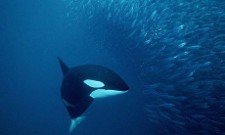
Killer whale have very complex calls or repertoires, experts say. Photograph: Amos Nachoum/Corbis
The Whale Project, launched by Scientific American and the online citizen science organisation The Zooniverse, is similar to the first major attempt to use crowd-sourcing by amateur astronomers to help discover new galaxies by studying images taken by the Hubble space telescope in July 2007.
Participants visiting whale.fm will be asked to study and then compare the sound wave patterns, or spectrograms, of calls made by whales in different pods and families of whales around the world. They will be asked to identify identical or very similar sound wave patterns, and will be able to play back each sound excerpt to help them match segments. Every sound recording is linked to a specific location in the sea, or geotagged, allowing scientists to precisely place clusters of calls in the areas where specific families of whale are known to inhabit.
Prof Ian Boyd, one of the project's collaborators from the University of St Andrews' sea mammal research unit, said scientists had discovered that people were often naturally much more able than computers to see similarities in complex spectrograms. "The first thing we want them to do is compare the images because what the human brain is very, very good at doing is comparing images, and is much better than a computer," Boyd said. "For someone like me who's tone deaf, who isn't very good at telling sounds apart, we're very, very good at making distinctions between small changes in shapes and objects."
He said pilot and killer whales had very complex calls or repertoires. Marine scientists now wanted to investigate the differences in each group's calls, like a dialect, and whether they could discover different kinds of messages from analysing these calls. "If these animals have some form of linguistics or language tradition, we're wanting to try to find the words within that repertoire of sounds. We don't know what they mean but what we do find is they have different lexicons; different groups have different types of sound, and they probably inherit these sounds from their parents. It's like a dialect. We want to be able to compare them; both these species have such complex sorts of sounds, and some of these sounds are repeated again, again and again. So they are not random."
Every matched group of sounds would be compared with the whales' location and activities that the whales were involved in. "We want to try and take that back to the context where they're produced, such as hunting or social situations."
Scientific American has previously run "citizen science" projects to track dragonfly swarms, the Gulf oil spill and a "great sunflower project", recording their observations of the natural world. Mariette DiChristina, the editor in chief, said: "One doesn't need a science degree to be a citizen scientist. All you need is a curiosity about the world around you and an interest in observing, measuring and reporting what you hear and see."
Cairn Energy fails to find oil off Greenland
A $1bn (£640m) bet by a British firm to find commercial quantities of oil in the Arctic has ended in failure and there is now mounting speculation there will be no more drilling by Cairn Energy next year.
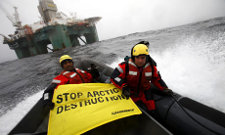
Greenpeace activists preparing to board a Cairn platform in the Arctic in a protest over drilling for oil in the pristine environment. Photograph: Jiri Rezac/Greenpeace
The controversial exploration off Greenland was physically opposed by Greenpeace but Cairn has been forced to retreat by complex geology and growing criticism in the City. Shares in the business, which was set up by the former Scottish rugby star Sir Bill Gammell, fell by as much 6% at one point today to make it the biggest faller in the FTSE-100 index of leading companies after admitting no significant finds with its two latest wells off Greenland.
Simon Thomson, Cairn's chief executive, said the company remained optimistic about the region generally but was looking for partners to take on some of the risk. Well placed sources admitted there may be no drilling in 2012.
Cairn made spectacular discoveries in Rajasthan, India — which were sold off, partly to fund a new drive into the Arctic — but the City is now losing patience.
Angus McPhail, an oil analyst at the investment bank Investec, said: "They've drilled four wells — they haven't found anything. I think the company probably needs to refocus on another area, like Sri Lanka or [the] east Mediterranean." Others noted that Cairn was now in discussions with potential partners about buying into its Greenland licences — showing its diminishing commitment to going it alone in the far north.
Richard Slape, an analyst with Canaccord Adams, said: "People are going to question why Cairn is seeking to farm out after drilling a bunch of dry holes rather than 18 months ago. They will find somebody to come in [but] it may not be on such good terms as they would have got before."
The biggest criticism came from Greenpeace, which has repeatedly urged Cairn to abandon its operations on the grounds that they pose a huge risk to a region of paramount environmental importance. Vicky Wyatt, a Greenpeace campaigner, said: "However the company tries to spin this, Cairn's Greenland misadventures have been an unmitigated disaster from day one, the company squandering a fortune drilling one dry hole after another. These results show that the incredible technical, economic and environmental risks of operating in the Arctic simply aren't worth it. Cleaning up a BP-type oil spill in the remote and freezing 'high north' would be impossible, with the devastating consequences this would have for the wildlife and people that live there. Other oil companies, like Shell, who are planning to move into the Arctic, should pay close attention to this news. Instead of drilling for the last drops of oil in some of the most extreme and hostile places on the planet, we should be using less oil in the first place."
Cairn has spent $1bn hiring rigs and other equipment to drill wells over the last two years. The pristine nature of the environment and the fact that the drilling took place after BP's accident in the Gulf meant Cairn had to take more care than ever before. A well placed source said the company may not drill at all next year — regardless of whether it picked up a partner — and might concentrate instead on seismic tests. But he added: "No definite decision on this has yet been taken."
£2.4m funding secured for Norfolk fishing heritage
To the delight of the fishermen and their organisations, Brussels Environmental chiefs have just confirmed that the European Fisheries Fund (EFF) will be donating a lump sum of £2.4m to the traditional fishermen and linked businesses trading along a sixty mile stretch of the Norfolk coast between Thornham and Caister-on-Sea. It will be provided under the auspices of the UK's Marine Management Organisation (MMO) and employed to open up new markets, provide infrastructure, boost competitiveness and to ensure that the environmental impact of fishing remains minimal.
The grant will be made to the areas fishing concerns, mainly crab. lobster and shellfish, to help provide the infrastructure for marketing, for education and in getting European protection for the Cromer crab, as part of a bid to help save the threatened industry, with a longer-term vision to create a fisheries training school.
Specific projects include a visitor and heritage centre, protection for the Cromer crab, new equipment for twenty launch and landing points around the 59-mile stretch of coast, and financial support such as the creation of a fishermen's micro-finance scheme to help businesses connected to the fishery develop in the future. Further planned is a fisheries and communities engagement programme, managed by North Norfolk Business Forum, which exists to promote and encourage uptake of the projects, applied for by businesses and individuals within the target area.
Government confirms Coastguard Centres closure
Ministers confirmed on Tuesday 22nd November that despite the massive reaction, the waves of protest and the 9,000-strong 'Coastguard SOS' petition against the closures, their plans to close eight vital regional coastguard co-ordination centres at Walton-on-the-Naze, Great Yarmouth, Swansea, Portland in Dorset, Clyde and Forth in Scotland, Liverpool, Brixham in Devon are to go ahead, so leaving no coastguard presence anywhere along the entire East Anglian coastline. This despite the overwhelming argument of the experts and the governments own promise of consultation in good faith.
Together with the many thousands who understand the resultant threat, the decision was met with 'utter dismay' by Norfolk and Suffolk Euro MP Richard Howitt, who has warned that the decision will lead to another disaster like the Marchioness or the Gulf of Mexico on the East coast. He is now writing to the European Commission calling on them to review whether the decision could breach EU rules on maritime safety and coastal protection.
What with the oil transfer at sea ban recently reversed by the government, the removal of the flood sirens, the implementation of the SMP now permitting the ceasing of defences for vital areas, the continuation of offshore aggregate dredging, the rising sea level, the worsening weather and the recent further 25% cut in the sea defence budget, the future for the East Anglian coastline and the inland Broads area now looks very bleak.
Already this year the beaches have been stripped of over 2 metres of sand with dunes, sand-cliffs and sea wall defences undercut and the first tidal surge causing flooding came about on 27/28th November — and the worst of the winter has yet to come!
The Norwich Evening news published the sad news of the governments crass decision on Tuesday 22nd November. It can be read here.
UN investment fund considering investment opportunities in the Arctic region
Guggenheim Partners, a privately held investment firm based in the US, which manages more than $125bn worth of assets on behalf of its clients, has confirmed it is setting up a new fund dedicated to making investments in the Arctic region.
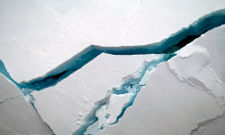
Multi year ice cracks before the prow of a Russian icebreaker en route to North Pole, Arctic. Photograph: Galen Rowell//Corbis
The news has been criticised by environmentalists who fear that it will further accelerate the exploitation by oil and shipping companies of the region which is being made even more accessible by climate change.
The fund was first revealed over the weekend at a conference held by the Juneau World Affairs Council in the Alaskan capital on the "politics of climate change". Alice Rogoff, the publisher of Alaska Dispatch who is married to one of America's wealthiest men, Carlyle Group co-founder David Rubenstein, told the conference that she had learned Guggenheim Partners was planning a fund "worth billions". She added that it might concentrate first on building a privately funded icebreaker, which could then be leased to the US coastguard.
There have been growing calls in Alaska for a $1bn "heavy" ice breaker which could be used not just to help tackle any possible oil spills and perform search and rescue duties, but also further secure new shipping routes into the area. Shell confirmed last year that it is already building two of its own icebreakers in preparation of it being granted an extended permit to drill in the Chukchi and Beaufort seas from next year onwards.
Mead Treadwell, Alaska's lieutenant general, said the fund was a "major announcement" for the region, adding that the Alaskan Arctic also currently lacks a deep water port. Without such a port available, he said, oil companies would incur extra costs by having to supply a "flotilla" of support vessels when drilling at sea.
The Guggenheim Partners website posted a link to an Alaska Dispatch story about the fund, but a company spokesman refused to provide any specific details. "We are in the very early planning stages for an Arctic investment fund," said Jeffrey Kelley. "At this point in time it would be premature to comment further about potential structure or investment parameters."
A permanently secured route through the Bering Strait up into the Arctic would be a major boon to shipping companies and resource extractors. Last month, Nordic Bulk Carriers, a Danish shipping company, said it would save a third of its usual costs and nearly half the time shipping goods if a route to China was available through the Arctic instead of via the Suez Canal and the Indian Ocean.
Ben Ayliffe, an Arctic campaigner for Greenpeace, criticised the fund: "We shouldn't be surprised that the industry which got us into the worst global economic crisis in living memory now has the planet's last great wilderness in its sights. But, even by its own standards, it would seem exceedingly short-sighted to pour billions of dollars into the extraction of climate-changing fossil fuels just as scientists warn that the Arctic's summer sea ice is entering what they call a 'death spiral'."
Exploiting Lancashire's coastal shale gas would "wreck climate change targets"
The UK will fail to meet its climate change targets if industry and politicians back controversial new plans to go ahead with widespread drilling for shale gas, according to a report which has just been published.
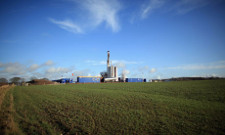
Cuadrilla Resources's shale gas drilling site near Blackpool, Lancashire. Photograph: Christopher Furlong/Getty Images
About 2 trillion cubic feet of natural gas trapped in dense shale rocks is estimated to lie beneath Lancashire according to Cuadrilla Resources, the main shale gas company operating in the UK. Further exploration in Wales, Scotland and other parts of England could add substantially to this total.
But burning it for fuel results in large-scale carbon dioxide emissions, and scientists from the Tyndall Centre for Climate Research, in a report commissioned by the Co-operative Group, warned that exploiting even a minor proportion of this gas would generate so much carbon dioxide that the government's greenhouse gas emissions targets would be rendered unreachable.
Exploiting even one-fifth of the Lancashire shale gas reserves alone would produce about 15% of the total carbon dioxide that the UK can produce between now and 2050, if government targets are to be adhered to. Those targets state that CO2 emissions are to be cut by 80% by 2050.
Kevin Anderson, professor of energy and climate change at the Tyndall Centre, at the University of Manchester, said: "The government faces a difficult choice — to lead a new and low-carbon energy revolution or stick with high-carbon fossil fuels, forgo its emission targets and relinquish its hard-won international reputation on climate change."
Proponents of shale gas say it could cut emissions by displacing higher-emitting fossil fuels such as coal, and could increase the UK's energy security by providing a "home-grown" source of gas, even as the UK's reserves in the North Sea are rapidly running out. Cuadrilla estimates that shale gas could create about 6,500 jobs in the UK.
However, the industry — with only a few exploratory wells yet drilled — has already struck controversy, as earlier this year two small earthquakes occurred close to the Cuadrilla drilling operations. A subsequent report by Cuadrilla, published earlier in the autumn, found that the drilling operations were probably the cause of the seismic activity, though they said this presented little danger to the inhabitants.
Lobbyists for the gas industry have also seized on the potential of shale gas to argue within Whitehall and Brussels that investing in gas could be cheaper than opting for renewables. The government pledged this summer to make it easier for new gas-fired power stations to be built.
Green campaigners are concerned that not enough is known about the effects of shale gas exploration. Drawing on experiences from the US, where widespread shale gas exploration has ripped up landscapes, they warn of the potential for water contamination, gas leaks, the release of heavy metals and other harmful substances, as well as increased greenhouse gas emissions.
Paul Monaghan, head of social goals at the Co-operative, said: "It is shocking how little scrutiny and thoughtful consideration has been demonstrated by the UK government and its environmental agencies when it comes to shale gas. Not least because, evidence is now emerging which indicates that gas derived from shale may have a significantly greater carbon footprint than previously thought, seriously questioning whether it can play any role in the transition to a low-carbon economy. The calls from 'big gas' for the abandonment of renewables targets must be rebuffed, and here is the science to do just that."
The new report also found that the amount of investment needed to exploit gas reserves — about £32bn — would be enough to build 2,300 offshore wind turbines, which would produce enough renewable energy to meet government targets. Shale gas exploration also supports fewer jobs than renewable energy generation — hundreds of thousands of jobs could be created in offshore wind, solar power and other green energy, but drilling shale gas wells requires minimal manpower.
Tony Bosworth, energy campaigner at Friends of the Earth, said: "If ministers give shale gas the green light it could wreck UK climate targets and keep us all in hock to soaring energy bills. The only solution to our broken power system is to develop the nation's home-grown clean energy supplies and cut energy waste. David Cameron must free us from the shackles of the big energy companies keeping us hooked on dirty fossil fuels — and support clean British energy providers instead."
Atlantic sharks are heading for extinction, but only 1% are protected
Only a tiny fraction of sharks caught in the Atlantic — less than 1% — are under protection, even though most shark species are heading towards extinction, a report by Oceana warns.
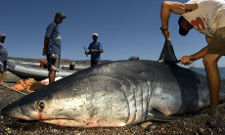
A female mako shark. Conservationists have called for limits on shark fishing. Photograph: Brian Skerry/National Geographic/Getty Images
Officials from 48 Atlantic fishing countries have met in Istanbul this week to try to protect bluefin tuna, swordfish and other large fish. But existing conservation efforts are only saving a tiny proportion of sharks, the report from the Oceana conservation group said.
"It's just the tip of the iceberg, and there are a lot of shark species, many of them vulnerable species, that are still being caught and killed," said Elizabeth Griffin Wilson, a senior scientist at Oceana.
Conservation groups at the International Commission for the Conservation of Atlantic Tuna (Iccat) meeting are pushing for a ban on the catch of porbeagle and silky sharks — which are at extreme risk — as well as catch limits on other species such as the shortfin mako shark.
Three quarters of the wide ranging shark now being caught in the Atlantic are under threat, the report said. But Iccat countries to date have only limited protection for specific shark species such as the bigeye thresher, hammerhead and oceanic whitetip sharks. There are no limits on the fishing of 15 Atlantic shark species even though some — such as the silky shark — are close to extinction. Conservationist groups hope the Istanbul meeting will build on recent momentum on shark conservation.
The White House has sought the Senate's approval for a new international treaty that would make it easier for countries to crack down on any illegal catches being brought to port. The state of Florida is expected to adopt new protection measures this week. The European Union last week banned all fishing for porbeagle shark in the Atlantic and Mediterranean. But it is a race against time. Sharks were not built for reproduction. They can take take years to reach sexual maturity, and produce only a few pups. And highly mobile animals are notoriously difficult to protect.
"You just can't manage them one country by one country because they cross international boundaries," Wilson said.
Atlantic fishing countries reported catching more than 68,000 tonnes of shark in 2009, or more than 1.3 million animals. Most were caught inadvertently by vessels targeting tuna and other fish.
Populations of some species, such as the porbeagle, which are caught for their meat as well as their fins, have fallen by 99% since the middle of the last century. Scientists estimate it could take up to 34 years for populations to recover — even with the new EU protections. Fishing of porbeagle sharks continue in Canadian waters, Wilson said.
Three other shark species are also at high risk: silky sharks, shortfin mako, and blue sharks, the report said.
New Zealand's marine oil spill disaster averted
Salvage crews are preparing to remove containers from a cargo ship that ran aground on a New Zealand reef nearly six weeks ago after pumping all remaining oil from the vessel and averting an environmental disaster.
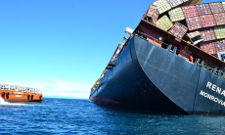
Salvage crews are to begin removing containers from the grounded Rena. Photograph: Maritime New Zealand/EPA
Government ministers and local politicians hailed the work of the teams after they managed to remove all but a few traces of oil from the Liberian-flagged Rena, which ran aground off Tauranga, in North Island's Bay of Plenty, in heavy seas on 5th October.
In the following days, several hundred tonnes of oil spilt into the sea after a fuel tank ruptured, washing onto beaches and affecting birds and other wildlife. There were fears that the badly damaged 47,000-tonne vessel could completely break apart, spilling a further 1,600 tonnes of fuel and causing an environmental catastrophe. But the Rena stayed intact as salvage workers spent weeks pumping the heavy fuel oil from its tanks to an adjoining tanker, and this process was almost complete, Maritime New Zealand said.
The next stage of the operation would involve a crane barge being put into position to begin the tricky job of removing cargo containers from the ship. An accompanying shoreline clean-up has been sufficiently successful for local beaches to be expected to reopen later in the week.
The country's prime minister, John Key, said the operation had been "very, very successful", the New Zealand Herald reported. "I think the people of Tauranga will be very happy they haven't had the environmental disaster that some predicted," Key added.
The local mayor, Stuart Crosby said: "The salvors have done an amazing job under treacherous conditions to avoid an environmental disaster. I guess we've all gone through a series of emotions that we all do in this type of event. There has been disbelief, frustration, anger, and now relief — relief that the oil has been taken away by these great people."
However, the operation to remove the containers remains long and risky, Maritime New Zealand said. It is likely to take several months, during which time the Rena could still break up. "The salvors are taking this time to make sure that all the equipment and systems are ready and working properly before commencing operations. They also need good, calm weather to operate effectively, with safety being the top priority," the salvage unit head, Arthur Jobard, said. "Once the testing has been successfully completed, the salvors will be lowering men down in a cage to ready the containers for removal. However, as we have seen with this entire operation so far, the speed at which the salvage team can work depends on many different factors. This includes weather and how complex it proves to be to access the containers, many of which are badly damaged and in very precarious positions." He said this meant it would be "impossible to predict exactly how long it will take to safely remove all of the containers on board — but realistically, it is likely to take several months of patient and careful work".
EU proposes to forbid EU vessels from removing shark's fins at sea
Europe's governments have been urged to back a global ban on EU fishermen removing shark fins at sea.
Shark finning — cutting off a shark's fin and discarding the body — is driven by a profitable market for the delicacy of shark fin soup in Asia.
A general ban on the practice has been in force in the EU since 2003, but with exceptions which allow some countries to issue fishing permits for removing shark fins as long as both the fin and body are landed and that the total fins caught do not exceed 5% of the live weight of sharks caught. The UK ended such permits in 2009, but the EU is one of the world's largest suppliers of shark fins to Asia, largely because of the volume exported by Spain and Portugal.
Now the European Commission has proposed a total ban, to be applied to EU vessels, anywhere in the world.
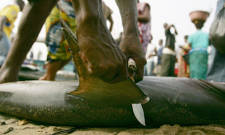
A fisherman cuts the fins off of a shark at a fish market. Photograph: Kambou Sia/AFP/Getty Images
Maria Damanaki, commissioner for maritime affairs and fisheries, said: "By closing the loophole in our legislation, we want to eradicate the appalling removal of shark fins and provide much better protection for sharks." She said controls would be stepped up, making it harder to hide "finning", and she urged EU governments and MEPs to speed the legislation through.
Once approved, the move means vessels fishing in EU waters — and all EU vessels fishing in the world — must land sharks with fins attached to the body.
Ali Hood, the Shark Trust's director of conservation, said: "The Shark Trust will look to the UK government to show leadership among the member states and champion the adoption of a 'fins-naturally-attached policy', with no exceptions."
EU director of Humane Society International Joanna Swabe warned: "It is imperative that no attempt be made by any EU member states or MEPs to water down this legislative proposal. A 'fins-naturally-attached' policy, without exception, is the only way to end the cruel and wasteful practice of shark finning." The organisation says the permit system has become the norm, rather than the exception, for the Spanish and Portuguese longline fleets.
Ricardo Aguilar, research director at Oceana, the international marine conservation organisation, said: "By opting for a fins-attached approach, the European Commission has heeded the advice of experts worldwide: landing sharks with their fins still naturally attached is the only possible way to guarantee that finning does not occur. Furthermore, if all sharks must be landed with their fins attached, it will be much easier to identify the species caught, and therefore, to gather critical data about the status of shark populations."
Globally, up to 73 million sharks are killed each year to satisfy the demand of the international shark fin market. EU nations combined catch the second-largest share of sharks — 14% of the world's reported shark catches.
Seal Laceration Deaths — further input
The spiral 'corkscrew' lacerations found on the dead seals washed up along our East Anglian coastline (see www.marinet.org.uk/archive/archivelatestnewsfiles/ltsd.pdf) was well covered on Saturday 19th November and repeated the following day, in a programme televised on National Geographic Wild entitled 'The Seal Ripper'.
It examines the deaths of up to 1,000 or more seals washed up on Sable Island off the Canadian coast and the investigations that have been carried out indicating that these deaths were/are being caused by the Greenland Sharks now hunting in shallow water, their behaviour having been modified by the collapse of the fisheries in the North West Atlantic and the shark's need to find an alternate source of food. Seal remains were indeed found in the stomachs of the sharks caught.
The Greenland Sharks, previously deep water bottom scavengers, are now apparently hunting seals resting below water. It is proposed that using their electro receptors and sense of smell, they spring an ambush when the seals are sleeping . They have jaws that can cut in both directions acting like a reciprocating saw, so when attacking/eating the seal their jaws can create the cork screw lacerations found.
It would seem that maybe these animals have now migrated to the North East Atlantic where the fisheries are also collapsing, so indicating yet another catastrophic human activity caused by creating imbalance in the marine food chain.
Once both the marine and land ecosystems are compromised beyond repair the demise of humanity is assured — but who listens or cares? Politicians are more concerned about the Euro, the financial markets and exploiting the Earth's resources etc. to even notice.
Russia and China want to start exploring for minerals in Antarctica
The opening manoeuvres may have begun. During the Antarctic Treaty consultative meeting in Buenos Aires last June, Russia stated its intention to start prospecting for minerals, oil and gas in the white continent and surrounding seas. The document submitted by the Russian delegation listed the key points of the "strategy for the development of the Russian Federation activities in the Antarctic for the period until 2020, and longer-term perspective".
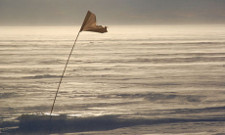
Who claims which bit and for what? Pine Island glacier, Antarctica Photograph: Andy Smith/British Antarctic Survey
Whether or not this document ruffled feathers among the 48 treaty nations nobody knows, since the meetings are closed to outside observers and the contents of the discussions are not disclosed. However the Russian document was discreetly posted on the treaty secretariat's website.
The Russian project to carry out "complex investigations of the Antarctic mineral, hydrocarbon and other natural resources… both on the continent and in surrounding waters" would jeopardise the Antarctic's special legal status and go against the Madrid protocol, which makes this near-virgin territory a "natural reserve devoted to peace and science". At present, any form of prospecting and mining is, in theory, forbidden.
Faced with the need for raw materials and against a backdrop of tensions with China, which is firmly placing its own pawns on the icecap, the former Spanish president, Felipé Gonzalez, and two former prime ministers, Bob Hawke (Australia) and Michel Rocard (France), have launched an appeal to ratify the Madrid protocol. In other words to do everything possible to persuade the stragglers to sign.
To date, 14 signatory states have yet to ratify the protocol, signed in the Spanish capital in 1991, which became effective seven years later. If those countries were to rally around the protocol, which is the principal environmental protection section of the Antarctic treaty system, it would gain more diplomatic clout. But would it be enough to prevent a rush to the Antarctic seabed? Following the declared Russian intention to do precisely that, an Australian thinktank, the Lowy Institute for International Policy, has recently published a report urging the Australian government to protect its national interests and "open discussions with like minded states in anticipation of sovereignty and resource issues being revisited in 2048". (That being that date when the Madrid Protocol can be reviewed by the treaty nations.)
Australia, like France, New Zealand, Norway, the UK, Chile and Argentina, has territorial claims on the Antarctic that were frozen by the treaty. It is one of the strange aspects about the legal setup that while the territorial claims of the seven states are frozen, they are not actually challenged. Each state maintains its claims, but is committed to not exercising them.
Rocard, who, like Hawke, was one of the architects of the protocol, is confident that it will hold up. The protocol may be revised after 2048 if three-quarters of the 12 consultative states (who have a casting vote in the treaty system) agree. But according to Rocard, the world will be feeling the effects of increased global warning by then and getting oil and gas from the Antarctic will no longer seem so relevant.
"Today everyone is panicking because we are heading for a shortage of natural resources," said Rocard. "And no coercive measures have been factored in to the treaty system to prevent anyone doing whatever they want."
Like all international treaties this one depends on the good will of its signatories and it could be seriously undermined if one country were to take liberties with the text. If Russia's aim was to test reactions with its document, it failed to trigger any official protests from the signatory nations at all, so that point should be taken very seriously. And all the more so since it comes at a time when China is reinforcing its own position in the Antarctic. China's new base in Kunlun stands at an altitude of 4,000 metres and overlooks all the other research stations. That is a powerful symbol because there is apparently no clear scientific justification for the site, according to the consultative parties who authorise these research stations, supposedly on the sole criterion of scientific benefit."
The patriotic titles of its stations… imply a latent nationalism in China's policy," observed the Lowy Institute in its report. "There are even reports that Kunlun station features a sign stating 'Welcome to China' implying Chinese territoriality and denial of Australia's claim." The Chinese station is located right in the middle of territory that Canberra considers to be Australian.
EDF, owner of British Energy, found guilty of spying
France's state energy firm EDF has been fined €1.5m by a Paris court for spying on Greenpeace. Its head of nuclear production security in 2006, Pascal Durieux, was given a three-year sentence with two years suspended, and a €10,000 fine for commissioning the spying. The Nanterre court also sentenced the security No 2 in 2006, Pierre-Paul François, to three years, 30 months suspended. EDF has also been ordered to pay €500,000 in damages to Greenpeace.

Yannick Jadot, Greenpeace's then campaign director, had his computer hacked into by a firm hired by EDF energy. Photograph: Jean-Sebastien Evrard/AFP/Getty Images
The judge further handed down a guilty verdict on Thierry Lorho, head of Kargus, a firm employed by EDF to hack into Greenpeace's computers. He got three years in jail, two suspended, and a €4,000 fine.
EDF is the world's biggest nuclear energy supplier; it owns the UK nuclear power operator, British Energy, and is a major sponsor of the London Olympics. It was charged with complicity in concealing stolen documents and complicity to intrude on a computer network.
EDF and Greenpeace have fought for years over France's power production, more than three-quarters of it nuclear. According to confidential court testimony released by a French website, Mediapart, two years ago, EDF had organised surveillance not only of Greenpeace in France, but broadly across Europe since 2004.
In 2006, EDF hired a detective agency, Kargus Consultants, run by a former member of France's secret services, to find out about Greenpeace France's intentions and its plan to block new nuclear plants in the UK. The agency hacked the computer of Yannick Jadot, Greenpeace's then campaigns director, taking 1,400 documents.
An EDF official had no immediate comment. In the trial, EDF said it had victim of overzealous efforts, and had been unaware anyone would hack a computer. "The fine and the damages awarded send a strong signal to the nuclear industry that nobody is above the law," said Adélaïde Colin for Greenpeace France. "In the runup to the next presidential elections… voters should keep this scandal in mind."
The outrage among anti-nuclear campaigners echoes that which emerged when it was revealed that France's secret services were behind the bombing of the Greenpeace ship Rainbow Warrior 26 years ago. Moreover, safety is a very live issue since Japan's Fukushima disaster. In March, only weeks later, EDF boss Vincent de Rivaz said its plan to build four reactors in the UK would be unaffected, starting at Hinkley Point in Somerset.
At present, the four EPR are being built in Finland, France and China are well behind schedule, hampered by construction problems and billions over budget, in the case of EDF's reactors in Finland, and France.
Speaking from alongside the new Rainbow Warrior, currently on its maiden voyage and docked in London, Greenpeace UK's executive director, John Sauven, said: "The evidence presented at the trial showed that the espionage undertaken by EDF in its efforts to discredit Greenpeace was both extensive and totally illegal. The company should now give a full account of the spying operation it mounted against its critics. As one of the six companies with a monopoly over electricity supply in this country and a major sponsor of the Olympics, EDF has a duty to come clean. The length of the sentences handed down shows just how seriously the judge views what the French state owned company did."
EDF has raised its target for nuclear generation in France and reported a 3.2% rise in sales.
Five of the Eight Bluefin tuna species are "threatened"
We provide here a photograph of the Atlantic bluefin tuna, courtesy of The Guardian, (see photograph 10).
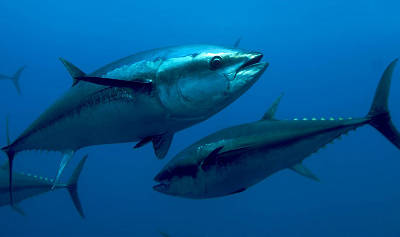
Five of the eight species of tuna are in the threatened or near threatened categories.
These include:
- Southern bluefin, critically endangered;
- Atlantic bluefin, endangered;
- Bigeye, vulnerable;
- Yellowfin, near threatened;
- Albacore, near threatened.
Tuna is a species of high economic value, and is widely fished. For further details about Tuna, visit http://en.wikipedia.org/wiki/Tuna.
New Carbon Capture and Storage (CCS) scheme proposed for Peterhead, Aberdeen
Two major energy companies have combined forces to bolster the case to build the UK's first carbon-capture project at Peterhead power station near Aberdeen. The power company SSE and Shell, the fuel producer, have announced their alliance after the recent collapse of £1bn proposals to fit carbon-capture and storage (CCS) plant to Longannet coal-fired power station, one of Europe's largest coal-powered stations.
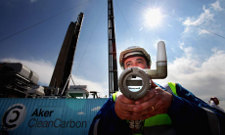
A scientist holds a pressure monitor, beside a new carbon capture test unit at Longanet power station. Two energy companies have joined forces to bolster the case for CCS. Photograph: Jeff J Mitchell/Getty Images
UK ministers have insisted they are still committed to funding a pilot project but the collapse of the Scottish Power scheme at Longannet has damaged confidence that the UK will build carbon-capture plant. A decision on another major CCS project, at a new coal-fired station at Hunterston in Ayrshire is now expected to be delayed for at least a year after receiving a record number of objections. Councillors in North Ayrshire are anticipated to vote against the project later on Wednesday, forcing the Scottish government to order a lengthy public inquiry.
The Peterhead gas-fired power station is owned by SSE and was one of the first to be mooted for carbon-capture. A small pilot project there by BP to make hydrogen and pump the CO2 into North Sea seabed was scrapped because of a lack of UK government support. It is one of several British schemes in the running for European funding, including the Ayrshire Power project at Hunterston.
Shell and SSE said they would now accelerate their planning and designs for Peterhead, to retrofit CCS equipment to one of its three 385MW combined gas cycle turbines. The CO2 would then be piped to Shell's Goldeneye gas field in the North Sea.
Ian Marchant, the chief executive of SSE, said: "If long-term targets for reducing emissions are to be met, CCS technology must be applied as widely as possible. We therefore welcomed the UK government's decision to include gas-fired generation plant in its CCS demonstration programme. However, the development of a commercial-scale CCS demonstration project presents significant challenges and will require appropriate levels of support from both the EU and UK government."
The Peterhead alliance was welcomed, if cautiously, by WWF Scotland, the Scottish Labour party and Friends of the Earth Scotland.
Alex Salmond, the first minister of Scotland, said this could be "game changing" technology. "CCS technology could transform carbon-reduction efforts across the world, particularly in fast-growing economies. As such, it has the potential to become a significant export industry for these islands, and for Scotland in particular," he said.
A spokesman for the Department of Energy and Climate Change said the joint venture at Peterhead was a welcome reflection of the strong commitment to CCS in the UK. "Gas CCS will be an important part of our future energy mix and there are a number of promising projects, both gas and coal, in Scotland and England. We will be considering projects through an open and transparent selection process to be launched as soon as possible."
The Wildlife Trusts fear that the number of Marine Conservation Zones may be drastically reduced
The wildlife in England's seas is facing a serious threat, warns The Wildlife Trusts.
The long-awaited network of Marine Conservation Zones, promised by Government for 2012, is in danger, according to the conservation organisation, which has been instrumental in marine campaigning and research. It is urging the public to write to Under-Secretary for Natural Environment and Fisheries, Richard Benyon MP, in support of Marine Conservation Zones.
After years of pressure from NGOs and with huge public support, The Marine and Coastal Access Act 2009 promised a coherent network of protection around the coast of England by 2012. Now 127 marine sites around England's coast have been recommended by four regional stakeholder groups to become Marine Conservation Zones next year.
The recommendations are the result of two years of consultation with more than one million stakeholders involved including fishermen, conservationists and businesses. This has been the first 'Big Society' experiment where local stakeholders have decided together which areas of sea should be protected.
There is a concern that Government's Statutory Nature Conservation Bodies (Natural England and the Joint Nature Conservation Committee) will recommend to Government that only a fraction of the 127 recommended sites are designated. This would result in a much smaller and less effective network of Marine Conservation Zones, leaving vulnerable and precious areas unprotected.
Joan Edwards, The Wildlife Trusts' Head of Living Seas, said: " A huge amount of work has been done to get a broad agreement on this network needed for the health and future productivity of our marine environment. Now, however, in the final stages the Government has lost it's direction and is proposing to over-ride the recommendations of local stakeholders and cut the 127 sites down to an unrealistic 30 in contradiction with the aims of the new Marine and Coastal Access Act. With Wildlife Trusts all around the UK, we are lobbying hard for the successful completion of a process that will make the difference between the life or death of our seas. We need to demonstrate the weight of public support for the Marine Conservation Zones to Government. This is a once in a lifetime chance. We can't afford to let it slip away."
The Wildlife Trusts is urging people to write to Richard Benyon and ask for Government to create the proposed network of 127 sites in England. It has produced some guidance on writing to the Minister.
Government claims that 88% of UK bathing waters now meet EU Guideline standard
Nine out of 10 beaches and bathing spots in England and Wales met EU standards for water quality in 2011, new government figures show. But campaigners claimed "meeting an outdated and inadequate standard is nothing to shout about".
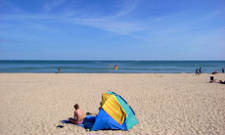
Water quality meets EU standards at 90% of beaches in England and Wales. Photograph: Alex Sudea/Rex Features
Statistics from the Department for Environment, Food and Rural Affairs (Defra) and the Welsh government show that just 10 out of 502 beaches and inland bathing sites in the two countries failed basic water quality standards. A record 88% of the bathing waters, a total of 447 sites, met European standards, up from 86% which met that grade last year.
"Almost all of our beaches meet the minimum standards now, compared to just three-quarters in 1991," said Christine Tuckett from the Environment Agency.
But Andy Cummins, from Surfers Against Sewage, said: "Many beaches may be meeting woefully inadequate water quality standards set down 35 years ago, but this still leaves bathers exposed to significant numbers of sewage spills, with possible serious health implications." Cummins said Defra figures showed that the basic standard, met by 97.8% of all beaches, still meant a one in seven chance of contracting gastro-enteritis.
Blackpool central and south beaches, St Anne's North, St Anne's Pier, Heysham Half Moon Bay and Fleetwood, all on the Lancashire coast, failed the basic water quality tests, as did Walpole Bay, Margate, and Ilfracombe Capstone and Combe Martin on the north Devon coast.
Tuckett said: "But new, stricter standards will come into force in 2015, and we are working with water companies, farmers, local authorities and beach managers to tackle persistent sources of pollution and make sure that as many beaches as possible pass these standards."
"We are moving in the right direction," said Cummins. "The top end of the new standards will give you some pretty good water quality." He noted that the government ratings were retrospective, unlike SAS's real-time sewage alerts, which immediately warn bathers of pollution washed out to sea by heavy rain.
The Environment Agency said it had helped secure further investment from the water industry for environmental improvements, some of which would be spent on bathing water. Over 90 projects will improve water quality at 37 coastal locations, it said, while scientific investigation will help identify sources of pollution at a further 44 sites.
The agency is also working with farmers to reduce the amount of animal waste washed into rivers, streams and ultimately the sea, and with local authorities to address pollution from roads, homes and business, which can be caused by appliances such as dishwashers or toilets being incorrectly plumbed.
A report in April from the Marine Conservation Society found that the amount bathroom rubbish flushed down toilets and ending up on Britain's shoreline has risen by 40% over the previous year. Cotton buds, condoms, sanitary towels and tampon applicators were among the most common items recovered.
MARINET observes: The annual statistics on UK Bathing Water Quality have always been, and remain, very misleading for the following reasons:
- The sampling for bathing water quality, under the EC Bathing Water Quality Directive 76/160/EEC, should include testing for salmonella and enteroviruses — the real pathogens which cause illness when present in sea water. For a full list of the types of pathogens and the illnesses concerned, see www.marinet.org.uk/ukbw/swimminginsewage2.pdf. However UK sampling does not comply with the EC Bathing Water Directive because it fails to sample for salmonella and enteroviruses . The result is that the true compliance of UK bathing waters with EU standards is unknown.
To pass the EU standards, there should be no salmonella or enteroviruses present in any sample taken during the bathing season. - The UK government is now allowing a practice whereby if a sample fails it may be claimed that "exceptional weather conditions" existed at the time of the sample, and thus the sample is invalid and a new sample may be taken at a later date when normal weather conditions prevail. What this means is that when heavy rain occurs, and storm overflow discharges of untreated sewage are made into the bathing water, the contaminated sample can be ignored for recording (compliance) purposes and a new sample taken when the storm discharges have ceased i.e. at a time when the testing is likely to meet the quality standard. It is this new, second sample that is used for official recording (compliance) purposes.
- Samples are only taken fortnightly. Thus if discharges of sewage are made in the period between the fortnightly sampling dates, it is possible that the contamination will not be recorded.
- Sampling points are often located some distance away from the location of storm sewage overflow outlets, thus tending to conceal the fact that swimming nearer to an outlet may lead to non-compliance of the bathing water.
Record level of global greenhouse gas emissions in 2010
The global output of heat-trapping carbon dioxide has jumped by a record amount, according to the US department of energy, a sign of how feeble the world's efforts are at slowing man-made global warming. The figures for 2010 mean that levels of greenhouse gases are higher than the worst case scenario outlined by climate experts just four years ago. "The more we talk about the need to control emissions, the more they are growing," said John Reilly, the co-director of MIT's Joint Program on the Science and Policy of Global Change.

Emissions from a coal-fired power station. The output of greenhouse gases has jumped by the highest amount on record. Photograph: John Giles/PA
The world pumped about 564m more tons (512m metric tons) of carbon into the air in 2010 than it did in 2009, an increase of 6%. That amount of extra pollution eclipses the individual emissions of all but three countries, China, the US and India, the world's top producers of greenhouse gases. It is a "monster" increase that is unheard of, said Gregg Marland, a professor of geology at Appalachian State University, who has helped calculate department of energy figures in the past.
Extra pollution in China and the US account for more than half the increase in emissions last year, Marland said.
"It's a big jump," said Tom Boden, the director of the energy department's Carbon Dioxide Information Analysis Centre at Oak Ridge National Lab. "From an emissions standpoint, the global financial crisis seems to be over." Boden said that in 2010 people were travelling, and manufacturing was back up worldwide, spurring the use of fossil fuels, the chief contributor of man-made climate change.
India and China are huge users of coal. Burning coal is the biggest carbon source worldwide and emissions from that jumped nearly 8% in 2010.
"The good news is that these economies are growing rapidly so everyone ought to be for that, right?" Reilly said. "Broader economic improvements in poor countries has been bringing living improvements to people. Doing it with increasing reliance on coal is imperilling the world."
In 2007, when the Intergovernmental Panel on Climate Change issued its last large report on global warming, it used different scenarios for carbon dioxide pollution and said the rate of warming would be based on the rate of pollution. Boden said the latest figures put global emissions higher than the worst case projections from the climate panel. Those forecast global temperatures rising between 4 and 11 degrees Fahrenheit (2.4-6.4 Celsius) by the end of the century with the best estimate at 7.5 degrees (4 Celsius).
Even though global warming sceptics have criticised the climate change panel as being too alarmist, scientists have generally found their predictions too conservative, Reilly said. He said his university worked on emissions scenarios, their likelihood, and what would happen. The IPCC's worst case scenario was only about in the middle of what MIT calculated are likely scenarios.
Chris Field of Stanford University, head of one of the IPCC's working groups, said the panel's emissions scenarios are intended to be more accurate in the long term and are less so in earlier years. He said the question now among scientists is whether the future is the panel's worst case scenario "or something more extreme".
"Really dismaying," Granger Morgan, head of the engineering and public policy department at Carnegie Mellon University, said of the new figures. "We are building up a horrible legacy for our children and grandchildren."
But Reilly and University of Victoria climate scientist Andrew Weaver found something good in recent emissions figures. The developed countries that ratified the 1997 Kyoto Protocol greenhouse gas limiting treaty have reduced their emissions overall since then and have achieved their goals of cutting emissions to about 8% below 1990 levels. The US did not ratify the agreement.
In 1990, developed countries produced about 60% of the world's greenhouse gases, now it's probably less than 50%, Reilly said. "We really need to get the developing world because if we don't, the problem is going to be running away from us," Weaver said. "And the problem is pretty close from running away from us."
Pollution can make storms at sea, such as cyclones, more likely
Powerful tropical cyclones that cause large numbers of deaths and massive property damage around the Arabian Sea are becoming increasingly common as a result of pollution, scientists say.
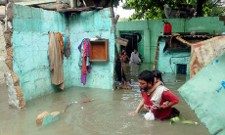
Flooding in the aftermath of a tropical cyclone in Karachi, August 2007. Pollution may increase the likelihood of such storms. Photograph: Rizwan Tabassum/AFP/Getty Images
Analysis of the intensity of storms between 1979 and 2010 suggests that thick layers of haze have created atmospheric conditions that intensify cyclones and increase the chances they will reach land.
There has been a sixfold increase in fine aerosol emissions locally since the 1930s from forest fires, domestic heating and diesel use, creating a layer of pollution 3km thick over the Indian Ocean.
It has long been known that high wind shear — a large difference between the speed of winds near the sea surface and those higher up in the atmosphere — can prevent storms from forming or prevent existing ones from intensifying. Dr Amato Evan of the University of Virginia in Charlottesville, US, and his colleagues suggest that the giant pollution cloud reduces the surface temperature of the Arabian Sea, which in turn reduces wind shear and triggers the formation of more powerful cyclones.
"We have found a clear connection between human activity and changes in atmospheric conditions that create favourable conditions for the formation of large tropical cyclones," said Evan. "In my mind that's a big step forward. Every analysis we did pointed in the same direction. We only have 30 years of data, but we have used data from multiple different sources, so I'm confident our results are robust."
Evan's team used three sets of data on the maximum wind speed of the 10 tropical cyclones that occurred in the region between 1979 and 1996 and the 10 that developed between 1997 and 2010. The median maximum speed increased from 23 metres per second in the first period to 41 mps in the second. They used numerical modelling to develop their theory and unpick the underlying causes.
The study found wind sheer had dropped from an average of 11 mps in the period 1979-96 to eight mps in 1997-2010. All the five strongest storms, which exceeded 50 mps, have occurred since 1998. In that year a major cyclone resulted in thousands of deaths and the inundation of numerous salt mines in India.
Other large cyclones since then have made landfall and caused loss of life and billions of pounds' worth of property damage in Pakistan, Iran and Oman.
"Storms that are more intense have a longer lifespan, so the probability that they are going to make landfall goes up," said Evan.
Dr Ryan Sriver of Pennsylvania State University, US, said that while the research shed "much-needed light" on the topic, the findings should be interpreted with caution. In an article published alongside the new research in the journal Nature, Sriver said: "This is a very small number of events to use as a basis for estimating climate trends."
Whale meat on sale at Icelandic airport
Up to 70,000 Britons who visit Iceland each year have been given a stiff warning by the Foreign Office not to bring home any whale meat, saying to do so is in breach of international law protecting endangered species.
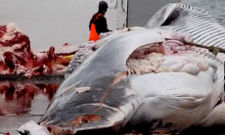
Importing whale meat into the UK or Europe is in breach of international law. Photograph: Reuters
Penalties of imprisonment or fines up to £5,000 could be meted out by the courts, says the Foreign Office, because importation into Britain and other EU countries is illegal under the Convention on International Trade of Endangered Species (Cites).
The government has added the warning to its advice on travelling to Iceland after being alerted to the fact that whale meat is on sale at Keflavik airport. Environment department Defra, responsible for border checks on illegal food imports, said: "There have been no reports of whale meat on sale in the UK or being seized at the border."
Icelandic whalers are trying to win tourists over to their point of view, offering them the chance to go to see with them, feel harpoons and eat whale meat and blubber.
New MCS research shows 31,000 raw sewage discharges in England and Wales!
Research by the Marine Conservation Society using the Environmental Information Regulations has revealed that far more raw sewage discharges exist than those hitherto known. It was previously thought there were some 22,000 discharges — the vast majority of which are known as combined sewer overflows (CSOs) and emergency overflows (EOs). However, using Environmental Information Regulations in obtaining information from the Environment Agency and water companies, the MCS have discovered that the Environment Agency uses another four terms for raw sewage discharges that are not widely understood by the public. Taking these into account, the number of raw sewage outfalls in operation in England and Wales are actually more like 31,000, instead of the usually published figure of 22,000.
CSOs and EOs are designed to act as emergency outlets for overloaded sewerage systems during periods of heavy rainfall, but can discharge at other times as well, to lakes, rivers, estuaries and coastal waters. The research shows that numerous CSOs around the UK coastline discharge well in excess of the permitted amount of ten times per annum, with one CSO discharging to the Kent coast for more than 1,000 hours during the May — September bathing water season last year.
The MCS Press Release covering the revelation can be read in full by visiting the Marine Conservation Society.
Fracking for gas did likely cause two minor earthquakes, but reserves of frackable gas are vast
Two earthquake tremors in north-west England earlier this year were probably caused by controversial operations to extract gas nearby, a report by the company responsible has concluded. The two tremors — magnitude 2.3 and 1.5 — which were felt by people just outside Blackpool, but did not cause any known damage, were reported in April and May. Since the second event, Cuadrilla Resources has stopped "fracking" operations — where water and chemicals are injected into rocks at high pressure to extract gas from the cracks.
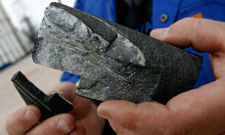
A segment of Bowland shale extracted by Cuadrilla Resouces at Singleton. A company report said it is probable the fracking caused the tremors. Photograph: Paul Thomas/Bloomberg/Getty Images
The news came as protesters against the controversial new energy source halted work at a Cuadrilla gas exploration rig at Banks, near Southport, Merseyside. Four members of the environmental campaign group Frack Off unfurled banners after climbing climbing the rig at around 5.30am on Wednesday. Others remained on the ground.
In a separate protest in London, around 50 anti-fracking activists gathered from around 3pm outside the Copthorne Tara hotel in Kensington in an attempt to disrupt an industry conference organised by by SMI international. Two dozen police kept demonstrators away from the conference on the hotel's first floor which was attended by delegates paying £1,500 per head.
The report, by a team of European seismic experts not usually employed by the company, concluded it was "highly probable" that the two main tremors and a series of aftershocks were caused by Cuadrilla's operations at the Preese Hall-1 Well in Lancashire. It said, however, that the cause was an "extremely rare" combination of factors including a pre-existing fault in the rocks, and that it was "unlikely" to occur at other sites in the Bowland Basin, where Cuadrilla is hoping to exploit an estimated 200 trillion cubic feet of shale gas. "If these factors were to combine again in the future, local geology limits seismic events to around magnitude three as a "worst-case" scenario," added a company statement.
The report, which also recommends an early warning system so the company can monitor work more carefully or even stop operations if seismic activity is felt in the future, will be sent to the Department for Energy and Climate Change and the British Geological Survey for approval before the company can resume operations at Preece Hall.
The study was criticised, however, by opponents of fracking, who called for a full investigation by the government before Cuadrilla or other companies are allowed to continue operations in the UK. "An early seismic detection system won't be enough to make local people feel safe — there should be no more fracking in Britain until the health and environmental impacts are fully understood," said Tony Bosworth, senior climate campaigner for the group Friends of the Earth.
Nick Molho, head of energy policy at WWF-UK, said: "We're extremely concerned by the way in which shale gas is being painted as a 'wonder gas' which will slash energy bills in Britain and help tackle climate change. Shale gas is still a fossil fuel, and a new dash for gas could see global temperatures skyrocket. There's also no evidence that it will have a big impact on energy bills, which have in fact been driven up in recent years by a rising gas price."
Prof Andrew C Aplin at Newcastle University said safety and pollution risks could be "handled" by good regulation, but said: "The social issue of whether the public want onshore drilling is a different matter, requiring public discussion. We should all realise that our lifestyles demand energy and that there are no easy answers to where that energy will come from."
Opinion is split over the huge and growing gas fracking industry in north America. Opponents say the industry contaminates groundwater and adds to greenhouse gas pollution from burning fossil fuels, leading to the practice being banned in some places, including France. Supporters say fracking is safe, and contributes valuable energy at a time when conventional gas and oil supplies are supposed to be running out and prices soaring.
A report into fracking by MPs, published in May, said that shale gas in the UK could improve the country's energy "self reliance" and reduce use of highly polluting coal-fired power. But said it was "unlikely" that the industry could improve energy security or lower prices, and warned that it could damage government efforts to boost renewable energy generation. "On balance", the committee recommended fracking should be allowed to go ahead so long as it was well-regulated and closely monitored.
Cuadrilla announced in September that it had "gas in-place" in its licence area in Lancashire of 200 trillion cubic feet — more than the entire UK proven gas reserves previously, and many times the British Geological Survey's previous estimate of the entire UK shale gas potential. A report commissioned by the company also estimated that the operations would create 5,600 jobs, about one-third of them in Lancashire.
Cuadrilla said groundwater in Lancashire was protected by layers of rock between the aquifers which are up to 300m deep and their operations which occur as far below as 3km underground.
A Department of Energy and Climate Change spokesman said: "Cuadrilla's geomechanical study was given to the Department of Energy and Climate Change today. The implications of this report will be reviewed very carefully — in consultation with the British Geological Survey, independent experts, and the other key regulators, [the Health and Safety Executive] and the Environment Agency — before any decision on the resumption of these hydraulic fracture operations is made."
Waveney District Council capitulates to SMP
Already having been approved by the Department of Environment, Food and Rural Affairs (DEFRA), signed off by the Environment Agency, and adopted by Suffolk Coastal District Council last week, Waveney District Council's cabinet met on Wednesday 9th November to (rather as anticipated) formally adopt the county's Shoreline Management Plan (SMP) covering the stretch of coast between Lowestoft Ness and Felixstowe. This will mean that no active intervention will come about, so abandoning Covehithe, Benacre and other large and precious areas to continuing erosion leading to their total loss.
Prior to the Waveney District Council Cabinet meeting Peter Boggis submitted a warning note to all the councillors present, pointing out that proposals in the SMP "were a minefield" and could expose Waveney DC and maybe the ratepayers of the area to a £9,000,000 fine from the EU for Environmental infraction etc., as all persons involved in a decision making process that causes damage or deterioration to a protected site are liable to infraction proceedings under the EU Habitats Directive. This risk is brought about by Waveney DC choosing to take on (under pressure from their political partners) an abuse ongoing from 1994 of the Wild Bird and Habitats Directive 92/43/EEC, a duty they have ignored at the environments and now the publics risk.
By not applying the 'Precautionary Principle to prevent Habitat Deterioration' on Natura 2000 Sites in their area the proposed SMP ensures further deterioration, prior to the establishment of mature compensatory habitat elsewhere. Such is unlawful, as their first duty should have been to prevent the situation from arising, a measure they have ignored at the environments and now the publics risk. One such complaint already exists with the EU Commission and another is being drafted due to WDC's actions, which is likely to be followed by action in the European Court.
Peter further pointed out that it cannot be sensibly said that the coastal area from Kessingland to Southwold fails to qualify as an historic natural environment, or is not of significant conservation or landscape quality interest. It is a beautiful area, only spoilt by the deterioration caused by environmental mismanagement. The proposed SMP erodes the very reason for it to be a Natura 2000 site, with most special long established flora and fauna. A similar situation exists in the Blyth Estuary. This has also been condemned to destruction by the adoption of plans based on spurious scientific presumptions and without mature compensatory habitat in place, hence abandonment is similarly unlawful.
DEFRA's approval of the statement of case is conditional upon the adoption of an action plan which ensures that "at no point habitat losses exceed habitat gains".
At present no such action plan has been adopted, and therefore the condition of the Secretary of State's approval has not been met. It is clear that the Environment Agency's Regional Habitat Creation Programme cannot provide mature replacements for all of the habitat including bittern and marsh harrier within the Special Protection Area which the SMP intends, as it will be lost over the life of the plan. Suitable sites for the establishment of the required area of mature replacement habitat previously identified by Natural England do not exist within Suffolk nor even beyond.
Both the Environment Agency and the Secretary of State have failed to address the issue of the abandonment of the lagoons comprised in the Special Areas of Conservation. That is the subject of an outstanding complaint to the European Commission, as the withdrawal of protection from European sites of nature conservation cannot be sustained as a matter of European law; the integrity of Natura 2000 requires that coastal lagoons of the type principally located on the East Anglian coast shall be protected or at the very least recreated prior to their destruction. Thus, to purposefully allow the deterioration of European nature conservation sites without mature compensatory habitat provided in advance appears to be a clear breach of European law, and one which the European Commission will most likely recognize and so take appropriate action against the UK.
Furthermore, without a valid IROPI (Imperative Reasons for Overriding Public Interest) the deterioration of the Natura 2000 sites effected by the SMP is unlawful. The IROPI that has been produced appears invalid on several grounds, the most important being that of Public benefit. An IROPI must demonstrate clear public benefit, but there is no public benefit in an SMP which encourages deterioration of Natura 2000 sites by just to allowing them to be replaced by sites elsewhere, at possibly greater cost than taking reasonable action to protect them in situ, this the UK's responsibility since 1994. Endeavouring to cover up past created environmental errors by those responsible and then adopting an unsafe SMP with its impacts would also risk of EU action. Thus, destruction of what is left has no public benefit and abandonment and relocation without a public benefit is also clearly unlawful.
Furthermore still there has been no will on the part of the SMP partners to seriously consider feasible alternatives. These have presumably been ignored because of dictatorial internal pressure to satisfy the whims of some members of the Partnership.
Finally there is one other future problem, that for future generations at Southwold. The SMP includes the planned destruction of the sea wall immediately north of the pier, causing Southwold to become an evermore exposed promontory as the coast erodes back, which will sharply increase the aggressiveness of the wave action on the Southwold sea defences, some of which are already proving to be inadequate.
The Thursday 10th November Eastern Daily Press report by Mark Boggis entitled 'Waveney shoreline management plan adopted' describes the basis of the meeting, and can be seen on the EDP24 website
EU plans for stronger regulation of offshore oil and gas activities
The European Commission has put forward draft rules to improve the safety of oil and gas activities in the EU. It has also proposed to implement a Barcelona convention protocol on offshore pollution in the Mediterranean.
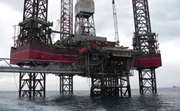
Prinos platform, Greece
The draft regulation closely resembles a text leaked to the press. It contains a number of requirements that the commission says take into account the learning from an investigation into last year's BP oil disaster. The law would extend the environmental liability directive to cover all EU marine waters, including exclusive economic zones within 370 kilometres from coastal areas. This also applies to parts of the continental shelf under member states' jurisdiction.
Operators would have to submit a "major hazard report" to national authorities, which will include a risk assessment and evidence of the installation's ability to cope with an oil leak. They would also be required to prepare an emergency response plan.
These documents, to be updated every five years, would be checked by national authorities and independently verified by a third party organisation. Member states would also be required to set penalties for offenders. The penalties should be "effective, proportionate and dissuasive", in line with rules on environmental crimes.
As reported before, no mandatory insurance would be required. But according to an EU source the commission is conducting a cost-benefit analysis on the matter, which suggests mandatory insurance may be considered at a later stage. The cost of a major accident in European waters is estimated at €205-€915m per year.
"It is essential that an uncapped compulsory insurance requirement be integrated into EU law to ensure the full financial liability of operators," marine conservation group Oceana said on Thursday. NGO Client Earth made a similar call.
An EU offshore authorities group would also be set up to encourage best practice sharing and contribute to improved safety standards. However, this falls short from what the European Parliament and environmental groups would like to see.
MEPs and NGOs want to give the European Maritime Safety Authority (EMSA) greater powers to oversee third party verifications and inspections under the new regulation. A parliament resolution states EMSA's remit should be extended to cover prevention and response to pollution caused by oil and gas offshore activities.
UK and Norway sign North Sea energy agreement
Energy ministers from Norway and the United Kingdom today signed a joint agreement to co-operate further on renewables, oil and gas and the use of technology such as carbon capture and storage, to ensure energy security and manage emissions. UK Energy Secretary Chris Huhne signed the agreement with Norwegian Minister for Petroleum and Energy Ola Borten Moe in London.
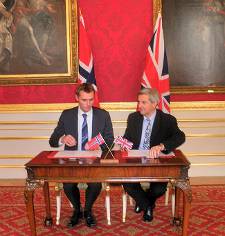
Norwegian Minister for Petroleum and Energy Ola Borten Moe and UK Energy Secretary Chris Huhne sign the joint energy agreement
Ministers affirmed their "commitment to support industry in the future development of our oil and gas resources in the North Sea using the best technology available to manage emissions, protect the environment and maximise recovery of resources". They also agreed to continue to support efforts to develop interconnection between the UK and Norway.
UK Energy Minister Charles Hendry said: "Our energy security is enhanced by close links with Scandinavia and Europe. As North Sea neighbours, the UK has long enjoyed close and beneficial ties with Norway based on the development of oil and gas. And as renewables and CCS (carbon capture and storage) develop further, it is increasingly vital that we work closely in these areas too. Today's agreement confirms the importance of Norwegian natural gas to UK energy needs as an essential part of our longer term energy security, and it boosts co-operation on CCS and the development of renewable energy and interconnection."
Shale gas reserves in Lancashire said to be "vast"
Richard Black, Environment correspondent for BBC News, reports 21st September 2011: "The total amount of gas that Cuadrilla estimates to be in the shale formation it's been exploring is huge. It's more than 10 times the reserves known to exist under the UK's part of the North Sea — more than the total known in all UK fields, in fact.
"But total gas isn't the same thing as useable gas; and how much of it can be extracted is another matter, as the company acknowledges. Before it can extract any of it, it will have to satisfy the government (and local residents, perhaps) that the process is safe, which might not be straightforward given the association that has been mooted between "fracking" and small earthquakes close to the existing exploratory wells.
"Then there is the question of whether the economics work out. If it is extractable at a good price, there is a large chance that this one field will put a major dent in the government's climate change ambitions, which depend most of all on switching electricity generation to low-carbon fuels — which shale gas most definitely is not."
BBC News also reports, 21st September 2011: "An energy firm which has been test drilling for controversial "shale gas" in Lancashire has said it has found vast gas resources underground. Cuadrilla Resources began testing for gas on the Fylde Coast in March, using a technique known as "fracking". It said it had found 200 trillion cubic feet of gas under the ground, which if recovered could provide 5,600 jobs in the UK, 1,700 of those in Lancashire.

Opponents to the process believe it produces damaging carbon emissions. A small protest, organised by Campaign Against Climate Change, was held outside The Imperial Hotel in Blackpool on Wednesday, where Cuadrilla met to announce its findings.
Fracking involves the hydraulic fracturing of the ground using high-pressure liquid containing chemicals to release the gas.
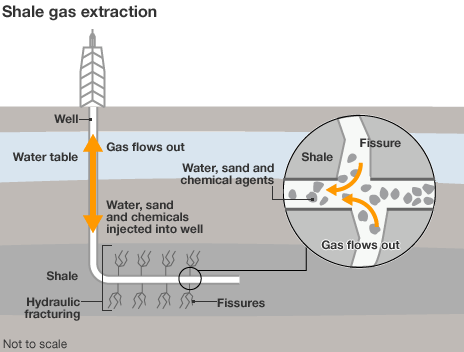
Campaigners have warned developing the fossil fuel could draw investment away from the UK's potentially huge renewable industry.
The gas is found in shale formed from deposits of mud, silt, clay and organic matter. The process has caused controversy in the US on environmental grounds, where there have been claims from some householders that the subsequent release of gas has caused illness and polluted drinking water.
In Lancashire, the tests were halted in June when two earthquakes occurred in the nearby Blackpool area. Cuadrilla said it was expecting to find out within the next 30 days whether or not its work contributed to the tremors.
Cuadrilla's chief executive, Mark Miller, said the process would not pose a threat to UK groundwater. He said the company hoped to drill up to 400 wells in Lancashire to extract some of the gas it had found under the ground in the area. Mr Miller said thousands of highly skilled jobs would be created, with posts paying an average wage of £55,000.
Cuadrilla hopes to drill as many as 400 wells over the next nine years and up to 800 over 16 years if gas extraction is successful. Mr Miller said they could be grouped in units of 10 on each football pitch-sized site, reducing their impact on the landscape. He said each well is drilled and then fracking takes place over several weeks, after which the well can potentially produce gas for up to 30 to 50 years. "When they are done right, someone driving by on a country road or walking their dog, it will be hard for them to see our sites as they will blend in with the Lancashire countryside," he said.
Phil Thornhill, from Campaign Against Climate Change, was one of those protesting outside the meeting. He said: "Those jobs could and should be in green energy. We need a revolution in the economy to really deal with climate change effectively. We need to be moving much quicker than we are to a low carbon economy, that would be a lot of jobs, a lot of development. They could create jobs in renewables if they put the investment there." A spokesman for the Department of Energy and Climate Change (DECC) said it had to ensure any operations which went ahead were properly regulated. "We welcome the news that Cuadrilla believe there to be good quantities of gas contained in the shale covered by their licence," he said. "Our priority is to ensure that their operations are properly regulated and they face the same rigorous regime that all oil and gas operators must adhere to. The shale gas industry in the UK is in its infancy, and the eventual scale of the recoverable gas from this site is still unclear, but nothing will temper the government's firm and unbending commitment to safety and environmental protection. Any development must sit with our plans for a strong portfolio of energy sources as we move to a low carbon economy, including renewables, nuclear and clean coal and gas."
Radioactive pollution from Dounreay "will never be completely cleaned up"
Radioactive contamination that leaked for more than two decades from the Dounreay nuclear plant on the north coast of Scotland will never be completely cleaned up, a Scottish government agency has admitted.
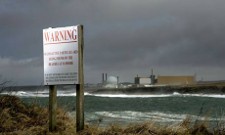
Dounreay was shut in 1993 but radioactive contamination will 'never be completely cleaned up'. Photograph: Murdo Macleod
The Scottish Environment Protection Agency (Sepa) has decided to give up on its aim of returning the seabed near the plant to a "pristine condition". To do so, it said, could cause "more harm than good". At a board meeting in Stirling, the Scottish government's environmental watchdog opted to encourage remediation "as far as is practically achievable" but to abandon any hope of removing all the radioactive pollution from the seabed.
Tens of thousands of radioactive fuel fragments escaped from the Dounreay plant between 1963 and 1984, polluting local beaches, the coastline and the seabed. Fishing has been banned within a two-kilometre radius of the plant since 1997.
The most radioactive of the particles are regarded by experts as potentially lethal if ingested. Similar in size to grains of sand, they contain caesium-137, which has a half-life of 30 years, but they can also incorporate traces of plutonium-239, which has a half-life of over 24,000 years — meaning that is the time period for half of the material to break down.
The particles are milled shards from the reprocessing of irradiated uranium and plutonium fuel from two long-defunct reactors. They are thought to have drained into the sea with discharges from cooling ponds. In 2007, Dounreay, which is now being decommissioned, pleaded guilty at Wick sheriff court to a "failure to prevent fragments of irradiated nuclear fuel being discharged into the environment". The plant's operator at the time, the UK Atomic Energy Authority, was fined £140,000.
Since 2008, over 2,300 radioactive particles have been recovered from the seabed, with 351 removed by a remotely operated underwater vehicle this summer. Since 1983, over 480 particles have also been found on three local beaches and the Dounreay foreshore.
Sepa recommended in 1998 that the seabed around Dounreay should be returned to a "pristine condition". Since then, it pointed out, the contamination had been extensively investigated and new regulations on radioactively contaminated land had come into force. "It is now widely accepted that a literal return to a pristine condition is a far from simple or even achievable concept," a Sepa spokeswoman told the Guardian. Trying to achieve it might also cause more harm than good. There is the potential that ecosystems may be destroyed on trying to get to something which does not pose a significant hazard."
An expert committee set up by Sepa warned in 2006 that disturbing the seabed could cause particles to escape and be swept ashore, putting members of the public at risk. The most radioactive particle found "could have had life-threatening consequences if it had been ingested", the committee said. Sepa's board agreed to change its policy to encourage further remediation "provided that this achieves more good than harm and accepting that at some sites it will not be practical to return the land to a pristine condition".
Dounreay, which is now managed by a consortium including the UK engineering firm Babcock, welcomed Sepa's new policy. It was still aiming to remove "the majority of the most hazardous particles, together with the removal of any other particles encountered," said the site's senior project manager, Phil Cartwright. "The best practicable environmental option, which was welcomed by the government agencies, is focused on doing more good than harm and was publicly discussed on the basis that it would never be possible to retrieve every particle."
Friends of the Earth Scotland, however, attacked the development. "Once again, we see the nuclear industry causing a problem it can't solve, and dumping the cost and consequence on the rest of us," said the environmental group's chief executive, Stan Blackley. "Nuclear power is neither safe, clean, cheap nor low-carbon and it continues to cause problems and cost the taxpayer a hidden and open-ended fortune. Let's learn from our past mistakes and consign it to a lead-lined dustbin."
Has "The Times Atlas" overstated ice loss in Greenland?
Climate scientists and polar researchers from across the world have rallied, mobilised and responded to a massively incorrect press statement by HarperCollins, the publisher of the Times Comprehensive Atlas of the World. According to HarperCollins, the atlas is "turning Greenland 'green' because the new edition has had to erase 15% of Greenland's once permanent ice cover".
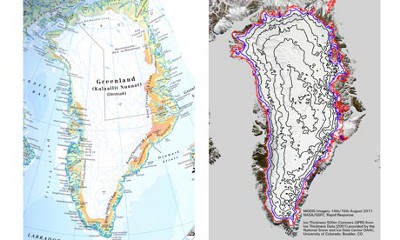
The new Times map of Greenland (left), and the satellite image from August 2011. The contours on the satellite image show ice thickness at 500-metre intervals (red — 0 metres, blue — 500 metres). In the atlas, the unit commonly used is altitude, but here, the margin of the ice sheet is outlined using the blue contour. Scientists question this definition, as a large area mapped as ice-free is clearly ice-covered. Photograph: Times Atlas/NASA/Modis
The press release quickly spread across the global news, leaving many scientists flabbergasted. How on earth could the Times Atlas obtain such high number? The Greenland Ice Sheet contains 2.9m cubic kilometres of ice — enough to raise the sea level by 7 metres if it were to melt. A 15% reduction in size would be about a 1-metre rise — enough to cause flooding over a third of the Netherlands.
Since flooding of this magnitude has not taken place in recent years, scepticism was immediate in the glaciological community. Something must have gone seriously wrong when the new map of Greenland was compared against the previous version from 1999.
What happened next is something new. Scientists from around the world quickly expressed their frustration with the questionable claim. Jeffrey Kargel from the University of Arizona wrote on the cryolist, an e-mail distribution list used by many students, researchers and academics, that "a number like 15% ice loss… is simply a killer mistake. This is not a scientific error, but it could be perceived as one."
Graham Cogley, a professor of geography at Trent University in Ontario, Canada, replied "the claims here are simply not backed up by science", and concluded "this pig can't fly".
At the Scott Polar Research Institute, seven scientists including myself issued a press statement on the University of Cambridge website explaining "a 15% decrease in permanent ice cover since the publication of the previous atlas 12 years ago is both incorrect and misleading. A sizeable portion of the area mapped as ice-free in the atlas is clearly still ice-covered."
Meanwhile, scientists from across the world continued the exchange of e-mails via the cryolist. Ted Scambos, a senior scientist at the National Snow and Ice Data Centre, said: "I'm worried that the importance of the changes that are going on will be lost on the public, because the true value of what the ice sheet has lost compared to this 15% number sounds very small."
And he is right, because the true loss of permanent ice in Greenland from 1999-2011 is about 0.1%. This sounds minuscule. Why worry?
The answer is that it is a small fraction of a very large number. The current annual loss of ice from Greenland is about 200 cubic kilometres per year. This is about 0.007% of the total ice volume, but the same as 6mm/decade in terms of sea level rise. This is a substantial number which excludes losses from other ice sheets and ice caps, and mountain glaciers, which tend to melt faster.
So we should worry about climate change and its impact, not only on the Greenland Ice Sheet, but ice masses across the world as a whole. A recent study published in Nature shows a rapid decline of glaciers and ice caps in the Canadian Arctic. In Antarctica, a number of ice shelves have collapsed, exposing glaciers to the marine environment and causing them to flow much faster than their original pace. Many readers will probably already be familiar with the continuing decline of European glaciers.
Yet in recent years, Greenland has been on the top of the list when it comes to large and sudden glacier change. The past ten years have seen record melt year after year. The margin of the ice sheet is clearly thinning. Numerous glaciers have retreated abruptly, exposing new lands and causing faster transfer of ice from ice sheet interior to the ocean. For glaciologists working in Greenland, climate change is very real.
Atlases such as the Times Comprehensive Atlas of the World can and probably will play an important role in the communication of climate change, but it is absolutely essential that the communication is based on facts and scientific evidence.
The substantial consequences of making inaccurate or exaggerated claims in the climate change debate came to light after the Intergovernmental Panel on Climate Change incorrectly stated in their last assessment report, that Himalayan glaciers could vanish before 2035. Although this mistake was not made within the actual assessment of the physical science basis of climate change, the unravelling of this mistake nonetheless lasted more than a year and was damaging not just to the IPCC, but the wider scientific community.
In the aftermath of what is often referred to as 'Himalayagate', scientists are well aware that one big error can cloud a thousand truths. This is why the science community tackled the Times Atlas mistake swiftly and effectively.
HarperCollins issued a press statement retracting the claimed magnitude of ice loss, but maintained that they stand by their maps. But to scientists, the representation of the Greenland Ice Sheet in the latest atlas, without explanatory text, will continue to be misleading.
Is there a jellyfish plague in UK seas? If so, why?
Britain's beaches are increasingly facing some unusual visitors, with research suggesting jellyfish numbers are on the increase in UK waters.

Jellyfish numbers appear to be on the rise in UK waters, research suggests. So why is the sea turning into "jellyfish soup"?
It's not only beach-goers who have to watch out. Torness nuclear power plant in Scotland recently had to shut down after moon jellyfish blocked the water intake system. Several tonnes of the creatures had to be cleared out.
Some areas, including the Irish Sea and the east coast of Scotland, have been invaded by so many they now resemble a "jellyfish soup", says the Marine Conservation Society (MCS). So why do they appear to be on the increase? According to research there is strong evidence that an increase is linked to three main factors — pollution, overfishing and possibly climate change.
Pollution such as sewage and fertilisers run off the land and into the sea, causing increased nutrients in the water. This can boost jellyfish numbers as the nutrients increase plankton which they feed on, along with fish.
Overfishing means jellyfish do not face their usual predators and competitors, which usually regulate population growth. Large fish, which eat jellyfish, have been drastically reduced by bad fishing practices, says Ocean 2012, a pressure group which campaigns to stop overfishing. So have smaller fish which compete for food with the stingers.
It is argued that climate change can cause more favourable conditions for jellyfish, with their adaptability giving them an advantage over some other sea creatures.
It is difficult to estimate the jellyfish population in UK waters because very little research has been done and in the past they were ignored in long-term fishing surveys, says Dr Victoria Hobson, from EcoJel, a project researching the distribution and abundance of jellyfish. Its current study has been running since 2008.
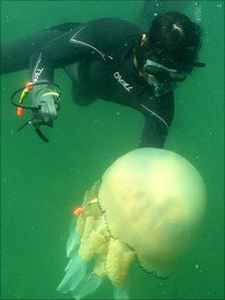
Researchers are tagging jellyfish to follow their movements
"This also makes it difficult to get a handle on how numbers have changed," she says. "Even in recent years people are doing a lot more watersports so are spotting more. With the development of smartphones it is also much easier to report those sightings. It makes it difficult to interpret if there are actually more jellyfish or just more sightings."
The MCS has been running a national jellyfish survey since 2003, where the public report sightings. Dr Richardson agrees it's probably too early to draw any firm conclusions from the data, but says a few other organisations have been doing systematic at-seas surveys over recent decades and they have shown a rise in jellyfish numbers in UK waters. "Our survey reflects that," he says. "Some of the people who have been reporting jellyfish to us say they have lived by the coast for years and never seen anything like it. This year we received our first reports of the huge but harmless barrel jellyfish off north Wales back in early January. This species has occurred in huge numbers in the Irish Sea and beyond ever since, with reports received from north Somerset to the Firth of Clyde."
There are hundreds of types of jellyfish, with a few common species in the UK. These include the moon jellyfish, which can grow to the size of a saucer, and the barrel jellyfish, which can get as big as a large household dustbin. Some do sting, but in most cases it causes just a mild rash. The occasional Portuguese man o'war has been spotted in UK waters and its sting is far more serious.
A group of jellyfish is called a "bloom". Scientists say it is difficult to measure blooms because of the sheer numbers involved and the fact jellyfish spend time at depth, as well as on the surface. But a bloom of barrel jellyfish can cover an area the size of Carmarthen Bay in Wales and numbers can run into hundreds of thousands, says Dr Hobson.
EcoJel's project involves tagging jellyfish to study their movements. Monitoring jellyfish numbers is important because they are an indication of the state of oceans. If they overtake fish and start to dominate an area — as they have off the coast of Namibia — this causes environmental and economic problems, says Dr Hobson.
In 2007 a jellyfish invasion wiped out Northern Ireland's only salmon farm, killing more than 100,000 fish. At the time a spokesman said the attack could cost the company more than £1m. They can also have an impact on tourism. In 2008 the Red Cross treated 400 people for jellyfish stings in a single day on a beach in Malaga, Spain. But one consequence to come from the growing numbers is increased sightings of leatherback sea turtles, which feed on them, in UK waters. Dr Richards says there has been an unusually high number of sighting in 2011 — six in six days recently. "That's an amazing number, it's definitely a good year for turtles."
Note: If you are interested in learning more about Jellyfish, visit the MARINET website feature on "Great British Marine Animals" www.marinet.org.uk/mreserves/marineanimals.html#cni
North Pacific and Alaska Humpback Whale population recovering from near extinction
Humpback whales of the North Pacific and Alaska have rebounded dramatically from near extinction half a century ago and now number at least 21,000 animals, according to the most comprehensive count of the species ever undertaken.

"Results confirm that the overall humpback whale population in the North Pacific has continued to increase and is now greater than some prior estimates of pre-whaling abundance," wrote the 19 co-authors from Alaska, British Columbia, Washington, Oregon, California, Mexico and Japan in a paper published this week in the journal of Marine Mammal Science.
This updated population figure is about 15 times greater than the 1,400 whales thought to remain alive in the region after the species was decimated by mid-century industrial whaling, and at least 1,000 more animals than the biologists estimated in 2008.
"We feel the numbers may even be larger since there have been across-the-board increases in known population areas and unknown areas have probably seen the same increase," said Jay Barlow, the lead author and a marine mammal biologist with the south-west Fisheries Science Centre in La Jolla, California.
Humpback whales have been listed as endangered by the United States for decades, but populations throughout the world have increased since whaling was banned in 1966. NOAA Fisheries announced in 2009 it would review the status of the species' listing under the Endangered Species Act.
Before commercial whaling, as many as 125,000 humpbacks swam the world's oceans, divided into the broad populations in the North Pacific, the North Atlantic and Southern oceans. Decades of industrial style whaling in the middle of the 20th century wiped out 90 percent of the population to about 5,000 worldwide by 1966, including the 1,400 animals in the North Pacific, according to this genetic study. Once whaling ended, the species began to rebound.
Source: AlaskaDispatch, 22nd October 2011
Note: — For further information about whales, please visit MARINET's special feature on "Whales and their Survival" in our new Planet Ocean section.
Safety concerns over cockle harvesting in Ribble estuary
The Lytham St Annes Express reports, 27th October 2011: "Reckless cocklers have diced with death in a desperate attempt to get to the rich pickings in the Lytham estuary. But the shocking disregard for their own lives may well have put a stop to the cockle harvest. For the cockle licence issuing authority has exclusively revealed to the Express that it is seeking legal advice to have the cockle beds closed on safety grounds. Around 100 cockle pickers battled for their lives in high winds on Monday night when a massive search and rescue operation was launched on the Ribble Estuary.
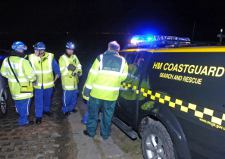
Cockle pickers are rescued from Ribble Estuary in Lytham by the coastguard and RNLI
"Ten people had to be rescued as rapidly fading light, high winds and towering waves meant around 30 boats working the cockle beds struggled to get back to shore. Distress flares were fired into the air as desperate cocklers found their fishing boats filling with icy water.
"Calls for tough action have repeatedly been made into what is a multi-agency cockling operation, following a flood of complaints. And Dr Stephen Atkins, chief executive North West of the Inshore Fisheries and Conservation Authority (IFCA), which issues the licences, said: "The problem is IFCA isn't really able to take action on safety grounds. We are there to look after stocks and the marine environment. At the end of the day, I'm not sure we can close the beds on safety grounds. But I'm getting legal advice on that to see if we can do that." He said he was reluctant, as it would hit the livelihoods of responsible cockle fishermen, after the beds opened in September following a 20-year ban.
"On Tuesday Fylde Council met police and senior IFCA officers to review recent events. IFCA will meet again in early December to review police and council evidence into the impact on the local community. Calls for greater harvesting controls will include a temporary ban, safer mechanical harvesting and daylight working only. Council Leader David Eaves said: "In the meantime we will continue to work with the police, IFCA, Coastguard and other relevant agencies to minimise the impact as best we can with the tools we have available." Dr Atkins explained that cockling off the Fylde was unusual in that: "They use boats to get out to the cockle beds. I have not experienced that before. It is a dangerous stretch of water."
"Meanwhile, powerless Fylde Council feels as though it has its hands tied as tragedy could be lurking just around the corner. Councillor Tommy Threlfall, cabinet member for the environment and partnerships, wants a meeting with Fisheries Minister Richard Benyon to press for the right to restrict the number of licences. He said: "The discussion we want with Mr Benyon will cover the issuing and policing of permits to ensure that cocklers are licensed and trained in working safely. We will ask if it is possible for the council to have an input into how many licences are issued. We will examine if it is possible to retain a proportion of licences for local fishermen who know the local conditions. We will ask if we can raise any money from cocklers to offset our costs in monitoring their activities. Another idea we would like to pursue is closing access to the beds if there are safety concerns."
Fylde chief executive Phil Woodward said: "This meeting will give us the opportunity to lobby for a longer-term change in the legislation relating to cockle harvesting, which, to be effective, meaningful and contain timely controls, should be vested in the local district council that has a greater understanding of local circumstances and the community impact of this operation and is locally accountable unlike many of these other agencies."
Duchy of Cornwall ordered to reveal oyster farm data
The Duchy of Cornwall, which comprises the Prince of Wales's business interests, has been ordered to disclose environmental data from an oyster farm.

The Prince of Wales derives his income from the Duchy of Cornwall
The decision by an information tribunal redefines the duchy, a 700-year-old private institution, as a public body, leaving it open to further challenges. The ruling came after a legal battle against the farm near Falmouth. The tribunal said the duchy had not carried out an environmental assessment of the farm.
The potentially far-reaching decision defining the duchy as a public body under environmental regulations was made by the First-Tier Tribunal on information rights, a court that deals with disputes relating to freedom of information.
Michael Bruton, co-founder of the Port Navas Quay Conservation Committee (www.preserveportnavasquay.co.uk), had asked the duchy to disclose information about the Port Navas Oyster Farm under legislation which requires public bodies to reveal their environmental record. He had challenged the cultivation of non-native oysters in the historic beds and had demanded to know what environmental assessments were made by the body that provides the Princes of Wales' income.
The area used for the oyster farm is an officially designated conservation zone which includes a protection plan for native oysters.
Mr Bruton argued that the area's conservation status required the duchy to properly assess the potential effect of introducing Pacific oysters.
In its ruling, the tribunal said: "As we understood the duchy's evidence, no Environmental Assessment of the oyster farm had been carried out." It said the duchy had been wrong to withhold information about the farm because it should be regarded as a public body with a duty to disclose environmental information.
The duchy effectively dates from the 14th Century when Edward III created a perpetual body to generate income for each heir to the throne. Its precise workings and legal arrangements are steeped in history and tradition. During the challenge, it argued that it could not be considered a public body for the purposes of environmental legislation because it was set up to provide a "private inheritance" and was an "entirely private operation". But the tribunal ruled: "In a modern day context, the duchy is carrying out the public function or service of providing an income for the undertaking of an extremely important constitutional role for the UK."
A Duchy of Cornwall spokesperson said: "The duchy is reviewing the Tribunal's reasons for reaching its conclusion with a view to establishing whether to appeal the decision."
Graham Smith of campaign group Republic, which wants the Royal Family to be subjected to the Freedom of Information Act, said: "It sets a precedent and hopefully will subject Prince Charles's business dealings to greater scrutiny. It does remind us that Prince Charles does try to have it both ways, being a public figure and, when it suits him, a private enterprise. This reminds us that what the Duchy of Cornwall does is of public interest and it is wholly appropriate that they are subject to these regulations."
EU Fisheries Commissioner suggests fish "discards" could be food for the poor
Fish from European waters will be distributed to the poor as an alternative to throwing them away at sea, the EU fisheries chief told MPs, as part of a sweeping reform of marine policy.

EU fisheries commissioner Maria Damanaki. Photograph: Olivier Hoslet/EPA
Maria Damanaki, the European commissioner for fisheries, said that as part of a proposed new deal with fishermen aimed at ending the wasteful practice of discarding edible fish at sea, lower value fish could be distributed to charities and other public organisations. Appearing before the House of Commons select committee on environment, food and rural affairs, she said: "We can use these for charitable purposes, [though] we will have to give fishermen compensation if they give fish to the poor."
Damanaki is seeking the most wide-ranging reform of the EU's common fisheries policy since it was formulated more than four decades ago. Key to the reforms will be an end to the practice of discards, by which as much as two-thirds of the catch of some species are abandoned at sea, almost all of them to die. About 1m tonnes are estimated to be thrown back each year into the North Sea alone. Discards are a by-product of the rules on fishing quotas — when fishermen exceed their allowance, or net species for which they lack a quota, they must throw the excess back.
But the commissioner faces stiff opposition from fishing groups and some member states, because forcing fishermen to land all their catch will mean lower incomes. Current practices allow fleets to discard damaged fish, or lower value species, for which they receive less money, in order to maximise their profits.
Damanaki called on consumers to urge governments, retailers and the fishing industry to abandon discards and manage the EU's fish stocks more sustainably. "We could not do this without the support of consumers," she said. "I would encourage people to make responsible choices [in the fish they eat] and keep up the pressure."
Earlier this year, hundreds of thousands of people signed a petition against discards spearheaded by Guardian food writer Hugh Fearnley-Whittingstall.
Damanaki also wants an end to subsidies paid for scrapping fishing vessels. Although about €1bn was spent on compensation for fishermen who agreed to scrap their vessels between 2007 and this year, the total capacity of the EU fleet rose by 3% a year over that period — in part because fishermen used their compensation money to invest in bigger vessels.
There is already a ready-made model for distributing excess goods from Europe to charities and people on low incomes, in the form of the food for the poor initiative, that covers agricultural products. Lower value catch that cannot be eaten could be turned into fish-meal, used as feed in fish farms. In addition, fishermen would have to receive compensation for any juvenile fish they caught, because allowing them to sell such fish would act as a perverse incentive to catch them.
A few types of fish that can survive after they are thrown back, such as small sharks, would still be allowed to be discarded, under the plans.
But Damanaki acknowledged that the levels of compensation would be difficult to set. "You have to give some money, enough [to encourage fleets] to be honest, but not too much — you want them to use selective gear [that would exclude smaller fish]."
The fisheries commission is seeking €6.7bn in budget for the next seven years, which will be used to help fishermen move out of the industry and find new ways to make a living, such as by turning their boats to leisure uses or pursuing innovative schemes such as rounding up plastic from the seas for recycling. Money will also be made available to build new infrastructure, such as cold storage facilities, to ensure fewer fish go to waste.
Damanaki's proposals are now under consideration by the European Parliament and the EU Council, and will be debated next year. If they pass without a mauling by member states, they could become law as soon as the end of next year.
New EU rules to reduce risk of oil spills
The European Union plans to crack down on oil companies, with orders to improve safety to prevent a spill like that in the Gulf of Mexico last year.
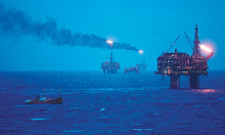
North Sea oil rigs. At least 486 UK installations will be covered by the new rules Photograph: Getty
The measures, from the European Union's energy commissioner, Guenther Oettinger, will force companies drilling in EU waters to release details of their safety procedures, place new liabilities on them in the event of an accident, and require them to prove they have the money to clean up any spills that do occur. However, the European Commission has stopped short of extending the tougher new rules to the overseas operations of EU-based companies, after pressure from oil companies and the UK government.
"Oil companies have to be fully liable," Oettinger told the Guardian. "We want to make sure that the highest standards are put in place."
At least 486 UK installations will be covered by the new rules, more than in all of the other member states combined.
The rules apply to all drilling sites within 200 miles of the coast, the first time EU regulations on oil drilling have been extended so far. Previously they were limited to 12 miles. They would cover the boundary with international waters where the legal standing of wells is unclear, and mean virtually all offshore oil drilling operations within the EU will be covered. Oil drillers will have to use a higher standard of equipment, and will have to prove they can pay for any damage they cause, either through an obligation to buy sufficient insurance or by paying into a fund — it will be left to member states to decide which one. Companies will also have to submit to independent third party auditing.
However, the Commission will not force European companies to adhere to the same standards in their overseas operations, a step some activists had called for in order to improve the sometimes woeful safety record of European oil companies in developing countries.
For instance, this year the Guardian uncovered in Nigeria evidence of oil leaks for which Shell was partly liable, amounting to a greater volume of spillage than in the Gulf accident. If the EU had extended its rules as urged, Shell would be forced to reveal details of its practices and prove it was using the same stringent safety controls it uses in the North Sea.
Oettinger said such a sweeping change was outside the scope of the current directive, and extension would be hard to formulate in legal terms as it would involve complex areas of international law. But he vowed to put pressure on companies to pursue "best practice" and to co-operate with other countries to achieve this, particularly around the Mediterranean. If European companies did not voluntarily extend their EU safety practices to other areas, he indicated, this issue could be looked at again.
The EU will stay out of rows over where drilling should be allowed to take place. At present, several companies are seeking to explore areas near the Shetland Islands and in Greenland where their wells would be in far deeper water than normal, and potentially in environmentally sensitive areas. Activists oppose these operations, warning of the dangers of leaks occurring where they are difficult to reach, and where they could damage pristine habitats. Greenpeace has mounted several protests against Cairn Energy this year in an attempt to stop its operations in Arctic waters.
The new energy directive may face a difficult ride through the rest of the legislative process, as the UK government is known to be wary of some of the plans. If it is accepted, it could be in force by the end of next year. The Department of Energy and Climate Change said: "Today the UK has a robust, proven national regime with decades of experience in regulating the offshore industry. The lessons of Piper Alpha led to a dramatic improvement in the regulatory system in the UK and more generally in Europe. We know that the commission is considering proposals which might result in a greater regulatory burden on the UK industry. We will continue to work with the commission towards a pragmatic approach which does not reduce the standards of the very robust regulatory system which we already have here."
The proposed new rules were a direct response to the explosion last spring at BP's Deepwater Horizon drilling rig in the Gulf of Mexico, which killed 11 people and caused the biggest offshore oil spill in US history, wreaking devastation over a wide area.
UK scraps key "carbon capture and storage" project
The British government has cancelled plans to fund a carbon capture and storage (CCS) demonstration project at Longannet in Scotland, signalling the technology remains too costly and undermining Britain's ambition to become a clean technology leader.
"A decision has been made not to proceed with Longannet but to pursue other projects with the 1 billion pounds ($1.5 billion) funding made available by the government," the Department of Energy and Climate Change (DECC) said in a statement.
CCS is still a commercially unproven technology but is widely seen as a key mechanism to fight climate change by trapping and burying greenhouse gas emissions, while maintaining stable energy supply.
The government said it plans to use the money to fund other CCS projects following the launch of a new bidding process in England and Scotland. Ministers will meet industry leaders in a forum on 2nd November to discuss further steps, DECC said.
"At a time when North Sea revenues are coming in at record levels, it was surely not too much to expect that the Treasury would make the necessary funding commitment for Longannet to go forward," said Scotland's First Minister Alex Salmond, who supported the Longannet CCS project. The cost would have been less than a tenth of this year's alone estimated North Sea revenues of 13.4 billion pounds."
A source close to the talks between Longannet developer Scottish Power, owned by Spain's Iberdrola, and the government said two weeks ago the two parties were unable to agree on how much up-front funding the government should provide, stalling negotiations. The Longannet coal-fired power station has a capacity of 2,400 megawatt (MW) and is Britain's second-largest coal-fired power plant behind Drax's 3,900 MW power station in Yorkshire.
"This announcement is very frustrating and damaging for the credibility of the UK CCS demonstration program," said Nick Molho, head of energy policy at WWF-UK.
The UK plans to become a world leader in clean energy technology, and CCS is central to plans to reduce carbon emissions. But tough government spending cuts to curb sovereign debt have made it difficult for the state to commit huge sums of state money to new technologies.
UK calls for Iceland and the Faroe Islands to reduce their mackerel quotas
The Guardian reports, 21st October 2011: "The UK has won backing from Ireland in its call for Iceland and the Faroe Islands to reduce the quotas they unilaterally awarded themselves for mackerel in the North Sea, or face sanctions, to ensure the stocks are fished fairly.
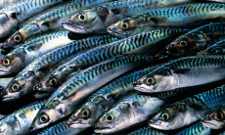
The UK has called for Iceland and the Faroe Islands to reduce their mackerel quotas. Photograph: H Taillard/Corbis
"Richard Benyon, UK Fisheries Minister, has said he wants to reach agreement with Iceland and the Faroese on managing mackerel stocks, but warned that if they continued to fish at the same level they were doing this year, the fishery could be in danger by 2014.
"Mackerel is vitally important to the Scottish fleet in particular, and it's not right that they should lose out when they have played by the rules. We had a very constructive meeting with the Irish delegation, who feel the same as we do that if Iceland and the Faroe Islands don't stop taking more than their fair share then the sanctions proposed by the Commission must be considered as soon as possible."
UK pressure forces EU to abandon automatic fish quota reductions
The Guardian reports, 21st October 2001: "The European Commission has dropped proposals that would have seen an automatic cut in fish quotas where there is not enough information about stock levels.
The UK had opposed the plans for a 25% reduction in quotas for stocks which were lacking in data, as part of efforts to make the EU's fisheries more sustainable, because officials said they were not based on science.
The proposals could have hit important UK fisheries including Rockall cod, Irish Sea herring, haddock and plaice, and West of Scotland whiting and pollock.
The Commission also said quotas would not automatically revert to the same level as the previous year for stocks without sufficient data, but each would be assessed on a case-by-case basis.
UK fisheries minister, Richard Benyon, said he was glad to see some "realism" in the decisions being made at today's EU Agriculture and Fisheries Council in Luxembourg.
Speaking on the ditching of proposals for an automatic cut to stocks without sufficient data, Benyon said: "Just because the data on a stock doesn't give the full picture, that doesn't mean slashing the amount which you're allowed to catch by a quarter is the right response. The UK fully supports the Commission's ambitions to ensure that fish stocks are sustainable in the long term. But we can't support proposals which have no basis in science and could risk increasing discards from otherwise healthy stocks."
Cuts to quotas could mean fishermen may be forced to throw overboard fish they caught from stocks which may well be healthy — because they did not have the quota to cover the catch.
MARINET comments: This is a serious climb down by the EU Commission on its draft CFP Reform proposals. The proposal for a 25% automatic cut in the annual catch quota for stocks where there is no scientific data was made by the EU Commission because currently decisions as to what is a sustainable yield from these stocks are being made "blind" i.e. on the basis of no scientific data about the size of the stock or its reproductive status. Member states are required by the EU Commission to inform the Commission of the biological status of each of the various fish stocks within their area, thus enabling a scientific decision to be made about what is a sustainable level of fishing. However, the EU Commission has stated [Fishing Opportunities COM(2011) 298 final] that it lacks such scientific advice from member countries in around two-thirds of all fish stocks (ref. COM(2011) 298 final, Section 4.1) and that member states are failing in this obligation to submit scientific data.
Given this reality, MARINET has in fact recommended to the EU Commission that in the case of fish stocks where no such data exists — because member states are witholding this information or are not prepared to meet their responsibilities to undertake proper scientific assessment — the EU Commission should close the fishery and issue no annual catch quotas at all for the stock until the member state supplies the necessary scientific data to enable a sustainable fish catch quota to be determined. This is the "precautionary principle" in action (a legal requirement under EU and international law) and is the only sensible means to ensure that the historic saga of over-fishing and all its attendant adverse consequences are brought to an end.
MARINET believes that it is wholly disingenuous of the UK government to assert that the EU Commission's limited CFP Reform proposal — the 25% quota cut for stocks with no scientific data — is an action that has "no basis in science". This assertion is absurd. The truth is that the UK government is concealing the scientific data or failing to collect it for many of its own fish stocks, and is thus the real party at fault. It is the UK government who is insisting on the CFP being run on unsustainable principles — indeed, illegal principles because the precautionary principle (the need to take preventative action when no scientific data exists in cases where reasonable concern exists that damage may be caused) mandates that fisheries be closed or restricted in such circumstances — and it is therefore the UK government which is subverting the true aspirations for effective CFP reform. It is also very regrettable that the EU Commission has climbed down under pressure, and thus become a party to this illegality.
For CFP Reform to genuinely mean something and to pursue policies which will restore health to our seas and fisheries, this decision has to be revisited and reversed by both the UK government and the EU Commission. The credibility of the CFP Reform process is currently in serious jeopardy.
Boost for North Norfolk Fisheries?
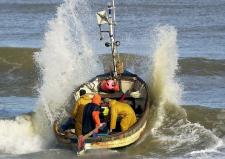
Cromer crab fishermen heading out
Under the heading 'North Norfolk fishing industry hopes for £2.4m investment' Lucy Clapham wrote in the North Norfolk News of 24th October of the possibility of £2.4m of European funding to boost its fishing heritage, in a bid to keep the dying industry afloat and support its dwindling work force.
Environmental chiefs in Brussels are currently considering this bid, which if granted is hoped to provide a sustainable future for fishermen along the 66 mile coastal stretch from Brancaster to Hemsby, and inshore businesses linked to the traditional trade. A detailed plan has been submitted by the North Norfolk's Fisheries Local Action Group (FLAG) with a proposal to the European Fisheries Fund, showing how it would spend the cash on areas that include infrastructure, marketing, education and getting EU protection for the famous Cromer crab and to create a fisheries training school.
Suffolk CC adopt the SMP
As part of an article by Craig Robinson in the East Anglian Daily Times of 1st November entitled 'Suffolk Coastal: Council agrees to launch formal consultation on car parking shake-up' Craig Robinson reported that members of Suffolk Coastal Council agreed to adopt the Shoreline Management Plan (SMP), which claims to outline how flood and erosion risk should be tackled along the Suffolk coast.
The councillors decided to restrict discussion to just those parts of the plan that affected their district and not neighbouring Waveney, which is set to look at the proposals next week. Following assurances that the SMP was not set in stone and that it would be subject to regular reviews to allow flexibility for unforeseen circumstances, the plan was adopted for the Suffolk Coastal part of the shoreline.
Would MCZ RAs boost tourism?
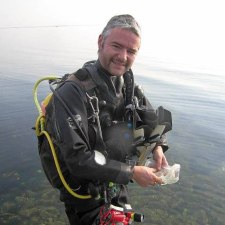
Marine conservationist Rob Spray
Following the attack on the NET Gain MCZ RA's by some fishermen and coastal councillors as earlier placed on our website, a leading marine conservationist, Rob Spray, has responded by staunchly defending the proposed 'no-go' conservation areas along the Norfolk coastline claiming they are tiny and likely to boost tourism.
The Eastern Daily Press published an item by reporter Alex Hurrell entitled 'Leading marine conservationist says Norfolk no-go areas could boost tourism' on Tuesday, 1st November, 2011.
Diver and photographer Rob Spray, a volunteer with the Marine Conservation Society, dismissed as "absurd" claims that the stretches, known as Reference Areas (RAs), could have a devastating impact on the local economy because human activity would either be banned or strictly controlled within them so that they could return to a natural state. He pointed out that the six RAs recommended for Norfolk are "ridiculously small" and would definitely not interfere with activities such as seal boat-trips. He believes that if the RAs were established, they would actually boost the tourism economy by enhancing Norfolk's reputation as an unspoilt place of natural beauty.
He voiced his views ahead of an invitees-only meeting (to which MARINET was not invited) called by Blakeney Parish Council to discuss two of the RAs which affect Blakeney and neighbouring Morston. Some of the representatives from coastline user groups and other interested parties have been asked to attend, along with officers from Natural England, one of the key organisations involved in the government Marine Conservation Zone (MCZ) Project.
He said that the concerns expressed were "completely unfounded" adding "The areas are small. They are not where people arrange commercial trips from and they are not where people go to watch seals. They allow nature to re-establish itself and show how habitats would appear if there was no human influence. One of the key attractions is the coastline and its wildlife and these areas will enhance that. I would hope that people would appreciate that these areas are special and want them saved. Humans don't have a great track record in looking after natural resources — witness the collapse of the North Sea fisheries."
He considers the recommended RAs to be disappointingly small — ranging from 0.04sq km within Norfolk Wildlife Trust's Cley Marshes Reserve to one sq km of salt marsh between Morston and Blakeney — but said they were the "first real step into conservation" adding "For the past two or three years the income of New Zealand's Goat Island marine reserve had been measured at $1 million per km and restrictions there were seen as a tourism benefit."
OSPAR countries agree carbon capture and storage measures
At its meeting on 26th October 2011, the strategic Co-ordination Group of the OSPAR Commission (www.ospar.org) welcomed further progress towards the legal storage of carbon dioxide in subsea geological formations.
Amendments to the OSPAR Convention for this purpose, agreed in 2007, have been ratified and entered into force for those Contracting Parties to the OSPAR Convention which have ratified (Norway, Germany, United Kingdom, Spain, European Union, Luxembourg and Denmark) on 23rd July 2011. The amendments also entered into force for The Netherlands and additional Contracting Parties to the OSPAR Convention will continue the process of ratification, acceptance or approval through their official national channels.
Following up the conclusions and recommendations of the Quality Status Report 2010, the OSPAR Commission is giving further consideration to how to take forward the development of monitoring and assessment capacities for climate change and ocean acidification at the regional scale, including tools to assess the rate of change.
BBC "Frozen Planet" in pictures
Please visit the following address to see a series of exceptional photographs from the BBC series, The Frozen Planet, on life in the Arctic and Antarctica.
Can US law and the Endangered Species Act protect the polar bear?
The US government has not broken its obligation to protect the polar bear by failing to cut greenhouse gas emissions, a federal judge has ruled.
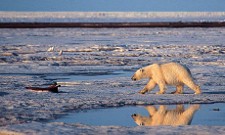
Polar bears' primary habitat is shrinking as the Arctic ice melts. Photograph: Subhankar Banerjee/AP
The suit, brought by environment organisations — including Greenpeace, the Centre for Biological Diversity, the Natural Defence Council and Defenders of Wildlife — hoped to use the Endangered Species Act (ESA) to force the Obama administration to act on emissions.
In 2008, the Bush administration listed the polar bear as an endangered species under the act, ruling it was at risk from melting ice caused by climate change.
For a long time the US government refused to see a link between climate change and threat to polar bears. Even when listing the bears as endangered, the former US secretary of the interior, Dirk Kempthorne, said: "While the legal standards under the ESA compel me to list the polar bear as threatened, I want to make clear that this listing will not stop global climate change or prevent any sea ice from melting. Any real solution requires action by all major economies for it to be effective. That is why I am taking administrative and regulatory action to make certain the ESA isn't abused to make global warming policies."
Despite Kempthorne's comments, under the ESA, the government is legally obliged to create a plan to protect the species. Green groups argue that this means the US government has a duty to force industry to cut its emissions.
A variety of oil industry and business groups, along with the governor of Alaska, opposed that stance, saying it would be impossible to draw a scientific link between, for instance, a new coal power plant in the US and the ice melting in Alaska.
However, the court decided on Monday that the government had met its obligations. US district judge Emmet G. Sullivan concluded that federal officials were within their authority in a rule allowing "incidental" harm to polar bears that might occur in the Arctic as a result of oil and gas activities.
"The question at the heart of this litigation — whether ESA is an effective or appropriate tool to address the threat of climate change — is not a question that this court can decide based upon its own independent assessment, particularly in the abstract," the judge wrote.
But he also found that the US government erred in not undertaking an environmental impact statement before it listed polar bears in 2008. The judge has asked the Interior Department to undertake an environmental review — it has until 17th November to do so.
Nobody knows the exact number of polar bears. While the population is estimated to be about 25,000 at the most, observations by biologists show a decline.
Conservationists said they were confident a new environmental review would show that global warming needs to be addressed in order to hasten the polar bear's recovery.
"The polar bear was the first species added to endangered species list solely because of threats to the species from global warming. The ruling does not limit the applicability of the ESA to greenhouse gas emissions affecting species listed as endangered under the act, or to other threatened species for which Interior has not issued a specific exemption," the plaintiffs noted in a statement.
The court's decision was "bittersweet", one said.
Atlantic Bluefin tuna being harvested at twice the official quota level
The amount of Atlantic bluefin tuna traded on the global market last year was more than double the quota set for the endangered fish, conservationists have warned.
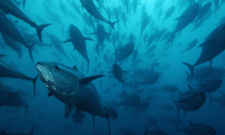
Bluefin tuna. Analysis shows the amount traded on the market was 141% higher than the limits set. Photograph: Brian J. Skerry/Getty Images/National Geographic
The Pew Environment Group said that after a decade of heavy overfishing of the tuna in the Mediterranean, the body governing the fishery took action in 2008 to impose much lower quotas on catches in a bid to conserve the fish.
But analysis by Pew revealed that while the quota in 2010 was within the recommendations made by scientists for the first time, the amount traded on the market was 141% higher than the limits set.
The figure does not include black market sales of Atlantic bluefin tuna, which would push up the total catch of the fish even higher, Pew warned.
The total quota set by the International Commission for the Conservation of Atlantic Tuna (ICCAT) between 1998 and 2010 was 378,698 tonnes, while the official catch reported by the body was 395,554 in that time. But Pew estimates that the amount traded, excluding on the black market, was more than 490,000 tonnes — an extra catch of almost 100,000 tonnes which had a market value of €2bn (£1.8bn).
The report said that since 2008, legal and illegal catch of bluefin tuna, which is a sushi delicacy in Japan, had significantly dropped due to lower quotas which have been brought down from 29,082 tonnes that year to 13,525 tonnes in 2010.
Other measures brought in include a paper-based documentation system to more accurately track the amount of bluefin tuna caught and traded, plans for a reduction in the fleet's capacity, a ban on using planes over the Mediterranean to spot the fish and a shortened fishing season.
But Pew Environment Group warned the fishery "cannot be considered a success story" because a number of loopholes still existed, including the continued under-reporting of tuna being caught and transferred to "ranches" where they are fattened for market, the use of prohibited drift nets and illegal trading.
And the gap between the quota and what was actually being traded is growing, up from 31% above the permitted level in 2008 to more than double the quota in 2009 and 2010. Last year 141% more tuna was traded, the report found. If overfishing continues at the same rate, based on stock levels analysed by ICCAT, the species has just a 24% chance of recovering by the target year of 2022, Pew said.
The environmental group is calling on ICCAT to take immediate action at their next annual meeting in November, in particular bringing in an electronic documentation system to better track catches and trading. Lee Crockett, from Pew, said: "The paper-based catch documentation of the bluefin trade is rife with fraud and misinformation. An electronic system would provide more accurate information that can be easily shared and cross-checked instantly. Such a programme should also include a physical bar code for each bluefin, which could be easily administered and not be cost-prohibitive. This would allow the fish to be tracked from sea to plate."
Last year, efforts to list the fish as endangered under the Convention on International Trade in Endangered Species, temporarily stopping the trade in the species, failed, leaving the management of Atlantic bluefin tuna in the hands of ICCAT.
Highly radioactive metal found at Dalgety Bay in Fife, Scotland
Highly radioactive material found on a Fife beach is giving "cause for concern", according to environmental watchdogs. The Scottish Environment Protection Agency found the lump of contaminated metal at Dalgety Bay beach, Fife.
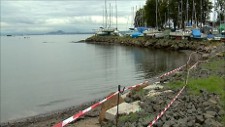
Dalgety Bay
Radium from wartime aircraft is thought to have been in landfill used when the foreshore was reclaimed. The material was 10-times more radioactive than any material found at the site previously. The discovery was made during work to trace the radioactive source, which is due to be completed over the next two weeks.
A specialist team removed the material from the beach and took it to a lab for testing on Wednesday. Warning signs have been put in place and the beach cordoned off. The metal has been contaminated with radium and is now being tested before the environmental watchdog can be certain about the threat it poses to public health.
Dr Paul Dale, Scottish Environmental Protection Agency (SEPA) radioactive substances specialist, told the BBC Scotland news website: "When the detector has an increased count rate you start moving the sand away to see if it gets stronger and on this occasion it gave me cause for concern because it went off the scale. We covered the tidal area with bricks and a specialist team removed the material using protective equipment and put it into a specialist container which has lots of shielding."
He added: "We have been monitoring the area in a bid to find the origin of radioactive material that we have been finding at the beach and this was when we found this lump of what looked like melted metal."
The council has been asked to erect signs warning people not to go onto the beach.
Scottish Environment Secretary, Richard Lochhead, said he would be writing to the secretary of state for defence, urging action to address the situation. He said: "We absolutely must get to the root cause of this repeated contamination of Dalgety Bay, and I want to reassure the local community that we will do everything in our power to prevent, once and for all, any radioactive sources being a significant hazard to the public."
Dalgety Bay was the site of a World War II airfield, where many aircraft were dismantled. The dials in the planes were coated with radioactive radium so that they could be read at night. It is thought the dials were incinerated along with other waste and later tipped on the land and used to help reclaim some of the coastline.
Numerous surveys have been carried out on the beach since radiation was first discovered in 1990.
The shore at Dalgety Bay has been cordoned off for further investigations
"Whale war" kicks off in the Antarctic Ocean
John Vidal, The Guardian, 18th October 2011, reports: "As the Sea Shepherd vessel, Steve Irwin, approached the equator word that Japan would be sending a strengthened whaling fleet to Antarctica next month reached the bridge of the old Aberdeen-built customs vessel. The crew of activists on board cheered, as their veteran leader, Captain Paul Watson resigned himself to his eighth "whale war" among the icebergs and 100mph winds of the Southern ocean.
"Watson, on what is nearly his 350th voyage in nearly 40 years defending whales and other marine wildlife at the helm of Sea Shepherd Conservation Society, is sending three ships to intercept, chase and harass the Japanese. He promises "aggressive non-violence", while the Japanese, still smarting from last year's humiliation when their fleet took only a fifth of its planned whale catch, say they will heighten security and take an armed government fisheries patrol vessel.
"We intend to carry out the [whale] research after enhancing measures to assure that the fleet is not obstructed," said fisheries minister, Michihiko Kano.
The two fleets expect to meet in the Antarctic whale sanctuary before Christmas and will shadow and confront each other for at least 12 weeks. Both have helicopters and water cannon. In addition, the Steve Irwin has iron spikes to prevent the Japanese from boarding, and Watson's crew has a store of vile-smelling butyric acid stink bombs to fling aboard any vessel that comes close. Both fleets are expected to wage a media and diplomatic battle, as well as engage in a dangerous physical tussle on the high seas.
But it was Australia, which fired the first diplomatic shots, this week condemning Japan and urging it not to send its fleet. "There is widespread concern in the international community at Japan's whaling programme and widespread calls for it to cease", said foreign minister, Kevin Rudd, this week. Australia last year took Japan to the international court of justice seeking an end to the harpooning which it conducts under a "scientific" loophole.
Few people realise, said Watson in London before setting off for the Antarctic, how dirty this old-fashioned sea war can get, with hand-to-hand combat, collisions, bombardments and sinkings. "Some of the scenes look like out of world war two. There are a lot of ships at sea, seven or eight at a time, water cannons going… We get help finding them [the whaling vessels]. Tourist ships and fishing boats, research stations give us their co-ordinates."
Although he is on Interpol's wanted list and is classed as an eco-terrorist in Japan, Watson says he has been on the side of the law since he was first mate on the first Greenpeace voyages of the early 1970s. "We don't protest, we intervene. We are not there to witness but to stop crimes being committed," he says. "They call me a pirate but what is a pirate? Drake and Raleigh were pirates. John Paul Jones, who started the US and the Russian navies, was a pirate. Pirates challenge the status quo."
Watson, for years little known in Europe, has recently become a star of Discovery Channel reality TV programme Whale Wars. Although the show has been criticised for being more show business than documentary, the TV exposure has tripled the group's membership and income.
But Watson has his critics. He was savagely satirised in the South Park animation "Whale Whores" for being media-hungry, and a long-standing row with Greenpeace has resulted in the two organisations not talking to each other.
"[Greenpeace's international executive director Kumi Naidoo] should be running the Red Cross. He's not an environmentalist. He's an anti-apartheid organiser who has stated that the only way to save the planet is through alleviating world poverty. It can't be done. There are just not enough resources. Why does he want to do the job of Oxfam or the Red Cross? Greenpeace seems to have lost their direction," says Watson.
Watson is a confirmed "biocentrist" who believes worms and cockroaches are more important than humans. "I say look at earth as a spaceship travelling at 500km a second. Our life support system is the biosphere. It provides the air and temperature, and it's run by a crew, not us. We are just passengers, busy entertaining ourselves, but the crew are the bacteria, the worms and the fish we are killing off. There's only so many crew we can kill before things fall apart. They are more important than we are. If the fish die the ocean dies and if the ocean dies we die. We cannot live without them. I measure intelligence by the ability to live in harmony with the natural world and by that criteria cockroaches are more intelligent than we are."
Too many humans, he says, is by far the greatest problem facing earth. "Earth can probably only carry one billion humans. As long as human populations continue growing, the battle [to save the planet] will be lost.
"One of two things will happen. Some incredibly imaginative, intelligent person will come along or planet Earth will take care of it for us. The reason we had great age of affluence is we had four continents to exploit. But we have now far exceeded earth's carrying capacity which is why we're in the middle of this major extinction. There will inevitably be a resource crash, but we are in denial about it."
There's a waiting list of thousands from dozens of countries wanting to sail with Watson, who prides himself on never having caused or sustained an injury in his 34 years of taking amateurs to sea in often dangerous situations.
"Because our crew are amateurs and not professional there's much more precaution taken in everything we do. Sometimes professionals get themselves into trouble because they take things for granted. Passion is the most important thing."
SMP denies self-help for threatened Suffolk village
The historic church at Covehithe is continuing to lose it's battle with the North Sea

The threatened historic church at Covehithe
An article by Craig Robinson entitled 'Covehithe: Landowner raises fears over coastal defence proposals' appeared in the East Anglian Daily Times on Saturday, October 29th.
It tells how the tiny Suffolk hamlet of Covehithe now faces abandonment to the sea as the residents are now being prevented from proceeding with their self-funded DIY coastal defence scheme imposed by the dictates of the Shoreline Management Plan (SMP) that both Suffolk Coastal District Council's cabinet and Waveney District Council's cabinet will be asked to formally adopt this week — and it is feared that they may do just this.
The SMP recommends a policy of 'no active intervention' for the next century at Covehithe, which would mean that within 30 to 40 years the entire hamlet, including homes, a 14th century historic church and important conservation areas will be lost, along with 390 hectares of vitally important and protected countryside. This latter appears contrary to EU law because it is being abandoned with no public benefit and with no decided provision for relocation of habitat. It was merely given as a suggestion by the Environment Agency (EA) that alternative sites for areas of internationally designated habitat could be given while investing in further research to record valuable information before it is completely gone.
The residents have been told by the EA that they would be prevented from funding their our own defences similar to those further down the coast at Dunwich and Thorpeness, which, if adopted should stop the current erosion of 18 acres of land every year. If this is not invoked it would mean the total loss of the entire village by at least 2055. The 'reason' given for refusal of defences by the EA was given as the impact on the sediment shift from Southwold beach. But that 'opinion' was made without modelling or independent peer-review, and further is contrary to a previous opinion.
A spokesman for Suffolk Coastal and Waveney district councils said that no formal proposal for sea defences had ever been submitted for consideration, so it was wrong to say anything had been rejected. "The SMP has been approved by DEFRA and the Environment Agency, and we have taken legal advice while drawing up the plan and before sending it off for approval, and our view is that it is legally sound," was stated.
BP prepares oil-spill contingency plan for for North Uist prospecting area
BP has drawn up a contingency plan to tackle an oil spill off the coast Shetland Islands, which has the potential to be bigger than its Deepwater Horizon disaster. The oil giant has revealed its "worst case scenario" emergency plan before it starts drilling in the North Uist oil-prospecting area, 80 miles north-west of the islands next year, once it has been approved.
The worst-case scenario drawn up by BP sees the leak coming from the well some 1300m below the surface of the sea.
The company documents show that a potential spill from a sea-floor oil gusher would leak 75,000 barrels of crude oil a day for 140 days -a total of 10.5 million barrels — before it could be capped. This would be more than double the Gulf of Mexico oil spill, which had a maximum of 62,000 barrels a day and lasted for 88 days.
The April 2010 oil rig explosion of BP's Deepwater Horizon rig killed 11 workers and left 4.9 million barrels of oil spewing out into the Gulf of Mexico.
"As part of our North Sea exploration programme, BP is planning to explore the North Uist prospect in the deep water West of Shetland in the first quarter of 2012," said a spokesman for BP. BP has been exploring successfully West of Shetland since the 1970s and producing there safely for over 15 years. BP will be using the 'state-of-the-art' Stena Carron drill-ship, which has experience of deep water drilling West of Shetland. Key lessons from the Deepwater Horizon incident have been incorporated into the overall planning for this well."
Oil companies are now required to submit contingency plans to the government ahead of any new drilling operations.
"This is a worst case scenario, but it is a realistic scenario. So this could happen," said Dr Richard Dixon, from WWF Scotland. If things went wrong in the same way they went wrong in the Deepwater Horizon disaster, and the measures that BP tried to put in place didn't work very well, we could have 140 days worth of very significant oil spill," Dixon added.
All fish sold by McDonald's UK restaurants now have MSC "sustainable fishery" label
All fish products served in McDonald's UK restaurants will carry the official Marine Stewardship Council (MSC) ecolabel. The blue logo printed on the packaging of the Filet-O-Fish and Fish Fingers items represents the company's ongoing commitment to sustainable sourcing and shows that all fish used by McDonald's UK is fully traceable from sea to restaurant.
McDonald's UK has been using sustainably sourced fish in all of its fish products since 2001, but the MSC certification logo is now being added to recognise that its entire supply chain is formally certified against the MSC Chain of Custody traceability standard — McDonald's is the first company in its sector to introduce MSC certified white fish throughout Europe.
Over 50% of the world's marine fish stocks are fully exploited. The MSC is an independent global organisation set up to promote solutions to the problem of overfishing by recognising and rewarding well managed and sustainable fisheries through its certification and eco-labelling programme.
Last year, McDonald's sold approximately 18 million Filet-O-Fish and eight million Fish Finger portions in the UK alone. Both products use Hoki — a white fish, sourced from fisheries in the Southern Hemisphere.
Jill McDonald, chief executive McDonald's UK said: "McDonald's has long been a champion of sustainable fishing and with our restaurants serving nearly three million customers each day we're delighted that our commitment to environmental standards will help us keep fish on the McDonald's menu for generations to come."
Rupert Howes, CEO of the Marine Stewardship Council, said: "We are delighted to see that the first MSC labelled Filet-O-Fish have been launched in McDonald's UK restaurants this month. McDonald's Europe's decision to source white fish products exclusively from fisheries that have met the rigorous MSC standard for sustainability is a tremendous testament to the ability of our industry leaders to transform the seafood market and help drive changes on the water. We're delighted all of McDonald's Filet-O-Fish in Europe will be MSC certified and McDonald's is making sustainable fish so widely available."
Achieving the MSC traceability standard is the latest landmark in McDonald's drive for improved quality and sustainability in its agricultural supply chain. McDonald's UK also only use free-range eggs, 100% British and Irish beef, and The Rainforest Alliance and Utz Certified logo appeared on the 95 million cups of coffee served in their UK restaurants last year.
Deep-sea fisheries require careful management to be sustainable, says IUCN
During a meeting held recently at the United Nations in New York, the International Union for the Conservation of Nature (IUCN) and The Nature Conservancy (TNC) provided information on policy recommendations on how to improve the management of deep-sea fisheries and ecosystems. The recommendations were developed following a workshop jointly organized by TNC and IUCN.
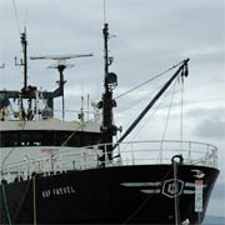
Trawler, Hobart harbour, Australia (Photo: Imène Meliane)
Whilst acknowledging that considerable progress has been made by States and Regional Fisheries Management Organisations (RFMOs) on deep sea fisheries management, including areas closures and the creation of new regional management structures, full implementation of existing agreements and greater compliance still needs to be ensured.
To overcome some of the challenges faced by States and RFMOs in complying with existing agreements, the participants' recommendations included: greater sharing of deep-sea fisheries data, better guidance on undertaking risk assessments, elimination of subsidies that generate overcapacity, and tighter thresholds to minimise bycatch and protect key ecosystems.
Fishing is often undertaken without proper catch limits and enforcement of obligations. Deep-sea fishing in the high seas is carried out by relatively few vessels from a small number of countries and contributes only marginally to global marine capture fisheries. However, this deep-sea fishery, if not properly managed, has the potential to decimate unique species and ecosystems that the international community has only just started to discover. Ensuring the sustainability of deep sea fisheries is still feasible, and would only require a fraction of the efforts needed to fix other fisheries. It simply requires a strong political will.
"It is urgent to deal with fisheries subsidies. States should urgently put in place regulations to remove all incentives that result in excess capacity of fishing fleets, ineffective distortions of socio-economic systems, and economic policies that exacerbate threats to the sustainability of deep water resources", said Harlan Cohen of IUCN's Global Marine Programme. "Where there is no management, there should be no fishing".
While deep sea fisheries face challenges related to the lack of knowledge about deep sea species and ecosystems, many of the management issues actually relate to a lack of implementation of general fishery governance and management principles. "Fishing should not be allowed in areas where data are not collected or shared", said Imène Meliane, Director of International Marine Policy at the Nature Conservancy.
"An international programme to contribute fisheries-related data and information to a common database would greatly assist States and Fisheries organizations in the identification and location of vulnerable marine ecosystems," said Carmen Revenga, leader of the sustainable fisheries strategy at The Nature Conservancy.
Long-line fishing causes huge seabird losses
Research presented at the World Conference on Marine Biodiversity in Aberdeen (27th September 2011) has provided a global estimate of the impact of long-line fisheries on seabirds and reveals that, despite efforts to reduce seabird deaths, upwards of 300,000 birds are still being killed every year.
The study, recently published in the journal Endangered Species Research, was carried out by scientists from the RSPB and BirdLife International and is a powerful reminder of how far we still need to go to ensure ecologically responsible fishing.
Since the 1980s, scientists have linked global declines of albatrosses and other seabirds with 'incidental catch' in long-line fisheries. Adult and juvenile birds become snared on hooks attached to the lines, which can be over a hundred kilometres long, and are dragged underwater to a premature death.
Presenting the research is Dr Orea Anderson, policy officer for the Global Seabird Programme and lead author of this study: "It is little wonder that so many of the affected seabird species are threatened with extinction — their slow rate of reproduction is simply incapable of compensating for losses on the scale this study has demonstrated. A major factor determining this huge estimate is the emergence of fleets, with previously unaccounted for bycatch problems, adding to the global tally. While some fisheries have reduced their impacts on seabirds, we are only just becoming aware of problems in others — hampered by a lack of data."
The Spanish long-line fleet on the Gran Sol grounds off SW Ireland is one such fleet, with preliminary data suggesting it may be responsible for killing large numbers of seabirds, potentially upwards of 50,000 annually, mostly shearwaters and fulmars. The Japanese tuna fleet came second in scale — over 20,000 killed each year, but with the largest impact on albatrosses.
Despite an exhaustive review, substantial data gaps remain (e.g. Nordic, Asian distant water, and Mediterranean fleets) and until these are filled it is impossible to gauge the true impact of global long-line activities on seabirds. However, the continued declining trends in many seabirds remain a cause for grave concern. Seventeen out of 22 albatross species are threatened with extinction [www.iucnredlist.org] with the main threat coming from mortality in fisheries.
Some fisheries have enforced strict regulations, resulting in substantial bycatch reductions in recent years. Seabird deaths around South Georgia in the CCAMLR zone of the Southern Ocean have declined by 99% since regulations were enforced. South Africa achieved a drop of 85% bycatch in its foreign-licensed fleet in 2008, when a cap was placed on the number of seabird deaths permitted. More recently, in April 2011, Brazil passed a law requiring the use of stringent seabird bycatch measures in their domestic tuna long-line fleets.
But the problem is so global in scale that every fishing nation has a role to play in alleviating this needless waste of marine life.
RSPB and BirdLife International's Global Seabird Programme call on regional fisheries management organisations and industry to protect seabirds through the use of simple, cost-effective mitigation measures that have been proven to reduce the threat of bycatch. They are also working to be part of the solution: the Albatross Task Force, founded by the RSPB and BirdLife International, works directly with fishermen and fishery managers in seven countries (bycatch hotspots) worldwide to reduce the number of seabirds being killed.
Dr. Cleo Small, senior policy officer for the Global Seabird Programme and co-author of the review, commented: "Using simple bird-scaring lines and weighting of hooks as they enter the water could dramatically reduce the number of seabirds being killed.
"With the UK's Overseas Territories in the South Atlantic holding a third of the world's breeding albatrosses, the UK has a major responsibility to ensure seabird-friendly fisheries. As for the EU, the findings of this review places a heavy onus on the forthcoming EU Plan of Action for Seabirds to deliver a robust set of remedial measures capable of reducing the impact of long-line and other fisheries on seabird populations in EU waters and beyond."
The full journal article can be found at: www.int-res.com/articles/esr_oa/n014p091.pdf
USA Video on coastal erosion and dredging
A 14 minute video from the USA on dredging and the resultant coastal erosion, showing the both causes of it and the methodology capable of correcting the loss of shoreline, can be seen by going to: www.youtube.com/watch?v=zYMEh8kkRKs&feature=player_embedded
If those of you who have your houses, businesses or beaches threatened by dredging and the Shoreline Management Plan are able to get some of your Councillors to see this (e.g. those who are either abandoning the coastline they are supposed to be responsible for, or for aiding, abetting and allowing expensive short-term fixes) it could go a long way to asserting sanity of practice and restoration.
Whale and Dolphin deaths twice normal rate in Gulf of Mexico
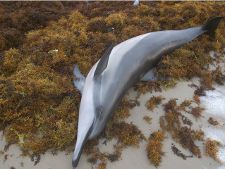
Stranded Spinner dolphin. Credit: qnr via Flickr.
The latest NOAA (United States: National Oceanic and Atmospheric Administration) report on unusual strandings of whales and dolphins in the northern Gulf of Mexico finds they're still dying at twice the normal rate 18 months after BP's Deepwater Horizon disaster.
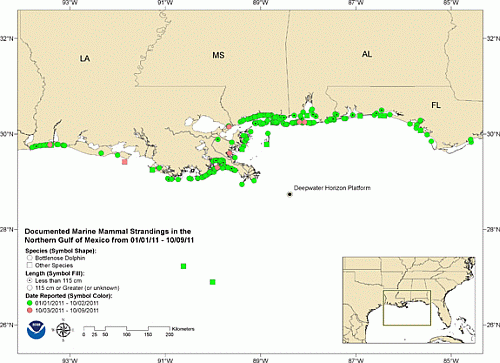
Map of strandings in relation to Deepwater Horizon well Credit: NOAA.
As you can see in the map above, the most heavily oiled shoreline still corresponds with the most dead whales and dolphins. Bottlenose dolphins are shown as circles and other species as squares. Premature, stillborn, or neonatal bottlenose dolphins (with actual or estimated lengths of less than 115 cm/45 inches) are shown as a circle with a black dot inside. Pink points mark the most recent week of data. Green points mark are all other cases since 1st January.
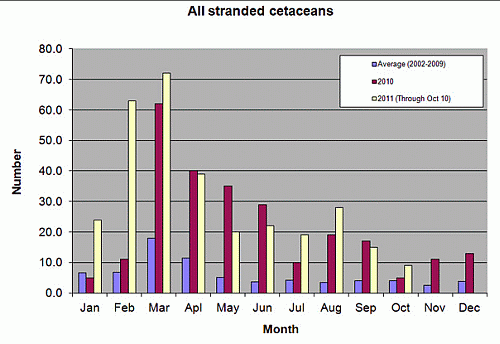
All stranded cetaceans (dolphins and whales) from Franklin County, Florida, to the Texas/Louisiana border. Credit: NOAA.
Here you can see how the numbers of strandings have not yet stabilized or even begun to decline. In some cases they're still growing. The magenta-coloured bars mark strandings per month in the year 2010. The ivory-coloured bars mark strandings per month so far this year.
In my Mother Jones article "The BP Cover-Up" last year, I wrote about the kind of long-term problems the Gulf might face not just from oil but from extreme quantities of oil in very deep water, as well as from chemical dispersant, including dispersant injected into very deep water.
Sadly, it seems that cetaceans — past, present, and future — may be bearing some of those burdens.
Is your washing machine causing plastic pollution of the oceans?
It turns out that the plastic pollution problem in the world's oceans is not just a result of improper or irresponsible disposal of our waste. Some of the plastic collecting in the oceans is coming directly from our washing machines.
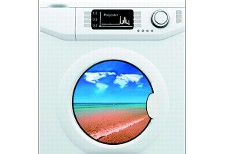
A story in Environmental Science and Technology presents research showing that micrometer-size fragments of plastics have contaminated the shorelines at 18 sites around the world, from the poles to the equator, with greater levels of contamination in densely populated areas.
The contamination is traced to "sewage contaminated by fibres from washing clothes," and the fibres are plastics used in clothing materials so many people wear every day: Acrylic, polyethylene, polypropylene, polyamide and polyester.
Experiments sampling wastewater from domestic washing machines demonstrated that a single garment can produce more than 1900 fibres per wash. This suggests that a large proportion of microplastic fibres found in the marine environment may be derived from sewage as a consequence of washing of clothes. As the human population grows and people use more synthetic textiles, contamination of habitats and animals by microplastic is likely to increase.
Put more simply, from the New York Times, "Examining washing-machine waste water, they found that 1900 fibres can rinse off a single garment during a wash cycle and that those fibres look just like the microplastic debris on shorelines. As the human population increases, they say, the problem is likely grow."
"Giant" single celled organisms discovered in the ocean
Gigantic amoebas have been found in the Mariana Trench, the deepest region on Earth.
During a July 2011 voyage to the Pacific Ocean chasm, researchers with Scripps Institution of Oceanography at UC San Diego and National Geographic engineers deployed untethered landers, called dropcams, equipped with digital video and lights to explore the largely mysterious region of the deep sea.
The team documented the deepest known existence of xenophyophores, single-celled animals exclusively found in deep-sea environments. Xenophyophores are noteworthy for their size, with individual cells often exceeding 4 inches (10 centimetres), their extreme abundance on the sea-floor and their role as hosts for a variety of organisms.
The researchers spotted the life forms at depths up to 6.6 miles (10,641 metres) within the Sirena Deep of the Mariana Trench. The previous depth record for xenophyophores was approximately 4.7 miles (7,500m) in the New Hebrides Trench, although sightings in the deepest portion of the Mariana Trench have been reported.
Scientists say xenophyophores are the largest individual cells in existence. Recent studies indicate that by trapping particles from the water, xenophyophores can concentrate high levels of lead, uranium and mercury and are thus likely resistant to large doses of heavy metals. They also are well suited to a life of darkness, low temperature and high pressure in the deep sea.
"The identification of these gigantic cells in one of the deepest marine environments on the planet opens up a whole new habitat for further study of biodiversity, biotechnological potential and extreme environment adaptation," said Doug Bartlett, the Scripps marine microbiologist who organized the expedition.
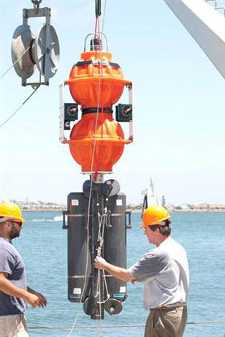
Scripps ocean engineer Kevin Hardy (right) and marine technician Josh Manger prepare to test Hardy's deep-sea lander at Scripps' Nimitz Marine Facility.
The xenophyophores are just the tip of the deep-sea ecosystem iceberg. The expedition also found the deepest jellyfish observed to date, as well as other mysterious animals.
"As one of very few taxa found exclusively in the deep sea, the xenophyophores are emblematic of what the deep sea offers. They are fascinating giants that are highly adapted to extreme conditions but at the same time are very fragile and poorly studied," Levin said. "These and many other structurally important organisms in the deep sea need our stewardship as human activities move to deeper waters."
The dropcams used to observe the creatures contained an HD camera and lighting inside a glass bubble that can withstand the extreme pressures encountered at these depths.
"Sea-floor animals are lured to the camera with bait, a technique first developed by Scripps professor John Isaacs in the 1960s," said Kevin Hardy, a Scripps ocean engineer and cruise participant. Hardy advanced the ultra-deep glass sphere design used on 'dropcams' more than a decade ago. "Scripps researchers hope to one day capture and return novel living animals to the laboratory for study in high-pressure aquariums that replicate the trench environment."
Millions of tonnes of debris from Japan's tsunami afloat in the Pacific Ocean
Some 5 to 20 million tons of debris — furniture, fishing boats, refrigerators — sucked into the Pacific Ocean in the wake of Japan's 11th March earthquake and tsunami are moving rapidly across the Pacific. Researchers from the University of Hawaii tracking the wreckage estimate it could approach the U.S. West Coast in the next three years.

Debris from Japan's tsunami approaching Hawaii. (KITV/ABC)
"We have a rough estimate of 5 to 20 million tons of debris coming from Japan," University of Hawaii researcher Jan Hafner told Hawaii's ABC affiliate KITV.
Crew members from the Russian training ship the STS Pallada "spotted the debris 2,000 miles from Japan," last month after passing the Midway islands, the Mail wrote. "They saw some pieces of furniture, some appliances, anything that can float, and they picked up a fishing boat," said Hafner. The boat was 20-feet long, and was painted with the word "Fukushima." "That's actually our first confirmed report of tsunami debris," Hafner told KITV.
Suffolk: Coastal erosion scheme set for approval
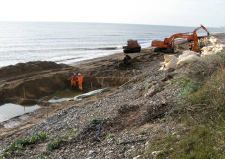
Beachless Covehithe
It currently appears that Suffolk Coastal's cabinet will be asked to formally adopt the Shoreline Management Plan (SMP) next Tuesday 1st November and so will be likely to implement a policy of "no active intervention" in all the vulnerable smaller communities, including Covehithe, just north of Southwold. Here residents face the inevitable loss of their homes, a 15th century church and important conservation areas within the next 40 years unless they pay for the sea defences themselves.
The entire stretch of 45 mile stretch between Lowestoft Ness and Languard Point in Felixstowe is threatened by erosion and loss of cliff face, this of grave concern to many. It has been the cause of widespread opposition by local residents, ornithologists, artists, environmentalists, nature lovers, the Alde and Ore Association and SCAR (Suffolk Coast Against Retreat) and of course MARINET, indeed all those who value this delightful coastline, as the area has been denied investment for long-term defence against erosion. The plan shows that Sudbourne beach and Orford Ness will both be allowed to become victims of the ongoing and escalating erosion, as will Orford beach, but with realignment, maintenance and upgrades made going south as far as Bawdsey Hill and Cliffs, which will be left. The coastline between Bawdsey Manor and Languard Point will continue to be managed and realigned where appropriate to maintain important flood defences.
Suffolk Coastal Council is expected to capitulate to the persistent and unrelenting demands of the Shoreline Management Plan earlier structured by Natural England, Suffolk Coastal, Waveney, British Energy and the Environment Agency, despite overwhelming opposition and its rejection at public consultations, and without consideration of modern cheaper far methods of protection that could and should have been deployed. Furthermore, the council is one of the few who have failed to oppose causative offshore aggregate dredging.
An informative article on the above by Tom Potter entitled 'Suffolk: Coastal erosion scheme set for approval appears in the East Anglian Daily Times of Wednesday, 26th October, 2011
Sampling O2 levels in the North Sea
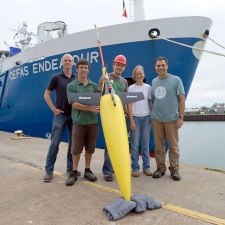
The iRobot gliding device which is self propelled in water measures oxygen and other levels in the sea.
In the East Anglian Daily Times of Monday, 19th September, 2011 David Green reported on a new piece of technology which will help give us a better understanding of what is happening in our ailing seas. It is a torpedo-shaped satellite controlled density adjusting marine glider for sampling oxygen levels(and other vectors) in the North Sea, and is deployed from the 3,000 tonne 73-metre long research vessel 'Endeavour'. The work is being carried out by the Lowestoft-based Centre for Environment, Fisheries and Aquaculture Science (CEFAS) in collaboration with the University of East Anglia (UEA) who already have data of oxygen levels in the North Sea dating back to 1902.
As is well known, there is mounting evidence that oxygen levels are declining, especially in the bottom layers of the sea. If the trend continues non-addressed, the future of fish and shellfish will be endangered. Whilst much of the cause may be organic inputs such as sewage, agricultural run-off, etc, part may be due to Climate Change causing warming oceans. Oxygen levels actually increased in the North Sea during the 1970s, this considered to be largely due to European Union legislation which led to a reduction in the volume of nutrients entering the sea, mainly from farm fertilizers and non-primary treated sewage outfalls. However, that increase in oxygen levels was short-lived and now continues to decline. The decrease has been far more pronounced in the last ten to fifteen years.
If investigations prove that the problem is man-made then action might be possible, even if it takes years to have an effect. But really action is necessary and needs to be taken before the problem occurs. See 'What an Orca can tell us about the North Sea' at EADT24
The ongoing saga of oil transfers off Southwold
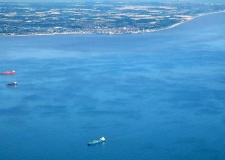
Picture by Mike Page shows tankers off the coast between Lowestoft and Southwold
Anthony Carroll's article in the Lowestoft Journal of Friday, 14th October, 2011 and that earlier by Jonathan Barnes in the Evening Star of Tuesday, 20th September, 2011 tell that the long-running battle over plans to allow ship-to-ship transfers off the coast of Suffolk is set to be fought out in Parliament after opposition MPs vowed to stop the controversial practice going ahead.
The previous Labour administration had wanted to ban all transfers taking place in UK territorial waters, but that ban was blocked by the new coalition government when an Early Day Motion was submitted, which was amazingly signed by the local Suffolk Coastal MP Therese Coffey and Waveney's MP Peter Aldous! The government had originally hoped to introduce the exclusive Sole Bay tanker zone from this month but the Department for Transport admitted that there had been a delay because of the process of reversing Labour's legislation to outlaw the practice within the UK's 12-mile territorial limit. Needless to say, the Labour Party have decided to fight the plans being approved by Parliament. Shadow transport minister Jim Fitzpatrick said he would attempt to force a vote on the tanker transfer exclusion zone when it was brought before the House of Commons by Mr Penning.
The issue is that the government is now proposing to designate Sole Bay, off Southwold, as the only place in UK territorial waters where tankers can legally transfer oil, despite fierce local objections. Shipping minister Mike Penning hopes to introduce the exclusive zone from April after blocking the implementation of an all-out ban on the transfers which was drawn up by the previous Labour government. Under parliamentary regulations, the government has until April to introduce legislation or legislative orders to create the new zone.
Strangely, the flotilla of tankers earlier moored off Southwold until a month ago suddenly seem to have disappeared. This just may have had something to do with the rise in the price of oil followed by a slight decrease. If you should wish to follow progress, the positioning of all ships can be seen on www.marinetraffic.com/ais.
Is BP risking worst ever oil spill in Shetlands?
Michael McCarthy, Environment Editor of The Independent, on Wednesday, 12th October 2011 published 'Exclusive: BP to risk worst ever oil spill in Shetlands drilling' that warned of an ecological disaster if BP's exploratory North Uist well was to be sunk 4,000 feet down in the Atlantic next year bursts.
It told how a worst-case scenario for a spill would involve a leak of 75,000 barrels a day for 140 days — a total of 10.5 million barrels of oil — the world's biggest pollution disaster that would be more than double the amount of oil spilled from its Deepwater Horizon well in the Gulf of Mexico last year.
The project appeared to have been shelved by the former BP chief executive Tony Hayward last year in the aftermath of Deepwater Horizon and the barrage of criticism directed at the company for its safety record. But it now appears to be going ahead, with the well to be drilled by a drilling ship, the Stena Caron, some time from January onwards, as long as it is given a licence by the Energy Secretary, Chris Huhne.
Seabirds including many rare species are to be found in massive concentrations on Shetland, the nearest landmass to any spill, and in the surrounding waters, which also contain large numbers of whales, dolphins and seals, as well as substantial fish stocks. North Uist holds more than 20 vulnerable Shetland nature sites, including eight Special Protection Areas, two Special Conservation Areas and 12 Sites of Special Scientific Interest, which include the breeding grounds of otters and rare birds such as the great skua, the red-throated diver and Leach's petrel. It is also a vital area for tourist income.
BP claim to have held a public consultation about the project, but this was not widely advertised, had virtually no publicity, and a BP spokesman admitted that there had been "no responses" from the public.
Purple sponge sea creature found off Cromer is brand-new species
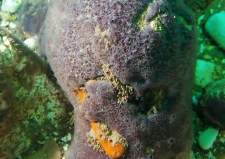
The previously unrecorded sponge Hymedesmia, found on the chalk reef off Sheringham. Picture: Rob Spray
Greater empasis has been put on recognising Europe's longest underwater offshore chalk reef off Sheringham as a fragile eco-system of international importance due to the finding of the sponge Hymedesmia, now officially declared as a brand new species.
In all, the Wildlife Trust's survey of the entirity of the East Coast, from Essex to Northumberland, carried out during National Marine Week in August, uncovered 352 species of marine wildlife including 126 seaweeds, several of them previously unrecorded. Dr Claire Goodwin of the National Museums of Northern Ireland said that because the reef is unusually made of chalk there could be other "new" sponge species living there.
The story of the discovery of Hymedesmia was first told in the Eastern Daily Press on Monday 15th August 2011 under 'Seaweed survey uncovers purple sponge off north Norfolk coast' and Purple sponge sea creature found off Cromer is brand new species and shown on BBC-1 TV at 7.30 pm on Monday 10th October 2011.
Suffolk aims to be first "sustainable fish county"
A campaign to make Suffolk the first Sustainable Fish County has been launched at a special ceremony during the Suffolk Herring Festival, 22nd October, reports the East Anglia Daily Times.
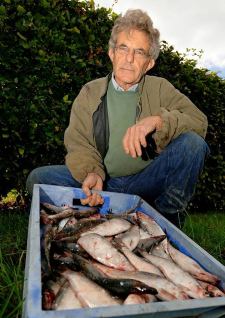
Jack Rosenthal of Middleton Farm Shop who is calling for Suffolk to become the first sustainable fish county
Festival organiser Jack Rosenthal has been the first to sign the Suffolk Sustainable Fish County Pledge at the event, which took place over the weekend of 22nd/23rd October.
Event organisers want to encourage people to eat more fish — but from sustainable sources — and to show that Suffolk, with its tradition of caring for the North Sea Fisheries, can become the first Sustainable Fish County.
"That's why we are asking Suffolk's shops, fish suppliers, restaurants, caterers, schools, colleges and tourist attractions to sign the Suffolk Sustainable Fish County Pledge, and asking engaged citizens to support the campaign by their buying power and encouragement," said Mr Rosenthal, owner of Middleton Farmshop, near Leiston, which is hosting the event.
Campaigners are calling on people in the county, including retailers and restaurateurs which have not already done so, to adopt the sustainability policy drawn up by the UK's leading marine conservation groups.
In practice, this means that caterers must exclude species rated as "at risk" by the Marine Conservation Society (MCS), promote Marine Stewardship Council certified fish and fish rated as "fish to eat" by the MCS, and work with suppliers to help improve the sustainability of other fish that they serve. Let's make Suffolk the first county where individuals and businesses build a market for sustainable fish, supporting fishing communities and contributing to the protection of our precious marine resources," said Mr Rosenthal.
"Every year, Suffolk waits for herring, cod, sole and sprats to arrive on our coast. If we want them to keep coming we have to act now to stop the situation in the North Sea getting any worse. That's why I'm signing the pledge."
The Suffolk Sustainable Fish County Campaign's aim is to make the county the first ever sustainable fish county, following London's campaign to help the London 2012 Games organisers to adopt a sustainable fish policy.
Those who sign up to the Suffolk Sustainable Fish County pledge promise to take the appropriate steps to buy sustainable seafood, as well as to protect precious marine environments, fish stocks, and good fishing livelihoods.
They also agree, among other things, to tell suppliers or caterer to remove endangered species from menus and catering — those rated as 'fish to avoid' by the Marine Conservation Society, spread the message about sustainable fishing, consider investing in Marine Stewardship Council (MSC) Chain of Custody certification to communicate the sustainability of MSC-certified seafood to customers and support positive change for fish, fisheries and marine resources.
For more information see www.suffolkherringfestival.net
168 organisations sign Ocean2012 Brussels Declaration in support of artisanal fishermen
Ocean2012 has presented to EU Fisheries Commissioner, Mrs Damanaki, a Declaration, Scale Matters — Quality Counts, signed by 168 civil society and artisanal fisher organisations represented from all across Europe. The text reads:
"We, the undersigned organisations, representing artisanal coastal and inland fish-workers, development and environmental NGOs and other stakeholders, share a common interest in placing European fisheries on a sustainable footing by supporting the reform of the Common Fisheries Policy (CFP) in ways which ensure the recovery of fish stocks and habitats, the promotion of best practice, a just allocation of fishing access based on social and environmental criteria, and an equitable distribution of the benefits derived from these activities."
"New fisheries policies that reward best practices with preferential access to fish resources, and target capacity reduction programmes so as to eliminate the most harmful fishing methods would go a long way to placing European fisheries on a more sustainable footing.
"This was recognised in the European Parliament resolution on the Green Paper adopted in February 2010. The resolution highlighted that, although local fishing communities should be given primary access to fish stocks, access rights should no longer be based solely on the criterion of historical catches. Rather, environmental and social criteria should gradually be introduced to determine who should have access to fishery resources, where the use of such criteria could foster a dynamic that would lead to improved fishing practices and a more environmentally, socially and economically sustainable fishing industry.
"A significant proportion of the European fleet is small in scale and fishes in a non-intensive manner, using a range of seasonally diverse fishing methods on a range of species, with a relatively low impact on the ecosystem. This artisanal segment of the coastal and inland fisheries generates considerable ancillary jobs and provides the social, economic and cultural fabric that sustains many communities, where it makes an important contribution to food supplies and political, social and economic stability.
"This has been highlighted in the 2009 Statement from the Brussels Workshop on Common Fisheries Policy Reform in the European Union and Small-Scale Fisheries and in the 2010 A Coruña Statement, amongst others. However, the qualitative aspects of different fishing gears and practices have been largely overlooked by the Commission in its reform package.
"Coastal artisanal fishers are likely to be marginalised under the compulsory regime of Transferable Fishing Concessions as proposed by the Commission. Such a regime will favour the most economically powerful enterprises rather than the most sustainable fishery activities. However, if treated fairly, managed responsibly and given well defined fishing access, these kinds of fishery activities have the potential to deliver healthy fisheries and sustainable livelihoods over the long-term.
"European Commission projections show employment in the fish catching sector is set to decline by 60% over the next 10 years, with the heaviest losses falling on the artisanal sector, which employs around 65% of the fisheries workforce.
"We therefore call on the Members of the European Parliament, the Member States of the EU, and the Commissioner for Fisheries and Maritime Affairs to turn the tide by:
- Providing priority access to fish resources to those who fish in the most environmentally and socially sustainable way. Sustainability criteria should rank access to resources, favouring those who have the least impact on the marine environment, who can demonstrate compliance and who operate within and contribute to local communities;
- Revoking the compulsory nature of the proposed Transferable Fishing Concessions (TFCs) scheme and providing a range of tools to be selected and adapted to enable the allocation of access to fishing opportunities based on sustainability criteria;
- Including firm time-lines for the development and adoption of multi-annual plans that apply the appropriate measures through genuine bottom-up, participative co-management processes, through co-management committees, and giving due weight to sustainable development while ensuring the involvement and collaboration of all segments in the sector and stakeholders; and
- Establishing and applying clear conditions and protocols to avoid conflicts between different users targeting shared stocks or common fishing grounds.
NOTE: This Declaration has been signed by MARINET, and for a full list of other signatories visit www.ocean2012.eu/publications/43-scale-matters-quality-counts-securing-sustainability
Spain's fishing fleet gets nearly €6 billion in national subsidies since 2000
The International Consortium of Investigative Journalists have issued a report, 2nd October 2011, on the Spanish fishing industry's political influence, global reach and criminal record. The stories reveal an industry more subsidized by taxpayers than any other in the European Union, even as it has racked up an extensive history of flouting rules and breaking laws.
Key findings
- The Spanish fishing industry has received more than €5.8 billion (more than $8 billion) in subsidies from the EU and Spain since 2000 — far more than the industry of any other EU country.
- Subsidies account for a third of the sector's value. Simply put, nearly one-in-three fish caught on a hook or raised in a farm is paid for with public money.
- The subsidized Spanish fleet has cultivated an extensive record of flouting the rules while officials overlook fraud and continue to dole out aid to vessels that break the law.
- More than 80 percent of subsidized fishing companies that were fined in Spain for fishing infractions — and then lost subsequent court appeals — continued to receive subsidies.
- One Spanish shipowner received more than €8.2 million in subsidies even while his company or its affiliates faced more than 40 accusations of illegal fishing and US$5 million in fines.
For further details of the report, visit iwatchnews
BP to expand North Sea oil fields
BP is facing fresh condemnation from environmentalists after it got the go-ahead to invest £4bn to develop one of the North Sea's largest oilfields off Shetland. The company has been criticised by green campaigners for trying to open up "a new Atlantic frontier" west of Shetland, to replace dwindling reserves in other parts of the North Sea.
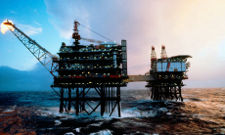
Greenpeace and other green groups have already criticised BP for seeking to drill in the deep-water North Sea oilfield of North Uist, off Shetland. Photograph: Alamy
BP's latest move to extract oil from the Clair Ridge field was immediately criticised by Greenpeace, which claimed it was now "frankly risible for David Cameron to claim that this government will be the 'greenest ever'." Greenpeace said: "While [energy secretary] Chris Huhne likes to portray himself as the good green guy of the cabinet, all those around him are pledging the UK to a dirty fuel future that will do only one thing: increase CO2 emissions and cause irreparable damage to the environment."
Green groups have already criticised BP for seeking permits to drill a potentially hazardous deep-water well 1,300 metres below the surface in the North Uist field — a seabed block named after the Hebridean island but located 80 miles north-west of Shetland. However, the prime minister threw his weight behind BP, declaring: "We should be looking to try and make these things happen rather than ruling them out."
The firm had planned to start drilling in the North Uist area last year but the launch date was postponed following the Deepwater Horizon disaster, in which 11 workers were killed and 4.9m barrels of oil leaked into the Gulf of Mexico. Now the company is pushing ahead, prompting environmental groups to write to Huhne urging him to withhold consent. They warn that a spill could be disastrous and that exploiting new oil reserves would be harmful to the climate.
But during a visit to BP's headquarters in Aberdeen, David Cameron appeared to dismiss those concerns when he said: "There are some people who you will never reassure, who quite frankly would probably prefer we weren't recovering oil from any part of the North Sea. I don't think you're going to convince them." Cameron said he was delighted to give BP the go-ahead for the next phase of development of the huge Clair Ridge field, 50 miles from Shetland, which is not in deep water. He said it was "great news for Aberdeen and the country and provides a massive boost for jobs and growth".
BP said its Clair investment was its biggest in a single year in the North Sea and, together with other recently announced projects off the UK, should enable it "to maintain our production from the North Sea to around 200,000-250,000 barrels a day until 2030".
The UK energy group, headed by Bob Dudley, desperately needs good news after several international setbacks that resulted in shares falling. Besides the disastrous Mexican Gulf oil spill, BP's joint venture in the Arctic with Russia's Rosneft collapsed.
So far this year, BP has announced North Sea investments worth £10bn, including contributions from its partners, Shell, Chevron and ConocoPhillips. Dudley said: "Although it began over 40 years ago, the story of the North Sea oil industry has a long way yet to run. BP has produced some 5bn barrels of oil and gas equivalent so far from the region and we believe we have the potential for over 3bn more."
BP said after a "decade of decline", industry-wide oil investment in the North Sea and the Atlantic margin was now increasingly strongly once more. The announcement of the Clair scheme comes after BP and its partners revealed plans earlier this year for a £3bn redevelopment of the Schiehallion and Loyal oilfields, also to the west of Shetland. In addition, they are investing £700m in developing the Kinnoull field in the central North Sea.
David Cameron said: "We live in a very dangerous and difficult world. We do not want to be over-reliant on energy supplies from difficult parts of the world, from unstable parts of the world. And it is a huge national advantage having such a brilliant oil and gas industry here in Aberdeen and here in the North Sea. "We should treasure that and want to see it expand, want to see it grow, want to see it be part of a good and diversified energy industry in the UK."
According to BP, since the late 1960s, £300bn has been invested in exploration drilling and field developments on the UK continental shelf — and a similar figure has been paid in corporate taxes. BP alone has invested about £35bn into the UK North Sea, paying more than £40bn to the government in tax.
Dudley said: "We have a major presence in the North Sea today, operating around 40 oil and gas fields, four onshore terminals and a network of pipelines that transport almost half of the UK's oil and gas production. And as demonstrated by these announcements, the region still offers competitive, attractive investment opportunities, which we will pursue."
Over the next few years, BP will be bringing onstream more major project developments in the UK than ever before over a similar period, it said.
Antarctic lake could predict the Earth's future
An ancient lake hidden deep beneath the west Antarctic ice sheet may reveal vital clues about climate change, future sea level rises and uncover new forms of life, according to a group of British engineers and scientists
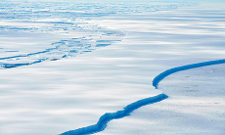
The Antarctic study could find new species of life as well as data on climate change. Photograph: Reuters
This month, a British engineering team will travel to one of the most remote and hostile environments on Earth — Lake Ellsworth, which is buried under two miles (3km) of ice — in the first stage of a project costing over £7m.
The ice sheet covering the lake has trapped the Earth's geothermal heat, preventing it from freezing. The team will prepare for a challenging drilling operation starting next November to collect water and sediment samples from the lake's floor, which will help scientists assess the stability of the west Antarctic ice sheet and future sea level rises.
"If we can find out if or when the ice sheet retreated or collapsed, it could tell us what kind of conditions would lead to a west Antarctic retreat in the future," Mike Bentley, a glacial geologist at Durham University, told reporters at a briefing on Monday.
For many years, scientists have speculated that new and unique forms of microbial life evolved in this dark, sterile and isolated environment, which experiences temperatures of -25C (-13F).
The team expects to find evidence of viruses, bacteria, single-celled micro-organisms called archea and complex cell organisms called eukaryotes. These lifeforms could increase our understanding of how life on Earth began and evolved and help define its limits.
"Finding life in a lake that could have been isolated from the rest of the biosphere for up to half a million years will tell us so much about the potential origin of and constraints for life on Earth and may provide clues to the evolution of life on other extraterrestrial environments," said David Pearce, science coordinator at the British Antarctic Survey. "If we find nothing (it) will be even more significant because it will define limits at which life can no longer exist on the planet."
However, some experts worry that penetrating such untouched environments could alter them for good. To avoid contamination, the Lake Ellsworth Programme's water probe and hot water drill will use clean technology derived from space science, the team said.
The project, mostly funded by the UK's Natural Environment Research Council, hopes to be the first to take samples and measurements from one of Antarctica's 387 known sub-glacial lakes. Other research teams have been racing to penetrate such lakes after satellite data in the 1990s uncovered the hidden network in Antarctica.
Russian scientists are currently forced to wait until December to resume drilling at east Antarctica's Lake Vostock, after the end of summer this February cut short their operation.
A US project is concentrating on the Whilland ice stream in west Antarctica but it is unlikely to gain entry to the lake until next year.
Stricken New Zealand oil tanker threatens serious pollution problems
Oil has begun washing up on a popular beach on New Zealand's east coast, five days after the container ship Rena struck a reef in the Bay of Plenty. Officials urged people to avoid the area, warning that the water off Tauranga city had become "highly toxic".
Efforts to remove oil from the ship, which ran aground on Astrolabe Reef in the early hours of Wednesday, have been suspended in the face of deteriorating weather conditions. On Sunday about 10 tonnes of fuel oil had been pumped into safe storage from the 236-metre-long ship but that represented a fraction of the 1,700 tonnes on board.
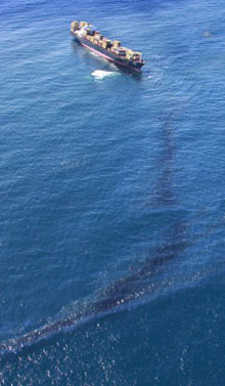
Oil streams from the Rena stuck on Astrolabe Reef in New Zealand's Bay of Plenty Oil streams from the Rena. Photograph: Getty/Fairfax Media
The salvage operators have said they are confident the Rena is secure but fears remain that the 47,000-tonne vessel could break up in stormy weather, disgorging oil and cargo into the bay. Maritime New Zealand, which is overseeing the salvage operation, issued a public health warning on Monday, ordering people not to "touch or attempt to clean up oil as it is toxic" and reinforcing earlier advice to avoid collecting or eating shellfish from the affected area.
Warning signs are being erected on beaches. Earlier advice had been that oil was unlikely to come ashore before the middle of this week but stick black blobs have been deposited on shorelines by the tide.
At least nine oil-coated seabirds, including seven little blue penguins, have been recovered from the slick.
Maritime New Zealand said it hoped that when the operation resumed it would take between 30 and 40 hours to remove the remainder of the oil. Chemical oil dispersants have been dropped on the slick but this is believed to have had little effect.
Maritime New Zealand salvage co-ordinator Bruce Anderson said experts were confident the ship was in "pretty good shape". He told Radio New Zealand: "It's stable on the reef, there are no signs of deformation in the vessel, things are OK."
The salvage strategy is first to remove oil, then to lighten it by lifting off containers, and finally to remove the ship itself.
In a press conference on Monday afternoon the New Zealand transport minister, Steven Joyce, confirmed that among the many hundreds of containers stacked on board the ship 12 were believed to contain potentially dangerous materials.
He added that the captain of the Rena, which is chiefly crewed by Filipino nationals, had been interviewed as part of two separate investigations into the grounding and that consumption of alcohol could not be ruled out as a factor.
Brett Keller, the owner of Tauranga Marine Charters, who has viewed the stricken vessel from sea, said that in the face of deteriorating weather the response could be "too little, too late. They're lucky they had five flat days, and now today is looking pretty snotty," he told the Guardian early on Monday. "The ship is totally unsupported on half its length. You put a two- or three-metre swell on that, add in 40 or 45 knots of wind and something has got to give."
Responding to criticisms around the speed of the response, the New Zealand prime minister, John Key, pointed to the rarity and complexity of the incident. Speaking on the TV One Breakfast programme, Key said: "Every year around the world there are ships that get into grief, but not ones that normally just plough into a very well documented reef in calm waters at high speed."
Officials had moved immediately to fly specialists to New Zealand, Key said, with five of the world's 50 top experts now in the country. "You have to make sure you understand exactly what you're doing before you do it," he said.
Is China interested in Blackpool's shale gas deposits?
China's growing attempts to seize global natural resources has reached Britain with a link to the recent shale discoveries near Blackpool and a bid for a London-listed uranium company.
Close ties have emerged between China National Offshore Oil Corporation (CNOOC) and a backer of Cuadrilla Resources, the exploration group that claimed last month there were trillions of cubic metres of shale gas under Lancashire.
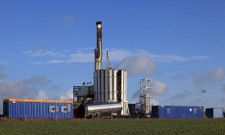
Cuadrilla Resources' rig near Blackpool, where the firm is drilling the Bowland shale for gas. Photograph: Christopher Furlong/Getty
The Beijing-to-Blackpool link was revealed after the Hong Kong-based Kerogen Capital came to the rescue of one of the largest shareholders in Cuadrilla. Kerogen and CNOOC are behind a new $1.5bn (£1bn) fund, which is looking at investing in new resource projects. Kerogen, set up by former JP Morgan bankers Ivor Orchard and Jason Cheng, has taken a 15% stake in AJ Lucas — an Australian engineering business that holds about 40% of Cuadrilla.
Lucas has been struggling to raise new cash and needed to inject $10m in Cuadrilla to maintain its stake in a business that is also 40% owned by Riverstone — a private equity firm in which former BP boss, Lord Browne, is a key player.
Chinese companies have already bought into shale gas companies in the US, where a welter of discoveries has sent the price of natural gas plummeting. Cuadrilla made headlines when it claimed that two exploratory wells in the Bowland shale of Lancashire indicated huge reserves of 5.6tn cubic metres of shale gas.
Some academics have questioned the very high estimates, but Cuadrilla told the Guardian that it stands by those numbers, and made clear that Lord Browne, one of the most respected figures in the oil world, had endorsed them too in his capacity as a Cuadrilla board member.
Objections to shale operations focus on potential water contamination, due to the chemicals pumped into the ground with water to hydraulically fracture, or "frack", the rock and release the hydrocarbons. Green groups also fear that cheap gas will undermine government carbon-reduction targets and inhibit the nascent renewable energy industry. The process has been banned in France and some US states but another company is also applying for drilling licences in Britain, this time in the Mendip Hills outside Bath.
Meanwhile, the state-backed China Guangdong Nuclear Power Group (CGNPG) is expected to launch a £650m takeover of a London-listed uranium miner, Kalahari Minerals, as early as this week.
Shares in Kalahari, which is listed on the Alternative Investment Market, rose 7% on Friday amid speculation about interests in the far east. Kalahari is of interest to nuclear operators because it owns a big stake in the Husab uranium mine in Namibia, one of the world's largest.
Despite the Fukushima nuclear disaster in Japan, China is still expected to proceed with its reactor construction programme — it already has 25 plants under construction, half of the world's new capacity.
CGNPG offered 290p a share for Kalahari Minerals in March, valuing the mining group at £756m, but the deal fell apart after the Chinese company tried to cut the price after Fukushima.
The tsunami led Japan, Germany and Austria to halt their new nuclear programmes or phase out reactors early, reducing uranium's value as a fuel.
China's Minmetals launched a $1.2bn offer last month for Anvil Mining, a copper producer with assets in the Democratic Republic of Congo.
Melting Arctic ice clears the way for supertankers
Supertankers and giant cargo ships could next year travel regularly between the Atlantic and Pacific Oceans via the Arctic to save time, money and emissions, say Scandinavian shipowners.
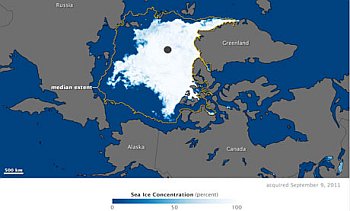
The image above was made from observations collected by the Advanced Microwave Scanning Radiometer and shows the extent of sea ice melt. The yellow outline shows the median minimum ice extent for 1979/2000. Photograph: Aqua/NASA
New data from companies who have taken advantage of receding Arctic sea ice this year to complete several voyages across the north of Russia shows that the "northern sea route" can save even a medium-sized bulk carrier 18 days and 580 tonnes of bunker fuel on a journey between northern Norway and China. The voyage would normally take upwards of 40 days.
Even bigger fuel and time savings have been reported this week by Danish shipping company Nordic Bulk Carriers which says it saved a third of its usual costs and nearly half the time in shipping goods to China via the Arctic.
The route, which cuts around 4,000 nautical miles off the southern Suez route from the Atlantic to the Pacific, has barely needed an ice-breaker since July as annual sea ice melted to a near record low extent. "We saved 1,000 tonnes of bunker fuel — nearly 3,000 tonnes of CO2 — on one journey between Murmansk and north China," said Christian Bonfils, a director of Nordic Bulk Carriers in Oslo.
The shipowners, who anticipate that the northern route could gradually be opened for four to six months a year as air and sea temperatures increase, are exploring the possibility of regular summer passages through the Arctic ocean. This could save them €180,000-300,000 on each voyage, they say.
"The window for sailing the route is four months now, but the Russians say it is seven [if the cargo ships are accompanied by Russian atomic icebreakers]. When we can save 22 days on transportation, it is very good business for us," said Bonfils.
Apart from time savings, the shipowners can avoid Somali pirates and the high insurance premiums they attract if their ships pass through the Suez canal.
The Russian prime minister, Vladimir Putin, has recently predicted that the route would soon rival the Suez canal as a quicker trade link from Europe to Asia. "The Northern sea route will rival traditional trade lanes in service fees, security and quality," he told a conference organised by the Russian Geographical Society in Arkhangelsk in September.
This is seen as wildly optimistic by the Scandinavian shipowners, who are nevertheless encouraged by the speed of change in high latitudes. The Arctic was crossed in a record eight days in August by an STI Heritage tanker on a route between the US and Thailand, and on 20th August, a 160,000 tonne supertanker with 120,000 tonnes of gas made the passage, becoming the largest commercial ship ever to sail the route.
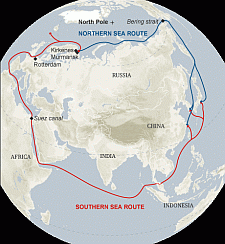
The route, which used to be known as the North-east passage, runs along the Russian Arctic coast from Murmansk on the Barents Sea, along Siberia, to the Bering Strait. Environment groups have warned that an Arctic shipping rush could accelerate global warming. While they accept that ships would burn less fuel and emit less CO2, they fear oil spills and other maritime accidents, as well as "black carbon", the sooty residue of partly burned fuel which is deposited on ice and is a short-lived but powerful "forcer" of climate change.
"The prospect of the creeping industrialisation of the high north is deeply worrying. More ships bring more chance of major accidents and will mean more climate pollutants on the back of more melting of the ice," said Ben Ayliffe, Arctic campaigner with Greenpeace.
But shipowners cautioned that special ice-strengthened ships were needed and it is too early to build ships especially for the journey.
In a further sign that the Arctic was opening up, Russian atomic icebreakers received 15 requests to escort Arctic voyages in 2011, against four in 2010.
Canadian and American maritime experts have estimated that 2% of global shipping could be diverted to the Arctic by 2030, rising to 5% by 2050.
Arran Seabed Trust (C.O.A.S.T.) report on "Sainsbury's Prawn Cock-Tale"
The Community of Arran Seabed Trust (C.O.A.S.T.) report in their October newsletter "In a revealing and ultimately laughable exchange with Sainsbury's Supermarket who are claiming to have found a wonderful source of sustainably harvested Scottish prawns, Arran marine campaigner, Russell Cheshire forced them to admit the prawns were in fact bottom trawled. Russell sent us a transcript of his exchange which is included below."

Russell Cheshire reports "I've been having an interesting question and answer session with J Sainsbury plc regarding their new offering: (Langoustines [Prawns] from Scotland, if you're in a hurry).
"There are two commercial methods of catching prawns: either by using creels, which have little or no impact on the seabed or by-catch (the catching of species other than the one targeted); or by using trawl-nets, which scrape the seabed causing damage to static life and which brings large amounts of by-catch to the surface, most of which is discarded as non-saleable but is already dead or dying. ("Large amounts" has been quantified in the Clyde prawn fishery as up to 90% — that is, for every tonne of prawns landed, nine tonnes of sea life is discarded.) At certain times of year the prawns burrow into the mud a few inches — so the trawls are rigged to plough down into the silt, causing even more damage.
"So I asked Sainsbury's:
"I note that you are to purchase prawns (nephrops norvegicus) from the west coast of Scotland. While agreeing that all efforts to support local industries are laudable, would you please confirm that these prawns are caught by low-impact methods such as creeling and not by means of trawling — which has a destructive effect on the marine environment. I look forward to your reply with interest."
"And I had a reply within 2 days:
"Dear Russell
Thanks for your e-mail enquiring if the Scottish prawns that we sell are fished using low-impact methods.
We work hard to source our prawns with integrity. We source then in a sustainable manner where we take exactly what we need. We make sure that there is no harm or long lasting damage caused to the area.
If you visit our corporate website on www.jsainsburys.co.uk you can click on the orange tab across the top called 'Responsibility'. This leads you to our page called 'Commitments and Progress', one of which is 'Sourcing with Integrity'. Here, you can read more information on how we are progressing in our commitment regarding the way we fishing.
You can also read information on the following link. This speaks more about our fisheries.
If you've any further question, please feel free to get in touch with us using one of the methods at the end of this e-mail.
We appreciate the time that you've taken to contact us.
Kind regards
Sxxxxx Axxxxx — Customer Manager"
"Which was great, but didn't actually tell me anything that I didn't already know and certainly didn't mention the methods used for this new product; so I tried again:
"Dear Customer Manager,
Thank you for your reply.
Unfortunately it does not seem to answer the question as to which method is used — creels (pots) or trawling.
Neither of the web links clarifies the situation.
I would appreciate your further efforts to provide me with a definitive answer.
Best Regards, Russell."
… and I received another reply:
"Dear Russell
Thanks for your further e-mail. I'm sorry my colleague didn't fully answer your question. I can understand your disappointment as you would like an answer to your previous enquiry.
As part of our sourcing with integrity policy we take great care with where are sea food products come from and how they are caught.
I can confirm that our Scottish prawns are line caught in the North West Atlantic Ocean. We only use reputable suppliers that can assure us of the methods used.
As my colleague mentioned, for further information and general knowledge please visit our corporate website, www.j-sainsburys.co.uk for any other queries you may have.
We appreciate you taking the time to contact us regarding this matter as we use customer feedback to improve our products. We look forward to seeing you in store again soon.
Kind regards
Gxxxxx Gxxxxx … Customer Manager"
"Obviously Hugh's Fish Fight has made a lasting impression on someone. Anyway:
"Dear Customer Manager,
Thank you for your response; however:
- Prawns can not be caught on a line;
- Scotland is in the North East Atlantic.
It seems you and your colleagues need to look into this matter again.
To remind you of my original question:
'Would you please confirm that these prawns are caught by low-impact methods such as creeling and not by means of trawling — which has a destructive effect on the marine environment.'
Regards, Russell."
"Today I received (via Twitter) the following response from Sainsbury's PR department:
"@obskipper the langoustines are caught using trawl around the West coast of Scotland, specifically North and South Minch areas, landing in Mallaig. We're targeting the last day's catch, i.e. prawns that are only 1 day old to guarantee the freshest prawns to our customers."
"So there we have it — you can buy fresh prawns from J Sainsbury plc at a huge environmental cost. I did thank them for their help:
"Thanks for this; trawling has a destructive effect on the marine environment & should not be considered sustainable. @SainsburysPR"
"If you are concerned about the future of Scotland's fisheries — or the seas in general — please ask your favourite supermarket how their products are sourced.
"Oh — I also brought this to the attention of the Marine Conservation Society and Hugh's Fish Fight… "
Russell Cheshire
Arran Seabed Trust (C.O.A.S.T) do not favour transfer of Crown Estate to the Scottish Government
In their October Newsletter the Community of Arran Seabed Trust (C.O.A.S.T.) state "At the present time the Scottish Government, through the SNP, is attempting to have the powers and revenue of the Crown Estate in Scotland totally transferred to the Scottish Government. COAST supports no political party but was formed by community stakeholders to support the sustainability of the marine environment in Lamlash Bay, Arran, the Firth of Clyde and around Scotland. On recent evidence and decisions taken, the Scottish government is not supporting the sustainability of her seas, and so COAST is not in favour of transfer of additional powers from the Crown Estate."
COAST's response to the Scottish Affairs Committee in the UK Parliament, sent in September, can be seen in full at www.arrancoast.com/website_pdf/Crown_Estates_Response_Sept2011.pdf.
World's oceans originated from comets, study suggests
The dirty snowballs known as comets might be the sources of Earth's water after all, scientists say.
Water is critical to life on Earth — life is found virtually wherever there is water on our planet. Researchers have spent decades debating where Earth's water and other key ingredients of life came from.
Prior studies had suggested that early Earth was dry, lacking water and other so-called volatile materials.
Now Earth-like water has been discovered in the small oddball comet Hartley 2, which the Deep Impact/EPOXI spacecraft flew by in November 2010. This comet originated in the disk-shaped Kuiper belt, a region of the solar system beyond the orbit of Neptune, suggesting this is ultimately where much of Earth's water came from.
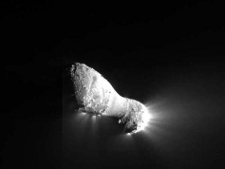
A stunning close-up photo of Comet Hartley 2 from the November 2010 flyby performed by NASA's Deep Impact spacecraft. NASA / JPL-Caltech / UMD
"When the Earth formed it was so hot that most volatiles escaped to space, so when the Earth cooled down it was dry," said study lead author Paul Hartogh, a planetary scientist at the Max Planck Institute for Solar System Research in Katlenburg-Lindau, Germany. "Water and other volatiles must have been delivered at a later stage."
Comets are natural candidates for the original sources of the world's seas, loaded with ice as they often are. However, computer models of how the solar system formed have suggested that asteroids actually were the source of most of the planet's oceans, with comets delivering no more than 10 percent of Earth's water.
To identify the original sources of Earth's oceans, scientists compared isotopes of the hydrogen found in the planet's water to isotopes of hydrogen seen in extraterrestrial bodies such as comets. All isotopes of an element have the same number of protons, but each has a different number of neutrons — for instance, regular hydrogen has no neutrons, while the hydrogen isotope known as deuterium has one neutron.
Scientists used the European Space Agency's Herschel Space Observatory to observe the ratio of deuterium to regular hydrogen in comet Hartley 2. In Earth water, about 1,558 deuterium atoms are seen per 10 million regular hydrogen atoms.
Past measurements of six comets from the giant spherical Oort cloud beyond the Kuiper belt saw about 2,960 deuterium atoms there per 10 million regular hydrogen atoms, which had suggested they were not the source of Earth's water.
Prior studies of meteorites known as carbonaceous chondrites originating from asteroids had water more like that seen on Earth, with about 1,400 deuterium atoms per 10 million regular hydrogen atoms. Now researchers find that water seen in Comet Hartley 2 is very close to Earth's, with about 1,610 deuterium atoms per 10 million regular hydrogen atoms.
"With our finding it may be that more than 10 percent and perhaps all water on Earth possibly stems from comets," Hartogh told Space.com. It may be that all bodies in the inner solar system get their water from these comets. Sampling a larger number of comets for their deuterium-hydrogen ratios could shed light on the matter, Hartogh said.
The scientists detailed their findings online 5th Oct. in the journal Nature.
Severe criticism of Thames estuary site for new London airport
Boris Johnson's campaign for a new airport in the Thames estuary "flies in the face of public opinion", a Tory council leader who commissioned a poll that revealed widespread opposition to the plan has said.

Boris Johnson's plans for a new £70bn airport in the Thames estuary have been described as 'undeliverable, unaffordable and unnecessary'. Photograph: Toby Melville/REUTERS
The Conservative London mayor wants to see a £70bn airport built on an artificial island off the north Kent coast — the so-called "Boris Island" — to increase flight capacity.
But his proposal has put him on a collision course with two Tory councils that would be directly affected by the plans, Medway and Kent, and in conflict with the government's aviation policy.
Environmentalists also point out that the site of the proposed airport is a protected habitat for birds and wildlife.
Medway commissioned a UK-wide poll involving 1,000 respondents, of whom 76% said London did not need another airport, in August. Eighty-one percent said the cited figure of £70bn was too much to spend on a new airport, particularly given the financial difficulties the country faces. Even more (87%) believed the government's plan to make airports "better not bigger" should be pursued instead of creating a new airport.
Rodney Chambers, the Medway Tory leader, said the proposed airport would prove to be "undeliverable, unaffordable and unnecessary".
"It is a proposal that has already been dismissed by the airline industry and by the government, and this poll makes it clear that no one at all sees it as a serious option," he said. "A Thames estuary airport would blight huge parts of Kent and Medway, as it would need a huge amount of infrastructure to support it and it would devastate one of Europe's most important areas for migrating wildfowl. An overwhelming majority of people agree it is unaffordable to spend up to £70bn on a new airport and that the government's plans to improve regional airports is the right policy."
He said Johnson needed to "listen to public opinion, admit it is a pie in the sky idea and drop it for good".
But despite critics arguing that he should focus on policy issues within his remit for the capital rather than venturing into national policy, Johnson — who chairs Transport for London — is sticking to his vision. The mayor, who is seeking re-election in May, has approved up to £200,000 of spending to allow TfL to respond to the government's consultation on aviation.
A spokesperson said: "There is absolutely no question that a serious aviation bottleneck is emerging in London and the south-east that has the potential to strangle our national economy. Several sites have been widely publicised as possible locations for a new hub airport, but the mayor's priority at this stage is to ensure the government gives clear acknowledgement to the need for greater aviation capacity in the south-east. London is the motor of the UK economy, and if it is to retain its position as the heartbeat of global business then a new hub airport is an absolute necessity."
Dogger Bank to get special marine protection
Defra (UK Government) has announced that over 12,000 square km of species rich sandbank in the area of the Dogger bank, an area almost double the size of Devon, has become Britain's latest marine protected area to safeguard important sea life and habitats.
The Dogger Bank is in the middle of the North Sea and crosses the offshore waters of the UK, the Netherlands and Germany. The UK section has been submitted by the Government to the European Commission and now has candidate Special Area of Conservation (cSAC) status.
It will be the largest European Marine Site to be submitted by any Member State for protection and links up with the existing sites in Germany and the Netherlands.
Natural Environment Minister, Richard Benyon, said: "The thousands of species and habitats in our seas need just the same protection as those on land. The Dogger Bank is home to a fantastic array of sea life and habitats and thoroughly deserves special protection. This marks a major step towards achieving our commitment to create an ecologically coherent network of marine protected areas."
The Dogger Bank is an important feature in its own right as well as being home to crabs, brittlestars (a type of starfish), clams and other crustaceans. It is also important for fish such as plaice, sole and sand eels.
Candidate SAC status means that the site must be protected from damaging activities to ensure its features are conserved.
The UK Government has submitted the Dogger Bank to the European Commission to be included within the European 'Natura 2000' network of protected areas. The site is now a candidate Special Area of Conservation. It will also contribute towards the OSPAR network of Marine Protected Areas in the North East Atlantic Ocean area. The UK is one of 15 contracting parties to the 1992 OSPAR Convention for the Protection of the Marine Environment of the North East Atlantic, who have all committed to the establishment of an ecologically coherent network across the OSPAR area.
Further information on the Dogger Bank and the public consultation is at http://jncc.defra.gov.uk/page-4534#DoggerBank.
Note: A public consultation by the Joint Nature Conservation Committee (JNCC) has also begun on three more proposed SACs; the Wight-Barfleur Reef in the English Channel and the Pisces Reef Complex and Croker Carbonate Slabs in the Irish Sea; and a further consultation by Natural England on a reef site at Studland to Portland.
Wight Barfleur reef is an area of bedrock and stony reef located in the central English Channel. A range of colourful marine animals are found there including sponges, tube worms, anemones and sea squirts.
Pisces Reef Complex is a series of small reefs in a muddy basin of the Western Irish Sea. The reefs support a mixture of lampshells, sea squirts, hydroids, sponges and fish.
Croker Carbonate Slabs is an area in the mid-Irish Sea with carbonate structures made by methane leaking from under the seabed. It supports a mixture of colourful soft corals, sponges, tube worms and anemones.
Studland to Portland is located off the Dorset coast in Southern England. The site exhibits huge geological variety, with its reefs supporting pink sea fan, cup corals and mussels amongst a wide range of other species.
For further details, see http://jncc.defra.gov.uk/page-4534#DoggerBank.
Japan to go ahead with Whale hunting in the Antarctic Ocean
Japan will begin whaling again in the Antarctic later this year under heightened security to fend off activists who have vowed to disrupt the annual hunt, the country's fisheries minister has said.
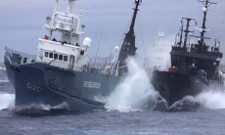
Japanese whaling ship No 3 Yushin Maru (left) and the Sea Shepherd's vessel Bob Barker collide last year. Photograph: AP
Japan's whale hunts have become increasingly tense in recent years because of clashes with the Sea Shepherd Conservation Society. The most recent expedition was cut short after several high-seas confrontations, and it was unclear whether the hunt would be held at all this year.
But the fisheries minister, Michihiko Kano, said on Tuesday that measures would be taken to ensure the whalers' safety, and that the hunt would go ahead. It is expected to begin in December.
"We intend to carry out the research after enhancing measures to assure that it is not obstructed," he said.
Commercial whaling has been banned since 1986, but Japan conducts hunts in the Antarctic and the north-west Pacific under an exception that allows limited kills for research purposes. Tokyo claims the research is needed to provide data on whale populations so that the international ban on commercial whaling can be re-examined based on scientific studies.
Opponents say the programme is a guise for keeping Japan's dwindling whaling industry alive. The Sea Shepherd group, which is already rallying to block the upcoming hunt, has been particularly dogged in its efforts to stop the kills.
Last year's season was marred by repeated incidents with Sea Shepherd vessels, one of which sank after colliding with a Japanese ship. The boat's New Zealand-born captain, Peter Bethune, was later arrested when he boarded a whaling ship from a jet ski, and brought back to Japan for trial. He was convicted of assault, vandalism and three other charges and given a suspended prison term. Bethune has since returned to New Zealand.
Sea Shepherd recently announced that it is calling its effort to obstruct the December expedition Operation Divine Wind — a reference to the kamikaze missions flown by Japanese pilots during the second world war.
Though vilified by anti-whaling organisations around the world, Tokyo's strong pro-whaling position has the support of the Japanese public, according to an AP poll conducted in July and August which found that 52% favours it, with 35% neutral and 13% opposing it.
Once a common item on school lunch menus, whale meat can be found in stores and restaurants in Japan. But, because of its relatively high price, it is generally regarded as a gourmet food by the public.
European poll of public perception of climate change in the marine environment
CLAMER, the Climate Change & European Marine Ecosystem Research body, has just placed on the web the first European poll of public perception of climate change in the marine environment.
The widely researched results show the degree of understanding and attitudes from the various countries of the EU, and act as an educational indicator as to how effective the various bodies concerned have been in effecting public knowledge and awareness of this most important of all environmental issues. They thus serve to inform us as to where we must place our efforts in the future, particularly in the UK.
UK citizens appeared to be well informed about the magnitudes of changes in the ocean in the past and of anticipated changes in sea temperature or sea level rise in the future, but less informed about other important issues such as ocean acidification and the arrival of non-native plant or animal species. They were significantly more concerned about coastal erosion and sea level rise than other European nations.
UK citizens trust newspapers as a source of information on climate change in the sea is far less than their mainland European counterparts, but they trust television slightly more. Scientists working in universities or for environmental NGOs are trusted as a source of reliable evidence, more than those working for government or in industry, and also more than politicians, the European Union, family and friends.
The document showing the responses and concerns is to be seen on the CLAMER website.
Bristol Channel's Atlantic Array offshore windfarm commences public consultation
RWE NRL intends to submit an application in 2012 to the Infrastructure Planning Commission (IPC), or successor body, to develop a new wind farm in the Bristol Channel to be known as Atlantic Array Offshore Wind Farm.
The scoping report for the proposed EIA of the project has already been published and contains plans of the offshore and onshore components of the project. This can be found on the Atlantic Array website; www.npower-renewables.com/atlanticarray
The proposed Atlantic Array Offshore Wind Farm project site area is located within the Bristol Channel. The export cable route extends from the edge of the wind farm to the landfall in north Devon bringing the power generated from the wind farm ashore. The offshore site, excluding the export corridor, extends over approximately 500km2 in an average water depth of 45m.
At the closest point to shore it would be approximately 14km from the north Devon coast, approximately 16km from the south Wales coast and approximately 13km north of Lundy. As it is early in the development process the megawatt size of the turbines to be used is undecided, however it is expected that the proposed Atlantic Array project would consist of between 188 (8MW) and 416 (3.6MW) turbines with a total capacity of approximately 1,500 megawatts.
In addition to the offshore elements of the scheme, Atlantic Array will also require associated development onshore, comprising electrical infrastructure to enable the electricity generated by the offshore wind turbines to be transferred into the National Grid transmission system.
The onshore development includes the landfall site and the onward terrestrial cable route from the landfall location to the agreed grid connection point at Alverdiscott. This is currently a 400kV substation, approximately 5km to the south of Bideford, north Devon. The substation will be expanded and re-developed to house the equipment needed to transform the voltage coming in from the wind farm to the voltage being distributed via National Grid.
Consultation responses must be received by 5pm on 10th November 2011.
Write to: Atlantic Array Offshore Wind Farm, RWE Npower Renewables Limited, Auckland House, Lydiard Fields, Great Western Way, Swindon, Wiltshire SN5 8ZT or e-mail: atlanticarray@npower-renewables.com
Arctic summer sea ice melting in 2011 exceeds all previous records
Arctic sea ice has melted to a level not recorded since satellite observations started in 1972 — and almost certainly not experienced for at least 8,000 years, say polar scientists.
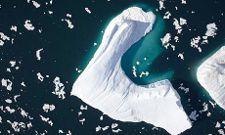
Aerial view of the Petermann glacier, Greenland's north-west coast — a 100 square-mile block of ice broke off it in August last year; by July this year it had melted. Photograph: Nick Cobbing/AFP/Getty Images
Daily satellite sea-ice maps released by Bremen university physicists show that with a week's more melt expected this year, the floating ice in the Arctic covered an area of 4.24 million square kilometres on 8th September. The previous one-day minimum was 4.27m sq km on 17th September 2007.
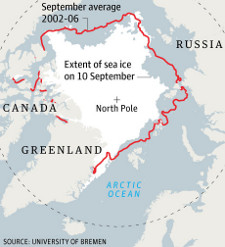
The US National Snow and Ice Data Centre (NSIDC) in Boulder, Colorado, which also tracks the extent of sea ice, has not posted data for a week but is expected to announce similar results in the next few days.
The German researchers said the record melt was undoubtedly because of human-induced global warming. "The sea-ice retreat can no more be explained with the natural variability from one year to the next, caused by weather influence," said Georg Heygster, head of the Institute of Environmental Physics at Bremen.
"It seems to be clear that this is a further consequence of the man-made global warming with global consequences. Climate models show that the reduction is related to the man-made global warming, which, due to the albedo effect, is particularly pronounced in the Arctic," he said. The albedo effect is related to a surface's reflecting power — whiter sea ice reflects more of the sun's heat back into space than darker seawater, which absorbs the sun's heat and gets warmer.
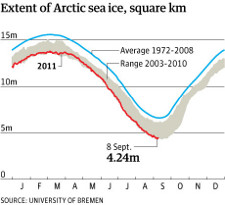
Floating Arctic sea ice naturally melts and re-freezes annually, but the speed of change in a generation has shocked scientists — it is now twice as great as it was in 1972, according to the NSIDC, with a decline of about 10% per decade.
Arctic temperatures have risen more than twice as fast as the global average over the past half century.
Separate, less reliable, research suggests that Arctic ice is in a downward spiral, declining in area but also thinning. Using records of air, wind and sea temperature, scientists from the Polar Science Centre of the University of Washington, Seattle, announced last week that the Arctic sea-ice volume reached its lowest ever level in 2010 and was on course to set more records this year.
The new data suggests that the volume of sea ice last month appeared to be about 2,135 cubic miles — just half the average volume and 62% lower than the maximum volume of ice that covered the Arctic in 1979. The research will be published in a forthcoming issue of the Journal of Geophysical Research.
If current trends continue, a largely ice-free Arctic in the summer months is likely within 30 years — that is up to 40 years earlier than was anticipated in the last Intergovernmental Panel on Climate Change (IPCC) assessment report.
The last time the Arctic was incontestably free of summertime ice was 125,000 years ago, at the height of the last major interglacial period, known as the Eemian.
"This stunning loss of Arctic sea ice is yet another wake-up call that climate change is here now and is having devastating effects around the world," Shaye Wolf, climate science director at the Centre for Biological Diversity in San Francisco told journalists.
Arctic ice plays a critical role in regulating Earth's climate by reflecting sunlight and keeping the polar region cool. Retreating summer sea ice is widely described by scientists as both a measure and a driver of global warming, with negative impacts on a local and planetary scale.
This year, both the North-west and North-east passages were mostly ice free, as they have been twice since 2008.
Last month, the 74,000-tonne STI Heritage tanker passed through the North-east Passage with the assistance of ice breakers in just eight days on its way from Houston, Texas, to Thailand.
The north-east sea route, which links the Atlantic to the Pacific, is likely to become a commercial ship operator's favourite, saving thousands of miles and avoiding tolls on the Suez Canal tolls.
Further evidence of dramatic change in the Arctic came last week from Alan Hubbard, a Welsh glaciologist at Aberystwyth University, who has been studying the Petermann glacier in northern Greenland for several years.
The glacier, which covers about 6% of the icecap, is 186 miles (300km) long and up to 3,280ft (1km) high. In August last year, a 100 square-mile (260sq km) block of ice calved from the glacier. Photographs show that by July this year it had melted and disappeared.
"I was gobsmacked. It [was] like looking into the Grand Canyon full of ice and coming back two years later to find it full of water," said Hubbard.
Last year (2010) tied with 2005 as the warmest year on record.
Oceana report shows that EU fishing subsidies equal half the value of the annual catch
Oceana, the American marine environmental organisation based in Washington D.C. has issued a press release dated 13th September 2011 in which it records the enormous scale of EU subsidies via the Common Fisheries Policy to the EU fishing industry, along with a further report on the condition of the world's fisheries. Oceana states:
"The world's oceans are nearing irreversible collapse. Most of the world's fisheries are fully exploited or facing overexploitation and depletion. In Europe, the oceans are equally in crisis. Only a minority of commercially fished stocks have been assessed or are managed. Of the fish stocks that have been scientifically assessed, the majority are overfished. An increasing number of marine species are threatened, with some nearing extinction.
"The European Union fishing industry receives a significant amount of government subsidies. These subsidies have promoted the massive overcapacity of European fishing fleets. The European fishing fleet is now two to three times greater than what is needed to fish sustainably.
"This report attempts to provide an as complete as possible overview on the sources and amounts of subsidies available to the European Union fishing sector for the most recent year available. The paper also provides a country-by-country analysis and evaluation of subsidy intensity as an indicator of economic performance."
MARINET provides here the text of the Oceana report titled:
The European Union and Fishing Subsidies.The European Union and Fishing Subsidies
- Taxpayers throughout the European Union (EU) finance the subsidies given to the fishing sector.
- Despite the precarious condition of fisheries in Europe and beyond, the EU continues to provide massive subsidies to support its fishing fleets.
- Europe is currently one of the world's top three subsidisers, along with China and Japan.
- Subsidies available to EU fishing fleets totalled €3.3 billion in 2009, which is more than three times the publicly available figures referenced in the past.
- Total subsidies to the fishing sector are equivalent to 50 percent of the value of the total fish catch by the EU in the same year (€6.6 billion).
- Fuel subsidies amount for half of all EU fisheries subsidies.
- Spain, France, Denmark, the United Kingdom and Italy received the most fishing subsidies.
- Thirteen EU countries had more fishing subsidies than the value of the landings of fish in their ports.
- Growing demand for fish, combined with local resource depletion, has promoted the major expansion of European fleets in size and fishing range.
- As a result of these major subsidies, the EU now has a fishing fleet that is estimated to be two to three times larger than what sustainable limits would allow.
- More than two-thirds of these EU subsidies have the ability to enhance fishing capacity and promote overfishing.
- A recent economic analysis by the European Commission revealed that despite subsidies, 30 to 40 percent of the fishing segment it assessed suffered losses each year from 2002 to 2008.
- In 2009, close to €150 million was paid to 14 countries to secure access to fisheries for European fleets.
To view the Oceana Report on The State of the World's Fisheries, visit http://na.oceana.org/sites/default/files/reports/Oceans_in_Trouble_with_EU_Facts_FINAL_FINAL.pdf
Natural England explains the way forward on Marine Conservation Zones
Natural England has published its Newsletter Issue 6 in which its explains the way forward in the process to establish Marine Conservation Zones in English seas now that the four Regional Stakeholder Groups have identified 127 potential sites.
Key to this process will be the Impact Assessment of these Marine Conservation Zones (MCZs) in each regional area of English seas (Irish Sea, South West Seas, Eastern Channel, and North Sea). The Natural England Newsletter advises:
The Impact Assessment
"Over the next few months, the regional MCZ projects will continue to work with JNCC and Natural England to deliver an Impact Assessment (IA) for the proposed MCZs. It will be prepared and consulted on (as part of the public consultation managed by Defra) to ensure that people with an interest in the marine environment understand and can challenge:
- how and to what extent the proposed MCZs may impact on them; and
- the estimated economic, environmental, and social costs and benefits of the proposed MCZs.
"The IA consultation will also give affected parties an opportunity to identify potential unintended consequences. The IA will:
- Summarise the regional MCZ project recommendations.
- Summarise the benefit of designating the recommended MCZs.
- Identify activities that would need to be managed in order for the conservation objectives of the recommended sites to be achieved.
- Identify possible management measures.
- Assess the impact of designating the recommended MCZs on different sectors on a site-by-site basis, and a regional basis where appropriate.
- Provide information on the evidence used to identify the possible management measures and assess the impact of designation.
"The regional stakeholder groups and named consultative stakeholders will be given an opportunity to review the IA before it is submitted and the wider public will be able to comment on the findings in the IA during the public consultation.
The Final Stages
"Once the regional MCZ project site recommendations, impact assessment and Natural England and JNCC's advice has been received, Ministers will consider the supporting evidence and potential environmental, social and economic impacts, before deciding sites to take forward for consultation and designation. The factors considered in reaching the Government's decisions, will be made clear in the public consultation documentation. The public consultation on sites the Government intends to designate is expected to take place next year, and will be an opportunity for stakeholders to review, comment and feedback to government on the proposed designation decisions before they are finalised.
Ongoing Engagement
"Most of the contribution needed from stakeholders to make well supported, well informed recommendations for MCZs, has now been captured through a wide variety of engagement including negotiations, meetings, facilitated workshops, interviews and data sharing. The amount of direct input from stakeholders into the designation process will reduce when the regional MCZ projects handover to Natural England and JNCC. However, we recognise the need to continue to involve sea users and interest groups and keep them well informed of progress and provide the required transparency:
- We will keep stakeholders updated through the MCZ Project newsletter.
- Queries can be answered through the Project e-mail address or through Natural England local advisors and JNCC international advisors.
- Some direct engagement with Regional Stakeholder Group members and named Consultative Stakeholders will be maintained to quality assure the process at various stages.
- The public consultation will be another opportunity for stakeholders to have their say."
127 sites go forward for consideration as Marine Conservation Zones in English seas
Much of the sea around the Isle of Wight and the Isles of Scilly , major estuaries and islets off the east coast, as well as reefs, trenches, sandbars and remote places seldom seen by humans, are included in a list of 127 sea areas that have been proposed as new nature reserves.

Jewel anemones (Corynactis viridis) at the Lizard peninsula in Cornwall. The MCZs will protect rare and threatened marine wildlife and habitats. Photograph: Paul Kay/Natural England
The zones range from a giant 5,800 sq km (2,240 sq mile) patch on the edge of British territorial waters in the western Channel to a minute 0.09sq km speck of rock off Dorset, from the sea floor below some of the busiest shipping lanes in the world in the Channel to the muddy waters off the northern Irish coast where Dublin Bay prawn thrives.
The total area expected to be named as new nationally important marine conservation zones (MCZs) is more than 37,000 sq km — about twice the size of Wales. Nearly half the sites are off the south-west coast and in the Channel. Wales and Scotland are expected to designate other marine conservation areas later this year.
"Together they will conserve a mixture of wildlife, habitats, geology and geomorphology," said a spokeswoman for the MCZ project. "They are being recommended not just to conserve the rare and threatened, but the range of marine wildlife — from seahorses to sunset cup corals, and from honeycomb worm reefs to estuarine rocky habitats in English waters."
The project has conducted more than 2,500 interviews and held 155 meetings in what has been called a "people to parliament" approach to decision-making.
Conservationists have welcomed the list as one of Britain's most significant natural protection initiatives in decades, but said that the level of safeguards proposed for the nationally important sites varied from tight to potentially weak. Decisions about how the sites are managed, and what activities can or cannot take place in them, will only be made once formal designation is confirmed next year.
However, only 20 of the 127 sites are proposed to be highly protected "reference" sites where any exploitation or damage by industry will be banned. Nearly half the sites are expected to contain highly protected areas within them, while the oil and gas, wind and dredging industries will be allowed some access in some areas. Only 2% of the sites are expected to be given full protection.
In what has been described as "robust" arguments, industry objected to some areas and conservationists had to compromise to arrive at the final list.
"Sites we were sorry to see dropped due to industry concerns include Flamborough-Helgoland, the north Norfolk chalk reefs and the Farne Islands," said the Marine Conservation Society (MCS), one of the many organisations that helped to determine the sites.
But other landmark places proposed by ecologists were chosen, including the Needles off the Isle of Wight and the Manacles rocks off Cornwall.
"Protected sites are desperately needed to protect our seas so that marine habitats and ecosystems can begin to recover from decades of degradation," said Richard Harrington of the MCS.
"Conservation for the UK's marine environment has taken a major step forward. The thousands of species of sealife and habitats that live hidden under our waters need just as much protection as those that we can see on land," said marine minister Richard Benyon.
The unique process of allowing sea users to choose the sites rather than government took nearly two years, but is expected to avoid arguments and disputes later.
Unlike proposals for forests and planning areas, which were decided by government ministers without proper consultation, the 127 sites were only recommended following long negotiations between dozens of sea users and interest groups — including the oil and gas, wind and fishing industries, eco-tourism and conservation groups, ports and shippers.
"It has been challenging. Over 2,500 interviews have been conducted and 155 meetings held. Over 1 million individuals' interests have been represented, and it has enabled marine industries such as fishing, ports and offshore renewable energy to share their views alongside conservationists, landowners and recreational sea users," said the MCZ spokeswoman
Southwold: New delay in oil tanker saga
New legislation limiting the controversial practice of ship-to-ship oil transfers to waters off the Suffolk coast has been delayed for six months.
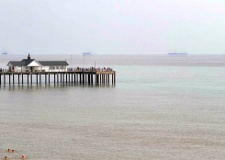
Tankers anchor off the coast at Southwold
The new regulations were due to come into force on 1st October but the Department for Transport (DfT) has admitted there has been a delay, caused by the process of reversing previous legislation to outlaw the practice.
Southwold residents reacted with dismay earlier this year when it was announced that oil transfers between tankers in UK waters would be restricted to Sole Bay.
They have campaigning against the move, pointing out the previous Government was set to ban the transfers altogether — a policy overturned by the new administration.
A spokesman for the DfT confirmed the regulation was being deferred, and was now due to come into force on 1st April.
There had been speculation in Southwold and Lowestoft about the future of the practice after a noticeable drop in the number of ships visible on the horizon.
But any suggestion that a decision had been taken to carry out transfers off the Dutch coast to avoid further controversy has been quashed.
The DfT confirmed there had been no shift in policy and SPT Marine, one of the companies which carries out the transfers, said the situation was solely down to market conditions.
The main reason we haven't seen activity off Southwold and Lowestoft is down to the economic situation — traders are not trading and it is quiet in all three locations where we do business," said a spokesman.
"We have 100% not made a decision to move the location of transfers and it would not be our decision anyway."
Campaigners have warned the transfers have a harmful impact on the tourism industry and any spillage of oil would be disastrous for Suffolk's Heritage Coast.
They were angered when the new coalition Government overturned previous legislation which would have banned the transfers — and nominated the waters off Suffolk as the only permitted zone for the practice. The area stretches 12 miles out to sea.
But the Government and oil companies insist the practice is strictly monitored to the highest safety standards.
New Arran proposed marine reserve to be centred on habitats that assist herring spawning
The Community of Arran Seabed Trust (www.arrancoast.com) reports "Community proposals are now afoot for a larger network of angler-friendly Marine Protected Areas (MPA) around the COAST of Arran that would also permit creel-fishing and diving.
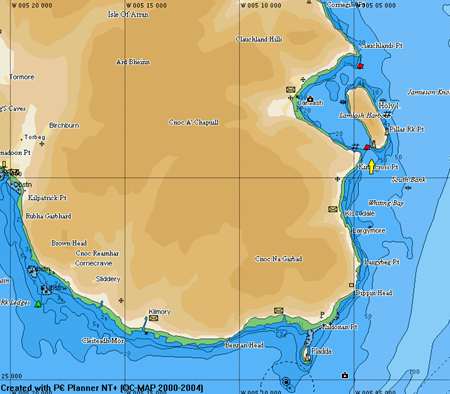
"COAST's AGM on the 3rd March 2011 — announced and gained initial support for — a proposal to establish a larger Marine Protected Area (MPA) off the coast of Arran. The main drive behind the MPA is to protect the coastal waters from bottom trawling and dredging activities — it will not affect static creel fishing or recreational sea-angling. Further meetings are now planned in villages around the island over the coming months and COAST hopes that there will be widespread feedback from around the island about the proposals.
"Initial draft proposals suggest the MPA could stretch south from the Dhunnan (one mile north of the existing No Take Zone (NTZ)) to encompass the whole of Lamlash Bay around the eastern Arran coast, continuing around Pladda island and along the southern coast to beyond the reefs known as the Iron Rock Ledges off Corriecravie. The MPA outer boundary could be marked by a straight line boundary, possibly three miles off shore, as suggested by Arran's last creel fisherman who has extensive knowledge of the whole area. Along with SNH and Marine Scotland Compliance we have learned that whatever the site that is designated for protection, a larger buffer zone needs to be implemented at the same time, in order that the site has appropriate protection against damaging impacts.
"A Marine Protected Area is not the same as a No Take Zone. The proposed MPA will not stop anglers, divers or creel fishermen from operating in the area. It is proposed that it affect only the less selective and more intensive and damaging fishing methods of bottom trawling and dredging.
"There are a whole range of reasons why the MPA would be of benefit On a purely scientific level, the area contains many Priority Marine Features including :—
- at least seven maerl beds;
- probably the largest area of remaining seagrass in the Clyde,
- muddy substrate with sea pens;
- important tidal rocky reefs, one of which has the only known jewel anemones in the Clyde area;
- extensive kelp beds along the south coast;
- an area south of Bennan Head which has historically been known as an important herring spawning area;
- the area also contains important resident seal and otter populations
"Besides the biodiversity advantages of this proposal, COAST are confident of broad community support. As you know COAST volunteers have many years of experience in canvassing for an MPA and NTZ, and doing basic research through Seasearch and diving. In addition we now have experience in the direct management of the NTZ. There are at least four clear additional reasons why an MPA on Arran would be a positive way forward:
- It would be ideally situated in the centre of the Firth of Clyde. The Clyde is desperate for renewal, sustainability and a strategy for management for the future.
- It is a rich biodiverse coastal environment which has already a considerable wealth of scientific knowledge, built up over time from both academic and community work.
- It is an ideal location for supervision and for further research with good access to mainland Scotland.
- COAST could be pivotal in facilitating some of the studies.
"Although we have a large amount of scientific data for most of the proposed area, there are still a few locations along the south coast that we intend to survey within the next six months. COAST feels that this area should be in SNH's proposal to the Scottish Government. If this proposed MPA is not accepted as a direct SNH proposal, COAST would wish to propose it as a third party designation. But for now, we will hold a number of community meetings to receive feedback about the proposals and gauge the general level of support. The 50 islanders present at COAST's AGM last month unanimously supported the idea. We look forward to updating you once the wider consultation has concluded."
Success of California MPA due to the involvement of fishermen
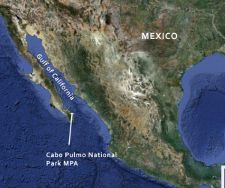
COAST (The Community of Arran Seabed Trust) report in their September newsletter "A Marine Protected Area (MPA) in the Gulf of California reveals an interesting lesson for the Scottish context. Over the past decade there has been a phenomenal recovery of marine life in Cubo Pulmo National Marine Park. A recent report showed that the amount of fish in the marine protected area (located off the Baja Peninsula) soared 463 percent between 1999 and 2009. Populations of large predator fish have recovered and the average biomass is five times larger than the average in comparable open access areas in the surrounding Gulf of California. It's a success story that is being heralded as an international model for marine conservation.
"Other MPAs in the area haven't been nearly as 'successful' and researchers attribute the Cubo Pulmo success as much to the socio-economic context as any underlying ecological factors. Local skippers, dive masters and residents have all been firmly supportive of the MPA, promoting and self-enforcing the reserve.
"A study of the findings concluded that: "Protected areas with locally managed resources and stakeholder buy-in can be more successful than areas with top down, federally mandated preservation. This model is considered the most viable in rural settings where people rely on local natural resources for their livelihoods."
"It's a simple, interesting point. People who very directly depend on the health of the marine resource are most likely to do the right thing by the ecology upon which their jobs rely. In Scotland, this link is more complicated. Some of the revenues flowing from Scottish fisheries do get recycled locally in the form of jobs, but much of the value is absorbed by large, nomadic fishing boats and remotely-located processors. No longer do all coastal communities immediately feel the pinch when local fisheries are in decline.
"At root though, we do still all depend upon the health of the marine resources. A productive commercial fishery and the marine tourism that can flow from it can be a critical part of Scotland's future economy. This requires imagination. And many, for example, still have the memory of the recreational sea angling which brought so much well-distributed wealth to the Clyde. The success — or otherwise — of Marine Protected Areas in Scotland as a measure to help regenerate the resource, will boil down to whether people see the long-term interest for their local communities."
Marine Management Organisation publishes 2010 UK fishing industry data
The Marine Management Organisation's (MMO) UK Sea Fisheries Statistics provides a broad picture of the UK fishing industry and its operations. The coverage includes the Isle of Man and the Channel Islands with separate figures for England and Wales, Scotland and Northern Ireland. UK Sea Fisheries Statistics 2010 will be published on 29th September 2011.
In response to recommendations from the MMO's user consultation in 2010, the MMO is now releasing sections of its publication early as soon as data are available.
The UK Fishing Industry: Landings contains information published in chapter 3 of UK Sea Fisheries Statistics. The publication provides a comprehensive overview of the quantity and value of species landed by UK and foreign vessels into the UK and by UK vessels landing abroad. It includes breakdowns by:
- vessel nationality
- port and country of landing
- area of capture and fishing gear used
- vessel size and sectoral membership.
The UK Fishing Industry: Structure and Activity contains information published in chapter 2 of UK Sea Fisheries Statistics. The publication covers:
- the size and composition of the UK fishing fleet
- number of fishermen on UK registered fishing vessels
- accidents involving fishing vessels and fishermen
- fishing effort by UK vessels, including expanded coverage of effort in the cod and sole recovery zones and the Western Waters.
Source: MMO, September 2011
COAST disputes Clyde fishery management plan
The Clyde Inshore Fishery Group (IFG), one of six pilot IFGs set up by the Scottish Government for the management of fisheries in Scotland's inshore waters (out to 6 nautical miles), has published its draft Management Plan for the Firth of Clyde fishery.
The fishery in the Firth of Clyde has experienced severe decline over historical time due, it is argued, to over-fishing which has led to an ecological meltdown. This argument is recorded by Dr. Ruth Thurstan and Prof. Callum Roberts, York University, titled Ecological Meltdown in the Firth of Clyde, Scotland: Two Centuries of Change in a Coastal Marine Ecosystem, published 2010. The fishery in the Firth of Clyde today is largely confined to its shellfishery, based on Prawns (Nephrops norvegicus), Brown Crab (Cancer pagurus), Velvet Crab (Necora Puber), European Lobster (Homerus Gammarus), King Scallop (Pecten Maximus) and Queen Scallop (Aequipecten Opercualis).
In the Clyde IFG's current draft management plan it appears that old ways still prevail, with Brown Crab, Velvet Crab and Lobster stocks being recorded (ref. page 140) as still being fished between the period 2006 and 2008 at levels above the maximum long term sustainable yield.
The Community of Arran Seabed Trust (COAST) has reported in its September newsletter that it attended a public consultation event organised by the Clyde IFG and records that a Voice of Arran report stated that "neither consultation nor discussion was seriously on the menu". COAST has submitted its own response to the Clyde IFG draft management plan, concluding that "the Plan is without any clear proposals to protect and restore the damaged inshore marine ecosystem and completely disregards those marine stakeholders who are not mobile fishermen." The full COAST report can be read here.
Pollution disaster fears as rescue tugs are ditched
Britain is abandoning its first line of defence against oil tanker pollution disasters, four ocean-going tugs stationed around the coastline to help vessels in distress.
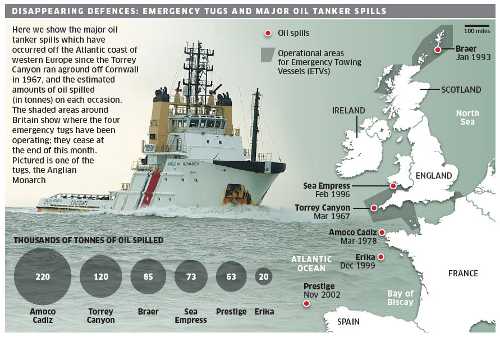
The four tugs, put in place as a result of the calamitous oil spill from the tanker Braer, which ran aground in Shetland in 1993, are to come out of service in a fortnight as part of the Government's public spending cuts.
The move, which will save £8m a year — vastly less than the cost of dealing with any major oil spill – goes against the clear recommendations of the Maritime and Coastguard Agency and is being described by concerned MPs as "inviting disaster" and "crazy".
The Government hopes that commercial tug operators will fill the gap when needed, but there is great concern that while this may happen in the Channel and the Southwest Approaches, it will be impossible in Scotland's Northern and Western Isles – which are both the most environmentally sensitive waters around Britain and the most dangerous to shipping.
The four tugs, or emergency towing vessels (ETVs), have been stationed since 1995, at public expense, in four zones around Britain: the Dover Strait, the Southwest Approaches, the Minches (the Hebrides) and Fair Isle (the Shetland Islands).
They are sturdy vessels, much stronger than harbour or coastal tugs, fitted with powerful towing gear which enables them to take even the largest supertankers under control.
They were put in place after a direct recommendation from Lord Donaldson in his report on the grounding of the Braer on the Shetland coast in January 1993, which saw nearly 85,000 tonnes of oil spilled and the mass deaths of seabirds.
MARINET makes submission to UK Parliament's EFRA committee about CFP reform
The House of Commons Environment, Food and Rural Affairs (EFRA) Committee is considering the adequacy or otherwise of the Common Fisheries Policy reform proposals announced by the European Commission on 13th July 2011 — http://ec.europa.eu/fisheries/reform/index_en.htm. The EFRA Committee has set out a number of questions to test its perception of adequacy, and has invited public comment referenced to those questions. MARINET has responded to this invitation, identiftying the cardinal objective of CFP Reform as being the restoration of food security and the associated management regime required in order to deliver food security. MARINET's submission may be viewed here — www.marinet.org.uk/rocfp.html#efr.
Protection of Norfolk's Sheringham reef and seven other Norfolk coastal gems in the balance
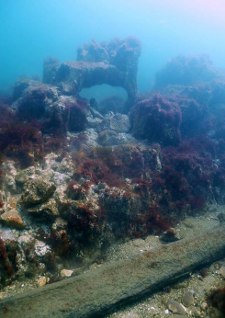
Europe's longest chalk reef, off Sheringham, could become a marine conservation area. PHOTO: Rob Spray and Dawn Watson.
From Steve Downes in the EDP of 9th September 2011 under the title 'Sheringham reef and seven other Norfolk coastal gems could get special protection' the progress in obtaining the required protection status of Norfolk's valuable marine sites is in the balance.
Whilst Sheringham Reef (Europe's longest that runs offshore from Sheringham to Mundesley) and seven other Norfolk coastal gems could get special protection by becoming Marine Conservation Areas (MCAs) disappointment has been registered that greater protection has not been afforded. Other deserving cases have not even been given the nod for this by the government.
Meanwhile, seven special spots on the county's coast have been included at the higher level, in a list of possible "reference areas" in the proposals to ministers. The areas have been identified for supporting special animal, bird or plant species — and will be held up as examples of what can happen when there is no human interference in an environment.
The locations likely to be 'reference areas' are:
- An area five miles off Trimingham, where there is a high density of blue mussels
- Two saline lagoons — Seahorse Lagoon and Arnold's Marsh — at Cley Marshes nature reserve, which were recommended for their starlet sea anemones
- Another area at Cley Marshes, which is seen as special for its saltwater reedbeds
- A spot at Morston salt-marsh, to protect the coastal salt-marsh and saline reedbeds
- An area of Stanley's Cockle Bight at Blakeney Point, chosen for its seagrass bed
- The peat and clay beds near Holme-next-the-Sea, in the area where Seahenge was found
- The Wash Approach, 27km off the Lincolnshire coast, where the seabed supports a diverse range of flora and fauna.
More than 100 MCZs have been proposed as a response to the 2009 UK marine bill, which portends to give formal protection to more than 25pc of the nation's coastal waters — up from the current 1pc. These will be assessed by an 'expert panel', which will decide levels of protection before the government makes its final decision, probably next year.
The proposal to earmark the Sheringham reef as an MCZ came after in-depth talks with interested groups formed by dredging firms, fishermen, divers and windfarm companies.
Rob Spray from the Marine Conservation Society, whose underwater photography helped to reveal the extent of the Sheringham reef and the wildlife it supports, had misgivings. He said: "The lack of the reference area for the chalk reef is the biggest oversight. It would be a chance to monitor the health and confirm the importance of the chalk — so recently brought to public attention." He said making it an MCZ would be no more than the "status quo", and meant there was "no chance of seeing how it would thrive if completely left alone".
Whilst he admitted that it meant it "would not be allowed to get any worse", he added that "intractable objections" from opponents had "blocked" the idea of bolstering protection.
The ultimate aim of the bill claims to be to safeguard important natural habitats while allowing others activities such as angling, commercial fishing, surfing and marine dredging to go ahead, this seen by MARINET and other marine conservation bodies as being totally incompatible.
Dr Peter Richardson, biodiversity programme manager at the Marine Conservation Society, said: "We think we need these protected areas to allow areas of the seabed to recover. Aggregate dredgers and fishermen have pretty much had free rein for centuries. The studies show a general degradation of seabeds and marine species. In order for our eco-systems to recover, we think there should be some areas protected. That will then lead to functioning ecosystems and sustainable fisheries."
Severely sick seal pups washed up along the north Norfolk coast
Lucy Chapman wrote in the Eastern Daily Press of Thursday, 8th September 2011 that animal rescuers are being inundated with calls to severely sick seal pups being washed up along the north Norfolk coast — but remain baffled as to what is causing them to become so ill.
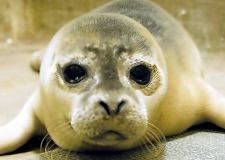
Mary Rose is the first common seal pup to arrive at the East Winch wildlife centre this season
Volunteers and members of the Seal and Bird Rescue Trust have been attending beaches from Winterton to Sheringham to pick up the emaciated and malnourished mammals, many of which have not survived. The Ridlington-based charity said it has been rescuing between two and four seals a day. The Trust has pointed to lungworm, a parasite known to be present in most seals, as one possible cause for the influx in the poorly pups. Beverley Cosse, Trust chairman, said: "We are losing common seals at a great rate and until the reason for this problem is discovered, work cannot begin on addressing it although research continues with great vigour. The lungworm parasite leaves the seals weak, starving and fighting for breath. Why they are being affected so badly we just don't know yet."
Seals rescued by the Trust have been taken to the RSPCA wildlife rescue centre in East Winch, west Norfolk, which has taken in 41 sick pups since June. The dead seals are due to have post mortems to try and discover if there was a common theme for their sickness. The underlying likelihood is starvation due to the few remaining fish in the North Sea, because the only common theme being that the victims are absolutely emaciated.
Last year the RSPCA East Winch centre took in an unprecedented 121 seals, which were suffering from a number of ailments including pneumonia, and it is hoped 2011's sudden influx of sick babies will not result in a repeat of 2010's high numbers."We can't explain it. Last year there was all sorts of reasons and (there) wasn't one specific disease."We had one last week come in at nine and a half kilos, it should be born at 10 kilos."
The Trust has now launched an emergency appeal for donations to help members to continue their work to rescue the seals. Cheques for The Seal and Bird Rescue Trust can be sent to The Barns, Mill Common Road, Ridlington, North Walsham, Norfolk, NR28 9TY or visit www.sealbirdrescuetrust.co.uk.
New Finding — Giant Underwater Waves
A newly found phenomena has recently been discovered that could have a major contribution to the variables of the sea and coastline, the fine details of which may be seen in the pages of First Science News.
David Farmer, a physical oceanographer and Dean of the URI Graduate School of Oceanography, University of Rhode Island, USA, together with student Qiang Li, reported at the Ocean Sciences meeting of the American Geophysical Union in Portland, Oregon, that they are gaining new insight into the mechanisms that have been recently found to generate the huge, steep underwater waves that occur between layers of warm and cold water in coastal regions of the world's oceans.
These large amplitude, non-linear internal underwater waves, linked to tides and Earth's rotation, have been seen to reach heights of 150 metres and more in the South China Sea. These modulate surface wave, making their presence observable from satellites in space.
According to David Farmer, non-linear internal waves impact the ocean in many ways — stirring up sediment on the sea floor, creating hazards to offshore engineering structures, interfering with submarine navigation, and greatly affecting propagation of underwater sound. Internal waves also appear to have significant ,but not yet fully understood, biological impacts, and in shallow water environments they can mix water masses and modify coastal circulation.
Obituary — Robin Chenery
We are sad to report that Robin Chenery has died recently as a result of a massive stroke.
Robin was a reliable, firm and consistent supporter of MARINET, NSAG and FoE, with his heart and soul in passionate support of defending the marine, coastal and Broadland environment. He never missed an opportunity to turn up at a meeting to firmly give his views.
He will be sadly missed by his colleagues.
The Encyclopedia of Life publishes its first pages
An ambitious attempt to create an encyclopedia of every known species on Earth has reached a major new milestone.
The Encyclopedia of Life (EoL) www.eol.org, a free and collaborative website, has announced that it now has pages for each of 750,000 species, meaning more than one-third of all the planet's 1.9m species are now covered.
For example, if one wishes to examine the entry on Cod (Gadus morhua) one simply goes to the website, enter the Latin (Linnean) name into the search box, and you end up with the following:
Brief Summary:
Like the herring, there are various races of cod, which differ in their growth rates, distribution and times of spawning. Most cod spawn between the months of January and April and a female, if she is large enough, can release up to five million eggs. Depending on the temperature, the eggs hatch in two to four weeks and the young cod drift in the open ocean, feeding on small crustaceans. Atlantic cod will eat a wide variety of prey, ranging from other fish (up to the size of herring) to worms; they also take swimming crabs, shrimps and prawns. The different races of this fish vary in the ages and weights attained before they become sexually mature. The migratory cod found off the coasts of Newfoundland, Iceland and Norway mature at around eight to 12 years old when they may weigh up to eight kilogrammes. Coastal cod mature more rapidly and may be able to reproduce at the age of three years.
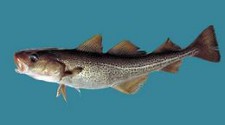
Full entry:
Overview
- Brief Summary
- Comprehensive Description
- Distribution
Physical Description
- Morphology
- Size
- Diagnostic Description
Ecology
- Habitat
- Migration
- Trophic Strategy
- Associations
- Diseases and Parasites
Life History and Behavior
- Behavior
- Life Cycle
- Life Expectancy
- Reproduction
Molecular Biology and Genetics
- Molecular Biology
Conservation
- Conservation Status
- Threats
- Management
Relevance to Humans and Ecosystems
- Benefits
It is also to to be noted that the EoL has more than 1m more pages in place awaiting content from partners and members. But a recent study estimated that there are a total of 8.7m species on Earth, excluding bacteria and viruses, suggesting many more pages will need to be added to EoL in the future.
MARINET identifies "food security" as the key objective of CFP Reform
In its advice to the EU Commission and to parliamentarians in the UK and throughout Europe, MARINET (www.marinet.org.uk) has made clear that the Common Fisheries Policy (CFP) has failed the people of Europe because, despite the CFP's legal obligation to conserve fish stocks, many stocks have declined so severely that we no longer enjoy food security — the ability to meet our needs for fish wholly from EU seas for all twelve months of the year, year after year. Thus, MARINET explains, the present reform of the Common Fisheries Policy must meet this legal obligation and set this as its primary objective.
Ocean 2012 (www.ocean2012.eu/) — which represents some 135 organisations seeking an ecosystem-based reform of the CFP — has identified in a report, titled Fish dependence: The increasing reliance of the EU on fish from elsewhere that the EU can now only provide for our needs for six months of the year, and the situation is continuing to deteriorate.
MARINET has researched the decline in North Sea commercial fish stocks between 1880 and 2010, and in the case of cod the decline is of the order of 90% — only one fish now for every ten that there used to be. Further, the loss of food security has been researched and recorded by MARINET in a North Sea Food Security graph where the decline in the cod stock has been recorded against the rise in the UK population during the period 1880 to 2010. Of particular interest is the pattern of the decline in the North Sea cod stock, showing a marked recovery during the periods of World War I and World War II when the fishery was closed, thus substantiating the belief that the closure of key fishery areas, centred on spawning and nursery grounds, is an effective management tool which can deliver a recovery in stock levels and thus re-establish food security.
MARINET has set out four key principles for CFP Reform.
- Firstly, the CFP must operate within EU and international law, implementing the precautionary principle and the ecosystem-based approach in the management of commercial fish stocks. If it fails to do this, the CFP is operating illegally and is open to legal challenge.
- Secondly, the idea of quotas being based on a stock's "maximum sustainable yield" — the catch which can be taken annually, year after year, without depleting the overall stock and its reproductive capability — must not be referenced to the current depleted levels of stocks (in large part due to over-fishing) but rather must be referenced to data on the historical levels of these stocks so that the stocks can be genuinely rebuilt, ecological and climatic changes permitting, with the result that these stocks can once again deliver their true potential yield.
- Thirdly, with fish stocks and their maximum sustainable yield referenced to historical levels, the principle of food security can be delivered, premised on the knowledge that historically referenced stocks sizes which once did deliver food security can now do so once again, with allowance for ecological and climatic changes taken into account.
- And fourthly, in order to deliver all the foregoing objectives, the reformed CFP must employ the management tools which will deliver these results. This means closed areas, centred on the spawning and nursery grounds of commercial fish stocks, which will allow fish to reach their full physical size and age profile which is indicative of a healthy stock. These closed areas, effectively fisheries-based marine reserves, will result in the displacement of fishermen from traditional fishing grounds. As a result it is essential that these fishermen are re-employed under the CFP as the managers of these sites, patrolling them and assisting in the monitoring and collection of scientific data. This way, fishermen retain an income and a financial investment in the reformed CFP, knowing that the fishery will be rebuilt and available to the future generations of their families.
The full record of MARINET's submissions to the EU Commission may be seen here www.marinet.org.uk/rocfp.html.
The lessons of Fukushima for our nuclear programme and its coastal sites
Areas surrounding Japan's crippled Fukushima nuclear plant could remain uninhabitable for decades due to high radiation, the government warned as it struggles to clean up after the world's worst nuclear disaster since Chernobyl.

Tokyo Electric Power Co (TEPCO)'s handout shows a worker in protective gear measuring radiation levels at the bottom of a ventilation stack standing between Fukushima Daiichi nuclear power plant's No.1 and No.2 reactors. Photo: Tokyo Electric Power Co/Handout
Japan faces the daunting task of decontaminating large areas of land around the Fukushima Daiichi nuclear complex, which is still leaking low levels of radiation nearly six months after an earthquake and tsunami triggered a nuclear meltdown.
In a meeting with local officials, the government estimated it could take more than 20 years before residents could safely return to areas with current radiation readings of 200 millisieverts per year, and a decade for areas at 100 millisieverts per year.
The estimates, which merely confirm what many experts have been saying for months, are based on the natural decline of radiation over time and do not account for the impact of decontamination steps such as removing affected soil.
A vast area is still uninhabitable around the Chernobyl plant 25 years after that disaster.
The Japanese government unveiled guidelines this week with the aim of halving radiation in problem areas in two years, but for spots with very high readings it could take much longer to reach safe levels.
"I can't deny the possibility that it could be a long time before people can return to and live in regions with high radiation levels," outgoing Prime Minister Naoto Kan was quoted by domestic media as telling Fukushima Governor Yuhei Sato.
Japan has banned people from entering within 20km (12 miles) of the Fukushima plant, located 240 km north east of Tokyo. Around 80,000 people have been evacuated since the 11th March quake and tsunami and many are living in shelters or temporary homes.
The government's announcement follows the release of data this week showing radiation readings in 35 spots in the evacuation zone above the 20 millisieverts per year level deemed safe by the government. The highest reading was 508 millisieverts in the town of Okuma, about 3km from the nuclear plant.
Kan, who has resigned as leader of the ruling Democratic Party of Japan amid intense criticism of his handling of the nuclear crisis, also told Sato that the government planned to build a temporary storage facility in Fukushima for radioactive waste.
The accident at the Fukushima plant is likely to have released about 15 percent of the radiation released at Chernobyl in 1986, Japan's Nuclear and Industrial Safety Agency has estimated.
But that is still more than seven times the amount of radiation produced by Three Mile Island accident in the United States in 1979, and experts have estimated Japan's decontamination efforts could cost as much as 10 trillion yen ($130 billion).
Note: The levels of radioactivity measured in soil samples in the Tokyo district due to radioactive fallout from Fukushima may be viewed here — www.radiationdefense.jp/en/investigation.
World's largest tidal energy array commences trials off French coast
Construction of the world's largest tidal array remains on course after the first of four 16 metre turbines set to be deployed off the French coast was towed out to sea for testing. The OpenHydro-designed device will be put through its paces for two months in 35 metre deep water off the island of Bréhat, near Paimpol in Côtes-d'Armor, Brittany.
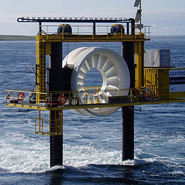
OpenHydro tidal array
Three more turbines will be added by 2012 to create France's first offshore tidal installation and, according to project developers EDF, the world's first grid-connected tidal energy farm. The French utility initiated the €40m (£35m) Paimpol-Bréhat project in 2004, but work did not begin until 2008.
When complete, the 2MW array will supply enough electricity to the French grid to power 4,000 homes, Openhydro said in a statement.
In related news, Ocean Power Technologies (OPT) announced yesterday that its PowerBuoy device recently deployed off the coast of New Jersey successfully withstood the severe conditions experienced during Hurricane Irene.
The PowerBuoy emerged from the two-day storm undamaged and fully operational, having maintained a continuous supply of electricity to the Navy communications and radar system it powers through waves approaching 15 metres high.
"Despite encountering significant wave heights, the buoy continued to produce power and operated exactly as designed for extreme sea conditions," said Charles Dunleavy, chief executive of OPT. "On Monday morning, after the storm passed, our PowerBuoy was right on station where it had originally been deployed and was operating to the Navy's specifications as it did prior to the storm. This achievement stands as an important testament to the skills and innovation of our engineering and operations teams."
Commercial agreement reached to exploit oil and gas in Russia's Arctic seas
In an age of diminishing resources but soaring populations, the scramble for the Arctic's riches continues. Months after BP's rival bid fell through, US oil giant ExxonMobil has just struck a £2bn agreement to develop vast hydrocarbon resources in the Kara Sea, off Russia's northern coast, in return for offering its Russian partner, Rosneft, assets in the US

Russian president Vladimir Putin (right) and Rex Tillerson of ExxonMobil during the signing of the arctic oil exploration deal. Photograph: Sasha Mordovets/Getty Images
In one sense the deal is, of course, a very welcome development. Far from fulfilling dark prophecies of conflict and confrontation between rival governments, the Arctic's resources are instead bringing nations closer together, moving in step with the mysterious, unpredictable pace at which regional ice is retreating: US experts, using advanced satellite information, have shown that ice in the Arctic Ocean is continuing to "decline at a brisk pace", even if this year's figure is not set to match the record low of 2007.
The deal represents a remarkable mutual interdependence and harmony. On the one hand, the Russian government, highly dependent on oil and gas exports for revenue, desperately needs advanced western technology and expertise if it is to have any hope of maintaining its current level of production. Meanwhile, western "supermajors" such as ExxonMobil are under constant shareholder pressure to "book reserves" by finding large sources of future revenue that will allow them to keep commercial pace with global, particularly Asian, competitors.
It is just such reserves that the Arctic appears to offer. A 2008 survey by the US Geological Survey estimated that the region appears to harbour around 13% of the world's undiscovered oil resources and 30% of its undiscovered natural gas. And the relatively shallow waters of the Kara Sea are particularly appealing.
In this respect, this week's agreement represents a positive step — one that will reduce political rivalry and tension between the two respective governments, both of which will have much to gain from oil revenues when the deal is put into practice.
Nonetheless, the new agreement does give one major cause for concern. For as the Deepwater Horizon catastrophe showed so painfully last year (around 5m barrels of oil were lost as a result of BP's Macondo blow out), both parties need to give some reassurance that they will be doing their utmost to prevent and minimise any environmental mishap.
The Arctic region is particularly vulnerable to such mishaps for the obvious reason that the regional climate makes them much more likely. True, there is less ice than before — levels this year are said to be "exceptionally low" in the Kara Sea — but they can vary enormously from year to year, and icebergs, moving at fast speed, can still appear at any time of year. In difficult conditions, pipelines are not only more likely to crack, but any spillages are apt to be proportionately harder to find: it was no coincidence that BP's other recent environmental tragedy, the Prudhoe Bay oil spill in 2006, happened in a remote area of Alaska's North Slope.
It is true that, under the deal, the two companies have agreed to set up a joint research centre in St Petersburg to develop new ice-resistant drilling platforms and other technology. But these could take years, or even decades, to bear fruit; and in any case the agreement says nothing about the enhanced safety standards — such as a detailed clean-up plan to deal quickly and effectively with any spillage — that need to be rigorously enforced.
The Russians have an appalling track record on environmental safety — the way they have dumped radioactive waste into Arctic waters bears ample testimony to that — while ExxonMobil's critics allege that a company so concerned about shareholder returns could be tempted to cut costs and take environmental risks.
In particular, the two companies need to recognise that environmental safety is a matter of commercial self-interest. Any serious oil spillage would of course hugely damage their share price and, even if this remained just the stuff of nightmares, the power of the "ethical investor" should not be underestimated.
For Moscow, the costs of guarding oil installations, if they are targeted by protestors using similar tactics to those who boarded Cairn's rig off Greenland last summer, could also be considerable. And the mere threat of such protests would also further undermine Russia's battered image before international investors.
ExxonMobil and Rosneft could now seize this Arctic opportunity and break new commercial ground by signalling that they will respect the concerns of the environmental lobby and drill in Arctic waters only when strict safety standards have been met. And formulating and implementing those standards now offers the US, Russia and other international powers a fruitful way of working together.
Consultation on SAC status for marine reefs from Studland to Portland, Dorset
Natural England is currently undertaking a public consultation on Special Area of Conservation status under the Habitats Directive for marine reefs to be found in the coastal waters from Studland to Portland, Dorset. If you want to participate in this consultation, or simply learn further details, visit www.naturalengland.org.uk/ourwork/marine/sacconsultation/default.aspx
Shark Trust launches Petition to EU to prohibit "finning" of sharks
The Shark Trust (www.sharktrust.org) reports, 8th August 2011: "The European Union (EU) has unfinished business with sharks! In a petition launched today, European citizens are calling on EU fisheries ministers to make the push and protect sharks from overexploitation and to urgently strengthen the EU regulation that bans the wasteful practice of 'finning' (slicing off a shark's fins and discarding the body at sea).
"For five years, the Shark Alliance, EU fisheries and environment officials, and members of the European Parliament (MEPs) have been discussing the need to better protect sharks.
"After a sustained advocacy campaign from the Shark Alliance, two years ago EU Fisheries Ministers endorsed a sound EU shark Plan of Action that led to significant improvement in the conservation of these exceptionally vulnerable species. Yet, there is unfinished business.
"Targeted EU shark fisheries continue without limits, many endangered species remain unprotected, and the EU finning ban still has huge loopholes that make it possible to fin sharks without detection or punishment. However, there is opportunity for change with the release of the European Commission's proposal for a revised finning regulation expected this autumn.
"Public pressure across Europe has made a real and positive difference in shark conservation over the past five years, but we need another push to ensure loopholes in the finning ban are finally closed and ministers live up to the commitments of the EU shark Plan of Action", said Martin Clark, coordinator of the Shark Alliance.
Shark Alliance member groups, aquariums and other supporters will gather signatures for a petition urging policy makers to resist industry pressure and take the necessary steps towards sustainable shark fishing in Europe, by demanding:
- A complete ban on removing shark fins at sea, without any exception
- Shark and ray catch limits based on scientific advice and the precautionary approach
- EU and national protections for endangered shark and ray species
"Sharks, as top predators, play an essential role for the good health of our oceans. We call on European citizens to make their voices heard by signing the petition and calling for much needed protection of sharks from overexploitation and finning" said Ali Hood from the Shark Trust, a founder member of the Shark Alliance.
New calls for EU freeze on deep water oil drilling
The oil spill from Shell's Gannet Alpha platform in the North Sea has prompted new calls for an EU moratorium on deep water drilling. Green Scottish MPs have warned that a leak in deep water would be a lot harder to control.
"Now we see how easily accidents can happen in even much shallower water, and how long it can take to resolve this sort of incident… it is time to look again at a proper moratorium on deep water drilling," said Green MSP Patrick Harvie.
Green MEPs in the European Parliament also said such a moratorium was needed until EU rules on oil and gas offshore platforms are tightened. In October 2010, the parliament in Strasbourg rejected calls for a moratorium following the BP oil spill.
Green MEPs have also urged the European Commission to table a legislative proposal on offshore safety as soon as possible. This proposal, initially due before the summer break, is now likely to be put forward in September. The parliament will also vote on the commission's plans to update and unify EU rules next month.
On Sunday, Shell reported that the relief valve from which oil had been leaking was now closed. No oil has since been released but the company will continue to monitor the situation to ensure the closure was successful, it said. Shell has been criticised for its apparent failure to act quickly and to publish response plans.
In a statement issued on Monday afternoon, the UK government said Shell was now securing with concrete mattresses sections of the oil pipeline that are raised from the seabed. The work is expected to be completed over the next 36 hours
Arctic oil-spill contingency plan heavily criticised
An oil spill response plan is, all can agree, a critical document, particularly when drilling is breaking new ground in the Arctic. But Cairn Energy's plan, released despite their best efforts to keep it secret, has now been analysed and the verdict, say campaigners, is damning.
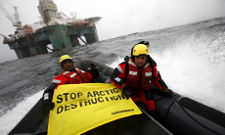
Greenpeace activists head towards the Leiv Eiriksson, one of Cairn Energy oil platforms in the Arctic Photograph: Jiri Rezac/Greenpeace
Professor Richard Steiner, formerly at the University of Alaska and an authority on oil spills, said Cairn "dramatically understates the potential size and impacts of a blow out… and dramatically overstates the potential effectiveness of any spill response."
The analysis comes from Greenpeace and Steiner, who resigned from his university over his anti-oil views, so it is not likely to be impartial. But you can see Cairn's spill response plan for yourself, in which a series of issues stand out. And don't forget two things: the shameful inadequacy of the response plan to BP's Deepwater Horizon spill and the full-steam ahead for Arctic oil and gas exploration represented by yesterday's multi-billion dollar deal between ExxonMobil and Rosneft.
So what have Greenpeace and Steiner found in the plan?
- Useless booms and skimmers: Cairn admits on page 78 of its plans that these conventional approaches to capturing spilled oil will be of "little or no use" and "very inefficient" in Arctic conditions.
- Arctic winter shut down of clean-up operations: The response to a spill during the Arctic winter "may be limited to monitoring the spill with recovery operations resuming once the thaw is complete", says Cairn on page 90. The problem there is that if a relief well is needed to stem a blow out, there would be a limited time to get it in before winter ice closed down operations. If unsuccessful, a blown out well would pump oil into the ocean unhindered for months.
- Shorelines that can't be cleaned. Cairn admits "the coastal environment in Greenland does not facilitate containment, recovery or protection due to the uneven rocky substrate that prevails in the region" (page 89) and says "in some circumstances oiled shorelines are best left to recover naturally" (page 90).
- Cleaning up ice, cube by cube: Cairn says that if ice and oil were mixed, it would cut out chunks of contaminated ice and melt them in a heated warehouse to recover the oil (page 70). To me, that doesn't sound like an operation that could work at scale and experts told Greenpeace there is no evidence that this technique is effective.
- Working in the dark. Cairn admits the near perpetual darkness of an Arctic winter would "cause serious operational complications" (page 70) during a spill clean up. It says "limited portable lights" are available for shoreline operations.
- Harm to wildlife: Cairn admits that significant long-terms impacts of a spill could be expected on narwhals, breeding colonies of Atlantic puffins and razorbill and other species (page 146). Steiner claims Cairn "dramatically understates the potential impacts".
- Dispersants ineffective: Cairn states that "low oil temperature increases viscosity" (page 70). Steiner says this renders the chemical dispersants used to break up oil ineffective, aside from their potential harm to wildlife.
Greenpeace are not happy. Campaigner Vicky Wyatt says: "It's no wonder Cairn Energy didn't want the public to see their secret spill plan. The company offers only giant assumptions and pie-in-the-sky solutions. This cowboy company are playing roulette with one of the most important and fragile environments on the planet, and must be stopped."
Cairn disagree of course. A spokesperson told me the company now welcomes the release of its spill response plan by the government of Greenland. She added: "This plan has been reviewed and approved by third parties including Oil Spill Response Limited, the Danish National Environmental Research Institute and the Greenland government. All are satisfied that the plan is robust and appropriately designed to deal with an incident in this area."
Ove Karl Berthelsen, Greenland's minister for industry and mineral resources, said: "All exploration is being carried out in accordance with the utmost focus on meeting the stringent requirements we have put in place focusing on safety and environmental protection. In addition, our supervision of these requirements is among the most stringent anywhere in the world".
The problem for me is that cleaning up oil spills are like putting toothpaste back in the tube: there's just no way to do it without making a big mess. As I have written before, the lure of the Arctic's sunken treasure is irresistible at present, despite the unique nature of the region and the extraordinary difficulty of operating there.
These spill response plans are in essence triumphs of hope over expectation, so I'll leave you with one more nugget from Cairn's plan: "Adult salmon and cod have been observed to avoid oil" (page 145). So, if there's a spill, the fish will just swim around it. Feel safe now?
Surfing in Gaza, despite all the obstacles
The Guardina reports "Twelve-year-old Sabah Abu Ghanim drags her board through the water as the sinking sun glints on the eastern Mediterranean. The wind has got up a little, and she is hoping the surf will follow — enough, at least, for her to ride the waves.
"I feel the sea belongs to me," says the Gaza surfer. "When I'm in the sea I feel content and happy."

Gazasurfer
Gaza's 25 miles of Mediterranean coastline are a magnet for a population with few forms of entertainment and a pressing need to escape the drudgery of life under blockade. A small but growing band of surfers use a variety of makeshift boards plus a few sent by surfer activists through the heavily controlled crossings from Israel.
"We have a problem getting equipment in, but these guys try to do the best for themselves," says Mahfouz Kabariti, president of the Palestine Sailing and Surfing Federation. "Always people are suffering from the siege, so they need some space to feel normal. This is good for their mental health."
Sabah was taught by her lifeguard father to use their 22-year-old surfboard, which is shared between friends and family. The first time, she says, "I put myself in God's hands. I said my last prayers. And I surfed a very high wave."
Now she studies TV and the internet to improve her technique. She, in turn, coaches others. "When my friends see me surfing they are very proud. They like it and ask me to teach them. They become surfers like me. Not exactly like me, not quite as good as me."
Gaza's beaches are along one of the few undeveloped stretches of Mediterranean coastline. There are no tourists to fill the handful of seafront hotels. A few beach cafés, some run by Hamas, attract locals outside Ramadan.
Ramshackle lifeguard towers are stationed periodically along the beach, but there are no signs warning swimmers of the greatest hazard — the sewage in the water. Up to 80m litres of sewage is dumped in the sea every day, causing diarrhoea and skin complaints among those who swallow the water.
Gaza's four sewage treatment plants cannot cope with the growing population, according to Ewash, a consortium of international and local NGOs. Israel's continued blockade prevents materials needed for maintaining and upgrading the plants from reaching Gaza, it says.
"People should be warned about swimming in areas close to sewage outlets," says Ghada Snunu of Ewash. "But it's not easy to tell people to stop swimming. The beach is the only recreation for the majority of Gazans."
After getting sick, Sabah says she has has avoided the most contaminated areas. But most people prefer to risk illness than give up one of their few pleasures. Her father, Rajab Aby Ghanim, 37, a self-taught surfer, is proud of his daughter's prowess and is planning to introduce eight-year-old Saja, Sabah's sister, to the joys of surfing. But, he says, "I have many problems with my daughters surfing. Many people criticise me. I asked my two older daughters to stop because of the community."
Sabah sometimes senses disapproval of her activities from some conservative Gazans. "There is a difference [between boys and girls]. When we are swimming in the sea and men see us, they are very surprised. They tell us to get out."
"When I am older, my society refuses to allow me to surf. It's shameful. I will keep surfing until then, and then I will have to stop. I will be sad," she says.
Once, she says, her 16-year-old sister to come to the beach to watch her surf. "I found her sad. I said, 'You keep wishing to go back to the old days because then you could surf and swim.' She said, 'I wish those days would return.'"
Her mother and aunts sometimes come to the beach to swim "if no one is around. But if others start to arrive, they get out and go home. We don't want people to talk about us."
But, for now, Gaza's surfer girl is riding the waves. "People are proud of us. They say, 'This is the first time we saw a girl who knows how to surf.'"
New sewage monitoring scheme trialled in Devon and Cornwall
A new sewage alert system for beachgoers has flagged up 48 sewage spills across Devon and Cornwall since it launched in June. The text and e-mail alerts are a trial collaboration between Surfers Against Sewage (SAS) and a number of water companies.
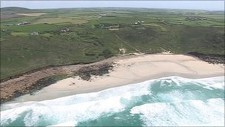
Cornish beach
Salcombe, in Devon, has had nine sewage alerts and Summerleaze beach in Bude, Cornwall, has had eight. SAS said the spills were happening "too frequently". The trial began in the South West on 20th June. It involves South West Water (SWW) informing SAS when sewage is discharged from Combined Storm Overflows (CSOs) near beaches. SAS then texts or e-mails the 1,500 subscribers to let them know about the sewage.
Andy Cummins, from SAS, told BBC News that SAS had been campaigning about sewage releases "for years". He said since the alert system had been operating, SAS was seeing "surprise, shock and disgust" from the public. "We have a [sewage] system that's full to the brim already," he said. "That's not acceptable, we need to work on improving the system."
South West Water said: "No other European country is offering this sort of live information on risks to bathing water quality. The system is broadly telling us what we and most beach users know — that storms can have a short term impact on the quality of the bathing water. We need to analyse the results carefully across the whole season and compare them with the sampling data to decide whether we need to make further investment at specific locations."
Mr Cummins said that if no sewage alerts were sent out beachgoers "should have confidence in the water quality."
The South West trial is due to end on 30th September but Mr Cummins said SAS hoped to work with the Environment Agency to introduce the alerts year round.
Sea Shepherd Prevents Pilot Whale Bloodshed in the Faeroe Islands
Sea Shepherd Conservation Society's Operation Ferocious Isles pilot whale defence campaign is almost over and it looks like their objective has been achieved. Not a single whale or dolphin has been killed on the beaches or in the waters of the Faeroe Islands under their watch this July and August.
Earlier in the summer, the Faeroese police ordered that no 'grinds' (pilot whale drives and slaughter) would be allowed for as long as the Sea Shepherd ships were in Faeroese waters. Thus, their mere watchful presence prevented any killings this summer saving hundreds of whales as a result. Not a dramatic campaign by far, but enormously successful nonetheless. It remains possible that whales may be killed after the Steve Irwin and the Brigitte Bardot leave patrol, but June, July, and August are the three most notorious months for the slaughter of the whales as they are peak migration months. Sea Shepherd Conservation Society's objective was to prevent the killing of any whales during this period and that objective has been realized; therefore, Operation Ferocious Isles has been extraordinarily successful.
Additionally during the duration of the campaign, the crews of their two Sea Shepherd ships were able to meet and speak to hundreds of Faeroese youth. They were pleasantly surprised to find so many young people in opposition to the grind.
Sea Shepherd had hoped to make a public presentation but unfortunately, their request was denied by the Faeroese government, although their presence generated a great deal of publicity both in the Faeroes and in Denmark.
Significant campaign achievements include increasing international awareness of the whaling that takes place in the Faeroes, provoking controversy and discussion amongst the local people, increasing spending for the Danish Navy and police during the Sea Shepherd's time in Faeroese waters, and most importantly, preventing a single grind from taking place.
The two Sea Shepherd ships will return to Great Britain to begin to make preparations for a return voyage to the Antarctic waters to once again intervene against illegal Japanese whaling activities in the Southern Ocean Whale Sanctuary.
The Steve Irwin will host a fundraising event on the river Thames in London on 13th September.
RSPB concerned about oil exploration near important seabird colonies
Important wildlife sites for seabirds such as puffins could be hit if an oil spill occurred in areas being considered for new fossil fuel exploration off the UK coast, conservationists have warned.
The RSPB is concerned that the latest round of exploration licences could lead to full-scale drilling and extraction of oil and gas as little as a few miles from internationally important seabird colonies.
The Gannet Alpha platform spill and a damning report by the UN, undermining Shell's PR strategy. The company has been castigated over its lack of transparency in reporting the leak and for downplaying its magnitude and potential impacts. We now know that the spill is the single largest in UK waters in the last 10 years. While the spill is unlikely to approach the devastating impacts of the Deepwater Horizon disaster, its significance lies in the fact that it took place under the much vaunted "gold standard" regulatory regime of the UK and by a company that has been trading on its reputation as a responsible corporate citizen.
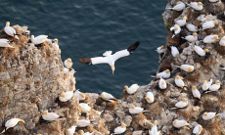
Gannets nesting on Bempton cliffs on the east Yorkshire coast. Photograph: Dan Kitwood/Getty Images
Any oil spills near designated special protection areas and special areas of conservation could pose an "untenable" risk, it said. And the increased air and sea traffic and new pipelines and infrastructure could disturb the colonies.
The warning came as a consultation on the latest round of oil and gas licensing closed, and follows the Shell oil spill in the North Sea.
Stuart Housden, director of RSPB Scotland, said: "This process will result in exploration licences, allowing companies to go out looking for oil and gas. If they are successful, that is highly likely to lead to full-scale drilling and exploitation. We have seen off the coast of Aberdeenshire that no matter how carefully drilling is done there is always the risk of an oil spill. In [the Shell] case, the spill happened far away from any vulnerable wildlife colonies, but just imagine if that oil was washing ashore at a globally important puffin colony. These risks are real, and are clearly untenable."
Protected areas the RSPB is concerned about include:
- Rathlin Island, Northern Ireland, which is home to puffins, razorbills and kittiwakes.
- Western Solent and west towards Portland, home to breeding seabirds including terns and gulls and wintering waterbirds such as geese, ducks and waders.
- Liverpool Bay, where thousands of common scoters and hundreds of red-throated divers spend the winter.
- Flamborough and Bempton cliffs, Yorkshire, home to the only mainland breeding colony of gannets in the UK, as well as seabirds such as kittiwakes and auks.
- Shetland and Orkney, particularly Foula, west Westray and Papa Westray, where great and Arctic skuas are found, along with Europe's largest concentrations of cliff-breeding seabirds such as guillemots, razorbills, kittiwakes and fulmars.
- East Caithness cliffs and Troup, Pennan and Lion's Heads, Scotland, which have internationally important numbers of guillemots, razorbills, kittiwakes and fulmars.
Mekong River dolphin species threatened with extinction
The Irrawaddy dolphin population in the Mekong River is at high risk of extinction, with numbers estimated at 85 and the survival of new calves very low, WWF has reported.
Fishing gear, especially gill nets, and illegal fishing methods involving explosions, poison and electricity all appear to be taking a toll, with surveys conducted from 2007 to 2010 showing the dolphin population slowly declining.
"Evidence is strong that very few young animals survive to adulthood, as older dolphins die off and are not replaced," said Li Lifeng, director of WWR's freshwater programme.
"This tiny population is at risk by its small size alone. With the added pressure of gill net entanglement and high calf mortality, we are really worried for the future of dolphins."
The Irrawaddy dolphins live in a 190km (118mile) section of the Mekong between Kratie, Cambodia and the Khone Falls, which are on the border with Laos.
Research also shows that the population of dolphins in a small transboundary pool on the Cambodia-Laos border may be as few as seven or eight, WWF added, despite the fact that Irrawaddy dolphins are protected by law in both nations. The group called on Cambodia to establish a clear legal framework to protect dolphins, including steps such as banning gill nets if needed.
"Our best chance of saving this iconic species from extinction in the Mekong River is through joint conservation action," Li said.
Dolphins once ranged from the Mekong delta in Vietnam up through the Tonle Sap in Cambodia, and then up tributaries into Laos, but were shot by soldiers and harvested for oil in the past.
Irrawaddy dolphins are found in coastal areas in south and south-east Asia, and in three rivers: the Mekong, the Ayeyarwady in Burma, and the Mahakam in Indonesian Borneo.
North Sea oil spill exposes Shell's ticking timebomb
For Shell, the timing of a spill at its Gannet A facility in the UK North Sea couldn't have been worse. For months, it has been selling its reputation as a responsible and cutting-edge oil company in its bid to drill in the Beaufort Sea in the US Arctic — and it recently won approval.
The Gannet Alpha platform spill and a damning report by the UN are undermining Shell's PR strategy. The company has been castigated over its lack of transparency in reporting the leak and for downplaying its magnitude and potential impacts. We now know that the spill is the single largest in UK waters in the last 10 years. While the spill is unlikely to approach the devastating impacts of the Deepwater Horizon disaster, its significance lies in the fact that it took place under the much vaunted "gold standard" regulatory regime of the UK and by a company that has been trading on its reputation as a responsible corporate citizen.
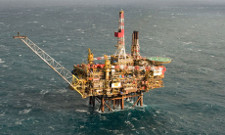
The Royal Dutch Shell platform Gannett Alpha in the North Sea. Photograph: Ho/Reuters
Gannet A should serve as a wake-up call to a government that has for too long relied on industry assurances that the regime in the UK is "fit for purpose" and "robust". Gannet A and its satellite projects are among the majority of offshore installations that are approaching or have exceeded their original design life (typically 20 to 25 years) and are posing an extra danger the longer they operate. Most of these rigs lie rusting in the southern North Sea region close to the Scottish coastline as they are pushed to extract every last drop of black gold. According to the Health and Safety Executive, the majority of hydrocarbon releases happen at facilities older than 20 years old, and more than 50% of existing platforms fall under that category. Gannet A will be celebrating its 20th birthday next year.
In the neighbouring Ekofisk field, one of the most significant fields in the North Sea, BP is still dealing with the aftermath of a fire that has forced the shutdown of several facilities since last month. One incident in the neighbouring Norwegian North Sea last year required crews to be evacuated and 50 wells shut down as a Statoil facility nearly approached a full blowout. A gas leak on another platform this April resulted in the closure of the field.
The response by the government and regulators has been to downplay concerns about ageing infrastructure and oversell the regulatory regime's ability to cope with a ticking time bomb. With the government's "red tape challenge" and swingeing cuts under way, there is a high probability that we will see more major oil spills and worker injuries in the coming years due to lack of regulatory capacity, a general drive towards "light touch regulation" and an apparent reluctance on the part of a government obsessed with "energy security" to challenge Big Oil.
Shell's oil spill in the UK North Sea comes barely a week after the UN issued a strong condemnation of the company's environmental impact in the Ogoni region of the Niger Delta. In a string of allegations, the UN environment programme accused Shell of failing to meet its own environmental standards, colluding with government officials to cover up oil spill sites and 40 years of devastating pollution. An estimated nine to 13 million barrels of oil have been spilled in the Delta — equivalent to one Exxon Valdez oil disaster every year, for 50 years.
Investors are also growing increasingly concerned. After a class action lawsuit in London, Shell admitted liability for two massive spills in Bodo, Ogoni, and could be forced to payout $410m in damages, while further claims are ongoing in The Hague. With Shell's poor record of preventing spills, the company's plans to expand into riskier, deeper drilling in Nigeria and the Arctic will only exacerbate the problem. Shell must clean up its mess rather than risk further pollution.
The North Sea is not as badly polluted as Nigeria, but the parallels are striking. In both cases, infrastructure built in the 1970s oil boom has not been sufficiently maintained. UK regulators, like their Nigerian counterparts, are unable to keep up with the deeper, riskier forms of extraction. Both governments lack independence from the oil industry, with revolving doors among top industry and government officials.
More stringent regulation is urgently required, and there is widespread support for a proposal by the EU commission to extend binding EU environmental and safety regulations to cover European oil companies operating overseas. The difference between the Gulf of Guinea and the UK Continental Shelf is a matter of degree.
MARINET observes: We recorded in 2010 the report of the French environmental organisation Robin des Bois that BP was flying a "flag of convenience" on its Deepwater Horizon oil rig in the Gulf of Mexico, see report www.marinet.org.uk/archive/archivelatestnews2010.html#bopw. We raised this matter with the UK government, and asked the question how many oil rigs in the UK seas of the NE Atlantic are also flying "flags of convenience"? The UK government declined to answer the question, and simply said that UK regulations were adequate to ensure safety on rigs in the UK seas of the NE Atlantic. Given the Shell Gannet A situation described above, we again ask this question "How many oil rigs in UK seas of the NE Atlantic are flying "flags of convenience" and, if this practice exists, can the safety of our seas be assurred?"
If UK offshore wind turbines are confirmed, Vestas will invest in UK
Vestas, the world's largest wind turbine manufacturer, has confirmed it could build a factory in the UK within a year as soon as it has secured sufficient orders for its new offshore wind turbine.

Vestas chief Ditlev Engel says the wind power company could build a plant in Kent within a year. Photograph: Vestas PR
Speaking to BusinessGreen, chief executive Ditlev Engel said that having secured the option to develop a new factory at a 70-hectare site at Sheerness in Kent, the company was poised to green light the project as soon as sufficient orders are confirmed for its 7MW V164 turbine.
"We have the manufacturing site ready as long as we get the orders to go ahead and manufacture them," he said, adding that if Vestas does proceed with the factory it will create up to 2,000 jobs and could be completed within a year, allowing the company to begin delivering turbines ahead of the next wave of offshore wind farm construction in 2015.
He also revealed that the company was already talking to a number of its customers about the potential orders and investment that would allow it to move forward with its plans for the Kent facility.
The move could complete a remarkable turnaround for Vestas in the UK, after the company controversially closed a smaller turbine blade factory on the Isle of Wight in 2009. The company has subsequently stepped up investment in a number of research and development centres, including a major new facility on the Isle of Wight. However, the Kent site promises to bring turbine manufacturing for the first time.
Engel also told the Guardian that sales in Asia could be hampered by a lack of available financing and infrastructural issues.
China has been one of the biggest growth regions for wind turbine manufacturers for the past five years, but Engel said that there were problems with grid connections for Chinese wind farms, which are sometimes built without connections and are left stranded for months or even years at a time while the necessary infrastructure is built to catch up. That lack of grid infrastructure has in turn discouraged financing, and Engel said it was a potential brake on growth in the world's biggest market for wind farms, and the biggest generator of wind energy.
Engel's comments came as Vestas released its financial results for the first half of the year, confirming that revenues and profits were in line with expectations as the company continued its recovery following a tough 2010. First-half revenues rose 31 per cent year on year to €2.47bn, while pre-tax profits reached €8m — a significant improvement on the €219m loss recorded during the first half of 2010. Engel said the results confirmed that the company's performance had returned to a "normalised level" following a weak first half of 2010.
Significantly, the company reported that it boasted a solid order pipeline with firm and unconditional orders covering almost all the expected revenue of €7bn for 2011. As a result, the company said it would maintain its outlook for the full year, predicting that it will deliver revenues of €7bn and a pre-tax profit margin of seven per cent.
"In spite of the macro-economic and financial uncertainty, Vestas still expects an intake of firm and unconditional orders of 7,000-8,000MW in a market that remains fiercely competitive," the company said.
Iceland claims to want proper regulation of NE Atlantic mackerel fishery
Sigurdur Sverrisson writes in The Guardian, 18th August 2011: " George Monbiot's article, 8th July 2011 on the European Union's fishing quota is interesting, though not altogether correct.
"Of the North Atlantic's mackerel stocks, he says: "As the seas have warmed, the fish have moved north. When they arrived in Icelandic and Faroese waters, those nations argued that their mackerel fishing agreement with Norway and the EU should be changed to allow them to catch more." He goes on: "Norway and the EU refused, so Iceland and the Faroes tore the agreement up and each awarded themselves a unilateral quota of 150,000 tonnes. As a result, the north-east Atlantic mackerel catch has risen almost 50%, and is now well beyond the replacement rate."
"Iceland has most certainly not torn up any agreement on mackerel fishery. A comprehensive agreement on the management of the mackerel fishery in the north-east Atlantic is non-existent. For a decade, until last year, Iceland's repeated claim for participating in negotiations was dismissed. By alleging that Iceland and the Faroe Islands are the driving force behind an increase in the mackerel catch, Monbiot sidesteps the core issue. If there's a question of mackerel being overfished, it is surely the joint responsibility of all parties involved. Playing the blame game will not get us anywhere.
"In recent years, large quantities of mackerel have migrated into the Icelandic exclusive economic zone. The area of distribution of the catch within the zone has also increased significantly, and mackerel have been located almost everywhere around the island. According to a joint Norwegian/Faroese/Icelandic survey in 2010, over 1m tonnes of mackerel — an estimated 23% of the stock — migrated into Icelandic waters during the feeding season. The Marine Research Institute in Iceland has estimated that the mackerel's weight gain is almost 60% during the feeding season in Icelandic waters. This has an impact on other fish stocks and the Icelandic marine ecosystem as a whole, and must be taken into account.
"As a coastal state, Iceland has the right to fish for mackerel within its jurisdiction — just as Norway and the EU have the right to fish for mackerel in theirs. The EU and Norway are not the sole owners of the mackerel stock. By issuing quotas for almost all the recommended allowable catch, they disregard the legitimate interests of the other two coastal states in question, Iceland and the Faroe Islands, as well as the interests of Russia, which also fishes from the stock.
"This totally unjustified decision has a built-in prescription for overfishing of mackerel this year. The lack of a comprehensive agreement on the management of mackerel fishery, however, needs to be addressed by all parties involved.
"As for the blue whiting, Iceland does not a have separate stock of its own. So Monbiot's allegations that Iceland has "more or less wiped out its blue whiting stocks" are unfounded. The total allowable catch of the blue whiting stock has, however, been drastically reduced in recent years by international agreement."
NFFO asks for balanced argument over CFP "rights based management" approach to fisheries
The National Federation of Fishermen's Organisations (NFFO) states, 11th August 2011: "Extreme positions and are being adopted and incendiary language used on the issue of transferable quotas. The question of how quotas have become tradable legal rights in the UK, and whether this is a good or bad thing is being conducted, in heated terms, between those who see tradable concessions as a panacea for the failures of fisheries policy and those who see it as a type of crime. This debate is important because it touches the current discussion on the way forward for the under-10m fisheries within domestic fisheries policy but also the direction of CFP reform.
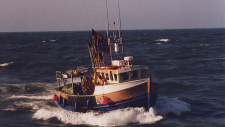
Fishing Concessions and Sustainable Fisheries
"On the one side of the argument are the European Commission, Defra and parts of the environmental lobby, which see the allocation of fishing rights, or 'fishing concessions", as a way of achieving sustainable fisheries and breaking free from the "tragedy of the commons". Their core argument is that allocating fishing rights gives the fishing vessel operators who receive them a vested interest in thinking long term and fishing in ways that preserves or increases their share of the resource, which in effect have become one of their assets. Without that vested interest, the argument runs, individual operators act in a short-term way to maximize immediate profit, leading to the degradation of the overall resource. This is a way in which private interest can be aligned with public policy, with the goal of well managed fish stocks within a healthy ecosystem. It is also seen as a way of dealing with the problem of fleet overcapacity and building a high level of compliance. Vessels that are not viable in a business sense may sell their quota entitlements to other vessels, reducing the capacity of the fleet overall and increasing the profitability of the remaining units. In Denmark this arrangement is said to have produced "happy fishermen, happy ex-fishermen and a happy government".
Stealth Privatisation of a Public Resource
"The counter-view, sometimes expressed in vigorous language by a mix of journalists, lawyers and single issue fishing groups, is that the introduction of this form of rights-based management amounts to the stealth privatisation of a public resource. "The biggest property grab since the Norman invasion" according to one over-excited legal commentator. Not only does the allocation of transferable quota shares enshrine and make permanent injustices already inherent in the quota allocations system, it has developed in the UK without a proper basis in law. The "commodification" of the fisheries resource amounts to a grab by the haves to the disadvantage of the have-nots that parallel the land enclosures in the 18th century. It is suggested that the whole process of quota ownership in the UK is shrouded in mystery that disguises the fact that quota traders — middlemen — or corporate groups outside the fishing industry could, or already do, hold large chunks of UK quota. Even the Government, it is claimed, don't know or won't reveal who ultimately owns UK quota.
Polarisation
"The polarisation of the debate on where the right balance lies between private access to, and management of, a public resource has not been very helpful. The reduction of the debate into simplistic slogans, misinformation and unsupported assertion might make good copy for a lazy journalist but it doesn't help us as an industry find a way through undoubtedly difficult issues. We certainly need a debate, not least because fishing concessions and rights-based management are central to the Commission's CFP proposals as well as Defra's thinking on domestic fisheries reform. But the strident tone and wild assertions, with weak links to evidence, and failure to make any attempt to understand how the quota management system in the UK has evolved only gets in the way of a clear view ahead.
The polarisation of the debate on rights based management (aka Catch Shares) is a pity.
NFFO Position
"The NFFO holds no ideological position on rights based management. We are interested in what works for the fishing industry as a whole. The evidence of the last two decades suggests that the development of a system of rights-based management has helped the UK industry to move beyond the anarchy of the era of black-fish, when under-reporting, misreporting and over-reporting undermined the viability, reputation and of the whitefish sector, along with the scientific assessments on which quotas are ultimately based. It has helped to achieve a high level of compliance and an industry that looks to the future in collaboration with fisheries managers and fisheries scientists. This is not to say that a rights-based system of allocations is automatically the best option in all circumstances. It is not the magic wand that its proponents suggest. It is also true to say that it is those parts of the UK fishing industry that have remained outside the rights-based system — the under-10m fleet — are where problems of quota management are their most acute.
This balanced, proportionate and cautious view is in stark contrast to both the advocates of rights-based management who see it as the solution to everything, and those who see it as a massive and stealthy conspiracy to privatise and monopolise a public resource. In order to draw some semblance of proportion into a debate, that threatens to spin into ever wilder claim and counter claim, we have described below some of the salient features of the current quota management system in the UK that should be taken into account for those interested in arriving at an informed judgement.
Some Salient Points
- Evolution
The evolution of the UK's quota arrangements into a system of rights-based management occurred in a fairly pragmatic, incremental, some might say, very British way and has been described elsewhere. There has been no blueprint or ideological driver. There was not so much a property grab as a gradual unplanned evolution towards transferable quotas on the basis of a number of pragmatic changes to the quota management and licensing rules for reasons that made sense in their own terms at the time. The main significance of the introduction of Fixed Quota Allocations in 1999 meant that whereas previously a vessel's quota entitlement for the following year was based on an average of what it caught in the previous three years, FQAs fixed that amount, thereby removing the rough justice of engine breakdown or similar calamity undermining a vessel's entitlement. It also removed some element of the race to fish, or in some cases over-reporting of catch simply to hold onto entitlement for the following year (the problem of "ghost fishing").
- Historic Rights
The ultimate basis for quota allocations in the UK both before 1999 and for the introduction FQAs in that year was historic access to the resource. Those with a demonstrable track record of participation in the fishery received an allocation proportionate to the level of that participation. This core principle is the same basic starting point as the principle of relative stability in EU and in other international fisheries agreements.
- Quota transfers with monetary value evolved out of the arrangements for swaps of unutilised quota between producer organisations. Initially all swaps had to be balanced in terms of cod equivalents, and quota entitlements were attached to vessels rather that licences. All this made for a rather rigid system with too much quota underutilised because it was in the "wrong" PO, or attached to the "wrong" vessel in the "wrong" sea area. Allowing unbalanced swaps and attaching the quota entitlement to the licence rather than the vessel were pragmatic adjustments to address these problems but they were important first steps towards tradable quotas. The introduction of FQAs in 1999 and a number of fishing vessel decommissioning schemes where the Government, to save money, allowed decommissioning owners to retain their quota, were also important steps in the introduction of the market into fish quotas.
- Legal Basis
It has been asserted that there is no legal basis for the kind of delegated responsibility that underpins the UK's sectoral management system through which producer organisations manage their members' quotas and tailor quota arrangements to local circumstances. It is true that there is no specific legislative basis for the allocation of quota entitlements to producer organisations; it has all been done on the basis of administrative provisions within existing fisheries legislation, underpinned by consultation with the fishing industry. But given that the Defra's quota management decisions have been tested very recently in the Courts and found solid there seems no reason to think other than that the legal basis for the current quota management regime is pretty robust.
Probably more significant is the fact that the type of delegated responsibility seen in the sectoral management system is a success story and may become the model for the governance of a radically reformed and decentralised CFP.
Nevertheless, it would probably be wise, once the CFP reform is settled, that a more formal and transparent legislative footing for a system of explicit use-rights in fisheries is introduced.
- Transparency and Control
Producer Organisations as collectives of fishermen and fishing vessel operators are the lynchpin of the system and remain the ultimate arbiter of the quotas allocated to them for that year. It is true that for whatever reason there is a lack of transparency at Government level about where "ownership" of the ultimate quota holdings lies, allowing daft stories about quota being held by bodies such as Manchester United to circulate. But POs have been requested by the MMO to provide comprehensive information on the ownership of FQAs within their membership and have complied. More transparency would serve to quell the rumour mill and so we agree that this information, subject to the usual strictures on data protection, should be made public. The suggestion of secrecy only serves to fuel those disposed to conspiracy theories and that is not helpful in the current febrile atmosphere.
- CFP Reform
The CFP reform proposals published on 13th July include the introduction of a mandatory system of transferable "fishing concessions" applicable to all fishing vessels over 12metres in length and all mobile gear vessels whether they are above or below 12mts. Member states would hold the discretion to apply a system of rights based management to the small scale fleets if minded. Importantly, the new system, if adopted, would be compatible with the principle of relative stability as it would operate within the confines of each member state. 'Fishing concessions" would be allocated for 15 years to allow investments to be planned and to provide a degree of security. These arrangements although requiring some changes to the UK's domestic arrangements are essentially compatible, indeed to some degree based on the current experience of transferable quotas in the UK, Netherlands and Denmark. Nevertheless, there is always scope for concern when a pragmatic, evolutionary domestic approach is about to be replaced by a broad brush, top down European system.
- Safeguards
What is important with any system of rights-based management is that is accompanied by appropriate safeguards to protect vulnerable components of the fleet from the full force of the market and to prevent over-concentration of quota in too few hands. It is not possible, or necessarily desirable to protect every vessel or fishing job, from the transfer of quota from outgoing vessels to more efficient vessels. But most observers and certainly the NFFO sees the sense in a one-way valve that would allow fishing-rights to be traded between small vessels and from larger vessels to small vessels but not from small vessels to large vessels, if rights based management is applied across the whole fleet. However, we remain to be convinced that extending tradable quotas, as proposed by Defra in its recent consultation, to the under-10m fleet would represent a step forward. The flexibility of the pool system, where vessels fish against monthly catch limits has many advantages for the inshore fleet which traditionally has maintained its viability by changing gear, or target species to adapt to changing circumstances.
Equally, the jury is very much out on whether the extension of rights-based management to the crab and lobster fisheries is necessary or desirable.
Plea for a Reasoned Debate
"The media thirst for pantomime villains in the fishing industry seems inexhaustible and it is not to the credit of some in our own industry who have pandered to it. Rights based management is important. Carefully and sensitively applied, with proper safeguards, it can in some circumstances, offer a superior way of managing quotas than cumbersome centralised government control. It has worked well for most of the time in the UK, Netherlands and Denmark. It is significant that those parts of the UK fleet not included in the mainstream rights-based management system are those that currently face the most acute quota problems. However, this is not to say however that strong arming the under-10m fleet into a catch share system is the right way forward either.
"But rights-based management should not be considered a panacea. In some quarters it is being oversold. Partly this is because it fits with a small government agenda and ultimately as a way to extract resource rental form the fishing industry. It is also seen as a way of achieving low or no cost decommissioning where various EU grandiose fleet reduction policies have failed.
"We have to navigate our way through the purists and the ideologues, past those with an axe to grind and those who make a living out of sensationalist nonsense. We have to thoroughly and calmly examine all of the options in front of us and adapt and adopt them to fit our industry's needs. None of this is easy but it certainly isn't helped by distorting the terms of the debate, finding conspiracies were none exist, or incendiary language."
Defra to publish who owns UK fishing quota "rights"
The UK government has pledged to set up a register of fishing rights, after widespread anger from small fishermen who say there is no way of discovering who owns the right to fish in the UK.
It would be the first time that the public, and fishermen, could find out which companies control the valuable rights to exploit the UK's fishing quota.
Fishing rights are distributed according to a formula set by the European Commission, which sets a "total allowable catch" each year for each member state. The rights are then divided up among national fishing fleets by member state governments, and in the UK the quotas for each boat are determined based on historic fishing levels as well as the boats' capabilities, and the availability of fish.
However, this process is opaque and it is hard to know which fishing companies or individual fishermen are being handed quotas. The fishing rights are tradeable, so companies can sell them to one another in a complex web of commercial agreements.
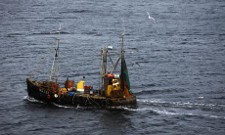
A fishing boat makes its way into Uig on the Isle of Skye in Scotland. Photograph: Jeff J Mitchell/Getty Images
The Department for Environment, Food and Rural Affairs (Defra) said the government was taking steps to remedy the situation, in response to the chorus of criticism. A spokesman told the Guardian: "We have recently held a consultation to look for ways of balancing the quota allocated to the larger industry and that of the under 10 [metres] fishing fleet. As part of this we have suggested a quota register and a web-based quota trading website to make this system more transparent. We are currently looking at the comments received and how we will take this forward."
The new register would, for the first time, show who owns the right to fish in UK waters.
At present, the rights are spread between a wide variety of organisations, many of which have nothing to do with fishing. Rumours even surfaced earlier this year that Manchester United plc and the Royal Bank of Scotland owned some rights. Both companies, when contacted by the Guardian, said they do not own any rights and have no idea why they are being cited.
Small fishermen are angry that the quota is being bought up in this way by large and untraceable companies. They say they are being priced out of the market, and that their own quotas are insufficient to make a living, while bankers and big companies are able to cream off profit from acquired rights.
Even Parliament was unable to discover who owned the rights to fish and MPs demanded to know why the government was not monitoring the sale of the rights. The MPs, on the environment, food and rural affairs select committee, said the current situation was "unacceptable".
A spokesman for Defra said the detail of who owns the rights could not be disclosed at present owing to "commercial confidentiality".
However, this is at odds with the government's stance on other matters involving similar European Union regulations. Recipients of the Common Agricultural Policy, for example, are made public, along with details on the amount they receive under the policy.
In the UK, fishing quotas are allocated to three groups: producer organisations, made up of fishing boat owners; large vessels that are not part of such a producer organisation; and vessels of under 10 metres. Their rights are distributed in the form of "fixed quota allocations", which are based on the vessels' historic landings, calculated for a fixed period. Quota can be traded between groups, or among fishermen within groups, through temporary leases or on a permanent basis.
As well as putting fishing rights in the hands of large organisations unconnected with the sea, many older fishermen can keep their rights while retiring from fishing, selling their quota to others. But critics say these "slipper skippers" — so-called because they stay at home in their slippers while others go out to sea — are holding back working fishermen who cannot get access to a quota of their own.
Defra said the ability to lease and trade quota could "lead to a lack of transparency as to who may hold certain quota at a given moment in time". Its proposed register would make that clearer, providing a regularly updated snapshot of what trades had taken place and some details of the new owners of the rights.
Defra said it has no timescale yet for when the new online registry might be introduced.
Sea Shepherd writes an Open Letter to the people of the Faeroe Islands
Captain Paul Watson writes, 11th August 2011: "The Faeroese government and media have claimed that they are an open society and that debate and dialogue are valued and welcome in the Faeroe Islands. Towards that end, we decided to make a public presentation in Torshavn to explain why Sea Shepherd is defending the whales.
"First we approached Nordic House, a cultural institution, where we were politely told we were not welcome to speak. Next, we made a reservation for a conference room at the Torshavn Hotel. With the reservation confirmed, we issued a notice of the event to take place on Saturday, 13th August. But just the next day, the hotel cancelled the reservation on the advice of a source they would not reveal. The movie theatre literally slammed the door in our faces when the same proposal was requested. So much for a welcome and an open dialogue in the Faeroes.
"We were told that other people had been welcome to discuss the "grind" in the Faeroes because they were open to understanding the culture and traditions of the Faeroese that lie behind the continuation of the slaughter of the whales. We were told we are not welcome because we will not compromise. In other words, we had to understand and accept the slaughter in order to discuss it, and that we will not do.
"It is our position that culture and tradition must never be a justification for cruelty and slaughter. When it comes to killing, we draw the line on compromise.
"Since we cannot make an in-person presentation to the local citizens, the only manner that we can explain our position to the people of the Faeroes is to post this open letter on our website and social forums allowing those Faeroese who wish to understand why Sea Shepherd does what we do the opportunity to read about it.
"We would have welcomed questions and an open exchange of views but this opportunity has been denied to us by circumstances beyond our control. However, if are given permission to do so, we still may dock our ship in Torshavn in Saturday, 13th August to invite people onboard for discussion with the Captain and crew.
"In the meantime, for anyone in the Faeroes who wants to know why we are here, the below letter is our explanation.
Mackerel is the last great fishery in the NE Atlantic, and its survival is threatened
George Mobiot writes in The Guardian, 8th August 2011: "Give a man a fish and you feed him for a day. Teach a man to fish and you feed him for a year, after which no one will ever eat fish again. Almost everywhere fish stocks are collapsing through catastrophic mismanagement. But no one in the rich world has managed them as badly as the European Union.
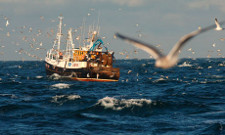
'Our obsession with cod and haddock is trashing the seabed and many of the other species which live there.' Photograph: Angus Blackburn/Rex Features
"So when the EU tells Iceland and the Faroes that they should engage in "responsible, modern fisheries management", it's like being lectured by Attila the Hun on human rights. They could be forgiven for telling us to sod off until we've cleaned up our own mess. Unfortunately, this is just what they've done, with catastrophic results.
"A feeding frenzy is taking place in their territorial waters, as they rip into the North Atlantic's last great stock: mackerel. As the seas have warmed, the fish have moved north. When they arrived in Icelandic and Faroese waters, those nations argued that their mackerel fishing agreement with Norway and the EU should be changed to allow them to catch more. Norway and the EU refused, so Iceland and the Faroes tore the agreement up and each awarded themselves a unilateral quota of 150,000 tonnes. As a result, the north-east Atlantic mackerel catch has risen almost 50%, and is now well beyond the replacement rate. If the mackerel go, so do the many links of the food chain which depend on them.
"No one is negotiating. The EU and Norway argue that Iceland and the Faroes are stealing our fish. But the mackerel migrating around the North Atlantic belong to everyone and no one. What matters is that the harvest is small enough to sustain the stock, regardless of who catches it, and at the moment no one's blinking. Iceland and the Faroes will reduce their quotas when the EU and Norway are prepared to reduce theirs. Brinkmanship by all four parties is trashing our last super-abundant food species.
"Channel 4 has broadcast the latest instalment of Fish Fight, presented by Hugh Fearnley-Whittingstall. It urges us to switch from what supermarkets call the big five — cod, haddock, salmon, tuna and prawns — towards more viable stocks, in particular mackerel.
"It's an engaging and powerful programme, and its attempt to prevent discards — throwing a large proportion of the catch overboard because of EU rules — is one that everyone should support. But what about its call to change species?
"Our obsession with cod and haddock is trashing the seabed and many of the other species which live there. Species such as mackerel, herring and sardines reproduce quickly. Because they live in mid-water, catching them involves scarcely any bycatch or damage to the sea-floor. "The Iceland and Faroes situation has given us a headache," Fearnley-Whittingstall told me. "But are we going to punish local Cornish handliners for doing the right thing?"
"I started work on this article in the belief that he was wrong: that switching to less popular species merely transfers pressure onto new stocks. But the research I've done has changed my mind. His campaign would make good ecological sense, were it not for the insanity of a fishing policy which cannot sustain even our fastest-growing fish. The new pressure on mackerel stocks has nothing to do with Channel 4's attempt to persuade us to broaden our tastes, which has not so far been successful. An analysis of sales by Maria McLean at Surrey University suggests no significant or lasting impact on any species. People have stuck with the big five. You wonder what it takes.
"The new mackerel fisheries are finding markets far beyond Channel 4's audience. Jogvan Jespersen of the Faroese Pelagic Organisation told me most of the fish his members catch are sold to Nigeria and eastern Europe. There's nothing wrong with this: the Nigerians have as much right to eat fish as we do. Jespersen says the Faroese catch is being sold only for human consumption.
"Iceland's industry is another matter. The chart its fisheries ministry sent me shows that over one-third of the mackerel that ships in its waters caught last year weren't fed to people at all. Instead they were turned into fish-meal, which is sold to feed chickens, pigs, other fish and pets and — even worse — to fertilise crops. It's a disgusting, astonishing waste. Already that country has more or less wiped out its blue whiting stocks and killed huge volumes of herring and capelin for the same purpose.
"But the government's website tells us something else of interest: that most of the fish-meal and fish oil Iceland sells is bought by Norway and the European Union: the very parties complaining about Iceland's plunder. Any nation which really cared about fish stocks would ban both the production and consumption of meal and oil, except from the waste produced by fish processing factories. A basic principle of marine conservation is that fish should be caught only for human consumption.
"As for the UK government, if it wants to establish any credibility in this debate, it should start by sacking its fisheries minister. In Channel 4's programme, Richard Benyon gave the impression of a man without the slightest interest in his brief, let alone any mastery of it. He was unable to identify the common fish species he's supposed to be protecting. After admitting that he's never been on a trawler, he wormed his way out of an invitation.
"It would also implement the Royal Commission on Environmental Pollution's proposal: that by 2010, 30% of British seas should be no-take zones in which fish could reproduce safely, greatly increasing the size of stocks. The score so far is 0.3%, and this government's contribution has been to abolish the Royal Commission. It would address the issue highlighted by Emma Cardwell that in 1999 the UK's quotas were handed, free, to anonymous cronies, who then leased them for a fortune to big fishing conglomerates, wiping out the smaller boats.
"Yes, let's demand that Iceland and the Faroes stop wrecking our common stocks. But let's not give the impression that we're doing so only in order to wreck them ourselves.
Fathoming 'Sand Waves'
Peter Waller of Felixtowe has been studying papers on Sand Waves and their mobility, and following much reading has come up with an interesting analysis which can be seen on our website here.
We need to eat less fish — not more "sustainable" fish
Getting people excited about fish isn't exactly easy. But somehow Hugh Fearnley-Whittingstall and Channel 4 have managed to do it, bringing a new level of public scrutiny to the plight of fish stocks. Hugh's Fish Fight campaign already has more than 600,000 signatures, and now has big retailers promising to change their labelling and sourcing policies. They deserve congratulations and support.
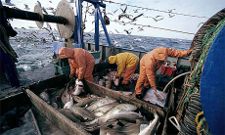
Cod fishermen work a trawler in the North Sea. Photograph: Jeffrey L Rotman/Corbis
There is, however, a lingering concern about their proposed solutions. Simply encouraging British people to be more adventurous and try new species such as gurnard, coley or dab will not automatically ease pressure on stocks most at risk. On the contrary, it could result in an increase of total amount of fish eaten. It may be happening already. Marks & Spencer and Waitrose have reported increases in fish sales of 25% and 15%.
People in Britain each consume about 20kg of fish per year. That's only half of what a Spaniard eats, and three times less than a Portuguese, but it's still much more than what the average world citizen eats. In the context of declining global fish stocks and rising global demand — as reported by the UN's Food and Agriculture Organisation (FAO) — increasing the total amount of fish eaten in the UK is unlikely to solve overfishing.
The UK eats more than its stocks are able to produce: it imports more than twice the amount of fish product it exports, and depends on fish from other countries for more than five months in the year. This dependence on fish from abroad makes the industry more vulnerable and reduces food security in countries that need the fish more than us.
But this trend is increasing. If the UK had to rely on its own fish supply to satisfy current demand, it would run out by mid July: three weeks earlier than last year. Quite bad for a nation surrounded by potentially rich and productive seas, but still better than Spain, France and Germany, which are fish dependent for more than half a year.
The main reason for this fish deficit is that three-quarters of EU fish stocks — including British ones — are overexploited and produce much less than they used to, or what is possible. Stocks, when properly managed, are a long-term source of prosperity and jobs: unsustainable management is economically, and ecologically, careless.
A recent study by the Centre for the Economics and Management of Aquatic Resources (CEMARE) shows that UK catches for cod, whiting and haddock could be five, four and three times bigger if stocks were allowed to recover, with the potential to increase economic gains ten-fold to more than £500m. How this is done and who would benefit most from this is a matter for another discussion, but the figures give an idea of why fish stock restoration deserves at least as much — if not more — attention as the promotion of new fish species into British fish eating habits.
Creating a market for under-utilised species, which would otherwise be discarded, could help to stop edible fish being thrown overboard. But, as the OCEAN2012 coalition suggests, the priority should be to ensure that unwanted catches are avoided, and that any ban on discards is based on the principle of avoiding unnecessary wastage, rather than creating new markets that use discards of unwanted or unsustainable catches such as immature fish or endangered species.
The upcoming reform of the Common Fisheries Policy (CFP) is a perfect opportunity end to discards and restore stocks to healthy and sustainable levels. Getting this piece of policy right will be critical to guarantee that in the not-too-distant future European consumers can go to the supermarket and buy fish with peace of mind, knowing that it all comes from sustainably managed stocks.
In the meantime, responsible consumers can reduce the amount of fish they eat — by far the safest option when it comes to satisfy concerns about the sustainability of stocks. They can also buy products certified by the marine stewardship council (MSC); it's far from perfect but it's the most widely recognised standard. Buying fish caught with static gear, such as gillnets, pots, bottom long-lines, also helps, as will eating species that are at low levels of the food chain, including mussel, squid, crab, Norwegian lobster, sardines or sprat, which tend to be more abundant and reproduce more rapidly, so eating them has less impact on the marine environment.
Simply bringing new fish species on to the menu without getting core fish stocks back into shape will only take the UK a step closer to becoming a fish-predator nation, such as Spain, Portugal or Japan, which all eat a much wider variety of fish but are far from providing models of sustainable fisheries management.
FishFight campaign resulting in consumption of more fish, not less
It was meant to stop the wasteful practice of fishermen catching fish, only to throw them back into the sea to die. It hoped to change British dining habits, by tempting the public to try previously largely unheard of fish, such as Cornish pollack and the ugly but tender megrim. But celebrity chef Hugh Fearnley-Whittingstall's high-profile Fish Fight campaign may have had the unintended consequence of driving up the total amount of fish consumed in the UK.

Hugh Fearnley-Whittingstall persuaded people to try new fish, such as the varieties on sale at Billingsgate fish market, London, but they like their old favourites too. Photograph: Graeme Robertson
Figures from supermarkets show that while sales of under-utilised, or "sustainable", species such as mackerel and pouting have increased dramatically following the show's first airing in January, sales of common fish-counter species such as cod, salmon and tuna have held steady. So demand for fish has increased overall.
Fearnley-Whittingstall's campaign has focused on the controversial issue of discards, the practice of throwing caught fish back into the sea to avoid exceeding European landing quotas and because of a lack of demand for unpopular species. It has also called for the British public "to diversify our fish-eating habits" by being more adventurous beyond the so-called "big five" species of cod, haddock, salmon, tuna and prawns.
But the New Economics Foundation (NEF) warns: "There is no evidence that encouraging people to be more adventurous with new species will ease the pressure on fish stocks." Aniol Esteban, head of environmental economics at NEF, said: "Fish stock restoration deserves more attention than the promotion of fish consumption. Promoting the consumption of unwanted species is a risky gamble which could lead to more demand for fish and put more pressure on our fish stocks."
Tesco, the UK's biggest fish retailer, reported that pouting sales had reached the level of 50% of the chain's cod fillet sales. In January, Tesco said sales of fresh sardines, coley, brown crab, sprats and whiting had risen by between 25% and 45% after Fish Fight aired. A spokeswoman told the Guardian sales of popular species such as cod had held steady, despite the rise in alternative fish.
Morrisons said it had seen a three-fold increase in pouting and dab sales, and a 33% increase in coley sales since January. Its spokeswoman said that while consumers had switched away from cod, haddock and salmon in January, sales of those species "soon returned".
Waitrose said it was now selling three tonnes of fillets a week across alternative species — such as Anglesey seabass fillets, Cornish pollack, Icelandic whiting fillets and Cornish brill fillets — compared with between 45 and 50 tonnes of cod fillets per week. A spokeswoman said that sales of popular species such as cod were "steady" rather than declining.
Asda said that since January, whole mackerel sales were up by 69%, whole sardines up 32% and whole trout up 72%. Sales of cod and haddock have also gone up.
But Sainsburys, which sells —400m worth of fish annually, said it had seen a 2% decrease in sales of the "big five" species. It sold 46 extra tonnes of coley, pouting, rainbow trout, hake and megrim since June after such alternative species were given away for free during a promotion.
Several of the supermarkets said they had been training staff to advise customers on alternative species, as well as running sustainable fish promotions. Marks and Spencer did not respond to requests for fish sales figures.
Will Anderson, the director and producer of Hugh's Fish Fight, said: "From our point of view, the most important thing is that people need educating on what fish to eat and what to avoid. We don't know who is buying this fish — whether it is people switching or people who weren't buying fish before. Also, we don't know if people can't find alternative fish and are buying species such as cod as a result."
On the question of whether the show was driving up overall fish consumption, he said: "We are concerned that may happen, but not worried about it yet, because nobody really knows. As a nation, we are recommended to eat nearly three portions of fish a week. We're not saying we should all pile in and eat more fish, and we are concerned with overfishing. It's about making people more aware."
Fearnley-Whittingstall's ongoing campaign takes place against the backdrop of European efforts to overhaul drastically the common fisheries policy (CFP). Damanaki has said she wants to phase out discards and in July laid out how she would ensure European fish stocks are "at sustainable levels" by 2015.
Cod, salmon and tuna alone account for more than half of all fish eaten in the UK. Globally, in 2008, 42 million tonnes were taken out of oceans — a demand that is forecast to rise, particularly from China, according to the UN.
Wildlife Trusts launch UK petition for creation of Marine Protected Areas
"Petition Fish" is The Wildlife Trusts' new campaign to put pressure on the UK, Scottish and Welsh Governments to create Marine Protected Areas (MPAs) — sanctuaries for our sea life.
2012 should see the UK's first network of Marine Protected Areas (MPAs) established under the Marine Act (2009). However, there are already signs that the proposed network will not adequately protect wildlife and some of our most important marine wildlife sites could even be missed off altogether.
The Wildlife Trusts are calling on the Government to deliver Marine Protected Areas that are:
- in the right place — where nature conservation is required;
- support recovery from past decline — not just maintenance of their current, sometimes damaged condition, and
- managed well — with adequate regulation and controls.
The Petition reads:
To UK Government,
With legislation in England, Wales, Scotland and soon Northern Ireland, we have a once in a lifetime opportunity to make a difference and adequately protect our seas and sea life. Our seas urgently need an ecologically coherent network of Marine Protected Areas if we are to make a difference and stop the clock on years of destruction and decline. Please keep your promise and protect our seas; if you do we'll have something to cherish for generations to come.
More details needed on oil incidents, says Scottish Government
Following the recent serious North Sea oil leak of 218 tonnes from the Shell Gannet Alpha platform 113 miles (180km) off Aberdeen, the Scottish Government have stated that the public must have better information on oil incidents in UK waters.
At this time oil industry regulation is reserved to Westminster, but Scottish ministers have now asked the UK government to hold a review on the issue. Scottish Environment Secretary Richard Lochhead said issues of disclosure had raised serious questions about how information was given to the public in such circumstances, saying "Not only should every effort be taken to minimise these risks, but when incidents do happen openness and transparency must be the guiding principles. More steps need to be taken to promote a culture of openness and transparency, especially when we are dealing with Scotland's rich and unique marine environment."
Oil spills are regular and ongoing as may be seen from the following table, which also shows that this most recent event was by far the worst off the UK Coastline in the past ten years.
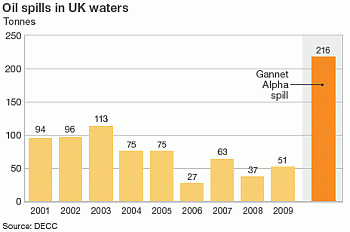
Shell admits 'Significant Oil Spill'
The worst North Sea oil spill for over ten years resulted when the Gannet Alpha platform, 112 miles East of Aberdeen, lost 1,300 barrels, i.e. 216 tonnes to the sea. The UK Government Department of Energy and Climate Change (DECC) said that this outstrips the annual spill for the past ten years. In 2009 alone the oil spill this amounted to 50.93 tonnes.
Germany to "bubble-wrap" marine industrial sites to protect the hearing of cetaceans
The German government is investigating ways to "bubble-wrap" underwater construction sites to protect whales and porpoises in the Baltic Sea from noise pollution from offshore wind farms.
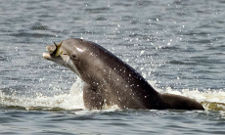
A porpoise leaps out of the water as it catches a fish. Photograph: Phil Sandlin/AP
The mammals rely on echo-location to hunt and navigate and researchers say noise from pile-driving work to install the turbines interferes with the animals' ability to find each other and their prey.
Karsten Brensing, a biologist at the Whales and Dolphins Conservation Society said: "These animals are so dependent on their acoustic sense… we need an acoustically clean environment.
But a report by the Federal Agency for Nature Conservation has suggested an ingenious solution. A "bubble curtain" could contain the disturbance. Using simple, low-cost technology, bubbles released from pipes on the sea-floor would create a sound-insulating barrier.
Germany is a leader in the field of wind-power technology and with the country's phase-out of nuclear power, incentives are being offered to encourage the expansion of offshore wind farms.
A Greenpeace campaigner, Thilo Maack, believes that if "bubble curtains" can mitigate the impact on wildlife, they should be used. But he also said quieter construction methods such as drilling need to be investigated.
"We have to be sure that the wind parks don't harm harbour porpoises and other marine mammals," Maack said. "On the other hand, we need these renewable energies to fight the consequences of climate.
UK shipping industry rejects EU carbon reduction programme
The UK's shipping industry has roundly rejected the European Union's emissions trading scheme, defying calls for shipping to be included in the carbon reduction programme.
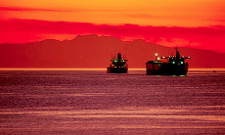
The UK's shipping association has just starting looking at emissions-reduction initiatives for the industry, despite years of talks. Photograph: Ron Watts/Corbis
Mark Brownrigg, the UK Chamber of Shipping's director general, told the Guardian: "The EU's emissions trading scheme will not work for shipping. It is not suitable. It is not a global system, and shipping is."
He claimed that if shipping were to be included, as campaigners have called for, that ships would simply refuel instead at non-EU ports.
Aviation is to be included in the emissions trading system, despite similar claims from airlines, which have said that companies would choose to land in countries outside the EU to avoid having to pay for carbon permits under the EU's system.
However, the European Commission held firm, and airlines will be included in the scheme. Although US airlines are disputing the legality of this decision in the courts, no airline from any country has announced plans to land flights outside the EU in preference to continuing with their current schedules.
The Chamber of Shipping will publish discussion documents setting out how the industry could adopt different methods of carbon reduction, including emissions trading schemes and carbon taxes.
Brownrigg said: "This is a complex international debate for which we need active participation from the shipping industry and governments to find a genuine solution. This must be global — through the International Maritime Organisation — rather than regional."
He said the Chamber had declined to make a recommendation on the kind of system that should be adopted, as "we are just at the beginning of this discussion", despite years of talks between shipping companies and governments over how to reduce emissions from the sector. Brownrigg said: "We would like to see this debate finally begin."
The EU announced in 2005 — the year in which its emissions trading scheme began, covering land-based heavy industries — that it intended to bring shipping within the scope of the system, but those plans have been delayed and there are no concrete proposals.
The global shipping industry recently adopted new technical standards for fuel efficiency, which reduce emissions.
Brownrigg said: "It is crucial that we do not discount either of the main proposed economic mechanisms for encouraging carbon reductions. The debate lies ahead on which option will provide greater certainty of outcome, ease of application, and without damaging the growth of the industry and world trade. That debate must be based on practical considerations rather than conjecture."
UK beachgoers urged to report sightings of leatherback turtles
Beachgoers are being asked to look out for endangered leatherback turtles which are currently visiting UK waters to feed on the huge numbers of jellyfish.
The Marine Conservation Society (MCS) wants the public to report any turtles they see during August, the peak time to spot the creatures in UK waters, to see if there are any hotspots for them or areas where conservation measures are needed
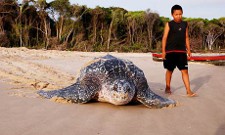
A female leatherback turtle returns to the Atlantic after laying eggs on a beach in French Guiana. The Marine Conservation Society wants the public to report turtle sightings in British waters, where they come to feed on abundant jellyfish. Photograph: Françoise Emily/Alamy
MCS specialists say the turtles are arriving from their nesting grounds in the Caribbean to feed on jellyfish, numbers of which, they believe, are rising, potentially providing more food for the critically endangered species.
Unlike other reptiles, says the MCS, leatherback turtles, which can weigh up to a tonne and grow to three metres (10ft) long, can maintain their own body heat up to 18C warmer than even the cold British summer seas.
This year, the Irish Sea in particular has been "turtle heaven" because of the huge numbers of jellyfish there, said Dr Peter Richardson, MCS's biodiversity programme manager and turtle specialist.
There have already been a dozen sightings, compared with a recent average of about 20 turtles a summer — but in a good year as many as 60 or 70 animals may be seen.
Richardson said the Atlantic appeared to have become the last stronghold of the leatherback. Breeding populations of turtles are increasing in the Atlantic while they face extinction in the Pacific and Indian oceans.
Their better fortune in the Atlantic could be due to conservation measures to protect their beach nesting sites, massive declines in species such as tuna which feed on baby turtles, and increasing numbers of jellyfish.
Pollution, over-fishing and climate change are among the theories for the increase in jellyfish.
"There are so many jellyfish this year, with lots and lots of reports, particularly in the Irish Sea — it's turtle heaven, there's so much food for them," Richardson said. "We want to know where and when they occur and if there are any hotspots so we know where they are and can run any protective measures where they occur."
He added: "The leatherback is the largest of all marine turtle species and at a distance could be mistaken for a floating log, but if you approach them slowly and carefully, once you see their large reptilian head, massive flippers and ridged leathery shell you can't mistake them for anything else."
How to rescue penguins from oil spills
When an oil tanker sank off the coast from Cape Town, South Africa, earlier this year, it spilled 1,300 tonnes of fuel between Dassen and Robben Islands where half of the world's population of the endangered African penguin, Spheniscus demersus, breeds. Of course, as happens with these events, the tanker sank during the penguins' breeding season, coating tens of thousands of birds in crude oil — a significant proportion of the remaining breeding population.
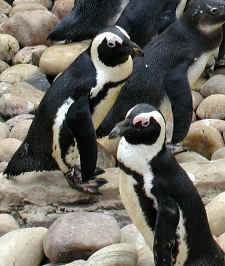
African penguins, Spheniscus demersus, Bristol Zoo, Bristol, England. Image: Adrian Pingstone
What to do with these birds? Predictably, the ongoing "kill or not to kill" controversy flared up again, but due to the location and timing of the spill and this species' endangered status, the stakes were higher than ever before. As always, some advocated killing the oiled birds.
"Kill, don't clean," German biologist, Silvia Gaus, had remarked after the BP oil spill in the Gulf of Mexico one year earlier. "The survival rate of oil-soaked birds is under 1 percent."
Ms Gaus's comments outraged the public. "Ms Gaus's comments outraged me, too" said Dyan deNapoli "because when I investigated her assertion, I found Ms Gaus was wrong.
In the wake of this controversy, the largest animal rescue event in history mobilised to save tens of thousands of oiled birds. And in fact, more than 91% of the oiled penguins were successfully rehabilitated and released — an amazing feat that could not have been accomplished without the tremendous international response that was generated.
Dyan "the Penguin Lady" deNapoli worked as the Senior Penguin Aquarist at Boston's New England Aquarium, where she hand-raised dozens of penguin chicks, presented daily programmes about penguins to aquarium visitors, and traveled the globe to work with penguin researchers in the field.
Now Ms deNapoli frequently writes on penguin topics and has served as the on-board penguin expert and guest lecturer on cruise ships visiting the Galapagos Islands and Antarctica. She estimates she has taught about 250,000 people in the US and abroad about penguins.
Dyan deNapoli is the author of the book, The Great Penguin Rescue: 40,000 Penguins, a Devastating Oil Spill, and the Inspiring Story of the World's Largest Animal Rescue and she can be found on facebook and twitter @ThePenguinLady
Offshore windfarms are good for wildlife
It is the evidence proponents of offshore wind farms have been waiting for: a Dutch study has found that offshore wind turbines have "hardly any negative effects" on wildlife, and may even benefit animals living beneath the waves.
The researchers reached their conclusions after studying a wind farm near Windpark Egmond aan Zee, the first large-scale offshore wind farm built off the Dutch North Sea coast.
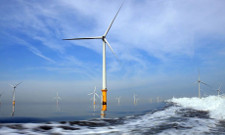
An offshore wind farm off the coast of Liverpool — such farms could have a positive impact on marine life. Photograph: Christopher Furlong/Getty Images
Anti-wind farm campaigners have often argued that wind farms can have a negative impact on bird populations, while some critics have voiced concerns that offshore wind farms could prove disruptive to marine life.
However, Professor Han Lindeboom from the Institute for Marine Resources and Ecosystem Studies at Wageningen University and Research centre, said that the new study revealed little evidence of negative effects on local wildlife.
"At most, a few bird species will avoid such a wind farm. It turns out that a wind farm also provides a new natural habitat for organisms living on the sea bed such as mussels, anemones and crabs, thereby contributing to increased biodiversity," he said. "For fish and marine mammals, it provides an oasis of calm in a relatively busy coastal area."
The research, sponsored by NoordzeeWind, a joint venture of Nuon and Shell Wind Energy, claimed that offshore wind farms actually have a beneficial long-term effect on wildlife.
The wind farm functions as a new type of habitat, the report said, detailing how new species are attracted to the turbine foundations and surrounding rocks. The researchers also noted that the turbines help to protect schools of cod, and that porpoises are heard more often inside than outside the wind farm.
Meanwhile, the survey concluded that sea bird species such as gannets tend to avoid the turbines, while seagulls appear unflustered and local cormorant numbers even increase.
"The number of birds that collided with the turbines was not determined but was estimated to be quite low on the basis of observations and model calculations," the researchers added in the article, published in online journal Environmental Research Letters.
The study noted that the effects of wind farms will inevitably vary depending on their position, but that offshore wind farms can contribute to a more diverse habitat and even help nature to recover from the effects of intensive fishing, pollution, oil and gas extraction, and shipping.
However, the report did recognise that the rotating blades can have a "disruptive impact" on some bird species, and recommends that wind farms are located in specific areas to minimise the possible impact.
Sellafield Mox plant closes, but Irish fears remain
Sellafield Mox nuclear fuel plant to close. It's a headline that generations of Irish environmental activists, and government ministers in Leinster House, never thought they would see. After just 10 years of operation — and at the cost of a vertiginous £1.4bn to the British taxpayer — the mixed-oxide fuel plant nestled on the edge of bucolic west Cumbria is to be decommissioned.
Sellafield has long been an emotive issue in Ireland. At just 128 miles from Dublin, the plant is within spitting distance of Ireland's densely populated eastern seaboard. The Irish Sea is now the most radioactively contaminated in the world, while in the wake of 9/11 concerns about a terrorist attack on the plant briefly gripped the Irish popular imagination.
Unsurprisingly then, yesterday's announcement that the Mox plant is to cease operation has been welcomed by Irish activists, many of whom have been involved in decades-long campaigns opposing the facility. However, the closure is anything but the end of Sellafield's nuclear story.

Sellafield nuclear reprocessing site in Cumbria. Photograph: David Moir/REUTERS
Last October, the environment secretary, Chris Huhne — in a volte-face from previous Lib Dem energy policy — announced that eight new nuclear power plants are to be constructed across Britain. Only last month it was confirmed that Sellafield is to be the site of one such new reactor, to be built by 2025. It is widely expected that additional employment at the new facility will at the very least replace the 600 job losses announced yesterday.
The earthquake in Japan — and the crisis at Fukushima — have radically altered nuclear priorities across Europe: Germany is to phase out all its plants by 2022, opposition to nuclear power is increasing in France and Italy. But here the only demonstrable effect is the closing of a reprocessing facility that was, from the off, run on a faulty economic model.
The Mox plant was built to handle plutonium dioxide that was shipped around the world, through the Irish Sea to Cumbria, where it was to be recycled from spent fuel at the Thorp plant at Sellafield. The environmental implications, particularly in the event of a disaster, of shipping highly radioactive cargo around the world are all the obvious; the financial rationale is equally flawed. Sellafield was designed to process 120 tonnes of Mox a year: in reality it produced barely a fraction of that. In the five years since opening in 2006 just five tonnes were made, and as of yesterday the total output over its lifetime stood at a paltry 13 tonnes. The loss of Japanese contracts in the aftermath of Fukushima sounded the plant's death knell.
As Irish campaigner Brian Greene, who blogs at Shut Sellafield, noted: "From a business perspective the Mox plant has been a total failure so it's no great surprise that they are shutting it down. But the legacy is huge. It'll cost millions to decommission, the land will never be used again."
Mox or no Mox, Sellafield will still pose an environmental threat. When the famous Calder Hall cooling towers were demolished in 2007 it took 12 weeks to remove all the asbestos from the debris. The site's radioactive legacy will last significantly longer.
Meanwhile, in May, British authorities backtracked on a commitment given to Irish environment minister Phil Hogan that Sellafield would be included in European-wide stress tests of nuclear installations following Fukushima. That the plant does not generate nuclear power was adduced, rather dubiously, to explain why an examination of Sellafield's resilience against earthquakes, tsunamis, air crashes and terrorism was unnecessary.
In 1981, the plant's name was changed from Windscale to Sellafield in an attempt to shift attention away from the plant's less than impressive safety record. Thirty years on it seems that, with the closing of the Mox plant, another attempted re-branding of Sellafield is underway.
But unless British government policy changes quickly, future generations on both sides of the Irish Sea still face the disquieting prospect a life lived under a nuclear shadow.
Secrecy surrounds the question: who owns UK fishing rights?
The decline of the British fishing industry is often blamed on the EU quota system — the means by which European policymakers decide how many fish European fleets are allowed to catch every year. Less is generally said about how the UK government allocates their share of EU quota domestically — and how this unfair allocation represents a stealth privatisation of public rights, destroying the British fishing industry and the coastal communities that depend on it.
In the UK, the right to catch fish in territorial waters has traditionally been public — owned by the crown and managed by the state on behalf of the people. As fish stocks have dwindled, and under the catch limits imposed by the EU common fisheries policy, these rights to fish have become increasingly valuable and can now be leased to fishermen for substantial amounts of money.
Given this, it is somewhat shocking that very few members of the British public know that the British government freely gave these fishing rights to a small section of the fishing industry in 1999. These public goods have, since then, been bought, sold and leased for private profit on an unofficial, non-transparent and loosely regulated quota market.
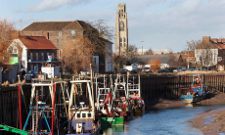
Small fishing boats in Boston, Lincolnshire. Photograph: Fabio de Paola
Thomas Appleby, a senior lecturer in law at the University of the West of England, has publicly questioned the legality of this "privatisation by stealth", which he calls "the biggest property grab since the Norman invasion". Legally, a state sell-off of public property should only be done through an act of parliament. "Government departments don't normally dish out valuable public rights to individuals without going through due process," Appleby wrote in the Ecologist in March, "this usually involves statutory checks and balances."
The vast majority of UK fishing rights were given to a small minority of large vessels. Smaller fishing boats (under 10 metres in length), which make up around 75% of the UK fishing fleet, were only granted about 4% of fishing rights. This means that thousands of British fishermen have been left with very little right to fish, although smaller boats provide more employment and are widely considered to be more environmentally friendly, they have been forced to either take on the considerable expense of leasing quota from the owners of fishing rights, or go out of business.
"It makes absolutely no sense" says Jeremy Percy, chief executive of the New Under Ten Fishermen's Association, "that small-scale fishers, with a heritage of genuinely sustainable fishing going back hundreds of years, should be forced to pay quota owners, often quota traders, ever increasing prices to lease the right to catch fish."
The identity of these quota owners and traders is shrouded in mystery, as the management of quota fishing rights is not in the public domain. Only the producer organisations (the industry membership associations that manage quota) know exactly who now owns fishing rights. The government has admitted that even they do not know who owns the quota.
According to one fishing industry representative I interviewed recently, there's a rumour that some is held by Manchester United. "I don't think that's true," he admits. "But there's no way of knowing for sure. I do believe that the Royal Bank of Scotland owns some quota, but again, there's really no way to confirm it."
Whitby boat-owner Bob Roberts has repeatedly filed Freedom of Information requests for information about who holds fishing rights, which have been refused. "I would consider it to be entirely within the British public's interest to know who owns our fishing rights," he says. "Since they are a national asset, I can see no reason why this information is not available."
With the common fisheries policy looking ever more likely to introduce a European quota market, it's of vital importance that we now take a good look at how fishing rights are allocated in the UK, before it is too late. Requests for information can be made to the Marine Management Organisation, or you can write to your MP to express concern about the secretive and undemocratic way in which the public right to fish has been privatised.
"It's time to introduce a fairer and more transparent method of allocation than the current one," says Jeremy Percy of the New Under Ten Fishermen's Association. "This system rewards those who have the biggest impact on the environment. Fishing rights belong to the public. Allocation based on environmental, social and economic criteria would increase employment, support coastal communities, dramatically reduce discards and provide greater protection to the marine environment at a stroke."
Offshore wind turbines in "conflict" with a golf course
Donald Trump has pledged to use "any legal means" to block the building of an offshore windfarm near his championship golf course in Aberdeenshire, claiming the development would spoil his view.
The proposed windfarm in Aberdeen Bay, about 1.5 miles from the golf resort, would install the next generation of offshore wind turbine technology.
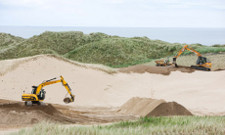
Donald Trump's golf resort under construction on the Menie estate, Aberdeenshire, with diggers stripping grasses from the coastal dunes, June 2011. Photograph: Murdo Macleod for the Guardian
The £200m energy scheme has just been formally submitted to Marine Scotland for approval. It has been cut back from up to 33 turbines to a maximum of 11 after safety concerns were raised by shipping agencies and Aberdeen heliport, the world's busiest, which serves the North Sea oil industry.
Trump, who hopes to open his first course at the Menie estate, near Balmedie, next July, in a development spanning about 500 hectares (1,235 acres), has renewed his long-standing complaints about the project. He believes the smaller proposal is still unacceptable: some of the turbines could stand up to 195 metres in the water, more than double the height of the Big Ben clock tower.
George Sorial, managing director of the Trump Organisation, said the windfarm would compromise the golf resort. "We are here to stay and I don't think it's a good idea to interfere with our investment. We are not going to support a project that compromises what we have done. We will use any legal means in our jurisdiction."
David Milne, one of Trump's most critical neighbours, whose house at Hermit Point is next to the golf course now under construction, said the billionaire developer was turning into a "New York clown". Milne's view over the dunes and the North Sea has been blocked by Trump; a 6-metre (20ft) high earth wall came first, later replaced with a row of spruce and pine trees surrounding Milne's property.
"How can a man who has just destroyed a site of special scientific interest and is in the process of despoiling an area of outstanding natural beauty with his golf course, comment on the view? It's laughable," Milne said.
It remains highly unlikely that Trump's objections will succeed. The windfarm is supported by the European commission and the Scottish government, and is one of a number of test centres seen as essential if the UK is to reach its target of 7,000 offshore wind turbines, with an expected investment of £100bn.
Trump is also in conflict with several of his most prominent supporters over the windfarm scheme, known as the European Offshore Wind Deployment Centre. The EOWDC project involves Aberdeen Renewable Energy Group, a publicly-funded agency part controlled by Aberdeenshire council, which approved Trump's resort, as well as Robert Gordon University in Aberdeen, which last year gave the American tycoon an honorary degree, and the Wood Group, founded by the oil services magnate Sir Ian Wood, a cheerleader for Trump's resort.
David Rodger, a spokesman for the wind project, said: "We have been in regular contact with the Trump Organisation and acknowledge the concern raised. We made a strong case for the environmental and economic benefits of the centre [for] global research and development for offshore wind… [which] is of strategic importance to Aberdeen, and Scotland's renewable energy ambitions."
New deep sea exploration vehicles are under development
You have the private plane, the luxury yacht and the helicopter. Only one hi-tech goody is missing from your list of billionaire playthings — a submarine to take you to the bottom of the ocean.
But now, thanks to a revolution in the manufacture of ultra-strong materials and advanced guidance systems, such a super-submersible is being built, and sold, by marine companies. Soon the abyss, and the strange denizens that inhabit its stygian depths, will be filled with packs of tiny submarines piloted by hedge-fund managers and venture capitalists.

An artist's concept of Virgin Oceanic Submarine Virgin Oceanic Expedition. Photograph: Virgin Oceanic / Rex Features
Among those who have already shown keen interest, either in funding or buying super-submersibles, are film director James Cameron, Google executive chairman Eric Schmidt and entrepreneur Richard Branson.
"Ninety per cent of the sea bed has still to be explored," said Patrick Lahey, president of Triton Submarines of Vero Beach, Florida. "There is a host of wonders down there. You could visit the mid-Atlantic thermal vents, where volcanic heated gases bubble up from Earth's core, or cruise down to the wrecks of the Titanic or the Bismarck. You will be able to access any place in the ocean and watch all those wonderful sea creatures."
Craft that can take two or three passengers on dives of 300 metres are already being built and sold by firms such as Triton or Deep Flight, which is based in California and was set up by UK marine engineer Graham Hawkes. The latter's craft have appeared in Bond films and have been sold to Richard Branson and venture capitalist Tom Perkins.
The depths achieved by these submarines are still relatively modest. However, versions are now being designed to survive dives down to 1,000 metres, depths normally frequented by military submarines. "These should be ready for their first journeys in the next few months," added Lahey.
However, it is the prospect of craft that would take their owners right down to the very deepest parts of the oceans that will create the greatest stir among thrill-seeking billionaires. Sites include the Challenger Deep, part of the Mariana Trench, near the Mariana Islands, in the Pacific. There is no light here, 11,000 metres below the surface, and the water pressure is a thousand times that of the atmosphere at sea level.
Nevertheless, several companies say they are now designing craft that will withstand these colossal pressures.
"We will use a sphere of special glass that is more than four inches thick for the main part of our submersible," said Lahey. "It will give its three passengers an all-round view of everything that is going on down there — though, obviously, when we get very deep, we will have to use pretty powerful lamps to illuminate proceedings."
By contrast, Deep Flight Challenger, a one-person, high-performance, experimental, prototype submersible designed by Hawkes, looks more like a plane and uses hydrodynamic force to propel the craft down. It is designed to dive to depths of 11,000 metres and was originally intended to be piloted by Steve Fossett, the US adventurer killed during an aircraft flight in 2007.
"It's about 24 feet long, with a 10-foot wingspan," Hawkes has said. "The pressure hull is made of a custom-designed carbon fibre, with very thick walls. Inside, we provide an artificial atmosphere. The pilot is not subjected to any pressure differences whatsoever. There's a big window in the front that's covered by a Plexiglas streamline canopy. The deep water typically is clear, so there will be lots to see. And it doesn't look like it, but the inside is actually a comfortable space."
In addition, James Cameron has formed a team which has been building its own deep-sea craft. This will cost around $8m and Cameron says he intends to use it to dive to the bottom of the Kermadec-Tonga trench, north of New Zealand, next summer.
And finally, there is the submersible backed by Google executive chairman Eric Schmidt through Deep Ocean Exploration and Research, a company based on Alameda Island in San Francisco Bay.
The torpedo-shaped Deepsearch looks more like a traditional submarine than any of its competitors. It will hold up to three people and would plunge the 11km to the ocean's floor in little more than an hour. Its personnel sphere, like that of the Triton model, will also be made of glass for better viewing.
"The goal is not a stunt dive" but to open up "a world asset capable of providing scientists with unlimited access to the deep ocean," says the website of the company which aims to sell each Deepsearch for around $40m. So far it has plans to build two, it says. Undersea transport has changed remarkably since it was imagined by Jules Verne in 20,000 Leagues Under the Sea.
"We are at the stage that we were in during the 1960s, when the very first private helicopters were used to ferry people to and from yachts," added Lahey. "This technology is less functional, I suppose, but it is a lot more exciting."
MARINET observes: Is the development of these new deep ocean submersible vehicles as innocent as it seems? Is the motivation tourism and exploration of wrecks such as the Titanic, or is it more commercial — such as prospecting for oil and minerals, leading to deep sea mining?
Ecologist attacks lobbyist system for fisheries 'mess'
A top marine ecologist has launched a bitter attack against the lobbyist system that he claims has reduced Europe's fish stocks to seriously low levels.
Rainer Froese asserts that contrary to popular belief, the EU Commission is not to blame for the fisheries 'mess', but the member states and the fishermen are.
Froese, a marine ecologist at the Leibniz Institute for Marine Sciences at the Christian-Albrechts University of Kiel, Germany, adds: "The sad state of the European fish stocks is not a natural or societal failure that good management simply could not overcome.
"No, it is a desired outcome of Europe's Common Fisheries Policy (CFP) which has allowed the fishing lobby to infiltrate the European Union's political system.
"The European public has been led to believe that fisheries management is decided by bureaucrats in Brussels. In fact, member states have the most influence — they make and implement the decisions that are made.
"In most member states this power is with the ministry of agriculture. Yet too many of these ministries have a cosy relationship with the fishing lobby — many of the civil servants firmly believe it is their job to protect the rights of their national fishing sector, including the rights to obtain subsidies and to overfish.
"This concentration of explorative, legislative and executive power within a ministry belies what we learned in school about the importance of separated powers in a democratic system.
"Perhaps it is because the public still has romantic notions about fishing — the media are drawn to fishermen who block ports or dump fish in the streets of Brussels — that the European fisheries lobby gets away with destructive tactics.
"It routinely discredits scientists and their advice, denies the depleted status of stocks, fights the establishment on protected areas, defends the use of destructive equipment, insists on the right to catch juvenile fish and requests the abandonment of closed spawning seasons and areas.
"In doing so it has destroyed the very basis that fishing depends on.
European fishers have profit margins of between 3% and 6%, whereas in New Zealand, which has successfully reformed its fisheries, the margins are closer to 40%.
"Fisheries management in Europe culminates in the closed-door meetings of the Council of the European Union. Decisions are typically taken by a two-thirds majority, but need consensus if the European Commission feels that its proposal has been ignored.
"This was recently the case in a preparatory meeting on the threatened bluefin tuna. The member states were unhappy with the Commission's proposal which followed the scientific advice and asked commission officials to leave the room. They agreed unanimously, with few abstentions, on much higher catches.
"Although the ministers change every few years, their advisors remain and oppose any true change. As a result, the CFP has more than 600 regulations — many of which contradict each other.
"For example, regulated mesh sizes catch smaller fish than the fishers are allowed to land. These fish are then dumped dead at sea.
"The setting of next year's catches has been described as 'political horse-trading' with unholy alliances supporting each other in an effort to secure the highest possible share for the national fishing sector.
"Thus, Germany and Poland will support higher French catches in the Atlantic, while France will back higher catches in the Baltic.
"This is the situation that Maria Damanaki faced when she took charge of European fisheries last year.
"Building on the excellent 2009 Green Paper on the reform of the CFP, which documents much of what I have described, Damanaki confronted the Council with clear demands for rebuilding European fish stocks until 2015 in accordance with international agreements.
"Internationally agreed reference points for sustainable fishing will finally be recognised and the discarding of perfectly good fish for bureaucratic reasons will be phased out.
"However the proposal falls short of reforms enacted in New Zealand, Australia and the United States. These countries have precautionary fishing targets and close fisheries when stocks enter the slope to collapse.
"Europe will have no such precautionary margins and will only gradually reduce fishing pressure when stocks are on the slope to collapse, with no default rule for closing a fishery.
"Whereas the other countries have phased out or drastically reduced subsidies, the Commission proposes only to reshuffle them.
"There is no sign that the proposal will tackle concentration of power with agriculture ministers or the excessive influence of the fishing lobby — for example, by transferring management of wild fish to environmental ministries.
"The Commission's restraint is understandable. It knows that its plans to save Europe's seas must be approved by the same advisers and lobbyists who have wrecked them."
The ocean depths are in urgent need of protection, say marine scientists
There's trouble in the depths. The deep sea is the last true wilderness on Earth, but 1,800 km below the surface, an environmental crisis is growing. Scientists at the Census of Marine Life (COML) project, the 10-year assessment of the world's oceans completed in 2010, have published their analysis of the impact humans are having on the deep sea. Their conclusions were stark: the largest habitat on Earth is being damaged by pollution, resource exploitation and climate change.
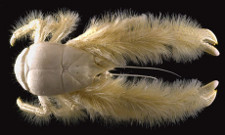
The yeti crab, Kiwa hirsuta, which lives around the hydrothermal vents of the Pacific Antarctic Ridge south of Easter Island. Photograph: A Fifis/AP
The deep sea accounts for 73% of the oceans, an area of 360 million square kilometres. It is a world completely unlike our own. Sunlight cannot reach the depths and the only flickers of light come from living things that use bioluminescence for hunting or disguise.
Far from being a barren wasteland, the deep sea is teeming with life. From vampire squid to blobfish, these extraordinary animals are found nowhere else and their habitats are as unusual as the creatures themselves. Hydrothermal vents, for example, spew out a variety of chemicals on which communities of bacteria can survive without any need for sunlight. There are even forests of coral adapted to live in the cold and dark, providing shelter for more than a thousand animal species.
All of this is under threat. Writing in the journal PLoS One, scientists led by Eva Ramirez-Llodra of the Institute of Marine Science in Barcelona conclude that humans are having severe impacts on the deep sea. In the past it was the dumping of waste that caused the most harm. "Approximately 6.4 million tonnes of litter per year is dropped into the oceans," they write.
Plastics are of particular concern. "There is accumulating evidence that 'mermaids' tears' (5mm in diameter) and microplastics (microscopic sand grain-sized particles of eroded plastic) are becoming more common in the world oceans," says the report. "Little is known however, of the true effect of these particles on the environment and fauna."
The main problems today are fishing and mining. Deep-sea trawling, say the researchers, is particularly damaging because the species caught are "often long lived, with slow growth and delayed maturity making them poorly adapted to sustain heavy fishing pressure."
Hydrothermal vents are beginning to be mined for precious metals such as gold and silver, and rare earth minerals such as cadmium. "Impacts are inevitable, such as habitat and fauna destruction at the mining site," say the scientists.
In the future, climate change will be the biggest problem. Rising carbon dioxide levels will increase the acidity of the oceans, for example, reducing the bio-availability of carbonate ions needed by creatures such as coral and oysters to make their shells and skeletons. "The distribution of cold-water corals already reflects the acidic conditions in the North Pacific but, in the long term, the entire ecosystem could be threatened by acidification," warn the researchers.
Lack of detailed scientific knowledge about the deep sea makes it a difficult environment to protect. One way to stop the damage is to create protected areas. "Management measures such as marine spatial planning and the creation of marine protected areas are very important policy developments that allow us to use resources in the ocean and protect its biodiversity," said Dr David Billett of the National Oceanography Centre in Southampton, who took part in the COML assessment.
A separate study, published in the Proceedings of the National Academy of Sciences, looked at the distribution of marine mammals around the world's oceans and lakes and concluded their conservation depends on protecting key areas that contain the greatest biodiversity.
Commenting on the deep sea study, Richard Page, a Greenpeace campaigner, said: "At present there is no overarching framework for protecting the marine life of the high seas. Such an agreement would enable the establishment of a network of marine reserves that would safeguard the extraordinary and vulnerable deep sea environments that we are only just beginning to understand."
This uncertainty is also a worry for scientists. Dr Billett said the environmental impacts on the deep sea environment were moving "much faster than scientists in understanding what is going on… this is a problem in the deep ocean, this lack of general knowledge."
His colleagues in the COML project agree. "One of the main problems that continue to cause concern is that the fastest movers in the deep sea are those who wish to use it as a service provider," they write. "Lagging behind somewhat are the scientists, managers and legislators."
2.1 million tonnes of North Sea cod thrown overboard between 1963 and 2008
UK fishing crews have thrown away stocks of cod worth about £1bn since 1963 due to the practice of discarding catches which exceed or fall outside quotas, according to a thinktank report.
Across all EU fleets, stocks of cod worth £2.7bn were discarded in the North Sea, the Channel and Skagerrak (the strait adjoining Norway, Sweden and the north of Denmark) between 1963 and 2008 according to the New Economics Foundation (NEF) study, Money Overboard. The report estimates that almost 7.5 billion cod have been discarded since 1963, which equates to a staggering 1.4 cod discarded for every cod landed.
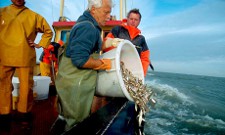
European Union fishing fleets have been forced to throw away 2.1 tonnes of cod, one of the best-documented stocks, to remain within their quotas, says the New Economics Foundation. Photograph: Alamy
Using discard data compiled by the International Council for the Exploration of the Sea and focusing just on cod, one of the best-documented stocks, the NEF calculated that just over 2.1m tonnes of the fish was thrown overboard during the period.
The report adds fuel to the bitter debate over the longstanding fisheries practice, particularly prevalent in heavy-regulated EU waters, of throwing overboard a significant proportion of any catch — up to two thirds in some areas — most of which is by this time dead or dying.
The fish are discarded for a variety of reasons: they can be species which are not included in the boat's quota, stocks which exceed a quota, too small, or simply from a species with low commercial value.
In March the EU's fisheries commissioner, Maria Damanaki, began steps to end the practice of discarding calling for reforms to quota systems to ensure this happened by the start of 2013.
The issue was highlighted in the UK by a high-profile campaign and accompanying TV series by the chef Hugh Fearnley-Whittingstall, something Damanaki cited as a key factor in her decision.
However, fishing lobby groups have objected strongly to the plan, arguing that already precarious livelihoods will be made untenable if crews are obliged to land large quantities of unpopular, low-value species.
A revised EU common fisheries policy (CFP), unveiled early in July, said discarding would be phased out, with fishing boats obliged to land all stocks of commercial fish they catch, although they will still not be able to sell undersized examples. The reforms are intended to provide an incentive for trawlers to invest in more selective fishing gear.
The NEF argues that a full discard ban will be good news for the fishing industry, citing a study published last month by academics at the University of York which found a discard ban by Norway, a non-EU member, during the late 1980s saw reduced profitability for just four years with Norwegian cod fisheries now among the most lucrative in the world.
Rupert Crilly, an environmental economics researcher at NEF, and the author of Money Overboard, said that for all the potential benefits of an EU discard ban it was only part of a wider issue, mainly connected to general overfishing.
"There needs to be a much more fundamental reform of the CFP, rather than just saying discards need to be banned. It's a little bit too simplistic. What we're saying in this report is: this is the value of what we've been throwing away, it's enormous and it needs to stop, but it's not the only thing that needs to change," he said. "It was vital for EU quotas to be set by scientists rather than politicians, and for the approach to be based around the effects on the whole ocean ecosystem rather than on a species-by-species basis. What we're arguing is that we need quotas set according to scientific limits. In the end this would be good news for the economy, the people who own the resource, which is everybody, and the fishing industry itself, which completes depends on stocks being at their best."
MARINET observes: The NEF report, Money Overboard, is absolutely right in saying that CFP Reform has to be far more fundamental than just saying that discards should be banned. However if catches are to remain constrained for scientific reasons (i.e. to keep the stock within safe biological limits so that its reproductive capability is not impaired) and quotas have to continue to be set in accordance with these scientific limits, then an important question arises — what exactly are these scientific limits?
At present it is being argued that these limits should be set on the basis of their "safe biological limit", or what is now being known as the maximum sustainable yield defined as the amount of fish that can be caught year after year without damaging the ability of the stock to reproduce itself.
However this approach, MARINET observes, has a flaw. The problem is simple. Do we accept the current depleted size of these stocks (depleted due to over-fishing) and set the "safe biological limit" at what it necessary to maintain these stocks at their current depleted level? Or, do we say that these current depleted levels are unacceptable and that we need to rebuild these stocks to a higher level so that they once again feed us properly — i.e. for a full twelve months of every year, instead of for only six months as is currently the case. This is the "food security" principle of fisheries management which states that we should be maintaining and managing our fish stocks at such a level so that they can feed us throughout the year.
If we accept the food security principle — and it seems eminently logical to do so — then we must manage stocks so that they increase above their current depleted levels and return to somewhere approaching their historic levels, see MARINET Briefing on historic levels, because it is when stocks sizes exist at or near their historic levels that we know that food security can be delivered, as it was in the past. In turn, this means that we also have to set the "safe biological limit" not at what is necessary to sustain the stocks at their current size, but rather at what is necessary to rebuild the stock size to a level that is necessary to deliver "food security" i.e. a stock level that is scientifically referenced to somewhere around its historic level.
How can we rebuild stocks to these increased levels, and thus secure a CFP and quota system that is actually sustainable and delivering food security?
The answer is straight forward. We have to protect the spawning and nursery grounds of these stocks by means of fisheries-based marine reserves. In other words, we have to close the spawning and nursery grounds to fishing until the stocks have recovered to the required levels and, once achieved, carefully manage fishing in those areas thereafter to ensure that this new scientific definition of "safe biological limit" is not compromised. Is this practical?
The answer is, yes. It is the ecosystem-based approach to fisheries management in action. There are hard truths to be faced because it does mean that fishermen in these areas will lose income and traditional rights. However, there is a way of responding positively to this. The fishermen must be re-employed as the managers of these fisheries-based marine reserves. This will give them a new income and new economic rôle and, in the course of this management, they will be required to patrol the reserves to prevent illegal fishing, and to assist in the monitoring and collection of scientific data necessary to rebuild the stocks.
This way, fishermen engage in the conservation of fisheries in a genuine, propely remunerated manner. And, they can be certain that these decisions based on the ecosystem approach to fisheries management will not only compensate them for their current loss of fishing rights, but will also guarantee that the stocks are being rebuilt for future generations of their families to fish once again.
Thus the rebuilding of fish stocks in order to deliver food security, with quotas referenced to historic stock levels and accomplished through the implementation of fisheries-based marine reserves where fishermen are the managers, is the way in which we should reform the Common Fisheries Policy so as to secure a return to health in our fisheries and the marine ecosystem as a whole. For further details, see MARINET's submission to the EU Commission.
How an offshore wind turbine is assembled — in pictures
The Ormonde windfarm has been built in the Irish Sea, 10km off Barrow-in-Furness. It comprises 30 5MW wind turbines with the capacity of 150 megawatts. It is expected to produce around 500 gigawatt hours of electricity every year, enough to supply the equivalent of approximately 100,000 homes per year with clean power. In order to see how a wind turbine in the Ormonde windfarm is assembled, visit the Guardian website
World War II unexploded mine closes North Sea pipeline
An oil pipeline off the north-east coast of the UK, responsible for delivering around 40% of oil produced in UK waters into the country,was shut down for five days so that an unexploded mine from the second world war can be removed.
The explosive was found in 300ft of water 25 miles off the coast of Peterhead, Scotland, in late March. The German-build sea-mine will be transported four kilometres (2.5 miles) away and detonated safely underwater, the operator of the Forties pipeline, BP, said.

BP's Forties oil pipeline has been closed for five days for the safe removal off an unexploded second world war mine off the coast of Peterhead in Scotland. Photograph: Graham Turner for the Guardian
"It didn't pose any risks where it was, but we knew pretty quickly we didn't want it there," a BP spokesman said. "It's very rare that the whole system is shut down, but we are not taking any chances."
BP has decided to shut down the pipeline now to deal with it because demand is typically lower around this time of year. The downtime will allow BP to carry out essential maintenance on the pipeline.
BP said: "The Forties pipeline system has started a five-day planned shutdown, to enable the safe removal and disposal of ordnance lying next to the pipeline. BP is also taking the opportunity to conduct some important maintenance while the system is shut down. All users of the Forties pipeline system have been kept regularly informed and are fully aware of the plan. The plans have also received full regulatory approvals and support."
Scientists identify 20 most important places in the oceans for marine mammals
Scientists have identified the 20 most important regions of the world's oceans and lakes that are key to ensuring the survival of the planet's marine mammals such as seals and porpoises. Their analysis also shows, however, that most of these areas are already under pressure from human impacts such as pollution and shipping.
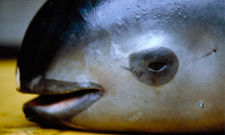
A dead California Gulf porpoise, also known as a vaquita (Phocoena sinus). Photograph: Reuters
Marine ecosystems around the world are deteriorating rapidly, according to Sandra Pompa, an ecologist at the National Autonomous University of Mexico who led the study, in particular due to habitat degradation, introduction of exotic species and over-exploitation of natural resources. Many species of marine mammals have experienced severe population depletion and several — including the Caribbean monk seal, Atlantic gray whale and the Steller's sea cow — became extinct in the 20th century because of the trade in their fur, blubber and meat.
Pompa led a team of scientists to try and identify which parts of the world's oceans were most crucial for the world's 129 marine mammal populations. Their results, published on Monday in the Proceedings of the National Academy of Sciences, revealed nine key global conservation sites that hold 84% of marine mammal species and 11 "irreplaceable" conservation sites, which contain species that are found nowhere else.
For the study, she split the oceans up into a grid of roughly 10,000 square kilometre boxes and examined which species lived in which boxes. The boxes were also assigned values based on whether they contained important feeding grounds or if they were in migration routes.
The main conservation areas, which contain 108 species, are the coasts of Baja California, north-eastern America, Peru, Argentina, north-western Africa, South Africa, Japan, Australia, and New Zealand. The 11 smaller conservation zones, which each contained unique species specific to them, included areas around Hawaiian and Galapagos Islands, Lake Baikal in Siberia and major rivers such as the Amazon, Ganges and Yangtze.
Pompa also correlated her map with information on human impacts such as climate disruption, ocean-based pollution and commercial shipping. Areas where there was no impact were scored zero, while areas of high impact were scored three. "Seventy per cent of the most impacted areas were near a key conservation site," said Pompa. "We are competing with [the sea mammals] in terms of shipping or ocean pollution. We want to build industry or touristic attractions and it's their home."
The next species of marine mammal that is likely to become extinct, said the researchers, is the Mexican vaquita, a small porpoise that is endemic to a small geographic area in the most northern part of Baja California. It is thought to number around 250 individuals in the wild.
"The Baikal seal, it's also a very small-numbered population," said Pompa. "Maybe you can think about the vaquita escaping the Gulf into somewhere else but the Baikal seal can't. It's a freshwater endemic mammal species. If any disruption in the lake should happen or a new sickness, they're all packed in one lake."
The researchers said that their maps should be the start of a conversation about where to site new conservation areas to safeguard the world's marine mammals. "Perhaps you are a government or NGO, you can use this information as a tool depending on the aim you have," said Pompa.
"Marine conservation is barely beginning. Marine mammals are great species because they represent healthy ecosystems so, if you begin to lose the species that give you a clue to a healthy ecosystem then you start with the degradation of all of the oceans. A visual projection of where is the richness, where are the endangered species, which corridors we need to protect in order to have all the species present in the world, it's a nice start to know where to focus the effort."
Glimmer of a suggestion that the Newfoundland ecosystem is recovering
The scientific journal Nature has published a small piece of good news. The infamous collapse in fish stocks in the waters off Canada's east coast has begun to be reversed. The data suggests that the wrecking of the world's oceans, a largely unseen but catastrophic process, is not inevitable, if we take the right steps to confront it.
The waters off Nova Scotia and Newfoundland were once famous for their fishing. After a voyage in 1497 one of John Cabot's crew reported that "the sea there is full of fish that can be taken not only with nets but with fishing-baskets". It was claimed that the sea was so thick with cod and haddock that boats could hardly be rowed through the water, or that people might be able to walk to land across the fishes' backs. Factory fishing all but obliterated stocks by the 1990s. As the food chain collapsed, populations of other smaller foraging fish, not of interest to trawlers, exploded. Scientists wondered if stocks of large benthic predators (of which cod is one) would ever recover.
Now there are signs that the damage can be undone. Given time, and protection, "the reversibility of perturbed ecosystems can occur", the Nature article concludes. Haddock has returned to pre-collapse levels; cod is a third of the way back. The lessons for Europe — in the middle of a debate about how to reform its common fisheries policy (CFP) — are obvious. Put science first. Limit catches. Ban fishing altogether when stocks get low. Treat the oceans as an ecosystem, not a resource. This is not happening at the moment: 88% of European stocks are being fished unsustainably and 30% are close to collapse.
In the North Sea, 93% of cod are fished before they can breed. The CFP will be revised next year, amid promises of sustainability. It should regulate fishing by the weight of fish caught, not the weight landed. At present the policy encourages fishing vessels to discard fish beneath the permitted size. But simply ending discards will do nothing to help stocks grow. The total catch must fall and rules enforced.
Perhaps it takes a spectacular event, such as the collapse of the Canadian Grand Banks fishing grounds, or the BP oil disaster in the Gulf of Mexico, to make people think about the seas. Environmental damage on land is easier to see, and fear. The threat to the oceans may be greater than most think. In June researchers at Oxford University warned of the "high risk of entering a phase of extinction of marine species unprecedented in human history". The world's seas, the groups suggests, are warmer, more acidic, more polluted and less diverse than hitherto understood. The good news from Canada is only a drop in the ocean.
Sea Shepherd finds the cash
The flagship for the environmental group Sea Shepherd was expected to set sail from Shetland after it paid £520,000 into court to secure its release.
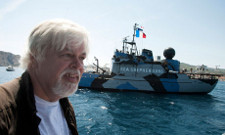
Paul Watson, president of the Sea Shepherd Conservation Society, said his group's action against a Fish and Fish vessel was justified as it was fishing tuna out of season. Photograph: Patrick Gherdoussi/AP
The Steve Irwin had been detained in Shetland more than two weeks ago after a Maltese company, Fish and Fish, raised an action for damages against the Sea Shepherd Conservation Society in a dispute over its direct action against the firm's bluefin tuna fishery last year.
The SSCS was ordered to deposit a bond of £520,000 by the court of session in Edinburgh on Tuesday, less than the sum originally sought by the firm: it is suing Sea Shepherd for $1.2m (£736,000) in damages and had sought £660,000 in security for the vessel.
There were significant fears that the ship, originally a Scottish government fishery protection vessel, may have had to be sold because the group would be unable to raise the money required.
The Steve Irwin, named after the Australian conservationist killed by a stingray in 2006, had been in Lerwick, the Shetland capital, before taking part in demonstrations against the Faroe Islands' annual pilot whale cull. The 40 campaigners on board the vessel hope to resume that action by joining its sister ship, the Brigitte Bardot, in Faroese waters this week.
Speaking from Sydney, Australia, Paul Watson, the group's founder, said he was confident the group would get their bond returned. He hopes to fly to Shetland on Friday to board the ship by helicopter.
"The bond has been paid, so the ship will seek port clearance in the morning and sail for the Faroe Islands," he said. He added that he was encouraged by the response the protesters had received from Faroese islanders. "The Faroese have not been killing any whales while the Brigitte Bardot has been there. We are making quite a bit of progress by talking to people. I find there is quite a lot of support for our position in the Faroes," he said. "We find it encouraging that quite a lot of people in the Faroe Islands are not happy with the killing of the pilot whales."
Fish and Fish lodged its court action after Sea Shepherd released about 800 bluefin tuna from nets off Libya in 2010 because, the conservation group said, the Maltese firm was illegally fishing. The firm accused Sea Shepherd activists of injuring two crew after violent confrontations.
In a statement released last month, soon after the Steve Irwin was impounded, Watson said: "Fish and Fish are claiming damages for the bluefin tuna we rescued from their nets in June 2010, fish that we believe were illegally caught after the season had closed, without an inspector onboard, or any paperwork documenting the legality of their catch."
Sea Shepherd beset by financial problems following court decision
John Vidal, The Observer 31st July 2011, reports: "Eco-pirate" Paul Watson is losing a race against time to recover his flagship boat, the Steve Irwin, which has been impounded in Shetland.
The world's most radical conservationist, Watson is being sued for $1.4m (£850,000) by a Maltese fishing company, Fish and Fish, one of Europe's leading tuna processors. The law suit against Watson's Sea Shepherd Conservation Society was filed last year after activists aboard the Steve Irwin freed 800 bluefin tuna from a pen in the Mediterranean.
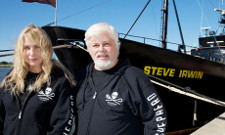
Terri Irwin, widow of the late crocodile hunter Steve Irwin, and Paul Watson aboard the Sea Shepherd flagship in Melbourne in 2007. Photograph: William West/AFP
Watson has just 10 days to raise the bond required to release the boat, which was named after the late Australian conservationist. It has been impounded in the harbour at Lerwick ever since the company sued him for damages. By last night, the society had raised about $500,000, after a global Twitter campaign and appeals to celebrities who have helped Watson in the past.
A co-founder of Greenpeace, Watson was picking up volunteer crew and restocking the Steve Irwin in preparation for a trip to protest against whaling in the Faroe Islands when he was served with the writ. The tuna cage that had been intercepted 40 miles off the Libyan coast in June last year held an estimated 35 tons of fish.
After a fracas in which there was hand-to-hand fighting between the two crews, Sea Shepherd sent in divers to release the 800 tuna.
Joseph Caruana, the owner of Fish and Fish, declined to speak to the Observer, but has claimed in the Maltese press that two of his divers were injured in the encounter, an allegation strongly denied by Watson. "Sea Shepherd cannot continue behaving this way. My aim is for justice to be done. I wanted to show that we mean business and we will fight our cause," he said.
Malta has become a global capital of tuna fishing, exporting £80m-worth of the fish, mainly to the Middle East and Japan. Ships surround the fish with nets and then tow them to cages, where they are fattened for export. Catches are limited to two weeks a year and ship owners have been given strict quotas to meet by governments, but, with little policing, the industry has been able to openly flout the law in Libyan waters.
Greenpeace and WWF called last month for a suspension of the Mediterranean tuna fishing season, saying that stocks were at critically low levels. "Mediterranean bluefin tuna is on the slippery slope to collapse," said Dr Sergi Tudela, of WWF Mediterranean.
In a statement last week, Watson said that if Sea Shepherd could not raise the money, the Steve Irwin could be held indefinitely and possibly sold. "This would not only be a financial hardship, but it could threaten our ability to defend whales in the Southern Ocean Whale Sanctuary from the Japanese whaling fleet this December. Fish and Fish are claiming damages for bluefin tuna we believe were illegally caught after the season had closed," he said.
In a separate incident, the Namibian government has declared Sea Shepherd a "threat to national security" after it tried to film the annual slaughter of 90,000 Cape fur seals on the west African coast. It is a crime to document seal clubbing in Namibia.
"The group tried to document the seal slaughter, but was detected by Namibian special forces," said Watson. "It was a good plan, but Sea Shepherd is no match for the Namibian military." The group fled to South Africa, having had its rooms burgled and cameras destroyed.
Leading US Arctic wildlife scientist "suspended"
It was seen as one of the most distressing effects of climate change ever recorded: polar bears dying of exhaustion after being stranded between melting patches of Arctic sea ice. But now the government scientist who first warned of the threat to polar bears in a warming Arctic has been suspended and his work put under official investigation for possible scientific misconduct.
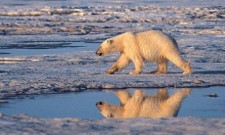
Charles Monnett's co-paper on the risk of polar bears drowning due to melting Arctic sea ice galvanised campaigners concerned about climate change. Photograph: Subhankar Banerjee/AP
Charles Monnett, a wildlife biologist, oversaw much of the scientific work for the government agency that has been examining drilling in the Arctic. He managed about $50m (£30.5m) in research projects.
Some question why Monnett, employed by the US Bureau of Ocean Energy Management, Regulation and Enforcement, has been suspended at this moment. The Obama administration has been accused of hounding the scientist so it can open up the fragile region to drilling by Shell and other big oil companies.
"You have to wonder: this is the guy in charge of all the science in the Arctic and he is being suspended just now as an arm of the interior department is getting ready to make its decision on offshore drilling in the Arctic seas," said Jeff Ruch, president of the group Public Employees for Environmental Responsibility. "This is a cautionary tale with a deeply chilling message for any federal scientist who dares to publish groundbreaking research on conditions in the Arctic."
The group filed an official complaint on Monnett's behalf on Thursday, accusing the government of persecuting the (PDF) scientist and interfering with his work. It seeks his reinstatement and a public apology.
Monnett was on a research flight tracking bowhead whales, in 2004, when he and his colleagues spotted four dead polar bears floating in the water after a storm. The scientists concluded the bears, though typically strong swimmers, had grown exhausted and drowned due to the long distances between patches of solid sea ice. It was the first time scientists had drawn a link between melting Arctic sea ice and a threat to the bears' survival.
Two years later, Monnett and a colleague published an article in the science journal Polar Biology, writing: "Drowning-related deaths of polar bears may increase in the future if the observed trend of regression of pack ice and/or longer open water periods continues."
The paper quickly heightened public concern for the polar bear. Al Gore, citing the paper, used polar bear footage in his film Inconvenient Truth. Campaigners focused on the bears to push George Bush to act on climate change, and in 2008, the government designated the animal a threatened species.
It was the first animal to be classed as a victim of climate change.
In 2010 the Obama administration began an investigation into his work. The scientist was suspended with pay on 18th July. He is said to be under a gagging order and forbidden from communicating with his colleagues. The employee group's complaint alleges that the investigation is a thinly veiled attempt to disrupt scientific work on the Arctic.
Oil firms, which want to drill in the pristine environment of the Chukchi and Beaufort seas, have been complaining of delays caused by environmental reviews. This month Obama issued an order to speed up Arctic drilling permits.
A spokeswoman for the Bureau of Ocean Energy Management Regulation and Enforcement (Boemre) said the government would continue to carry out research on the potential impacts of Arctic drilling, despite Monnett's suspension.
"All of the scientific contracts previously managed by Mr Monnett are being managed by the highly qualified scientists at Boemre," Melissa Schwartz said in an e-mail. She noted that the investigation was being overseen by the inspector general, which is independent, and that it was being conducted according to the Obama administration's new guidelines on scientific integrity.
However, Peer argues the exercise is intended to discredit Monnett's brief paper on the polar bear.
Other organisations also accused the government agency of a long record of meddling in science. A 2009 report by the Government Accountability Office found huge gaps in Boemre's research on the impacts of drilling in the Arctic. And the Alaska Wilderness League stated: "Alaska Boemre has continued to ignore science and traditional knowledge in its decision-making about oil and gas development."
Documents posted on the League's website include a transcript of a conversation between investigators and Jeffrey Gleason, another government scientist on the 2004 trip. Gleason, who works for the government, in the Gulf of Mexico, said he did not necessarily share Monnett's conclusions that the polar bears were killed as a consequence of climate change. "It's something along the lines of the changing environment in the Arctic," he was quoted as saying.
Can the oceans be cleared of waste plastic?
John Elkington writes in The Guardian, 1st June 2011 "Ian Kiernan is one of the most interesting people I have met. When I saw him in Sydney last year, he told me of a defining moment in his life: when he was involved in the BOC Challenge solo yacht around-the-world race — and found himself in the legendary Sargasso Sea. Having looked forward for years to seeing the fabled golden weeds, he came on deck to find his boat surrounded by plastic debris.
"As he put it later: "I can't overstate the disappointment I felt when I found this sea of magic and myth littered with rubbish from discarded thongs, plastic buckets and disposable nappies, to toothpaste tubes and plastic bags."
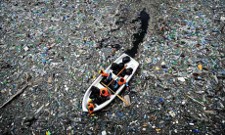
Despite decades of efforts to prevent and reduce marine debris, the problem continues to grow. Photograph: Dimitar Dilkoff/AFP/Getty Images
"In 1989, at the same time we were developing the green consumer movement, he decided to make a difference in his own backyard, Sydney Harbour. He organised the first Clean Up Sydney Harbour Day, motivating 40,000 volunteers to remove rusted car bodies, plastics of all kinds, glass bottles and cigarette butts. His conclusion: if a city could mobilise to take action, so could the whole nation. Almost 300,000 volunteers turned out on the first Clean Up Australia Day in 1990 — and that involvement has steadily increased over the ensuing years.
"Julia Hailes, my co-author on The Green Consumer Guide in 1988, had previously served as crew on a yacht with the late Teddy Kennedy — and recalled hearing those aboard complaining about the plastic litter they were sailing through, while their crew gaily tossed sacks of rubbish overboard.
"All of this was brought forcefully back to mind when David de Rothschild followed in the wake of one my all-time heroes, Thor Heyerdahl. But instead of building his raft out of balsa, like the Kon-Tiki, the Plastiki was constructed from plastic bottles. And, in addition to seeing far fewer top predators than Heyerdahl did, the Plastiki crew were appalled by the immense amounts of plastic debris they found in great, swirling gyres in mid-ocean, areas that now go under the collective title of the Great Pacific Garbage Patch.
"Despite decades of efforts to prevent and reduce marine debris, such as discarded plastic, abandoned fishing nets and industrial waste, the problem continues to grow. When I spoke at the PlasticsEurope PolyTalk '11 conference in France in May, I discovered that organisations that many see as brakes on progress — trade associations and industry federations — are finally coming together to tackle the problem.
"The Fifth International Marine Debris Conference earlier in the year, which brought together experts from 35 countries, governments, research bodies, corporations including Coca-Cola, and trade associations such as Plastics Europe, resulted in new commitments and partnerships to address the issue of marine debris.
"One key outcome was the Honolulu Commitment, hopefully symbolising a new, cross-sectoral approach to help reduce marine debris, as well as the growing damage they can cause to marine habitats and, ultimately, the global economy. At least 267 marine species worldwide are affected by entanglement in or ingestion of marine debris, including 86% of all sea turtles species, 44% of all seabird species and 43% of all marine mammal species.
"There is also growing concern over the potential impact on human health of toxic substances released by plastic waste in the ocean. Small particles (known as microplastics) made up of disintegrating plastic items or lost plastic pellets used by industry, may accumulate contaminants linked to cancer, reproductive problems and other health risks.
"One of the key themes to emerge from the Honolulu Marine Debris Conference was the need to improve global waste management. Improving national waste management programmes not only helps reduce the volume of waste in the world's seas and oceans and subsequent damage to the marine environment, but can also bring real economic benefits.
"In the Republic of Korea, a policy of "extended producer responsibility" has been enforced on packaging (paper, glass, iron, aluminium and plastic) and specific products (batteries, tyres, lubricating oil) since 2003. This initiative has resulted in the recycling of 6m metric tonnes of waste between 2003 and 2007, increasing the country's recycling rate by 14% and creating economic benefits equivalent to $1.6bn (£971m).
"Waste management is one of ten economic sectors highlighted in Unep's (United Nations Environment Programme) Green Economy Report, launched in February. The report highlights enormous opportunities for turning land-based waste — the major contributor to marine debris — into a more economically valuable resource. The value of the waste-to-energy market, for example, which was estimated at $20bn in 2008 is projected to grow by 30% by 2014.
"You still find plenty of people in the industry prepared to argue that plastic products — particularly plastic bags — are but a small part of the problem. Ignore them. As Ian Kiernan has put it, "Just like climate sceptics, our political leaders continue to listen to the self-interests of industry that claim plastic bags are not a problem."
"Yet a Unep report, Marine Litter: A Global Challenge, found that plastic, especially plastic bags and PET bottles, is the most pervasive type of marine litter on the planet, with plastic making up over 80% of all rubbish found in seas worldwide. "Plastic bags alone make up almost 10%," Ian Kiernan stresses.
"One chink of light comes from the fact that PlasticsEurope helped convene 47 plastics industry organisations in Honolulu to sign a joint declaration on solutions for marine litter. Interestingly, Cleaning Up Sydney Harbour is now a global phenomenon, in the form of Clean Up the World, which mobilises an astounding 35 million volunteers in 130 countries each year. Little more than a drop in the ocean of the overall problem, but a powerful indication of the potential muscle of the anti-litter movement.
"Now all people like Ian Kiernan, David de Rothschild and the rest of us have to do is breathe down the necks of these associations for the next 40-50 years.
Rodent threat to seabirds and marine life in Scilly Isles
The rat population on the Scilly islands of St Agnes and Gugh may not have quite reached Hamelin-like proportions. Nevertheless, the entire adult population of the two islands has backed plans by conservationists to rid the place of rodents.

Between 1983 and 2006, the bird population of the Scilly isles fell by almost 25% thanks in part to growing rat numbers. Photograph: PA
The problem is not that 3,100 brown rats menace the 70-odd human beings — but they are wreaking havoc on precious bird populations.
Tony Whitehead, a spokesman for the bird conservation charity the RSPB, said rats were a problem across the Isles of Scilly, the archipelago lying 28 miles off the south-west coast of mainland Britain.
Between 1983 and 2006 it was estimated that the bird population fell by almost 25%. "The availability of food is a major problem but the rats are also having a significant impact on birdlife," said Whitehead.
Two of the key species under threat by rats are the storm petrel and manx shearwater, both of which nest in burrows and so are easy prey for rodents. But the rats are not fussy and also target the Scilly shrew, only found on the islands, crabs and even limpets.
A feasibility concluded that the rat population could be eradicated on St Agnes and Gugh, which are linked by a sandbar, because they are far enough away from other islands to make it impossible for other rats to swim across and take their places.
The programme is also considered a priority because St Agnes and Gugh are close to an uninhabited island, Annet, which has hugely important colonies of seabirds and the fear is rats could reach there and cause devastation.
The RSPB, Natural England and other local conservation groups are asking the European Commission for a grant of £160,000 to bring in pest-control experts to poison the rats. According to the groups, they asked every adult on the islands and nobody objected to the idea. "We're all very pleased that they are going to try to get rid of the rats," said Jimmy Paget-Brown, who runs a self-catering cottage on St Agnes.
Many islands have armed themselves with vicious-looking rat traps and poison but a rat census found there are still between 20 and 25 rats per hectare. Paget-Brown insisted that it wasn't obvious that the island was over-run by rats. "It's not as if you see them running all over the place. I can't remember the last time I saw one but of course they are there and we'd rather they weren't."
Rats have been removed from the island of Lundy, off the coast of Devon, in recent years easing pressure on bird populations.
It is not just a British problem. The RSPB is carrying out a rat eradication programme on Henderson Island in the south Pacific to try to protect birds including petrels.
Algal pollution of Brittany's coastline worsens
Fears are growing over potentially lethal green algae piling up on the north Brittany coast following corpses of wild boars washing up at the picturesque tourist destination of côtes d'Armôr.
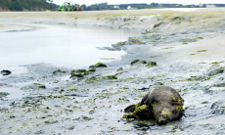
A wild boar on Brittany's shoreline. Around 31 boars have been found dead recently on the coast, suspected of drinking water contaminated by green algae. Photograph: Damien Meyer/AFP/Getty Images
Three dead boars were found floating in the water or slumped on muddy banks of the Gouessant estuary at Morieux on Wednesday after 18 were found dead the previous day. A total of 31 animals have been found dead this month.
Close to the estuary a beach at Saint-Maurice is now closed because of stinking piles of sludge from decomposing green algae. The local mayor said the beach had been cordoned off because the slime could harbour pockets of toxic gas fatal to humans if they slipped on it.
Local environmentalists have long campaigned against the dangers of what has become known as Brittany's "killer" green algae. It has been affecting the rugged north Breton coastline for decades but has increased in recent years, causing the death of a worker who was clearing it in 2009, as well as killing dogs and a horse walking on the beach.
Ecologists blame the spread of the algae on nitrates in fertilisers used in intensive pig, sheep and dairy farming in Brittany, saying the nitrates flow into the river system and enter the sea.
The government has launched a massive long-term plan to clear the beaches of algae, hauling away the noxious growth with bulldozers. But campaigners say nothing will change unless Brittany's powerful agriculture and food industry cuts its nitrates use. The algae is harmless until it dries and then decomposes, giving off a foul smell. Pockets of the toxic gas can become trapped under its crust.
Autopsies were being carried out on the boar corpses, which were also being tested for hydrogen sulphide, a poisonous gas. But officials said it was too early to say how the animals died or whether the green algae was to blame. An official analysis of the water in the estuary found that green algae was "above the alert level but below the danger level".
A local police official, Philippe De Gestas, said of the dead boars: "They were not [otherwise] sick and they did not drown."
Yvette Doré, the Socialist mayor of the neighbouring area of Hillion, told Le Monde she was "under no illusion" and that the boars' death was "very certainly" linked to toxic gas from the green algae. In Hillion in 2009 a 27-year-old vet was dragged unconscious from a metre-deep patch of rotting algae after his horse collapsed and died within minutes from fumes given off by the sludge that was heaped on the beach.
The local environmental group Eau et Rivières de Bretagne suggested that the boars could have been killed by drinking water contaminated with the algae and noxious gas. Thousands of tonnes of green algae have been cleared from the Brittany coast this year. In Finistère the amount of algae has grown since last year.
In a front-page editorial entitled, Green Algae: The Unbearable Denial, Le Monde said the French state, in thrall to lobby groups, was downplaying the rôle of agricultural pollution in the proliferation of noxious algae.
Environmentalists have claimed that politicians are too scared of alienating the farming vote before next year's presidential election so had failed to take big measures on curbing nitrates.
Brittany is the biggest stock raising region in France, with a high concentration of pig, poultry and dairy farms.
On a visit to Brittany this month the French president, Nicolas Sarkozy, defended farmers, saying they were not to blame for the green algae. He dismissed as "environmental fundamentalists" those people who were loudly campaigning over the nitrate link to the algae.
Census of Marine Life project wins international prize
As marine scientists ponder a possible sequel, the first global Census of Marine Life (www.comlsecretariat.org) project has been honoured with one of the world's foremost environmental prizes, awarded by Japan.
The prestigious International Cosmos Prize, created to commemorate Expo '90 in Osaka, recognises contributions to understanding of relationships among living organisms, as well as the interdependence of life and the global environment.
There were 141 nominees in 2011 for the annual prize, which consists of a certificate of merit, a medallion, and 40 million yen (US $510,000). It will be awarded to the Census' Scientific Steering Committee in Osaka October 18.
The Census of Marine Life ended in October 2010 after a 10-year global exploration involving 2,700 scientists from 80 nations. They reported what, where and how much lives and hides in global oceans, established a baseline against which to measure change, discovered thousands of new species, mapped marine highways and rest stops, documented diminished abundance and left an online directory of species' addresses worldwide.
The award announcement comes as scientists finalise a strategy for a potential follow-on programme of integrated global marine biodiversity research to address new questions and important emerging themes. The strategy will be presented at the "Beyond 2010" workshop 30th Sept. and 1st Oct. at the 2nd World Conference on Marine Biodiversity in Aberdeen, Scotland. For more information: www.comlsecretariat.org/community-resources/beyond-2010-workshop
UK leads in offshore wind turbine installation
The UK has sailed ahead in offshore wind power generation in the past six months, building more offshore windfarms than any other country in the world, and accounting for almost all of the turbines erected in European waters this year.
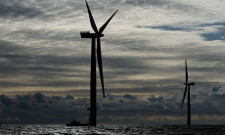
Walney offshore windfarm in Barrow-in-Furness, Cumbria. Photograph: Jeff J Mitchell/Getty Images
Of only 108 offshore turbines built around Europe's coastline from January to June, a whopping 101 were built around the UK, with only six built in Germany, and a single one in Norway, according to estimates published by the trade body European Wind Energy Association (EWEA).
Chris Huhne, energy and climate change secretary, told the Guardian the figures showed how fast the UK was moving in renewable power. "The UK is the undisputed home of offshore wind energy. Our natural resource and competitive advantage mean we have the biggest market in the world. We're blowing away the competition," he said. "It's part of the low-carbon revolution that's under way in the UK, bringing jobs and growth in new industries and building us a future less exposed to volatile global energy prices."
Wind energy is now one of the most important construction sectors in Europe, as most of the rest of the construction industry suffered badly during the recession. Offshore wind is seen as particularly important as the turbines can be bigger and wind speeds tend to be higher so energy can be generated more efficiently, and because in many countries the best onshore wind spots have already been taken or wind developers face opposition in erecting turbines.
However, there is still a time lag between the construction of offshore turbines and their connection to the electricity grid, as over the first six months of the year only about two thirds of the number of turbines built in the UK were actually connected to the grid. In the UK, 68 turbines were connected over the period compared with the 32 turbines, the vast majority of them built before the beginning of this year, that were connected to the German grid over the same period.
Owing to the difference between the number of turbines built and the number connected, the UK showed less progress than it should have in adding new generating capacity to the grid: 245 megawatts (MW) added so far this year, against 103MW for Germany because of the number of previously stranded turbines now wired up.
But the scale of the UK's ambitions is also apparent from EWEA's research: the turbines built this year represent only a fraction of the numbers planned for windfarms that have already begun, and the UK's plans far outstrip those of other countries. When the windfarms begun or added to this year are completed, they will be able to provide about 2,240MW of generating capacity in the UK. By contrast, when the German farms are complete their capacity will be only about one-fifth of the size as much, at 450MW.
These numbers also do not capture windfarms that are planned but are still not under construction, of which there are many more in the UK. Across Europe, as of 30 June 2011, there were 1,247 offshore wind turbines fully grid connected with a total capacity of 3,294 MW in 49 windfarms spread over nine countries. Although seven more turbines were erected in the first six months of 2010 than in the same period this year, the turbines tended to be bigger and more powerful, so the amount of generating capacity installed was greater this year.
Christian Kjaer, chief executive of EWEA, said progress had been made on offshore wind in the first half of the year but warned about the financial problems still facing the sector. "While we see several positive trends for the European offshore wind power sector we are not home and dry yet," he said. "We are coming out of the financial crisis but are still facing a potential worsening of the general economic crisis. The number of banks lending for offshore windfarms is steadily growing, although there is a continued need for attracting an increasing number of large institutional investors to offshore wind projects — presently the largest construction undertakings going on in Europe."
EWEA found that more banks were now interested in financing offshore windfarms — more than 20 are now involved — and said it was "positive" that the European Investment Bank continues to provide funds, and that the UK government is to make offshore wind a priority for the planned "green investment bank", to be set up next year with about £3bn.
Offshore wind technology is also progressing — the single turbine erected in Norway was a prototype floating turbine, that if successful could allow turbines to be placed in deeper water than is possible at present, opening up new areas for exploitation, and allowing turbines to be moved around if necessary.
Gt Yarmouth Outer Harbour beach erosion study under fire
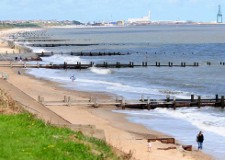
Hopton Beach last year — now missing!
Eastport UK and Great Yarmouth Borough Council, owners of the newly constructed Great Yarmouth outer harbour, could face a bill of millions of pounds to restore the rapidly vanishing Hopton beach if a new survey finds that deep dredging for the port and channels is responsible for its disappearance.
The area coastal leisure industry and Hopton Holiday Village owners Bourne Leisure, backed by Potter's Leisure Resort, are concerned that the dredging of the nearby harbour has led to the loss, and the company concerned has already spent a six-figure sum investigating the issue itself, with results due hopefully within the next two months. Despite widespread concern and the given grave considerations of MARINET, placed long before the construction and dredging, plus a host of evidence of the results of dredging, HR Wallingford was consulted by the port owners; they reported no proof of the port's responsibility for the sand's disappearance and stated they were unable to state why the beach has gone (!)
But Bourne Leisure highlights fears that HR Wallingford's yearly monitoring reports of the coastline are based on "old science" and are "not fit for purpose" They state "grave concerns" over the future of the beach and the studies, concluding: "In the event that damages are shown to have occurred to Bourne Leisure's business due to the outer harbour then Bourne Leisure would seek redress from the GYBC." Though keen to stress conclusions had yet to be drawn on whether the outer harbour was responsible, they said if they were pursuing redress in the form of restoring the beach it would "be in millions, not hundreds of thousands of pounds."
Chinese submarine breaks depth record in effort to "claim" the ocean seabed
Chinese scientists aim to complete the world's deepest dive in a manned submersible in 2012 by going to 7,000 metres (22,966 ft) beneath the sea after a successful test dive in the Pacific Ocean.
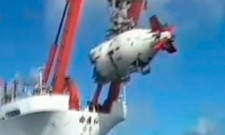
Chinese submersible Jiaolong is being loaded on to a scientific exploration ship. The vessel successfully reached a depth of 5,057 metres. Video image: Xinhua
The Jiaolong, named after a mythical Chinese sea dragon, reached 5,057 metres, its lowest-ever depth, in a dive in international waters in the Pacific in the early hours of Tuesday, Xinhua state news agency said. "Such a depth means the Jiaolong is capable of reaching over 70% of the seabeds in the world," it quoted the head of the diving operation, Wang Fei, as saying. "It will pave the way for a record-breaking 7,000-metre test dive in 2012."
The current record holder is Japan's Shinkai 6500, which dived to 6,527 metres in August 1989.
Wang said the Jiaolong had performed admirably: "At a depth of 5,000 metres, the Jiaolong withstood great pressure amounting to 5,000 tonnes per square metre." Further tests are expected, during which it will carry out "scientific research and further try out different functions of the craft", Xinhua added.
The Jiaolong was used last year to plant the national flag deep beneath the South China Sea, where Beijing has tussled with the US and south-east Asian nations over territorial disputes.
While the Jiaolong falls under the remit of the ostensibly civilian State Oceanic Administration, China is developing a formidable submarine capability and the military will be paying close attention to the submersible's development.
President Hu Jintao has made the upgrading of the navy a key element of the country's military modernisation, including the development of China's first aircraft carrier.
Cautious welcome from NGOs to IMO decision to ban dumping of ship waste at sea
Seas At Risk and the North Sea Foundation issued the following press release on 18th July 2011:
"London — After years of campaigning for stricter control of ship waste dumping at sea, environmental NGOs are cautiously celebrating substantial revisions to global rules governing garbage discharges from ships, as adopted at the IMO late on Friday last week. NGOs are however concerned about loopholes and the likely inability of governments to properly enforce the new regulations.
"Environmental groups the North Sea Foundation and Seas At Risk, who are represented at the International Maritime Organisation (IMO) through the Clean Shipping Coalition, have been calling for International action on ship source litter for many years.
"The most significant change to Annex V of the MARPOL Convention comes in the shift away from a system that listed what could not be dumped, to one that contains a "general prohibition" on dumping with only limited exceptions. Environmental NGOs welcome this development but fear that regulators have not given sufficient attention to the enforceability of the new regulations.
"A key criticism of the new regulations concerns their failure to create a "closed system" that would allow full waste accounting to expose instances of illegal dumping. The existence of unnecessary exceptions to the "general prohibition" together with the continued use of on-board incinerators make it impossible to tell if the waste a ship delivers to a port reception facility is all the waste it has generated on its voyage or not.
"It is also the case that although the dumping of plastics has been prohibited for many years, on most beaches, and certainly on any that are close to a shipping route, it is easy to find plastic items that have come from ships.
Jeroen Dagevos of the North Sea Foundation said: "After years of campaigning for international action on ship waste dumping we applaud the IMO for adopting stronger regulations. The global marine environment is under serious threat from the build of marine litter and although we are concerned that the current enforcement and compliance system is not working, these revisions are a big step towards ending the problem of ship waste dumping."
Chris Carroll of Seas At Risk said: "The extension of the ban on dumping plastics to other ship waste is welcome but the amended regulations are a missed opportunity as regards effective enforcement. Policing ships at sea is almost impossible and without a closed system and full waste accounting it will be difficult for port authorities to identify breaches of the regulations."
Concern that ice melting in the Arctic is releasing historic inventory of toxic pollutants
The warming of the Arctic is releasing a new wave of banned toxic chemicals that had been trapped in the ice and cold water, scientists have discovered.
The researchers warn that the amount of the poisons stockpiled in the polar region is unknown and their release could "undermine global efforts to reduce environmental and human exposure to them."
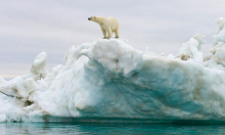
Melting Arctic ice is allowing chemicals to seep out, including the pesticides DDT, lindane and chlordane, as well as PCBs. Photograph: AlaskaStock/Corbis
The chemicals seeping out as temperatures rise include the pesticides DDT, lindane and chlordane, made infamous in Rachel Carson's 1962 book Silent Spring, as well as the industrial chemicals PCBs and the fungicide hexachlorobenzine (HCB). All of these persistent organic pollutants (Pops) are banned under the 2004 Stockholm Convention.
Pops can cause cancers and birth defects and take a very long time to degrade, meaning they can be transported for long distances and accumulate over time. Over past decades, the low temperatures in the Arctic trapped volatile Pops in ice and cold water.
But scientists in Canada and Norway have now discovered that global warming is freeing the Pops once again. They examined measurements of Pops in the air between 1993 and 2009 at the Zeppelin research station in Svalbaard and Alert weather station in northern Canada.
After allowing for the decline in global emissions of Pops, the team showed that the toxic chemicals are being remobilised by rising temperatures and the retreat of the sea ice, which exposes more water to the Sun. For example, air concentrations of PCBs and HCBs have shown a rising trend from about 2004 onwards. Their work is published in the journal Nature Climate Change.
Hayley Hung, a member of the air quality research division of Environment Canada and of the team, said its work provided the first evidence of the remobilisation of Pops in the Arctic. "But this is the beginning of a story," she told the Guardian. "The next step is to to find out how much is in the Arctic, how much will leak out and how quickly."
Hung said that, with the exception of lindane, there was little existing knowledge of the scale of the Pops stored in high latitude regions: "We really don't know."
The fate of the frozen Pops depends on the speed of warming in the Arctic — it is currently heating up much more quickly than lower latitudes — as well as how the chemicals interact with snow and rain. Pops accumulate in fats and are therefore concentrated up the food chain, but Hung cautions that food chains themselves in the Arctic may be altered by climate change.
Is sonar or oil drilling affecting Scottish whales?
A rescue operation was launched recently to save around 60 pilot whales which had become stranded in a sea loch in the Highlands.
The Whale and Dolphin Conservation Society, which sent a team to the area near the Kyle of Durness, said there is a chance that the pod is the same one that became stranded in the Outer Hebrides in May, leaving two whales dead.
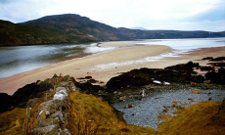
The Kyle of Durness in the Scottish Highlands where some 60 pilot whales have found themselves stranded. Photograph: Linda Nylind for the Guardian
The coastguard was alerted that a pod of whales appeared to be in difficulty on the remote coastline. Aberdeen coastguard said it had two teams on site, with a third on its way. A spokesman said: "We got a call at about 11.45am from a member of one of our coastguard teams up there. At first it was thought there were 40 minke whales but now it is thought there is up to 60 long-finned pilot whales. They are stuck in rock-pools and the tide is receding."
British Divers Marine Life Rescue was also on the scene. The BDMLR said it had received reports of 15 pilot whales trapped in rock pools. "We are scrambling as many people there as possible," a spokesman said.
Danny Groves of the conservation society said the pod could be the same one involved in a stranding near South Uist in May. In that incident, 60 of the mammals swam into a narrow and rocky sea loch on the island's coast prompting fears that dozens could be killed in a mass beaching. Two were found dead as the pod eventually left Loch Carnan, on the north-east corner of South Uist.
At the time, officials in Ireland were warned to watch out for a mass stranding on their shores. Last year, 35 pilot whales that appeared to be in danger of beaching in Loch Carnan left South Uist intact but less than a week later, 33 of the pod were found dead on a deserted island off County Donegal.
"It could well be (the same pod)," said Groves. "That's the group mentality. The last time, back in May, we thought one or two may have been injured. They operate in a very social group. Rather than leave, the others would come in and follow the injured."
Groves said other possible reasons for stranding behaviour could be noise pollution from sonar or drilling. Until a whale died and a post-mortem was carried out, it was difficult to say what the cause might be.
Can seaside towns, like Morecambe, regenerate themselves?
John Harris, writes in The Guardian, 21st July 2011: "Eva Skawinska is 47. In her native Warsaw she worked as a hospital radiographer. Now she runs a restaurant on Morecambe seafront — Eva's, where the standard of food surpasses most of what you'd find in the average British town centre.
"One problem: the business sits in the midst of what amounts to a huge but half-finished regeneration project, dealt blows by the recession and the austerity that has followed it. "We opened at a bad time," she says — and she's not wrong. If takings stay much the same, she tells me, Eva's won't remain open for much longer than a year.
"Her story is presumably the same as that of scores of small-scale risk takers who took a punt on the revival of the English seaside — witness optimistic pre-recession talk about Hastings, Margate, Folkestone and more. The hope was that dreams dangled in property columns and Sunday supplements might somehow take flight, but they have often plunged earthwards, like those infamous birdmen on Bognor pier.
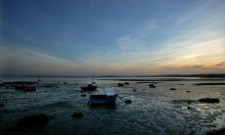
Morecambe Bay: The town is struggling in its efforts to regenerate itself.
"I pitched up in Morecambe on the back of an online Anywhere but Westminster discussion where one of the most interesting posts was left by a Guardian user named Tiojo: as it turned out, a fan of the town who has been here as a tourist.
"What about Morecambe and its attempt to reinvent itself as the Deauville of the Irish Sea coast?" he asked. His post paid tribute to the Midland Hotel — the art deco beauty recently restored by the Manchester-born developers Urban Splash, which offers a gleaming local example of high-end hospitality.
"But he then asked a couple of awkward questions. "Where are the small-scale entrepreneurs to open bistros, wine bars and boutiques that are a big part of today's holiday? What of the galleries and performance spaces that attract visitors to all sorts of places?"
"Quite so. As a child I used to come to Morecambe in the early 1980s, when it offered a human-sized alternative to Blackpool and had the largest big wheel in Europe, plonked in a wild west-themed amusement park called Frontierland. The latter is now derelict: a rusting, fenced-off dead zone owned by the supermarket Morrisons, which has apparently banked the land pending an upturn.
"Morecambe's promenade, by contrast, has been splendidly spruced up. But as plenty of other, boarded-up places confirm, things are not good at all. The so-called West End, a grid of streets at one end of the front, is Morecambe's predicament in microcosm. Once a thriving cluster of hotels and B&Bs, it has become ridden with social problems, as its low-rent accommodation filled up with people parked on incapacity benefit. But around 2005 there was bold talk of its reinvention as a pleasant location for family homes.
"A good deal of that effort has now stalled. The West End's regeneration was meant to be spread over 15 years, but the crash happened three years in, and the money started to run out. The abolition of a body called the North West Regional Leaders Board cost the West End around £1m. The Homes and Communities Agency promised £2.3m but that cash is no longer available. The winding up of the Northwest Regional Development Agency kiboshed a £750,000 contribution to the Morecambe Townscape Heritage Initiative. And so the woe goes on: a crash in local property prices, for example, has repelled private developers. Everything feels as if it has seized up — and given that people such as Eva Kawinska were gambling on regeneration continuing, that's very bad news for scores of local businesses.
"The lessons from all this are so obvious as to be almost painful. In a place like this, if you hack back the state, the private sector does not thrive in the newly vacant uplands: it shrinks, at speed. It really is the cruellest thing to behold — one blinkered decision following another, and hitting a town full of sparky, driven people who desperately want to revive it.
"A good example is Sonja Campbell, an artist and film-maker who grew up in Blackburn and then moved to London, but came here to start a family. She and her other half bought their five-bedroom house for less than £100,000. Morecambe's history and character is part of what attracted her; so too is the nearby Lake District. She dreams of a more robust local economy, buoyed by creative types. Living here, she says, "lets your mind breathe a bit". Listening to her talk, it's obvious that this place should have a future — and that if it doesn't, Morecambe will count as one of austerity's saddest casualties.
Isle of Man adds final details to its Ramsey Marine Nature Reserve
The Fisheries Directorate, Isle of Man, advised stakeholders on 1st July 2011:
"Following our extensive public consultation process and input from a wide range of marine users, scientists and other stakeholders we very are pleased to be able to update you with the finalised Management Zones for Ramsey Marine Nature Reserve. We would like to thank you for your participation in the consultation process, whether you attended a consultation workshop, responded to the online survey, provided a detailed written response to the consultation or assisted us in any other way.
"Over 200 people responded formally to the Ramsey Marine Nature Reserve consultation process and we received a large amount of additional information to inform the development of this plan. Over 85% of those who responded were active users of Ramsey Bay and the majority of responses were extremely supportive of the idea of establishing the Marine Nature Reserve.
"The Zoning Plan is illustrated on the attached map and takes into consideration the information and views put forward by fishermen and other marine users through the consultation process. It represents a balance between protection of the marine environment and the commercial and recreational uses of the area. The Zoning Plan protects key habitats including eelgrass meadows, horse mussel reefs and maerl beds and offers higher protection to some of the most vulnerable areas.
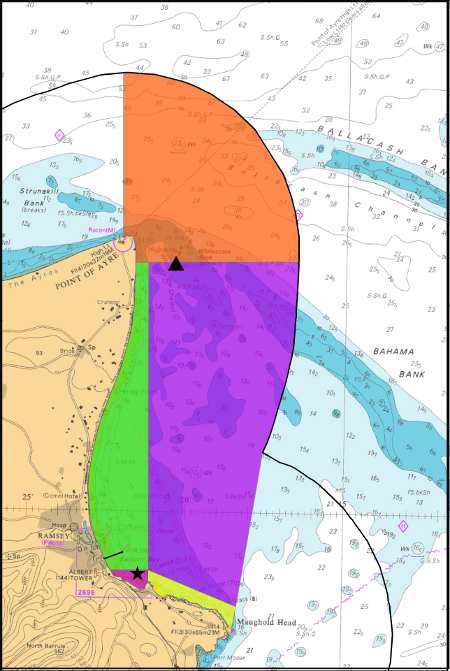
Protection throughout Marine Nature Reserve (all coloured zones on map)
"All zones on the map, including the Fisheries Zone, will be protected from aggregate extraction and dumping of dredged material. All zones will be protected from gill netting, a measure which has been developed in response to issues raised by anglers and all angling events will be catch and release (proposed by anglers' representatives). Any offshore or coastal developments within the area will require authority from DEFA and an Environmental Impact Assessment.
Conservation Zone (green area on map)
"The Conservation Zone (inner Ramsey Bay) will be protected from all trawling and dredging and all extraction of scallops and queenies. Potting, recreational angling and bait collection will be permitted.
Horse Mussel Zone (orange area on map)
"The Horse Mussel Zone (off the Point of Ayre and Ballacash Channel) will be protected from all trawling and dredging and all extraction of scallops and queenies. The site will also be protected from potting. Recreational angling and bait collection will be permitted.
Fisheries Management Zone (purple area on map)
"The Fisheries Management Zone (the outer area of Ramsey Bay) will be leased to the Manx Fish Producers' Organisation by the Department of Infrastructure and managed to support sustainable fisheries. Conditions to the lease will ensure that the area is protected from overfishing and that habitat damage is minimised. Trawling and dredging will be permitted to a level set by the MFPO and license d by DEFA. Potting and recreational fishing will be permitted.
Eelgrass Zone (pink area on map)
"This small zone will be protected from all extraction of living resources. Catch and release angling will be permitted but bait collection will not be allowed.
Rocky Shore Zone (yellow area on map)
"This narrow strip of coastal waters between Gob ny Rona and Maughold Head will be protected from all trawling and dredging and all extraction of scallops and queenies by other means. This management approach was developed in response to concerns raised through the stakeholder consultation process that the valuable rocky reef and kelp habitats along this coast also require protection. Most of the seabed and coast within the Marine Nature Reserve is on a sandy seabed. Rocky reef habitat is known to be diverse and also to provide natural breeding refuges for scallops. Recreational fishing and bait collection will be permitted.
"Byelaws will soon be implemented to support the management measures included in this Zoning Plan. A monitoring programme will also be put in place to ensure that we can assess the effects of the management measures and ensure that the Ramsey Marine Nature Reserve is having the positive benefits it has been designed to deliver. We will be working closely with users of Ramsey Bay and the wider community to develop Ramsey Marine Nature Reserve as a real asset for fisheries management, marine conservation and great opportunity for Ramsey and the surrounding area.
"Thank you for your valuable contribution to this process. We look forward to your continued support for this initiative to safeguard the future of Ramsey Bay as a valuable economic and ecological resource. If you would like further information about Ramsey Marine Nature Reserve please do not hesitate to get in touch."
International Whaling Commission reforms its rules and tackles corruption
Arcane rules that have led to countries in the international organisation which governs whaling being widely accused of corruption, malpractice and secrecy have been swept aside in an attempt to end a series of scandals.
Practices whereby delegates to International Whaling Commission (IWC) meetings would arrive with briefcases of cash, and small country delegations would have their membership fees paid by another country, are to be outlawed. From now on, all countries will have to pay subscriptions by bank transfer from government accounts, all minutes and decisions taken will have to be published within weeks rather than years, and any scientific evidence used by countries to support their arguments will have to rely on peer-reviewed work.
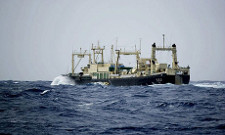
A reform of the 89-member International Whaling Committee is expected to reduce corruption. Photograph: EPA
The overdue reform of the 89-member IWC, proposed by Britain at the IWC's annual meeting this week in Jersey, is expected to reduce secrecy and make the body more open to scrutiny. "This will modernise the IWC, bringing it in to line with other important international bodies, and give it real credibility," said the minister for the natural environment and fisheries, Richard Benyon.
But the reforms may not end the allegations of "cash for votes" which have plagued IWC meetings for more than 15 years. Both pro- and anti-whaling nations have been regularly accused of using underhand diplomatic tactics to pack the commission with countries sympathetic to their positions.
Japan, the leading pro-whaling country, has been widely accused of "buying" the votes of landlocked countries such as Mali and Mongolia, which have no possible interest in whaling, with promises of development aid. It is also accused of persuading dozens of small Caribbean and Pacific nations to vote for their proposals by paying delegations' hotel bills and travelling expenses, and giving money to help small countries' fishing industries in the months before crucial votes.
Japan has always denied that it has in any way "bribed" small countries to vote for it, and says it gives foreign aid to more than 150 nations around the world, including strong anti-whaling nations such as Chile, Argentina, Brazil and Mexico.
On the other side, anti-whaling nations have been suspected of using undue diplomatic muscle and influential people to persuade countries with no commercial interest in whaling to go to IWC meetings and to vote against pro-whaling countries. Austria, the Czech Republic, Hungary, Luxembourg, Slovakia, Switzerland and San Marino, which have no coastlines, all regularly vote with anti-whaling countries.
Non-government groups broadly welcomed the rule changes but were disappointed not to be allowed into future meetings. "We would have preferred the reforms to have gone further, but we welcome these initial steps. However, the overriding issue [is that] our planet's great whales face more threats today than ever before, particularly from the cruelty of commercial whaling," said Patrick Ramage, director of the International Fund for Animal Welfare (IFAW) whale programme.
Plans to make new cargo ships 10% more energy efficient
Countries have taken a first step towards reducing climate emissions from shipping with a global agreement to reduce energy use in new vessels from 2013 onwards.
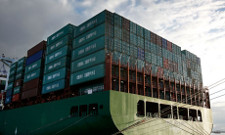
Maritime countries have agreed to regulate shipping emissions — but campaigners warn the rules don't go far enough. Photograph: David Levene for the Guardian
The belated action on Friday by 55 of the world's biggest sea-faring nations meeting at UN's international maritime organisation in London will force all ships over 400 tonnes built after 2013 to improve their efficiency by 10%, rising to 20% between 2020 and 2024 and 30% for ships delivered after 2024. The first ever regulation of emissions in shipping is expected to lead to greenhouse gas emission reductions of 45-50m tonnes a year by 2020.
But China, Brazil, Saudi Arabia and South Africa have secured a six and a half year delay for new ships registered in developing countries, which could mean the first guaranteed effective date of the reform will be in 2019. Shipping accounts for 3-4% percent of man-made CO2 emissions worldwide and this figure is expected to rise to 6% by 2020, with emissions doubling by 2050 if no action is taken. Shipowners, who traditionally do not pay for the fuel that their ships use, have long resisted any regulation despite increasing pressure from environmental groups and reformers within the industry.
Environmental NGOs welcomed the tightening of the energy efficiency design index (EEDI) standard but cautioned that because it only applies to new ships replacing older ones at the end of their long lives, the full effects of today's decision will take a long time to have any major impact. There is a significant danger, said some, that many shipowners will elect to have their new ships flagged in developing countries that provide a waiver.
"Today's decision should result in fuel savings of $5bn a year by 2020 and CO2 reductions of 22m tons. This is an unprecedented economic and environmental opportunity and the IMO has taken an important step forward", said Peter Boyd, COO of Carbon War Room.
If the same standards were applied to the existing fleet of more than 30,000 ocean-going ships it could save $50bn a year in fuel and 220m tons of CO2, he said.
"There will be no change to existing ships which are currently pumping out a billion tones of CO2 each year, and for new ships it will take another dozen years until the EEDI is really delivering benefits. Operational changes could be delivering major benefits today," said Jacqueline Savitz, the senior campaign director for the marine conservation NGO Oceana.
The efficiency improvements are expected to be met through better engine design, more efficient hull shapes, improved waste heat recovery systems and the use of hull coatings to make ships more "slippery".
The deal is not likely to satisfy the European Commission that the maritime organisation is successfully regulating greenhouse gas emissions. The EC is therefore expected to proceed with its threat to bring shipping into the Emissions Trading Scheme, as it is doing in aviation, where there have been recent legal challenges from non-European countries.
In a separate development, the European Commission said it plans to tighten ship fuel sulphur regulations, which should lead to public health savings of billions of dollars, especially in countries like Britain and Holland that border busy sea lanes. The proposal would cut the maximum permissible sulphur content of fuels to 0.1% from 1.5% from 2015 in sensitive areas such as the Baltic Sea and the Channel, and to 0.5% from 4.5% in all other areas from 2020.
Shipping burns some of the most polluting fuels, and the proposal is expected to fine particle emissions from ships by up to 80 percent, the commission said.
The expected cost to the shipping industry of the new standards is between €2.6bn and €11bn ($3.7-$15.6bn), which the EU executive argues would be far outweighed by public health savings, of up to €34bn.
EU plans to set stricter sulphur emissions from ships
The EU executive has tabled a long-awaited proposal to set stricter international limits on the sulphur content of marine fuels in EU law. The limits were adopted by the International Maritime Organisation (IMO) in 2008.
The proposal would lower the limit from 4.5% to 0.5% in 2020. For sulphur emission control areas (SECAs) such as the Baltic Sea and the North Sea, the limit would be lowered from 1.5% to 0.1% in 2015.
Industry stakeholders have raised concern not enough low sulphur fuel will be produced to meet the global 0.5% limit for 2020. "The problem is the tight time schedule — the requirement to reduce the sulphur limits… is simply not thought through", European paper industry association CEPI said on Friday.
CEPI also says the new limits would significantly increase shipping costs, especially in countries bordering the SECAs, putting EU firms at a disadvantage compared with China and Brazil. Pulp and paper prices will increase up to €10 per tonne, it believes.
The EU executive expects the limits, which would update a 1999 directive, to reduce sulphur dioxide emissions by up to 90% and fine particle emissions by up to 80%. Its proposal would also introduce provisions set by the IMO that allow alternative compliance methods, such as exhaust gas cleaning systems.
The proposal also goes beyond what is required by the IMO by imposing a stricter 0.1% sulphur standard for passenger ships outside of SECAs. And it includes stronger monitoring and enforcement rules, says the European Commission.
Environmental groups say further restrictions cannot be delayed given shipping will soon become the biggest source of NOx and SO2. They also point out that other industrialised countries such as the US and Canada have already implemented the IMO standards. These countries also have set up more SECAs than Europe.
Cefas publishes guide to choosing sustainable fish
When fishermen catch fish they can't sell, they have to throw them back — often dead — into the sea. This is called discarding. Cefas (Centre for Fisheries and Aquaculture Science) wants to reduce this wasteful practice by encouraging people to try lesser-known species. But which should they choose?
As a first step toward deciding which species to promote, Cefas considered:
- Which species are "under-utilised"
- How sensitive they are to over-fishing
- Which species consumers could be encouraged to try
Some species are regulated to prevent over-fishing: fishermen are set quotas, meaning they can legally bring only a fixed amount back to shore. Under-utilised species are ones that fishermen don't catch their full quota of; or they catch them but then discard the fish because no one wants to buy them.
Using quota and discard information, expert advice and local knowledge Cefas chose around 50 under-utilised species to study.
Cefas argue that if we encourage fishermen to target a new species we risk damaging the population. Cefas has developed a system, the Relative Life History Sensitivity Analysis, to study the risk. It uses biological information like growth and breeding strategies to see how increased fishing pressure might damage each species. Cefas then ranks the species by how tolerant they are to being over-fished.
The species that are most under-utilised AND most tolerant of over-fishing are the best ones for consumers to consider choosing. The following species came top:
Fish
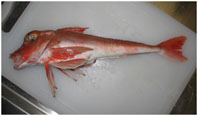
Red gurnard — Aspitrigla cuculus
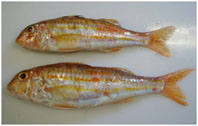
Red mullet — Mullus surmuletus
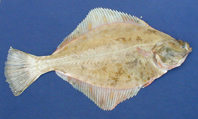
Flounder — Platichthys flesus

Grey gurnard — Eutrigla gurnardus
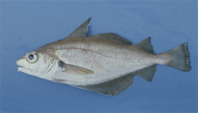
Pouting (bib) — Trisopterus luscus
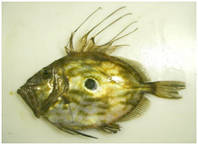
John Dory — Zeus faber

Dab — Limanda limanda
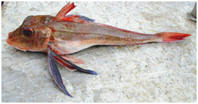
Tub gurnard — Trigla lucerna
Shellfish
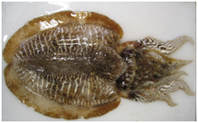
Cuttlefish — Sepia officinalis

Squid — Lolligo forbesi, L. vulgaris and Todarodes sagittatus
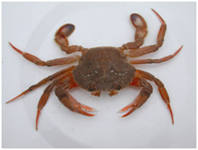
Velvet swimming crab — Necora puber
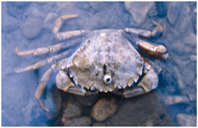
Green crab — Carcinus maenas

Chinese mitten crab — Eriocheir sinensis
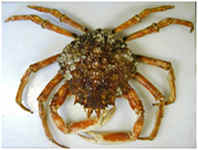
Spider crab — Maja brachydactyla
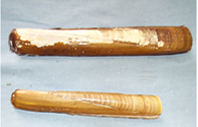
Razor clam — Ensis spp.
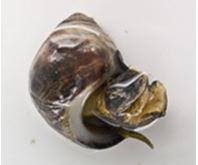
Winkle — Littorina littorea
Image courtesy of Claude Nozeres
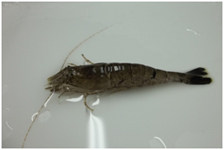
Brown shrimp — Crangon crangon
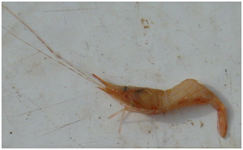
Pink shrimp — Pandalus montagui
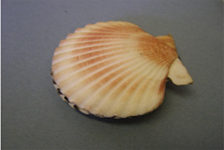
Queen scallop — Aequipecten opercularis
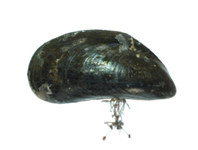
Mussel — Mytilus edulis
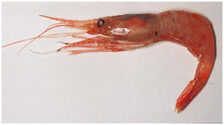
Northern prawn — Pandalus borealis
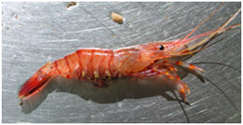
Common prawn — Palaemon serratus
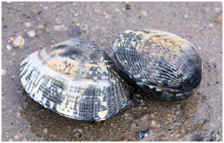
Manila clam — Tapes philipinnarum
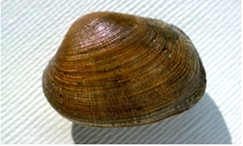
Carpet shell — Ruditapes decussatus and Venerupis senegalensis
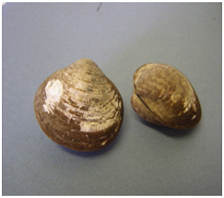
Dog cockle — Glycimeris glycimeris
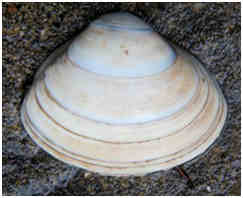
Surf clam — Spisula spp.
The list of species that could best tolerate greater fishing pressure is based on fisheries around the UK, particularly England. For the fish species, we used our own data plus data from ICES (International Council for the Exploration of the Sea) and the Marine Management Organisation. Where reliable data were unavailable for some shellfish species, local expert knowledge on species biology and fisheries characteristics was used.
This Cefas project is commissioned and funded by the Department for the Environment, Food and Rural Affairs (Defra).
MARINET observes: MARINET has very real concerns about shifting the never ending demand for fish from one group of threatened species to another group because we know so little about the inter-relationship between species, and their rôle in the ecosystem as a whole. For example, destroy the fish stocks that feed cod and you destroy the cod stocks too. This is a no win situation. It is also to be noted that the UK government's support for highly protected marine reserves, and how such reserves can be used to protect the whole marine ecosystem and rebuild fish stocks, is very lukewarm. Our only highly protected marine reserve, Lundy Island, has had no scientific monitoring for three years, and therefore our understanding of how highly protected marine reserves can serve as an effective marine management tool is being neglected by government. How can Defra and the government learn how to use marine reserves as a solution for the problem of falling fish stocks if they neglect our only real marine reserve? The time has come for a radical shift in thinking at senior level in government, both in the UK and Europe, and we must encourage MEPs and MPs to become involved in Common Fisheries Policy reform, see MARINET briefings (www.marinet.org.uk/rocfp.html)
Number of UK fishermen shows substantial decline over last 10 years
The number of fishermen working in the UK is down by 2,300 over the last decade, new figures show. There were 16 per cent fewer vessels over the same period, but the UK fleet still remains the sixth largest in the EU in terms of numbers.
The figures are released by the Marine Management Organisation in a report which gives detailed data about the size and composition of the UK fishing fleet, the number of fishermen and UK fishing activity during 2010.
The statistics also include new coverage of fishing effort in the Cod Recovery Zone and Western Waters. The report will inform and complement government policy and, in conjunction with the Department for Environment, Food and Rural Affairs (Defra), help inform changes to the Common Fisheries Policy.
Overall, the statistics reveal that there were 16 per cent fewer vessels in the UK fleet than in 2001, with fishermen numbers falling by around 2,300. The number of days spent at sea by over 10 metre vessels have fallen by 37 per cent over the same period.
The statistics are being released in advance of the compendium publication UK Sea Fisheries Statistics 2010 in late September in a drive to provide data to the public as soon as they are available. A further report on UK catches and landings will be issued in late August.
But up to now it shows the state of the industry in 2010 as:
- The UK fishing fleet remained the sixth largest in the EU in terms of vessel numbers, with the second largest capacity and fourth largest power. 6,477 fishing vessels were registered with a total capacity of 207,000 GT and total power of 827,000 kW.
- 22 per cent of the UK fleet was made up of vessels over 10 metres in length. In Scotland almost a third of vessels were over 10 metres.
- Around 12,700 fishermen were reported as active in the UK. Of these, 2,500 were part-time.
- 268 accidents involving fishing vessels occurred, an increase of 13 per cent on 2009. The number of injuries dropped to 45 from 75 in 2009, with 5 recorded fatalities.
- Fishing effort with regulated whitefish trawls has fallen by 56 per cent since the implementation of the Cod Recovery Zone in 2003. Effort in the Sole Recovery Zone with regulated beam trawls has fallen by 31 per cent since its creation in 2004.
- Effort on fishing trips targeting scallops in ICES sub-area VII has increased by 47 per cent since 2001, while effort on similar trips in ICES sub-areas V and VI has dropped by half.
"Make or Break" time for offshore wind industry
An industry wide survey into the offshore wind industry describes the coming few years as a 'make or break' time.
It will decide if the industry can get on track to reach the efficiencies and cost levels required to become competitive in the energy mix, and finds cause for optimism along with a note of caution.
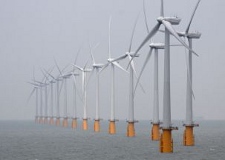
Thanet Offshore Wind Farm, a Round 2 project now fully operational and providing a return on investment. Photo by Peter Barker
You can get statistics to say anything or so the saying goes, but this survey, 'Turning windpower promise into performance' by PricewaterhouseCoopers (PwC), based on field research by GBI Research, involved 57 interviews with executives from across the industry in 12 countries in a format which provides interesting food for thought.
Wide ranging areas of the subject were covered, not only the practical aspects, with developers, contractors/original equipment manufacturers (OEMs), utility companies, government bodies and financial institutions consulted. Mention of these below, refers to those who responded to the survey.
Three quarters of government respondents were reasonably confident that offshore wind will play an enduring part in the energy mix in the coming 20 years with, interestingly, three fifths expecting it to be economic without subsidies within 15 years. Over a third believed there to be a high or very high chance of technological breakthroughs supporting offshore wind development. A cautious note was added, however, with three fifths feeling there to be a medium chance of offshore wind being eclipsed by other renewable technologies.
It is seen as important that the performance of offshore turbines matches that of onshore, and here there was a positive response from European developers, who reported comparable levels of availability between the two. Availability downtime (for offshore wind) was in line with pre-project expectations for 82% of developers, the remainder reporting downtime being a greater problem than expected. All the European developers expressed confidence in performance, reporting availability rates in the 90% to 97% range, translating into a robust return on investment.
Controlling Costs
The importance of controlling construction and turbine costs is recognised, prompting a mixed outlook from European contractors/OEMs. Forty two percent expect cost decreases in real terms although many do not foresee any reduction, with a quarter forecasting cost increases. Around half of developers reported high capital expenditure a significant or major problem, although significant variations in construction costs were reported, influenced by specific project circumstances. Control of capex is seen as critical, given there is little room for cost overrun recovery due to subsidy mechanisms.
Three quarters of developers considered that the risk of a seller's market in the supply chain was being created through capacity constraints, caused by the imbalance between suppliers and developers, something viewed as unavoidable as the market develops. The majority held the view that supply chain risks were likely to increase in the future. The report suggests the complexity of projects has resulted in multi-contracting, involving three to four suppliers, rather than turnkey contracts which have been slow to develop. On the positive side, two thirds were satisfied with how they had managed such risks so far. Seventy five percent of European contractors/OEMs forecast real term construction costs and turbine prices either decreasing or remaining the same in the next five years.
Construction Risk and Financing
Although construction and technological risk is seen as a significant barrier to investment, nearly two thirds of financial institutions reported offshore wind power investment risk reducing, with only 9% stating risks had increased in the past two years. A reduction in financing facilities at the time of the credit crisis led to public funding becoming more common. There are signs now, that with more projects completed and construction experience increasing, financiers are becoming more comfortable with the industry, although UK government reviews of the subsidy regimes are seen as an area of uncertainty among financiers. Importantly, 91% of financial institutions said risks were either reducing or had stayed the same.
Perhaps unsurprisingly, there was a mismatch between industry and government body perceptions of subsidy arrangements. Discussions about financing and subsidy was an area that 90% of European utility companies felt still required improvement, a view shared by none of the government bodies, although there was considerable consensus on the need to improve grid access and transmission capacity.
Asked before the nuclear emergency in Japan, investors favoured nuclear over offshore wind power. Asked again however, six weeks after the event, three quarters said their investment sentiment had shifted negatively against nuclear. Mention is made of US and French nuclear power generators diversifying through buying into the wind and solar sector with the suggestion that 'While it [the Fukushima emergency] won't raise a red flag to investment in nuclear, it could spur further moves by nuclear companies into renewables'. It would be interesting to gauge investors' sentiments once again, following Germany's recent decision to phase out nuclear power generation.
The above is just a brief summary of the survey which can be viewed at www.pwc.co.uk/index.html.
Parliament to investigate the future of marine renewables in the UK
The Energy and Climate Change Committee, chaired by Tim Yeo MP, is launching an inquiry to investigate the potential for marine renewables (wave and tidal) to contribute towards the UK's renewables and emissions targets.
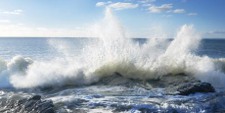
The UK has the largest wave and tidal resources in Europe. The Carbon Trust has estimated that around 15-20% of the UK's electricity could potentially be produced from marine renewable sources (based on the available resource). A range of technologies is being developed to harness these resources, but most are immature and still at an early stage of development.
The Government has provided funding to the research and development of marine technologies through a number of routes, including the £50 million Marine Renewables Deployment Fund (MRDF) created by the previous Government. The Spending Review of November 2010 announced innovation funding of over £200 million for low carbon technologies over the next four financial years, from April 2011. On 28th June 2011, DECC announced that £20 million of this funding would be used to support two projects to test prototypes in array formations.
The inquiry will assess the success of existing Government support and measures on marine renewables and investigate the potential impact of Government spending decisions on this area of low carbon technology. The focus of this inquiry will be wave and tidal energy only.
The Committee is inviting submissions on marine renewables, in particular:
- What are the potential benefits that marine renewables could bring to the UK and should Government be supporting the development of these particular technologies?
- How effective have existing Government policies and initiatives on marine renewables been in supporting the development and deployment of these technologies?
- What lessons can be learnt from experiences within the UK and from other countries to date in supporting the development and deployment of marine renewables?
- Is publicly provided innovation funding necessary for the development of marine technologies and if so, why?
- What non-financial barriers are there to the development of marine renewables?
- To what extent is the supply chain for marine renewables based in the UK and how does Government policy affect the development of these industries?
- What approach should Government take to supporting marine renewables in the future?
- Are there any other issues relating to the future of marine renewables in the UK that you think the Committee should be aware of?
Written evidence is invited from interested parties. The deadline for the submission of written evidence is Thursday 8 September.
Written evidence should be in Word or rich text format — not PDF format — and sent by e-mail to ecc@parliament.uk. The body of the e-mail must include a contact name, telephone number and postal address. The e-mail should also make clear who the submission is from. Hard copy submissions should be sent to: The Clerk, Energy and Climate Change Committee, 7 Millbank, London, SW1P 3JA. The deadline is Thursday 8th September 2011. As a guideline submissions should be no longer than 3000 words. However, please contact the Committee staff if you wish to discuss this matter.
Coalition of UK NGOs launches CFP Reform statement
A coalition of the UK's leading environmental and conservation organisations is urging the UK Government and other EU Member States to ensure the European marine environment and fishing industry have a sustainable future, and to act before it is too late. They are calling for ministers to ensure the long-term viability of fishing communities.
The coalition including WWF, Greenpeace, RSPB, Marine Conservation Society (MCS), ClientEarth, nef (new economics foundation), and OCEAN2012 made the call in response to the publication by the European Commission on its proposals to reform the 'broken' Common Fisheries Policy (CFP).
To coincide with the publication of the reform proposals, the coalition delivered their joint objectives for the Common Fisheries Policy to key decision-makers at the Zoological Society of London on 13th July, see the joint statement
The UK NGO coalition believes the current CFP Reform proposal fails to:
- Put the environment first for people's sake
- Provide tools to reduce capacity in line with the available resources
- Make access to resources conditional on social and environmental criteria
The NGOs have asked the UK Government to ensure a Common Fisheries Policy that delivers rather than undermines.
On behalf of the NGO coalition, Ian Campbell added: "A reformed Common Fisheries Policy must establish a new way to distribute access to fish. Sustainability criteria should be used to rank access to resources, favouring those who employ methods which have the least impact on marine habitats and non-target species, are most selective, most fuel-efficient, and those who can demonstrate strong legal compliance and operate within and contribute to coastal communities."
The groups said despite some positive measures, such as the commitment to stock recovery by 2015, there were too many shortcomings that if not addressed by Ministers and MEPs, could undermine any chance of meaningful reform.
A reformed CFP must:
- Put the environment first to make sure that fish stocks, the marine environment and fisheries can thrive
- Set legally binding sustainable fishing levels that cannot be exceeded by law-makers or fishers
- Eliminate discards
- Deliver transparent decision-making and reporting processes to measure performance
- Properly address the issue of overcapacity in the European fleet
Dr Mireille Thom, Marine Policy Officer at WWF said: "Long term management plans on the basis of fisheries are a significant step forward, but the delivery mechanisms, responsibilities and timescales must be clarified. A critical next step must be for Ministers and MEPs to ensure the responsibility for the management of these plans is decentralised to regional stakeholders. If we want to secure a thriving marine environment then fishermen, officials, scientists, industry and NGOs need to be recognised as co-managers of their fisheries, working together to implement multi-annual plans."
Ruth Davis, Chief Policy Advisor of Greenpeace said: "With 72% of Europe's fish stocks overexploited, we desperately need an emergency response plan to rescue our fisheries and the jobs and communities they support. The CFP reform process could produce that plan, but until Europe's leaders acknowledge the urgency of the problem, and make the recovery of fish stocks central to the Common Fisheries Policy, we will be stuck with plans detailing the best way to subsidise the destruction of the Europe's fishing industry."
Euan Dunn, RSPB's Head of Marine Policy said: "It's a tragedy that after thirty years of the CFP, stocks are more overfished in European waters than in other developed regions of the world, inflicting unacceptable collateral damage on marine ecosystems and dependent communities. Ministers must grasp the opportunity to chart a fundamentally new course which ensures that fishing lives within environmental limits."
Debbie Crockard, Fisheries Policy Officer of the Marine Conservation Society said: "It is outrageous that we are paying for sound scientific advice to be conducted by world experts, only for it to be disregarded as the baseline for stock management. Scientific advice must be considered the most important driver for sustainable fisheries management."
James Thornton, ClientEarth CEO, said: "This is perhaps the best opportunity of our life-time to stop over-fishing in the EU. We have unprecedented public support for an end to discards; NGOs are working together and have the ear of the government — all in a year of CFP reform. The first and most important step is to make sure that sustainable fishing levels are set and can never be exceeded, either by obscure loopholes or horse-trading between member states."
Aniol Esteban, head of environmental economics at nef said: "Fish are not only a source of food, but of jobs as well. If we keep overfishing, then we're putting future jobs at risk. We must challenge the view that setting stricter fishing limits will put fishermen out of job. It's actually the opposite. Any action that delays the restoration of fish stocks is bad for fishermen, bad for the seafood industry, and bad for society as a whole"
Source: Marine Conservation Society Press Release, 13th July 2011
Project Ocean raises over £96,000 for marine reserves
Since its launch in May 2011, Project Ocean has raised over £96,000 towards setting up marine reserves in our oceans.
Project Ocean is the result of a collaboration between the Zoological Society of London (ZSL) and Selfridges to promote the global need for marine conservation and highlight the issue of overfishing.
There are two key messages: vote with your fork — eat more sustainably; and support marine protected areas. MPAs are conservation sites in the ocean, set aside as safe havens for fish and their ecosystem. Selfridges has funded a community-managed MPA on Danajon Bank in the Philippines through Project Seahorse which is 0.5m2 — particularly significant when compared with the total area of 5m2 currently protected in the UK.
For five weeks Selfridges has dedicated its Oxford Street store to Project Ocean and during this time it:
- Raised over £96,200 towards marine reserves
- Held events and talks in the Ultralounge of its Oxford Street store to engage the public in the need to save our seas, attended by an average of 700 people each day
- Took unsustainable fish off their shelves and off the menu throughout its stores (and will keep them off!)
- Distributed 45,000 Selfridges Fish Guides
- Hosted the World Ocean Day summit launch on Wednesday 9th June, attended by members of Parliament across the European Union
Surprising number of whales seen off the Welsh coast
The Welsh coast is now attracting whales and dolphins in such large numbers that it could herald a change in their global behaviour, researchers have claimed. It follows the sightings of dozens of whales, dolphins and porpoises off the Pembrokeshire coastline. An unprecedented 15 minke whales and even one rare humpback whale were seen swimming within 14 hours.

Minke whale
Cliff Benson, of Sea Trust South and West Wales, called it a "whale and dolphin bonanza" as spotters made the most of unusually calm weather conditions on the Irish Sea. He said: "This weekend we saw 15 minke whales, we have only seen a total of 31 in all the previous years of monthly research added together since 2004. That shows something is happening."
Mr Benson added that he had also seen certain types of dolphins doubling in number off the coast.
He said: "Risso's dolphin have doubled in number. We are beginning to see trends emerging. It could be because there is plenty of fish here or a sign that fish stocks in the Bay of Biscay (where the dolphins would usually be spotted) are low."
Mr Benson said some species of whale, such as fin whales, had been disappearing from the Bay of Biscay, raising fears that over-fishing and climate change could be disturbing ecosystems. He said: "Fin whales have not been seen in the Bay of Biscay for some time, so fish stocks could be moving north as the climate gets warmer and warms up the sea currents."
Among the dozens of sightings he and his team had spotted on board their ferry over the weekend was a rare humpback whale. "The humpback whale was a big surprise," he said. "It was just on his own and I think he was a young one because they can end up anywhere. We would normally expect them to be off Iceland feeding on krill at the moment or at the Bay of Biscay."
Humpback whales are known for their ability to communicate across great distances through the world's oceans.
During the weekend, Mr Benson said his team were also "astonished" to see a minke whale reach speeds of up to 20mph as it chased their ferry around the Welsh coast between Fishguard and Rosslare in Ireland. "The minke whale didn't seem to be doing much at first, but I noticed it coming nearer to the ferry," he said. "I think we must have disturbed it as it snoozed and then started to chase us. We could see massive surges and splashes as it kept up with the 30,000-tonne ferry at speeds of at least 20mph for more than a minute. I hadn't seen anything like it before in all my survey work. The whale was chasing us like a dog goes after a car. I can only guess that he was doing it through instinct."
Minke whales have a tell-tale white flash on their flipper and are one of the smallest whales. They normally swim at speeds between 3mph and 16mph but can go up to 20mph in bursts when in danger.
July 16th marks "Fish Dependence Day" in the UK
Britain's coastal waters are so overfished that they can supply the nation's chip shops, restaurants and kitchens for little more than six months of every year, research has shown.
Overfishing has caused so much damage to fish stocks across Europe that the quantity landed each year to satisfy the public appetite has fallen by 2 per cent on average every year since 1993.
So great is demand that Saturday, 16th July, has been dubbed Fish Dependence Day — the day on which imports would have to be relied upon because native supplies would have run out if only home-caught fish had been eaten since 1st January. Last year it fell on 3rd August, almost three weeks later, and in 1995 it was six weeks later.
Other European countries consume fish at an even greater rate and the EU as a whole reached its Fish Dependence Day on 2nd July, compared with 9th July last year, with fishermen estimated to have landed 200,000 tonnes less than a year earlier. Spain became dependent on non-EU imports on 8th May, Germany on 27th April, Italy on 30th April and France on 13th June.
The demands made on UK and European fisheries are making them less productive, and unless they are better managed the supply of fish will dwindle and thousands of jobs will be lost, the report shows. Aniol Esteban, of the think tank NEF and the author of the report, said: "Eating more fish than our oceans can produce is playing dangerous games with the future of fisheries and fishing communities. Unless we change course, the jobs and livelihoods of many people in Europe and beyond are at risk. Our current appetite is putting our oceans under pressure. It's hard to understand why a country surrounded by potentially rich seas needs to import one out of every two fish that it eats."
As Maria Damanaki, the European Fisheries Commissioner, announced proposals to reform the Common Fisheries Policy (CFP) , Mr Esteban urged that the long-term health of fish stocks be given priority over short-term gains by fishermen.
"We need urgent action to ensure that jobs, revenues, food and the environment are protected from overfishing," he said. "Policymakers need to look beyond the short-term costs that could result from reform and give priority to the long-term benefits that healthy marine resources will provide for the environment, the economy and society. In a context of finite resources and growing populations, the current EU model is unsustainable."
The report, Fish Dependence, highlights growing concerns that Europe can only feed its craving by exploiting the waters of poorer developing nations — which can leave their fisheries depleted and the human population unable to access a valuable source of nutrition.
MARINET tells EU Commission how to eliminate over-fishing and achieve sustainable fishing quotas
MARINET has made a submission to the EU Commission in connection with the Commission's public consultation on how fishing quotas should be set for 2012 and beyond, and how over-fishing can be eliminated — "Fishing Opportunities: COM (2011) 298 final".
MARINET's submission explains precisely how these to key issues of CFP Reform should be determined, and the steps necessary to bring them to reality. Full details of this submission are on our website at www.marinet.org.uk/rocfp.html#eusubmission.
EU Commission announces its CFP Reform proposals, and MARINET comments
Brussels, 13th July 2011 EU Commission Press Release:
"In its proposals for a major reform of the EU Common Fisheries Policy (CFP), the European Commission has set out a radical approach to fisheries management in Europe. The plans will secure both fish stocks and fishermen's livelihood for the future while putting an end to overfishing and depletion of fish stocks. The reform will introduce a decentralised approach to science-based fisheries management by region and sea basin, and introduce better governance standards in the EU and on the international level through sustainable fisheries agreements.
"When presenting the proposals, Maria Damanaki, Commissioner for Maritime Affairs and Fisheries, said: "Action is needed now to get all our fish stocks back into a healthy state to preserve them for present and future generations. Only under this precondition can fishermen continue to fish and earn a decent living out of their activities."
"Commissioner Damanaki continued: "This means that we have to manage each stock wisely, harvesting what we can but keeping the stock healthy and productive for the future. This will bring us higher catches, a sound environment and a secure seafood supply. If we get this reform right, fishermen and coastal communities will be better off in the long run. And all Europeans will have a wider choice of fresh fish, both wild and farm produced."
"Sustainability and long-term solutions are the key points of today's proposals which set out the following elements:
- All fish stocks will have to be brought to sustainable levels by 2015, which is in line with the commitments the EU has undertaken internationally.
- An ecosystem approach will be adopted for all fisheries, with long-term management plans based on the best available scientific advice.
- The waste of food resources and the economic losses caused by throwing unwanted fish back into the sea, a practice known as "discarding", will be phased-out. Fishermen will be obliged to land all the fish that they catch.
- The proposals also include clear targets and time-frames to stop overfishing; market-based approaches such as individual tradeable catch shares; support measures for small-scale fisheries; improved data collection; and strategies to promote sustainable aquaculture in Europe.
- Consumers will be able to get better information on the quality and sustainability of the products they buy.
- General policy principles and goals will be prescribed from Brussels, while Member States will have to decide and apply the most appropriate conservation measures. In addition to simplifying the process, this will favour solutions tailored to regional and local needs.
- Operators throughout the fishing sector will have to make their own economic decisions to adapt fleet size to fishing possibilities. Fishermen's organisations will play a stronger rôle in steering market supply and increasing fishermen's profits.
- Financial support will only be granted to environmentally-friendly initiatives contributing to smart and sustainable growth. A strict control mechanism will rule out any perverse funding of illicit activities or overcapacity.
- Within international bodies and in its relations with third countries, the EU will act abroad as it does at home and promote good governance and a sound management of the sea in the rest of the world.
"EU fisheries are affected by several interconnected problems. Most fish stocks are being overfished by a fishing fleet that is too large and too efficient. Catches are dipping year after year and coastal communities, which often depend on fishing, watch their economic opportunities fade away. In decision making, political leaders tend to favour short-term interests rather than long-term resource conservation; and a top-down legislative approach from Brussels has so far given the sector little incentive to behave responsibly and contribute to a sustainable use of resources.
"In April 2009, a Green Paper analysed the shortcomings of the current policy and opened a public consultation which lasted until the end of 2010. Input to the consultation and conclusions from several stakeholder events fed into the preparation of today's reform package, which consists of the following components:
- A legislative proposal for a new Regulation setting out the main rules of the CFP
- A legislative proposal for a new Market Policy
- A Communication on the external dimension of the CFP.
- An overarching communication explaining the links between the above
"This new package is being submitted to the European Parliament and Council for adoption under the ordinary legislative procedure (co-decision). The Commission aims for adoption and entry into force of the new framework by 1st January 2013.
"Later this year the Commission plans to put forward a new funding mechanism for fisheries and maritime policy, in line with the Multi-Annual Financial Framework.
- Further details of the proposals can be found in Memo/11/503
- The policy documents and other information can be found at: http://ec.europa.eu/fisheries/reform/index_en.htm
MARINET observes: There is a great deal in the Commission's proposals to recommend them, and the Commission appears to genuinely aspire to eliminate over-fishing, and to introduce an ecosystem-based approach to the management of our fisheries and the wider marine environment upon which those fisheries depend.
However, the key questions now are whether the fishermen themselves will see the virtue in these proposals (i.e. that they are designed to rebuild their industry which is currently in terminal decline), whether the Council of Ministers can be persuaded to follow the lead taken by the Commission, and whether the European Parliament (which for the first time, following the Lisbon Treaty, is now involved in determining the CFP) will also take a positive approach and support the Commission's plans for reform.
Of course, the question also arises as to whether the Commission's proposals for reform actually go far enough — will these new management principles (setting fishing limits according to a stock's "maximum sustainable yield", ending the practice of discarding, and devolving fisheries management to local areas) actually achieve the objective of rebuilding fish stocks as a whole, and once again result in fish stocks being large enough to feed the European Union for 12 months in every year, instead of only 6 months in each year as at present? In short, will these proposals guarantee us "food security" once again?
MARINET has told the Commission that there are four principles which CFP Reform must meet if we are to get our fish stocks back into a sound, healthy condition, and it is by these principles that the integrity and effectiveness of the reform proposals must be judged;
- The Reform of the CFP must comply with EU law, specifically, the legal requirements of the Marine Strategy Framework Directive and Council Regulation 2371/2002 e.g. commercial fish populations are within safe biological limits and exhibiting a population age and size distribution that is indicative of a health stock, and that their management is employing both the precautionary principle and the principles of the ecosystem-based approach to marine management. For further details, see the MARINET Briefing.
- Fish stocks must be restored to somewhere approaching historic levels, and that Maximum Sustainable Yield (the new name for quotas) must be referenced to these historic levels rather than the current, depleted stock levels. We have defined the concept of historic levels in our North Sea Briefing Paper
- Fisheries-based marine reserves, centred on the spawning and nursery grounds of the commercial fish stocks, must be used as an essential management tool in order to enable these stocks to be rebuilt to somewhere approaching their historic levels, and that the fishermen who lose their fishing rights in these areas must be re-employed as the managers of these reserves, undertaking the patrolling and assisting in the monitoring and scientific research, thus ensuring that they are an essential part of the process which will guarantee fishing for their families in future generations.
- Food security must be the guiding principle which determines how we set what is an acceptable population size for various fish stocks, and thus be the reference point at which "maximum sustainable yield" [i.e. — the annual catch levels, aka "total allowable catch", "quota"] is set. In other words, we need to rebuild fish stock sizes to the degree and level where they are large enough to be able to feed the EU population for all the months in the year — in short, provide food security. What this stock size is should be calculated with reference to historic levels, these being a guide to what size is necessary. Also the stocks must and can only be rebuilt to these "food security" levels if we take serious actions in terms of management i.e. create fisheries-based marine reserves, and set catch levels at zero wherever necessary in order to rebuild these levels, using and re-employing fishermen as the managers who rebuild these stocks and protect them from poaching by other EU countries.
MARINET has explained these matters in detail to the EU Commission in our submission to the Commission's public consultation, titled "Fishing Opportunities COM (2011) 298 final", which asks those interested in CFP Reform to explain to the Commission how fishing quotas should be set for 2012 and beyond, and how over-fishing can be eliminated. MARINET's explanation to the Commission on these two key points is viewable on our website.
German North Sea brown shrimp fishery seeks MSC certification
The certification body, Food Certification International Ltd., has announced that the German North Sea brown shrimp fishery (crangon crangon) is now entering the information gathering phase of the Marine Stewardship Council's sustainable fishery assessment. The primary objective of this stage is to collect information on the fishery and in particular to speak to representatives of the fishery, fishery management bodies and other stakeholders of the fishery. Meetings will be carried out over the week commencing 19th September 2011 in Hamburg and Bsum, Germany. The fisheries for this shrimp are located within North Sea ICES sub-areas IVa, b and c.
The core area of the shrimp fishery is the Wadden Sea — an area listed a European Marine Protected Area (MPA), a provision that falls under the Wild Birds and Habitats Directive (BHD) of the European Union. Under this classification, anthropogenic activity taking place in this area is authorised only on the condition that sufficient evidence can be delivered which demonstrates that activities are not detrimental to the marine ecosystem.
Within the Common Fisheries Policy (CFP) the North Sea brown shrimp fishery is not considered a pressure stock fishery, and so is not subject to management by Total Allowable Catches (quotas). It is, however, the subject of ongoing scrutiny for stock assessment and management purposes, and such work is co-ordinated through a fishery specific ICES working group.
Once caught, the Shrimp are typically cooked and cooled down on board of the vessels, landed to shore and transported to the premises of two Dutch owned processors that specialise in, and dominate, this trade. Here the shrimp are cooked, peeled and graded ready for use in a range of packages and product forms. In addition, small quantities of shrimp from these fisheries are also handled locally at a small and artisanal scale, producing traditional products for local sale.
In the 2008 fishing season, the landing tonnage for the Client group was 11,004 metric tonnes.
Deja-vu — can sand pumped from the sea solve Italy's disappearing beaches?
The high cost and exclusive nature of Italy's best beaches cause regular disputes, but accelerating coastal erosion means some of them are now disappearing altogether.
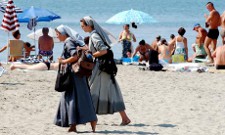
A beach at Ostia, near Rome, where extra sand has been trucked in to make up for coastline lost to winter storms and rising sea levels. Photograph: Gregorio Borgia/AP
Italian actors, intellectuals and the titled rich setting off for the beach this summer have been shocked to find that one of their favourite spots has all but vanished, thanks to encroaching development and violent winter storms linked to climate change. Traditionally, the cultural and political elites have soaked up the summer sun at Capocotta beach near Rome, which has a reputation for bohemian flamboyance and boasts Italy's only official nudist shoreline. But the golden dunes and beach huts have been swept away, leaving the literati fighting over a few inches of sand and how to rebuild.
"I realised something was happening three years ago when a beach kiosk from further down the sands floated past us in a storm," said Paolo Moscia, a lifeguard at the nudist section at Capocotta, which has drawn a mixture of gay bathers, ministers, musicians and hip film directors since Allen Ginsberg hung out there in the 1950s, and wild high-society drug parties gave birth to la dolce vita.
This year regulars arrived to find that their section was reduced to a trickle of sand and storms had engulfed 30 metres of beach, leaving the wooden restaurant renowned for its oysters and grilled squid close to toppling off the dunes into the waves. Moscia pointed at swimmers beyond the breakers. "This time last year people were strolling on the sand out there," he says. "If nothing is done, we won't be here in two years."
Experts blame development along Italy's rivers and the building of hydro-electric dams, which have slowed down the erosion of river banks and the flow out to sea of the tonnes of sediment and sand needed to replenish beaches after storms. "The Tiber sent 400,000 cubic metres of sand a year into the Mediterranean 25 years ago. Now it's down to 80,000 cubic metres," said Angelo Bonelli, head of the Italian Green party.
Francesco Lalli, a senior researcher at Italy's environmental research centre, Ispra, said Italy's beaches lost five million cubic metres of sand between 1950 and 2000. The losses caused by overbuilding are levelling out, he said, adding that there is now a suspicion that the storms chewing away at the beaches are more violent because of climate change. "Plus, we are seeing the initial effects of rising sea levels," he warned.
North of Rome, L'Ultima Spiaggia beach has fared no better than Capocotta. A long-time favourite of Italy's leftwing cultural elite, including the former prime minister Romano Prodi, the beach is tucked into the lower reaches of Tuscany. It is a retreat for philosophers, aristocrats and anti-Berlusconi politicians who convene every summer to eat wild boar and attend cultural conferences in nearby Capalbio, a medieval hilltown nicknamed "Little Athens". After storms left just a shallow layer of sand this spring, 15 metres have now been restored, thanks only to four truckloads of sand dumped by the local authority. But, according to the environmental centre Ispra, more than 1,000km of coastline is now eroding steadily.
Since the economic boom of the 1950s, working-class bathers from nearby Rome have flocked to the beach clubs of Ostia, near Rome. But they, too, are now watching their beaches slip away, prompting the regional authority to pump in sand scooped up from the seabed, part of a €26m scheme to bring 350,000 cubic metres of sand ashore to fill the gaps on almost 400km of coastline.
For patrons of the Sporting Beach Club in Ostia, where forlorn lines of changing rooms that once stood 150 metres back from the sea are now buffeted by waves, the new sand cannot arrive soon enough. "My parents came here before me and I am sticking it out," said Ivana Paolini, 55, "but it's tough when you have to swim out to sea past concrete pillars holding up the changing rooms."
An expert at the environmental group Legambiente said beach clubs were partly to blame for losing the sand on which they charge sunbathers for the privilege of stretching out. "The dunes which advanced to replace lost sand are being concreted over by the clubs," said Giorgio Zampetti. "By building beach clubs to profit from the sand, people are ensuring that sand will vanish."
Whaling conference ends in chaos or compromise?
Richard Black, BBC Environment correspondent, reports 15th July 2011: "The chaotic close of this year's IWC (International Whaling Conference) meeting had to be seen to be believed. And for those who argue the body is ill-fit for purpose, archaic, hopelessly riven and suited only for the scrapyard, it provided perfect ammunition. Let me try to set the picture out for you as best I can.
At the start of the final day, the Buenos Aires group of 14 Latin American countries demanded that their bid to have the South Atlantic Ocean declared a whale sanctuary be heard, debated and resolved, and voted upon if necessary. This was despite the fact that there was no chance of them gaining the three-quarters majority needed to usher it through. For the "pro-sustainable-use" bloc, headed by Japan and Iceland, this was unacceptable.
At the last two IWC meetings, the proposal had formed one small component of a much larger compromise package that also included acceptance of Japan's Antarctic whaling programme in scaled-down form, and quasi-commercial quotas for their coastal whaling towns. The package was formally declared dead at last year's meeting, with each bloc blaming the other for intransigence.
So for Japan and its allies, to have the sanctuary proposal aired again in isolation, when they had been prepared to concede it as part of the big package if they also gained things they wanted, was just unacceptable.
Once it became clear that the Latin Americans were determined to have a vote, the pro-whaling countries got up and walked out, in a bid — as they made clear — to make the meeting inquorate. The solution was for national representatives to go into a private meeting, to try to find a mutually acceptable way forward.
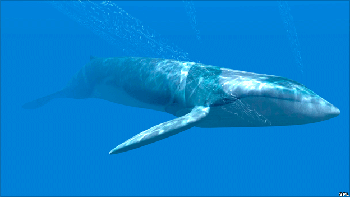
Guide to the ocean's great whales — BBC Website
Even more extraordinarily, the meeting also had to discuss and decide what was meant by "quorate".
Half of the organisation's countries need to be present in order for votes to count; but was that half of all members, half of countries present at the beginning of the meeting, half of the number in the room at the time of the vote? Different delegates gave me all three definitions; and despite the IWC having existed for 65 years, it's clear that no-one really knows.
You might also be wondering why the chairman and so many of the delegations were anxious to avoid having a vote. After all, decisions are taken by voting in most national parliaments and in many other international organisations as well.
A two-week meeting of the Convention on International Trade in Endangered Species (CITES) might have 50, maybe even more — and it doesn't fall apart.
The issue here is that votes in the IWC used to be ritualised, meaningless, ridiculous, an exercise in grandstanding — because neither bloc was ever going to come near to gaining the three-quarters majority needed to make major changes.
During the two-year "peace process", IWC governments agreed new rules mandating they would strain every sinew to reach consensus where possible, and avoid going back to the years of pointless fractious discord. The pro-whaling countries said the Latin Americans were doing precisely this, by calling a vote on something that was extracted from a bigger compromise package and which they could not win. Behind closed doors, reportedly, quite a few other anti-whaling countries told them the same thing — the US and some Europeans, at least.
On the other hand, the Latin Americans insisted that the sanctuary was important to them and they were entitled to call for a vote — which, of course, they were. Eventually a compromise was found… but finding it took nearly nine hours, time the meeting did not have, as it was already many hours behind schedule.
What the document says is that further efforts to find consensus will be made before the next meeting — and if it can't be found, the issue will go to a vote as the first item on the agenda next time. The coming year will also be spent deciding what a quorum means in the world of the IWC.
In a sense, what was agreed is less telling than the fact that the process happened in the way it did.
This is my seventh IWC meeting. But many of the other journalists here were on their first — and there's been widespread and wide-eyed amazement along the press balcony at how little time is spent discussing things like whales, or even whaling. And if next year does see a return to the old days of sterile stand-offs and un-winnable votes, we'll probably see even more points of order, procedural matters and accusations of bad faith — and even less time spent on the things this commission is supposed to be here to do.
Officially, every member government wants to be constructive and take things forward. But there are two distinct versions of what "forward" means; and beneath the veil of harmony heaves a roiling discordant stew that occasionally, inevitably, boils over. It's hard to see how this can change unless each side is really willing to yield ground.
This week, the Latin Americans weren't prepared to yield anything because they believe they are right in trying to bring extra conservation measures into force, because they believe the world should be about saving whales, with hunting consigned to the past.
The problem they face is that the other side believes it is right as well.
Cromer surfers clash with fishermen
Surfers at Cromer have clashed with crab fishermen over North Sea safety. Relations between surfers and the fisherman at Cromer have boiled over — they are at loggerheads regarding their use of the sea. Fishermen want the growing army of surfers to stay away from where they launch and land their boats — amid fears that "someone will be killed" if there is a collision.
Tensions almost boiled over a fortnight ago, when there was a frank exchange of views between surfers and some fishermen, whose boat narrowly missed the boarders as they landed it during a heavy swell.
North Norfolk District Council has stepped in and put up seafront signs, warning the surf community to not go into the water between the Bath House and the doctor's steps because the area is used by working boats.
Closure of East Anglian Coastguard stations
Transport secretary Philip Hammond has confirmed that the coastguards at Walton-on-the-Naze and at Great Yarmouth would both be axed, so leaving a huge gap between Humber and Dover plus the Norfolk and Suffolk Broads where there are no regional stations. The government has declined to listen to the massive protest arising from the coastal and Broadland leisure industry, the populace and the coastguard itself.
Nationally, the centres to be closed over the period from 2012 to 2014/15 are at Swansea, Portland in Devon, Clyde and Forth in Scotland, Liverpool, Great Yarmouth, Brixham in Devon, and Walton on the Naze in Essex.
Major Chinese oil spill goes unreported for 1 month
Polluted water. Murky information. Public anger. Government promises of transparency and oversight to prevent a recurrence. And then, a short time later, it all happens again. Watching the 840 square km oil slick now polluting China's Bohai Sea and listening to the excuses of the companies and officials involved, it is hard to avoid a sense of deja-vu.
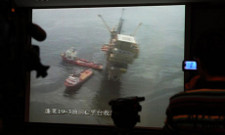
Press conference in Beijing on 5 July showing the oil spill off China's eastern coast. Photograph: Xing Guangli/AP
It has taken a month for news to emerge about the leak from a well in the Penglai 19-3 field operated by the US energy company ConocoPhillips in partnership with the China National Offshore Oil Corporation.
The companies detected the problem on 4th June, but it only came to light on 21st June thanks to a microblog leak rather than an official release. After initially downplaying the accident, the authorities finally revealed this week that it covers an area half the size of Greater London.
The State Oceanic Administration (SOA) said that the seabed leak is the first of its kind in China and the water quality in the affected area has fallen to the lowest of its four categories.
Information remains sketchy. Neither company has responded to The Guardian's request for details. Despite vague reassurances from CNOOC on Wednesday that problem is "basically under control", there has been no estimate of the amount of oil discharged or the potential impact on marine life and coastlines. The government also revealed that the maximum penalty for such incidents is 200,000 yuan (£19,000). Compensation is likely to be considerably higher.
Xinhua, the state newswire, has blamed the US oil company for the leak and quoted officials who claimed the slow release of official information was due to "technical limits". But the English language Global Times, which appeals to an international audience, boldly asked whether relations between government regulators and industry were too close."We cannot help but wonder: Is the SOA a serious watchdog that exists to prevent bigger incidents from happening, or a loving parent who is over-protective of his own child?… It is not acceptable that the SOA, which had learned about the incident in early June, held the news until a month later."
The Economic Observer, one of China's feistiest publications, accused China National Offshore Oil Corporation of hiding the accident in an act of "savage public relations".
Bloggers and environmental groups have been up in arms. Li Yan of Greenpeace said the authorities have failed to leans the lessons of pipeline explosion in Dalian last July.
Then as now, the environmental impact of the accident was initially downplayed by the authorities, but it was later recognised as China's worst known oil spill. Greenpeace claimed the scale of the leak was 60 times greater than reported.
The deja-vu is global. Industrial accidents and cover-ups happen all over the world. As my colleagues reported this week, there were more than 100 unpublicised oil and gas spills from European and American wells in the North Sea between 2009 and 2010.
China also has a dark history in this regard. I am particularly reminded of the botched cover up of the 2005 benzene spill into the Songhua river by the China National Petroleum Corporation.
Company executives and local government officials insisted at the time that water supplies were contaminated. As the toxic slick flowed towards Harbin, millions of residents were initially told their water supplies needed to be cut for several days for "routine pipe maintenance".
This was exposed as an outrageous lie, provoking a short-lived media outcry and promises of regulatory reform. Six-years on, not much seems to have changed. The authorities and state-owned oil industry are just as close, and their first instinct still seems to be to plug the news before the pollution.
Polar bears originated in Ireland
It's a long way from the Arctic to Tipperary, but scientists have discovered polar bears can trace their family tree to Ireland. Genetic evidence shows they are descended from Irish brown bears that lived during the last ice age.
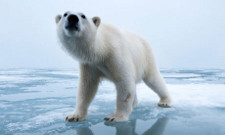
Polar bears have mitochondrial DNA found in the bones of ice age bears discovered in caves in Ireland. Photograph: Paul Souders/Corbis
Modern polar bears share a distinct DNA sequence, passed down the female line, with their now extinct brown ancestors. However, the same DNA fingerprint is absent from other species of brown bear alive today.
It is thought the link arose from interbreeding between prehistoric polar bears and female brown bears when their paths crossed as the Irish climate cooled.
Scientists made the discovery after analysing DNA in mitochondria — energy-producing structures within cells — that are only passed from a mother to her offspring.
Dr Ceiridwen Edwards, from Oxford University, a member of the international team that carried out the study, said: "Hybridisation between ancient Irish brown bears and polar bears has led to the complete replacement of the original polar bear mitochondria. This maternal lineage is now present in all modern polar bears."
Polar and brown bears are hugely different in terms of body size, skin and coat colour, fur type, tooth structure and many other physical features. They are also very distinct behaviourally. Polar bears, the world's largest carnivores, are expert swimmers which prey on seals, while forest-living brown bears climb and have a varied omnivorous diet. Yet the two appear to mate successfully whenever they come into contact.
Climate change is believed to have produced mating opportunities for the two species at various times in the past 100,000 years.
The scientists extracted mitochondrial DNA from the teeth and bones of 17 bears found at eight cave sites across Ireland. Ten Irish brown bears from the ice age period between 10,000 and 38,000 years ago had the maternal DNA that is now seen in every polar bear. Older pre-ice-age brown bears, dating to between 43,000 and 38,000 years ago, had a different genetic signature matching that of modern bears from eastern Europe.
Remains of the last ancient brown bears in Ireland, from 3,000 to 5,000 years ago, had yet another genetic fingerprint seen in modern western European bears.
Only the ice age brown bears carried the maternal genetic hallmark of polar bears.
Polar bears may have moved into what is now Ireland when the region was experiencing much cooler temperatures than it is today. At the same time, brown bears may have been pushed towards the coast by advancing ice sheets.
Warmer periods may bring the species together as melting glacial ice and rising sea levels force polar bears to retreat inland. "Environmental conditions appear to have played, and continue to play, a big part in the evolutionary history of polar bears," said Edwards. "Today's warming climate is again bringing modern polar bears into contact with brown bears in places like Canada and Alaska." The research is published in the journal Current Biology.
Are there any mackerel left in Cardigan Bay?
George Monbiot writes in The Guardian, 8th July 2011: "Last year I began to wonder, this year doubt is seeping away, to be replaced with a rising fear. Could it really have happened? Could the fishing industry have achieved the remarkable feat of destroying the last great stock?
"Until 2010, mackerel were the one reliable catch in Cardigan Bay in west Wales. Though I took to the water dozens of times, there wasn't a day in 2008 or 2009 when I failed to take 10 or more. Once every three or four trips I would hit a major shoal, and bring in 100 or 200 fish: enough, across the season, to fill the freezer and supply much of our protein for the year. Those were thrilling moments: pulling up strings of fish amid whirling flocks of shearwaters, gannets pluming into the water beside my kayak, dolphins breaching and blowing. It was, or so it seemed, the most sustainable of all the easy means of harvesting animal protein.
"Even those days were nothing by comparison to what the older residents remembered: weeks on end when the sea was so thick with fish that you could fill a bucket with mackerel just by picking them off the sand, as they flung themselves through and beyond the breaking waves while pursuing their prey.
"Last year it all changed. From the end of May to the end of October I scoured the bay, on one occasion paddling six or seven miles from land — the furthest I've ever been — to try to find the fish. With the exception of a day on which I caught 20, I brought them back in ones or twos, if at all. There were many days on which I caught nothing at all.
"There were as many explanations as there were fishermen: the dolphins had driven them away, the north-westerlies had broken up the shoals, a monstrous fishmeal ship was stationed in the Irish Sea, hoovering up 500 tonnes a day with a fiendish new vacuum device. (Despite a wealth of detail on this story I soon discovered that no such ship existed. But that's fishermen for you).
"I spoke to a number of fisheries officials and scientists, and was shocked to discover that not only did they have no explanation, they had no data either.
"So I hoped for the best — that the dearth could be explained by a fluctuation of weather or ecology. When the fish failed to arrive at the end of May I told myself they must be on their way. They had, after all, been showing off the south-west of England — it could be only a matter of time. I held off until last weekend. The conditions were perfect. There was no wind, no swell, and the best water visibility I've ever seen here. I looked at the sea and thought 'today's the day when it all comes right.'
"I pushed my kayak off the beach and felt that delightful sensation of gliding away from land almost effortlessly — I'm so used to fighting the westerlies and the waves they whip up in these shallow seas that on this occasion I seemed almost to be drifting towards the horizon. Far below me I could see the luminous feathers I used as bait tripping over the seabed.
"But I could also see something else. Jellyfish. Unimaginable numbers of them. Not the transparent cocktail umbrellas I was used to, but solid, white rubbery creatures the size of footballs. They roiled in the surface or loomed, vast and pale, in the depths. There was scarcely a cubic metre of water without one.
"Apart from that — nothing. It wasn't until I reached a buoy three miles from the shore that I felt the urgent tap of a fish, and brought up a single, juvenile mackerel. Otherwise, though I paddled to all the likely spots, I detected nothing but the jellyfish rubbing against the line. As I returned to shore I hooked a greater weever — which thrashed around the boat, trying to impale me on its poisonous spines. But that was all.
"Is this the moment? Have I just witnessed the beginning of the end of vertebrate ecology here? If so, the shift might not be confined to Cardigan Bay. In a perfect conjunction of two of my recent interests, last week a monstrous swarm of jellyfish succeeded where Greenpeace has failed, and shut down both reactors at the Torness nuclear power station in Scotland.
"The Israeli branch of Jellyfish Action pulled off a similar feat at the nuclear power station in Hadera.
"A combination of overfishing and ocean acidification (caused by rising concentrations of carbon dioxide in the atmosphere) has created the perfect conditions for this shift from a system dominated by fish to a system dominated by jellyfish.
"If this is indeed what we're seeing, the end of vertebrate ecology is a direct result of the end of vertebrate politics: the utter spinelessness of the people charged with protecting the life of the seas. In 2009 the Spanish fleet, for example, vastly exceeded its quota, netting twice the allowable catch of mackerel in the Cantabrian Sea, and no one stopped them until it was too late.
"Last week, the European commission again failed to take action against the unilateral decision by Iceland and the Faroes to award themselves a mackerel quota several times larger than the one they agreed to, under their trilateral agreement with the EU and Norway. Iceland and the Faroes have given two fingers to the other nations, and we appear to be incapable of responding.
"The mackerel haven't yet disappeared from everywhere, but my guess is that the shoals which, since time immemorial, came into Cardigan Bay, were a spillover from the mass movements up the Irish Sea. As the population falls, there's less competitive pressure pushing them towards the margins. Without data, guesswork is all we've got.
"I desperately hope it's not the case, but it could be that the fish that travelled to this coast, in such numbers that it seemed they could never collapse, have gone."
Norway searches for buried treasure in the Arctic
The race for the Arctic's natural resources is best explained by a tale of two countries. The first country is as near to nirvana as we have on Earth. It is rich and comfortable, with the highest standard of living in the world and the lowest murder rate. Its workers are the most productive in the world; its goods are consumed in every part of the globe; and its $550bn nest egg is currently the largest sovereign wealth fund in the world.
This country is also very friendly to the environment. At home, 95% of its electricity is zero carbon. Its huge fisheries are the most sustainably managed in all the oceans. Abroad is it spending more on rainforest protection than any other nation.
The second country is very different. It is one of the biggest oil and gas exporters in the world and is pushing exploration into risky new areas against the advice of its own environmental research institutes. It is mining coal and iron ore in one of the most fragile habitats on Earth. This country's wealth is invested in dirty tar sands projects and it is a major arms exporter. It is miserably failing to meet its own targets to cut the carbon emissions that are fuelling climate change, while in the seas, its fish farms vastly outnumber the wild populations and spread disease.
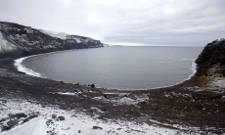
The Norwegian island of Jan Mayan. Norway, the world's fifth-biggest oil exporter, has signed a deal with Iceland for oil and gas exploration off the coast of the island. Photograph: Heidi Wideroe/Getty Images
The first nation is Norway. And so is the second. Norway's world-leading green ambition contrasts stunningly with its lust for the black gold that delivers its world-leading wealth. The contradiction is acknowledged even at the highest levels. "Yes, it is a dilemma," Jonas Gahr Støre, Norway's foreign minister, told me last month when I visited the Arctic. "But it is not for Norway alone, it is the world's dilemma."
Yet the world is not deciding the fate of the Arctic. The five Arctic nations, under whose national jurisdiction about 80% of the oil, gas and mineral rights will fall, control the region. And if Norway, the most favoured nation on Earth, cannot resist the lure of the buried treasure, whatever the environmental cost, who can? The other core members of the Arctic council — the US, Canada, Denmark and Russia — are scarcely paupers either.
The Arctic is irresistible for three simple reasons.
First, a global economy addicted to fossil fuels at almost any price will always find a dealer willing to find and sell them their fix at almost any cost.
Second, the strong demand for iron, uranium, gold and other metals shows little sign of ending, and won't until new goods are refashioned from old.
Third, and most telling, the most precious properties of the Arctic are economically worthless. The ice cap reflects sunlight and cools the planet, for free, while tundras trap vast volumes of the potent greenhouse gas methane. The Arctic oceans shelter some of the richest fisheries on Earth, without billing the fishing fleets who harvest them. And the fragile wilderness that stands as a last testament to a pre-human planet is of no more than philosophical worth.
Taking advantage of the melting ice to unearth oil and gas that will fuel yet further melting is a grotesque irony. But the race into the Arctic is inevitable in a world that prizes mineral wealth but takes the natural world for granted. Until resistance to transformative action on climate change and environmental degradation thaws, the true value of the Arctic will run through our hands like meltwater.
Half of bluefin tuna species threatened with extinction
Five out of the eight tuna species are at risk of extinction, conservationists warned today, as they called for urgent action to tackle over-fishing. The latest assessment for the International Union for Conservation of Nature (IUCN) showed that three species are threatened with global extinction, while two more will be under threat without action to help them.
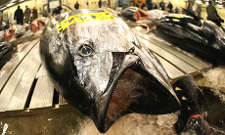
A tuna lies on a pallet at a fish market in Tokyo. Photograph: Koichi Kamoshida/Getty Images
A study, published in the journal Science, which looks at all "scombrid" fish, which include tuna and mackerel, and billfishes, which include swordfish and marlins, found that seven of the 61 known species were under threat.
The study said some of the species were heavily over-fished, with little interest in conserving them because of the high commercial value of the catch.
There were also difficulties in regulating the multinational fisheries which exploit the stocks.
IUCN experts warned that all three bluefin tuna species — southern, Atlantic and Pacific — were susceptible to collapse because of pressure from fishing for the high-value fish.
Southern bluefin tuna are already critically endangered, the highest category of risk, and Atlantic bluefin are endangered, the assessment for the IUCN red list of threatened species found.
Bigeye tuna are vulnerable to extinction, while yellowfin and albacore tuna are close to being under threat, or will be threatened with extinction if conservation measures are not put in place to turn their fortunes around.
Among other species, blue and white marlin were both assessed as being vulnerable to extinction, putting them in the third of the three most serious categories for threatened species and at risk of dying out globally.
Dr Kent Carpenter, manager of IUCN's marine biodiversity unit and an author of the study, said: "All three bluefin tuna species are susceptible to collapse under continued excessive fishing pressure. "The southern bluefin has already essentially crashed, with little hope of recovery. If no changes are made to current fishing practices, the western Atlantic bluefin stocks are at risk of collapse as they are showing little sign that the population is rebuilding following a significant reduction in the 1970s."
Most of the economically valuable species such as tuna are at the top of the marine food chain, and their decline could have negative impacts on other species.
They are also long-lived, with slower reproductive rates which means populations take longer to recover.
Last year, proposals were made to have Atlantic bluefin tuna listed as endangered under the Convention on International Trade in Endangered Species (Cites), temporarily stopping the trade in the species. But attempts to list bluefin tuna, a sushi delicacy in Japan, as an "appendix I" species were defeated by a large majority of countries at the Cites meeting in March 2010.
The study published in Science said the only way to save southern and Atlantic bluefin tuna was to shut down the fisheries until stocks were rebuilt, although to do so would encourage illegal fishing. Strong deterrents would be needed, such as controlling international trade in tuna through the Cites scheme, the scientists suggested.
Jean-Christophe Vie, deputy director of the IUCN's global species programme, said: "Temporarily shutting down tuna fisheries would only be a part of a much-needed recovery programme. Scientific finding should not be discarded in order to maintain short-term profit. Marine life and jobs for future generations are both at stake."
Serious North Sea oil and gas spills at rate of "one a week"
Serious spills of oil and gas from North Sea platforms are occurring at the rate of one a week, undermining oil companies' claims to be doing everything possible to improve the safety of rigs.
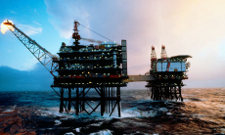
More than 100 potentially lethal oil and gas spills took place on rigs in the North Sea in 2009 and 2010. Photograph: Alamy
Shell has emerged as one of the top offenders despite promising to clean up its act five years ago after a large accident in which two oil workers died.
Documents obtained by the Guardian record leaks voluntarily declared by the oil companies to the safety regulator, the Health and Safety Executive(HSE), in a database set up after the Piper Alpha disaster of 6th July 1988 which killed 167 workers. They reveal for the first time the names of companies that have caused more than 100 potentially lethal and largely unpublicised oil and gas spills in the North Sea in 2009 and 2010.
They also deal a significant blow to the government's credibility in supporting the oil industry's fervent desire to drill in the Arctic. Charles Hendry, the energy minister, has said operations to drill in deep Arctic waters by companies such as Cairn Energy off Greenland are "entirely legitimate" as long as they adhere to Britain's "robust" safety regulation.
Shell has been at the forefront of plans to drill in the Arctic waters of the Beaufort and Chukchi seas.
The documents, released under freedom of information legislation, record leaks classed by the regulator as "major" or "significant", which, if ignited, could cause many deaths. The two rigs with the most frequent oil spills are owned by Shell and the French conglomerate Total. Shell executives regularly claim in public that safety is their most important commitment. Last November, Peter Voser, the Shell chief executive, said: "Safety is, has been, and forever will be, our number one priority. It is our core value."
The Shell-run platform responsible for the most spills, Brent Charlie, first began pumping oil in 1976 from its location 115 miles (180km) north-east of Scotland. The documents record seven leaks on it over the two-year period, with the worst happening on 26th April last year when four tonnes of leaked gas from one of its columns led to a shutdown of production.
On another occasion, on 30th September 2009, safety inspectors ordered Shell to stop producing oil from Brent Charlie after gas leaked from its ventilation system. Last Friday, the HSE formally threatened to close down some operations on Brent Charlie within two weeks over undisclosed safety issues. Since January this year, Shell has stopped exporting oil from the rig and three others in the Brent oilfield as the company struggles to put right safety problems.
Critics say the oldest rigs, built in the 70s when oil was found in the North Sea, are the most dangerous and fear safety is neglected as the platforms come to the end of their productive commercial life. Shell came under intense criticism over its safety record in 2006 when a judge ruled that it could have prevented the deaths of two men if it had properly repaired a hole in a corroding pipeline on a platform in the Brent field. In the same year, one of Shell's own safety consultants, Bill Campbell, alleged that safety procedures in the North Sea had been ignored for years.
Shell's then chief executive, Jereon van der Veer, admitted in a private email at the time that the company had a second-rate safety record and pledged to spend substantial sums of money to improve it.
A Shell spokesman said: "No spill is acceptable and we have made progress. We work closely with regulators and invested over a billion dollars in recent years to upgrade facilities across the North Sea to continue this improvement of our performance."
Other major oil companies which are high in the spills league include the Danish conglomerate Maersk and Canadian firm Talisman, which both have a rig with five leaks. Four spills came from a rig known as Mungo Etap, which is owned by BP.
Whistle-blowers have told the Guardian that the list of spills recorded in the documents is the tip of the iceberg.
Other accidents are kept quiet, they claim, because workers fear they cannot report them in case they lose their jobs. One veteran said that although everyone is formally told to report anything that goes wrong, staff adhere to an informal code to remain silent to avoid a halt in drilling that loses money for the companies.
The HSE documents also undermine claims by the major oil companies that last year's Deepwater Horizon explosion in the Gulf of Mexico that killed 11 workers was unlikely to ever happen to them.
Jake Molloy, general secretary of the Offshore Industry Liaison Committee (OILC), a union representing North Sea workers, said Deepwater Horizon showed that "even the most up-to-date, cutting-edge safety technology can go wrong if it is not maintained properly and not operated by competent people". He added: "We have been very lucky in the UK that we have not had another major incident with multiple fatalities. We have come very close on several occasions, very, very close. It is more luck than good management in some cases. Some operators don't give a damn. Because of the high price of oil, they are cutting corners. Some of them are overdue for prosecution."
Robert Paterson, health and safety director of the Oil & Gas UK, which represents the industry and aims to make Britain's oil industry the safest in the world, said oil companies last year agreed to "redouble efforts to reduce the number of leaks by 50% over three years and many companies are building this target into their business plans". He rejected the whistle-blowers' concerns: "We believe there is a very high standard of compliance when it comes to companies reporting offshore incidents to the regulator and a constructive culture in the workforce when it comes to reporting health and safety concerns."
The disclosures have provoked criticism of the government over its claims that regulation of the oil industry in the North Sea is one of the toughest in the world. Chris Huhne, the energy secretary, claimed in January that the UK's safety and environmental regime was "one of the most robust in the world."
Frank Doran, Labour MP for Aberdeen North, said: "Chris Huhne needs to have a rethink. There is a continuing problem, of particularly gas leakages, and that is a sign that the infrastructure in the North Sea is ageing and that maintenance and investment is still not sufficient to ensure the safety of offshore workers. There is still a long way to go."
JNCC announces consultation on 3 new marine SACs
The UK Joint Nature Conservation Committee (JNCC) has written to consultees about 3 new marine SACs, saying "I am writing to invite you to participate in the forthcoming public consultation on the selection of three possible offshore Special Areas of Conservation (SAC) — Croker Carbonate Slabs, Pisces Reef Complex, and Wight-Barfleur Reef. The three sites are areas in UK offshore waters which JNCC has recommended to Government for selection as SACs for their seabed habitats of European importance.
"Croker Carbonate Slabs pSAC is in the Irish Sea and is proposed for selection for the "submarine structures made by leaking gases" which occur there.
"Pisces Reef Complex is in the Irish Sea.
"Wight-Barfleur Reef in the English Channel are both proposed for selection for their reef habitat.
"The public consultation on the selection of the three sites will begin on the 6th July 2011 and will run for a 12 week period. We are inviting comments on:
- the scientific justification for the selection of each site as an SAC; and
- the assessment of the likely economic impact of designation of each site as an SAC (the 'Impact Assessment', formerly known as Regulatory Impact Assessment).
"The deadline for JNCC to receive feedback from consultees is the 29th September 2011. Further information about this public consultation, including full explanatory documents and maps for each possible site and a form for responses, is available online at www.jncc.gov.uk/marineconsult.
"If you cannot access the documents from our website we can provide all the necessary information to participate in this consultation on a CD — please send an email with 'Information request: 2011 Offshore SACs Three Sites Consultation' in the subject line to offshoreconsult@jncc.gov.uk, or contact Luke Laletin on 01733-866833. Please see brief explanatory notes below, and further information on our website at www.jncc.gov.uk/marineprotectedsites, If you would like to meet with JNCC to discuss the consultation, or if you require any more information, please contact us using the contact details above."
Fish scales reveal where salmon spend their time at sea
Scientists have discovered how to find out where Atlantic salmon spend their time at sea by analysing the chemistry of their scales, in a breakthrough that may help preserve dwindling populations.
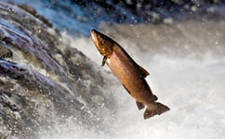
Atlantic salmon
It turns out that fish from different parts of the UK migrate to very different stretches of ocean. Salmon spend much of their adult lives at sea, before returning to breed in the rivers where they were spawned. But until now it's been unclear precisely where they go at sea.
It's an important question, because their numbers have been falling since the early 1970s, mostly because of losses at sea. In that decade, around 70 per cent of each generation died at sea, whereas in 2005 the mortality rate had risen to 90 per cent. This suggests it might be a good idea to protect them at sea. But where, exactly?
Now researchers have found the answer, by analysing the ratios between different forms of carbon, known as isotopes, in salmon scales. These form a distinctive chemical signature that can trace each salmon to the feeding grounds of its youth.
The team of scientists from the University of Southampton, the Centre for Environment, Fisheries and Aquaculture Science, the Game and Wildlife Conservation Trust and the National Oceanography Centre in Southampton looked at collections of preserved salmon scales taken from two salmon populations — one returning to rivers on the UK's north-east coast, the other coming back to the River Frome in Dorset.
They compared changes in the scales' isotopic signatures over time with satellite records of sea-surface temperatures from across the north Atlantic. Areas where changes in the records match up show where each population is feeding.
"As every single salmon contains the natural chemical tag, we can now see where fish from individual rivers go to feed in the Atlantic," says Dr Kirsteen MacKenzie of the University of Southampton, lead author of the study, which appears in Scientific Reports. '"Interestingly, we found that salmon born in two areas of the British Isles swim to feeding grounds that are far apart, and experience very different conditions at sea."
Salmon returning to rivers on the UK's north-east coast face far more variable conditions at sea, suggesting they feed in the Norwegian sea — roughly where scientists thought. But salmon returning to the River Frome in Dorset turn out to feed further to the west, around the Faroe Islands and Iceland — this was much more surprising, according to co-author Dr Clive Trueman, also from the University of Southampton.
"The prevailing view was that the more northerly UK populations feed around the Norwegian Sea, while the more southerly ones feed off western Greenland,' he explains. 'But our analysis suggests salmon from the south of the UK aren't going as far west as that. Some fish may make it to Greenland, but if so they don't seem to be making it back to the UK."
The proportion of different isotopes in an animal's body is determined by the different isotopes present in the food it ate as it grew, and this depends in turn on where it was at the time.
Each stretch of ocean carbon imparts a distinct isotopic signature to the animals feeding there, largely because its waters are a different temperature and host different plankton communities. Scales are relatively long-lasting and preserve a record of the fish's carbon intake over its last few months of feeding.
The north-eastern salmon face a more variable environment in the Norwegian Sea than the Frome population experiences near Iceland, suggesting their numbers may be more dependent on changing environmental conditions.
"This research will help protect small, vulnerable populations of fish," Trueman says. "If we know where they're going, we can look out for any changes in fishing practice that might be affecting their numbers."
This is the first time scientists have had a firm idea where salmon go to feed at sea. Previous studies have tried to find out by tagging individual fish and seeing where they are caught. But so many salmon die on the way that you have to tag an unfeasibly large number of them to get a sensible result.
And you're only likely to catch fish where there's fishing going on, so this method is biased towards parts of the ocean that are actively exploited by the fishing industry or targeted by research vessels.
Trueman says that similar techniques could be used to identify the feeding grounds of other migratory marine animals, including turtles, tuna and cod, helping conservationists manage their numbers and identify the best sites for protected areas in which fishing is restricted.
Publication: Locations of marine animals revealed by carbon isotopes. Kirsteen M. MacKenzie, Martin R. Palmer, Andy Moore, Anton T. Ibbotson, William R. C. Beaumont, David J. S. Poulter & Clive N. Trueman. Scientific Reports. 1, 21. doi:10.1038/srep00021
New shipping routes opening up in the Arctic
An increasing amount of seaborne traffic is beginning to move on the so-called Northern Sea Route which traverses the Siberian coast. There are also hopes of opening up more of the North West Passage above Canada.
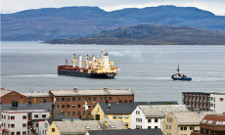
The MV Nordic Barents leaves Kirkenes harbour, northern Norway, carrying iron ore to China via the Northern Sea Route. Photograph: Helge Sterk/EPA
The attraction of the voyage is that it is one-third of the distance of more traditional routes through the Suez Canal. This means less carbon-dioxide (CO2) emissions and less fuel. It also means less pirates.
Attacks on ships off Somalia and in the Gulf of Aden have become so severe that some owners are already using longer sea routes around South Africa to avoid conflict.
Christian Bonfils, the managing director of Nordic Barents operator Nordic Bulk Carriers, claims it will save him $180,000 in fuel costs. New Arctic voyages are starting all the time. Russian oil company, Novatek is currently carrying a trial shipment of 60,000 tonnes of oil products to China via northern Siberia on the vessel, Perseverance.
Norilsk Nickel, the world's largest nickel producer, broke new ground last year by carrying ore to China and South Korea by the eastern part of the Arctic route. Two tankers owned by Murmansk Shipping, the Varzuga and Indiga, loaded with 27,000 tonnes of petroleum, recently moved through the ice-thinned passage from Murmansk to Chukotka in the Russian far east.
Sovcomflot, Russia's major shipowner, took one of its 70,000-dead weight tonnage tankers from Russia to the far east on this route.
And another state-owned Russian company, Atomflot, says it is handling more inquiries than ever before for east-to-west voyages transiting the north coast of Siberia. Atomflot provides the nuclear-powered icebreakers that are currently required by the Russian government to escort the growing number of cargo vessels braving the journey.
But it is not all plain sailing. Quite a lot of the Arctic routes are not properly mapped and surveyed while there is a serious dispute in Canada over whether the famous North West Passage is international water or sovereign territory.
Meanwhile the Russian authorities are still trying to decide what to do about dumped radioactive materials left along the route. The Tsivolka Inlet on Novaya Zemyla has been used as a burial ground for nuclear reactors such as the one from the first atomic-powered icebreaker, the Lenin.
The gathering interest in the Northern Sea Route is being generated by a political as well as a physical thaw. Global warming is reducing the thickness and immovability of the ice but Moscow is changing too. Russia under Dmitry Medvedev is an increasingly outward-looking country willing to compromise and co-operate.
Recently in Murmansk, the Russian president signed a bilateral agreement with Norway after a 40-year row over sea boundaries. It started with arguments over fish but has become a negotiation largely driven by prospects for oil and gas in the Barents Sea and beyond.
Wider political changes are happening as the Arctic increasingly becomes a hunting ground for minerals rather than the seals of the past.
The shipowners believe that this route could gradually be open for transit up to four months per year as air and sea temperatures increase. But they also foresee a world ahead when vessels can take a direct east-west route right across the north pole.
Viktor Basargin, Russian regional development minister, has said that cargo shipments via the North Sea Route could rise from its current level of 3m tonnes annually to 30m "in the near future." Canadian and American maritime experts say 2% of global shipping could be diverted to the Arctic by 2030, rising to 5% by 2050.
Already cruise ships are bringing tourists and income to countries such as Greenland. But they are also raising concerns about safety and pollution from oil spills. There is a widespread view that it is only a matter of time before there is a potential emergency: a passenger ship in trouble and potential evacuation into freezing seas.
Even with the best of intentions, the wider shipping industry will have accidents. Collisions are certainly more likely in areas of thick fog and where some navigational equipment might malfunction in extreme cold. Accidents are also more likely where mapping of the seabed is extremely patchy — as it is throughout the polar region. This summer an ice-strengthened cruise ship, the Clipper Adventurer, hit an uncharted "underwater cliff" off Nunavut, northern Canada.
Yet this is an area where an extensive search-and-rescue capability is only just being planned for inside the Arctic Council, where Russia, Canada and other coastal states discuss issues of the day.
The International Maritime Organisation has a set of "guidelines" for cruise ship operators and others about how to proceed in the area but it is only that — advice. A wider polar code is now being developed by the UN organisation but it must be formulated, agreed and then ratified.
That is a process that usually takes many years but even then there will still be issues outside its scope. For instance, risks to indigenous communities in the Arctic must be considered, along with threats to biodiversity in the region? The movement of vessels from one side of the world to another can bring unexpected and unwanted results: sea creatures attach to the bottom of boats or are carried in water needed as ballast to balance a ship. Aggressive, new species arriving from one region can have a devastating impact elsewhere.
The Finnish government warned in a study published this summer into the potential impact of shipping that "combating oil spills in icy water is almost impossible with the current technology". And scientists have warned that emissions from cargo ships using the Arctic will accelerate global warming.
"One of the most potent 'short-lived climate forcers' in diesel emissions is black carbon, or soot," says James Corbett, a marine scientist at the University of Delaware who has worked with Canadian colleagues to look at the impact of shipping in the far north. Ships operating in or near the Arctic use advanced diesel engines that release black carbon into one of the most sensitive regions for climate change," he says in a study first published in the journal, Atmospheric Chemistry and Physics.
The study team's key conclusion, based on the modelling of future emissions in the region, is that "short-lived forcing of about 4.5 gigatons of black carbon from Arctic shipping may increase the global warming potential due to ships' carbon dioxide emissions by some 17 to 78%."
The Arctic is the new hydrocarbon frontier
Oil companies and governments are looking north as prices rise and energy security fears grow.
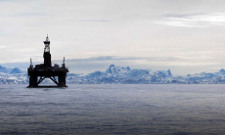
Cairn Energy, operators of the Leiv Eiriksson oil rig, has won permission to drill up to seven oil exploration wells off Greenland's west coast. Photograph: Greenpeace/AP
A report completed in 2008 by USGS argued that almost one-quarter of the undiscovered, technically recoverable, hydrocarbons in the world may be contained in an area north of the Arctic Circle. This — in numerical terms — amounts to 90bn barrels of undiscovered, technically recoverable oil, 1,670 trillion cubic feet of technically recoverable natural gas, and 44bn barrels of technically recoverable natural gas liquids in 25 geologically defined areas thought to have potential for petroleum.
That would mean the Arctic accounts for around 13% of the undiscovered oil, 30% of the undiscovered natural gas, and 20% of the undiscovered natural gas liquids in the world. About 84% of the estimated resources are expected to occur offshore, says the USGS in figures which the Russians argue hugely underestimate the contribution from their continental shelf.
Extracting these hydrocarbons would be hugely expensive using conventional means, but oil companies such as Shell are now building floating liquefied natural gas production systems which would reduce costs. But even high extraction costs can be economically viable because of the soaring value of fuel.
The price of crude has risen — from below $10 per barrel barely a decade ago to a current level of around $110 with predictions it could double again in the coming years, making exploration a highly attractive business.
Despite concerns about climate change, there is still rising demand for petrol and acrimonious debate about future fuel shortages and whether the world has already reached "peak oil" (the point at which oil production peaks before going into terminal decline). All of this makes oil deposits that are more difficult to reach financially viable.
"The low-lying fruit has been picked," is how Fadel Gheit, the veteran oil analyst at Oppenheimer & Co brokerage in New York, puts it.
The oil found in massive quantities just below the desert sands of Saudi Arabia or in the relatively calm waters of the North Sea has been used up or shut off by politics to Western oil companies. This leaves oil companies to push the physical boundaries out into deep water, or the technical boundaries out into "unconventionals" such as the carbon-intensive tar sands, and environmentally sensitive areas such as the Arctic.
The pressures have increased for the Western oil companies because of resource nationalism, which has seen developing countries seeking to restrict developments for their own national oil companies.
A report written by the Norwegian green group Bellona said it was particularly concerned about Russian operations in the Barents, Pechora and Kara seas because much of the hydrocarbon equipment there is old and inefficient, environmental regulation lax and too little is known about the marine ecosystems in the region. "An active growth of oil and gas exploration in the region may become a death sentence for its environment. The natural world of these northern seas is so sensitive and so vulnerable that even a slightest breach in its structure can lead to consequences no one will be able to reverse," the 2007 report concluded.
Arild Skedsmo, head of WWF-Norway's climate and energy programme, has more fundamental objections: "To avoid the worst consequences of climate change, we must phase out virtually all use of fossil fuel by 2050. This leaves very little room for any large-scale exploration and extraction of oil and gas in the Arctic."
Governments in Russia to the US and Greenland are convinced that new supplies of hydrocarbons are needed — but say only if operations are conducted safely.
Cairn said it has put in place various precautionary measures to safeguard against an oil spill. The Edinburgh-based company had two drilling units in place so one could go to the assistance of the other in the event of a "blowout" or other problem. Equally there were 20 support vessels on hand at various times and it said that all the systems on the rigs were in line with the toughest international safety standards. Cairn has taken legal action against Greenpeace to prevent it from disrupting its drilling and Watts was unwilling at the Knightsbridge conference to take questions from the conference floor, except those he defined as "technical" in nature. When asked whether the financial and political fallout of an oil spill would not be disastrous for his company given the experience of BP in the Gulf of Mexico, he said: "We have a full safety regime in place. We are there at the request of the government. We have got an encouraging (drilling) response. Full stop," he replied.
But other technical experts attest to the difficulties posed by the many hours of daily darkness in the winter, the higher failure rate of steel materials in cold temperatures and the sheer difficulties posed by the remoteness of infrastructure. Ove Gudmestad, professor of marine and Arctic technology at the University of Stavanger in Norway, also raises a host of potential difficulties, notably the suitability of existing oilfield equipment, oil and gas price uncertainty and troubled relations with local people in the Arctic.
"A single large oil spill in the wrong place and at the wrong time of year can have very serious, population-wide impacts on seabirds, fish and some marine mammals," said a spokesperson the WWF wildlife group. "The problem is particularly acute in ice-infested waters: there continues to be no effective method for containing and cleaning up an oil spill in ice conditions."
The US government has so far put on hold plans by Shell and others to drill in the Beaufort and Chukchi seas following BP's Gulf accident. But Cairn has already started new drilling this summer and the Greenland government has pressed ahead with new offshore licence awards to major companies including Shell, ConocoPhilips and Norway's Statoil.
Ove Karl Berthelsen, Greenland's minister for industry and mineral resources, makes clear his country's motivation at a time when it is trying to break away from overall political control by Denmark: "The result of the licensing round is an important step towards achieving a sustainable economy for Greenland."
Meanwhile the Norwegian government, which already sanctions gas from the Snohvit field in the Barents Sea, has unveiled new plans to exploit its far north.
Industry watchers such as Richard Shepherd, chairman of the specialist oil consultancy, Petrologica, based in Edinburgh, believes there is a strong political momentum behind increased polar exploration that extends way beyond the boundaries of Greenland. He says: "Arctic oil and gas is on the strategic agenda due to fear of energy dependence and fear of absolute shortages. Energy security is now synonymous with national security in the US — as it is with China". This, combined with rising prices means the pressure to exploit the Arctic's oil wealth will only increase.
Micro-plastics in our seas
Under the heading 'Microscopic rubbish threatening our seas' David Green has just written how Lowestoft based CEFAS are now investigating the serious impact and level of widespread marine litter, particularly plastic present in our oceans and now being ingested by fish and hence human beings. Tiny particles of plastic, originating from onshore wind blown plastic bags and bottles and other items from sewage outfalls, rendered invisible to the human eye, are now being found in huge volumes in the North Sea and elsewhere which, after being ingested by fish, are entering the human body with such potentially serious health damaging consequences. Over 70% of the rubbish is now plastic, much of which is non-biodegradable but invisible to the eye.
Marine Energy Budget cut to £20m
The government has taken an axe to funding for marine energy despite the prime minister's promise before he took office to put "rocket boosters" under the sector.
Ministers have decided to give £20m to kickstart commercial wave and tidal operations, instead of the £50m that was originally set aside under the marine renewables deployment fund.
The cash promised by Greg Barker, the energy and climate change minister, has been dismissed as a "drop in the ocean" by green energy leaders.
The decision to earmark only £20m for wave and tidal out of a larger £200m pot held by the Department of Energy and Climate Change to support low-carbon technologies has attracted anger because of previous statements by the Conservative party on the issue.
In June 2008, David Cameron said: "I am today committing a Conservative government to making this [marine energy] research and development a priority for Britain. The next Conservative government will put rocket boosters behind this area of research."
The prime minister later promised to lead the "greenest government yet", but its record over the last year remains patchy, including cuts to the feed-in tariff for large solar arrays, and a scaling down of environment budgets.
A host of innovative British companies such as Pelamis, Aquamarine and others have been developing new products for wave power at the European Marine Energy Centre in the Orkneys.
But the projects are all at an early stage of development and need public money to help them become commercially viable. Only one, the Marine Current Turbines operation in Strangford Lough, Northern Ireland, is producing a meaningful amount of electricity for the National Grid. A smaller scheme, Limpet, produces electricity for the Scottish island of Islay.
But larger power companies such as E.ON are beginning to become involved, and the world's largest tidal stream energy array has just been given planning permission for the Sound of Islay. ScottishPower Renewables says its £40m project will be able to generate enough electricity for more than 5,000 homes £ more than double the number on Islay.
Britain is considered to have the best natural resources for tidal and wind power in Europe and the Carbon Trust, a government thinktank, has predicted that the sector could be worth £76bn to the economy and support 68,000 jobs by 2050 with the right early funding in place.
Plans to solve R. Thames' sewage discharges encounter problems
The plan to build a £3.6bn "super sewer" to collect the millions of tonnes of raw sewage that overflows into the river Thames after heavy rain must be rethought to save money, the leaders of 14 city councils have told environment minister Richard Benyon.
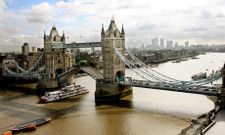
The Thames flowing under Tower Bridge. Millions of tonnes of raw sewage overflow into the river after heavy rain. Photograph: Graeme Robertson
In an unprecedented move, the councils have set up a commission of "independent" experts to examine Thames Water's case for the 20 mile long tunnel which could cost more than Wembley and the Olympic stadium and park together.
Benyon has been told that the scheme will cost all 14 million Thames Water customers — one in four of all ratepayers in England — an extra £10 a month "for life" and, in the councils' opinion, will not fix the problem of drains overflowing sewage into the river. The leaders argue that there are greener and cheaper alternatives.
"At a time when our public services are under intense pressure, Londoners cannot afford to effectively write a blank cheque for this scheme without proper scrutiny, accountability and debate. Doing nothing is not an option, but we need to consider the possibility that there are better alternatives. On a recent trip to Chicago I heard how very few world cities are approaching it in this way — many realise that a tunnel-only option is not the best solution," said Hammersmith and Fulham Tory council Leader Stephen Greenhalgh, who has led the pressure for a rethink and whose council will fund the commission.
The councils, who downplay the pollution caused saying it is only 5% of the flow into the river and only happens four times year, have appointed prominent Tory peer Lord Selborne, a former member of the Royal Commission on Environmental Pollution and Lloyds bank director, to chair the commission which is expected to report back within months.
"The key question is whether this multi-billion pound project is the best solution to making the Thames cleaner or whether there are sensible alternatives that are cheaper, greener and less disruptive," said Selborne.
Thames Water, who will also meet Benyon, counter that the 39m tonnes of raw sewerage that gets into the Thames every year is now an environmental health hazard, killing fish and carrying dangerous pathogens. The company says there are now as many as 90 incidents a year, with pollution getting worse as London experiences more frequent and intense storms.
"The unacceptable level of sewage discharges to the river must be resolved at minimum cost, so we welcome the appointment of this commission and look forward to providing whatever information Lord Selborne may require", said Thames Water in a statement.
Pressure for the tunnel to be completed is intense because Britain is in violation of Europe's urban wastewater treatment directive, which could bring fines of up to £37,000 a day. Brussels has agreed to suspend the fines because preliminary work has started on the project. It is uncertain how the EU would respond if a complete change of plan further delayed the project, or if the coalition government, on the back of the commission's report, ordered a public inquiry which could take many more months.
The scale of the disruption needed to build the giant sewer along the bed of the river and to connect it with dozens of outfalls along the river banks has angered many resident groups, who fear they will lose the use of public spaces for many years. Under Thames Water's current proposals, the park and children's playground at King's Stairs Gardens in Rotherhithe would be one of the project's main construction sites while a 100ft-wide shaft is dug to connect tunnels from other parts of the city. London mayor Boris Johnson and the botanist David Bellamy have objected to the super-sewer taking over the park.
The company hopes to apply for planning permission later this year and begin main construction of the Thames Tunnel towards the end of 2013, with completion in 2020. However, it will need the consent of all riverside councils.
"It's completely unacceptable that sewage can end up in the main river of one of the world's richest cities. If there are better ways of preventing this than currently planned they should be explored — but this mustn't distract from the need for urgent action," said Friends of the Earth's London campaigner Jenny Bates.
Melting Arctic causes a "white gold rush"
The following article appeared in The Guardian, 4th July 2011:
Arctic sea ice melting
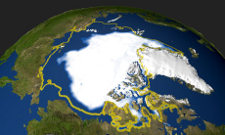
A satellite image showing the minimum concentration of Arctic sea ice in 2005. The yellow outline indicates where the concentration of ice was in September 1979. Photograph: NASA/AFP/Getty Images
The crumpled figure in seat 22 on the Air Greenland flight from Ilulissat to Kangerlussuaq was no Indiana Jones. But Dennis Thomas, a mining engineer viewing gold and diamond prospects in the Arctic, was happy to play up the part. "I've been shot at and involved in all sorts of other scrapes," the 62-year-old said as the plane cruised at 11,000ft.
Thomas had spent 30 years scouring Latin America, the Far East and most other points around the globe, but this was his first time in Greenland. And it will not be his last. The Briton was impressed with what he had seen and said he would be back after discussions with various mining companies and investors who pay him a "finder's fee" for putting them on to new, commercially viable, deposits.
"This is a very exciting place… There is only one working mine but in 10 years I would like to see them with half a dozen serious mines," he said.
It is not just small operations like Thomas Mining Associates, based in West Sussex, that are newly on the hunt as ice caps melt in the far north. Major companies have recently set foot in Greenland hoping to carve out — literally — a new mineral frontier. Political visits from countries such as China are also on the rise. They are being driven by the insatiable demand for a variety of precious stones and other commodities, which has driven up prices and sent prospectors on a frantic search for new supplies.
Greenland has long been known to harbour everything from uranium — needed for nuclear plants — to so-called rare earth minerals used in hardware such as mobile phones, flatscreen TVs and modern weaponry.
The Arctic was largely off-limits because much of the land was considered unworkable, buried under hundreds of metres of snow and ice, and with nothing in the way of traditional infrastructure. Global warming has changed that picture.
While Greenland's traditional way of hunting wild animals is endangered by the melting ice cap, mineral mining is entering a new, potentially lucrative chapter. More and more of the land is becoming ice-free — unleashing greenhouse gases in the process but offering new opportunities for diggers in the "white gold rush".
New mining applications are being submitted for extraction, all the way from Canada through Greenland to Finland. The Greenland government in Nuuk has just underlined its commitment to new ventures by repealing a law that prevented any kind of uranium mining. The laws have been amended to grant exploration licences for radioactive elements such as uranium and thorium on a case-by-case basis.
It benefits firms such as Australian-owned mining company Greenland Minerals & Energy Ltd (GMEL). Lars Emil Johansen, who recently retired as chairman of the company's Greenland subsidiary, and was Greenland's second prime minister, said: "It's not permission to start mining, but it is permission to make studies for mines with uranium. It's a very big step forward for the company."
This is happening at Kvanefjeld — said by GMEL to be "one of the world's most exciting emerging mineral projects" and believed to hold the world's sixth-largest uranium deposit.
There are also plans to open up uranium exploration in the far north of Canada, Russia, and Finland.
Uranium is controversial because of the potential health risks associated with its extraction, plus wider issues associated with its use in nuclear weapons and atomic power stations.
Meanwhile, one of the world's biggest gold mines was recently opened at Kittilä in the far north of Finland and others are already being planned in that country. Yet there is conflict over some of the plans. For example, there is vociferous opposition to a scheme by mining companies, including Anglo American, to produce gold and copper at the Pebble Mine in Alaska. Campaigners say such plans threaten the nearby Bristol Bay watershed, which supports the world's most productive wild sockeye salmon fishery, critical to the state's economy and the livelihoods of many Alaskan native communities.
So far the only current mining operation in Greenland is the Nalunaq gold mine in the south of the country. It was restarted this year as a going concern by its owner, Angel Mining, registered in London. It has created jobs and little opposition but there is more concern over a much larger industrial plan.
Alcoa, the world's third largest aluminium producer, is working on a scheme to build a massive smelter in Greenland. It hopes to use hydroelectric power as a cheap, green form of energy and produce a replica of the Fjardaál ("aluminium of the fjords") smelter at Reydðarfjörður in eastern Iceland.
Henrik Stendal, head of the geology department at the Bureau of Minerals and Petroleum in Nuuk, Greenland, says he is hopeful there will an increasing amount of activity in his country. This is not least because rising temperatures mean there is more land to explore now. He spells out something that many in government think privately but are reluctant to say openly: "You could say global warming is good for Greenland."
Large iron ore mine is planned in the Canadian Arctic
Britain's richest man is planning a giant new opencast mine 300 miles inside the Arctic Circle in a bid to extract a potential $23bn (£14bn) worth of iron ore.
The "mega-mine" — which includes a 150km railway line and two new ports — is believed to be the largest mineral extraction project in the Arctic and highlights the huge commercial potential of the far north as global warming makes industrial development in the region easier.
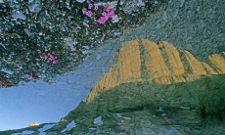
Great Sail Peak reflected in a snow melt pool on Baffin Island, Nunavut, in the Canadian Arctic. ArcelorMittal has bought Baffinland Iron Mines in order to exploit Mary river iron ore deposits. Photograph: Gordon Wiltsie/NGC/Getty Images
The billionaire steel magnate Lakshmi Mittal, who is behind the project, wants to exploit a commodity whose value has doubled due to soaring demand from China and India.
But the wildlife group WWF, describes the planned mine as a "game changer" and a test case that could affect all future industrialisation of the far north. "It is certainly… of a scale that would be massive anywhere in the world," said Martin von Mirbach, a director of the Arctic programme at WWF in Canada. WWF is demanding the company proceeds with extreme caution.
Documents seen by the Guardian show that Mittal's company, the world's biggest steel-making group, ArcelorMittal, admits the operations will be undertaken in an area inhabited by unique wildlife including polar bear, narwhal and walrus.
The company has just spent nearly $600m (£373m) alongside a US private equity firm buying Baffinland Iron Mines, to seize control and develop the Mary river deposits in the Nunavut region of the Canadian Arctic.
Mittal has already outlined an ambitious plan to use more than 2,000 workers to build 24 bridges, stretches of road, warehouses, fuel depots, landfills and an airstrip as well as the docks at Milne Inlet and Steensby.
The railway alone will take four years to construct and will need its own roads and quarries for iron ore, which the company says is "an essential commodity for ongoing growth and development of our society" particularly the developing economies of China and India.
The project will also provide jobs for locals and increased revenues for the local government of Nunavut while contributing to "strengthening Canada's sovereignty in the north".
But an environmental impact statement prepared for Baffinland Iron Mines accepts the area is home to terrestrial mammals including caribou, Arctic fox and hare.
The statement outlines how marine mammals are also found in abundance in the region including polar bears, narwhals, beluga whales and blowhead whales while migratory birds include snow geese, rough-legged hawks and gyro-falcons.
The operators say they will work hard to prevent contamination from sewage, wastewater and explosive equipment-washing but they admit: "building sections of the railway into the edge of several lakes will be unavoidable… some fish habitat will be lost."
It also says "accidental kills of caribou could occur as a result of project activity" and that "small numbers of ringed seal mortalities could occur as a result of ice-breaking activity."
The company admits any large diesel spill "would have significant environmental effects" but says this kind of event is unlikely. Baffinland also argues it will pay more than $2.8bn in taxes to the government of Nunavut over 21 years and that it will spend $1.7bn on labour.
A spokesperson for ArcellorMittal said that the project is currently in the environmental assessment process during which NGOs, governments and individuals are invited to review the plans.
"Included in the environmental impact statement (EIS) are detailed management, mitigation, and monitoring plans, which will allow for potential impacts to be minimised. All aspects of the project, through construction, operation and closure will be evaluated and will adhere to the conditions established for the project through this process," the spokesperson said.
WWF says it is up to the local Inuit to decide whether the project goes ahead but the wildlife group wants to help ensure the plans are developed in the most sensitive way.
"This is a test case on the potential for carrying out large-scale industrial development in the Canadian Arctic in an appropriate way. We would like to see better information about a project whose scale would be massive wherever it was in the world," said von Mirbach. "The biggest impact will be from shipping with a ship every 32 hours, year-round. This might not be much off Norway but here with an average of between 0-10 ships a year, it's significant. It is hard to know what impact it will have on narwhals and walruses," he added.
EU Ministers back out of international commitment on fisheries
Seas At Risk (www.seas-at-risk.org) report, Brussels, 28th June 2011: "At the Fisheries Council meeting today, EU Fisheries Ministers outrageously backed out of their international commitment to end overfishing by 2015 and chose to oppose the Commission's proposals that would result in more sustainable fisheries.
"These conclusions directly contradict what was agreed amongst Environment Ministers only last week, when they met to discuss the EU's Biodiversity Strategy and encouragingly endorsed a commitment to achieve MSY by 2015.
"Furthermore, Fisheries Ministers did not support the Commission's intention to apply a 25% reduction of Total Allowable Catches (TACs) as a matter of precaution for stocks for which there is no scientific advice or only poor information.
"Lack of stock assessment and clear scientific advice has in the past served as an argument for maintaining or even increasing catches. The proposed precautionary 25% reduction would have encouraged Member States to fulfill their Community obligations to collect and make available much needed data and would have helped avoiding the over exploitation of fish stocks we do not know enough about.
"By rejecting the Commission's approach, the Ministers have made a mockery of the precautionary principle, enshrined as one of the guiding principles in the EU Treaty. They have also paved the way for maintaining Europe's disgraceful track record in terms of fish stock assessments and management: the EU performs the worst among developed nations when it comes to fish stock assessments — for two thirds of the stocks there simply is no scientific advice available, and quotas are set blindly or stocks remain unmanaged.
"The discussions amongst the Fisheries Ministers do not bode well for the negotiations later this year on the fishing opportunities for 2012, nor for the ongoing reform of the Common Fisheries Policy.
"The European Commission is opening up the debate on how to manage fish stocks to the public, by means of an online consultation. It is high time that European citizens let their elected representatives know that they do not want public resources be so grossly mismanaged."
Puffins, seals and jellyfish of the Farne Islands — in pictures
The Farne Islands, run by the National Trust, is one of Europe's most important bird sanctuaries, home to more than 20 different species, including puffins and terns. The waters around the archipelago of 16-28 separate islands (depending on the tide) are also home to massive seal colonies. You can view these pictures on the Guardian website.
Mild tsunami hits Cornish coast
An underwater landslide is thought to have caused a small tsunami that sent holidaymakers and anglers scattering in Cornwall. Witnesses reported the sea being sucked out, or receding, before a wave struck the coast on the morning of 27th June.
No damage was caused by the wave, thought to have been about 40cm (16in) high and causing a surge up to 90cm (3ft) by the time the seawater pushed into the Yealm estuary, 70 miles up the coast near Plymouth, Devon, but many people, along the south coast, up to Hampshire, were left baffled by the phenomenon.
There were reports that static electricity in the air at the time made people's hair stand on end.
Simon Evans, who was digging for bait on the shore at Marazion, near Penzance, described the event as akin to a horror film. He said: "It was really eerie… the weather was really foggy but extremely warm and close, and the sea was as calm as a millpond. One minute I was stood at the water's edge then when I turned around the water had retreated around 50 yards. It was surreal, I couldn't believe what had happened. I had no idea what caused it, but I didn't really want to hang about and find out." He said that having heard about tsunamis, he "jumped in the car and got out of there".
Experts attributed the tsunami to a submarine landslide perhaps a couple of hundred miles out to sea.
According to the Tidal Gauge Anomaly measure, which records the difference between the forecast tide and actual tide, the wave was higher by 20cm in Newlyn, 30cm in Plymouth and 40cm in Portsmouth.
Bob Hunt, the head guide for St Michael's Mount in Cornwall, said day-trippers were caught out as they walked across the causeway to the island. "One minute they were happily walking across the walkway, the next they were knee-deep in water. It was bizarre. Ordinarily, the water slowly trickles across the walkway and the tide comes in over a matter of hours but it happened in a flash." There was also a feeling of lots of static in the air. "People's hair suddenly stood on end," Hunt said.
Further east, at the border of Cornwall and Devon, sailor Roland Stuart said his vessel was rocked by the wave. "My boat was moving around with the speed of the water rushing in. I wondered what the hell was going on. All sorts of things crossed my mind. Within 15 minutes it was all over."
Film footage taken by one witness showed the tsunami moving up the river Yealm against the natural tidal flow. Bob Brown was launching his dinghy at the mouth of the estuary at about 10.30am on Monday. He said: "The tide was coming in from left to right. All of a sudden it stopped coming in from the sea and went back the other way. It came back at quite a force, all the boats were bobbing around. To see a tide suddenly stop and go back the other way at four times the speed was unbelievable."
Mark Davidson, associate professor in coastal processes at the University of Plymouth, said people had reported seeing the sea being "sucked out" before a series of waves charged in. He believed it was a tsunami, probably caused not by an earthquake but by a landslide out at sea.
Such a landslide might have occurred at a place where the seabed sloped steeply down, such as at the edge of the continental shelf, about 250 miles off Land's End. However, had it taken place there, Davidson said, the tsunami probably would have been reported elsewhere, not just along the south coast.
Jellyfish shut down nuclear power station
Both reactors at Torness nuclear station have been shut down after high volumes of jellyfish were found on seawater filter screens. The units at Torness power station, on the coast near Dunbar in East Lothian, were closed down manually on 28th June.

Both reactors at Torness nuclear power station have been shut down after large numbers of jellyfish were found in seawater filters. Photograph: Danny Lawson/PA
EDF Energy [Electricite de France], which operates the plant, said the reactors were shut down as a precautionary measure and the public had not been in danger. The screens filter out debris in cooling water entering the plant.
An operation was put in place to clear the jellyfish from the waters near the power station and the reactors will be restarted once the numbers have gone down.
An EDF spokesman said: "Reduced cooling water flows due to ingress from jellyfish, seaweed and other marine debris are considered as part of the station's safety case and are not an unknown phenomenon. This was a precautionary action and the shutdown cooling systems performed in a satisfactory manner and both reactors were safely shut down. At no time was there any danger to the public. There are no radiological aspects associated with this event and there has been no impact to the environment."
EDF Energy could not comment on when the reactors were likely to be started up again.
OSPAR acts to protect seven sea bird species
Contracting Parties to the international OSPAR Convention (www.ospar.org) have taken another step towards protecting species which depend on the North-East Atlantic Ocean.
Agreement has been reached on a series of recommendations for actions to better understand and protect seven species of sea birds that range from the Azores in the south, in the north to the Arctic Circle. These seven sea birds are ivory gull, lesser black-backed gull, little shearwater, Balearic shearwater, black-legged kittiwake, roseate tern and thick-billed murre.
These sea birds feed at sea, often travelling far offshore to forage for their prey. With longer lifespans than many land-dwelling birds and producing fewer young, later in life, sea birds are vulnerable to the threats posed by the many competing human uses of the sea. Increases in threats such as accidentally being caught in fishing gears, and the impacts of pollution, together with the vulnerability of these sea birds make a powerful and urgent case for intervention to safeguard their survival.
BirdLife International, an Observer to OSPAR said, "We are delighted that the Recommendations for better protection and conservation of these seven sea bird species have been agreed today. We now urge the OSPAR Contracting Parties to put the actions into practice as soon as possible to give these sea birds the protection they so urgently need, and allow continued enjoyment of these sea birds by people along the Atlantic coasts of Europe."
During the same meeting the OSPAR Commission also agreed to undertake a ground-breaking regional study on the use of North-East Atlantic marine waters.
This study will be prepared as part of a two-year project that will draw the attention of the public and decision-makers to the economic benefits provided by the marine environment, to highlight the growing costs of ecosystem degradation and to draw together expertise from the fields of science, economics and policy to support an ecosystem approach to management of human activities.
The aim is to improve the understanding of the benefits of a good environmental status of our marine waters by linking changes in ecosystem services with changes to human welfare. In the future this work will support the identification of the most cost-effective measures to improve the status of the marine environment.
OSPAR's economic and social analysis project will help deliver commitments made by OSPAR Ministers at their 2010 meeting in Bergen, Norway. It will also support coordination between OSPAR Contracting Parties to ensure the consideration of economic and social factors, as required by the European Union's Marine Strategy Framework Directive (MSFD), is coherent across the North-East Atlantic. The analysis is co-funded by the following OSPAR Contracting Parties: France, Ireland, Norway, Sweden and the United Kingdom.
Unexpected rise in wild salmon numbers
Against all expectations, salmon numbers are leaping again in British rivers. Conservation scientists have discovered that the fish is staging a comeback in many native streams and waterways.
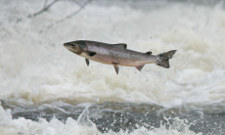
A wild salmon leaps upstream at Philiphaugh in the Scottish Borders. The number of fish returning to rivers and streams is rising almost everywhere across Britain, according to conservation experts. Photograph: Epicscotland/Alamy
The return of the salmon is good news for fly fishermen — and for conservationists who have worked hard to restore numbers after the fish's disastrous decline two decades ago.
However, experts warn that the current increase — revealed in statistics for salmon tagged and counted in 2010 and from observations from river banks this year — may only be temporary.
"We still don't know why this is happening. It may just be a one-off or it could be a general trend to a return to healthy salmon numbers in our rivers," said Dr Anton Ibbotson, of the Game and Wildlife Conservation Trust.
Some of the most detailed figures on salmon numbers have come from the river Frome in Dorset. Conservation experts have been able to monitor fish more easily and in greater detail on this modestly sized waterway than on the nation's great salmon rivers such as the Tweed and Tay, and at East Stoke they have introduced a system that can accurately count salmon in the river.
"We used to get more than 2,000 salmon coming back to the river every year," said Ibbotson, head of the trust's salmon and trout centre. "Then, in the early 1990s, that figure plunged to under 500 and it has never recovered — until this year."
This decline affected other rivers, leading to bans on the sale of fresh river salmon caught using rods and restrictions on the use of nets. In the process, wild salmon from rivers like the Wye and Usk disappeared from shops.
As to the cause, experts remain mystified. The life of the salmon is highly complex. Salmon eggs are laid in freshwater streams. The eggs hatch and the young fish live for six months to three years in their home river systems before their body chemistry changes to adapt to salt water. The salmon then migrate to the open ocean where they mature sexually. The adult salmon later return to their native streams to spawn.
Scientists say changes in environmental conditions at any stage in their life cycles, at sea or in their home rivers, could have affected numbers of salmon returning to their home rivers. "There are a host of possible reasons why numbers dropped," said Andrew Flitcroft, editor of Trout and Salmon magazine. "It could have involved alterations in conditions at sea — or in fresh water."
Changes in ocean temperatures and currents, the availability of food in the open seas and the over-exploitation of ocean fisheries have all been suggested as factors. In addition, young salmon may have left their home rivers in a weakened or undernourished condition and were unable to survive the open sea. "Whatever the cause, the impact was considerable," said Mark Lloyd, of the Angling Trust. "About 30% of young salmon used to make it back to their native rivers. By the end of the 20th century, that had dropped to about 0.3%."
However, over the past 12 months this trend has been reversed and salmon numbers — although not reaching the peaks of the 1970s and 80s — have risen remarkably. "There has been a very welcome return in numbers of salmon," said Flitcroft. "In addition, they seem to be coming back in a strong, healthy state."
The comeback is still patchy, Lloyd added. "Most of the east and north of Scotland have done well, as have the Tyne and Wear rivers," he said. "However, the Wye and Usk are still quite badly off — partly because river levels there are quite low, thanks to the recent dry springs and over-abstraction of their waters. It is then easy for cormorants and other birds to pick off salmon in the clear, shallow water."
The major exception to the salmon's successful return is the west of Scotland, a trend blamed by the Rivers and Fisheries Trusts of Scotland on the prevalence of fish farms, which provide jobs for thousands of workers in the Highlands. Wild salmon catches there have continued to decline while they have risen on the east coast, where there are no salmon farms, says the trust. It blames sea lice infestations from farmed salmon cages for infecting migrating wild salmon.
"We can see a clear trend of declining wild salmon catches in areas where the Scottish salmon farming industry operates, in comparison with the east coast," said Dr Alan Wells, policy and planning director of the Association of Salmon Fishery Boards. "There is a clear need to direct research and funding into initiatives that will give greater protection to our wild salmon and sea trout."
MPs critical of plans to reform the Coastguard Service
The government's plans to modernise the coastguard service should be scrapped, according to MPs.
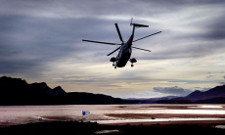
The MCA wants to reduce the existing 18 coastguard stations to three centres, open on a 24-hour basis, and five other centres operating only during daylight hours. Photograph: David Cheskin/PA
A highly critical report from the Commons' transport committee says the Maritime and Coastguard Agency (MCA) has mishandled the coastguard consultation and should withdraw its proposals.
The committee says the proposed changes to modernise the coastguard service will jeopardise safety at sea, and ministers are urged to issue revised proposals for further consultation.
The MCA wants to reduce the existing 18 coastguard stations to three centres, open on a 24-hour basis, and five other centres operating only during daylight hours. The remaining 10 centres would close and a geographic information system would be made available to all watch-keepers across the UK.
The committee is concerned that this technology will not adequately compensate for the loss of local knowledge incurred through reducing the number of rescue centres. The quality and rate of information would be reduced, jeopardising incident response rates, says its report.
Louise Ellman, chair of the transport committee, said the MPs accepted the need for some modernisation, but described the government's plans as "seriously flawed".
The plan to modernise the coastguard service has been controversial and has resulted in an increasingly bitter dispute between the MCA and its staff. Last month, Sir Alan Massey, chief executive of the agency, said he hoped that "given time and absolute honesty and constant communication", he would be able to persuade his staff to accept the plans, which involved cutting almost half the existing 481 coastguard jobs.
Massey's predecessor, Peter Cardy, has also backed the reforms, saying that not installing new communications technology would be far more risky than leaving the existing service as it is.
The committee's report highlights a number of concerns, including the burden of responsibility the proposals would place on volunteer coastguards. Volunteers do not have the same level of local knowledge held by operations room staff, it says, and there is a risk that excessive demands on volunteers would affect recruitment figures.
The committee has also questioned the statistics used by the MCA to back its proposals. The report found that the published figures do not show the seriousness or duration of incidents and that they fail to address regional differences. The MCA is urged to publish data for the number of staff hours per incident, disaggregated by region.
The report also opposes the decision to stop central funding to the Maritime Incident Response Group (MIRG), the fire-fighting-at-sea service, because evidence found that while ships' crews have some training, their skills do not match the expertise of the MIRG.
Alan Massey, chief executive of the Maritime and Coastguard Agency, said that he is "pleased" the committee's report acknowledges that the coastguard service is in need of modernisation.
Massey said: "Our original proposals do not compromise safety and include increased resources for frontline rescue services. Reform will improve resilience in the system through improvements to IT and create better career opportunities for staff, as well as better pay and conditions. I believe that our proposals will deliver that."
Maersk's "Triple E" ships promote a sustainability revolution in shipping
Stephanie Draper, director of change strategies at Forum for the Future (www.forumforthefuture.org ) writes:
"A couple of weeks ago Maersk Line, the shipping giant, launched a manifesto for change. Shipping has had a number of major changes in its commercial life — from sail to steam, from steam to oil, from individual loading to containerisation. Maersk argues that it is time for the next revolution — to sustainability.
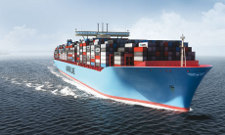
What the Maersk Triple E giant ship will look like when launched in 2013. Economies of scale give better fuel efficiency and reduced CO2 emissions. Photograph: Maersk
"This announcement is powerful because it bucks a historical trend. Companies that are doing well today generally don't try and change the status quo. However leading companies such as Maersk do — they aim to shape a future that they can profit from. Their super-efficient Triple E ships have been commissioned to succeed in a low-carbon world.
"Maersk has form in this sort of move. It was the first major shipper to invest in and really drive containerisation. In fact, the story of containerisation shows us how important the combined rôle of external disruption and leadership by incumbents can be in a move to a more sustainable future.
"Historically, ships were loaded and unloaded piece by piece. Ports were dangerous and chaotic, goods were often broken or lost and, as global trade increased, this became a real bottleneck. At first, the solutions didn't work very well.
"The idea of putting goods in large boxes had been around for years but the different-sized, heavy boxes simply added to the danger and complexity of getting goods into tightly packed holds.
"In 1955, Malcolm McLean, a trucker and industry outsider, considered shipping as part of the wider logistics system and the shift started to happen. McClean saw that containers needed to be easily and efficiently loaded on to a ship and offloaded onto trucks and rail at each end of the journey. He looked beyond the immediate problem to a find a more systemic solution that dovetailed ship cargo with other forms of transport.
"So McLean created what we call pioneering practice. He worked with engineer Keith Tantlinger to design a standard container that worked for trucks and rail and retrofitted tankers to take these containers. On 26th April 1956, a retrofitted tanker, the Ideal-X, sailed from Newark to Houston. McCleans went on to work with ports to co-invest in specialist loading systems and also developed, and importantly shared, "the McLean's standard (and patent)" for containers — to ensure consistency and wider market adoption.
"During the 1950s and 1960s, this new approach proved to be much more efficient and enabled McLean and other early adopters to offer much lower rates for shipping goods and services on the routes where the infrastructure was in place. But it didn't scale. Opposition was strong. The unions didn't like it — seeing an end to jobs. Countries protecting their national transport industries slowed implementation in major ports. It was the Korean and then the Vietnam war that changed that. US armed forces used containerisation for the huge volumes of goods that they were moving — proving the concept at scale.
"Following that, the increased speed and reduced cost made it a case of adapt or die for operators competing on containerised routes. It was at this point that Maersk adopted containerisation, and the size and commitment of the company led to a massive expansion of the infrastructure. In effect, Maersk's commitment and investment made containerisation mainstream. It proved a tipping point.
"OK, so you might not be as excited about shipping as me (Forum for the Future is running a large project to make shipping sustainable) and might rarely think about those colourful containers that travel our oceans, but this is a story of innovation, disruption and leadership to create change.
"We now live in a world where 90% of our non-bulk goods come in containers. The speed of shipping has accelerated (containers can ship 20 times faster) and this has had an impact on the speed and location of global production and trade. The seeds that McClean sowed in 1956 have grown into a key enabler of our globalised world.
"This story shows that you need a pioneer to take the first step to really change the approach of a whole industry. In McClean's case, he was an industry outsider and that is often the case with this sort of disruption. So today we see Vodafone moving into banking and Google into energy, not to mention the entrepreneurs — it is here were disruptive change can happen.
"But it also illustrates the important rôle that incumbents can play. Maersk's take-up of containers was what created the tipping point. There are lots of ways that companies can shape their future and this sort of large scale adoption of a proven, but relatively niche idea is a key one."
Planet's oceans face "inevitable mass extinction" says IUCN/IPSO Report
Fish, sharks, whales and other marine species are in imminent danger of an "unprecedented" and catastrophic extinction event at the hands of humankind, and are disappearing at a far faster rate than anyone had predicted, a study of the world's oceans has found. Mass extinction of species will be "inevitable" if current trends continue, researchers said.
Overfishing, pollution, run-off of fertilisers from farming and the acidification of the seas caused by increasing carbon dioxide emissions are combining to put marine creatures in extreme danger, according to the report from the International Programme on the State of the Ocean (IPSO), prepared at the first international workshop to consider all of the cumulative stresses affecting the oceans at Oxford University.
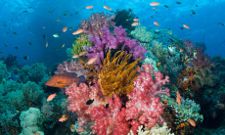
Record high temperatures during 1998 wiped out 16% of all tropical coral reefs. Photograph: Darryl Leniuk/Radius
The international panel of marine experts said there was a "high risk of entering a phase of extinction of marine species unprecedented in human history". They said the challenges facing the oceans created "the conditions associated with every previous major extinction of species in Earth's history".
"The findings are shocking," said Alex Rogers, scientific director of Ipso. "As we considered the cumulative effect of what humankind does to the ocean, the implications became far worse than we had individually realised. This is a very serious situation demanding unequivocal action at every level. We are looking at consequences for humankind that will impact in our lifetime, and worse, our children's and generations beyond that."
The flow of soil nutrients into the oceans is creating huge "dead zones", where anoxia — the absence of oxygen — and hypoxia — low oxygen levels — mean fish and other marine life are unable to survive there.
Hypoxia [low level of oxygen] and anoxia [absence of oxygen], warming and acidification are factors present in every mass extinction event in the oceans over the Earth's history, according to scientific research. About 55m years ago, as much as half of some species of deep-sea creatures were wiped out when atmospheric changes created similar conditions.
In recent years, human effects on the oceans have increased significantly. Overfishing has cut some fish populations by more than 90%. Pollutants, including flame-retardant chemicals and detergents are absorbed into particles of plastic waste in the sea, which are then ingested by marine creatures. Millions of fish, birds and other forms of life are choked or suffer internal ruptures from ingesting plastic waste.
During 1998, record high temperatures wiped out about 16% of the world's tropical coral reefs.
The scientists called on the United Nations and governments to bring in measures to conserve marin ecosystems. Dan Laffoley, of the International Union for the Conservation of Nature, said: "The world's leading experts on oceans are surprised by the rate and magnitude of changes we are seeing. The challenges for the future of the oceans are vast, but unlike previous generations.
Note: The full version of the IUCN/IPSO report is to be published at a future date, but a Summary has been published. Report Title: Rogers, A.D. & Laffoley, D.d'A. 2011. International Earth system expert workshop on ocean stresses and impacts. Summary report. IPSO Oxford
Shetlands' shellfishery gains a Marine Stewardship Council's sustainability certificate
For decades, catching crabs, lobster and scallops has been a cottage industry for the day-boat fishermen on Shetland, a useful sideline which helped boost their income.
But now these fishermen are on the brink of winning a coveted — and so far unique — environmental certification, catapulting their shellfish on to the menus of fine dining restaurants, the shelves of major supermarkets and into the shopping baskets of green-conscious foodies.
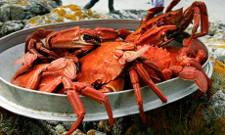
Velvet crabs from the Shetland islands are due to receive an environmental sustainability certificate from the Marine Stewardship Council. Photograph: Murdo Macleod for the Guardian
About 120 fishermen on Shetland are expected to become the first in the world to be granted an environmental sustainability certificate for lobster, scallops and brown and velvet crabs from the Marine Stewardship Council (MSC), the world's largest eco-labelling body for wild fisheries.
Winning the MSC label is likely to transform the Shetland shellfish, still regarded as the poor cousin of the Scottish fishing industry, into boutique products alongside the tiny MSC-certified dover sole and mackerel fisheries off Hastings, East Sussex, potentially making them some of the most sought after seafood in the UK.
The four fisheries are currently worth about £9m to Shetland, with landings of velvet crabs at just 328 tonnes in 2010 — most of which are exported live for seafood restaurants in Spain — and just 24 tonnes of lobster. They are dwarfed by the islands' largest and most valuable fisheries: mackerel, herring and white fish such as cod and haddock are worth about —70m a year to the islands.
For many critics, the scallop industry is a contentious issue; along some stretches of the British coast large-scale scallop dredging, where heavy mats are dragged along to scoop up scallops, has been blamed for stripping bare many fragile and vulnerable areas of seabed.
However, Shetland's inshore fishermen have access to some of the most detailed maps and sealife data of any waters in Europe, collated by the North Atlantic Fisheries College on Shetland.
Armed with that data, they voluntarily close down areas of their inshore waters to allow stocks to recover, and have agreed to permanent closures to protect delicate maerl, eelgrass beds and coral across 10.5 square miles of seabed. These policies, and strict rules on the bycatch of other species, have played a crucial rˆole in the certification process, MSC officials say.
Gary and Jonathan Leask, brothers who take their scallop-dredging vessel Kestrel along Shetland's rocky and intricate coastline, often fishing from dawn to dusk, believe that winning the MSC's approval will significantly increase the cachet of the catch for consumers and within the industry.
"I think we're hoping the value of our scallops will rise," said Gary. "But it's more looking after the stock. If the stock is right, you ken there will be fishing for years to come." Jonathan said: "The main thing is that if we want to have a future at this, we have to have the stock. We all have buyers [for our shellfish] so the market is there: but trying to improve the market is the thing. This will improve that. I think it's kind of exciting."
The brothers are members of the Shetland Shellfish Management Organisation, which is overseeing the application for the MSC eco-label, and they support the self-imposed rules on using a limited number of scallop trawls.
The MSC has powerful critics: the environment group Greenpeace has accused it of wrongly accrediting fisheries, particularly in the Pacific, where stocks are declining. The MSC rejects these allegations and insists every fishery is rigorously assessed and local conditions carefully examined.
The pressure group Food and Water Europe said it was "deeply disturbing" that the fast food chain McDonalds would soon use MSC-certified hoki from New Zealand for its Filet-o-Fish burger, claiming that the fishery involved was implicated in sea bird and sea deaths.
However, Shetland's shellfish are being championed by Roy Brett, an award-winning chef and restaurateur who previously oversaw Rick Stein's famous fish and chips and seafood empire in Cornwall. Brett now runs the restaurant Ondine at the Missoni hotel in central Edinburgh, one of the few in the UK to have accreditation from the MSC to sell eco-labelled fish dishes. He said his customers welcomed it.
Brett has struggled to source eco-labelled produce from within the UK, and relies heavily on frozen MSC fish from Alaska. He is waiting for a fish wholesaler in the Edinburgh area to become an MSC-certified supplier. "There's real demand out there," he said. "Everybody wants to know now, because of the consequences of over-fishing putting a strain on certain species. We will definitely buy [Shetland's shellfish] as soon as it becomes available: it will command a higher price and quite rightly so."
A fifth shellfish from Shetland, mussels, are also entering the accreditation process, in an alliance with mussel farmers on the west coast of mainland Scotland. This marks a shift in the MSC's policies: it currently restricts itself to only wild fisheries and has resisted moving into farmed fish and aquaculture. Even though they are grow on ropes placed there by mussel farmers, the mussels are regarded as wild.
Climate change solutions based on technology rather than restraint gain advocacy
Lighter-coloured crops, aerosols in the stratosphere and iron filings in the ocean are among the measures being considered by leading scientists for "geo-engineering" the Earth's climate, leaked documents from the UN climate science body show.
In a move that suggests the UN and rich countries are despairing of reaching agreement by consensus at global climate talks, the US, British and other western scientists will outline a series of ideas to manipulate the world's climate to reduce carbon emissions. But they accept that even though the ideas could theoretically work, they might equally have unintended and even irreversible consequences.
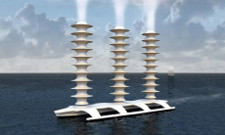
One of the geo-engineering solutions to climate change is to spray seawater droplets into marine clouds to make them reflect more sunlight. Photograph: NASA
The papers, leaked from inside the Intergovernmental Panel on Climate Change (IPCC), ahead of a geo-engineering expert group meeting in Lima in Peru, show that around 60 scientists will propose or try to assess a range of radical measures, including:
- blasting sulphate aerosols into the stratosphere to reflect sunlight into space;
- depositing massive quantities of iron filings into the oceans;
- bio-engineering crops to be a lighter colour to reflect sunlight; and
- suppressing cirrus clouds.
Other proposals likely to be suggested include spraying sea water into clouds to reflect sunlight away from the Earth, burying charcoal, painting streets and roofs white on a vast scale, adding lime to oceans and finding different ways to suck greenhouse gases out of the air and deposit heat deep into oceans.
The meeting is expected to provide governments with a scientific assessment of geo-engineering technologies, but is widely expected to be in favour of more research and possibly large-scale experimentation despite an international moratorium adopted by the UN last year in Japan.
This week, more than 125 environment, development and human rights groups from 40 countries published a letter sent to Rajendra Pachauri, the Nobel prize-winning head of the IPCC, warning that the body had no mandate to consider the legality or political suitability of using geo-engineering.
"Asking a group of geo-engineering scientists if more research should be done is like asking bears if they would like honey," said the letter, signed by groups including Friends of the Earth International, Via Campesina and ETC.
Concern over the IPCC meeting centres on who should decide what kind of geo-engineering takes place, and how it should be regulated and monitored. Some projects might, if they work, unintentionally change weather patterns and possibly affect farming and livelihoods in some of the most vulnerable areas in the world.
"[Geo-engineering] is not a scientific question, it is a political one. International peasant organisations, indigenous peoples and social movements have all expressed outright opposition to such measures as a false solution to the climate crisis," says the letter.
Britain is, along with the US, strongly backing geo-engineering research and has supported scientists with millions of pounds of university research, including a Bristol University plan to develop a "hose" held up by balloons through which sulphates can be sent into the stratosphere. The Royal Society is now trying to develop international guidelines and principles and is holding workshops around the world.
In a letter to the Guardian, Georgina Mace, professor of conservation science at Imperial College, London and Catherine Redgwell, professor of international law at UCL, said that investment in geo-engineering research had already begun and, "without international governance structures, schemes could soon be implemented unencumbered by the safeguards needed".
But according to abstracts of the papers, Redgwell will advise the IPCC in Peru next week that no new laws should be adopted. "A multilateral geo-engineering treaty is not likely or desirable. The appetite for climate change law-making is low."
The main principles, she suggests, should be that geo-engineering is a "public good", there should be public participation in schemes and independent assessment of the impacts.
"Geo-engineering is not a public good but could be a giant international scandal with devastating consequences on the poor," said Diana Bronson, researcher with international NGO the ETC Group.
In the papers, many of the scientists accept there are that major uncertainties around the technologies. However, the scientific steering group of the meeting, which will assess the technologies, includes many well-known geo-engineering advocates who have called for public funds to conduct large-scale experiments as well as scientists who have patents on geo-engineering technologies or financial interests in the technologies.
The meeting has been given added weight because last week, Christiana Figueres, head of the UNFCCC, told the Guardian that the world may have to investigate geo-engineering because emissions were continuing to rise.
"We are putting ourselves in a scenario where we will have to develop more powerful technologies to capture emissions out of the atmosphere", she said. "We are getting into very risky territory."
NGO Report suggests fish farming is preferable to livestock farming
The world needs to farm more fish and algae to meet the world's growing demand for animal products, according to a report released by international NGO Conservation International.
The worldwide assessment concluded the environmental impact of aquaculture is lower than raising cattle, pigs or poultry so it should be expanded to alleviate the growing global food crisis.
"Aquaculture is most likely to meet the growing demand for animal products with the least demand on ecosystems," said Sebastian Troëng of Conservation International. "It would be better still if more people became vegetarian, but that looks unlikely."
The report was co-written with the WorldFish Centre — which advocates sustainable aquaculture — as a response to the precipitous decline in word fish stocks.
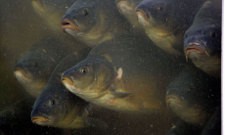
Carp in a fish farm at Zabieniec, Poland. Photograph: Janek Skarzynski/AFP/Getty Images
The United Nations Food and Agriculture Organisation estimates that over 84% of the world's fisheries are either depleted, over- or fully exploited, which means that wild fish in oceans are too weak to meet the growing needs of an expanding, increasingly affluent global population.
Fish farming in ponds, lakes, rivers and coastal waters is increasingly used to fill the gap — it is overtake wild-caught fish produce this year — particularly in Asia. The world's most crowded continent accounts for 91% of aquacultural production with the vast majority — about two-thirds — in China. This trend is expected to continue.
"China, India and the rest of Asia with their growing middle classes are where we can expect demand for fish to rise most significantly," said co-author Mike Phillips, a senior scientist at WorldFish. "Current trends indicate that the majority of the increase in global production will come from south and south-east Asia, with a continued drive by major producersuch as China and Vietnam towards export to Europe and north America."
The report says fish farming can have environmental benefits if done sustainably. Fish process energy more efficiently than mammals such as cows and pigs because they are cold-blooded (so less calories are needed for warming themselves) and live in water (so relatively more of the body converts to muscle than bone). The authors say that for each kilogram of protein from beef, a cow needs to be fed the equivalent of 61kg of grain, for pork, a pig needs 38kg, but for fish it is just 13kg of grain.
In addition, says the report, aquaculture emits less phosophorous, nitrogen and greenhouse gases than livestock farms.
However, it warns farming can have a greater negative impact if it focuses on carnivorous fish such as eel and salmon, or on shrimps and prawns, which require more temperature control. There is a lower impact from herbivorous fish, or better still seaweed, mussels, oysters and molluscs.
Fish farms have also been blamed for pollution and genetic contamination of wild stocks.
The report says 73% of salmon, 90% of carp and 99% of seaweed consumed worldwide is produced with aquaculture. The authors predict worldwide production will rise from 52.6m tonnes in 2008 to between 79m and 110m tonnes by 2030. However, environmental constraints could slow growth in China due to shortages of land and water and increased competition for energy and feed.
To improve the industry, they suggest greater monitoring, technological innovation and policy support. Mass production of microalgae — which is thought to be approaching commercial stage — is thought to have enormous potential for efficiency gains because it could replace fish feed and fish oil.
MARINET observes: A distinction must be made between the farming of herbivorous (e.g. carp) and carnivorous (e.g. salmon) fish species. If the purpose of fish farming is to relieve and/or substitute for the harvesting of wild fish when many wild stocks are under severe pressure due to over-fishing, it must be observed that herbivorous fish farming can genuinely relieve pressure on wild marine stocks by utilising sustainably vegetable-based feed stock in order to rear the fish, whereas carnivorous fish farming cannot meet this requirement because it takes roughly 3kg of wild caught fish (converted into a fish-based protein feed material) to produce 1 kg of farmed fish — in other words, carnivorous fish farming intensifies the pressure on wild stocks rather than relieving it — see MARINET report to Marine Scotland on fish farming in Scotland. Therefore if the world population is to continue to eat carnivorous (e.g. cod, haddock, herring, bluefin tuna, mackerel and so forth) it must rely on sustainably harvested wild populations which, in turn, means that commercial fishing practices and management must seek to manage wild fish stocks sustainably in accordance with the ecosystem-based approach to marine management and in conformity with marine legislation.
Also, it should be noted that the reform of fishing practices — how we restore wild fish populations to somewhere approaching historic stock levels, thus providing us with "food security" — is a key question that must be addressed by the European Union in its current decision to reform the EU Common Fisheries Policy. To see what it means to restore fish stocks to somewhere approaching historic levels in the North Sea, see MARINET Briefing on this subject.
Report claims subsidies to the fishing industry is damaging fish stocks
The Scottish Marine Institute reports, 24th May 2011, that researchers from the UK and Canada have discovered that massive EU fisheries subsidies cause North Sea fisheries to be less profitable by encouraging fishing to continue long after the fishery is profitable, so damaging fish stocks.
Pumping EU subsidies into North Sea fisheries damages fish stocks because subsidies encourage fishermen to carry on fishing long after the fishery is profitable, new research reveals.
Researchers from the UK and Canada have discovered that the 208 million Euros paid out by the EU in fisheries subsidies resulted in North Sea fisheries actually being less profitable by a massive 71 million Euros.
"Our findings show the negative impact that subsidies have on both the biomass of important fish species and the profit that can be made. We found that subsidising fisheries does not make good economic or ecological sense," said Dr Sheila Heymans of the Scottish Marine Institute.
Heymans and colleagues estimated total subsidies paid to a range of North Sea fleets and then incorporated the data into an ecosystem model of the North Sea.
They looked at two scenarios: maximising economic return; and maximising ecological stability. Examining the influence of subsidies on fisheries' profitability between 1991 and 2003 revealed that subsidies decrease the potential profit of the fisheries. The scientists then forecast the outcome of different effort levels in the various fisheries.
They discovered that to maximise profitability an increase in effort was required in some fisheries currently operating in the North Sea (Nephrops trawlers, beam trawlers and pelagic fleets) — but this would be at the expense of demersal trawl fishermen (who target fish like cod and haddock). However, even a three-fold increase in effort in the most profitable fleet (the Nephrops, or langoustine fishery) gave only six years of profit after which (even with subsidisation) the fishery made a loss.
"The model results suggest that you can maximise economic return from the North Sea in the short-term by increasing effort in fisheries like Nephrops trawling. However our work clearly shows the North Sea ecosystem is intimately linked, with some fleets and species suffering at the expense of gains in others", said Steve Mackinson from Cefas, a co-author on the report.
The study showed that removing subsidies decreased individual fisheries' income but increased the overall profitability and total biomass of commercial fish. When the scientists ran the model to optimise for profit, the amount of cod, haddock, herring and plaice increased and when they optimised for ecological stability, cod, plaice and sole biomass increased.
"The model shows that seeking ecological stability for the North Sea increases biomass of commercial fish species, creating a more robust ecosystem that is better able to withstand environmental fluctuations such as those we may see with climate change," said Rashid Sumaila from UBC Fisheries Centre.
UK supermarkets seek to promote "sustainable fish"
UK supermarkets are stepping up their efforts to encourage shoppers to buy fish from sustainable sources in a fresh attempt to alleviate pressure on threatened stocks.
Currently 80% of fish bought by British consumers is one of the 'Big Five' staples — cod, haddock, tuna, salmon and prawns. But experts predict that some popular species could be extinct in the wild by 2050.
On Friday Sainsbury's — the UK's largest retailer of Marine Stewardship Council (MSC) certified fish and seafood products — will offer customers asking for one of the 'Big Five' an alternative, lesser known species to try out free.
Suppliers will largely bear the cost of the drive to encourage shoppers to broaden their fish repertoire and try out little-known but sustainable species — coley, pouting and megrim, rainbow trout and mackerel. Shoppers will be targeted at the chain's 387 UK stores with fresh fish counters through the new 'Switch the Fish' campaign which will also feature regional road-shows and recipes.
Sales of "alternative" species of fish and seafood soared after being championed in Channel 4's Fish Fight campaign — led by Hugh Fearnley-Whittingstall — which launched in January. Initial supermarket sales figures suggested consumers were favouring coley, dab, mussels, squid and sardines over the salmon, cod and tuna in the TV programmes, which highlighted the wasteful use of "discard" in fishing practices while encouraging shoppers to take the pressure off popular fish stocks by being more adventurous in what they eat.
Yet new research carried out by YouGov for Sainsbury's and published on Monday shows that shoppers remain set in their ways. Nearly half (41%) of Britons eat cod at least once a month while a fifth of people eat tuna at least once a week. At the same time, 84% of Britons have never even tried megrim while 82% have never eaten pouting. Some 43% of fish eaters are put off trying a different type of fish if they were unsure about its taste, while 31% of people admit they would not try a new fish if they did not know how to cook it.
Supermarkets came under strong criticism last month from the Marine Conservation Society (MCS), which said they should be doing more to help the environment and boost dwindling fish stocks by helping shoppers to make the right choices.
Meanwhile, Marks & Spencer is to use the profits from its 5p food carrier bag charge to finance its 'Forever Fish' campaign starting later this month, which will promote the use of sustainable fish not only in fresh products but also in ready meals, takeaway and frozen foods. Money will also go to the environmental charity WWF to help clean up beaches and support threatened species such as turtles and dolphins.
Marc Bolland, M&S chief executive, said: "We will work together with our customers, our people and their children to promote a healthy future for our beaches, seas and fish. Forever Fish involves schools, charities, fishermen and fisheries so we can all enjoy cleaner beaches, more sustainable fishing and healthy fish."
Sainsbury's move is backed by the government and chef Jamie Oliver. Richard Benyon, the fisheries minister, said: "This is exactly the sort of thing we've been working hard for in government — sustainable fish stocks and the conservation of our precious marine environment for future generations.
"If more people start to choose a wider variety of fish, this will help in our battle to end the terrible waste of millions of edible fish being thrown back into the sea dead because of an outdated system." Oliver, who took part in the Fish Fight campaign, added: "Earlier this year I joined the debate to encourage people to try new, less loved fish, which had a great response."
Greenpeace launches new purpose-built protest ship
Tim Adams, The Observer 12th June 2011, reports: The 1985 bombing of the Rainbow Warrior made the converted fishing trawler a campaigning icon. Now, in its 40th anniversary year, Greenpeace is launching its first purpose-built protest ship — one of the most technologically advanced vessels to set sail.
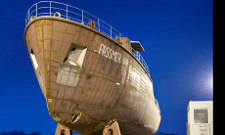
"You can't sink a Rainbow": the hull of the ship on dry ground in front of the ship building hall at Fassmer Shipyard in Berne. Photograph: Oliver Tjaden/Greenpeace
The secretive shipyards of Bremen in northern Germany are the places where Russian oligarchs and Silicon Valley billionaires go to have their fantasies (and insecurities) made into yachts. In a hangar at the yard of Fassmer on the banks of the River Weser, however, a different kind of £16m dream boat is taking shape.
It is a dream that began more than 25 years ago, when Greenpeace's Rainbow Warrior was sunk in Auckland Harbour by bombs planted by the French secret service. The determination then, from environmental activists across the globe, was that "you can't sink a Rainbow". In the years since, Greenpeace has become perhaps the world's most recognisable and sophisticated global eco-charity. Its ships, however — converted trawlers and gas guzzlers — have never quite lived up to its green aspirations. That is where the dream comes in.
The new Rainbow Warrior III, which I had come to Bremen to get a first look at, will be among the most environmentally advanced ships of its size at sea. The boat — "don't call it a yacht!" I'm told — is nearly 60m long and currently cased in scaffolding, though the distinctive dove of peace and childlike red-and-yellow — and-pink-and-green rainbow is visible on its hull. At the beginning of next month, when the ship is baptised, twin 50-metre masts will be hoisted on its deck to carry 1,200 sq m of sail. A state-of-the-art hybrid engine will be needed for only about 10% of its operational power.
Everything about it, from the paintwork to the insulation, has been designed with sustainability in mind. Each component comes with transparent ethical sourcing. Below deck the ship will house one of the most sophisticated communications operations anywhere on the ocean. As well as all this up-to-the-minute kit, the boat is required to have something that is not mentioned in the hundreds of pages of specification: a soul.
This particular tricky fixture is very much rooted in its history. On one level Rainbow Warrior III is the inspired result of some of the latest thinking in sailboat technology from world-leading — mainly Dutch — computer modellers and wind-tunnel obsessives. On another it is the latest fulfilment of an old Native American prophecy: "There will come a time when the earth grows sick, and when it does a tribe will gather from all the cultures of the world who believe in deeds and not words. They will work to heal it… they will be known as the 'Warriors of the Rainbow'."
There are various sources for that prophecy, which spread among early environmentalists when it was published in a book of Hopi Indian and Cree legends in California in 1962. But 15 years later, when Greenpeace activists in the UK came up with the idea of taking a ship to bear witness to some of the more blatant acts of ecological destruction … from whaling and oil exploration to nuclear testing and industrial fishing — that were occurring in the remote oceans, there was only one name that could do it justice. The Aberdeen-built trawler the Sir William Hardy" was almost ready for scrap when it was bought by Greenpeace for £40,000. After a refit and hand-painting of the famous logo on its bow, it first sailed out along the Thames on 15th May 1978.
The first Rainbow Warrior had been making headlines (and trouble for corporations and governments) successfully for seven years when, on a mission to disrupt French nuclear testing in the South Pacific, it was infamously sunk in Auckland harbour by two bombs attached to its hull by French secret agents. One Greenpeace crew member, the photographer Fernando Pereira, was killed, having gone below deck after the first explosion to try to retrieve his cameras. The story quickly became a defining legend, not just of Greenpeace but of environmental activism in general.
This history seemed very present as I walked around the half-finished decks of the new boat, where German engineers were efficiently welding together the latest incarnation of the mythology. The Rainbow Warrior III project is being overseen in Bremen by William Sykes, a 6ft 6in Glaswegian second-row forward, who points out to me some of the ship's more unusual features — the advanced technology that will drop smaller inflatable speedboats from its sides at record speed for the quickest possible advance or getaway; the helicopter pad that can be created on deck; the below-deck radio room with its reinforced door built to allow at least 30 minutes transmission time in the event of the ship being boarded — as it has been in the past — by SAS-style commandos wielding axes.
When it first embarked on the commissioning of the ship, Greenpeace canvassed staff at its 40 global offices to come up with a list of "wants and needs" for the project. As Ulrich von Eitzen, Greenpeace's operations director, explains, "You can imagine that the wish list we got was quite a long one." From it was developed a functional specification of 12 closely typed pages. One of the more insistent requirements, particularly from long-term crew members with the scent of old voyages to the Arctic or up the Amazon still vivid, was for a shower in each double cabin, as opposed to the scant communal facilities that had characterised previous boats. Keen attention was also paid to both the galley facilities and the sewage arrangements. As Sykes observes with a degree of pride, it is down to him to "get 10lb of shit into a 2lb bag".
His current focus in that mission is on 10 July when, having left its dry dock and been floated for the first time, the huge A-frame masts will be slotted into the ship's deck. The date has a powerful significance: it's the 26th anniversary of the bombing of the first Rainbow Warrior. Those who were on board that night have been following the progress of the new ship with a sense of expectation.
When I phoned Peter Willcox, the captain in 1985, he was on board a yacht near his home in Chesapeake Bay, Maryland. He has worked as a skipper for Greenpeace for 30 years, at sea for six months of most of them. He has been distantly involved with the plans for the new Warrior, but mostly, he says wryly, "they seemed happy to keep me about 4,000 miles away". Once the Rainbow Warrior III has done a European tour of duty at the end of the year, and given supporters a chance to see what their £10 a month has helped to pay for, Willcox will join it in the Azores in January and take the helm to America. He will then sail it up the Amazon, on its maiden campaign, as part of the protest against deforestation.
He still relives the day 26 years ago when he had to give the fateful shout to abandon ship. "One particularly moving thing for me," he says "was the 20th anniversary of the bombing, when I got to meet Marelle Pereira — Fernando's daughter. She is a remarkable woman who has gone through hell as a result of losing her father." That anniversary was marked by the arrival of Rainbow Warrior II at Auckland and a special Maori ceremony. The second Rainbow Warrior, a recycled ship that went into service four years after the sinking, these days spends more time out of the water than in it and, at 52 years old, is about to be retired.
Willcox, at 58, has no such plans. Things have changed over the years at Greenpeace, but one thing has not altered: "The atmosphere on the boats isn't very different . There is still a group of people bound by a similar goal." The job allows him to see the wonders of the planet as well as the way we abuse them. "The most memorable trip was a couple of years ago, going up to Greenland to do climate-change research," he says. "We were up north of 80 degrees for seven weeks, kayaking in ice melt." After that he was monitoring the BP oil spill in the Gulf of Mexico — "just depressing".
Willcox is an optimist, but over the 30 years he has never felt as though they were winning. "Greenpeace may be taken more seriously than it was 40 years ago, but that's partly because the planet is on its knees."
Still, he can't wait to get out on Rainbow Warrior III, not least because "Greenpeace running around in big polluting motor vessels is not ideal. It is good to see us get serious about alternative technology, because if we don't, how can we expect anyone else to?"
For David Edward, a Yorkshireman who was engineer on the boat in 1985, there is a great feeling of continuity. Edward is now in charge of all Greenpeace vessels at sea, but he is closely watching progress in Bremen. For him, the bombing was the point at which Greenpeace grew up as an organisation. "I think it was a springboard for Greenpeace International. It made us even more determined," he says. "But also lawyers are now a big part of Greenpeace." For a long while after the first Rainbow Warrior was raised, Edward thought it should be repaired. Eventually, though, it became clear that the ship was going to be scuttled so he felt he should get back to his family in Yorkshire. Getting out for sea trials on the new boat in the coming months will feel like another sort of homecoming. "For me, it's the closing of a circle," he says. "When we were in New Zealand with the old Warrior, after the bombing, I would go round schools and kids would hand me pocket money to help us build a new ship. I like to think that that money has finally helped to pay for this new boat."
Of course Rainbow Warrior III has to be as much about the future as about the past. Everyone I speak to at Greenpeace talks about getting the balance right between the size of the organisation and the need to put all the energy not into bureaucracy but the sharp end of campaigning. Rainbow Warrior III encapsulates this balance. Greenpeace is not a home-made anarchic kind of concern any more, it is a sophisticated lobbying network, but it still wants to be at the cutting end of environmental defence. "One thing this boat says very clearly," Ulrich von Eizen maintains, "is that we are still out there. At this very moment we have crews out on an oil rig trying to stop Arctic offshore drilling. We haven't changed our attitude, and we will not be silenced."
Though Rainbow Warrior has a proud history, he suggests, the boat in Bremen is not an exercise in nostalgia. "Rainbow Warrior is a strong name. But 20-year-olds don't necessarily know anything about it. This is not about preserving our past victories, it's about the future. To keep on bearing witness."
The Sinking of the Rainbow Warrior, 10 June 1985
By Steve Sawyer, former campaign leader on the ship
The day of the bombing was my birthday. I was 29. And I guess it is the day I really grew up. All the talk about standing up for what you believe in became different after Fernando Pereira was killed on the Rainbow Warrior. I was interviewed immediately afterwards and asked if I thought the French had done it and I said I really didn't believe they would do something so stupid. That aired Sunday night. And then on Monday morning they arrested the French spies who had planted the bombs, masquerading as a Swiss honeymooning couple. So you learn. After that I spent five or six years dealing with the court case, then became American director of Greenpeace and then international director. But that night stays with me.
Having celebrated my birthday, I had gone off about 20 minutes before midnight to stay in a hotel across town, where I was meant to have a meeting the next day. We had just broken open a bottle of rum that I'd had for my birthday and were playing a game of pool, and the woman from the hotel said there was a phone call for me. It was a woman from Greenpeace New Zealand, who said there had been a fire and an explosion on the boat. So we piled into a car and drove back across town. The dock was cordoned off and the crew were across the street at the police station. I saw Chris Robinson, one of our skippers, who told me, "They blew up the boat and killed Fernando." It took us some time to convince the police of those facts. They thought they were looking at a bunch of hippies with a big green boat. Their first reaction was, "How are you going to get your ship off the bottom of our harbour?" It was only when the divers went down the next day and found that the explosion had blown in and not out that the attitude of the police changed. The thing I remember most, though, was that we set up an office to try to deal with stuff and that afternoon people started arriving. Someone brought bags of clothes for us. Other stuff started coming. Someone set up a little kitchen in the office to feed the crew. Then people came with buckets of cash for us that they had collected on the street. They were giving, they said, for us to build a new boat. To keep on going.
MEPs vote to increase fuel subsidy for fishing fleet
The environmental group, Seas At Risk (www.seas-at-risk.org) report from Strasbourg, 12th May 2011:
"With blatant disregard for the EU's commitments on climate change and biodiversity loss, and in a move that could encourage further overfishing of depleted fish stocks, European Parliamentarians have voted favourably on a resolution urging the European Commission to increase national fuel subsidies for the fishing industry.
"The resolution argues that continuing rises in fuel prices are putting European fishermen in a difficult situation, and therefore urges the European Commission to allow Member States to increase de minimis state aid to the fishing sector.
"For fisheries, the de minimis ceiling was limited to 3.000 euros until 2007. It was then increased tenfold to 30.000 euros per company over a period of three years. The Parliament resolution approved today, with 369 votes in favour and 203 against, calls for it to be raised yet again to 60.000 euros — a staggering twentyfold increase in less than 5 years.
"Such an increase could make up as much as 48% of a vessel's annual operating cost, and a study conducted in 2009 concluded that it does distort competition between fleets of different Member States.
Monica Verbeek, Executive Director of Seas At Risk said: "It is shocking to see European Parliamentarians asking for such an increase in fuel aid at a time when most countries are going through budgetary constraints and when the Common Fisheries Policy reform process has clearly identified harmful subsidies as one of the major failings of the current CFP. It makes absolutely no sense from an economic or environmental perspective."
"There are three critical reasons against the provision of fuel subsidies:
"Firstly, fuel subsidies directly contribute to vessels' operating costs, which provides an incentive for a more intensive use of the vessels, thus encouraging greater fishing effort. Considering that 72% of assessed fish stocks in Europe are over exploited, increased effort is the last thing needed.
"Secondly, the lack of disclosure and transparency in the attribution of de minimis aid means that public scrutiny of this instrument is impossible. Political pressure for state aid is high particularly in some Member States where subsidies are culturally taken for granted and expected to be maintained year on year, keeping economically non-viable enterprises in business.
"Finally, fuel subsidies also provide an incentive for fuel intensive, environmentally damaging fishing practices. Providing such subsidies is in complete contradiction with the EU's commitments to reduce carbon emissions and halt biodiversity loss.
Huge increase in jellyfish populations creating "ecological stress"
A dramatic global increase in jellyfish swarms could damage the marine food chain, and global warming has long been blamed for the huge rise in the world's jellyfish population. But new research suggests that they, in turn, may be worsening the problem by producing more carbon than the oceans can cope with.
Research led by Rob Condon of the Virginia Institute of Marine Science in the US focuses on the effect that the increasing numbers of jellyfish are having on marine bacteria, which play an important rˆle by recycling nutrients created by decaying organisms back into the food web. The study, published in the journal Proceedings of the National Academy of Sciences, finds that while bacteria are capable of absorbing the constituent carbon, nitrogen, phosphorus and other chemicals given off by most fish when they die, they cannot do the same with jellyfish.
These invertebrates (jellyfish), populating the seas in ever-increasing numbers, break down into biomass with especially high levels of carbon, which the bacteria cannot absorb well. Instead of using it to grow, the bacteria breathe it out as carbon dioxide. This means more of the gas is released into the atmosphere.
Dr Carol Turley, a scientist at Plymouth University's Marine Laboratory, said the research highlighted the growing problem of ocean acidification, the so-called "evil twin" of global warming. "Oceans have been taking up 25% of the carbon dioxide that man has produced over the last 200 years, so it's been acting as a buffer for climate change. When you add more carbon dioxide to sea water it becomes more acidic. And already that is happening at a rate that hasn't occurred in 600 million years. The acidification of the oceans is already predicted to have such a corrosive effect that unprotected shellfish will dissolve by the middle of the century."
Rob Condon's research also found that the spike in jellyfish numbers is also turning the marine food cycle on its head. The creatures devour huge quantities of plankton, thus depriving small fish of the food they need. "This restricts the transfer of energy up the food chain because jellyfish are not readily consumed by other predators," said Condon.
The increase in the jellyfish population has been attributed to factors including climate change, over-fishing and the run-off of agricultural fertilisers. The rise in sea temperature and the elimination of predators such as sharks and tuna has made conditions ideal, and "blooms" — when populations explode in great swarms, sparking regular panics on beaches around the world — are being reported in ever-increasing size and frequency. Last year scientists at the University of British Columbia found that global warming was causing 2,000 different jellyfish species to appear earlier each year and expanding their number.
The proliferation of jellyfish has caused problems for seaside power and desalination plants in Japan, the Middle East and Africa. The blooms are also perilous to swimmers; the effects of a jellyfish sting range across the species from painless to tingling to agony and death.
Note: If you would like to learn more about jellyfish and their place in the marine animal kingdom, visit our Illustrated Guide to Great British Marine Animals on our website.
Massive fish kill in tidal reaches of R. Thames due to sewerage overflow
Pollution teams on 9th June were still clearing up the Thames in west London four days after 450,000 tonnes of raw household and industrial sewage overflowed into the river. The incident, which occurred after nearly 30mm of rain fell in a few hours on Sunday, killed tens of thousands of fish and left condoms, faeces and other pollution on riverbanks.
There are fears that a similar incident could mar the Queen's Jubilee celebrations June next year when 1,000 ships from around the world will travel with the Queen as she makes her way down the river in a new royal barge to celebrate 60 years on the throne. The chances of the Royal procession having to make its way through a tide of pollution is considered "very unlikely but conceivable", according to sources in the Environment Agency.
There are on average more than 60 significant sewerage incidents a year in the river, with major ones becoming more frequent. Heavy rains after dry spells left the river massively polluted in both 2004 and 2009. In the latest incident, 250,000 tonnes of storm sewage overflowed into the river from drains and a further 200,000 tonnes from the Mogden sewage treatment works in Isleworth. In response, the agency has spent four days pumping oxygen and hydrogen peroxide into the water to try to build back its health.
"This was a very big incident. Much of south-east England could be affected because the tidal Thames is a vital fish nursery for the whole region. There were a lot of juvenile flounders killed, who use the river as a nursery ground. Roach, dace, bream, eels, perch, pike, sea bass and flounder were all killed," said Angling trust's chief executive, Mark Lloyd.
Steve Holmes, a member of Thames Anglers' Conservancy, said he tried to help dying fish by Barnes Bridge. "We saw literally thousands upon thousands of small fish gasping for air on the surface. Many bigger fish had beached themselves."
The incident comes less than a year after the Thames won a global conservation prize for its dramatic recovery after being declared biologically dead in the 1950s. The International Thiess river prize, awarded annually in Australia, saw the Environment Agency receive a prize of £218,000.
Sewage floods into the river as many as 60 times a year because the antiquated, Victorian-age drainage system is unable to handle the quantity of sewage that London now produces.
Thames Water is planning to build the Thames Tideway "super sewer" to collect sewage before it overflows and channel it to a treatment plant, but the £3.6bn 20-mile tunnel along the river bed is not expected to be operational until 2020.
Martin Baggs, chief executive of Thames Water, said in a statement that the company "very much" regretted the fish deaths and environmental damage caused by the sewage. "Incidents like this are clearly totally unsatisfactory in a modern capital city and we have a major programme of work under way to sort the problem out", he said.
Britain agreed to meet EU water quality targets in 1991 but has so far failed to do so.
Ocean 2012 EU fisheries exhibition — in pictures
To mark the launch of the second annual European Fish Week, Ocean2012 will launch a photo and documentary exhibit at London zoo aquarium. The event is one of more than 100 being organised by the Ocean2012 coalition, which is gathering support across Europe to call for an effective reform of the EU's common fisheries policy. A new proposed policy will be presented in mid-July.
Questions raised over H R Wallingford study at Great Yarmouth
The owners of the outer harbour at Great Yarmouth, Norfolk, could face a bill of millions of pounds to restore Hopton beach if a new survey finds the port is responsible for its disappearance.
It has emerged that, prompted by concerns over the beach, a leading leisure company has spent a six-figure sum investigating the issue itself, with results due hopefully within the next three months. Carried out by Hopton Holiday Village owners Bourne Leisure, it takes place against a backdrop of widespread fears over beach erosion and its impact on the local economy, as well as an ongoing survey on behalf of harbour owners Great Yarmouth Port Company, by HR Wallingford. And in a letter, Bourne Leisure highlights fears that HR Wallingford's yearly monitoring reports on the coastline, which report no proof of the port's responsibility for the sand's disappearance, are based on "old science" and are "not fit for purpose".
The Great Yarmouth Mercury can reveal the letter, from Bourne Leisure director Anton Bednarek, highlights "grave concerns" over the future of the beach and the studies, concluding: "In the event that damages are shown to have occurred to Bourne Leisure's business due to the outer harbour then Bourne Leisure would seek redress from the GYPC."
The letter follows on from widespread reports of the beach vanishing, and a fiery public meeting last year in which HR Wallingford's yearly survey results were labelled by some as "a whitewash". It has also received backing from Brian Potter, chairman of Potter's Leisure Resort, who fears for the future of the area and who said they too would seek redress if the Bourne Leisure survey results warranted it. "We're very supportive of Bourne Leisure and we share their concerns about the erosion of the beach," he said. "As a very large employer within the borough we feel, looking long term, if nothing is done about it [the erosion] the current defences will crumble and we feel pretty certain in future times there won't be a holiday area or much else. We had a beach and we no longer have one."
Ongoing coastal studies regarding the harbour, which was completed in 2008, stretch back to 1998. Were the outer harbour to be proved responsible for such erosion, under a monitoring agreement signed in 2003 the owners would be obliged to make amends.
The letter from Bourne Leisure highlighting their concerns has been sent to all the parties signed up to the monitoring agreement, including International Port Holdings, of which GYPC is a subsidiary, Great Yarmouth Borough Council and the Environment Agency among others.
Alastair Tindle is the chartered surveyor who on behalf of Bourne Leisure has spent the last 18 months gathering reports compiled on Hopton's coastal waters. Though keen to stress conclusions had yet to be drawn on whether the outer harbour was responsible, he said if they were pursuing redress in the form of restoring the beach it would "be in millions, not hundreds of thousands of pounds."
Mr Tindle, who is to speak at a forthcoming Hopton Parish Council meeting, added: "The monitoring agreement was set up to ensure that when the harbour was constructed there was no harm to coastal processes, and though we don't know what's happened we do know we've not got a beach left," he said. "Bourne Leisure were concerned when they saw the beach disappearing to discover what was going on and it's taken 18 months to get the information together and get this to where we are now, which is producing modelling information."
Mr Tindle said concerns had been prompted by the fact that current HR Wallingford's current monitoring "couldn't tell us why the beach has gone. That's because the monitoring was set when the last major study was done in 1998 and science has moved on since then. There's always been the opportunity to do it and improve it but it's never happened."
He added he had struggled to get some of the information from HR Wallingford, who would need permission from their client, with whom he had hoped to collaborate to produce a more informed report. And, according to Bourne Leisure's letter, they were told that HR Wallingford could not offer their services as there was a "conflict of interest" with its rˆle for GYPC.
The letter states that the monitoring of wave refraction, a potentially important process which was not possible to measure in 1998 had not been included in survey updates in 2004. It also puts forward two hypothesis that "should have been tested" — namely the shelter effect of the harbour during storms, and the "snaking" effect of the longshore current.
In a statement responding to the letter, Eliza O' Toole, vice chairman of International Port Holdings, said: "The outer harbour was built in accordance with development and environmental approvals granted by the relevant authorities after full consideration by them of all environmental impacts. We are, and continue to be, in compliance with all the relevant approvals and our intent going forward is to maintain such compliance."
Disappearing Hopton — Gt.Yarmouth Outer Harbour suspected
To further complex the prime cause of the vanishing beach at Hopton, consideration is being given to the contribution of the dredging of the Great Yarmouth Outer Harbour. A new survey may come into being that will provide the information required to decide the evidence. So far what evidence exists is conflicting, whilst surveys by HR Wallingford were unable to determine the cause(s).
The complex environmental and legal aspects appear in full in the Eastern Daily Press of Thursday 9th June '11 under 'Outer harbour beach erosion study under fire'.
Huge Wind Farm on the way?
333 wind turbines may be coming off the north Norfolk coast
A truly massive Offshore Wind Farm consisting of 333 turbines has been proposed that could be located at Triton Knoll, circa 28 miles north of Wells and 20 miles east of the Lincolnshire coast, which would provide enough energy for 850,000 homes . Further details and reactions to this can be seen at the Eastern Daily Press of June '11.
A public exhibition of the plans for this enterprise was on display at The Maltings, Staithe Street, Wells on 20th June followed by a period of consultation until 5pm on 12th July. After this, a planning application will be submitted to the Infrastructure Planning Commission, which body determines planning projects of national significance.
Feedback can be given via the website www.npower-renewables.com/tritonknoll, via e mail at tritonknoll@npower-renewables.com or by writing to Triton Knoll Offshore Wind Farm, RWE npower Renewables Limited, Auckland House, Lydiard Fields, Great Western Way, Swindon, SN5 8ZT.
Satellite Salinity Mapper
It has long been thought that the salinity of Earth's oceans, along with their temperature, has far-reaching effects on our climate, and vice versa. The saltier the water, the more dense it is, and density drives the currents that determine how the ocean moves heat around our planet. For example, the North Atlantic Conveyor, a.k.a. the Gulf Stream, carries heat to higher latitudes and moderates the climate. When these currents are diverted by density variations, weather patterns such as rainfall and temperature change. This could have much to do with the 30% Gulf Stream flow and the marked change of climate of the UK as experienced by extremes these past three years.
To explore and provide data on this, an international team of scientists from NASA and the Space Agency of Argentina (CONAE) will investigate this possibility with the aid of a satellite named "Aquarius/SAC-D," scheduled to launch on 9th June 2011, all detailed in NASA News of 7th June at http://science.nasa.gov/science-news/science-at-nasa/2011/07jun_aquarius/.
A NASA video can be seen by going to www.youtube.com/watch?v=KsV7kvyxGQU.
Oil Companies win again
Oil transfer at Southwold given the thumbs-up
Despite the fact that the previous Government had moved to outlaw the practice and regardless of strong opposition to the practice by MARINET, MP's, former Suffolk Coastal MP and Environmental Minister John Gummer and thousands of protesters, Shipping Minister Mike Penning announced on 8th June that he has given the go-ahead to the oil companies for ship-to-ship oil transfers off the Suffolk coast.
In a written statement to the House of Commons he stated:
"Having taken account of all the representations made, both in the main review and in the extension of the review in February and March, I have again come to the conclusion that this is the appropriate course of action and that the designated area for ship-to-ship transfers (other than in harbour authority waters) shall be the waters off the Suffolk coast where ship-to-ship transfers are already carried out. The recognition of these waters off the Suffolk coast as a suitable area for carrying out ship-to-ship transfers is based on the Maritime and Coastguard Agency's and the industry's actual experience of the successful use of these waters for ship-to-ship transfer operations over a number of years without pollution of the seas and coasts. The MCA will continue to monitor such operations closely to ensure they are carried out to the highest possible safety standards."
Are there plenty more fish in the sea?
The Guardian, 3rd June 2011, has produced a data chart which records the biomass of popularly-eaten fish in the North Atlantic Ocean in 1900 and in 2000. See chart and related graphics at Guardian website.
David McCandless, author of The Guardian's chart, comments: "Researching this image, I read Professor Callum Roberts' harrowing book, The Unnatural History Of The Sea. He uses historical accounts of the ocean to depict the sheer fecundity of the sea in the times before industrialised fishing. These early accounts and data on the past abundance of fish help reveal the magnitude of today's fish stock declines which are otherwise abstract or invisible.
"They also help counter the phenomenon of "shifting environment baselines". This is when each generation views the environment they remember from their youth as "natural" and normal. Today that means our fishing policies and environmental activism is geared to restoring the oceans to the state we remember they were. That's considered the environmental baseline.
"The problem is, the sea was already heavily exploited when we were young. So this is a kind of collective social amnesia that allows over-exploitation to creep up and increase decade-by-decade without anyone truly questioning it. Today's fishing quotas and policies for example are attempting to reset fish stocks to the levels of ten or twenty years ago. But as you can see from the visualisation, we were already plenty screwed back then. As Prof Roberts writes: "The greater part of the decline of many exploited populations happened before the birth of anyone living today."
The chart and graphics were created by David McCandless for European Fish Week which starts 4th June and highlights the damaging results of decades of chronic over-fishing through exhibitions and events. Find out more and see more visualisations at http://ocean2012.eu.
MARINET defines the terms of compliance of Common Fisheries Policy reform with EU law
MARINET has produced a statement in conjunction with Ocean 2012 which defines the central aim of MARINET's campaign for reform of the EU's Common Fisheries Policy (CFP). Namely, that this forthcoming reform results in the compliance of the Common Fisheries Policy with EU law.
For the first time the European Parliament, resulting from the Lisbon Treaty, is an active participant in CFP Reform and via its members, supporters and members of the public MARINET is asking UK MEPs MPs, and the UK Minister for Fisheries, Richard Benyon MP, to ensure that the forthcoming reform of the CFP meets its legal obligations, and is thus compliant with EU and wider international law.
Compliance with EU law requires the reformed Common Fisheries Policy to meet its legal obligations under:
- The Marine Strategy Framework Directive, 2008/56/EC.
- Council Regulation on the conservation and sustainable exploitation of fisheries resources under the Common Fisheries Policy, (EC) 2371/2002.
In terms of these EU laws, this means the reformed CFP must conform with:
- The ecosystem-based approach to marine management.
- The precautionary principle.
- The "good environmental status" descriptors of the Marine Strategy Framework Directive.
These legal requirements are further defined as follows:
- The ecosystem-based approach to marine management: "Marine strategies shall apply an ecosystem-based approach to the management of human activities, ensuring that the collective pressure of such activities is kept within levels compatible with the achievement of good environmental status and that the capacity of marine ecosystems to respond to human-induced changes is not compromised, while enabling the sustainable use of marine goods and services by present and future generations" (ref. Marine Strategy Framework Directive, Article 1.3).
- The precautionary principle: "precautionary approach to fisheries management means that the absence of adequate scientific information should not be used as a reason for postponing or failing to take management measures to conserve target species, associated or dependent species and non-target species and their environment" (ref Article 3, para (i), Council Regulation (EC) 2371/2002.
-
Good Environmental Status (ref: Marine Strategy Framework Directive, Annex I):
- Populations of all commercially exploited fish and shellfish are within safe biological limits, exhibiting a population age and size distribution that is indicative of a healthy stock.
- All elements of the marine food webs, to the extent that they are known, occur at normal abundance and diversity and levels capable of ensuring the long-term abundance of the species and the retention of their full reproductive capacity.
In addition to complying with EU law, Marinet requires CFP Reform:
- To ensure that the "maximum sustainable yield" of a fish stock is based on the historic levels of that stock, and not the current depleted levels, in order to ensure the stocks full recovery, see MARINET Briefing North Sea Historic Fishstock Levels 1880 to 2010 fish stocks.
- To ensure that the rebuilding of fish stocks is determined by the principle of "food security" so that the EU can rely on its own commercial fish stocks rather than stocks located outside EU seas.
If you wish to assist with the MARINET CFP Reform campaign to ensure that commercial fish stocks in our seas are restored to somewhere approaching historic levels, and that the UK fishing industry is thus guaranteed a sustainable future, please contact us via our contacts page on our website www.marinet.org.uk/contacts.html.
MARINET publishes Briefing on North Sea fish stocks in 1880 compared to 2010
As part of its campaign to secure a reform of the EU Common Fisheries Policy so that this reform is compliant with EU law, MARINET has published a Briefing aimed in particular at UK and EU parliamentarians and policy makers which records the decline in North Sea fish stocks between 1880 and 2010.
MARINET believes that it is imperative that CFP reform complies with EU law because only then can we be assured of fisheries management policies and targets which will result in the restoration of commercial fish stock levels in our seas to somewhere approaching their historic levels. A return to historic levels is essential if we are to be able to restore "food security" from our seas i.e. harvest fish from our own seas without having to rely on harvesting fish stocks from seas outside the North East Atlantic.
This concept of marine food security is encapsulated in the term "fish dependence" which marks the date in the year when we stop feeding ourselves from fish caught in our seas and thereafter, in the remainder of the year, have to rely on fish imported from other seas. In 2007 (latest figures) the "fish dependency" date for the EU as a whole was 2nd July and, if the contribution from aquaculture is excluded (i.e. fish from fish farms) the date was 7th June. In other words, we can now only feed ourselves for half the year from our own seas, and have to rely on fish caught from other seas for the remainder of the year.
Fish stocks in the North Sea have declined very severely over the past 120 years due to unrestrained fishing and greatly intensified fishing practices and techniques. If present trends continue, nearly all commercial fish stocks in UK seas are facing commercial extinction.
This MARINET Briefing records the historic levels of our commercial fish stocks — the 1880 levels — and thus the measure of the challenge and the targets we have to set in our management policies if the are to restore our seas and our fishing industry to health.
The Value of our Natural Environment
The UK National Ecosystem Assessment (UK NEA) of the country's natural environment, published on 2nd June, showed that whilst a price tag is not yet placed on the likes of the Broads, Forests, Rivers, Beaches a precursor to them being sold, nature itself is nevertheless worth billions of pounds a year to the UK economy. The reports findings add weight to the argument that ecosystems need to be enhanced, nurtured and protected, not abandoned or destroyed, and makes the financial case for doing so.
The report makes the financial case for protecting what is often taken for granted. For instance The Norfolk Broads, the UK's largest inland wetland, brings in an estimated £414million a year in visitor revenue. Now the new report reveals that the benefit inland wetlands, such as the broads, bring to UK water quality is worth another £1.5million a year. The report says the health benefits of living with a view of green space are worth up to £300 per person per year while the amenity benefits of living close to rivers, lakes and the coast are worth up to £1.3 billion annually to the UK. The total value of woodlands in taking in carbon is put at £680m a year, while bees and other insects which pollinate fruit and crops are worth £430million a year to British agriculture.
It shows that the focus up to now has been on the market value of resources that can be exploited and sold, such as timber and food crops, while caring for the environment was seen as a cost — and as a result many valuable habitats and resources have been allowed to decline and degrade. It is hoped that recognition of the facts may help to attenuate the attitude of governments who 'know the price of everything and the value of nothing'
You can see a video by DEFRA's Professor Bob Watson on the DEFRA site here.
Paraffin Wax beach pollution update
Our website item "Paraffin Wax — the latest sea and shoreline pollutant" of last week gave that it may have emanated from tankers moored off Lowestoft and Southwold.
This source now appears less likely following an investigation by Suffolk Coast and Heaths AONB Unit and by Suffolk Coastal MP Dr.Therese Coffey sending a sample of the wax to the Marine and Coastguard Agency (MCA) for testing. This revealed that the sample showed no visible signs of oil contamination, that it was 'refined paraffin wax' and so more than likely to have come from a chemical tanker carrying paraffin wax as cargo.
Suffolk Coast and Heaths AONB manager Nick Collinson was inundated with reports of findings by people mainly from the areas around of Southwold, Sizewell and Thorpeness, so showing a huge interest from people concerned about our coastline.
Earthquake questions safety of UK shale oil extraction
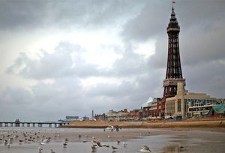
The 2.3 magnitude earthquake recorded in Blackpool in April is about 12 billion times smaller than the recent earthquake in Japan. Photograph: Getty Images.
The controversial new drilling operation for natural shale gas in Lancashire has been suspended following a second earthquake in the area that may have been triggered by the process. The earthquake last Friday near Blackpool occurred at the same time that the energy company Cuadrilla Resources was injecting fluids under high pressure deep underground to deliberately blast apart the gas-bearing rock — a process known as "fracking", brought to Britain from the US, where it has been highly contentious.
Earthquake experts from the British Geological Survey said that the 1.5 magnitude quake last week was similar to a 2.3 earthquake in April in the same area and that both may be linked to the experimental fracking for shale gas at Preese Hall on the Fylde coast.
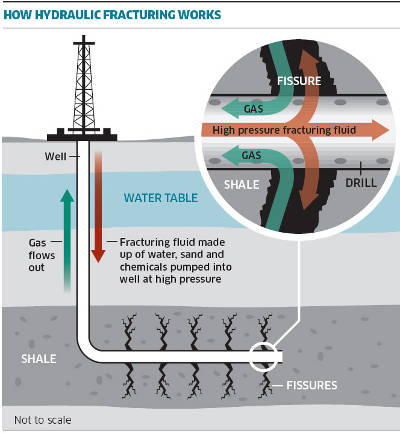
Bans on commercial fracking are already in place in France as well as in New York and Pennsylvania states, where people living close to fracking sites have been filmed setting fire to tap water contaminated with methane gas.
"It seems quite likely that they are related," said Brian Baptie of the British Geological Survey (BGS). "We had a couple of instruments close to the site and they show that both events were close to the site and at a shallow depth. The timing of these two events in conjunction with the ongoing fracking at the site suggests that they may be related." He added: "It is well-established that drilling like this can trigger small earthquakes."
The process involves pumping millions of gallons of water, mixed with rock-dissolving chemicals, into the earth to unsettle rocks and release the gas trapped there.
Cuadrilla said that it may be many weeks before it resumes fracking operations at its site near Blackpool because the incidents warrant further investigation with the help of outside experts.
"We've suspended drilling because there was an incident that the BGS recorded. We were aware of it because we have our own monitoring equipment on the site," said Paul Kelly of Cuadrilla last night. "We are now compiling a report with the BGS and Keele University. It was entirely our decision to suspend operations. We see it as an appropriate and responsible thing to do."
Dr Baptie of the British Geoplogical Society, said: "Our analysis places the epicentre of the [latest] event to within 2km of the Preese Hall site. Data from two temporary instruments close to the drill site, installed after the magnitude 2.3 earthquake on 1 April, indicate that the event occurred at a depth of approximately 2km. The recorded wave forms are very similar to those from the magnitude 2.3 event [in April], which suggests that the two events share a similar location and mechanism."
Neither of the earthquakes caused any structural damage, although they could be felt by people living near by because they occurred at a relatively shallow depth, Dr Baptie said. He pointed out that the earthquakes "are pretty insignificant even by UK standards" and "they don't usually cause any damage to property".
The 2.3 magnitude earthquake in April is about 12 billion times smaller than the recent earthquake in Japan that created a huge tsunami, and is roughly equivalent to exploding about a ton of TNT deep underground, Dr Baptie said.
A report last month by the Energy and Climate Change Committee of the House of Commons found that there was no evidence that the technique of fracking was unsafe. The committee's chairman, Tim Yeo, dismissed fears as "hot air", insisting there was no danger to underground drinking supplies — which he said was the chief cause of concern amongst critics. He said there was no case for a moratorium despite growing concerns overseas.
The BGS said about the previous Blackpool earthquake: "Any process that injects pressurised water into rocks at depth will cause the rock to fracture and possibly produce earthquakes. It is well known that injection of water or other fluids during oil extraction and geothermal engineering, such as shale gas, processes can result in earthquake activity. Typically, the earthquakes are too small to be felt; however, there are a number of examples of larger earthquakes occurring."
Beached Sperm whale in North East England dies
A 30ft whale that beached in north-east England has died.
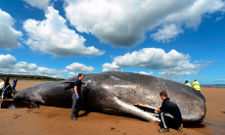
Photograph: Owen Humphreys/PA
Firefighters used their jet to spray the mammal which was reported alive but part-submerged on the beach at Redcar, Cleveland, at 6.10am on Tuesday.
A Cleveland fire brigade spokesman said shortly after 9am that the whale had died despite efforts to save it. A cordon had been set up around the stricken whale to stop people getting too close and causing it stress.
Cleveland police said a member of the public reported finding the 30-40ft sperm whale. and the force contacted experts to help rescue it. A police spokeswoman said: "On arrival the whale was still alive and partially submerged in seawater. Police contacted the coastguard, the local authority, the fire brigade, RSPCA and specialist marine animal welfare agencies. Police kept a cordon round the animal while they awaited colleagues from other organisations to arrive. Sadly, the whale was pronounced dead just after 9am. Arrangements for its disposal will be made by local authority environmental health officers and members of the public are asked to stay away from that area of the beach until this is complete."
Hundreds of onlookers turned out to take in the spectacle.
Carbon emissions "highest ever" in 2010
Greenhouse gas emissions increased by a record amount last year, to the highest carbon output in history, putting hopes of holding global warming to safe levels all but out of reach, according to unpublished estimates from the International Energy Agency (IEA).
The shock rise means the goal of preventing a temperature rise of more than 2 degrees Celsius — which scientists say is the threshold for potentially "dangerous climate change" — is likely to be just "a nice Utopia", according to Fatih Birol, chief economist of the IEA. It also shows the most serious global recession for 80 years has had only a minimal effect on emissions, contrary to some predictions.

Economic recession has failed to curb rising emissions, undermining hope of keeping global warming to safe levels. Photograph: Dave Reede/All Canada Photos/Corbis
Last year, a record 30.6 gigatonnes of carbon dioxide poured into the atmosphere, mainly from burning fossil fuel — a rise of 1.6Gt on 2009, according to estimates from the IEA regarded as the gold standard for emissions data.
"I am very worried. This is the worst news on emissions," Birol told the Guardian. "It is becoming extremely challenging to remain below 2 degrees. The prospect is getting bleaker. That is what the numbers say."
Professor Lord Stern of the London School of Economics, the author of the influential Stern Report into the economics of climate change for the Treasury in 2006, warned that if the pattern continued, the results would be dire. "These figures indicate that [emissions] are now close to being back on a 'business as usual' path. According to the [Intergovernmental Panel on Climate Change's] projections, such a path… would mean around a 50% chance of a rise in global average temperature of more than 4C by 2100," he said.
"Such warming would disrupt the lives and livelihoods of hundreds of millions of people across the planet, leading to widespread mass migration and conflict. That is a risk any sane person would seek to drastically reduce."
Birol said disaster could yet be averted, if governments heed the warning. "If we have bold, decisive and urgent action, very soon, we still have a chance of succeeding," he said.
The IEA has calculated that if the world is to escape the most damaging effects of global warming, annual energy-related emissions should be no more than 32Gt by 2020. If this year's emissions rise by as much as they did in 2010, that limit will be exceeded nine years ahead of schedule, making it all but impossible to hold warming to a manageable degree.
Emissions from energy fell slightly between 2008 and 2009, from 29.3Gt to 29Gt, due to the financial crisis. A small rise was predicted for 2010 as economies recovered, but the scale of the increase has shocked the IEA. "I was expecting a rebound, but not such a strong one," said Birol, who is widely regarded as one of the world's foremost experts on energy.
John Sauven, the executive director of Greenpeace UK, said time was running out. "This news should shock the world. Yet even now politicians in each of the great powers are eyeing up extraordinary and risky ways to extract the world's last remaining reserves of fossil fuels — even from under the melting ice of the Arctic. You don't put out a fire with gasoline. It will now be up to us to stop them.
Most of the rise — about three-quarters — has come from developing countries, as rapidly emerging economies have weathered the financial crisis and the recession that has gripped most of the developed world. But he added that, while the emissions data was bad enough news, there were other factors that made it even less likely that the world would meet its greenhouse gas targets.
About 80% of the power stations likely to be in use in 2020 are either already built or under construction, the IEA found. Most of these are fossil fuel power stations unlikely to be taken out of service early, so they will continue to pour out carbon — possibly into the mid-century. The emissions from these stations amount to about 11.2Gt, out of a total of 13.7Gt from the electricity sector. These "locked-in" emissions mean savings must be found elsewhere. "It means the room for manoeuvre is shrinking," warned Birol.
Another factor that suggests emissions will continue their climb is the crisis in the nuclear power industry. Following the tsunami damage at Fukushima, Japan and Germany have called a halt to their reactor programmes, and other countries are reconsidering nuclear power.
"People may not like nuclear, but it is one of the major technologies for generating electricity without carbon dioxide," said Birol. The gap left by scaling back the world's nuclear ambitions is unlikely to be filled entirely by renewable energy, meaning an increased reliance on fossil fuels.
Added to that, the United Nations-led negotiations on a new global treaty on climate change have stalled. "The significance of climate change in international policy debates is much less pronounced than it was a few years ago," said Birol. He urged governments to take action urgently. "This should be a wake-up call. A chance [of staying below 2 degrees] would be if we had a legally binding international agreement or major moves on clean energy technologies, energy efficiency and other technologies."
Governments are to meet in Bonn for the next round of the UN talks, but little progress is expected. Sir David King, former chief scientific adviser to the UK government, said the global emissions figures showed that the link between rising GDP and rising emissions had not been broken. "The only people who will be surprised by this are people who have not been reading the situation properly," he said. Forthcoming research led by Sir David will show the west has only managed to reduce emissions by relying on imports from countries such as China.
Another telling message from the IEA's estimates is the relatively small effect that the recession — the worst since the 1930s — had on emissions. Initially, the agency had hoped the resulting reduction in emissions could be maintained, helping to give the world a "breathing space" and set countries on a low-carbon path. The new estimates suggest that opportunity may have been missed.
The Irish consider whether to give Shell access to their offshore gas
The Observer, 29th May 2011, reports:
"If the sea is calm, you can hear the traffic in New York," goes the local introduction to the breathtaking beauty of Erris, in the north of County Mayo, where the coastline winds its way through little coves and beneath the cliffs of the wild seaboard at Europe's edge. Most nights, though, Manhattan must be quiet, for the only audible sounds are the distant baying of a dog several miles away, the soft bleating of newborn lambs from lush coastal meadows and the sighing of the brine as it moves across rocks and shingle.
Soon, however, this deep peace will be shattered forever. "And this is where it all began," says Willie Corduff, standing in his farmyard atop fields that tumble down to the estuary of Sruwaddacon. Corduff's family have farmed here for generations. "It's been hard," he says, "but we've made a living doing a little bit of everything, you know — a little suckling, a little silage, a little hay." Now that way of life stands to be destroyed, along with that of Corduff's neighbours, who fish the Atlantic waters as their forefathers have for centuries. Right across the estuary from Corduff's farm, where meadows and bog once came down to the sands, diggers now chug and churn the earth and security men strut behind the reinforced fencing in fluorescent "hi-viz" jackets. After dusk has fallen, what was once the pure darkness of night is pierced by floodlights. A mile behind this "exempted development" that needs no planning permission, a refinery has been built, heavily guarded, a gash across the land inflicted by lights, concrete, fencing and those ubiquitous fluorescent jackets. The Shell oil company has come to Erris — and how.
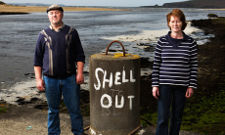
This land is our land: pipeline protesters Willie and Mary Corduff at the quay at Rossport. Photograph: Murdo MacLeod for the Observer
"It was a Scottish fellow came one morning," says Corduff. "And you know, it was the arrogance that triggered me off. There was no asking. He told me what was going to happen, taking me for a fool."
In 1996, a reserve of gas had been found 50 miles offshore by a consortium called Enterprise Energy Ireland and a major stake was bought by Shell in 2002. The plan has been to bring raw, untreated gas ashore by pipe, to the refinery at Ballinaboy, six miles south of the estuary. The pipe is to come ashore at Broadhaven Bay's widest and loveliest point, and was to skirt the estuary's northern shore, through farmland. "There's miles of empty bog out there," says John Monaghan, one of the leaders of the ensuing protest, "and they chose to take it across the farms. Where there are farms there are farmhouses, and where there are farmhouses there are families."
The arguments were made: successive government ministers insisted that what became known as the Corrib gas project would decrease Irish dependency on imported Scottish gas and provide up to 60% of Ireland's needs at peak periods. On the other side, there were immediate environmental concerns: Broadhaven Bay and nearby Carrowmore Lake are EU-designated Special Protection Areas; the lake, near the refinery, provides drinking water. There were concerns about potential explosions and the initial high pressure (345 bar) at which the gas would be piped ashore, and the fact that, as raw gas, it contained impurities, and would be corrosive. And there were issues of history and community.
Maura Harrington, a retired teacher in the village of Inver, who is one of the protest's most outspoken voices, says: "This is about a sense of place and its people. We may not qualify as indigenous people, but we have our land and culture, to which we belong. All those people who emigrated from Erris through history, Erris never left them. They say we are opposed to progress, and laugh at us. But to me, progress is the ability to sustain yourself, and those who come after you. It's nature and nurture: what we here call muinhin, which means of the place, and cointeann, which means to get a little awkward when that place and its people are about to be torn apart."
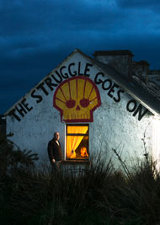
I'd be a fella who loved a quiet life': fisherman Pat O'Donnell with his daughter Aisling at Glenamoy. Photograph: Murdo MacLeod for the Observer
There had been a choice in Ireland about what to do with the "new frontier" — abundant natural gas off its western shores. There were two models: that of the Norwegians, who guaranteed a state-owned stake in exploitation and quota for domestic consumption, and that of British North Sea gas, where profits were largely spirited away by multinational companies. The Norwegian model was favoured by the Irish minister for industry and commerce during the 1970s, Justin Keating, who judged that Britain was wasting resources while Norway was securing its future. But the tide turned, as Keating's notions of state responsibility were swept aside by enthusiasm for the free market and Margaret Thatcher's handling of North Sea gas.
In 2000, Enterprise began digging holes for the pipeline through farmland in Rossport, and was granted planning permission by Mayo County Council for the refinery at Ballinaboy. The following year the Irish government awarded itself the right to statutorily acquire the private land it needed — the first consent orders issued by former minister Frank Fahey on election day in May 2002.
Enterprise, and later Shell, had courted Irish politicians — and the affair was reciprocated, with entertainment for oil executives in Fianna Fáil tents at Galway races — but everyone in the loop was dealt a blow when County Mayo's permission for the terminal was appealed to the national planning board, Bord Pleanála. The planning inspector, Kevin Moore, recommended refusal, concluding that: "From a strategic planning perspective, this is the wrong site. From the perspective of government policy which seeks to foster balanced regional development, this is the wrong site. From the perspective of minimising environmental impact, this is the wrong site; and consequently: from the perspective of sustainable development this is the wrong site."
Enterprise Oil was taken over by Shell soon after, and the minutes of a meeting of the company's managing directors laid out a plan for how to deal with Moore's objections. "The Committee", read the minutes, "queried whether the Group had sufficiently well-placed contacts with the Irish government and regulators" and "undertook to explore this issue further". In December 2003, Shell went back to Mayo Council and residents again appealed to the Bord Pleanála. This time a new director approved the plan.
Farmers across whose land the pipe was due to run were offered compensation. Some took it, but six owners of smallholdings along the route refused — one of them was Willie Corduff. In response, the Irish government passed, in 2005, the first ever legislation allowing a private corporation the same rights of compulsory purchase afforded to a state agency. Still Corduff and his fellow small farmers refused to admit Shell on to their land. "I think they thought they could break our spirit," he says. "I don't think they realised what kind of people they were dealing with. I think they thought we were farmers with 2,000 acres driving Jeeps, not people struggling on a little bit of bog, making it greener by the yard with a shovel." Corduff keeps his cloth cap on as we retreat to the kitchen of his farmhouse, where he explains how he became one of the first of many to go to jail.
In April 2005, Shell secured interlocutory orders against those refusing to let company agents on to their land. On 29th June, five people, including Corduff, were arrested and tried for contempt of the order, and jailed for 94 days. "When the judge said I was going to jail," says Corduff, "what little bit of hair that's upon my head was sticking up on end."
Corduff and his colleagues became known as the "Rossport Five", and the case of Shell's Corrib pipeline became a cause célèbre across Ireland. Now, the story of the uprising that followed has been made into a film, The Pipe, which is picking up worldwide awards, with queues around the block to watch screenings in Bucharest, Phoenix, Boston, San Francisco and New York — as well as Galway and London.
The director is Risteard O'Domhnaill, just past 30 years old, who at first covered the dispute as a news cameraman for the Irish-language television service and whose uncle farms sheep and cattle between Inver and the Erris coastline. He was appalled by the way in which many of his peers reported the story: "There was a culture of 'don't rock the boat' — the media had got caught up in the Celtic Tiger business, ready to round on anyone who criticised development, or deregulation — in this case, anyone who questioned what was happening to my uncle's community."

Security guards attempt to move an anti-Shell activist. Photograph: Murdo MacLeod for the Observer
The Pipe, says O'Domhnaill, "is Local Hero gone wrong" — it is also a vivid, close-range narrative of a battle unfolding, and a cruel parable of our times.
"People talk about us as though we want to be going back to the Stone Age," says Corduff. "But those people who farmed here with a donkey and cart and a bucket, they handed it on to their children. If this thing goes ahead, we won't be able to do that. They say we're standing in the way of progress, but what is it we're standing in the way of? We're standing in the way of the place being polluted and destroyed by Shell, that's what. They say we're enjoying ourselves with this protest. But we're not — it's a terrible sadness, the whole thing."
The imprisonment of the Rossport Five and nationwide demonstrations in support of them led to the formation of Shell To Sea. One of the most prominent figures in the protest alliance is Maura Harrington, who spent a month in jail for slapping a police officer in the face. On another occasion, she says: "I refused to pay a fine, went to jail for 13 days and saved myself €2,700." When a first attempt was made to lay the pipe at sea, Harrington went on hunger strike for 10 days.
"My mother was one of the few women for the time to have gone to the University of Galway, and my father was a trade union man, so he'd have been politically aware," she says, by way of introduction over a pub dinner in the homely Western Strands Hotel near Belmullet. "So I'd have been brought up this way… But in the end the cause of Shell To Sea is brutally simple: to oppose an assault on the air, the land, the sea and its people — and on the nation of Ireland. Shell tries to obfuscate things with environmental-impact statements and spin, but in the end it comes to this: will the traitors who govern this country allow such an assault to succeed, or will we stop it? Will raw gas come ashore to be refined and sold abroad to enrich a multinational corporation, or will it not? In a world of spin and virtuality, this is all very real — I don't want to sound all Marie Antoinette, but when you are living close to the land, air and sea, you are living in the real world."
Not everyone in the community opposed the project, as Shell and the Irish government point out. Father Kevin Hegarty of the neighbouring parish of Kilmore draws on a line from The Playboy of the Western World — set in these parts — to describe O'Domhnaill's film: "'It's a great story and he tells it lovely, but he doesn't tell the whole story. I'd say the majority of this community supports the project. It's a way to provide employment and an opening towards the development of sustainable fuels in Ireland." (Father Kevin's colleague Fr Michael Nallen, in Kilcommon itself, opposed the pipeline.)
There is argument over how many jobs the project would create: a spokeswoman for Shell, Denise Horan, says 450 people are currently employed, with "several hundred" more jobs to come with the building of the pipeline. "When the project is in operation, there will be approximately 130 full-time jobs," she says. There is also some debate as to how much the gas will benefit Ireland. Ms Horan says: "All the gas from the Corrib field will be consumed in Ireland," and that gas cannot be exported to the UK because the pipe runs one way; but O'Domhnaill insists that "there's no compulsion on them to serve Irish interests; in the end, they can sell it wherever they like, at whatever price they like — that's how it is with the multinational oil companies."
In June 2008, the Irish government gave Shell permission to begin laying its pipeline at sea and the biggest pipe-laying vessel in the world, the Solitaire, arrived to do so. The challenge to this colossus by a fisherman named Pat O'Donnell, his family and supporters, bobbing about on the ocean with the bows of the Solitaire towering above, makes for the most compelling and heart-breaking passage in O'Domhnaill's film.
The fishermen's battle against Shell begins heart-warmingly with O'Donnell saying to the camera: "Isn't it a lovely sight when you see all the fishermen together and fighting for the one thing?" But soon, it becomes a battle that turns fisherman against fisherman, as Shell offers money to those prepared to relinquish their fishing rights.
The scene climaxes with a remarkable piece of real-life action cinema as O'Donnell — in his little fishing boat, the John Michelle — and two other ships confront the immense Solitaire bow to bow. "I've a right to fish here," says O'Donnell of his lobster pots, but warships of the Irish navy arrive to ensure the Solitaire's way.
They call O'Donnell "The Chief" for miles around the lovely hamlet of Porturlin where he lives, and it is quite an honour to clamber aboard the John Michelle with him. "If I lived to be 100, I'd never sell this boat," says the Chief. "This is history, this boat.
"I was born in 1957," says Pat, "second youngest of 11 children. All my sisters emigrated to the United States at a young age, but we five boys stayed behind to fish, for the sea has been good to our family. I tried a while in London, in construction, but had to come back — I missed the sea; I'd known at a young age what I wanted to do for the rest of my life, and my oldest, Jonathan, was skipper of his own boat aged 15 — he's 26 now."
He continues: "I'd be a fella who loved a quiet life," but that aspiration ended after the fishermen's group he initially mobilised against Shell commissioned a scientist at Southampton University, Dr Alex Rogers, to survey the impact the pipeline would have on their livelihoods, the stocks at sea. Dr Rogers concluded pessimistically, and, says O'Donnell, "after all I'd read about Shell in Nigeria, who'd want them here as well?" He joined the protest movement blockading the contract workers' access to the refinery site.
"'People have the right to go to work,' we kept being told, but Pat O'Donnell and his son, who have the right to fish at sea under a ministerial licence were arrested for setting their pots," he fumes. "I'd never think I'd see the day when the Irish navy would turn its guns on Irish citizens fishing Irish waters, for the sake of a British and Dutch company."
O'Donnell served two jail sentences totalling seven months, only to watch most of the other members of his protest flotilla take Shell's silver, one by one. "One of them turned his boat into a portable toilet for men working on the jack-up rigs. How low can you get? What a way for a good fishing boat to be ending up, shifting shit for Shell!"
On 11th June 2009, O'Donnell claims his other boat, Iona Isle, was boarded off the western tip of Broadhaven Bay by "four masked men with guns, who went down below. All I could see was their eyes and their mouths. They came up some minutes later, vanished and I noticed the boat was water-heavy. I put out a Mayday call and had 20 minutes to get into my life craft. I wasn't right for a good while after, for it's a terrible thing for a fisherman to lose his boat in such an attack. I tried to get insurance, but the broker told me I wasn't covered for acts of terrorism." The police and the IRMS security firm contracted by Shell have both denied involvement in the sinking of the boat. Barrister Brian Barrington investigated the incident and that said as the boat was sunk at sea it was impossible to verify the claim.
On the shoreline at Glengad, above Broadhaven Bay's widest sweep, is the spot where the pipe hits landfall. Above this wild, wondrous foreshore is a standing stone circle. "It goes back to the first farmers on this land, and beyond," says O'Domhnaill as we clamber up the hill for a better view of the ocean sweep. This is where the pipe will come ashore, after which it will run overland beside the stone circle, beneath the estuary to Rossport, and journey overland to the refinery. It is here that Shell has been obliged to reduce the high pressure at which the gas will come ashore, but those who live here remain exposed to what they believe — despite Shell's assurances to the contrary — is the weakest joint, and most potentially dangerous point, in the process.
Above the site and just below the stone circle is the home of John Monaghan, who formed a group that split from Shell To Sea's absolute opposition, supporting instead a compromise route, proposed by local priests, across open, uninhabited bog at Glinsk, to the north. Its name was Pobal Chill Chomáin, People of Kilcommon. The rift is plain to see in O'Domhnaill's movie: the sad, inevitable, bad-tempered rupture of the vulnerable — neighbour pitched against neighbour — when faced by the giant.
Monaghan grew up in Nottingham, but "came back in the 1980s, to the family roots. And it's changed even since then. When I came back, they were still bringing in turf by horse and cart. Now, the Celtic Tiger has come and gone, and attitudes have changed — more selfishness, boom or bust. Bust, as it turned out. Shell is riding the tiger's back, the idea that greed is good, all development is good, end of story, no questions asked."
Corrib, says Monaghan, "is an entirely new approach — the 'sub-sea tie-back' system that brings in dirty gas and refines it ashore. And the idea of compulsory purchase orders by the private sector is also totally new. Also, I wonder if they've figured a worst-case scenario into their risk-assessment calculations, as I'd always do as a civil engineer. I was open to the idea at first, but we never got a glimpse of the reality. There's been zero accountability."
O'Domhnaill's film, as it reaches critical mass, becomes a vortex of images of how the pipeline's route has been forged: police officers and security men confronting protesters and their sympathisers at every turn.
"We keep being told 'the law must be upheld,'" says Monaghan. "But whose law? Shell's law. It might be called the law, but it's not justice. There is no way we can get justice. Even if there's a judicial review, we're liable for costs if we lose, and they'd break us. The law is that whoever has the money gets their way. Look at them! Navy warships patrolling, people coming up the beach from inflatables, moving through the village with video cameras filming us, police officers beating people up, Jeeps roaring around with number plates removed and no tax discs. And that's the law? If there's one thing I've learned from all this, it's that justice and the law are mutually exclusive."
"The Garda?" Corduff asks. "We put trust in them, used to have craic with them, our kids used to stay over at theirs. Now, if the children see a squad car or a paddy wagon, they'll be running off into the bog. That's a sad thing."
The fenced-in work beneath Monaghan's house is another "exempted development" without planning permission — which Shell argues is unnecessary anyway, as the pipe follows a route authorised at ministerial level. Even so, disruption to the family of Colm Henry, a few fields along from Monaghan, has been, he says, vulgar and extreme.
Henry is a soft-spoken man who plays country music in a band which tours Ireland and the UK. His walls are hung with Native American artefacts he brought back from visits to Arizona. "It's the most unspoilt stretch on the west coast," says his gracious wife Gabrielle, peeling potatoes. "There aren't even many tourists, and when they do find it, we ask them: 'Please don't tell anyone.'" "We used to go about our business in peace — we were left alone," says Henry, "and we would be using the beach in all weathers, swimming in summer and walking in winter."
When Shell's security dispatch invaded Glengad, they did so "with van loads of men", recalls Henry. "All night long there were heavy-duty lights directed at our home — even with the curtains drawn the house was illuminated. You had 50 cars and vans outside, floodlights and a cameraman sitting on the mound filming us in our house and on our own land."
The worst intrusions came, says Henry, "when they started filming the children walking on their own family land. My grandchildren went to play on the beach; they'd be changing to swim, when the security would be photographing them. Now I think that if I was to be filming children undressing on a beach, I might be ending up on the front page of a tabloid newspaper. But no — they can do what they wish, with impunity. Going around in balaclavas, no ID, they even have gloved hands, Jesus you can't even tell the colour of their skin — and they're very cosy with the Garda." When Henry tried to file a complaint at Belmullet police station, "the Super said he felt bad as a family man, like, but there was nothing he could do, it was out of his hands. When I made my statement about harassment, I didn't get so much as the courtesy of a reply from the Garda" — though he did secure back the pictures of his grandchildren changing clothes. "It makes me wonder: who are these people invading our lives and filming our children?"
Ms Horan of Shell said: "We reject the suggestions of heavy-handedness by the security company. IRMS is a reputable company. Their staff are trained to deal professionally with protesters and show them respect." She added: "The main reason we need to have security on this project is to allow our employees to go about their legitimate work and to protect our sites and our equipment." Staff had been "verbally abused, intimidated and prevented from entering their place of work. On one night alone, in 2009, €75,000 of damage was done." IRMS was not answering its telephone in County Kildare last week.
The question of official policing of the Corrib pipeline by the Garda made front-page headlines again last month, when tapes emerged of Garda officers joking about raping women protesters. Demonstrations culminated in one outside the Garda station at the Mayo County seat of Castlebar, home town of the new Taoiseach, Enda Kenny. One of the shamed officers had been transferred here, to a desk job. It was fitting that the demonstration was held in Castlebar, for it was here that Michael Davitt, the son of Mayo who inspired the protest movement, formed the Land League in 1879. Davitt mounted a highly effective campaign against big landowners, leading to the right of tenants to buy their land.
Erris is steeped, then, in the ravages and resistances of Irish history, so the protesters are even more aware than most Irishmen and women that the centenary of the 1916 Easter Rising is nigh. For them, the moment is charged with meaning. There is a heart-wrenching passage in O'Domhnaill's film when Pat O'Donnell, arrested, removes and furls the tricolour from the aft of his fishing boat. "The principles of the tricolour were wiped out when they did that to us," spits the Chief now. "People died for that flag and its principles, and if those men knew what was happening now, they'd be turning in their graves."
"I was in the third boat behind the Chief that day," says John Monaghan. "When he took down the tricolour, I felt it, too: they betray everything that was said in the proclamation of 1916, and the constitution. Then the guard puts his hand on the Chief's shoulder and says: 'I'm arresting you now, lad.' It's a seemingly kind gesture, but it's the kiss of Judas."
Mary Corduff, Willie's wife, laments that: "Everyone knew that a certain amount of money would split people, especially in a poor community." None of those who took money from Shell are willing to talk publicly. One man, who sold land for road widening, said simply, as we chatted in a Spar petrol station: "It's best if I'm not making a big thing of it all."
"People still talk to each other," continues Mary, "but it's not the same as before Shell came. All we do now is talk, sleep and eat Shell. You put up another Christmas tree, and all that has happened since you put up the last one is Shell, Shell, Shell. We haven't the life we used to, when between Christmas trees you'd hope to be getting in a bit of silage and have some hay drying."
John Monaghan looks back a couple of weeks to "a day when we were coming out of the depths of winter; the sun was shining through the window, the kids getting ready for school. It all looked so beautiful, the shore down there, the sea and a blue sky — but there they were: the Jeeps, the jackets, the cops, the navy, the choppers and diggers. This is deep stuff, it spoils the sunshine".
The Pipe and broadcast on More4 on 14th June 2011.
Ocean acidification is global warming's "equally evil twin"
The Observer, 29th May 2011, reports:
The infernal origins of Vulcano Island are easy to pinpoint. Step off the hydrofoil from Sicily and the rotten-egg smell of hydrogen sulphide strikes you immediately. Beside the quay, there are piles of yellow sulphurous rocks and chunks of pumice; the beach is made of thick, black volcanic sand; while the huge caldera that dominates the bay emits a constant stream of smoke and steam. According to legend, this was the lair of the Roman god of fire, Vulcan, who gave his name to the island and subsequently to all other volcanoes. An early eruption here also provided history with one of the first recorded descriptions of a volcano in action.
But Vulcano's importance today has nothing to do with the rock and lava it has spewed out for millennia. It is the volcano's output of invisible carbon dioxide — about 10 tonnes a day — that now interests scientists. They have found that the gas is bubbling through underground vents and is making the island's coastal waters more and more acidic. The consequences for sea life are grim with dozens of species having been eliminated.
That discovery is highly revealing, and worrying, because Vulcano's afflictions are being repeated today on a global scale, in every ocean on the planet — not from volcanic sources but from the industrial plants, power stations, cars and planes that are pumping out growing amounts of carbon dioxide and which are making our seas increasingly acidic. Millions of marine species are now threatened with extinction; fisheries face eradication; while reefs that protect coastal areas are starting to erode.
Ocean acidification is now one of the most worrying threats to the planet, say marine biologists. "Just as Vulcano is pumping carbon dioxide into the waters around it, humanity is pouring more and more carbon dioxide into the atmosphere," Dr Jason Hall-Spencer, a marine biologist at Plymouth University, told a conference on the island last week. Some of the billions of tonnes of carbon dioxide we emit each year lingers in the atmosphere and causes it to heat up, driving global warming. But about 30% of that gas is absorbed by the oceans where it turns to carbonic acid. It is beginning to kill off coral reefs and shellfish beds and threaten stocks of fish. Very little can live in water that gets too acidic."
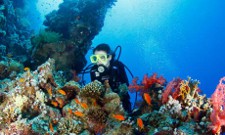
By the middle of the century there will probably be only a few pockets of coral left, in the North Sea and the Pacific. Millions of species of marine life will be wiped out. Photograph: Vladimir Levantovsky/Alamy
Hence science's renewed interest in Vulcano. Its carbon dioxide springs — which bubble up like burst water mains below the shallow seabed — provide researchers with a natural laboratory for testing the global impact of ocean acidification. "These vents and the carbonic acid they generate tell us a great deal about how carbon dioxide is going to affect the oceans and marine life this century," said Hall-Spencer. "And we should be worried. This problem is a train coming straight at us."
Scientists estimate that oceans absorb around a million tonnes of carbon dioxide every hour and our seas are 30% more acidic than they were last century. This increased acidity plays havoc with levels of calcium carbonate, which forms the shells and skeletons of many sea creatures, and also disrupts reproductive activity.
Among the warning signs recently noted have been the failures of commercial oyster and other shellfish beds on the Pacific coasts of the US and Canada. In addition, coral reefs — already bleached by rising global temperatures — have suffered calamitous disintegration in many regions. And at the poles and high latitudes, where the impact of ocean acidification is particularly serious, tiny shellfish called pteropods — the basic foodstuff of fish, whales and sea birds in those regions — have suffered noticeable drops in numbers. In each case, ocean acidification is thought to be involved.
The problem was recently highlighted by the head of the US National Oceanic and Atmospheric Administration, Dr Jane Lubchenco. She described ocean acidification as global warming's "equally evil twin". It is a powerful comparison, though it is clear that of the two, the crisis facing our seas has received far less attention. The last UN climate assessment report was more than 400 pages long but had only two pages on ocean acidification — mainly because studies of the phenomenon are less well advanced than meteorological and atmospheric research in general.
The workshop, held last week on Vulcano, is part of the campaign to understand the likely impact of ocean acidification. Dozens of young oceanographers, geologists and ecologists gathered for the meeting run by the Mediterranean Sea Acidification (MedSeA) programme. Dr Maoz Fine, of Bar-Ilan University in Israel, reported work on coral reef organisms that had been exposed to waters of different levels of acidity, temperature and light in his laboratory.
"We found that species of coral reef respond differently to rising carbon dioxide levels," he said. "Bigger corals suffer but survive while smaller, branching varieties become less able to fight disease and die off. That sort of thing just makes it even more difficult to predict exactly what is going to happen to our oceans."
Few scientists doubt that the impact on reefs will be anything short of devastating, however. The Caribbean has already lost about 80% of its coral reefs to bleaching caused by rising temperatures and by overfishing which removes species that normally aid coral growth. Acidification threatens to do the same for the rest of the world's coral reefs.
"By the middle of the century there will probably be only a few pockets — in the North Sea and the Pacific. Millions of species of fish, shellfish and micro-organisms will be wiped out," said Fine.
Acidification has affected the oceans in the past. However, these prehistoric events occurred at a far slower rate, said Dr Jerry Blackford of Plymouth Marine Laboratory. "The waters of the world take around 500 years to circulate the globe," he said. "If carbon dioxide was rising slowly, in terms of thousands of years, natural factors could then compensate. Sediments could buffer the carbonic acid, for example."
But levels of carbon dioxide are rising much faster today. By the end of the century, surface seawater will be 150% more acidic than it was in 1800. "There is simply not enough time for buffering to come into effect and lessen the impact," said Blackford. "The result will be significant acid build-up in the upper parts of the oceans which, of course, are the parts that are of greatest importance to humans."
A vision of the seas we are now creating can be seen at Vulcano. On the eastern side of its main bay, beyond an open-air thermal spa filled with elderly bathers wallowing in volcanically heated mud, there is a long stretch of black sand. Just offshore, in about four feet of water, silver beads of carbon dioxide stream up from stones that lie over an underground vent. The water, although cold, looks like a huge, frothing Jacuzzi. Water here is highly acidic and there is no marine life around the vent — not even seaweed.
"The acidity here is far greater than even the worst ocean scenario for 2100, so we have to be careful about making comparisons," said Dr Marco Milazzo, of Palermo University. "However, currents carry that acid water round the bay and it becomes more and more dilute. We can then study waters which reflect the kind of acidity we are likely to get at the end of the century."
Milazzo and his colleagues have placed open boxes containing coral and other forms of marine life in the waters round the bay and monitor the effects of the different levels of acidity in the sea water on these samples and also on the bay's natural marine life. "When I look one way, out to sea, where there is little acidity, the plant life is rich in reds, whites, greens and other colours. There is abundance and variety in the habitat," said Milazzo. "However, when I look the other way — back towards the carbon dioxide vent — that habitat gets less and less varied as the water gets more acidic. It is reduced to a dark brown bloom of macro-algae. There is no richness or variety here. In effect I am looking at the oceans of tomorrow. It is profoundly depressing."
Measuring Acidity in the Sea
Acidity is measured by its pH (power of hydrogen) value. Fresh water has a pH reading of 7. Readings below that are considered to be acidic. Those above 7 are alkaline. Surface sea water had a reading of 8.2 a century ago. Today it has dropped to 8.1 because so much carbon dioxide has been absorbed by the world's oceans. That may seem a small amount but the pH scale is logarithmic which means that 0.1 difference actually represents an increase in acidity of 30%. By the end of the century, the pH of surface sea water could have dropped to 7.8, which represents a decrease in alkalinity — or an increase in acidity, depending on your viewpoint — of around 150%.
461 out of 758 UK sea bathing waters are claimed to have met the top quality standard in 2010
Britain's beaches have had one of their best years in a quarter of a century of the Good Beach Guide, the Marine Conservation Society (MCS) has said.
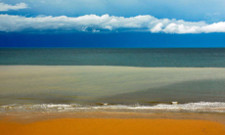
The beach at Sheringham in Norfolk, one of 461 given the top rating by the Good Beach Guide. Photograph: Brough Tomlinson/Alamy
Across the UK, 461 beaches were given the top recommended award for having excellent bathing water quality in the guide, the third highest number in the guide's 24-year history, and a significant increase on last year. Some 42 more bathing spots reached the top grade in 2011 than in 2010 [Note: 2011 grading is based on 2010 performance].
But 46 failed to meet even the basic standards of water quality set in European law 35 years ago, the MCS said, a slight increase on last year's figure of 41. And with stricter standards coming into force from 2015 — but being monitored from next year — the society raised concerns that almost double the number of beaches could fail in the future.
Blackpool's south and central beaches, St Andrews' east sands, the beach at Aberdyfi, Gwynedd, Wales, and Lyme Regis's church beach were among the coastal stretches which failed the current tests for water quality. But Bude's Summerleaze beach and Par, both in Cornwall, managed to turn around their fortunes, going from failing the standards last year to being recommended this year.
Other top quality beaches recommended by the Good Beach Guide include Polzeath and Newquay in Cornwall, Bognor Regis in West Sussex, Sheringham in Norfolk, Tenby in Pembrokeshire, Portobello central beach in Edinburgh, and Portrush in Antrim, Northern Ireland.
The MCS grades 758 beaches around the UK and the Channel Islands, with the cleanest spots given the recommended status. Beaches which meet the higher quality level under current EU rules are given the guideline grade, while those that reach the mandatory minimum levels required by the law are given a basic pass. Those that do not meet the standards are classed as failing.
Rachel Wyatt, MCS coastal pollution officer, said: "From 2015 Europe's beaches will be classified using even stricter water quality standards due to the revision of the Bathing Water Directive. "But instead of viewing these new standards with dread, our coastal communities and water companies should welcome them as an opportunity to attract more people to the UK's wonderful and varied seaside resorts."
She added: "The next few years are critical as the quality of the UK's bathing waters can play a vital rˆle in the economic recovery of our traditional seaside resorts. Making sure their local beaches are ready to comply with the revised Bathing Water Directive is a huge opportunity for local authorities and chambers of commerce to attract increasing numbers of tourists to the UK's coastline."
If the beaches consistently fail to meet the higher standards, the MCS said bathers heading to the sea could be faced with a sign advising them not to get in the water, which could damage local tourism. The MCS wants water companies and local authorities to work together to investigate and tackle water pollution, which can give swimmers stomach upsets or ear, nose and throat infections.
The society is particularly concerned about the amount of dilute sewage flowing into coastal waters from the UK's 22,000 combined sewer overflows, which act as emergency outlets for overloaded sewerage systems during periods of heavy rainfall, but which can discharge at other times as well.
Only a quarter of beaches are monitored to check how often they are putting untreated sewage into the sea, according to the MCS, which wants them all monitored and the public told if and when sewage is entering coastal waters.
The Environment Agency's head of bathing waters, Christine Tuckett said: "The results of the Good Beach Guide are underpinned by a record number of beaches in England and Wales reaching the highest European bathing water standards, as assessed by the Environment Agency, last year. Our bathing waters are at their cleanest for two decades, but more work needs to be done. Working with farmers, water companies and local authorities, we are continuing to drive improvements in water quality around our coasts."
MARINET observes: The claim that 461 out of 758 UK beaches met the top quality mandatory standard of the EU Bathing Water Directive, 76/160/EEC, in 2010 is essentially false. This is because in order to comply with this top EU standard the monitoring in 2010 should have sampled for the presence of salmonella and entero-viruses, and all samples throughout the 2010 season should have tested clear of any such contamination. However at no UK bathing site in 2010 was the bathing water tested for the presence of salmonella and entero-viruses. Thus compliance with the the EU's top quality mandatory standard was unknown, and not achieved as claimed. This is important because salmonella and entero-viruses are the real pathogens (i.e the bacteria and viruses which actually cause illness), and the nature of the risk can be viewed on the MARINET website at www.marinet.org.uk/ukbw/sewage.html.
It is also to be noted that a new sampling regime, based on EU standards, will take over from the current regime in 2015. It is claimed that this new EU quality regime will be stricter, and as a result less UK beaches will meet the best bathing water quality standards. However whilst the quality standard will be stricter in terms of the limit placed on the amount of indicator and faecal bacteria which may be present in individual samples (i.e. the scientific basis for the claim that the regime will be stricter), the sampling regime is being reduced from fortnightly to once a month (i.e. instead of 20 samples being taken throughout the season, only 4 samples will be taken). Thus diminution in the sampling regime is not good news. Further, if one of the 4 samples taken under this new regime should fail, it will be possible to claim that there were abnormal weather conditions at the time (e.g. resulting in storm sewage overflows) and a new sample can be taken at a later date in order to replace the failed sample. The failed sample can then be ignored and set aside.
In 2011 this new regime is being trialled alongside the established regime, so it will be interesting to see what the performance of this new regime — which is claimed to be more strict — actually reveals.
Yet another short-term fix
The following item comes from BBC News of 22nd May '11, under the heading 'Lincolnshire coastal sand-shifters start work'.
A £6m project to move sand on to Lincolnshire's beaches to help prevent flooding and coastal erosion is set to start. The "beach nourishment" campaign sees more than 141,000 tonnes of sand pumped from off-shore sites onto 20km (12.4 miles) of beach.
The scheme, carried out by the Environment Agency, protects 30,000 properties from the risk of flooding. Work is due to start at the end of May or beginning of June. The sand is moved using a specialised dredger.
Mike Dugher, Environment Agency area coastal manager, said: "Increasing the level of the beach reduces the risk of waves reaching the main defences and going over sea walls. "If the defences along the beach failed, there could be extensive damage to property and disruption to local communities." The scheme first started in 1994 and covers beaches from Mablethorpe to Skegness.
As MARINET has pointed out many times, the process may be likened to that of the monkey, who, desirous of growing a longer tail, eats his own tail to benefit from the protein so obtained. To dredge and so deepen the seabed to produce bigger more eroding waves, and to increase the beach slope to abet more gravitational draw down is hardly the way to maintain the defences.
New Government Documents on Flooding and Erosion Strategy
Secretary of State for Environment, Food and Rural Affairs, Mrs Caroline Spelman MP, announced in a written statement on 23rd May '11 that she was laying before Parliament a first 'National Flood and Coastal Erosion Risk Management Strategy for England' and statutory guidance on 'Co-operation and requesting information in flood and coastal erosion risk management'.
Both documents are being presented in accordance with section 7 of the Flood and Water Management Act 2010 and stem from Sir Michael Pitt's review of the widespread flooding in 2007. They are due to be issued on 18th July, unless either House resolves otherwise.
For full details go to the second item on the Parliamentary Website and be sure to read between the lines.
Paraffin Wax — the latest sea and shoreline pollutant

Clumps of paraffin wax are washing up on Suffolk and Norfolk beaches They may be from tankers moored off Lowestoft and Southwold
Since December 2010 increasing levels of clumps of paraffin wax have been washed up on Norfolk and Suffolk beaches, ranging from Happisburgh in North Norfolk right down to Southwold in Suffolk. The suspicion is that these emanate from the oil transfer operation. Whilst this is more of an aesthetic problem than a dangerous pollutant, the presence nevertheless evidences the continuing abuse of our seas.
The suspicion, unproven, is that these are most probably emanating from the fleet of oil tankers moored off the coast between Lowestoft and Southwold, as paraffin wax is used by tankers to seal or plug pipes. flush tanks and coat some hulls. It is thought that the oil transfer connections may be coated with this substance so as to prevent or limit the leakage of any oil into the sea and that this has broken away or been discarded after use.
The presence of this strewn along popular beaches has raised further reaction amid those already angered at permission having been given By Shipping Minister Mike Penning for the transfer of oil between vessels moored at Sole Bay, off Southwold in Suffolk, which people and visitors value as one of the most popular beaches in the UK. They feel it could threaten the livelihood of the area as a popular tourist destination.
UK Bathing Water Conformity
As the process of locating, calculating and recording the failure, pass or 'unknown' quality status of all the UK's designated seaside resorts against the 76/160/EC Bathing Waters Directive is highly demanding on time and hence so parasitic on our efforts to address other vital issues, MARINET is most unlikely to publish our own Good Beach Guide this year. After twenty years of campaigning to get the true compliance status recorded and attempting to revise the Directive to one not allowing escape clauses regarding the presence of the major pathogens, we are giving up the battle.
Yet we are fully aware that many of you plan a holiday or day out by the sea, and so visit our website in order to get a good idea as to where one could, should and should not enter the water. So here follows the convoluted route to be taken to locate the actual analysis as performed and published on the Environment Agency's web site, which is not an easy task, as the placing of these has changed many times over the years. This site at least tells you the bacterial concentrations, from which you may deduce the probable status.
Because of the EA's change of website address from that given in our Good Beach Guide at www.marinet.org.uk/ukbw/gbeachg.html, you may recall that on 17th May a memo was placed on our MARINET Reflector under 'Latest Bathing Water conformity' telling how the EA had changed the means of finding the detailed analysis of samples of the UK's Bathing Resorts since the previous year, so posing a problem to those wishing to judge compliance to the parameters in the 76/160/EC Bathing Waters Directive. To assist in finding the way through the maze and provide the new route, we wrote:
"Go to http://maps.environment-agency.gov.uk/wiyby/wiybyController?ep=maptopics&lang=_e and then click on 'Bathing Water Quality' to produce the large scale map of the UK. Next use the cursor keys on the map to shift the map so as to approximately centre map your resort of interest, then use the vertical + bar to zoom your map until you reach the scale of 1:125,00 or less, reshifting the location point up or down if necessary.
You will now see the resorts marked in coloured circles indicating the standard claimed to have been achieved with the year 2010 superimposed on them. (Note: You must have the map set to a scale of 1:125,00 or less, otherwise this will not be visible).
Click on the relative '2010', and all the past years will be indicated. Click on 2010 at the top of the column and then 'View Data' and the detailed findings for three of the five pathogen parameters in the 76/160/EC Bathing Waters Directive will be shown against the date the sample was taken"
Believe it or not, the very day after this was placed on our website, the EA changed the method of detecting the details yet again!
Whilst the first paragraph still holds true, the second should now say 2011 instead of 2010. The third paragraph should now read:
"You will now see the resorts marked in coloured circles indicating the standard claimed to have been achieved with the year 2011 superimposed on them. (Note: You must have the map set to a scale of 1:125,00 or less, otherwise this will not be visible). (e.g. a change from 2010 to 2011)".
Thus the fourth now becomes:
"Click on the relative '2011' and all the past years will be indicated. Click on 2010 at the top of the column and then 'View Data' and the detailed findings for three of the five pathogen parameters in the 76/160/EC Bathing Waters Directive will be shown against the years and date the samples were taken"
These results can now be compared for each resort, bearing in mind that the greater the coliform counts the greater the probability of the presence of Salmonella and Enteroviruses. For details please read the first page of our item at www.marinet.org.uk/ukbw/gbeachg.html
The bathing season commenced this month, so the May 2011 results are only the first to appear for now. The status for this year, 2011, is based upon the findings of the previous year, 2010. The detailed findings for only three of the five pathogen parameters in the 76/160/EC Bathing Waters Directive will be shown against the date the sample was taken. Yet again there is no mention of any tests for the presence of either of the other two mandatory pathogens, Salmonella or Enteroviruses, so the true conformity cannot be resolved.
New hope for threatened coastguard?
Having earlier stated that cuts of £210m were planned over the next 25 years resulting in the closure of most Coastguard Stations in the UK, nationally leaving only four manned 24 hours a day, on 24th May Shipping minister Mike Penning said in Parliament that proposals to axe the regional hubs will be amended in response to the serious anxieties and the resultant outcry expressed.
The Minister suggested that the final number of stations may now be nine or ten and insisted that no decision would be made until he had received the committee's report and the final decision was made pending the result of consultations currently taking place. However, it still appears that both the coastguard station at Walton-on-the-Naze in Essex and that at Great Yarmouth in Norfolk are among those facing a very uncertain future, these being just two of ten such centres around the country threatened with closure. At Great Yarmouth the thirty-six staff at Havenbridge House are apt to lose their jobs, as the responsibility for co-ordinating search-and-rescue efforts was to focused elsewhere. The Yarmouth station, which currently provides coverage from Haile Sand Fort in Lincolnshire to Southwold, was one of ten such centres around the country marked to be shelved as numbers were reduced from eighteen to eight.
With the increase of shipping with gas field, offshore turbine, dredging and oil tanker traffic, added to the destabilisation of the East Anglian coastline, to lose such a vital facility could have tragic consequences. It is to be hoped that common sense will prevail and that a re-think based upon knowledge and awareness will result.
Flood defence funding : now you can buy your own
Damian Carrington, The Guardian 24th May 2011, reports: "It's time to wade back into the troubled waters of flood and coastal defence funding in England, because the government [has] unveiled a new plan. Here's the headline from the Defra press release:
More flood and coastal defence schemes to go ahead under new funding system
"Sounds good right? As regular visitors will know, I have been angered by the glaring contradiction between ministers saying that the risk of flooding is rising due to climate change, and then cutting year-on-year funding by over 25%. Over 1000 schemes that were in line for funding no longer have it.
"Of the new arrangement, environment minister Richard Benyon said: 'This new funding system means more flood defence schemes will benefit from government money so we can protect more people and properties.' So the new funding system means more government money, you're thinking. You're wrong. There is no new money to alleviate the risks of floods devastating people's homes and businesses.
"The new scheme is in fact an opportunity for you to dip into your own pocket and help fund flood defence schemes. Businesses or developers who stand to benefit from the additional protection a flood defence will bring can also pay part of the cost.
"Now that's not necessarily a bad thing in some cases, if voluntary donations tip the balance so a marginal scheme goes ahead. But what does Charles Tucker, chair of the National Flood Forum and representing 200 community groups, think?
'I wish government press officers didn't always feel the need to "spin" the news! The fact is that more schemes will NOT go ahead under the new funding arrangements UNLESS local bodies come forward to "top up" the partial funding allocated centrally. Under the new scheme, each project will be allocated an indicative amount, which in most cases will be less than the cost of the scheme. This means the project CANNOT go ahead as it stands. Government expects councils, local businesses, utilities and local communities to make up the difference, leverage in other funds, or find ways to make the scheme cheaper. If they don't, the government money will be reallocated elsewhere! With less money available generally, what are the chances that local bodies will be able to find the "top-up" required? '
"Tucker also told me that the new funding scheme is being implemented for just one year (2011-12) because the "government knows this scheme has many unknowns and risks of unforeseen consequences."
"Uncertainty is a genuine fear for people who suffered the devastation of being flooded. 'Every time it rains, I start to panic,' one victim told me earlier this year. And uncertainty is the criticism of Labour's Mary Creagh, the shadow environment secretary. She told me: ' The Government's 'new' funding formula will not provide certainty for the hundreds of communities across the country whose schemes are currently on hold, and need certainty to get insurance.'
"So instead of rising funding to combat a rising threat, we have falling funding and a call for communities and others to fill the cash gap. Is that Big Society or a big con? You tell me."
Danish commandos protect Cairn Energy's Arctic exploration rigs
Armed Danish commandos are thought to have been landed on a giant oil rig by helicopter to prevent environmentalists interfering with a British oil company's controversial exploration of deep Arctic waters. In a stand-off in the Davis Strait, west of Greenland, the Danish navy has been shadowing the Greenpeace ship Esperanza as it tracked the 53,000 tonne Leiv Eiriksson in iceberg-strewn sea to the site where it plans to search for oil at depths of up to 5,000ft.
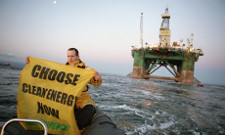
Greenpeace activists protest against Arctic oil exploration by the Leiv Eiriksson rig. Photograph: Markel Redondo/Greenpeace
The confrontation between Denmark and Greenpeace, which argues that it is dangerous to drill for oil in pristine Arctic waters, follows the decision by Scottish oil company Cairn Energy to explore for oil and gas in Baffin Sea this summer.
Fears that an Arctic spill would be difficult if not impossible to clean up were confirmed in an email exchange between the British Foreign Office and the energy secretary, Chris Huhne, that was obtained by Greenpeace under freedom of information legislation. Officials briefed Huhne, saying: "It is difficult to get assistance in case of pollution problems in such areas, and near impossible to make good damage caused."
They warned of "significant" environmental challenges and the potential for a Gulf of Mexico-type spill. "The impact of such a spill in the Arctic would be proportionately higher due to the lower temperatures and (in winter) lack of sunlight that will inhibit oil eating bacteria (which played a large rˆle in cleaning up the Macondo spill). The Arctic ecosystem is particularly vulnerable, and emergency responses would be slower and harder than the Gulf of Mexico due to the areas remoteness and the difficulty of operating in sub-zero temperatures. A situation compounded by response lag resulting from the vast distances between points of habitations and at certain times, winter ice."
Ruth Davis, chief policy adviser at Greenpeace UK said: "These documents make it clear that companies like Cairn are playing Russian roulette with one of the most important environments in the world. When even the UK government recognises the huge risks associated with the oil drilling in the Arctic then it must be time to halt the rush for oil in one of the most delicate ecosystems in the in the world."
Cairn says it has prepared comprehensive oil spill plans, and has put up a bond of $2bn. Last month it said in a statement: "Wherever it is active, Cairn seeks to operate in a safe and prudent manner. The Greenlandic Bureau of Minerals and Petroleum has established some of the most stringent operating regulations anywhere globally, which mirror those applied in the Norwegian North Sea. Cairn respects the rights of individuals and organisations to express their views in a safe manner."
Seven major oil companies have licenses to explore off Greenland but Cairn will be the only one to begin operations in the short July-October "summer window" when the ice has retreated. Cairn holds 11 licences covering over 80,000 square kilometres and plans to drill four exploratory wells to depths of around 5,000ft, the deepest ever attempted in the Arctic.
Fears that Greenpeace plan to prevent work have been heightened since the group occupied one of Cairn's drilling ships working in shallower Arctic waters last years, and 11 climbers also boarded the Leiv Eiriksson, when it left Turkey for Greenland last month. Greenpeace also tried to stop the rig as it passed Greece and Italy last month but was prevented by storms.
"We are in the Davis Straits doing 10 knots in big seas. There are icebergs everywhere. We're getting very close to where Cairn intends to drill.," said the Greenpeace campaigner Ben Ayliffe aboard the Esperanza.
Denmark is believed to have sent two warships to protect Cairn from Greenpeace, which in turn has sent two ships to monitor Cairn. Greenland is an autonomous country within the Kingdom of Denmark.
"Sociability" behind an explanation of beached Pilot whales in the Outer Hebrides
The distressed and distressing behaviour of the pilot whales threatening to beach themselves in South Uist reflects the remarkable and highly complex nature of cetacean sociability. Pilot whales, like the other toothed whales (odontocetes) of their sub-order — which includes sperm whales, killer whales and dolphins — form social groups, unlike baleen whales (mysticetes, such as the blue whale, the fin whale and the humpback), which generally travel alone or in mother-calf pairs.
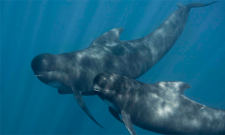
Pilot whales are no strangers to Scottish waters — but these ones were spotted off Gibraltar. Photograph: Andrew Sutton
Toothed whales may travel in massive pods of hundreds, even thousands; I've seen pilot whales in huge numbers in the Bay of Biscay, the Azores and Cape Cod. Between their two species (the long-finned and the short-finned pilot whale) they can be found in almost every ocean. The combined population may number more than 1.5m. They are nomadic, as opposed to migratory in habit (unlike the mysticetes), principally going where their food source takes them; these are deep-diving cetaceans, often feeding on squid at depths of 200-500 metres. They are also obviously highly successful — and part of that success must be due to their socialisation, held together by bonds we still do not completely understand.
We know that they communicate with each other continually. Dolphins have been proven to use signature whistles with which they announce their presence in the group. Sperm whales and pilot whales almost certainly use this method, too — unique in the animal kingdom. They focus these sounds through the bio-acoustical oil contained in their distinctively rounded heads, known as melons — in fact, enlarged noses. The necropsy on the first whale to die in South Uist indicated an infection in this area of the whale's anatomy, which might have caused its disorientation — and also caused its fellow whales to follow it into shallow waters. Such strandings are sadly common, and occur around the world — even in the river Thames, where a pod of 20 pilot whales appeared in 1965.
The scenes of the whales in Scotland show typical behaviour. They are moving together, dependent on one another as a cohesive whole, but are composed of smaller family units of 10 to 20 whales. Genetic methods and observation, by scientists such as Hal Whitehead, of Dalhousie University, Nova Scotia, have proved that these are basically matriarchal, but with males staying with their mother's group all their lives. As a result, these units are permanent and incredibly loyal. Hence the behaviour of the endangered whales in South Uist where the second whale to die was also a female. Photographs showing the whales raising their heads above water displays behaviour known as "spy-hopping" — they are literally looking up and around them. This may look cute but in this situation, where the animals are far too close to shore, it is a sign of near panic.
Pilot whales are no strangers to Scottish waters. In fact, it was the Orkney scientist, Thomas Traill, who first observed and scientifically named the pilot whale, Globicephala melas, in 1809, as a result of his first hand experience of the cetaceans — either alive, at sea, or stranded on Orcadian beaches. "This kind of dolphin sometimes appears in large herds off the Orkney, Shetland, and Faroe islands," noted Traill's friend and fellow scientist, William Scoresby. "The main body of the herd follows the leading whales, and from this property the animal is called in Shetland the ca'ing whale, and by Dr Traill the deductor."
It's because of their propensity to act in unison, following one another, that these whales — also known as "blackfish" — were hunted as they still are, controversially, in the Faroe Islands, by being driven into shallow bays and slaughtered. Humans have even adopted pilot whale behaviour for their own warlike ends. The warriors of the Ngati Kahungunu, a Maori iwi tribe, donned black cloaks and lay on the beach to lure an enemy iwi who would believe they were beached pilot whales and a source of ready food.
More benevolent encounters between pilot whales and humans have been witnessed off Gibraltar and the Canary Islands. Pilots are, like many cetaceans, highly inquisitive, and divers report the animals will often make physical contact. This is not always a good idea. A now-infamous YouTube clip shows a female diver being dragged down by a pilot whale and nearly drowning. Far from being a "vicious attack", however, this whale was probably only playing, displaying the sociability of its species, which has brought them into such dangerous straits off the Scottish coast.
MPs support shale gas exploration in the UK
There should be no moratorium on prospecting for shale gas in the UK despite concerns about its negative environmental impacts, a report from an influential group of MPs has advised.
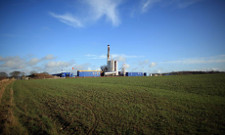
A shale gas drilling rig near Blackpool. Photograph: Christopher Furlong/Getty Images
The UK could have "considerable" shale gas resources, particularly offshore, said the energy and climate change select committee, and should exploit these to reduce reliance on energy imports.
But the MPs acknowledged that exploiting shale gas could be environmentally damaging and could spell severe problems for the renewables industry, which is facing a lobbying onslaught from gas industry representatives seeking to position their fuel as "green" because it produces less carbon than coal.
Tim Yeo, the Tory MP and former minister who chairs the committee, said: "Shale gas could encourage more countries to switch from coal to gas, which in some cases could halve power station emissions. But if it has a downward effect on gas prices it could divert much needed investment away from lower carbon technologies like solar, wind, wave or tidal power."
France recently agreed a moratorium on new shale gas projects, and similar steps have been taken in several US states, after widespread reports of shale gas wells leading to contamination and dangers to home owners.
However, the MPs dismayed green campaigners by dismissing evidence that shale gas exploration can be dangerous and damaging to the environment. Drilling for shale gas requires blasting the dense underground rocks in which the gas is found with vast quantities of water mixed with chemicals. In the US, the pioneer of shale exploration, communities have had their water supply polluted with methane, meaning that in some places the water can be set on fire.
Keith Allott, head of climate change at WWF-UK, said: "Concerns about water contamination and the greenhouse gas footprint of shale gas are serious and deserve to be thoroughly investigated." He cited US research that found more than 1,000 cases of contamination from gas drilling, and a recent study that found shale gas had a bigger greenhouse gas footprint than coal.
There is likely to be much less shale gas in the UK than in the US, with most of the recoverable supplies believed to be in the Bowland Shale, near Blackpool. Cuadrilla Resources, a UK-based company drawing on US expertise, has so far drilled two exploratory wells in the area, with some local opposition.
The MPs said there was only a risk of water contamination when the walls of the gas wells were not sufficiently well made, leading to cracks or other failures. "There is no evidence that hydraulic fracturing poses any risk to underground water aquifers provided the well casing is intact before the process commences," they said.
They called on the Environment Agency to monitor the chemicals used in the process, which in the US have included benzene and lead, and for the Department of Energy and Climate Change (Decc) to "monitor closely the current exploratory activity in the Bowland Shale in order to both assess the likely impact of large scale shale gas extraction in the UK and also to promote public confidence in the regulation of this activity".
The MPs also warned against branding shale gas as low-carbon, and as a "transition fuel" that could be used for the next decade before the widespread move to renewables is complete. "Although gas emissions are less than coal, they are still higher than renewables," the committee concluded. "Shale gas has the potential to shift the balance in the energy markets that Decc has tried to create away from low carbon electricity generation. The UK needs to manage this risk if its aim is to increase the proportion of the UK's energy from renewable sources."
Craig Bennett, the policy and campaigns director at Friends of the Earth, said: "Instead of seeing shale gas as a miracle fix, the government should focus on developing the clean, safe energy alternatives at our fingertips like solar power and wind."
Allott added: "Shale gas is a dangerous distraction from the urgent need for us to tackle climate change. Chasing after risky and hard-to-get fossil fuels like shale gas, tar sands or drilling for oil in the Arctic may seriously undermine the move towards renewables as the only effective and sustainable solution to our energy challenges."
London fashion designers support the "stop over-fishing" campaign
When Lady Gaga wore a crystal-encrusted lobster hat last year, crustacean chic was seen as the height of fashion frivolity. Now, thanks to a new exhibition, ocean-inspired designs have been unexpectedly invested with serious meaning.

Lady Gaga wearing her Lobster hat last year. The hat will be part of an exhibition to raise awareness about overfishing. Photograph: Copetti/Photofab/MCP/Rex Features
The Washed Up exhibition uses marine-inspired vintage and haute couture designs to highlight the potentially disastrous impact of overfishing in the world's oceans. The installation forms part of Project Ocean, a five-week programme of events at Selfridges in London. The department store is working with the Zoological Society of London (ZSL) to raise awareness of the plight of marine life.
Judith Clark, curator of Washed Up, is more used to working in traditional museum settings such as the V&A and believes the exhibition's focus is unique. Alongside the surrealist Lady Gaga lobster hat — designed by the milliner Philip Treacy — sit 26 sea-themed exhibits. The earliest dates from the 1870s and the newest has been commissioned for the show.
One highlight is a dress featuring watery prints by the late Alexander McQueen from his last 2010 collection, entitled Plato's Atlantis. A dress by the avant garde designer Hussein Chalayan, which is formed of clear bubbles and resembles giant fish eggs or underwater oxygen air bubbles, is surrounded by dead coral seized from illegal smugglers by customs officers. It is usually in storage at London Zoo rather than in Selfridges' Wonder Room.
Among the exhibits is a 1930s-style wig commissioned by the curator. Entitled Pearl Waves, the faux-jazz-age skull cap recalls froth-edged waves.
"I wanted a narrative that went beyond dresses designed with fish prints," said Clark. She said the exhibition's inspiration was the drawings of Ernst Haeckel, the 19th-century biologist and illustrator who coined the term ecology. A lot of what the conceptual designers are referring to in their work is the ocean under the microscope, rather than just fish," said Clark. Each of the exhibition's nine thematic sections is concerned with making the invisible visible, she added.
The Project Ocean campaign is the brainchild of Alannah Weston, the creative director of Selfridges, whose family owns the chain of department stores. In addition to the ZSL, the initiative is backed by the Marine Conservation Society, Greenpeace and WWF. In total 22 environmental NGOs and high-profile activists from creative industries are taking part.
Selfridges calls the programme "retail activism", as it is intended not only to entertain and raise awareness but also to raise money. Jonathan Baille, director of ZSL and co-curator of the event, hopes to "sell" the campaign to the store's 40,000 daily customers. The worst-case environmental predictions are that the world's major fisheries will collapse by 2050, Baille said, and so the bottom line must be that the project "measurably leads to more fish in the sea".
CPRE and NT demand 'Seascape' protection
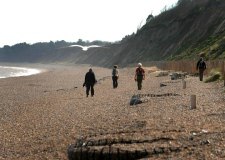
Dunwich Beach, part of the Suffolk Coast and heaths AONB
The Campaign for the Protection of Rural England (CPRE) together with the National Trust (NT) want the Government to take action to carry out assessments of the character of seascapes and to identify areas that are of national importance and to introduce a mechanism by which they can be protected. They note that it is more than sixty years since special land areas were given protection by the formation of national parks and areas of outstanding natural beauty (AONB) designations, and thus it is about time the seas surrounding them were treated the same. At this time almost all of Suffolk's coastline falls into the Suffolk Coast and Heaths AONB but the protection that provides ends at the water's edge.
The CPRE and NT say that special "seascapes", such as Dunwich on the Suffolk coast, should be given the same kind of protection as the nation's treasured landscapes, and that they have fears that seascapes around the UK, made up of coastal and inshore sea areas, could be even more damaged over time by developments such as renewable energy installations, oil extraction, dredging for aggregates, more shipping and increasing port development unless steps are taken to protect them.
Talking to the media, Phil Dyke, coast and marine adviser at the National Trust, said that seascapes which could be protected from development included Suffolk's AONB.
"As an island nation it does seem strange that it's taken us more than six decades to start thinking about how we protect our seascapes, these wonderful yet fragile places that mean so much to people. In Suffolk and Norfolk we have AONBs that are protected landscapes that are recognised as 'jewels in the crown' and the argument is that the special qualities of the Suffolk Coast and Heaths AONB are derived from the combination of the landscape and the seascape. It's the combination of the two that makes it such a special experience but what we don't have is the means to recognise the importance of the seascape and offer it some sort of protection."
In April the MMO given powers under the Marine and Coastal Access Act 2009, created its first marine planning area, which stretches from Felixstowe all the way up to Flamborough Head in East Yorkshire. The Head of Marine Planning at the MMO, Steve Brooker said:
"This is an important milestone for the future of our seas, as marine planning formally begins. These plans will help the MMO and others to take decisions about development of the marine area, which will include protection of the marine environment and benefits for coastal communities"
Linda Clapham, a spokeswoman for the Suffolk Preservation Society, the county's branch of the CPRE, said a robust marine planning system would be welcomed by coastal communities, saying:
The environment is always losing out to other things. It's important that there is a proper planning framework in place so that we know where the boundaries are."
Vestas ready to invest in North Sea wind turbine production
The world's biggest wind turbine manufacturer is offering to create over 2,000 jobs at the Kent port of Sheerness but warned the green energy project could be killed off by any uncertainty over government policies.
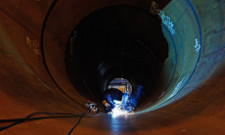
Vestas says the offer of 2,000 new UK jobs depends on energy policy. Photograph: Jeff J Mitchell/Getty Images
Vestas has obtained exclusive rights to land — the equivalent to 93 football pitches — that would enable it to construct a huge new production facility to build a generation of mega-turbines to be used in the North Sea.
"Before our customers can provide us with the needed order pipeline, they need stability in the market and a long-term political and regulatory certainty that ensures their business case," said Anders Soe-Jensen, president of Vestas Offshore. "Making that happen lies in the hands of policy makers, so we are looking forward to seeing the UK government providing the best possible terms for the offshore wind market to truly take off and the potential jobs becoming a reality," he added.
The Vestas executive said the timing of a report from the government-established climate change committee which raised questions about the high cost of offshore wind "could not be worse for us." Soe-Jensen warned it would be a "shame" if a great new job opportunity at Sheerness was lost. But he remained optimistic that Vestas could obtain the orders from the deep sea "Round 3" projects that would allow the Danish-based company to build vast new turbines that would be as tall as the "Gherkin" office block in the City of London.
Vestas has also built a new research and development centre on the Isle of Wight but created controversy when it closed a facility for building smaller turbines in the summer of 2009.
The renewable energy sector worldwide has been facing tougher times as politicians worry about wider budget cutbacks and seek to reduce subsidies to wind and solar despite a continuing desire to cut carbon emissions and tackle global warming. But there was a boost from Japan where the prime minister promised to scrap a plan to obtain half of its electricity from nuclear power and said it would promote renewable energy as a result of its nuclear crisis.
Naoto Kan said Japan needed to "start from scratch" on its long-term energy policy after the Fukushima Daiichi nuclear power plant was heavily damaged by an 11th March earthquake and began leaking radiation.
A United Nations report out earlier has recently predicted that if the regulatory and other conditions were right renewables could provide 80% of all the world's energy needs after 2050.
Innovative Marine Power projects in Scotland win DECC support
The Government /DECC announced on 10th May they had submitted 12 UK projects to the European Investment Bank (EIB) for consideration in the next round of the EU's New Entrant Reserve (NER) scheme. Four of the five marine renewables projects are in Scotland, the fifth off Blyth, Northumberland. The other 7 projects are forms of CCS. Only 3 projects of all 12 projects can win NER funds.
The five marine power projects are:
- POWER (Pentland Orkney Wave Energy Resource) which will deploy Aquamarine Oyster and Pelamis wave energy converters off the coast of the Orkneys;
- Kyle Rhea Tidal Turbine Array which will deploy Marine Current Turbines "SeaGen" devices in Kyle Rhea, Islay;
- MeyGen Tidal Stream Project which will deploy Atlantis Resources and Rolls Royce/Tidal Generation tidal turbines in the Pentland Firth Inner Sound;
- Scottish Power Renewables Sound of Islay Demonstration Tidal Array which will deploy Hammerfest Strom tidal turbines in the Sound of Islay; and
- Blyth Britannia which will deploy Clipper Wind Power 10 MW Offshore Wind Turbines off Blyth in Northumberland.
Australian Report mirrors UK failings in properly assessing marine aggregate dredging
The Australian Government's Commonwealth Scientific and Industrial Research Organisation (CSIRO, www.csiro.au) has produced a report which considers whether Australia should embrace offshore aggregate (sand and gravel) extraction from the seabed.
MARINET explained to CSIRO that if they were to recommend marine aggregate dredging to the Australian Government, they should bear in mind the following points from the UK experience:
- Many of the Environmental Impact Assessments (EIAs) in the UK are deficient, both in terms of their assessment of the impact on the marine environment and in terms of the impact on the coastline. When these deficiencies are drawn to the attention of the consultant little results from this process, and when these deficiencies are drawn to the attention of the licensing authority (central government) they are ignored. There is no independent auditing of the EIA and its findings.
- The environmental consultancy employed by the applicant, whilst working to professional procedures, is often heavily dependent on the licence applicant (marine aggregate company) for its own livelihood i.e. it is evident that if the environmental consultancy produces an EIA which is unfavourable to the applicant, then that consultancy obtains no further EIA contracts and may be forced out of business.
- There is a need for the EIA process to be conducted by an environmental agency/consultancy which is wholly independent of any relationship with the applicant. The system that operates at present does not provide this independence. Nor is there any auditing of the EIAs by an independent party. In theory, the licensing authority is the independent party. However the licensing authority (central government) has a policy which says that marine aggregate extraction is to be encouraged, and central government receives the revenue arising from the licence - to be precise, the seabed is owned by the Crown Estate to whom the licence holder pays a licence fee and the Crown Estate remits this revenue to the central government exchequer. In other words, central government, like the environmental consultancy, has a pecuniary interest in the determination of the licence.
- A key factor is the evaluation of the long-term impact of aggregate extraction on the marine ecosystem and the coastline. In other words: does the marine ecosystem, which is inevitably damaged during extraction, recover? And, if so, to what degree, and is there evidence of coastal erosion in the years after the extraction licence has expired? Evaluation by the licence holder of long-term impact is generally written into the terms of the licence, and the purpose of this is to assemble scientific evidence on the impact of marine aggregate extraction - in short, to use old licences to inform the determination of new licence applications. However, these long-term studies are rarely undertaken in an effective way by the licence holder following the cessation of the licence, and there is no enforcement of this matter by the licensing authority.
- MARINET believes that all the sea, the entire area, should be placed in a default position where it has total protection from all extractive human activities, including fishing. Then, when a human activity wishes to operate in specific areas, it needs a licence which will only be issued if it can be shown that the activity will not damage the integrity of the marine ecosystem.
This is the "ecosystem-based approach to marine management", and ensures that we can restore health back to a severely damaged marine ecosystem in the NE Atlantic, see www.marinet.org.uk/eatmm/definition.pdf.
For example, 88% of commercial fish stocks in the EU's seas of the NE Atlantic are currently being overfished due to trawling and modern technological aids (EU data) and this, in turn, is extensively damaging the structure of the ecosystem on the sea bed, and similar excesses in fishing are evident worldwide. Aggregate dredging sites are located on areas of alluvial sand and gravel deposited by rivers during the last Ice Age and, as such, these areas are rich habitats for marine life and for the spawning and nursery grounds of fish. Aggregate dredging is therefore located on physical habitats which are unique, non-renewable, and of especial value to marine biodiversity.
To access the complete MARINET submission to CSIRO, visit www.marinet.org.uk/mad.html#csiro.
New base mapping of the North Sea
A consortium of CEFAS led scientists used state of the art techniques deployed from the research vessel 'Cefas Endeavour' to study a 3,300 km2 site stretching from the North Norfolk coast to Walberswick in Suffolk. The comprehensive survey was commissioned in an attempt to better understand the habitats and archaeological features lying on the seabed off East Anglia at this time when intensive offshore aggregate dredging and other potential impacts are expanding and MARINET's concern at the lack of responsible monitoring is growing.
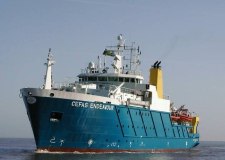
The research vessel Cefas Endeavour spent almost three years out at sea
Following combining their finds with existing data, the researchers have produced a report containing a series of maps detailing everything from tidal patterns and water temperature to the shape and biodiversity of our waters, and have characterised environmentally important features such as sub-tidal reefs, gravel deposits, bedrock outcrops and shifting sandbanks.
Among the findings were Palaeolithic artefacts, including hand axes, cores and flakes, peat and wood fragments that indicate human habitation during the Mesolithic (8500 BC to 4000 BC) period, scattered remnants of second world war aircraft and the wreck of the HMS Exmoor which sank south of Great Yarmouth on 25th February 1941, plus the scattered remnants of second world war aircraft. The team also encountered some unusual species of animal. A surprise was the discovery of twenty-two rare Mantis Shrimps (Rissoides desmaresti) found at five different sites in the north and the south, but only in offshore areas at water depths of between 32 and 48 metres. These are normally only found on the south and Welsh coasts of the UK. The researchers also noted the presence of grey seals, minke whales and harbour porpoises amongst the more common mammals.
Dr Siân Limpenny, the project manager, said:
"There is increasing demand on marine space and resources, due to the expansion of maritime industries and because of newer developments such as wind farms. The east coast region is also likely to be the focus for the increasing demand for marine aggregates in the future, to support large-scale infrastructure projects and coastal defence programmes. That's why these maps are so helpful. They underpin statutory marine plans, required under the Marine and Coastal Access Act, which help decision-makers to ensure the sustainable management of offshore resources now and into the future. For instance, sensitive habitats might be safeguarded, whilst other areas may be identified as commercially important fishing grounds or deemed to be ideal for marine construction or for energy supply. A wide range of commercial operators and developers, who need to plan their own specific activities, could also find the maps essential tools to support their investment decisions."
Shell and Cairn Energy announce plans to drill in the Arctic
A new battle between environmentalists and Big Oil over drilling in the Arctic is likely to be triggered by Shell unveiling "risky" plans for the Beaufort Sea while a Cairn Energy rig has set sail for Greenland.
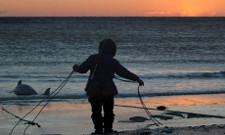
The Inupiat people — who have 'lived off the Arctic waters for thousands of years' — are threatened by Shell's plans, says the Alaska Wilderness League. Photograph: Laurent Dick/AP
Shell, Europe's largest oil group, has submitted plans to the US government for permission to drill 10 exploration wells in the Beaufort and Chukchi seas off the north coast of Alaska in 2012 and 2013.
Previous plans to start this summer were halted first by the moratorium imposed after the Deepwater Horizon disaster last April and then by a ruling from the Environmental Protection Agency. But Shell said it was now confident that it could offer regulators the reassurances that should enable it to proceed with a programme said to have cost it $2bn to lease the acreage and possibly an additional $4bn in planning.
"Shell was one of the original offshore explorers in Alaska," said a spokesman at the company's head office in The Hague. "As in years past, Shell remains committed to employing world-class technology and experience to ensure a safe, environmentally responsible Arctic exploration programme in 2012 — one that has the smallest possible footprint and no negative impact on traditional substance-hunting activities of the people of the North Slope."
Cairn meanwhile has given the green light to the drill ship, Ocean Rig Corcovado, to leave Aberdeen heading for Nuuk. It is also bringing a separate drilling rig, Leiv Eriksson, through the Mediterranean en route for the far north. Greenpeace has already boarded the rig off the coast of Turkey in protest at the Greenland drilling plans and said it remained totally opposed to what both Cairn and Shell plan to do in the Arctic region.
"The high north is becoming the front line of the global environmental battleground," said Ben Ayliffe, senior oil campaigner at Greenpeace. "Shell is gambling with the fragile Alaskan environment a year after the Deepwater Horizon spill, lining up to start dangerous drilling in one of the world's most pristine natural habitats despite the terrible risks of a spill there. As climate change causes the sea ice to retreat, oil companies are rushing in to extract the fossil fuels that caused the melt in the first place. It's madness — you don't put out a fire with gasoline. Instead of drilling in the Arctic, we should be extracting oil from the car industry by driving up the efficiency of their vehicles and forcing them to use new clean technologies."
The Alaska Wilderness League also condemned Shell, saying it was relying on "the same failed technology" used in BP's devastating spill 12 months ago off the coast of Louisiana, yet the drilling conditions were far worse and the marine environment rich but less understood. "Despite the risk of a spill that could eclipse the devastation in the Gulf of Mexico, Shell's proposed scope for 2012 and 2013 is more risky and aggressive than ever," said Cindy Shogan, the league's executive director. "The [Inupiat] people who have thrived off the Arctic waters for thousands of years and those who treasure the Arctic's unique wildlife will continue to demand that the Obama administration not allow Shell to move forward."
The northerly region has become a new frontier for exploration since global warming caused ice to melt, oil escalated in value to its current $114 a barrel and the US Geological Survey concluded that almost a quarter of the world's undiscovered oil and gas reserves may lie in the Arctic.
Cairn created excitement last summer when it reported it had found indications of hydrocarbons with a well off Greenland, while BP has signalled its interest by signing up for a controversial deal to explore in the far north of Siberia with Russian group Rosneft. This scheme is being challenged by another of its partners inside TNK-BP. The region has seen wider industrial, political and military interest over the last two years.
UK marine energy industry could be worth £76 billion and 68,000 jobs
A government think-tank has predicted that the British marine energy sector could be worth £76bn to the economy and support 68,000 jobs by 2050. The analysis by the Carbon Trust comes only weeks after coalition ministers ended the industry's subsidy programme.
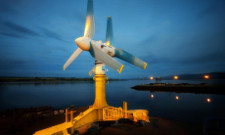
A tidal turbine developed by Atlantis Resources Corporation is unveiled at Invergordon, on the Cromarty Firth. The UK is home to about 35 of the world's 120-130 wave and tidal energy developers. Photograph: Mike Brookes Roper/PA
Britain could capture almost a quarter of the global wave and tidal power market if it builds on its existing lead, the trust forecast. The majority of the jobs would be a result of the growing export markets in countries such as Chile, Korea and the US as well as Atlantic-facing European states which benefit from powerful waves or tidal currents. The study, the most in-depth of its kind, found that total marine energy capacity could be 27.5 gigawatts in the UK by 2050, enough to supply more than a fifth of current electricity demand.
But the Carbon Trust says new wave and tidal technologies need to be accelerate at a time when the government's £42m marine renewable deployment fund has been eliminated and the most ambitious marine project — the 10-mile long Severn Barrage — has been given the thumbs down by the energy secretary, Chris Huhne.
However, some smaller schemes have been given the go-ahead, such as one in the Sound of Islay between Islay and Jura in western Scotland. Britain is still said to be home to about 35 of the world's 120-130 wave energy and tidal stream device developers. "Marine energy could be a major 'made in Britain' success," said Benj Sykes, director of innovations at the Carbon Trust. "By cementing our early mover advantage, the UK could develop a significant export market, generate thousands of jobs and meet our own demand for clean, home-grown electricity. To maintain our world-leading position, we must continue to drive innovation within the industry and turn our competitive advantage in constructing and operating marine technology into sustained green growth."
Innovative British companies such as Pelamis, Aquamarine Power and Marine Current Turbines are among those active in UK waters. Almost half of Europe's wave resources and more than a quarter of its tidal energy resources are to be found off the British coastline.
Supermarkets challenged on their fish labelling information
Supermarkets are failing ethical consumers by offering "poor and confusing" labelling for sustainable fish, a conservation charity has warned. The Marine Conservation Society (MCS) says retailers should be doing more to help the environment and boost dwindling fish stocks by helping shoppers to make the right choices.
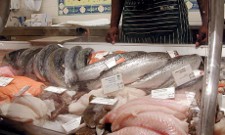
Fish labelling in supermarkets does not help consumers to make sustainable choices, says the Marine Conservation Society. Photograph: Alex Segre/Rex Features
On Thursday the charity is launching its most comprehensive seafood advice to date to help consumers, industry, chefs and retailers make the right decision when it comes to buying seafood. Its Pocket Good Fish Guide has also been updated to include a credit card-sized guide to purchasing fish, with top buying tips and questions to ask at the fish counter when labelling is not sufficiently informative. It includes a traffic light-style green list of fish to eat, a red list of those to avoid and an amber list of fish to eat only occasionally.
But MCS aquaculture and fisheries programme manager, Peter Duncan, said much labelling remained vague and confusing: "The use of a traffic light [labelling] system to indicate the nutritional value of supermarket produce is now well-established. However, sadly, the labelling of fish and fish products sold in supermarkets has not kept up. It is still virtually impossible to tell precisely where most fish and fish products have been caught."
Sue Davies, head of policy at the consumer organisation Which? said: "Which? research has also highlighted how confusing it can be to make sure you're buying sustainably sourced fish, and there's a lot of confusion about existing labelling schemes. It is important to move to a consistent, independently certified scheme."
EU legislation dictates that retailers must display the common name of the species being sold, its method of production (farmed or wild-caught) and the area of production (the specified fisheries area, eg north-east Atlantic, for wild caught fish, and country of final development for farmed fish). But the MCS believes the area of production needs to be more specific, as there are a huge number of different fisheries, with varying sustainability credentials in an area as large as the north-east Atlantic.
Channel 4's "Fish Fight" campaign earlier this year — led by food writer Hugh Fearnley-Whittingstall — highlighted the issue of sustainability, prompting a significant increase in sales of "alternative" species of fish and seafood at the end of January.
Supermarkets said consumers were favouring coley, dab, mussels, squid and sardines over the staple salmon, cod and tuna as a result of the series, which exposed the wasteful use of "discard" in fishing practices while encouraging shoppers to take the pressure off popular fish stocks by being more adventurous in what they eat. Despite this spike in sales, it is not yet clear whether it is likely to be a sustained trend.
Fish to eat (green list) compiled by the Marine Conservation Society
- Atlantic salmon (organic farmed)
- Coley or saithe
- Herring
- Mackerel
- Skipjack tuna
Fish to avoid (red list) compiled by the Marine Conservation Society
- Shark
- Skate
- Eel
- Marlin
- Bluefin tuna
Wild Atlantic salmon under severe threat
An epic traveller and spectacular high-jumper, the Atlantic salmon is one of Europe's most enduring creatures. For thousands of years they have roamed free across the Atlantic Ocean and spawned in the rivers and streams that flow out into the North Atlantic. Yet this remarkable animal — given the regal nickname of the "king of fish" — faces an uncertain future.
Over the past 40 years overall European stocks of Atlantic salmon have experienced a multi-decadal decline from around eight million in the early 1970s to around three million today, resulting in the lowest population levels observed since regular monitoring began in the 1970s. While stock levels in a handful of individual rivers (eg, the Tyne) have increased in recent years, due to intense and localised conservation efforts, Atlantic salmon populations in general are contracting.
Decades of freshwater pollution, habitat destruction, rampant over-fishing and reckless marine salmon farming have taken their toll.
An increasing body of evidence shows that rising sea surface temperatures and a corresponding decline in survival of salmon at sea may pose the most serious threat yet to this once abundant species. During the industrial revolution water quality in many rivers hit an historic low. Choked by sewage and severe industrial pollution, Atlantic salmon became locally extinct in rivers where they had previously flourished, such as the Rhine and the Thames. Water quality has since greatly improved and there has been some cause for celebration as salmon have recolonised some industrialised rivers. However, populations are a fraction of what they once were and salmon remain locally extinct in many of Europe's rivers. More recent freshwater issues continue to have a damaging impact. Problems range from acid rain and excessive water removal to chemical spills, agricultural pollution and siltation. Impassable barriers to migration, such as dams and weirs, are a problem, too, as they prevent adults from reaching headwater streams and good spawning habitat.
Atlantic salmon have also suffered in the marine environment. In the 1950s it was discovered that salmon from rivers in the USA, Canada and Europe, congregated in large numbers off the coast of Greenland and the Faroe Isles. A lucrative, commercial fishing operation sprang into action and unbridled over-fishing, peaking in the 70s and 80s, dealt a hammer-blow to the species.
Thousands of miles of drift-nets and long-lines were strung across migratory passages and vast shoals, destined for rivers all over Europe, were massacred. Annual catches initially soared, but then plummeted from four million to just 700,000 between 1979 and 1990. This intense and unsustainable over-fishing threatened the salmon with extinction across much of its range, prompting Icelandic angler and businessman, Orri Vigfússon, to found the North Atlantic Salmon Fund (NASF) in 1989 — an international coalition of conservation groups that work together to restore stocks of wild Atlantic salmon to their historic abundance.
Having raised in excess of £17.5 million, NASF has successfully "retired" scores of drift-net licences in the North Atlantic, significantly boosting wild stocks. Vigfússon's goal is clear: "My objective is to restore the abundance of wild salmon that formerly existed on both sides of the North Atlantic. This can only be achieved by safeguarding the fish at sea." Unsustainable drift-net fishing is still prevalent in many parts of Europe, including here in the UK, and NASF and other organisations continue to work tirelessly to keep the industry at bay.
Since the 1970s the overall catches of Atlantic salmon in the North Atlantic have decreased by as much as 80 per cent. Management measures taken to regulate the exploitation of wild stocks have dramatically reduced catches, and played a vital rˆle in the conservation, but they have not stemmed the overall decline observed throughout their geographic range. There are many possible explanations for the continued decline, a key one of which is the impact salmon farming has on wild stocks.
There is little doubt, apart from within those groups who benefit from the industry, that salmon farming has had a disastrous impact on wild stocks, and continues to do so. Over the past 30 years, this unsustainable, environmentally damaging and poorly regulated industry has significantly contributed to the contraction of wild populations.
Salmon farms are frequently overrun by diseases and parasite outbreaks and high densities of penned salmon seriously pollute the surrounding environment. The parasitic sea louse is particularly harmful, reaching plague proportions around salmon farms and latching on to juvenile wild salmon as they pass farm cages on their seaward migration. Sea lice feed on the mucus, tissue and blood of their host, compromising their immune system and causing secondary infection which can have fatal consequences. A staggering number of salmon escape the cages. Despite pressure from conservation groups to improve the containment, around two million escape into the Atlantic every year and up to 40 per cent of all free-swimming salmon, in some areas of the North Atlantic, are thought to be escaped farmed fish. Escapees spread diseases and interbreed with wild stocks, diluting their genetic integrity.
Given all this, it is extraordinary that Scotland's First Minister Alex Salmond recently signed a trade deal with China that will see a substantial increase in Scottish salmon farming over the coming years. He was widely quoted in the media as saying: "Even if 1 per cent of the people of China decide to eat Scottish salmon, then we'll have to double production in Scotland."
While feeding the world, securing jobs and developing the economy is rightly high on every government agenda, there can be no doubt that this trade deal will have a serious knock-on effect, at a time when we should be doing everything we can to aid wild stocks. Are we to infer that the Scottish Government has given up on wild salmon?
Producing 1kg of farmed salmon requires 3kg of feed, generated from species of other wild fish. This is unsustainable and makes little sense when 80 per cent of the world's fish stocks are already severely depleted. A positive solution would be to develop more sustainable methods of aquaculture, such as rearing species that feed on primary producers like shellfish and herbivorous fish. The great irony is that farmed salmon is marketed using the iconic image of a leaping wild salmon, yet each sale of farmed salmon indirectly erodes wild stocks. The words of American ecologist Aldo Leopold spring to mind: "Harmony with land [and the natural world] is like harmony with a friend; you cannot cherish his right hand and chop off his left." Although salmon farming has had a negative impact on wild stocks, it is fair to say that other marine factors have also contributed to the decline of wild salmon. It is widely accepted that marine survival of adult salmon has fallen by more than 50 per cent over the past 30 years. There are numerous explanations for the decline, including continued over-exploitation of wild stocks at sea, the negative impact of farming and industrial over-fishing at the base of the marine food chain. It is highly likely that a combination of factors is to blame, but an increasing amount of research suggests rising sea surface temperatures may be playing a decisive rˆle.
Over the past three decades there has been widespread sea surface warming in the North East Atlantic, including in key foraging areas exploited by Atlantic salmon. Marine scientists have found a strong correlation between rising sea surface temperature and the observed reduction in marine survival of Atlantic salmon. Research also shows that growth condition of adult salmon has fallen as sea surface temperature has risen, and there is a strong link between growth of juvenile salmon in their first year and survival at sea.
Atlantic salmon are opportunist predators that feed on a range of prey, including crustaceans and various species of fish, at the ocean surface. Scientists fear that rising sea surface temperature may be limiting food availability by redistributing zooplankton and restructuring the North Atlantic ecosystem.
There is also some evidence that ocean warming may influence the migratory routes and the extent to which they are killed by predators. Research continues in this area, but if marine survival continues to drop away, Atlantic salmon could face localised extinction in river systems, with those in southern Europe expected to be worst affected.
Many organisations have contributed to conservation efforts, but more needs to be done and fast. Governments throughout Europe urgently need to work harder to further improve the freshwater environment, halt the continued exploitation, increase regulation of salmon farming, and curb carbon emissions before it is too late.
Wild Atlantic salmon are of great economic importance, but they are also one of Europe's most celebrated creatures. They need to be conserved not just for economic gain, but for their value to the natural world. Those people lucky enough to have laid eyes on a wild Atlantic salmon leaping high into a foaming waterfall will know that the world will not be the same without the king of fish.
Author: Robert MacDougall-Davis is a biologist and writer specialising in fish ecology.
Sustainable Seafood Coalition seeks to find a retail market for discards
Some of Britain's top seafood companies and retailers have joined forces in a new seafood coalition to keep up the pressure on the EU discards policy, which they want to see scrapped.
The companies include Waitrose, Marks & Spencer, Morrisons, The Co-operative, on the retail side and Birds Eye, the Icelandic Group (which owns Coldwater, Seachill and the Saucy Fish Company in the UK.), Young's Seafood Limited (and parent company Findus Group) and Fish4ever. They are the first members of the newly formed Sustainable Seafood Coalition (SSC). The initiative also has the backing of food writer and TV chef Hugh Fearnley-Whittingstall, who took the lead in January with his Fish Fight television series.
SSC members, brought together by environmental law organisation ClientEarth, are frustrated with lack of progress overturning the unacceptable practice of discarding (throwing dead fish back into the sea) and collecting adequate data needed to manage fish stocks in order to help the UK's seafood market become more sustainable.
The campaigners said that most people in the UK eat only five types of fish (usually cod, haddock, plaice, salmon and one of the prime species like halibut). There's practically no market for half the species discarded, although the Fish Fight campaign has renewed interest in some of these, according to one or two supermarkets. The SSC members say they do not want to wait for legislative reform on these issues, so they have voluntarily decided to sell seafood that is currently underutilised or discarded and to encourage consumers to eat a wider variety of sustainable seafood.
Additionally, they will ask their source fisheries to collect catch and discard information aiding government to assess the state of these stocks; to implement measures that will help protect these stocks (where management measures do not already exist); and to agree labelling standards to provide consumers with accurate information on sustainability.
James Thornton, ClientEarth CEO, said: "The crises facing UK and EU fisheries are ever-present and worsening. The legislative tools move slower than the problems escalate and we cannot afford to wait. This is why members of the Sustainable Seafood Coalition are taking matters into their own hands. It is heartening to see industry organisations taking a lead."
Hugh Fearnley-Whittingstall, whose recent Fish Fight campaign and TV series highlighted the problem of discarding fish on a huge scale in the North Sea, said: "If we're going to sort out the discards disgrace, everyone in the business of selling fish needs to play their part. FishFight helped to amplify a clear message from ordinary people that they want to eat more sustainable fish. The Sustainable Seafood Coalition is about giving more people access to sustainable fish and I'm proud to be involved." Hugh also confirmed that The River Cottage Canteen restaurants would be one of the first restaurant groups to join the scheme."
Nigel Edwards, Sustainability Director of Icelandic Group, said: "As a leading brand (Saucy Fish Co) we are keen to ensure that our customers have access to responsibly sourced fish, as they trust us to do the right thing by actively engaging in making fisheries and fish farming more sustainable. Knowing that products are sourced responsibly is increasingly important to consumers of seafood."
EU unveils plans to pay fishermen to catch plastic
Fishermen will be paid to catch plastic, rather than fish, under bold new plans from the EU's fisheries chief, aimed at providing fleets with an alternative source of income to reduce pressure on dwindling fish stocks.
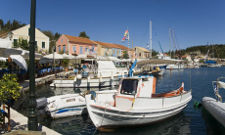
Fishing boats in Fiskardo, Greece. A trial project in the Mediterranean this month will see fishermen equipped with nets to catch plastic rather than fish. Photograph: R H Productions/Getty Images/Robert Harding World Imagery
Maria Damanaki, commissioner for fisheries, will unveil a trial project in the Mediterranean this month, which will see fishermen equipped with nets to round up the plastic detritus that is threatening marine life, and send it for recycling. The move is intended as a sweetener to fishermen who have bitterly opposed the European commission's plans to ban the wasteful practice of discarding edible fish at sea. Fleets fear they will lose money by not being able to throw away lower-value catch.
Damanaki vowed yesterday to press on with her plan to eliminate discards, citing the strength of public opinion on the issue, whipped up in large part by the Fish Fight campaign waged by the food writer Hugh Fearnley-Whittingstall. Two-thirds of the fish caught in some areas is thrown back, usually dead, because fleets exceed their quota, unintentionally catch juveniles or species for which they lack a quota, or because they prioritise higher value fish and throw away lesser species. About 1 million tonnes are thrown back each year in the North Sea alone.
"Ending this practice of throwing away edible fish is in the interest of fishermen, and consumers," Damanaki told the Guardian in an interview. "It has to happen — we cannot have consumers afraid to eat fish because they hate this problem of discards." But she acknowledged: "People [in the fishing industry] feel insecure, because this is a change. That is why they need incentives."
Fishermen who clear plastic will be subsidised initially by EU member states, but in future the scheme could turn into a self-sustaining profitable enterprise, as fleets cash in on the increasing value of recycled plastics. Cleaning up the rubbish will also improve the prospects for fish, sea birds and other marine species, which frequently choke or suffer internal damage from ingesting small pieces of non-biodegradable packaging.
In a boost to Scottish fishermen, Damanaki also said she was seeking a legal instrument that would allow the EU to ban imports of fish products — such as fish oils and fish meal — from countries that did not meet high sustainability standards. This would help to level the playing field, she said, between EU and non-EU fleets. It would also deprive Iceland of a significant export market, and cheer Scottish fleets who have complained that Icelandic fishermen have too high a quota of mackerel, putting huge pressure on the shared stock.
This month, Damanaki will also seek to tackle a growing source of conflict with developing countries over fishing rights. At present, several EU fishing fleets take large amounts of their catch from the seas around Africa and the Indian Ocean. They are able to do so because of secretive agreements on fishing rights, struck with developing country governments. As a result of these, campaigners complain that the EU boats are depriving fishermen in poor countries of their potential catch, and stifling the growth of indigenous fishing industries that could boost developing economies.
On 13th May, Damanaki will hold the first meeting of ministers from developing countries aimed at redrawing these controversial fishing access plans. She said: "There needs to be more transparency. We have to recognise that people have the right to establish their own control mechanisms on their own industry. We have to co-operate to find a way to deal with the problem of overfishing." But the scale of the opposition Damanaki will face to her key proposals on discards has been on display at a hearing in Brussels when fishing representatives attacked the measures. One said: "The consequence of this will be a much, much smaller fleet." Another said it was not possible to end discarding completely.
An alternative being touted by some member states is to make the phasing out of discards voluntary. But Damanaki rejected this outright, saying it would be no different from the current situation. "We have been talking about discards for more than a decade. Now we need radical reform. Time is running out," she said.
Damanaki has the support of several key member states, including UK, Germany, France and Denmark. She will publish her formal proposals in July, for debate by the European parliament and council.
MARINET observes: Plastic is a huge problem in our seas, leading to the widespread death of marine life which ingests the plastic or becomes entangled in it — see our publication The Ocean Planet. Therefore as fishermen lay up their nets and need alternative income whilst fish stocks are rebuilt, fishing for plastic is a good move. However an equally important alternative income for fishermen (using EU money) lies with the monitoring and recording of data at sea about the size and rate of recovery of fish stocks. In other words, re-employing fishermen as hands-on managers whilst the stocks are re-built and superintended against illegal fishing. Fishermen have the expertise and knowledge to perform this vital rˆle of management, and the forthcoming reform of the CFP should see fishermen in this light and employ them in this new rˆle. Fishermen would thus be actively involved in rebuilding fish stocks, and their own future.
Fishing industry expresses concern to the EU about the proposal to end discards
Proposals to end the wasteful practice of throwing away edible fish have met strong opposition from the European fishing industry.
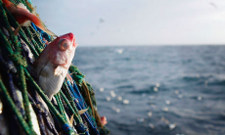
The EU has proposed a ban on the controversial practice of 'discarding' surplus fish back into the sea. Photograph: Christopher Furlong/Getty Images
The plan to ban "discards" was brought forward by the EU fisheries commissioner, Maria Damanaki, earlier this year. She wants a ban — which she says is necessary to preserve fish stocks — within two years, as part of a wide-ranging reform of the European common fisheries policy. But at a hearing in Brussels held by Damanaki and attended by fishermen's representatives, green groups and consumer groups, some members of the fishing industry vehemently opposed the plans, while others suggested the proposals should be modified.
Millions of tonnes of edible fish are caught and then thrown away at sea in Europe for several reasons: some, because they are of low commercial value, but others are discarded because the fishermen do not have a quota for that species, or because if the fishermen landed them, they would exceed their allotted EU quotas.
Damanaki said: "I know that there are many here today who follow the discussion on discarding with some mistrust. Some among you think and have said so that the commission is showing a knee-jerk reaction to media hype in the UK when we say that we need to tackle this problem of discards once and for all."
But she told the meeting that ending discards was necessary if fishing fleets in Europe were to have a future. She said: "We don't have time [to delay]. Our stocks are in a difficult position. The great majority of our fishermen, specially the coastal fishermen are complaining that there is no fish in the sea. We are also faced with a strong public opinion of consumers… [and] it is also about good old common sense. If we are hauling up fish, it mostly dies in the process and throwing it back doesn't help anybody. It is actually worse than landing it."
She credited the UK "Fish Fight" campaign, headed by the celebrity chef Hugh Fearnley-Whittingstall, as a key factor in persuading the commission of the need to eliminate discards.
Fearnley-Whittingstall, also present at the hearing, commended the commissioner's plans and said throwing away up to 50% of the catch was "unsustainable".
But fishermen are concerned that they will lose money as a result of a ban, mainly because they will be forced to land lower value fish for which there is little consumer demand. One told the meeting: "The consequence of this will be a much, much smaller fleet." Another said it was simply not possible to end discarding completely.
Mike Parker, chief executive of the Scottish White Fish Producer's Association, said: "Dictatorial practices [from the European commission] will not work." Jon Harman, of pan-industry body Seafish UK, added that the EU must not be "prescriptive".
Sections of the fishing industry and some member states have come up with an alternative proposal that would water down the commission's plans. Under this alternative, discards would not be banned outright but would rely on fishermen signing up voluntarily.
But conservationists attacked the alternative proposal. Greenpeace said that if it was adopted, fishermen who discarded the most would in fact be rewarded, by receiving a higher catch quota, and countries that signed up to the scheme would have their existing national quotas increased by as much as 12%.
Saskia Richartz, Greenpeace EU oceans policy director, said: "The practice of discarding dead or dying fish is disgraceful. We must stop throwing away perfectly good fish. All fish that are caught should be landed and counted under scientifically based quotas. It is ridiculous to reward the fishermen that discard the most with a higher catch quota unless there is an effort to shift towards more selective fishing methods. Unbelievably, destructive bottom trawlers with high levels of discards would get more out of this scheme than fishermen using sustainable fishing methods."
MARINET observes: The practice of discards is wholly unacceptable, and should be eliminated by requiring all fish caught to be landed. Unmarketable landed fish can be converted to fish protein for fish farms and, if necessary, can command a guaranteed minimum price by means of EU subsidy. However, the issue of discards threatens to divert attention from the most fundamental issue which is that nearly all commercial fish stocks in EU seas are being overfished, and nearly one-third of these stocks are now facing commercial extinction (EU data). The urgent need therefore is the adoption of management policies which will rebuild these fish stocks and, most importantly, rebuild these stocks to historic levels and not just seek to preserve them at their current, depleted levels due to over-fishing. Only if we restore fish stocks to historic levels can we guaranteed a future for fishermen and their industry and, equally importantly, provide the citizens of Europe with "food security" derived from fish and our seas. These are the real, long-term priorities of CFP Reform.
Seal cull deaths blamed on salmon fish-farms
Animal rights campaigners have accused the Scottish Government of sanctioning the slaughter of almost 1300 seals under new legislation designed to protect fish stocks.
Activists claim it has failed to force firms to comply with aspects of the law, which permits seals to be shot at some of the near-300 salmon farms in Scotland as a last resort to avoid damage to supplies bound for supermarkets and shops. They claim it is sentencing some pups to starve to death if their parents are killed because shooting is permitted through the breeding season.
The Seal Protection Action Group said the law, which makes clear that seals can only be slaughtered if all other methods of controlling them fail, is being abused, and is considering a legal challenge to the Government's application of the law. In total, 65 licences have been granted since the Marine (Scotland) Act came into force last week, allowing the deaths of 1298 seals.
Spokesman Andy Ottoway said it "beggared belief" that the multimillion-pound industry could not keep predators away from salmon without shooting them. He said: "Forty years ago we stuck a man on the moon, so surely we can find a way of keeping seals out of fish farms. If it was whales or dolphins it would be banned overnight."
The Scottish Government said it has strict enforcement rules for the issuing of licences. However, 66 applications have already been granted including one for a yet-to-be-completed fish farm. Campaigners argue that shooting should be a last resort, only reached where non-lethal methods have been exhausted. In a publication covering its seal-shooting policy, the Scottish Government states that not all licencees are using these measures. "The majority of seal licence applicants are either using or have investigated the use of non-lethal measures," it states.
A Scottish Government spokesman added: "Marine Scotland assess all fish farms before granting a licence to ensure that non-lethal measures, as appropriate to that site, are being taken. These include tensioned and predator nets, acoustic deterrents and seal blinds." The Government notes that, in many cases, "the measures used… appear to have proved unsatisfactory in that they have not entirely eliminated the risk of seal predation".
Campaigners called on the Government to phase out shooting licences to give the industry a "mandate to come up with measures to stop the killing of seals".
Fears have also been expressed about the potential impact on tourism. Marine biologist David Ainsley, owner of the Sealife Adventures attraction in Oban, Argyll, said that farms shoot seals "not as a last resort but simply because killing is the cheapest solution".
Caroline Warburton, of Wild Scotland, which represents more than 90 outdoor tourism firms, said: "The wildlife tourism sector in Scotland has grown significantly over the last 10 years and many coastal and marine tourism operators include seals as part of their trips or promotions. A number of our members have voiced concerns about the shooting of seals in their area and should seal numbers drop significantly Wild Scotland is concerned that livelihoods would be affected."
Scottish Green Party co-convenor Eleanor Scott said the party had worked in the last parliament to ban "this outdated and brutal licence regime". She added: "The scale of this killing spree is a surprise even to us. The fish farming industry could just install double nets to protect their fish, but it appears it's cheaper for them just to reach for the gun, even in the breeding season." Labour and the Liberal Democrats said there were circumstances where seals could reasonably be killed as a last resort, but only if they posed a serious threat.
Government, industry and charity bodies are now working to improve non-lethal measures to protect against seals. Mr Ottoway said he was speaking to the animal protection bodies, the SSPCA, Freedom Foods, Sainsbury's, which uses significant amounts of Scottish salmon, and Marine Harvest, the country's largest salmon farmer.
Plastic found in the stomachs of Scampi, causing a concern about "poisonous food contamination"
The majority of the scampi caught in one of Britain's busiest fishing grounds were found to have harmful plastic lodged in their stomachs, scientists have claimed.
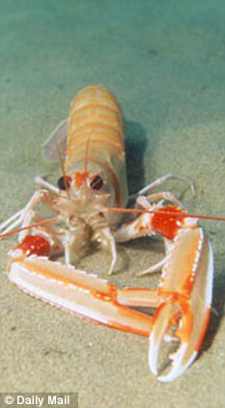
Plastic from fishing nets was found in the stomachs of scampi
Millions of the crustaceans are landed each year before they find their way to dining tables around the country. But a study by two leading universities has found that tightly wrapped balls of potentially harmful plastic left in the water from fisherman are damaging the scampi.
Campaigners have now called for urgent action to tackle the pollution that has been found in the Clyde estuary in Scotland, a major fishing sport for scampi in the UK.
Trawlers based at British ports catch an estimated 40,000 tonnes of scampi, also known as langoustines or Dublin Bay Prawns, each year.
Researchers from the University of London's marine biological station at Cumbrae and a team from the University of Aberdeen embarked on the study. The scientists found plastic inside the bodies of 100 out of 120 langoustines examined in the spring of 2009. The figure accounts for four fifth of the langoustines that are caught in the estuary.
The plastic came from a variety of sources including polythene bags and waste thrown overboard from yachts. But in the majority of cases the pollution had come from fisherman using 'chafers', knots of non-biodegradable plastic designed to stop nets from dragging along the seabed.
Fisherman switched in the 1960s from using ropes made from biodegradable materials to synthetic plastics such as nylon, polyethylene, polypropylene, polyamide and polyester. But the plastic fibres have been breaking away and becoming lodged in the langoustines' stomachs, preventing them from excreting and feeding properly. Although the tail is the part of the langoustines that is eaten by humans, carcinogenic chemicals from the plastic are often leached into the body of the creature. The harmful chemicals can cause cancer and other health problems. Furthermore, plastic debris in oceans can absorb harmful pesticides before it is taken in by the langoustines.
Chefs have also been known to boil the entire body of the langoustine which could release chemicals from the plastic into meals such as soups and sauces.
The scientists concluded that 'alternatives need to be developed' to protect langoustines, whose scientific name is 'nephrops'. They said that plastic pollution is 'poorly understood'. The study paper added: "The potential presence of mobilised chemicals in nephrops tail flesh, which is eaten, is a potential health concern. 'The results of this study clearly show that nephrops in the Clyde are consuming plastics and that one of the sources of this plastic is that used by the nephrops fishery itself."
Conservation groups called for a review of fishing practices in order to prevent further pollution from damaging the estuary. "We urgently need more research to quantify the risk to humans from this plastic pollution and the potentially carcinogenic and feminising chemicals in the fibres," Matt Shardlow from conservation group Buglife told the Times.
Officials from the Government body Seafish, which promotes the UK seafood, said that tides and currents that normally wash away debris could make the Clyde may be more susceptible to plastic pollution.
Saving our precious Coastline
Professor Jules Pretty is Pro-vice-chancellor at the University of Essex, also responsible for the Faculty of Science and Engineering. He set up the Centre for Environment and Society there and in 2006 received the OBE for services to sustainable agriculture. The following year he began the process that fuelled his most recent book 'The Luminous Coast' telling of his 500-mile journey, in stages, around the coast of Essex, Suffolk and Norfolk, with some 400 miles covered on foot and 100 in various boats. Just published by Suffolk-based Full Circle Editions at £25-00, it celebrates the wildness, people, buildings, wildlife, beaches, dunes, marshes, shingle banks and everything else that dwells on the edge of East Anglia, both embracing the sea and yet now so vulnerable to it.
On Thursday, 17th March 2011 Steven Russell wrote in the 'East Anglian Daily Times' an article detailing Professor Pretty's efforts is saving the coastline under the heading "Suffolk and Essex seaside: Why it's valuable and why we must stop it being eaten away".
The Professor, expressing his serious concern of the severe damage being created by current government policy, says:
"I think the main thing that has changed has been the gradual lack of attention — the assumption that 'We'll let things go a bit — but, at the same time, there's a growing of local opposition and concern. I think, at the time I was doing it (his fact gathering trip) the authorities were kind of assuming they could let areas go and people would quietly agree to it — which they didn't. Just because there are only a few people living in an area doesn't mean it's the right thing to do. I think we should have a slightly higher-level view on this".
"The assumption in certain areas to let river walls go, or to continue to allow the softer cliffs to go, such as around Happisburgh (Norfolk) or just north of Southwold — Easton Bavents and those kinds of areas - it's pretty mean, actually. Mean-spirited. Because the amount of money required, on the bigger scale, is not large. It's symptomatic of something that is not quite right for an island nation. The people of Britain pay £130 million out of their pockets to run lifeboats every year — it's a completely charitable exercise; Government doesn't put anything into it whatsoever — and many landlubbers are happy to do that, even though they know they'll never be close to being rescued themselves. Caister and Sea Palling (both in Norfolk) and others around the coast run their own lifeboats. It's remarkable. People feel a strong sense of identity for their place, but also for doing the right thing. I would see that as a symptom of how strongly people feel when they feel a bit betrayed by Government — local, regional, national, or whatever - in not doing the right thing to help them. As with most things, decisions about sea and river defences turn on money, influence and the number of chimney-pots. Not that it should"
He considered if the climate of austerity has made it harder to win that argument, saying:
"At that level, yes. In the bigger picture, we should step back and ask 'What do we want from our coastlines and why are they important to us? Do we want to maintain them as they are or do we want to do something different? I don't really see that sort of strategic discussion. We tend to have technical discussions about engineering or seawalls, or this much flood and that much water, but they don't connect with local people. What people are concerned about is identity and place and memories — places that are important to them because that's where they go for walks or feel is home. Those rather more diffuse kinds of concepts don't sit well with the more technical language. I'd like to see those connect up better, and ask 'What is it we really want and what can we do about it?'
"The long and short of it is that if we do want to maintain our habitats and coastlines and environments and communities largely as they are, we're going to have to spend money. There's just no way out of it. The sooner we start talking about these things — not in a particularly alarmist way, because I don't think that helps, but just to say 'Look, roughly 700 miles of coastline, if you count the inlets and rivers and so forth around Essex, Suffolk and Norfolk, what do we want to do to keep them largely as they are, because they're important to people' — then you could start working out how much it would cost. It's still going to be small compared to the overall scheme of things. Government has cut the flood protection budget"
"The problems that happened in '53 (terrible east coast flooding that claimed more than 300 lives), and almost in 2007, which actually brought water up higher than in 1953, we haven't had recent memories of that sort of flooding. The risk of flooding from rivers and sea should be of equal concern and merit equal attention, Jules argues. Crude methods of weighing up costs and benefits — which often come down to a large number of urban homes under threat, versus a handful of rural houses — can skew resources. The argument should be 'What's the absolute importance of each area?' Happisburgh's still falling into the sea and nobody seems to be doing much about that. If water gets into the lowlands there, it's potentially heading for Norwich. And that's when people would wake up — and realise they should have done something about it 10 years earlier. It's easy to forget those communities, politically and culturally. It's easy to assume they're on the edge, and therefore convenient to forget. Of course, being on the edge and away from things is also part of the charm — but, politically, it plays against them."
'The Luminous Coast' is a very good read, with a good deal more common sense than we have coming forth from government and the bodies who should be responsible for conserving our coastline, it beauty, its environment and ecosytem, and it's communities.
Forthcoming Yorkshire sand mapping survey
A £400,000 study funded by European money, commissioned by DEFRA, carried out by NetSurvey Ltd (a seabed survey company) with work input by East Riding Council coastal engineer Neil McLachlan, supervised by Pell Frischmann ( a national consultancy firm) will be mapping the seabed between Spurn Point and Flamborough Head, from the low water mark to two kilometres offshore. It will employ sonar like pulses emanating from the survey vessel and read by on-board equipment, hopefully to provide an accurate mapping of the sea floor.
Claimed to be an important addition to the council's coastal monitoring programme and the widespread concern at the huge level of erosion, East Riding Council coastal engineer Neil McLachlan said:
"Without it there is a gap in our knowledge. When beaches go up and down we don't know where the sand is going. Until we get the information it's not easy to say exactly how people will benefit. We'll be able to assess the impact of dredging that is done offshore and see if that is where we are losing the beach. Nowhere sees coastal erosion quite as bad as we do. If any area can justify having this kind of work done it's our area, it's probably the most important stretch of coastline in the country".
Whilst MARINET doubts Neil McLachlan's claim "Nowhere sees coastal erosion quite as bad" or that this is "the most important stretch of coastline in the country" we welcome such a long awaited study, although it we do not think such a survey out to only two kilometres offshore will show the complete picture as the dredging sites are much further out than this. It is suggested that tracking pre-labelled sand movement from the shoreline to the seabed lowered by dredging will provide far more reliable and comprehensive data to qualify the process.
Consequently MARINET has written to coastal engineer Neil McLachlan the following:
Ref: Forthcoming Yorkshire sand mapping survey
Noting that a £400,000 European money funded study commissioned by DEFRA, carried out by NetSurvey Ltd, with work input by East Riding Council, that you and Pell Frischmann will be mapping the seabed between Spurn Point and Flamborough Head from the low water mark out to two kilometres offshore by SONAR, o.b.o. MARINET I would like to impart comment.
You will be aware that our Norfolk and Suffolk coastline has suffered even more than your area since massive offshore aggregate dredging commenced, resulting in our own detailed long term study of the issue. For full detail on this please read my briefing to be seen at www.marinet.org.uk/mad/madbrief.html and for additional independent research findings relating aggregate exploitation to shoreline loss please see under 'Scientific Studies from around the World' at www.marinet.org.uk/mad/scientificstudies.html.
Amid these at www.marinet.org.uk/mad/scientificstudies.html#uns you will find 'USA - Navigation study for Canaveral Harbor, Florida - August 1990' which tells of the coastal impact resulting following the US Army Corps of Engineers dredging an initial 27 foot deep channel almost 14 miles offshore to keep the shipping channel clear, which created a massive, hydraulically self-sustaining open pit mine offshore serving to denude the onshore supply and coastline. Initially, in 1951, 325,000 cubic yards of sand was removed, from 1963 to 1979 the average yearly take was 675,000 cubic yards, and from 1979 to 1990 when the study was made the average was 925,000 cubic yards, this quite modest compared with the take off our UK eastern seaboard. This operation caused the previously accreting shorelines over forty miles south of the channel dredging to begin eroding at incredible rates, when prior to the dredging, the shoreline was accreting tens of feet per year.
The closest dredging area to your East Riding coastline is 6 miles (9.6 Km) offshore (see attachment) so to provide the full and comprehensive picture your survey needs to be extended to cover the path from your shoreline to the sand destination formed by the exploited deepened seabed, the greater slope and the demand of the pits following sand extraction. Thus I suggest that the 2 Km range proposed is seriously insufficient to provide the meaningful and comprehensive information that you need.
What is more, as identification of the source and destination as well as the topography of the seabed is needed, a far more rewarding operation would be to 'label' the beach and cliff material to enable tracking (although it could take several years for the shoreline cover to get to the dredged area). Such a survey was performed for Blackpool Council during 2007, when fluorescent tiny glass balls and radioactive tracer labelled sand was tracked from the depleting beach to destination, the landed aggregate. (Related documents :Energy Citation Database (ECD)--Document#4771777 "Sand, Transport, tracer" This is a summary doc which covers the use of the isotope Xe 133 for tracking sand transport).
More that will be of interest to you can be seen under 'Evidence for the Anglian Offshore Dredging Association confirming the Link between Offshore Dredging and Erosion of the Adjacent Coastline' by going to www.marinet.org.uk/mad/earod09may.html and 'Why are our beaches eroding' at www.marinet.org.uk/mad/coastalzone07.html. A review of all the material listed under www.marinet.org.uk/mad.html will reveal even more.
MARINET on September 9th 2010 held a meeting with EMU, consultants to AODA (Anglian Offshore Dredging Association) in order to establish a set of meaningful criteria and tests required to establish the full and true impact of dredging offshore, the current criteria for granting licences being mainly simulated computer model studies composed by companies selected by, appointed by and paid for by the dredging companies themselves. These are seriously deficient of any empirical evidence, yet all applications for dredging licences are readily granted.
After five months of waiting and reminding, we still await a response from EMU, AODA, MFA and BMAPA.
I hope that this will prove to be of some value to you in your quest.
Pat Gowen — MARINET & NSAG
Marine life flourishing in Scotland's Lamlash Bay marine reserve
A marine reserve set up off the Isle of Arran in 2008 is already flourishing with wildlife and commercially-valuable scallops, according to researchers. The small area of seabed in Lamlash Bay became the first protected site of its kind in Scotland.
A study by York University and the local seabed trust C.O.A.S.T. (www.arrancoast.com) has found significantly more juvenile scallops inside the reserve than outside. And there were also high levels of kelp and other marine life.
The 2.7sq km (1sq mile) area, representing about a third of Lamlash Bay, is conserved from any fishing and other potentially damaging activities. The Community of Arran Seabed Trust (C.O.A.S.T.), which was formed to improve protection of marine life around the islands, said they were delighted at the findings.
C.O.A.S.T. chairman Howard Wood said studies had shown "a lot more" juvenile scallops in specific areas of the reserve, which boded well for the future. "What we are delighted in is there have been closed reserves like this throughout the world, including the Isle of Man and the United States, but I don't think there has ever been such evidence of improvement in less than two years," he said. Mr Wood added: "I am very confident that within two or three years we will see even better results."
The Trust said that as scallop stocks built up, they could start to breed at higher levels and provide stock for surrounding fishing grounds.
The community marine reserve was set up in an attempt to strike a balance between fishing and marine conservation. A complete fishing ban was put in place to help protect local fish and shellfish populations and maerl seaweed beds. Commercial fishermen in the area later also added their support.
Huge rise in sewage debris on UK beaches
The amount of bathroom rubbish spread over Britain's shoreline has risen by an average of 40% in the past year, a survey has found.
Cotton buds, condoms, sanitary towels and tampon applicators were among the items recovered at the Marine Conservation Society's Beachwatch Big Weekend last September. Overall there was a 6% increase in average litter levels on Britain's beaches compared with a similar survey in 2010.
Marine Conservation Society beach-watch officer, Lauren Davis, urged people to stop using their toilet as a "wet bin". She said: "[Bathroom rubbish] is being flushed away with an 'out of sight, out of mind' perception, but sewerage networks and waste water treatment works are not designed to remove these sort of items and, unfortunately, more and more are ending up in our rivers and beaches."
Almost 5,000 volunteers cleaned 376 beaches across the UK for the Big Weekend, covering a total of 167km. Over 330,000 items of litter were collected; 7% of it was bathroom waste, which included almost 16,000 cotton buds.
Only the north-west of the UK and Northern Ireland saw a decrease in the amount of bathroom rubbish found on beaches compared with the previous year. The largest increases were in the north-east, where levels tripled, and Wales, where they doubled.
UK water companies backed the Marine Conservation Society's push for people to stop flushing rubbish. Edmund Bramley, Yorkshire Water's environmental regulation manager, said: "We support the Marine Conservation Society's call for people to dispose of bathroom waste responsibly, by placing it in the bin, rather than flushing it down the toilet. By flushing things like baby wipes, cotton buds or nappies down toilets, people can end up causing damage both to their homes and the environment."
Hugo Tagholm, director of the clean water campaign Surfers Against Sewage, said: "We of course see this first-hand on lots of beaches around the UK, and it's unfortunately no huge surprise to us. It's worrying to see the continuing trend of increasing litter on our coastline, and it's something we're actively tackling with our nationwide supporter and membership base."
MARINET observes: To blame the public for flushing sanitary items down their toilet for this problem entirely misses the point. The real issue is the failure by the water companies, and the UK government, to cease discharging sewage and foul water into our coastal waters. If this ceased, we would have no "bathroom debris" on the beaches at all. The water companies are legally obligated to cease this practice of discharging improperly treated sewage and foul water, but the practice persists and the health of the public who use our beaches and bathing waters is continually put at risk, see www.marinet.org.uk/ukbw.html. So, don't blame the innocent public, but rather put the blame where it lies — with the water companies and the UK government, and exhort them to change their actions.
Radioactive spills and breakdowns revealed at UK nuclear power plants
There have been two spillages of radioactive waste and a breakdown in an emergency cooling system at Britain's nuclear plants in the last three months, according to a report to ministers leaked to The Guardian.
A brown puddle containing plutonium five times the legal limit leaked from an old ventilation duct at the Sellafield nuclear complex in Cumbria. This exposed "a number of shortfalls in the design", says the report.
Groundwater at the Torness nuclear power station near Edinburgh was contaminated with radioactive tritium (an isotope of hydrogen) leaking from two pipelines. At Hartlepool nuclear station on the north-east coast of England, the backup cooling system was put out of action by a faulty valve.
All three incidents occurred in February and are still under investigation by the Office for Nuclear Regulation (ONR), the government's new nuclear safety watchdog. They were sufficiently serious to be reported to ministers under safety guidelines agreed after the Chernobyl accident in Ukraine 25 years ago.
A MARINET member, Mike King, who has experience as a nuclear safety inspector, has considered the lessons that could apply to UK nuclear reactors should a "natural event" occur to our nuclear reactors which are all situated on the coast.
To read this MARINET article, please visit www.marinet.org.uk/radiation/mikekingapr11.pdf. Further details are in a Guardian article of the 20th April 2011.
PISCO publishes booklet on the Science of Marine Reserves
The Partnership for Interdisciplinary Studies of Coastal Oceans (PISCO — a consortium of academic scientists at universities in the United States) has published the European version of the "Science of Marine Reserves", the fourth in a series of publications by PISCO.
The booklet provides the latest scientific information about no-take marine reserves, reporting peer-reviewed research from throughout Europe and globally. Its accessible graphics, text, fast facts and case studies are designed to provide natural resource managers, government officials, scientists and the public with relevant information about an important management tool.
The booklet is the culmination of a rigorous scientific review, including the participation of twelve European science advisors from nine countries along with hundreds of regional and international scientists and marine reserve experts who assisted with this or previous versions of the booklet.
Hard copies are available upon request. The PDF version of the booklet is also available on PISCO's website www.piscoweb.org/outreach/pubs/reserves along with more information about the Science of Marine Reserves project and previous versions of the booklet (International, United States, Latin America and Caribbean). A PDF version can also be seen on the MARINET website at www.marinet.org.uk/mreserves/pisco.pdf (Large file).
For expanded Science of Marine Reserves case study information, including animations geared towards a general audience, please visit www.protectplanetocean.org/somr/CaseStudiesHome.html.
Report calls for a halt to shale gas exploration in the UK
The Government should impose an immediate moratorium on the extraction of natural gas from the UK's shale formations until all the ecological implications are fully understood. That is the conclusion of a carefully considered report commissioned and issued in January 2011 by The Co-operative to coincide with the UK première of the award winning film, Gasland, which shows the astonishing implications of shale gas extraction in the United States.
The report, written by the internationally respected Tyndall Centre, part of The University of Manchester, highlights evidence from the US, where some residents of Pennsylvania can now set fire to their drinking water, which suggests shale gas extraction brings a significant risk of groundwater contamination.
The exploitation of gas shales is bringing new greenhouse gas sources into play and even a mid-range extraction scenario could see carbon dioxide levels rise globally by some 5 parts per million by 2050. This will further reduce any slim possibility of maintaining global temperature changes at or below 2°C and thereby increase the risk of entering a period of 'dangerous climate change'.
The report concludes that until a sufficient evidence base is developed a precautionary approach to development in the UK is the only responsible action.
The rapid growth of shale gas production in the US has raised interest in the UK, with a number of businesses beginning activities particularly on the Fylde coast of North West England. For further details and explanation about shale gas "hydraulic fracturing" visit the Central Lancashire Friends of the Earth website www.foe-centrallancs.co.uk/foenews.htm.
Footnote: For details of what this industry means to Pennsylvania, USA, see the following article in the Guardian of the 21st April 2011.
Tristan da Cuhna's islanders rescue the Rockhopper penguin
One of the world's most dramatic wildlife rescues is coming to a successful conclusion on Tristan da Cunha in the South Atlantic. Thousands of endangered northern rockhopper penguins, which were caught in thick oil slicks, have been saved in a month-long operation involving virtually all of the islands' 260 inhabitants.
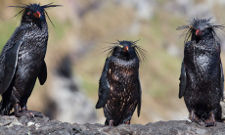
Oil-covered northern rockhopper penguins on Nightingale island after the freighter MV Oliva ran aground. Photograph: Kent Kobersteen/Getty
The penguins were trapped in oil released by the freighter MV Oliva when it ran aground and broke up last month off Nightingale island, 20 miles from the main island of Tristan da Cunha. Thousands of these delicately feathered birds — known locally as pinnamins — were coated in thick oil and all would have died but for the extraordinary intervention of local people.
"Just about everyone on the island has played a part in this operation," Katrine Herian, an RSPB project officer based on the island, said. "It was an amazing, co-operative effort. Some people took boats to Nightingale to pick up oiled penguins — a very tricky task given the swells and winds there. Carpenters on the main island built pens to keep them in. The main store — where tools, cement and machinery are stored — was cleared out and sand put down on the concrete floor so we could keep the penguins there.
"Then the island's swimming pool was drained of nearly all its water and used as a home for cleaned birds. People even ransacked their freezers to find fish they could thaw out and use to feed the rockhoppers. They would have starved otherwise." In the end, about 4,000 rockhoppers were saved, although Herian warned that it was impossible to say how many others may have died: "We won't really know until next year when the birds start breeding again and we can get a proper chance to count numbers and see how badly they were affected."
The northern rockhopper penguin, Eudyptes moseleyi, is found on only a few islands in the Atlantic, with 99% of its population making homes on the British overseas territory of Tristan da Cunha, a lonely, volcanic archipelago considered to be the world's most remote inhabited group of islands. There is no airstrip and the nearest major ports are in South Africa.
Keeping track of the northern rockhoppers in such a location is not easy. Nevertheless, ornithologists have discovered that their numbers have plunged by more than 90% since the 1950s, with factors such as climate change and over-fishing of squid and octopus — the penguins' main source of food — being put forward as possible causes. As a result, the northern rockhopper is now classified as an endangered species. The wrecking of the MV Oliva, therefore, posed a significant threat to them. The ship was carrying 65,000 tonnes of soya beans from Brazil to China when it ran aground on 16th March on an islet off Nightingale island. All 20 crewmen were rescued by islanders, but the vessel broke apart and released more than 1,500 tonnes of oil on to the waters around the island, coating the rockhoppers.
Within a day, islanders and RSPB workers began their remarkable rescue operation. When winds and the swell were low, they sailed to the island in small boats and, using Tristan's principal fishing vessel, the Edinburgh, as a command vessel, began shipping oiled rockhoppers back to the main island.
"The birds get very distressed when they are coated in oil," said Herian. "They lose body temperature very quickly in the water and preen themselves to get rid of the oil. They get weaker and weaker as they do that. Unless they get help, they die."
Capturing the birds as quickly as possible became a priority. Then they were transported to the main island, where they were corralled in pens, then showered and soaped to get rid of the oil and given liquid glucose feeds that vets usually give to pet cats and dogs to provide them with a quick energy boost. Then they were dried off under infra-red lamps.
"Many of the islands' older inhabitants played a key rˆle in this work," said Herian. "These are remarkably hardy people and pensioners think nothing of walking many miles every day to get about. They did a lot of the hard work in cleaning up the penguins."
The local rescue mission was also given crucial support from a team from Sanccob, the Southern African Foundation for the Conservation of Coastal Birds, which arrived on the island on 5th April. They brought specialist cleaning equipment, vitamins — and 20 tonnes of frozen pilchards. The Sanccob team also installed three large hot-water geysers in the wash-bay to improve penguin-washing, as well as hundreds of metres of piping and cable to link to the island's water and electrical supplies. In the end, a complex routine was established. Workers sprayed a fine mist of de-greasing agent over stricken penguins. Then the birds were washed in a warm bath of biodegradable soap and an antiseptic solution before being given a gentle clean round their eyes using a toothbrush. Later the rockhoppers were moved to the islanders' swimming pool so that their swimming skills could be assessed. Those that passed the test were released into the Atlantic.
"We will know next year how successful this operation has been when we count how many breeding pairs have returned to Tristan," said Herian.
UK Marine Management Organisation launches new marine licensing system
The Marine Management Organisation (MMO), who contribute to the sustainable development of the marine area, have launched a new system for licensing marine activities in seas around England, a commitment set out in the Marine and Coastal Access Act 2009.
The new system will result in a streamlined application process for developers, and will enable the MMO to publish information about how our decisions take into account the needs of coastal communities and the environment.
The MMO currently deals with around 350 licence applications per year and this number is expected to increase significantly as investment in marine development continues to grow.
Following public consultation, licensing charges will be proportionate, based on the work required to process the licence application. Head of Regulation and Licensing, Andrew Beattie, said "With this new system we will offer a simpler and easier online service. We've listened to developers, industry and representative bodies who have been instrumental in shaping the system launched today."
Portugal is being urged to protect its seamounts
The international marine conservation organisation Oceana is urging the Portuguese government to expand the Natura 2000 Network and protect its seamounts.
Despite the fact that Portugal has the largest marine area in the EU and the largest number of seamounts in the north-east Atlantic, currently only 3 seamounts (João de Castro, Menez Gwen and Lucky Strike), all located around the Azores, are protected and included in the European network of protected areas known as Natura 2000.
Oceana believes that other seamounts in Portuguese waters should also be included in this network, such as Gorringe, Ampere and Seine. To support this proposal, Oceana will carry out an expedition this summer to document and sample the peaks of some of these seamounts, with the help of professional divers and an underwater robot, descending to 1,000 metres depth.
In 2005, Oceana photographed and took video footage of the impressive diversity of the Gorringe Bank, located roughly 250 km southwest of Cape St. Vincent, and identified both Atlantic and Mediterranean species. During the expedition carried out on board the Oceana Ranger research catamaran, the organisation identified 36 species that had never been seen before on these seamounts.
The results were published in the report "The Seamounts of the Gorringe Bank", which includes an initial characterisation of these structures and has served as a reference document for subsequent scientific research.
"Apart from harbouring species that no one had ever seen in the area, the kelp forests covering the peak and gorgonian forests on the slopes are spectacular. The diversity of species, the high level of endemism, as well as the productivity of adjacent areas make the Gorringe Bank one of the most unique seamounts in the north-east Atlantic, and its protection should be considered an urgent matter," explains Ricardo Aguilar, Director of Research for Oceana Europe.
The importance and vulnerability of sites considered "sensitive habitats" is internationally known and, as such, these areas clearly deserve special protected status.
Seamounts are habitats with high concentrations of larvae, and constitute veritable "corridors" for many migratory species, including birds and cetaceans. The high level of diversity and large number of endemic species make these sites hotspots of biodiversity. The ecosystems present here, including kelp or laminaria forests, deep-sea reefs, gorgonian gardens, and coral and sponge fields provide important areas for reproduction and shelter for a number of fish species.
Even so, Oceana calls attention to the lack of scientific information available about these mountain chains and the need to continuously update it, in order to obtain essential data for governments to develop adequate management plans. Protecting and correctly managing seamounts greatly benefits the species that live directly on these structures, as well as those present in the overlying water column. Thus, dolphins, sea turtles, sharks and other large pelagic species like tunas would also benefit from protection afforded to these areas.
Ana de la Torriente, marine scientist at Oceana, points out that "the Portuguese government must be aware of the richness of these seamounts and develop a network of marine protected areas that guarantees their conservation, drawing up an adequate management plan with specific measures. In addition, the benefits generated by marine protected areas for fisheries are unquestionable; allowing increased growth of commercial species and generating increased biomass in adjacent areas."
To see video footage of these seamounts: www.youtube.com/watch?v=VmyBfx4TFdU
New undersea electricity cable between UK and Holland goes "live"
The 1,000 MW BritNed power interconnector between Britain and the Netherlands has opened commercially.
"This is good news for our energy security, for UK renewables and for consumers. It plugs the UK directly into a wider European electricity market, allowing us to import our peak needs cheaply rather than hold expensive plant in readiness," said energy secretary Chris Huhne in a statement. "Renewables win as it means surplus wind power can be easily shared. Consumers win as a single European market puts pressure on prices. And more new cables are planned so by 2020 we could have over 10 GW of additional electricity flowing under the North Sea."
"This cable link between the electricity markets of the UK and the Netherlands will enhance the security of supply and will contribute to effective pricing. What's more, the link will help us integrate sustainable energy initiatives in the electricity grid," said the Dutch minister of economic affairs, agriculture and innovation Maxime Verhagen.
BritNed, owned by National Grid and Dutch grid operator TenneT, is the second interconnector to link Britain to Continental Europe, after the 2,000 MW France-Britain link that opened in 1986.
Britain is currently building a 500 MW interconnector between Wales and the Republic of Ireland and there are further plans for interconnectors with Belgium, France, Norway and Iceland.
Scientists believe humpback whales compose "songs"
Humpback whales spread catchy songs to each other through the ocean, research has shown.
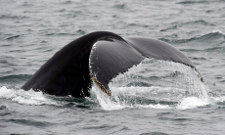
Male humpback whales often combine snippets of classic tunes with new material. Photograph: Don Emmert/AFP/Getty Images
Male whales whistle mating tunes that either prove a hit or miss. Catchy "remix" versions of the songs quickly spread across the ocean, almost always travelling east to west, scientists have found.
Usually the songs are made up of blended old and new material. But sometimes a song is judged to be a failure and dropped altogether, making way for a new tune. Researcher Ellen Garland, from the University of Queensland in Australia, said: "Our findings reveal cultural change on a vast scale." She said popular songs moved like "cultural ripples from one population to another", causing all the males to start singing the new version.
The scientists made the discovery after spending a decade searching for patterns in songs recorded from six neighbouring Pacific whale populations. They found it took about two years for male mating songs to spread from Australia to French Polynesia.
"The songs started in the population that migrates along the eastern coast of Australia and then moved — just the songs, and probably not the whales — all the way to French Polynesia in the east," said Garland. "Songs were first learned from males in the west and then subsequently learned in a stepwise fashion repeatedly across the vast region."
The eastward movement may be due to differences in population size, said the researchers, whose study is reported online in the journal Current Biology. Humpback whales exist in much larger numbers on Australia's east coast than in other areas. It is thought that either small numbers of whales take their songs to other populations, or whales in neighbouring groups hear the new songs as they swim together.
Garland described how the whales combined samples of "classic" tunes with new material. "It would be like splicing an old Beatles song with U2," she said. "Occasionally they completely throw the current song out of the window and start singing a brand new song."
Once a new song emerges, it quickly catches on among the males, rising to the "top of the chart" over the course of one breeding season. The scientists still do not know why the whales' songs are spread in this way. It is unclear whether the purpose of the songs is chiefly to attract females or to repel rival males.
"We think this male quest for song novelty is in the hope of being that little bit different and perhaps more attractive to the opposite sex," said Garland. "This is then countered by the urge to sing the same tune, by the need to conform."
Sustainable environmental alternative to offshore sand
Now that Japan, like Europe (but sadly not Britain) has banned Offshore Aggregate Dredging, a new market opportunity has arisen to fill the void created by the resultant shortage of sand and asphalt supply to the construction industry.
Springing from some remarkable research and development by the Japanese Kotobuki Engineering & Manufacturing Co. Ltd ('Kemco') a company called KAYASAND has now been formed in New Zealand that manufactures by reprocessing the usually discarded waste crusher dust produced in the quarries to form a high quality sand equating to the natural source and often even superior. These plants are already manufacturing some 35% of Japan's sand needs
KAYASAND has already embarked upon a program with Cardiff University subsidised by the Welsh Aggregate Levy Fund to prove the effectiveness of this technology in reducing quarry waste in Wales while producing a viable alternative sand for the Welsh and UK construction industries.
Now that the UK is reducing the waste once deposited in the vacated and closed inland quarries, they can be returned to the environment to provide reservoirs and lakes for wildlife, recreation and fishing, at the same time as reducing the leachate threat to the aquifer, rivers and sea. If the KAYASAND methodology is taken up, considerable pressure will be taken off our fish spawning beds and our coastline. Furthermore, a dramatically reduction in CO2 Emissions and cost is produced.
European Commission to investigate sea disposal
The Environment Agency (EA) granted the Coal Authority (CA) permission for a trial to discover if pumping the toxin containing waste dumped in the old Whitburn Colliery pit shafts out to the North Sea at Marsden Cove provided a way out of preventing the rising level of liquid in the pit from contaminating the aquifer, hence the public drinking water supply.
Like many other mines, Whitburn was closed in 1968 along with Westoe, South Shields, and Sunderland's Wearmouth Colliery, all of which shafts were then used to dump toxin containing sludge out of sight and out of mind. But like many an ill-thought-out 'disposal' a serious problem later arose. As a possible way out of this threat the Environment Agency (EA) granted the Coal Authority (CA) permission for a trial beginning in February to see if pumping the poisonous liquid to the North Sea at Marsden Cove proved to be an acceptable solution.
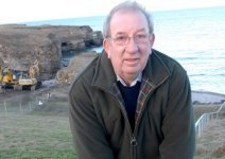
CONCERNED… Bob Latimer is worried what's being pumped into the North Sea
Coastal campaigner Bob Latimer has had a prolonged and acrimonious exchange with the Environment Agency over the level and nature of the poisonous substances being pumped into the North Sea following refusal to provide details of testing and the analysis of the liquid discharged, resulting in a cessation of communications on the matter. He finally took the issue to his MEP Stephen Hughes, who then referred the matter to the European Commission in Brussels, who will have it investigated by their officers. According to their findings as to whether the discharge violates the Water Framework Directive requirements and if vital public information is not being released on this matter, action may be taken in the European Court of Justice.
EA Chairman speaks to SCAR AGM
Lord Smith, Chairman the Environment Agency (EA) was guest speaker at the annual general meeting of the Suffolk Coast Against Retreat (SCAR) group at the Jubilee Hall in Aldeburgh on Saturday 9th April when he addressed on the topical issue of funding defence projects as the government comes up with a new Government formula for calculating project grants and budgets for flood defence projects are further squeezed.
He was quite frank in his warning that people would need to need to come up with the money and "imaginative ideas" to protect their rapidly crumbling coastline. He told the assembled landowners, local councillors and representatives of coastal groups that the EA was committed to cutting bureaucracy and enabling defence schemes offered a personal pledge to investigate failings. "The 'we know best' approach doesn't wash these days," he said. "There will be times when we don't get it right, and if you experience that, then come to me."
But he pointed out that there was still a national pot of £2.1bn for flood risk management and defences over the next four years and that the EA would "sit down with communities" and look at schemes on a case-by-case basis, adding "I would like for us to be able to say 'we have this amount of money we can put in the pot — if that's the case, can you raise this much?' I'd like there to be real clarity and to give real power to communities to make those decisions. We are committed to protecting as many properties and as much land as effectively and efficiently as we can. We need to identify the communities most at need, look at all the available resources and find imaginative solutions to funding."
Scottish government inspection report on fish farms "released" under Freedom of Information Act
Fish farms are being frequently hit by parasite infestations and mass escapes that threaten the survival of the UK's wild salmon stocks, a leading anglers' group has said. Official inspections have revealed that scores of salmon farms around the Scottish coast have had infestations of the sea lice parasite that breached recommended levels or have led to fish suffering wounds or an early death.
The Salmon and Trout Association (S&TA) said that official reports, released to the group under freedom of information powers, showed that the government's inspection regime was failing and was too lenient — a claim disputed by the Scottish Salmon Producers' Organisation.
It said their evidence raised significant questions about the common practice of routinely warning fish farms, often up to 10 days in advance, that an inspection was to take place. This often allowed salmon farms to take action on sea lice and repair damaged nets before the inspectors arrived.
Conservationists believe that high sea lice levels and escaped farmed salmon have caused a steep slump in wild Atlantic salmon numbers as the parasites kill young salmon before they breed, and genetically weaker farmed salmon cross-breed with wild fish. The industry disputes both claims.
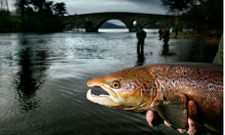
Young wild Atlantic salmon are being killed by sea lice before they breed, leading to a slump in their numbers, the Salmon and Trout Association claims. Photograph: Murdo Macleod
Guy Linley-Adams, the association's solicitor and a former conservation director with the Marine Conservation Society, said all inspections should be unannounced and all inspection reports must be published weekly, in line with more rigorous enforcement procedures used in Norway.
A majority of Scotland's fish farms are Norwegian-owned yet they enjoyed weaker regulations in the UK, he said.
"The information contained within the inspectors' reports gives the lie to the bland reassurances we are given by the salmon farming industry and indeed Scottish government that the industry is properly regulated," Linley-Adams said. "The devil is in the detail — now we have seen at least some of that detail and it is not pretty, revealing the true extent of the threat to wild fish conservation from sea lice emanating from Scottish salmon farms".
The association, in common with other conservation groups, believes the Scottish salmon farming industry is wrongly given lenient treatment by the government and enforcement agencies because of its significant economic status.
Boosted by a 23% increase in value in 2009, the industry earns around £412m a year, and is seen as a flagship product for Scotland; its fish farms are also sited in areas with weak economies, including the Western Isles and the west coast of Scotland.
The reports by the Fish Health Inspectorate released to S&TA found that from early 2009 until mid-2010, there were:
- nearly 70 instances where sea lice levels broke the industry's own code of practice and another 52 cases where there was "damage or mortality caused by sea lice, or high lice loads on sampled fish".
- 48 instances where fish farms failed to record or report sea lice numbers in line with industry standards.
The inspections also found evidence about the ineffectiveness of sea lice treatments, including lack of efficacy, tolerance to the chemicals or "potential resistance" to the treatments.
John Webster, the Scottish Salmon Producers Organisation's technical director, said the association's findings actually proved that the industry was very successful and very well-policed. The 68 instances where sea lice levels went over the guidelines were equivalent to only 15% of the inspections in that period. In 85% of the inspections, the guidelines were met.
"The figures actually show an extremely high level of compliance; we're rather puzzled with the way that they've drawn conclusions from these figures," he said. "I believe the industry is performing extremely well… We can always improve on our performance but to allege that it is poor is simply inaccurate."
The Scottish government said there were tougher standards being introduced, in co-operation with the industry, to improve sea lice monitoring and tighten up enforcement. Alongside a national database of sea lice levels across Scotland, all fish farms would be required to sign up to management agreements and mandatory reporting of sea lice "failures."
Officials were unable to comment on the association's demands for a new inspection regime because of the Scottish election campaign. "It should be noted that future plans and direction will be a matter for next government, including any move towards weekly reporting of sea lice levels," a spokesman said.
MARINET observes: The Scottish Government has recently undertaken a public consultation to establish views about the economic importance and environmental impact of the Scottish fish farming industry. MARINET has expressed a number of concerns to the Scottish Government, principal amongst which is the false belief that fish farming can act as a direct substitute for the collapse in wild fish stocks and the serious situation now affecting the offshore fishing industry. To see the MARINET comments in full, visit www.marinet.org.uk/rocfp/marinescotlandfeb11.pdf
.Campaign secures EU inquiry into discharge of contaminated mining water into the sea at Whitburn
Campaigners concerned about potentially contaminated mine water will have their fears investigated by officers from the European Union. The European Commission in Brussels has announced it will look into claims that a "cocktail of poisons" is being pumped into the North Sea from the former Whitburn Colliery in North East England.
The Environment Agency (EA) has granted the Coal Authority (CA) permission for a trial to see if the pumping system is a workable solution to prevent rising water and materials in the pit from contaminating drinking water. Environmental campaigner Bob Latimer highlighted concerns over the trial, which began in February.
The Whitburn pit shafts, which were abandoned when the mine closed in 1968, were later used to dump waste and slurry from both Westoe Colliery, South Shields, and Sunderland's Wearmouth Colliery.
Objectors are worried about poisonous substances and levels of iron and other elements in the water. The CA and EA say these are being monitored and the pumping will halt if these levels are too high.
The European Commission will now question the EA over the matter, and could refer it to the European Court of Justice.
North East Labour MEP Stephen Hughes, who referred the matter to the commission after liaising with Mr Latimer, said: "I am extremely concerned that the discharge does not meet the water framework directive requirements, and that vital public information is not being released on this matter. I requested that the European Commission intervene and investigate. I have now received notification that they will do just that. If it is found that there has been a contravention of environmental laws, action may be taken in the European Court of Justice."
Mr Hughes said the EA had refused Mr Latimer details of testing and analysis of the liquid discharged in the pumping trial.
An angry Mr Latimer said: "It is not acceptable to monitor the chemical composition of the water daily after it has been pumped into the sea. The chemical nature of this mine water should have been analysed long before it was piped to this beautiful and vulnerable cove near Marsden. It would have then been found — as I have found through analysis — that it contains high levels of undesirable substances which can only add to the burden of both sewage and contaminated dredge material already being discharged to this sea area. It is highly suspect that the public, including local fishermen and beach and sea users, were not informed of this test until the pipes were laid. Apart from the damage which may be caused by the 'trial', obviously the intention is to continue such pumping on a long-term basis with unknown effects upon the sea water."
The EA has defended its record on the scheme. Dave Edwardson, the Environment Agency's team leader for Tyne and Wear, said: "Information and analysis relating to the Whitburn mine water trial is public information, and the Environment Agency has always, and will continue to, make this available to anyone upon request. The trial's purpose is to investigate how it can control rising mine water to prevent possible pollution to groundwater, which is a source for the public water supply in the Sunderland and South Shields area. The chemical composition of the mine water is monitored daily to ensure minimal impact on the environment, and results from the trial, which ends this month, will help to decide how to tackle the issue in the long-term.
Angler-friendly Marine Protected Area network proposed for Arran
The Community of Arran Seabed Trust's (COAST) AGM on the 3rd March 2011 announced and gained initial support for a proposal to establish a larger Marine Protected Area (MPA) off the coast of Arran.
The main drive behind the MPA is to protect the coastal waters from bottom trawling and dredging activities. It will not affect static creel fishing or recreational sea-angling. Further meetings are now planned in villages around the island over the coming months and COAST hopes that there will be widespread feedback from around the island about the proposals.
Initial draft proposals suggest the MPA could stretch south from the Dhunnan (one mile north of the existing NTZ) to encompass the whole of Lamlash Bay around the eastern Arran coast, continuing around Pladda island and along the southern coast to beyond the reefs known as the Iron Rock Ledges off Corriecravie. The MPA outer boundary could be marked by a straight line boundary, possibly three miles off shore, as suggested by Arran's last creel fisherman who has extensive knowledge of the whole area. Along with SNH and Marine Scotland Compliance we have learned that whatever the site that is designated for protection, a larger buffer zone needs to be implemented at the same time, in order that the site has appropriate protection against damaging impacts.
A Marine Protected Area is not the same as a No Take Zone. The proposed MPA will not stop anglers, divers or creel fishermen from operating in the area. It is proposed that it affect only the less selective and more intensive and damaging fishing methods of bottom trawling and dredging.
Community proposals are now afoot for a larger network of angler-friendly Marine Protected Areas around the COAST of Arran that would also permit creel-fishing and diving. On a purely scientific level, the area contains many Priority Marine Features including :— at least seven maerl beds; probably the largest area of remaining seagrass in the Clyde; muddy substrate with sea pens; important tidal rocky reefs, one of which has the only known jewel anemones in the Clyde area; extensive kelp beds along the south coast; an area south of Bennan Head which has historically been known as an important herring spawning area; the area also contains important resident seal and otter populations
Besides the biodiversity advantages of this proposal, COAST are confident of broad community support. COAST volunteers have many years of experience in canvassing for an MPA and NTZ, and doing basic research through Seasearch and diving. In addition COAST now have experience in the direct management of the NTZ.
There are at least four clear additional reasons why a MPA on Arran would be a positive way forward:
- It would be ideally situated in the centre of the Firth of Clyde. The Clyde is desperate for renewal, sustainability and a strategy for management for the future.
- It is a rich biodiverse coastal environment which has already a considerable wealth of scientific knowledge, built up over time from both academic and community work.
- It is an ideal location for supervision and for further research with good access to mainland Scotland.
- COAST could be pivotal in facilitating some of the studies.
Although COAST have a large amount of scientific data for most of the proposed area, there are still a few locations along the south coast that they intend to survey within the next six months. COAST feels that this area should be in SNH's proposal to the Scottish Government. If this proposed MPA is not accepted as a direct SNH proposal, COAST would wish to propose it as a third party designation.
But for now, COAST will hold a number of community meetings to receive feedback about the proposals and gauge the general level of support. The 50 islanders present at COAST's AGM last month unanimously supported the idea.
Western Isles fish farm plan rejected
A contentious bid to establish a salmon farm close to four wild salmon river systems on Lewis has been thrown out by Western Isles planning councillors.
More than 1,500 people opposed the plan to locate 12 huge sea cages in Broad Bay, Lewis, following a high profile vociferous campaign.
The Western Isles Council's planning committee ruled that the environmental risks were too great and maintained the developer Scottish Salmon Company failed to have sufficient robust precautions to protect the environment. Fears were also expressed that the fish farm would not hold fast in a storm in the exposed site near the mouth of Broad Bay and lead to mass escapes of fish.
The firm failed also to properly show how it could stop seals from gnawing through the nets and releasing salmon to interbreed with wild fish migrating on the Creed, Gress, Coll and Laxdale rivers. In addition, sea lice from the caged fish could infest wild salmon and sea trout and the company failed to assess alternative sites said planners.
Planning officers said there were "clear deficiencies" in the firm's environmental assessment "lacking a robust, independent and accurate assessment of the potential impacts" which failed to deal with the risks.
The Scottish Salmon Company proposal said the overall impacts on wild fish were low and would be fully reversible when farming ceased.
The company is an important large employer locally and recently invested heavily in reopening a Stornoway processing factory, creating nearly 100 vital jobs. While other growers export farmed fish directly off the island, the firm is increasing production and developing a Hebrides salmon brand.
Peter Urpeth was among a group from the No Fish Farms In Broad Bay campaign said: "The council made the right decision for the right reasons. We are not against the fish-farming industry but not in favour of development at any cost." He said the council "struck the right balance between economic development and the environment".
Stewart McLelland, chief operating officer at the Scottish Salmon Company, said: "While it is unfortunate that the planning committee has not approved this application, the Scottish Salmon Company remains committed to growing a strong and sustainable business in and for the Hebrides. Identifying new farm sites to ensure we have the supply for year-round production at our recently-reopened Marybank factory is vital to that goal and we will continue to work alongside Western Isles Council and local stakeholders to identify further potential sites."
Ross and Skye Council approve a large new smolt rearing facility for seawater fish farms
Fish Farm operator Marine Harvest has welcomed Ross, Skye and Lochaber area planning committee's decision to grant approval for the company's plans to develop a new smolt rearing facility at Lochailort to stock its seawater farms.
The proposed location for the new facility, originally a commando training station during the second world war, subsequently became the site of the UK's first to develop commercial scale salmon farming and is widely regarded as the home of the industry.
Marine Harvest business support manager Steve Bracken said Lochailort had 'a unique place' in the history of fish farming and it was fitting the Lochaber clachan should be the location for the latest expansion, some 45 years later. He told The Oban Times: "Some of our staff still recall the early pioneering days when Unilever carried out their research. Despite a few changes of name and ownership along the way, we are a big part of the business community in the Highlands and still sustaining the economy of some of the most remote and rural parts of the region. This facility will be vital to the continued growth of the salmon farming industry in Scotland which is enjoying great success as people look for healthy food that is easy to prepare."
The new £12 million facility will replace the existing smolt unit which has been in place for 16 years.
Marine Harvest will grow the salmon from eyed eggs until the smolt stage when they will be transferred into the company's new seawater fish farms planned for the Minch. The new hatchery will also help supply smolts for the company's existing 25 sea farms across the west coast of the Highlands and the Western Isles.
As well as securing the positions of the existing four staff, a further six jobs will be created.
This latest development follows an announcement in October 2009 that the company is expanding its seawater operations by creating offshore residential fish farms in various locations in the Minch.
The lesson of Fukushima: gamble with safety, and you almost certainly lose
MARINET observes that whilst the following article by Prof. Joseph Stiglitz, The Guardian, 6th April 2011, is not strictly marine in nature, the consequences of the subject under discussion certainly do have serious implications for the marine environment. Prof Stiglitz writes:
"The consequences of the Japanese earthquake — especially the ongoing crisis at the Fukushima nuclear power plant — resonate grimly for observers of the American financial crash that precipitated the Great Recession. Both events provide stark lessons about risks, and about how badly markets and societies can manage them.
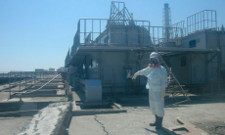
The damaged Fukushima nuclear plant, where staff continue to tackle grave radiation leaks. Photograph: Reuters
"Of course, in one sense, there is no comparison between the tragedy of the earthquake — which has left more than 25,000 people dead or missing — and the financial crisis, to which no such acute physical suffering can be attributed. But when it comes to the nuclear meltdown at Fukushima, there is a common theme in the two events.
"Experts in both the nuclear and finance industries assured us that new technology had all but eliminated the risk of catastrophe. Events proved them wrong: not only did the risks exist, but their consequences were so enormous that they easily erased all the supposed benefits of the systems that industry leaders promoted.
"Before the Great Recession, America's economic gurus — from the head of the Federal Reserve to the titans of finance — boasted that we had learned to master risk. "Innovative" financial instruments such as derivatives and credit default swaps enabled the distribution of risk throughout the economy. We now know that they deluded not only the rest of society, but even themselves.
"These wizards of finance, it turned out, didn't understand the intricacies of risk, let alone the dangers posed by "fat-tail distributions" — a statistical term for rare events with huge consequences, sometimes called "black swans". Events that were supposed to happen once in a century — or even once in the lifetime of the universe — seemed to happen every 10 years. Worse, not only was the frequency of these events vastly underestimated; so was the astronomical damage they would cause — something like the meltdowns that keep dogging the nuclear industry.
"Research in economics and psychology helps us understand why we do such a bad job in managing these risks. We have little empirical basis for judging rare events, so it is difficult to arrive at good estimates. In such circumstances, more than wishful thinking can come into play: we might have few incentives to think hard at all. On the contrary, when others bear the costs of mistakes, the incentives favour self-delusion. A system that socialises losses and privatises gains is doomed to mismanage risk.
"Indeed, the entire financial sector was rife with agency problems and externalities. Ratings agencies had incentives to give good ratings to the high-risk securities produced by the investment banks that were paying them. Mortgage originators bore no consequences for their irresponsibility, and even those who engaged in predatory lending or created and marketed securities that were designed to lose did so in ways that insulated them from civil and criminal prosecution.
"This brings us to the next question: are there other "black swan" events waiting to happen? Unfortunately, some of the really big risks that we face today are most likely not even rare events. The good news is that such risks can be controlled at little or no cost. The bad news is that doing so faces strong political opposition — for there are people who profit from the status quo.
"We have seen two of the big risks in recent years, but have done little to bring them under control. By some accounts, how the last crisis was managed may have increased the risk of a future financial meltdown.
"Too-big-to-fail banks, and the markets in which they participate, now know that they can expect to be bailed out if they get into trouble. As a result of this moral hazard, these banks can borrow on favourable terms, giving them a competitive advantage based not on superior performance, but on political strength. While some of the excesses in risk-taking have been curbed, predatory lending and unregulated trading in obscure, over-the-counter derivatives continue. Incentive structures that encourage excess risk-taking remain virtually unchanged.
"So, too, while Germany has shut down its older nuclear reactors, in the US and elsewhere, even plants that have the same flawed design as Fukushima continue to operate. The nuclear industry's very existence is dependent on hidden public subsidies — costs borne by society in the event of nuclear disaster, as well as the costs of the still-unmanaged disposal of nuclear waste. So much for unfettered capitalism!
"For the planet, there is one more risk, which, like the other two, is almost a certainty: global warming and climate change. If there were other planets to which we could move at low cost in the event of the almost certain outcome predicted by scientists, one could argue that this is a risk worth taking. But there aren't, so it isn't.
"The costs of reducing emissions pale in comparison to the possible risks the world faces. And that is true even if we rule out the nuclear option (the costs of which were always underestimated). To be sure, coal and oil companies would suffer, and big polluting countries — like the US — would obviously pay a higher price than those with a less profligate lifestyle.
"In the end, those gambling in Las Vegas lose more than they gain. As a society, we are gambling — with our big banks, with our nuclear power facilities, with our planet. As in Las Vegas, the lucky few — the bankers that put our economy at risk and the owners of energy companies that put our planet at risk — may walk off with a mint. But on average and almost certainly, we as a society, like all gamblers, will lose.
That, unfortunately, is a lesson of Japan's disaster that we continue to ignore at our peril.
© Project Syndicate 2011
Marine Climate Change Impacts Partnership (MCCIP) website update
The MCCIP website at www.mccip.org.uk has just been updated with new marine climate change, news and events, that include:
- Scotland's Marine Atlas for marine planners and schools — an atlas of Scotland's seas visually representing competing uses, productivity and health.
- A report on the impacts of climate change on disadvantaged UK coastal communities showing the more vunerable areas.
- A short, three page article from the journal 'Nature' providing an accessible, illustrated update on ocean acidification research and potential impacts. It shows what impacts might happen to marine organisms in the future under a range of emissions scenarios and also discusses other related issues such as the uptake of CO2 by the ocean.
- Some of the major research programs underway both in Europe and across the rest of the world.
Claim that Arctic Ocean freshwater will cause "unpredictable changes in climate"
A vast expanse of freshwater in the midst of the Arctic Ocean is set to wreak unpredictable changes on the climate in Europe and North America, new scientific analysis has shown.
The water — comprising meltwater from the ice cap and run off from rivers — is at least twice the volume of Lake Victoria in Africa, and is continuing to grow. At some point huge quantities of this water are likely to flush out of the Arctic Ocean and into the Atlantic, which could have significant impacts on the climate. Scientists say they cannot predict when this will happen though.
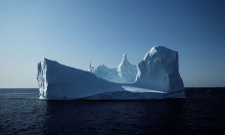
Arctic Ocean freshwater is expected to flush into the Atlantic, causing 'unpredictable' changes to the climate. Photograph: Delphine Star/getty images
"This could have an influence on ocean circulation," said Benjamin Rabe of the Alfred Wengener Institute "It could have an influence on the Gulf Stream."
At present, the freshwater acts as a "lid", preventing the warmer salty water below from meeting the ice, which would melt if the two mixed, according to Rabe. But while it is currently stable, this situation is likely to change as atmospheric circulation patterns shift, and as greater quantities of meltwater spill into the "lake". There were signs of an atmospheric change in 2009 that could have precipitated such an outflow, but that episode did not last.
Laura de Steur, an oceanographer at the Royal Netherlands Institute for Sea Research, said: "The volume of water discharged into the Arctic Ocean, largely from Canadian and Siberian rivers, is higher than usual due to warmer temperatures in the north causing ice to melt. Sea ice is also melting quickly — another new record low for ocean area covered was recently documented by the National Snow and Ice Data Centre, adding even more freshwater to the relatively calm Arctic Ocean."
She added: "Sea ice that is thinner is more mobile and could exit the Arctic faster. In the worst case, these Arctic outflow surges can significantly change the densities of marine surface waters in the extreme North Atlantic. What happens then is hard to predict."
Such an outflow would probably have a measurable impact on the "conveyor belt" or thermohaline circulation, a system of deep ocean and wind-driven currents, including the Gulf Stream, which carries heat from the tropics, said Rabe. An influx of dense, cold freshwater could slow the conveyor belt. If the effect were marked, it would be felt in the form of a change of weather in Europe and America, he said. Europe could find itself cooling, particularly around the Western edges, as the circulations tend to bring warmer air to the continent. But, he said, it was impossible yet to say whether any such effect would be dramatic or slight. Some climate models predict a 20% weakening of the current by the century's end.
Detlef Quadfasel, of Hamburg University's climate centre, warned that there was a chance changes in the system could be abrupt, occurring over a decade or two, but that more gradual change would be expected.
The findings are part of Project Clamer, a collaboration of 17 institutes in 10 European countries that is synthesising research from nearly 300 EU-funded projects over the past 13 years that concern climate change and Europe's waters, and the Baltic and Black Seas.
Freshwater inflow from rivers could also affect the Baltic Sea, one of the biggest brackish-water ecosystems in the world, according to Thomas Neumann, of Germany's . Its salinity is controlled by the amount of freshwater flowing off the surrounding land, as well as how much water is exchanged with the North Sea. If the salinity lowers further, this could have a harmful effect on the species that live there.
Japan to dump Fukushima's radioactivity in the ocean as levels in the plant become "immeasurable"
Fukushima nuclear power plant operator Tokyo Electric Power Co. plans to dump more than 11,500 tonnes of radioactive water from the destroyed plant into the Pacific Ocean.
Japan keeps on discharging slightly radioactive water into the ocean, with 3,430 tons dumped so far, while even more highly contaminated water inside the plant is exposing the workers to reportedly immeasurable levels of radiation.
The radiation level inside the plant has risen beyond the limit where it can be measured, NHK local television reported, quoting a plant's monitoring specialist. He said the radiation is exceeding the 100 millisievert level in some places outside the plant, while inside the buildings the monitoring systems fail to show any accurate numbers.
The monitoring systems have already demonstrated their unreliability, showing that reactors had a radiation level that exceeded the admissible maximum by ten million times, numbers which later were declared inaccurate.
Fukushima nuclear power plant operator Tokyo Electric Power Co. (TEPCO) plans to dump more than 11,500 tones of radioactive water from the destroyed plant into the Pacific Ocean by this weekend.
Banri Kaieda, the industry minister, promised the water will pose no major health risk and brought apologies for the situation to public, especially fishermen. And while Japanese officials claim the release will not pose an environmental threat, some experts strongly disagree.
The emergency move was done after it became clear that a total of 60,000 tons (20,000 tons for each of the 1-3 damaged Fukushima reactors) of highly radioactive water is flooding the basement of the reactor buildings and underground communications and that the operator will have remove the liquid obstructing recovery work.
This water is going to be stored in different locations, including provisional tanks, US Navy barges, an artificial floating island and a 30,000 ton waste disposal at the site.
Meanwhile Russia's state atomic energy agency Rosatom is discussing the possibility of sending Japan a "Landysh" liquid radioactive waste processing facility worth 35 million dollars, designed under the Russia-Japan 1993 agreement on nuclear disarmament, non-proliferation and utilisation, and financed by the Japanese government.
"That would be a symbolic gesture, charity for charity. We are ready to help our Japanese friends as they helped us once," Rosatom spokesman Sergey Novikov was quoted as saying by Ria-Novosti news agency. He also added that for now they are solving the technical questions of sending the system to Japan.
Arnold Gundersen, an energy adviser at Fairewinds Associates, a corporation specialising in environmental and nuclear safety issues, agrees that Russia could play a crucial rˆle amid this nuclear disaster. "The problem is that the amount of water is so astronomical and it is so tainted, that as they begin to clean the water they are going to get filters becoming so radioactive it will be very difficult to approach the filters," he said. "The Russians have the capability to clean this water, but it's still not going to be easy."
Valery Petrosyan, a UN expert on chemical safety, believes there is a way Russia's experience with the Chernobyl disaster could help Japan. "First of all [they were] trying to cover the lands at which the radionuclides were deposited with polymeric thin layers," he said. "They were not allowing the radionuclides to be distributed by wind. And I think that experience can be used in Japan."
Damon Moglen, a director of the Climate and Energy Project at Friends of the Earth, believes that Japan's government and TEPCO are not in control of this situation. "Now news is coming out today that levels of radiation in the sea right there at the reactor site are 7.5 million times beyond regulatory limits. The fact is that TEPCO does not have the situation under control," he said. "And I really think that they are dumping this nuclear waste into the ocean because they don't want to pay to retain it, and to deal with it otherwise. And that is unacceptable."
Currently, the contaminated water is leaking from a cracked concrete pit near the No.2 reactor, where nuclear fuel rods suffered a partial meltdown.
TEPCO says that samples of seawater taken near the plant showed 7.5 million times the legal limit of radioactive iodine 131. Samples taken recently also contained 1.1 million times the maximum legal limit of caesium 137, with half life period of 30 years.
Meanwhile, as safety concerns rise in the wake of continuing water leaks, Japan hastily set 2,000 bequerels per kilogram as the legal limit for the permitted level of radioactive iodine in seafood, the same limit that has been already adopted for vegetables, Kyodo news network reports, quoting Japan's Chief Cabinet Secretary Yukio Edano.
Tokyo predicts the Fukushima-1 nuclear power plant, devastated by a 9.0 earthquake and a 10 meter high tsunami on March 11th, will continue leaking as workers struggle to plug a damaged reactor.
In order to stop the radioactive water flow, TEPCO will inject 'water glass' or sodium silicate into areas beneath the pit's bottom, where the radioactive water is believed to be leaking through, informed the operator.
Earlier attempts to block the radioactive water leakage with water-absorbing polymeric materials and concrete proved to be unsuccessful, as well as attempts to pinpoint the exact location of the leakage with coloured water.
Anger at Faroes' decision to massively increase mackerel quota
Scottish fishermen have expressed their anger at the decision by the Faroe Islands to unilaterally set itself a massively increased quota for mackerel this year of 150,000 tonnes.

The move follows the breakdown of talks in Oslo last week in which the Faroes and Iceland refused to accept a compromise deal on catching opportunity from the EU and Norway to ensure a sustainable future for the north-east Atlantic mackerel stock. Iceland had already set itself a unilateral total allowable catch (TAC) for mackerel of around 155,000 tonnes for 2011.
Ian Gatt, chief executive of the Scottish Pelagic Fishermen's Association, said that if the Faroes had stuck by the Coastal States management plan for mackerel that it previously participated in, then their quota this year should have been 29,700 tonnes.
"In effect they have massively increased their quota by five-fold, which goes against all scientific advice. Their behaviour is grossly irresponsible and puts at real risk a stock that has been carefully nurtured and looked after by the Scottish fleet. If every nation unilaterally increased their quotas five-fold, then there would be no fish left in the sea.
"The Faroese maintain that changes in the migratory patterns of mackerel is behind their decision to increase their quota. However, we totally refute this suggestion as there is no evidence that there has been any change in the movement of mackerel.
"We have already seen the impact of the lack of an international agreement on the blue whiting stock, which has been decimated as a result of a number of non-EU countries such as Iceland and the Faroes engaging in 'free-for-all' fishing. The impact on Scottish jobs if the same were to happen to mackerel would be disastrous.
"The situation is so serious that the Scottish Government needs to take charge of the negotiations at the highest ministerial level. In the meantime, Scottish and European fishermen are determined that no Faroese mackerel will be landed into our ports.
Meanwhile, the Scottish Fishermen's Federation has also expressed its concern at the impact on some parts of the whitefish fleet by the decision by the Faroes to remain outside an international management agreement for mackerel, which will mean a significant number of Scottish whitefish vessels will be denied access to Faroese waters, putting further pressure on an already economically pressured fleet.
UK Government publishes its Marine Policy Statement
The UK Government states "This Marine Policy Statement (MPS) is the framework for preparing Marine Plans and taking decisions affecting the marine environment. It will contribute to the achievement of sustainable development in the United Kingdom marine area. It has been prepared and adopted for the purposes of section 44 of the Marine and Coastal Access Act 2009.
"The Secretary of State, Scottish Ministers, Welsh Ministers and the Department of the Environment in Northern Ireland are jointly adopting the MPS. This is a key step towards achieving the vision shared by the UK Administrations (UK Government, Scottish Government, Welsh Assembly Government and Northern Ireland Executive) of having 'clean, healthy, safe, productive and biologically diverse oceans and seas'
"The MPS will facilitate and support the formulation of Marine Plans, ensuring that marine resources are used in a sustainable way in line with the high level marine objectives and thereby:
- Enable the UK's move towards a low-carbon economy, in order to mitigate the causes of climate change and ocean acidification and adapt to their effects;
- Promote sustainable economic development;
- Ensure a sustainable marine environment which promotes healthy, functioning marine ecosystems and protects marine habitats, species and our heritage assets; and
- Contribute to the societal benefits of the marine area, including the sustainable use of marine resources to address local social and economic issues.
In order to see the Marine Policy Statement, visit http://archive.defra.gov.uk/environment/marine/documents/interim2/marine-policy-statement.pdf.
BP expects to resume normal operations soon in the Gulf of Mexico
BP plans to restart deep water drilling in the Gulf of Mexico this summer a year after the fatal Deepwater Horizon rig explosion triggered the worst oil spill in history.
US regulators have given the firm approval to start work on 10 wells in the Gulf that were halted by a moratorium on drilling imposed after the spill, according to the Sunday Times. BP declined to comment. The move is likely to fuel public anger and comes days after it emerged that the US justice department is considering manslaughter charges after the devastating oil spill, which killed 11 workers and caused an environmental crisis. Drilling could start as early as July, less than 15 months after the disaster.
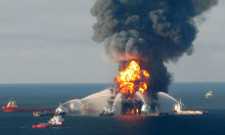
BP is spending $41bn to clear up after its Deepwater Horizon oil well exploded last year. Photograph Reuters
BP is spending about $41bn (£25bn) on cleaning up the spill and to cover damages. Investigations into the spill continue with the US authorities examining testimony from Tony Hayward, the former chief executive, and others as they consider bringing legal action.
Last week the Bureau of Ocean Energy Management, Regulation and Enforcement (BOEMRE) announced it had given permits for the drilling of eight deep water wells since 17th February this year and the imposition of "rigorous new safety standards implemented in the wake of the Deepwater Horizon explosion and resulting oil spill".
Michael Bromwich, BOEMRE director, said: "The progress in permitting deep water drilling is directly related to industry's ability to meet and satisfy the enhanced safety requirements associated with deep water drilling, including the capability to contain a deep water loss of well control and blowout."
The BP wells are likely to be existing wells reopened for production and not exploratory rigs like Deepwater. The company is expected to seek approval to start exploratory drilling later in the year. BP is believed to have promised to meet very strict safety standards as part of negotiations, including 24-hour access by the US government.
The accident, which released almost 5bn barrels of oil into the Gulf of Mexico, was the largest marine spill in history. Charlie Kronick, a spokesman for Greenpeace, called the news "a poke in the eye not only to the environment but to investors". He told msnbc.com: "It has been a year now and 80% of that oil is still somewhere in the sea. There is nothing different about the situation now other than regulators may keep a slightly beadier eye on operations."
Last week it emerged that Transocean, the firm that operated the Deepwater rig, had awarded millions of dollars in bonuses to its executives after "the best year in safety performance in our company's history", according to a regulatory filing.
"Notwithstanding the tragic loss of life in the Gulf of Mexico, we achieved an exemplary statistical safety record as measured by our total recordable incident rate and total potential severity rate," Transocean states in the filing. "As measured by these standards, we recorded the best year in safety performance in our company's history, which is a reflection on our commitment to achieving an incident free environment, all the time, everywhere."
Is 'Jaws' patrolling Great Yarmouth?
'The Sun' (who else?) reported on 26th March (NB not 1st April) with the headline 'Great White Yarmouth' and the caption 'JAWS is stalking the coast of Norfolk, experts fear — after a porpoise was found mutilated by a giant shark'. Just as if Great Yarmouth has not got enough by way of hazards already!
The bite out of the unfortunate porpoise certainly appears to be a shark bite, and is quite different from the mechanically induced lacerations being found on many seals washed up on the North Norfolk Coast. And with warming seas, it is not impossible that such sharks could migrate from the South Atlantic to the North Sea. But such carcases can drift from far seas away to end up on our shoreline.
The full story and the accompanying photograph may be seen on the Sun website.
The Scottish Government asks: Is fish farming the way forward? MARINET answers: No
Marine Scotland, on behalf of the Scottish Government, has recently undertaken a public consultation on attitudes to aquaculture (fish farming), and has sought evidence as to whether this industry has a serious future.
MARINET has responded (http://www.marinet.org.uk/rocfp/marinescotlandfeb11.pdf), and has advised that fish farming of carnivorous fish (salmon, cod) — as opposed to herbivorous fish (trout, carp) — is not a solution to the collapse of wild populations, largely because it takes 2 to 3 kg of wild fish to produce 1 kg of farmed carnivorous fish (e.g. salmon), thus intensifying the fishing pressure on wild populations in our seas rather than reducing the pressure. Hence, farming carnivorous fish (salmon, cod) is no substitute or replacement for the collapse in wild populations of salmon and cod. Indeed, it is contributing to their collapse.
MARINET has informed the Scottish Government that if the harvesting of wild populations were undertaken on a sustainable basis, then there would be little need for fish farming (other than in a specialised context i.e. seeding of shellfish beds with wild stock, and the use of freshwater fisheries in conjunction with other farming methods i.e. herbivorous species — such as carp and trout — extensively reared in rice paddies in Asia or in conjunction with water conservation in the UK).
Therefore, the primary emphasis of fisheries management policy must be on action to protect and rebuild wild fish stock populations, rather than the development of alternative methods of aquaculture which are, at best, a substitute for wild populations and, at worst, contributing to the damage and further decline of wild populations.
In respect of the regulatory regime for fish farming, MARINET notes that the Salmon and Trout Association reported in November 2010:
"In March, Marine Scotland informed the industry that it would be publishing details online of certain inspection reports on salmon farms relating in particular to sea lice infestations and fish escapes, carried out under the terms of the Aquaculture and Fisheries (Scotland) Act, given a ruling by the Scottish Information Commissioner that such information should be in the public domain.
"The industry's trade body, the Scottish Salmon Producers Organisation (SSPO), responded threatening Marine Scotland with legal action if any company's business was "compromised" as a consequence. Marine Scotland then announced that it was suspending the publication plan and reviewing the situation in light of the issues raised by SSPO. In October Environment Minister Roseanna Cunningham confirmed that no audits or inspections of fish farms had taken place since March 2010." (Ref. www.marinet.org.uk/archive/archivelatestnews2010.html#ctss).
MARINET is greatly concerned by this report. It seriously undermines confidence. We further ask whether proper Environmental Impact Assessments are being conducted at the time of licence applications, and whether these EIAs are being undertaken on the basis of freely available, objective evidence if the above reported suppression of evidence is taking place? Further, are these licence applications being sufficiently advertised at the time of their submission, thus enabling the public to comment freely?
Looking to the future, a matter of fundamental importance is whether aquaculture embraces genetic modification (GM). The principal proposal at the present time is the genetic modification of salmon. Ref.
www.marinet.org.uk/archive/archivelatestnews2010.html#uccs and
www.marinet.org.uk/archive/archivelatestnews2010.html#fggs and
www.marinet.org.uk/archive/archivelatestnews2010.html#itgh
MARINET believes that the genetic modification of farmed fish is unacceptable.
In the case of the salmon proposal (references above), where salmon is being crossed with Norway pout resulting in a GM fish that grows at twice the rate of natural salmon, there is a substantial risk that wild salmon will be eliminated from our seas. This is because GM salmon will escape from the fish farms (over 100,000 escaped in March 2010 from a UK fish farm, ref: www.marinet.org.uk/archive/archivelatestnews2010.html#uccs) and only 98% will be infertile. Thus, given the growth advantage introduced by the genetic modification it is very likely that, over time, the entire salmon genetic pool will be affected and only stocks carrying the GM genes will survive because of the competitive growth advantage. This means the natural salmon will become extinct. In turn, its replacement by the GM variant will likely have serious ecological impact as the GM variant's feeding behaviour (appetite and prey selection) will be different from natural salmon.
This corruption of the natural ecology of our seas is unacceptable, both in terms of moral principle and in terms of its practical consequences. Under no circumstances must GM be introduced to aquaculture unless the ecological consequences can be shown to be benign or, at worst, entirely neutral.
MARINET concludes in its submission to the Scottish Government that if the aquaculture industry is to prosper and equally, if not more importantly, is to develop and function in an ecologically responsible manner, then it has to assess itself objectively and fully publish assessments about its environmental impact, and to develop policies with public approval which will place the industry on a sustainable basis.
MARINET told the Scottish Government that our society urgently needs this industry to behave in this manner because it is imperative for us to achieve marine "food security" on a sustainable basis (our society is rapidly losing marine "food security" at the present time), and because food security, if it is to be achieved, requires the marine environment and the ecological structure of our seas to be in a sound condition as a prerequisite.
For a full copy of the MARINET report to Marine Scotland (Scottish Government) with additional questions and replies see (http://www.marinet.org.uk/rocfp/marinescotlandfeb11.pdf)
New Report assesses the Scale and Nature of Radioactivity released into the marine environment via cooling water from new Nuclear power stations
A new report (www.marinet.org.uk/radiation/tdjonesmar11.pdf), published March 2011 by Tim Deere-Jones, a marine pollution consultant, records the nature and amount of radioactivity likely to be discharged via cooling water into the estuarine and coastal environment from the new designs of nuclear power stations proposed for the UK.
Tim Deere-Jones states: "This briefing seeks to answer a few of the basic queries raised by colleagues and fellow campaigners regarding the nature of liquid radioactive waste discharges to the marine environment from the two reactors types proposed for the proposed new UK fleet of nuclear electricity generating stations."
"The briefing is necessarily a summary of the available information (which is itself less than complete) and contains my personal interpretation of the available data based on 28 years experience as a marine pollution consultant."
An assessment is provided in the report of aquatic tritium discharges, along with the discharges of Carbon 14, Caesium 137, Cobalt 60, Alpha emitters, and Plutonium 241. Also considered by the author are a number of what he considers to be unresolved issues. These involve a lack of transparency over the total inventory of aquatic discharges, a lack of transparency on the alpha/actinide discharges, and the need for greater clarification in the justification of the limits set by the Environment Agency.
The report also considers dose assessment, the impact of gaseous discharges, and the fate and behaviour of radioactive wastes in the marine environment.
New report on "Thermal standards for cooling water from new build nuclear power stations"
The expert panel of the British Energy (EDF) Estuarine and Marine Studies (BEEMS) has published a report via Cefas on the thermal impact of cooling water from nuclear power stations. In the introduction to their report, they state:
"The abstraction and return of seawater used for cooling represents the most important environmental aspect to the marine environment of nuclear power station operation.
"The discharge introduces significant thermal energy (heat) to receiving waters, which will continue with little variation throughout the operational life of the station, which may exceed 40 years. Return cooling-water will typically be 8-10°C higher than background. A modest temperature rise adjacent to the discharge is inevitable with little practical opportunity for mitigation once the station is commissioned.
"Although European and UK legislation includes inter alia thermal limits, there are currently no uniform standards available to the Environment Agency and other UK regulators for the control of temperature or thermal loads in Transitional (estuaries) and Coastal (TraC) waters.
"Current thermal controls have been derived mostly on pragmatic grounds and have worked tolerably well, but they have a number of fundamental flaws. Many of the current limits are either based on freshwater standards or rely heavily on an intuitive view on the behaviour of fish (and other marine organisms) with little scientific justification, whilst the potential impacts of a systemic rise in seawater temperature brought on by climate change has largely been ignored.
"This report critically reviews the available scientific information from published and grey literature over the past 50 years.
"Based on data from numerous laboratory and field studies, detailed information is given on the thermal tolerance for a wide range of species which will be relevant in the context of the new nuclear build (NNB) programme in the UK. Context for this information is given in the earlier chapters, which review current legislation, discharge plume behaviour and possible influences of water quality issues.
"The report provides the developer and regulator with:
- confidence that the local ecosystem will not be damaged by power station operation throughout the anticipated operating life in a context of systemic climate change;
- standards to ensure legitimate ecological conservation and fishing interests will be protected;
- assurance that investment in control measures provides environmental benefits.
"In particular, this report provides an overview of all significant issues pertaining to thermal discharges to TraC waters with special consideration given to the requirements at Hinkley Point and Sizewell.
"In essence, the review confirms the fact that adverse effects of cooling water (CW) outfalls are restricted to an area close to the plume, that temperature rises up to 3°C appear to be tolerable and that resulting temperatures less than 27°C have no clear deleterious impact on species in the receiving waters.
"However, in the longer term, changes in the local community may result as species with differing tolerances of elevated temperature show differing survival, growth and patterns of reproduction from those expressed under ambient conditions. Populations that persist in the receiving area of a heated CW effluent will acclimate to those new local conditions and may adapt in response to them. Superimposed on these changes, however, are community changes caused by species distribution alterations as the result of climate change.
This report has been produced by the Expert Panel, British EDF Estuarine & Marine Studies (BEEMS):
Professor Mike Elliott (Chair) (Institute of Estuarine and Coastal Studies, University of Hull) on behalf of the Expert Panel:
Dr Roger Bamber (ARTOO Marine Biology Consultants, Southampton)
Steve Colcloug (Environment Agency, Abbey Wood)
Professor Keith Dyer (Independent Consultant)
Dr Henk Jenner (Aquator BV, Netherlands)
Peter Holmes (Scottish Environment Protection Agency)
Dr Andy Turnpenny (Turnpenny Horsfield Associates, Ashurst)
Andrew Wither (National Oceanography Centre, Liverpool)
(with assistance from Daryl Burdon, IECS, University of Hull)
MARINET observes: This report only studies the thermal impact of cooling water on receiving estuarine and coastal waters. It does not study the impact of any radioactivity which these cooling waters may be carrying and thus releasing into the estuarine and marine environment.
Are we evaluating the risk from failure of our nuclear power stations?
We supply below copy of an article from the SLO Journal, California, USA, where environmentalists are asking the question — what happens if Japan is repeated here? MARINET asks, are we similarly evaluating the true nature of the impact of a serious failure, for whatever reason, of our nuclear power stations in the UK?
SLO's Godzilla: Diablo Canyon Nuclear Power Plant
by Carol Georgi and Karl Kempton, former Energy Planner for San Luis Obispo County and Lead Author of "Proposed Central Coast National Marine Sanctuary, 1990"
- Scheduled to be decommissioned in 2024/2025 (two 40 year old reactors)
- PG&E (Pacific Gas and Electric Company) is applying to add 20 more years of operation, until 2045. (will be 60 years old)
- Radioactive nuclear waste is increasing and being stored onsite until 2105, but with no alternative storage site, forever?
Introduction
Our thoughts and prayers go out to the people of Japan and the victims of this tremendous ongoing tragedy as we write. This nuclear accident is the second tragedy affecting marine habitat with implications for our local rich, diverse and dense marine habitat and life forms with national and international significance we have witnessed during the last few months. The first tragedy was the oil gusher in the Gulf of Mexico, a grim demonstration of what is possible off our shores.
The nuclear disaster in Japan also demonstrates what the release of radioactive materials into our land and offshore waters would entail. Nuclear power advocates are flooding the media and internet with dubious messages designed to placate growing public and scientific concern.
PG&E's Diablo Canyon Nuclear Power Plant (DCNPP) is mankind's attempt to assume that engineering can eliminate any possibility of a seismically induced accident. However, improbable is not impossible, as earthquakes are unpredictable. "Now, as Japan struggles to contain four out-of-control reactors, all of us — whatever our views of nuclear energy — must focus not on assurances that it can't happen here, but rather on ensuring it never does," Joel R. Reynolds, senior attorney and director of the Southern California program of the Natural Resources Defense Council.
From the beginning, (designed in the 1960's and built from the seventies through the early 1980's), local residents and concerned scientists have opposed and questioned DCNPP for four main reasons:
- Risk benefit analysis and economic costs to the public, the state and the national economy
- Storage of deadly radioactive spent fuel onsite
- California's unpredictable seismic faults could cause dangerous earthquakes
- Once through cooling is problematic to operational shut-downs, destroys at least 1.7 billion fish larvae each year, and is vulnerable to tsunamis
Risk Benefit Analysis and Economic Costs to the Public and to the State and the National Economy
What would happen if a massive earthquake hit a California nuclear power plant? Estimates are that California represents 13% of the US GDP, 12% of the population, and ranks eighth in global economies. Therefore, losing California's productivity due to a nuclear accident would be catastrophic to both California and the entire United States of America.
Nuclear power plants are built within an economic philosophical framework called risk benefit analysis. Do the benefits of an economic endeavor outweigh the real and potential risks? The bottom line is that for San Luis Obispo (SLO) County residents, we are the at risk. For PG&E, profits are the benefits. The tragic problem with PG&E's bottom line is that it's fractured with known and hidden faults upon which the other risks of nuclear power sit.
The real experts for risk benefit analysis can be found in the insurance business sector of the economy. Our political and economic system has designed within it a variety of checks and balances to avoid undue risk and maintain a balance of power. After careful study, the insurance companies, when approached to insure nuclear power plants, refused. For them, the risks were too overwhelming. How did the nuclear industry do an end run around this check? They got the government to insure them (the Price-Anderson Act of 1957). The Encyclopedia of Earth states, "opponents argue that the Act represents a massive taxpayer subsidy of the nuclear industry that substantially reduces the cost of doing business. Some opponents claim that without the cap on liability damages, the industry could not survive."
Had PG&E proved during the licensing and hearings process a willingness for transparency, being openly forthcoming, honest, and non-bullying, many a PG&E critic would not be looking askance at the avalanche of safety and not-to-worry hubris filling local and national newsprint and air waves as the Japanese tragedy unfolds.
Some could give PG&E credit for naming the plant after the devil, Diablo Nuclear Power Plant, as unintended truth in advertising. Some believe the devil comes in many disguises, bearing gifts to the gullible. In this county, the gifts have come in the form of a huge property tax windfall for government and for a large number of groups, associations and non-profit organizations, as generous donations and grants. This has bought many open — and unfortunately — hidden friends and a loud painful silence.
Let us examine some of the risks PG&E is willing to take, since they have no real liability.
- A radioactive release large enough to radiate a 12-mile radius would close down the major north-south coastal transportation corridor for the entire state and cause considerable damage to our county population and ocean life.
- A radioactive release large enough to radiate a 50-mile radius would threaten National Security by making Vandenberg Air Force Base useless. That also means no West Coast space launch site.
- Radiation would contaminate vast areas of major agriculture production including perhaps California Central Valley agriculture lands. This would also perhaps shut down the other main north-south transportation corridor.
- Then there is the huge population who survived the earthquake damage at risk and faced with death, slow death and injury from radiation.
This potential destruction is as if PG&E has been playing a card game while being pals with the card dealer (NRC) and the gambling house (Nuclear Industry). However, PG&E has not been playing with their money, but with the money belonging to all others at the table (ratepayers). PG&E was given an operating permit to get away with a bet on our lives and livelihood and on the economy of the county, state and, nation and national security (Vandenburg Air Force Base, aka Space Port West Coast). All these risks have been for PG&E's profits.
What About the Payments the California Ratepayers Continue to Pay?
Extending DCNPP's operating licence would likely open ratepayers up to footing even more than the $5.5 billion bill for the plant thus far, commented Steven Weissman, a former administrative law judge at the California Public Utilities Commission (CPUC) and current law professor at the University of California, Berkeley, as reported in the Scientific American magazine.
Furthermore, as reported in the same article, California's only power to influence the federal relicensing process lies in its ability to protect customers from high electricity rates. PG&E's request to pass on about $85 million of seismic studies and other relicensing costs to the ratepayers could provide an outlet for the California Public Utilities Commission to withdraw the plant's certificate of public convenience and necessity.
Storage of Deadly Radioactive Spent Fuel Onsite
Concern: Safety of Indefinite Storage of Nuclear Waste Onsite
The DCNPP, owned and operated by PG&E, consists of two reactor units, and each unit has its own spent fuel storage pool. The Diablo Canyon Independent Spent Fuel Storage Installation (ISFSI) provides additional spent fuel storage capacity when the storage capacity of the spent fuel pools is reached. The Nuclear Regulatory Commission (NRC) has stated that nuclear power plants may store spent fuel onsite for 60 years after cessation of operations.
DCNPP plans to put the spent fuel from the pools into dry storage casks. However, with a 20-year extension to PG&E's operating licence, the pools will then be used to store the next 20-year supply of spent nuclear fuel. The U.S. has no permanent storage solution for the waste, which takes about 250,000 years to lose it's harmful radiation potency. Therefore, San Luis Obispo County now has a radioactive storage site at DCNPP, one that was never planned, permitted, nor agreed to by the community or the state of California.
Janet Zimmerman's article, "Japan Crisis Renews U.S. Nuclear Fuel Storage Debate," in the Press-Enterprise is an analysis of the problems with the U.S. storage of radioactive nuclear spent fuel.
Zimmerman states, "At U.S. nuclear plants, spent fuel rods are cycled out of reactors every 18 months or so and placed in deep pools of circulating water to cool. The process takes seven years or more. As the pools reach capacity, the rods are moved to dry-cask storage on site, since there is no national repository." Nuclear power plants have to rack and stack their used nuclear fuel and build another facility to maintain and guard. Therefore, U.S. communities with nuclear power plants now have to also endure radioactive nuclear waste storage sites.
Zimmerman further reports that in a 2008 speech to the nuclear trade industry, Nuclear Regulatory Commission head Gregory Jaczko said it is safer to store spent fuel in the dry containers than in the wet pools. He recommended requiring plants to transfer spent fuel to dry casks rather than letting it accumulate in the pools.
A large radiation release from a wet pool fire could result in thousands of cancer deaths and hundreds of billions of dollars in decontamination costs and economic damage, according to a 2004 study published in the journal Science and Global Security. (Storing Radioactive Fuel)
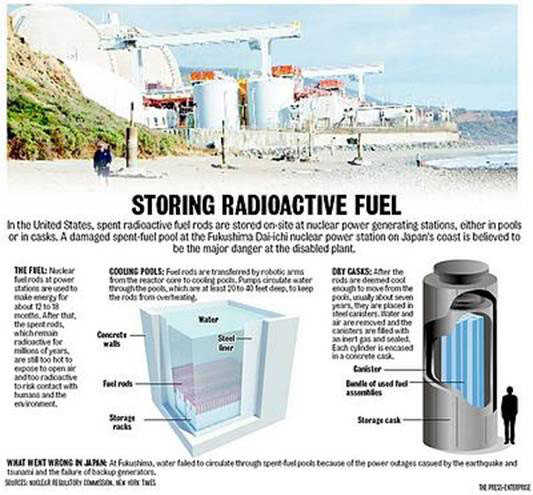
Newsweek reported a study that showed," an attack on a dry cask storage area would result in a much smaller release of radioactivity and much less severe damage." In one important respect, the threat in the U.S. might be even greater than what befell Japan. The U.S. has failed to establish a permanent nuclear-waste depository, the NRC allows plant operators to move from "open rack" configurations — which cool the rods most effectively — to a "dense pack" design that eventually fills pools "almost wall to wall," argues Robert Alvarez of the Institute for Policy Studies, a former Department of Energy official.
Proposals submitted for 10MW tidal energy array off Welsh coast
Tidal energy company Marine Current Turbines (MCT), in partnership with RWE npower renewables, today submitted a consent application to install a 10MW array of tidal stream turbines off the North West coast of Anglesey in 2015.
Consisting of seven twin-rotor turbines arranged across an area of 0.56sq.km, the array will harness the power of the tidal waters, generating enough power for over 10,000 homes on the island. It will be the first tidal array to be deployed in Wales.
Using the fast moving and predictable flow of the tides, it will use MCT's proven tidal energy technology known as SeaGen, which works in principle like an "underwater windmill. SeaGen is a proven technology: the first 1.2MW unit has been successfully operating in Strangford Narrows, Northern Ireland since 2008, and MCT says it is officially accredited by OFGEM as the UK's first and only tidal current power plant.
If the planning consent is granted to SeaGeneration Wales Ltd — the MCT/RWE npower renewables project company — it will be the first tidal array in Wales demonstrating the commercial viability of this technology. MCT says the project will help to demonstrate that the deployment of tidal generation can be recognised as a viable means of securing renewable generation, lower carbon emissions whilst simultaneously creating a new industry and many jobs.
The project is expected to cost approximately £70m to develop and, where possible, local businesses will be contracted for the assembly, installation, operation and maintenance of the tidal array. It will generate jobs that use skills ranging from advanced blacksmithing through to sophisticated control systems management. It will also stimulate the supply chain to support the emerging marine renewable energy sector in the UK and Wales.
Martin Wright, CEO and founder of MCT said: "Tidal power is a predictable and reliable source of renewable energy and our technology can play an important part in helping Wales realise its renewable energy targets as set out in the Welsh Assembly Government (WAG) Energy Policy statement.
"It aims to capture ten per cent of the tidal stream and wave energy off the Welsh coast by 2025, making Wales a UK low carbon economic area for tidal energy. The proposed project would represent a significant step in meeting both of these targets and furthermore, will see the creation of many new green jobs."
And RWE npower Renewables' Project Manager, Paul Catterall, said: "RWE npower renewables is delighted to have been involved in the development of this project, which exemplifies one of the most promising of the emerging renewable energy technologies. Tidal energy has the potential to play a significant role in our future renewables portfolio."
Family home to be bulldozed before it crumbles into sea
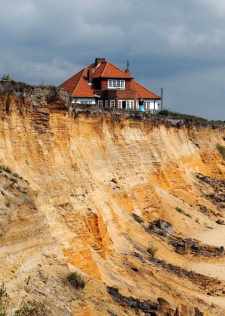
Sally Mitchell and her cliff top house at Easton Bavents
Under 'Easton Bavents: Family home to be bulldozed before it crumbles into sea' Lauren Rogers describes in the East Anglian Daily Times of March 20th 2011 how a family home built in the 1930's at Suffolk's Easton Bavents, near Southwold, is to be demolished before it disappears over the edge of the rapidly decaying cliff and falls into the ever-approaching sea. When it was bought by the Thrawle family in the 1940s it stood some 80 metres away from the cliff edge, and passed through four generations of the family.
Brother and sister Andrew Thrawle and Sally Mitchell, who have spent summers at the house since childhood, will watch as the bulldozers move in to demolish the house on April 4th. Norma and Pat Gowen, who watched as their coastal bungalow went into the sea along with over 80 others at Hemsby, know just how they will feel.
Saving our valuable Coastline
Professor Jules Pretty is Pro-vice-chancellor at the University of Essex, also responsible for the Faculty of Science and Engineering. He set up the Centre for Environment and Society there and in 2006 received the OBE for services to sustainable agriculture. The following year he began the process that fuelled his imminently forthcoming book 'The Luminous Coast' telling of his 500-mile journey, in stages, around the coast of Essex, Suffolk and Norfolk, with some 400 miles covered on foot and 100 in various boats.
About to be published by Suffolk-based Full Circle Editions at £25-00, it celebrates the wildness, people, buildings, wildlife, beaches, dunes, marshes, shingle banks and everything else that dwells on the edge of East Anglia, both embracing the sea and yet now so vulnerable to it.
On Thursday, 17th March 2011 Steven Russell wrote in the 'East Anglian Daily Times' an article detailing Professor Pretty's efforts is saving the coastline under the heading "Suffolk and Essex seaside: Why it's valuable and why we must stop it being eaten away".
The Professor, expressing his serious concern of the severe damage being created by current government policy, says:
"I think the main thing that has changed has been the gradual lack of attention — the assumption that 'We'll let things go a bit — but, at the same time, there's a growing of local opposition and concern. I think, at the time I was doing it (his fact gathering trip) the authorities were kind of assuming they could let areas go and people would quietly agree to it — which they didn't. Just because there are only a few people living in an area doesn't mean it's the right thing to do. I think we should have a slightly higher-level view on this.
"The assumption in certain areas to let river walls go, or to continue to allow the softer cliffs to go, such as around Happisburgh (Norfolk) or just north of Southwold — Easton Bavents and those kinds of areas — it's pretty mean, actually. Mean-spirited. Because the amount of money required, on the bigger scale, is not large. It's symptomatic of something that is not quite right for an island nation. The people of Britain pay £130 million out of their pockets to run lifeboats every year — it's a completely charitable exercise; Government doesn't put anything into it whatsoever — and many landlubbers are happy to do that, even though they know they'll never be close to being rescued themselves. Caister and Sea Palling (both in Norfolk) and others around the coast run their own lifeboats. It's remarkable. People feel a strong sense of identity for their place, but also for doing the right thing. I would see that as a symptom of how strongly people feel when they feel a bit betrayed by Government — local, regional, national, or whatever — in not doing the right thing to help them. As with most things, decisions about sea and river defences turn on money, influence and the number of chimney-pots. Not that it should"
He considered if the climate of austerity has made it harder to win that argument, saying:
"At that level, yes. In the bigger picture, we should step back and ask 'What do we want from our coastlines and why are they important to us? Do we want to maintain them as they are or do we want to do something different? I don't really see that sort of strategic discussion. We tend to have technical discussions about engineering or seawalls, or this much flood and that much water, but they don't connect with local people. What people are concerned about is identity and place and memories — places that are important to them because that's where they go for walks or feel is home. Those rather more diffuse kinds of concepts don't sit well with the more technical language. I'd like to see those connect up better, and ask 'What is it we really want and what can we do about it?'
"The long and short of it is that if we do want to maintain our habitats and coastlines and environments and communities largely as they are, we're going to have to spend money. There's just no way out of it. The sooner we start talking about these things — not in a particularly alarmist way, because I don't think that helps, but just to say 'Look, roughly 700 miles of coastline, if you count the inlets and rivers and so forth around Essex, Suffolk and Norfolk, what do we want to do to keep them largely as they are, because they're important to people' — then you could start working out how much it would cost. It's still going to be small compared to the overall scheme of things. Government has cut the flood protection budget.
"The problems that happened in '53 (terrible east coast flooding that claimed more than 300 lives), and almost in 2007, which actually brought water up higher than in 1953, we haven't had recent memories of that sort of flooding. The risk of flooding from rivers and sea should be of equal concern and merit equal attention, Jules argues. Crude methods of weighing up costs and benefits — which often come down to a large number of urban homes under threat, versus a handful of rural houses — can skew resources. The argument should be 'What's the absolute importance of each area?' Happisburgh's still falling into the sea and nobody seems to be doing much about that. If water gets into the lowlands there, it's potentially heading for Norwich. And that's when people would wake up — and realise they should have done something about it 10 years earlier. It's easy to forget those communities, politically and culturally. It's easy to assume they're on the edge, and therefore convenient to forget. Of course, being on the edge and away from things is also part of the charm — but, politically, it plays against them."
It looks like 'The Luminous Coast' is going to be a very good read, with a good deal more common sense than we have coming forth from government and the bodies who should be responsible for conserving our coastline, it beauty and it's communities.
MARINET's video on The Impact of Offshore Aggregate Dredging
MARINET's 24 minute video presentation on Marine Aggregate Dredging providing a balanced view from all stakeholders, can be seen by clicking below. Although some of content is now several years old, the points of view remain topical. It is presented in three parts which may be played sequentially or individually.
Holiday Park owners spend £190,000 protecting their business
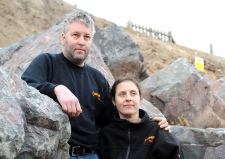
Castaway owners Anna and Richard Hollis at the base of the cliff which has had new sea defence work carried out to protect their holiday park
In the light of the failure of government to protect coastal assets and in the face of escalating man-made erosion, Holiday Park owners Anna and Richard Hollis have just spent £190,000 of their own money on protecting their living. The protection takes the form of 1,750 tonnes of armoured rock, which has been heaped around steel sheet pilings at the base of the eroding cliff.
Anna and Richard are the owners of the Castaways Holiday Park in Bacton, North Norfolk, containing a clubhouse, seven apartments, 35 caravans and three pine lodges, all getting nearer to the edge as the cliff they sit on disappears into the sea. The beach level has been seriously drawn down, the sand cliff dropping and the steel pilings collapsed, undermining the cliff. There estimate is that about four metres of cliff top has disappeared over the past three years. The couple had been told that they would lose their cliff-edge caravans this year when all attempts to get help with funding failed, so they decided to go it alone.
So far, unlike others who have provided their own protection, they have not been stopped by those who support the retreat of the coast. Neither North Norfolk District Council, the EA or the EN have commented. Peter Boggis who protected his Easton Bavents home by fronting the cliff face with 250,000 tonnes of clay at his own cost had every form of official opposition possible, culminating in the High Court. (See numerous mentions in our archived Latest News by using our Search MARINET facility). Mike King of Scratby was initially accused of 'depositing waste' by Great Yarmouth Borough Council for placing biodegradable flora to protect the cliff face, while Pat Gowen had his planted marrams and chestnut fencing on the Hemsby Dunes destroyed and burned by vandals. But Michael Kennedy, who has been throwing stones and boulders against Hunstanton cliff for two hours each day, six days a week, for the past 14 years, in a one-man bid to create a tidal barrier and protect it from erosion, has received nothing but congratulatory support.
U-turn over oil tanker transfer plan?
At a meeting organised by the Southwold and Reydon Society strongly opposing the creation of an oil tanker transfer zone off the Suffolk coastline, Suffolk Coastal MP Therese Coffey, who earlier fully supported the zone, told Southwold residents that shipping minister Mike Penning is now considering banning tankers from anchoring off the town and that the proposed oil transfer zone may be moved away from Southwold so giant vessels, some weighing up to 300,000 tonnes, will not be able to drop anchor off the picturesque resort. But accused of not doing enough to protect Southwold from the tanker threat, she would not say she supported an outright ban on tanker transfers in British territorial waters, yet that her preferred option was for transfers to take place in harbours and if that was not possible then the operations should take place under tighter regulations.
Very strangely, James Reeder, Vice-chairman of Waveney and Lowestoft chamber of trade, said they supported the creation of the zone as tanker transfers contribute £5m to the local economy and double-hulled tankers meet strict safety standards
The meeting was told that there could be a 30% chance of a major spill in the Sole Bay area over the next 25 years if the zone was approved, and that last year there were 278 transfers off the coast between Lowestoft and Southwold, compared to only 13 in 2007.
The Southwold and Reydon Society, who around Southwold itself gathered 1277 signatures on a petition that has now been sent to Shipping Minister Mike Penning along with the 376 signatures received by e-mail.
A report by Anthony Carroll was published in the Eastern Daily Press of Monday 14th March 2011.
On 6th March '11 MARINET wrote the following letter to Shipping Minister Mike Penning and the Department of Transport (DfT) objectiing to permitting Ship to Ship Oil Transfers off the Suffolk Coast.
Major tidal energy scheme set for waters off Islay
A £40m major tidal energy project that will generate 10 Megawatts, enough electricity to power more than 5,000 homes, is soon to be built in the Sound of Islay just off Scotland's west coast. The island offers not only strong tidal flows but shelter from storms, as well as the required grid capacity to handle the array.
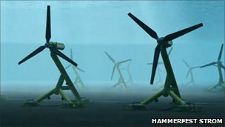
The Islay scheme will see an array of 10 tidal turbines generating power
The Scottish government is all set to approve plans for 10 tidal turbines off Islay, which is will become the world's largest similar installation. The 'tide farm' will employ Hammerfest Strom models which have been successfully operating as a generating prototype in Norwegian waters for more than six years.
With around a quarter of Europe's potential tidal energy resource and a tenth of the wave capacity, Scotland's seas have unrivalled potential to generate green energy, create new, low carbon jobs, and bring billions of pounds of investment to Scotland. The tidal energy industry is growing fast, so Islay's project could soon be dwarfed by much larger schemes planned for the powerful waters of the Pentland Firth.
Scotland and the UK generally are becoming seen as world leaders in tidal energy research, and the US and Canada are now both investing heavily in this field.
European Commission loses Urban Waste Water Directive (UWWD) UK case
From the Allbusiness website at www.allbusiness.com and from the ENDS report 336 pages 12-13 comes the basis of the following news.
The UK government was taken to the European Court on failure to meet the 1991 91/271/EEC Urban Waste Water Directive, a long running source of dispute. (Google 'UWWD' for the history on this website).
The case dates back to a Commission report in 2001 which found that the UK had not designated the Humber, the Wash, the Deben and Colne estuaries in East Anglia, the outer Thames Estuary, Southampton Water and the north east Irish Sea, or provided the necessary level of treatment (see ENDS Report 323, pp9-10). The commission maintained the UK had failed to designate several coastal and estuarine waters as sensitive to over-enrichment or eutrophication nor to provide advanced wastewater treatment facilities, such as nitrate and phosphate removal at sewage works discharging to those waters. The directive requires that works serving populations of 10,000 or more and discharging to these sensitive waters be fitted with such facilities by 1998. The UK has long resisted the challenge from the European Commission and has maintained its own interpretation of the 1991 EU Urban Wastewater Treatment Directive.
The directive sets four criteria for defining eutrophication, these being that the waters are enriched by nutrients, that these are causing accelerated growth of algae or other plants, that this is undesirably disturbing the balance of aquatic organisms and/or impairs the water quality. The lengthy judgement, delivered on 10th December, considered the evidence for whether each of these waters could be classified as eutrophic, or liable to become so, between 1993 and 1997
In most cases, there was no question that there were high levels of nutrients in the waters in question, or that algae levels were elevated. But it could not be demonstrated that there were consistent disturbances to the balance of organisms and the water quality related to eutrophication. However, the court did find abundant instances of marine algal blooms, mats of algae covering the foreshore of estuaries, problems with diarrhetic shellfish poisoning, loss of eel grass beds and wide fluctuations in dissolved oxygen levels. But in no case did the court find evidence that these were so frequent, extensive and persistent so as to prove eutrophication.
Perhaps surprisingly, the UK government won the European Commission's key case on the need for sewage nutrient removal and whether coastal and estuarine waters were eutrophic, so obviating the need for additional (tertiary) sewage treatment to remove the offending nutrients.
The outcome came as a relief to the water industry and government. A spokesman for DEFRA said: 'We're pleased with this decision. Water quality in England and Wales is better than at any time since the industrial revolution, and we are still working on improvements.'
Sad news for the eco-system, the environment and public health, but good news for the water companies and those who profit from them.
Largest kite-powered vessel to be operational next year
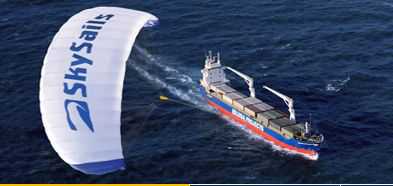
Cargill (global transporter of agricultural, energy and industrial commodities) has signed an agreement with SkySails to use wind power technology to reduce greenhouse gas emissions in the shipping industry. SkySails, based in Hamburg, has developed innovative technology that uses a kite which flies ahead of the vessel and generates enough propulsion to reduce consumption of bunker fuel by up to 35% in ideal sailing conditions.
Next December Cargill will install the 320m2 kite on a vessel of between 25,000 and 30,000 deadweight tonnes making it the largest vessel propelled by a kite in the world. Cargill and SkySails aim to have the system fully operational in the first quarter of 2012.
The SkySails kite will be connected to the ship by rope and is computer-controlled to maximise the wind benefits. The kite functions at a height of between 100 to 420 metres and flies in a figure of eight formation. The SkySails system is automated and requires only minimal action by the crew.
According to a United Nations (International Maritime Organisation) study, up to 100 million tonnes of carbon dioxide could be saved every year by the broad application of the SkySails' technology on the world merchant fleet. This figure would equate to 11% of the CO2 emissions of Germany.
Climate change threatens a 'militarisation' of the Arctic, warns US Navy
America urgently needs to build up its military readiness in the Arctic where melting summer sea ice is setting up a global struggle for resources, a study prepared for the US navy has warned. The report by the National Academy of Sciences warned that climate change could upset the delicate security balance in the Arctic — even among close allies — and that America is unprepared for the challenges ahead.
"The US military as a whole has lost most of its competence in cold-weather operations for Arctic weather," the report, National Security Implications of Climate Change for US Naval Forces, warned. "In the immediate term, the navy should begin Arctic training and the marine corps should also establish a cold weather training programme."
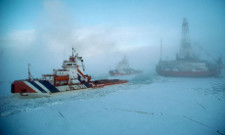
Icebreakers in the Arctic. Melting summer sea ice is setting up a global struggle for resources in the Arctic. Photograph: Richard Olsenius/NG/Getty Images
The report warned that America was currently unprepared to defend its interests in the Arctic. Current submarine systems would be challenged to operate in the Arctic, the report warned. In addition, the coastguard has just three ice breakers, and these are old and obsolete.
It went on to call on the navy to develop an Arctic observer and research service, with remote sensing equipment such as satellites and drones.
"Even the most moderate predicted trends in climate change will present new national security challenges for the US navy, marine corps, and coastguard," said Frank Bowman, a retired US navy admiral and co-chair of the committee that produced the report. "Naval forces need to monitor more closely and start preparing now for projected challenges climate change will present in the future," Bowman said.
The report said that it expected large stretches of the Arctic to be ice-free in the summer by 2030, if current rates of ice loss continued.
Competition for oil and gas in the region was bound to increase, the report said. Last year, Scottish oil producer Cairn Energy confirmed it had found oil off the coast of Greenland and one of Nato's senior commanders warned the race for resources could lead to conflict.
"The geopolitical situation in the Arctic region has become complex and nuanced, despite the area being essentially ignored since the end of the Cold War," the report warns.
Between them, the countries sharing the Arctic, which include the US, Canada, Denmark, Norway, Russia, Iceland, Sweden and Finland, have a number of unresolved disputes — over boundaries as well as resources, the report warned. Although the report acknowledged the potential for conflict in the Arctic was low, it warned: "Co-operation in the Arctic should not be considered a given even among close allies."
The report, four years in the making, reflects growing concern in US military and strategic circles about the security implications of climate change. In addition to the looming security challenges in the Arctic, the report warned that $100bn in navy installations were at risk from rising sea levels.
All three branches of the US military have been looking at ways to get off oil — through testing biofuels on jet fighters or deploying solar technology in combat zones such as Afghanistan.
The navy has adopted a goal of deriving only 50% of its energy from fossil fuels by 2020. Much of the other half will come from nuclear power, though the navy has also committed to buying stocks of camelina, a crop like canola [oil seed rape].
One prime motivator of the switch is cost, and the volatility oil prices. "For every dollar the price of a barrel of oil goes up, the navy spends $31m more for fuel," the navy secretary, Ray Mabus, told a seminar this month. "Our dependence on fossil fuels creates strategic, operational and tactical vulnerabilities for our forces." The army and marines have also long been concerned that fuel convoys are highly vulnerable to roadside bombs.
Melting of ice sheets threaten to raise sea level 1ft by 2050
Ice sheets are now the largest contributor to rising sea levels, a new report has found. If ice sheets continue to melt at their current rates, sea levels may rise over 12 inches in the next four decades.
The study was conducted over the course of 20 years, and the results will be published in the journal Geophysical Research Letters [www.agu.org/journals/gl]. The group of researchers examined monthly satellite measurements between 1992 and 2009, using climate model data. The research shows that in 2006, Greenland and Antarctic ice sheets lost a combined mass of 475 gigatonnes — this ice loss can raise the global sea level by 1.3 millimetres per year.
Unfortunately, 2006 was not just a fluke occurrence. As ScienceDaily [www.sciencedaily.com/releases/2011/03/110308150228.htm] explains, ice sheets are melting at a steadily increasing rate. Over the course of the study, the ice sheets lost about an additional 36 gigatonnes per year, compared to each year before.
Melting ice caps have often taken the spotlight, but melting ice sheets are now dwindling at a faster rate than the ice caps and glaciers. While ice sheets extend for over 20,000 square miles, ice caps are defined as areas of less than 20,000 square miles. Though melting ice caps are certainly worthy of concern, their rate of loss has been three times smaller than the acceleration rate at which ice sheets are melting. The report's lead author, Eric Rignot of NASA's Jet Propulsion Laboratory, is not surprised that ice sheets will now contribute the most to sea level rise. But, Rignot remarks, "What is surprising is this increased contribution by the ice sheets is already happening. If present trends continue, sea level is likely to be significantly higher than levels projected by the United Nations Intergovernmental Panel on Climate Change in 2007." The trends suggest that by 2050, melting ice sheets could raise sea levels by nearly six inches — this amount is then added to predictions for melting ice caps and ocean thermal expansion. The resulting calculations find that sea levels could rise 12.6 inches by 2050.
How would these rising sea levels affect us? Another recent study, reported in the journal Climate Change Letters, shows that rising sea levels may threaten 180 U.S. cities [www.huffingtonpost.com/2011/02/17/rising-seas-threaten-us_n_824482.html] by 2100. This study was based on projections that sea levels will rise by about three feet within the next century. Cities such as Miami, New Orleans, and Virginia Beach are expected to lose over 10 percent of their land. New York and Washington D.C. are also expected be impacted, though to a lesser degree.
U.N. reports have predicted that because of climate change, the world will have 50 million environmental refugees by 2020. That's less than 10 years from now.
Climate change not only leads to rising sea levels, but it also is linked to droughts, flooding, and food shortages. As ice sheets melt at a faster pace, environmental refugees flee their homes, and major cities sink underwater, will climate change finally be taken seriously by everyone?
Underwater kite-turbine may turn tides into green electricity
Swooping a turbine through the sea's currents could be a cheaper way to harness the power of the oceans. And that's what an underwater kite-turbine, being developed by Swedish company Minesto does.
They will do the first sea trial in Strangford Lough in Northern Ireland this summer. The kite, which at full size will have a wingspan of 8-14 metres, carries a turbine below it. The kite is tethered by a cable to the sea floor and then "flies" in the tidal stream. It swoops round in a figure-of-eight shape to increase the speed of the water flowing through the turbine tenfold (see company video below), just as sailing boat cuts across the wind to go faster.
That manoeuvre means the kite can generate renewable electricity in tidal streams that would be too slow to drive the first-generation tidal devices, such as the SeaGen turbine also installed in Strangford Loch. The kite has neutral buoyancy, so doesn't sink as the tide turns and the turbine mouth is protected to stop fish flying through.
Company video showing the figure-of-eight flying pattern of the tidal kite.
Petition against Oil transfers off the Suffolk Coast
Readers are invited to sign the petition at www.gopetition.com/petition/43090.html emanating from the Southwold Pier Group and Southwold and Reydon Society to support the campaign opposing the ship-to-ship oil transfers. Their website is at www.southwoldandreydonsoc.org.uk/news/index.php. If you are able to push the on-line petition out further they would be very grateful.
It would also be most helpful if you could subscribe to the government consultation by writing to:
Godfrey Souter
Shipping Policy 3
2/33 Great Minster House
76 Marsham Street
London SW1P 4DR
The impact of Oil Spill
The truly amazing decision of the government in aiding and abetting the transfer of oil between tankers moored off the Suffolk coast, whilst at the same time terminating the Coastguard at Great Yarmouth shows what little understanding there is in Westminster of the potential consequences of a major oil spill. (See 'Ship-to-Ship Oil transfers given go ahead at www.marinet.org.uk/archive/archivelatestnews2011.html#sotg and 'Oil transfer off Southwold — the latest outcome' at www.marinet.org.uk/archive/archivelatestnews2011.html#otos).
Jason Palmer, BBC News Science and technology reporter in Washington reported on 21st February 2011 how the 2010 Deepwater Horizon oil spill of millions of gallons had utterly devastated life on the sea floor, and how it is that the full effects of the spill may not be seen for ten more years yet. His source was Marine Scientist Professor Samantha Joye of the University of Georgia, who told the American Association for the Advancement of Science Conference in Washington her study findings made using the Alvin submersible to explore the bethnos, the bottom-most layer of the water around the well head.
Professor Joye disputed the claim made by BP that the Gulf of Mexico would recover by the end of 2012, which assessment was focused on surface oil, as she found areas of sea floor where the layer of oil and dead animals are 10cm thick, pointing out how knocking these animals out of the food chain will, in time, affect species relevant to fisheries. Her estimate was that it would be 2012 before we even begin to really see the fisheries implications and repercussions from this.
She said "The impact on the benthos was devastating. Filter-feeding organisms, invertebrate worms, corals, sea fans — all of those were substantially impacted — and by impacted, I mean essentially killed. Another critical point is detrital feeders like sea cucumbers, brittle stars that wander around the bottom. I didn't see a living (sea cucumber) around on any of the wellhead dives. They're typically everywhere, and we saw none." She pointed out that after the Exxon Valdez spill, it took several years before it became clear that the herring industry had been destroyed.
Community partnerships and coastal defence
Suffolk Coastal Council has pioneered an early example how the government's latest idea of community partnership working together with them, in this case in defending the district's coastline by gaining the full £660,000 of funding necessary to complete a project critical for the future protection of Thorpeness on the Suffolk Coast. On 22nd February they published the full details entitled 'Community partnerships leading the way in coastal defence' on their website that can be read in full by visiting www.suffolkcoastal.gov.uk/news.
It rather optimistically describes how Suffolk Coastal Council have committed some £89,000 to the project, with the residents and community providing about £137,000. The good news claimed is that the Environment Agency will back this with up to £431,000, meaning that if all comes to fruition the work necessary to keep Thorpeness safe for the next 50 years should soon be completed.
The locals are watching progress with interest to see developments, and are not yet exactly 'counting their chickens before they are hatched'.
Greenland oil exploration to proceed, but latest Falklands' exploration well is 'dry'
Cairn Energy could begin drilling for oil in Greenland in April this year, two months earlier than the usual start of the season.
Analysts said that they expected the Greenland authorities to extend the period when oil companies can begin exploring for oil, which is limited because of safety concerns over the icy winter conditions.
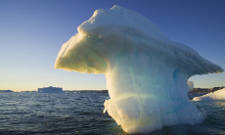
Cairn Energy plans to start drilling in Greenland in April two months before the season normally begins. Photograph Theo Allofs/Corbis
It is thought that the FTSE100 company, which announced its new Greenland drilling programme for the year, will first drill in virgin waters off the south coast, where ice melts earlier in the year. It will then restart activities in Baffin Bay, which lies further north just within the Arctic Circle, in June. The drilling season in Greenland normally runs between June and the end of September.
Greenpeace, which opposes the opening up of Arctic regions to oil exploration, said last night said: "Conditions, whether in April or August, mean drilling is going to be a huge risk for the environment and for investors." The environmental group disrupted drilling for two days last August when four activists managed to board Cairn's drilling rig, the Stena Don. Greenpeace then claimed victory in October when Cairn admitted that it had spent $185m (£119m) during the season and only managed to complete two wells, neither of which resulted in a commercial discovery despite traces of hydrocarbons being found. Shares plunged by more than 7% on the news.
The company has announced that it has secured two rigs to drill up to four wells in Greenland waters this year, subject to approval from the authorities. It did not say when or where they would operate.
Analyst Richard Rose from Oriel Securities, the stockbroker, said: "Cairn seems confident that the window for drilling in its southern Greenland acreage would be open for a wider period. We expect the Greenland authorities will allow drilling to take place probably in April because there are not the same ice issues as in Baffin Bay. But it's never been drilled before."
He added that there was still a slim chance of success. "Drilling in Greenland is still seen as high risk given the lack of drilling to date and frontier nature of the acreage. It's a huge opportunity but I wouldn't describe the market as being confident that it will make a commercial discovery. After some positive drilling results last year, I'd say the odds have gone from 20-1 to 10-1."
Cairn has been accused of talking up its prospects there. Another analyst, who did not want to be named, said: "The company is probably more optimistic and bullish about it than I am at the moment."
There was less good news for rival oil company Desire Petroleum which was struck again by the Falklands curse. The Aim-listed explorer admitted that the fourth well it has completed since February off the north coast of the islands came up dry. Shares closed 26% down on the news, adding to losses sustained last month when it revealed that a prospect contained water and not oil. The company has enough cash to drill one well and carry out seismic surveying of its acreage adjacent to the only commercial find to date, by rival Rockhopper.
Peter Hitchens from Panmure Gordon, who covers Rockhopper, said: "Desire has been unlucky. They are starting to run out of cash a bit."
Oriel Securities' Rose said: "It's looking pretty poor for Desire Petroleum. The infill seismic survey they will undertake to the south of Rockhopper's Sea Lion discovery is key and might throw up an extension to the field or new prospects. Apart from that, the prospect inventory looks weak."
The company's only assets are the rights it owns to drill some blocks off the Falklands.
"Shale gas" found near Blackpool, Lancashire
Blackpool could become the new Houston if an experimental "shale gas" well being drilled in the north-west of England turns up the same stellar results that have been seen in America.
Lord Browne of Madingley, the former BP chief executive, is one of the backers of Cuadrilla Resources, which will start operations on a geological formation that stretches from Pendle Hill to the Lancashire coast near Blackpool.
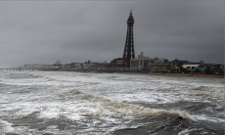
Extracting shale gas near Blackpool would reduce the need for imports as North Sea gas supplies dwindle. Photograph: Christopher Thomond
The well being drilled is the first of its kind in Britain and comes after discoveries of huge reserves in the US promised to transform the energy landscape there and sent gas prices plummeting.
In an interview with Channel 4 News Chris Cornelius, the founder of Cuadrilla, said that in future shale gas could reduce the need for some imports into Britain as North Sea supplies run down. "It's very early days," he said. "It will take a lot of exploration and a lot of effort by small companies like us, and larger companies as well, but ultimately we are hopeful that we would find certain deposits here that would add to the net reserves of the UK."
The Financial Times recently claimed that shale gas would "change the world". The American finds have scuppered the plans of Russia and other countries to start exporting gas to the energy-hungry US.
Any kind of gas is a relatively carbon-friendly alternative to oil, and countries around the world are keen to find their own supplies that will help to limit climate change while also providing energy security.
But shale gas comes with its own environmental problems. The gas is reached by drilling wells deep into rock formations, which are then "fractured" or broken up with the aid of water and heavy chemicals, to release tiny pockets of trapped gas. The US Congress is currently investigating the potential threat posed by these substances to local water supplies but the big oil companies have no doubt that shale gas is the new oil rush.
Royal Dutch Shell has just bought a shale gas expert, East Resources, for $4.7bn (£3bn), while Shell has started to drill for shale gas in Sweden, and ConocoPhillips is drilling in Poland.
There have been no big discoveries yet in Europe but Cuadrilla is confident that it can make a strike in Britain. The company is backed by some of the most canny financial players in the world: the Carlyle Group, the private equity firm at which the former British prime minister John Major used to have a seat on the board, and Riverstone Holdings, where Browne is UK managing director.
Chris Cornelius told Channel 4 that his company had taken care to involve the Health and Safety Executive (HSE) and other agencies to ensure that there would be no major problems attached to the drilling process. "There are certain cases in the US where certain operators have been documented as having some issues, and they do exist. But I think we have done everything here working with the HSE and the Environment Agency in the UK to ensure that doesn't happen on Cuadrilla's location," he said.
A programme shown last month on HBO, the US cable television network, documented some alarming and spectacular pollution incidents allegedly caused by shale gas drilling — including tap water apparently so contaminated with methane gas that it caught fire. However, the Washington-based environmental thinktank the Worldwatch Institute argues that hydraulic fracturing is not necessary polluting — and insists that most of the documented incidents are the result of clumsy drilling and poor regulation.
Shale gas is nothing new; the innovation lies in the development of new methodology for extracting it — for example, allowing mining companies to drill horizontally as opposed to vertically. Twenty years ago, British Gas drilled a couple of exploratory wells in the north-west in an attempt to extract gas in commercial quantities.
Chris Cornelius said: "They penetrated through the Bowland shale [part of the same geological formation that extends to Blackpool], and the old indications were that there was gas in that shale. So we decided that this area would be prospective, and after about a year's worth of work we decided that this was the place to start." He added: "We're quite confident that we'll find gas — it's just whether we find gas in economic quantities. I don't think we'll ever be like the US, but I think there will certainly be the possibility that we'll find significant volumes of gas in various parts of Europe, which will be potentially commercial. It could help offset imports into Europe by a certain percentage, about 5% or 10%, if we're successful."
Sales of sustainable seafood soar in UK supermarkets
Sales of "alternative" species of fish and seafood have soared after being championed in Channel 4's new Fish Fight campaign, the UK's leading supermarkets reported today.
Consumers are favouring coley, dab, mussels, squid and sardines over the staple salmon, cod and tuna following Fish Fight programmes which highlighted the wasteful use of "discard" in fishing practices while encouraging shoppers to take the pressure off popular fish stocks by being more adventurous in what they eat.
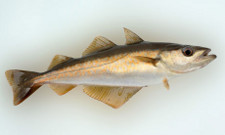
Atlantic pollock or coley fish (Pollachius virens)Sales of sustainable fish species such as Atlantic pollack have soared. Photograph: Alamy
The cook and Guardian writer Hugh Fearnley-Whittingstall, credited with boosting demand for higher-welfare chicken three years ago, has taken the lead in the new campaign. Programmes from fellow chef Jamie Oliver have shown consumers new ways of cooking less popular species such as mussels, squid and trout.
Sainsbury's said sales of "bycatch" from its fresh fish counter had been "promising" overall, while sales of pollack had leapt by 167% week on week. It said customers had responded well to the fish featured in Jamie Oliver's programmes with sales of British and MSC-certified mackerel up 60% and mussels up 16%.
Sales of its sustainable "line and pole caught" canned tuna increased by 17% over previous weeks, while sales of organic salmon grew by 16% and normal salmon sales remained unchanged.
Tesco, the UK's biggest fish retailer, said it had seen an increase in sales of between 25 and 45% for fresh sardines, coley, brown crab, sprats and whiting in the week since the first programmes. It said in a statement: "We sell around 40 species of fish on our fresh counters and our staff are trained to advise customers on trying new varieties. Sales of fresh cod, herring, mussels, mackerel and canned tuna also increased compared to last week."
But the supermarket was singled out by Fearnley-Whittingstall for misleading labelling on its canned tuna, leading the company to pledge to catch 100% of its own-brand canned tuna using the "pole and line" method. Tesco last week came fifth out of the major supermarkets in a 2011 league table of sustainable tuna, compiled by Greenpeace.
Waitrose said sales of seafood overall were up by 15% — with most of this increase being attributed to species that have traditionally been less popular. Sales of frozen coley were up by 36%, frozen mackerel up 31% and Dover sole up 163%. A spokeswoman for Waitrose said: "There has also been strong demand for dabs, which we sell frozen. This week we are launching sprats (a fish that has almost been forgotten by UK consumers) and are looking at introducing dabs and coley on our service counters over the coming weeks. We are also introducing Welsh flounder — a species commonly discarded."
Ally Dingwall, aquaculture and fisheries manager at Sainsbury's, said: "Fish Fight has had a direct impact on consumer behaviour. It's encouraging to see a positive shift towards less popular and bycatch fish, and if we can establish continued demand, fishermen will land and sell more of these species, and it may potentially become targeted species. In the last week, our fish sales have risen across the board: from fresh to counter to frozen fish."
Asda reported "really strong sales across the whole of the fish category in the last week, up 10% on the previous week" with particular growth in the sales of products included in Jamie Oliver's recipes. Sales of trout fillets, for example, rose by 56%, whole sardines 66% and whole mackerel up by 115%.
Marks & Spencer said it had ordered in over a third more stock than it did for its peak Christmas week. Richard Luney, M&S fish expert, commented: "We had our biggest ever week in the history of M&S on fish sales last week, sales were up 25% versus this time last year. One of the key highlights was on our line-caught tuna that had a record week — so the importance of avoiding purse seined [a large net that catches entire schools of fish] fishing methods obviously really hit home."
As part of the Fish Fight campaign, consumers have been urged to add their signatures to a letter to the European fisheries minister, Maria Damanaki, calling for the elimination of discards to be elevated to a top priority in the forthcoming review of the European common fisheries policy. Even before the programmes were aired, the letter attracted over 35,000 signatories but this has now risen to well over 500,000. Fearnley-Whittingstall urged consumers: "Please keep spreading the word. Half a million supporters today — less than a week after our shows went out! I wonder if a million sign-ups is a crazy dream… what do you think?"
Coastal erosion discussion in parliament
The the Coastal Erosion All Party Parliamentary Group (APPG) now chaired by Great Yarmouth Conservative MP Brandon Lewis met on Tuesday 8th February to discuss coastal policy. Norman Lamb, the LibDem MP for North Norfolk, who earlier held this post, has now been appointed chief parliamentary and political advisor to Nick Clegg MP, the Deputy Prime Minister following the outcome of the 2010 General Election resulting in the coalition government between the Liberal Democrats and the Conservative party.
DEFRA Minister Richard Benyon appeared as guest speaker at the APPG to talk about the government's approach to the funding outlined for flood and coastal erosion management, pledging to spend £2.1 billion on protecting homes in coastal regions over the next four years and also highlighting the importance of the role of the solidarity fund in coastal policy as a safeguard for local communities in immediate danger.
As far as is known the meeting failed to address and discuss the matter of the causes of the continuing loss of houses, businesses, land, beaches and dunes to erosion.
Oil Tanker collision casualty
A new hazard has been evidence by the concentration of oil tankers off the Suffolk Coast.
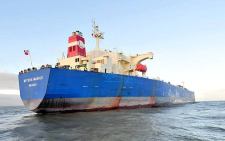
One of the oil tankers moored off the Suffolk coast
Port health officers from Waveney district council visit Oil tankers of the Lowestoft Coast.
Further to our recent item 'Ship-to-Ship Oil transfers' describing the widespread fears that oil tanker transfers offshore to the coast off Southwold could damage the local economy and put the marine and coastal environment at risk, following the public outcry and much controversy, Shipping Minister Mike Penning agreed to open a discussion on his highly controversial proposal.
The Suffolk Coastal MP Therese Coffey revealed that a full public consultation would now go ahead, saying "I have been pressing the minister on this and while it is unusual for a minister to open up consultation on a Statutory Instrument — a delegated legislation made by a minister rather than parliament — he has recognised the strength of public feeling on this." She added that as soon as the public consultation is opened she would provide a link to it on her website.
Concerns were further fuelled this week after an oil tanker, the Singapore Prisco owned 797ft Zaliv Vostok, ran down and crashed into a local fishing boat, the Chloe Page, on the morning of Tuesday 10th February by the allocated tanker 'parking zone'. The tanker caught the smaller boats anchor and started to pull it down until fortunately the cable snapped and to release the fishing vessel, so stopping it from capsizing.
The two fishermen, Richard Morgan and Brian Wright, said they were lucky to be alive after the oil tanker crashed into their boat's bow on Tuesday. They commented "We saw a tanker two miles away and I called him up on the radio, gave him our position and said what we were doing. He confirmed that he would navigate away from us but 15 minutes later he came too close, so I called the radio again but there was no answer. We honestly thought we were going to lose the boat. If the anchor had not parted we wouldn't be here at all."
While the concentration of wind turbines, dredgers, transport to the gas rigs and now the tankers builds up, the government are cutting the coastguard.
Further Seal Casualties
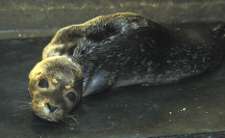
Baffling: Harbour seals are being left weak, starving and barely able to breathe with a disease that is baffling scientists
The Mail's David Derbyshire reported on 10th February with 'Save our seals: Mystery sickness striking down British pups as vets treat double usual number' that can be read in full by visiting here.
The article tells how yet another blight has hit our Harbour Seals of Norfolk, this time a mystery illness that leaves the animals weak, starving and barely able to breathe, emaciated and dehydrated, many with dry eyes and coughing up blood. Marine experts can find no signs of viral disease or bacteria, and one possibility is that the invalids are orphans of those mothers who have been decimated by the 'corkscrew' lacerations earlier reported here. Alternatively, that there are so few fish now remaining in our ailing North Sea that they are suffering as a consequence of malnutrition and starvation.
Perhaps we should not be surprised to see this further evidence of a declining eco-system brought about by an unholy combination of seabed destruction, toxin and pathogen ridden sewage input and unsustainable fishing. The North Sea was once called the English River, later the German Ocean, and more recently the North Sea. How long will it be before it is known as the Dead Sea II?
Plan for local fund to help those made homeless by ongoing erosion
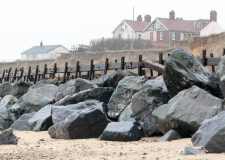
Di Wrightsons' home Cliff House, Happisburgh — The huge Norwegian rocks are to protect what remains of the sea defences
Di Wrightsons' home Cliff House, Happisburgh. She has agreed a price for her home with the district council and will be moving out in March. Her home is right on the cliff edge at Happisburgh.
Plans for a 'DIY' pot of cash to help tackle coastal erosion problems around Norfolk are being promoted by two local MPs, North Norfolk's Norman Lamb and Great Yarmouth's MP Brandon Lewis, who have met with decentralisation minister Greg Clark, who has also given his backing to the idea.
Under the scheme local people would pay a small sum — such as £5 a year — from their council tax which would be ring-fenced for coastal schemes ranging from emergency defences to projects to help erosion hit communities adapt to the changes affecting them. This is not a substitute for government funds, but a chance to provide an extra pot which could give more local control in the future.
The aim was to initiate a debate on the fund idea — which was not a substitute for government funds, but a chance to provide an extra pot which gave more local control over the future as it will allow calling for a referendum on the issue. It supplements agreed compensation deals, using part of the £3m kitty of cash that is part of a government Pathfinder scheme helping coastal communities adjust to their problems.
Agreement reached at disappearing Happisburgh
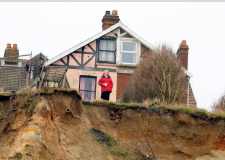
Di Wrightson in what remains of her garden at Cliff House, Happisburgh
Householders whose doomed homes are perched close to the edge of Happisburgh's crumbling cliff have finally struck a deal with North Norfolk District Council (NNDC) to vacate their homes and start anew elsewhere. The breakthrough after some ten years of negotiations has finally agreed compensation payments from NNDC shared between nine of the 12 owners of 13 homes. Negotiations are still under way with another, but the two owners have decided to stay put and not sell to the council. If that remaining deal is concluded, it will have seen the council give out some £725,000 to help the at-risk householders, all from its £3m pot of national Pathfinder cash, given to to help communities threatened with homelessness by the government's decision not to maintain their sea defences.
Amounts paid represent only 40 to 50% of each home's pre-blight value, but will enable most threatened residents to afford safe accommodation elsewhere. Di Wrightson, whose home is metres from the cliff edge as depicted, said that she and business partner Jill Morris would move out next month and that they were looking for rented accommodation somewhere near Happisburgh. Together they ran a guest house and tea garden for 26 years until forced to close five years ago because of the growing threat.
Oil transfer off Southwold — the latest outcome
Readers may recall our last bulletins on the concern of mooring oil tankers off the coast of Southwold, written under 'Offshore Oil Transfer menace slowly being addressed' at www.marinet.org.uk/archive/archivelatestnews2010.html#ootm (and the more recent coverage at www.marinet.org.uk/archive/archivelatestnews2011.html#sotg) and how Suffolk Coastal Conservative MP Dr Therese Coffey signed an Early Day Motion last year to overturn a proposed ban on the controversial practice, despite the fact that her predecessor MP for Suffolk Coastal, John Gummer, had pushed for an outright ban on the transfers. Shipping Minister Mike Penning then announced that the transfer of oil between ships would still be allowed in UK waters off the north Suffolk coast. This is due to come into force in April.
Now the boomerang has come back, with a vengeance! The Southwold and Reydon Society and the town's Chamber of Trade have raised serious concerns about the oil transfers, fearing the potential for disaster in the event of a spillage and the impact on the town's image in the eyes of tourists. Teresa Coffee was confronted by 30 protesting residents at the town's Conservative Club recent AGM, and many in the town were angered.
The net result was that Therese Coffey has now admitted to her regrets in the move and the part she played in aiding and abetting these ship-to-ship oil transfers off Southwold, so appearing to be in much deeper water than the tankers. She said that she understood why people were angry and pledged to seek answers from the Government over why Southwold had been singled out, saying "I said 'look, I hold my hands up — I haven't handled this very well and I should have discussed it more widely'. I have learned from that. I do understand people's concerns and I am trying to get straight answers from the minister about why it's only Southwold — we still haven't got clear reasons." further saying that she hoped to arrange a public meeting in Southwold next month to discuss the issue.
If you would wish to play 'Spot the Tankers', go to www.marinetraffic.com.ais to see the AIS Live Ships Map, using your arrow shift keys to select and click on the number over the Suffolk Coast, and use the zoom keys to home in. The tankers are shown in red, those moored or at anchor ones are indicated with a red diamond. By clicking on these, the details of the name, the exact position, often a picture,etc. will be given in a dialogue box.
Norfolk's local hero fighting coastal erosion
Michael Kennedy, a 73-year-old retired engineer who lives in Hunstanton on the north Norfolk coast, has spent 14 years moving stones across a beach to prevent the erosion of sea cliffs.
For two hours every day (except Saturdays) collecting rocks on Hunstanton beach to construct sea walls as a defence against the erosion that is rampant along this stretch of coast. "I'm like King Canute," he says with a laugh.
How on earth did this strange obsession begin? "I used to walk to Old Hunstanton and back, two and a half miles, every day, but that wasn't enough physical exercise for me. I started moving rocks and now I can't stop." He piles stones at the foot of the threatened cliffs, and reckons to move 40lb of rocks in each two-hour session, always starting at midday regardless of the weather. Over the 14 years, he has put in 9,000 hours' labour and moved 200 tonnes of rock with the largest rocks carefully placed at the bottom designed to survive a battering.
Great Yarmouth tidal energy plan unveiled
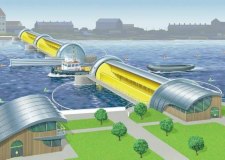
The Tidal Barrier planned for Great Yarmouth
It might seem like science fiction, but developers say this cutting-edge tidal energy harvester and flood barrier could become technically achievable on the River Yare at Great Yarmouth within three years. Lowestoft research and development firm, 4NRG, has already built a 7m-long harvester prototype with the help of a £92,000 grant from the East of England Development Agency and is to begin trials on Lake Lothing next week. The four tonne device, built at Small and Co shipbuilders in Lowestoft, will then be moved to a site on the River Yare for further research within the next few weeks.
Mark Aspinall, a director of 4NRG, based at the Orbis Energy Centre, said that although their technology was world-leading, the principle was simple — the tide passes through the harvester, pushing blades to generate power.
Their first objective had been to build tidal energy generators for use at the site of windfarms to help bring down the cost of producing wind energy. He said: "The whole of the North Sea is very promising because of the strong tidal flow. Tidal energy is more regular than wind and can be harnessed four times a day as the tide goes in and out." Mr Aspinall said their awareness of the region's need for green power and the flood risk on the Broads had made them see the potential of combining the technology with a flood barrier on the River Yare. The Broads Authority is supporting the Yare research with a £7,500 grant from its sustainable development fund (SDF).
Mr Aspinall said: "This would be an opportunity to create tidal defences which would benefit the whole of the Broads. The barriers would help pay for themselves with revenues gained from generating electricity. They would generate a reliable supply of renewable energy in almost any weather and at times of a very high or surge tide, the shutters would close to serve as a flood defence." He admitted that while the Yare device — which would incorporate three harvesters — could be ready to be built within three years, the pace of development would depend on political will.
Council back plan to lose Suffolk village

St Andrew's in Covehithe is threatened by coastal erosion
Plans which would see a village and more than 1,000 acres of land lost to the sea in a scheme for 'tackling erosion in Suffolk' have been backed by Suffolk County Council's cabinet despite the Shoreline Management Plan for the area calling for the continued defence of major towns and villages from flooding and coastal erosion.
The plan, developed by a group of partners led by Suffolk Coastal District Council and backed the Council's cabinet says that over the next 30 to 40 years the historic village of Covehithe and its 15th Century church may be surrendered to the sea. Furthermore, that land and property will be lost at Pakefield and 1,000 acres (400 hectares) of land between Kessingland and Southwold will be lost also.
To MARINET's eyes, it is truly an excellent example of Orwellian 'doublespeak' that aiding and abetting erosion is claimed as being 'tackling erosion'.
On the more sensible side, sea defences at Lowestoft, Southwold and Felixstowe are intended to be maintained, the main area of Kessingland will be protected and the A12 will be defended. The Environment Agency said that shoreline management plans provided a framework for dealing with coastal flooding and erosion risks to people, and that a final decision on the plans will be made by their regional director.
Edward Vere Nicoll, estate manager for The Benacre Estate, which owns a large portion of land at Covehithe and the surrounding area, criticised the plan. He accepted the need for a "managed retreat" of the coast, but not for the wholesale "sacrifice" of large tracts of land and a village, saying "Local people are all pretty disgusted and seriously worried about it".
Grave Concerns of Gt. Yarmouth Harbour
The grand plans and expectancies earlier voiced for the new harbour at Great Yarmouth appear to have sunk. The £18m of public funds invested in the £80m project have fallen upon stony ground whilst the Borough Council land lost as the West Quay, a remunerative caravan site and a car park now gone. The whole plan and its outcome are now coming under severe criticism by some who wish to see a Public Enquiry and those complaining of the erosion created when it was deep-dredged for the big ships.
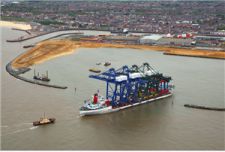
Great Yarmouth's outer harbour — Cranes entering Harbour direct from China
The claimed intention was to have a roll-on roll-off ferry, container handling and freighting, the latter with two massive £7m cranes specially imported from China. But now the original concept has been abandoned. The cranes have been dismantled and its use as a container port and ferry terminated with its future use limited to the offshore industry. It is now owned and run by private companies port Eastport UK and its parent company International Port Holdings (IPH) so leaving a huge burden on the ratepayers with no foreseeable advantage.
The first few ships to arrive withdrew due to the pitch and roll encountered, as the port, open and exposed to the easterly winds, gave swell thought to be too hazardous to moored shipping.
More Seal Mutilations — can you help?
The corpses of four more seals were discovered between Wells, Morston and Blakeney along an eight mile stretch of the North Norfolk Coast last month, taking the total number of similar mortalities to 45. Three of those recently discovered showed, like their predecessors, deep corkscrew type lacerations as a single, smooth-edged cut starting at the head and spiralling around the body. (see 'Latest on Seal Deaths' at www.marinet.org.uk/archive/archivelatestnews2010.html#ltsd and the earlier www.marinet.org.uk/latestnews.html#lots with references).
It is suspected that many more than those accounted for may have been killed but not found. So far the cause of the mutilation remains unproven, although it is very apparent that the cuts are mechanically created. The investigation has now been taken over by the Marine Conservation and Enforcement Team of the Marine Management Organisation They are working with the Sea Mammal Research Unit, Natural England, the Eastern Sea Fisheries Joint Committee, the Crown Estate with input from MARINET and others during the course of the investigation.
In an effort to resolve the enigma, the MMO are seeking aid from the public in their quest, and are asking anyone with information regarding these incidents, or their possible cause, to contact the MMO's Marine Conservation and Enforcement Team on Newcastle on 0191-376 2512. All information given will remain confidential and callers can remain anonymous, if requested. Neil Wellum, head of Marine Conservation and Enforcement at the MMO, said: "We are keeping an open mind on all possible causes as we collect information from as many sources as possible. We would welcome any information from residents around this area of coastline as part of our ongoing investigation."
Marine Management Organisation oppose a dredging
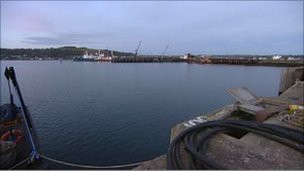
Falmouth Harbour
To the delight of local protest groups, the area's oyster protection association and MARINET alike, a £20m plan by the harbour's commissioners to dredge Falmouth harbour to remove tonnes of silt from the seabed so that bigger ships could use the port has been blocked by the government's Marine Management Organisation, who said that dredging could harm maerl [algae] beds which act as a nursery for commercial fish stocks.
Although it may be more likely that the ruling may have been dictated by the cuts and economic reasons, it is nevertheless good news for the marine environment and an unexpected surprise.
Funding for sustainable energy scheme cut
…first you see it — now you don't
On Monday 24th January the Broads Authority proudly announced the 'Tidal Harvester', developed by research by 4NRG, based at the OrbisEnergy centre in Lowestoft, who were given a £7,500 grant last year by the authority to develop the strategy for sustainable energy creation. The device would have been installed offshore where it would feed electricity back to the grid and further serve to help prevent stormy weather heightened waves from stripping beaches of protective sand.
That was the good news, sadly soon to be followed on the same day with the bad news that the Sustainable Development Fund (SDF) budget which would have allowed this and many other similar projects to come to fruition was to be slashed, cut from the original £200,000 a year to just £150,000 for the next three years.
Whitburn Waste War escalates
In addition to taking up the cudgels with the Environment Agency over the dumping of dredged port contaminated waste and the continuing passage of untreated sewage to the sea at Byer's Hole, Souter, Bob Latimer of Whitburn has now taken up opposition the plan to discharge waste mining water to the sea.
The slurry emanates from the Westoe and Wearmouth collieries that closed in 1968 then to be used to dump waste and slurry for over twenty years. It is feared that the millions of untreated gallons to be disposed to the sea could contain a cocktail of toxins that could prove to be damaging to the marine environment.
Hope for Walberswick?
Farmer landowner Andrew Blois, Suffolk chairman of the Country Land and Business Association, who has long been fighting to save some one hundred acres of land and forty houses around the Blyth estuary from the sea, reports that much more progress has recently been made with DEFRA and the EA in combining private and public funding to prepare for a major rebuilding of the river walls on his land at Walberswick, hopefully to commence in the next few months.
Whilst swathes of Suffolk coastline, much of it being Area of Outstanding Natural Beauty and Sites of Special Scientific Interest. around the Deben, Alde and Ode estuaries remain under threat due to defence underfunding, at least it appears that some may yet be saved for posterity by a similar venture. Already some work has been carried out to repair Tinkers Marshes in delightful Walberswick.
Ship-to-Ship Oil transfers given go ahead
Just as if the sea off East Anglia hasn't enough threats to its sea and beaches already, we now have the prospect of major oil spills.
In July this year MARINET reported that Parliamentary Under-Secretary of State for Transport Mike Penning announced a review allowing all views on offshore Suffolk ship-to-ship oil transfers to be heard ahead of proposed legislation banning such transfers in British waters. The law was due to come into force from 1st October 2010, but was pushed back to 1st April, 2011, allowing local authorities, industry and environmental non-governmental organisations to all give their view by 30th September. But just prior to this Waveney MP Peter Aldous and Suffolk Coastal MP Terese Coffey had signed an Early Day Motion (EDM) calling for the new laws banning all ship-to-ship transfers off the Suffolk coast to be scrapped. (See 'Offshore Oil Transfer menace slowly being addressed' at www.marinet.org.uk/archive/archivelatestnews2010.html#ootm)
Last November, then Secretary of State for Transport Lord Adonis moved to cease transfers in UK waters. But now, placing oil company profits paramount to environmental security, new Shipping Minister Mike Penning has announced that instead of a general prohibition, all ship-to-ship transfers outside harbour authority areas will be restricted to a single designated area off the north Suffolk coast, so making the threat even greater to the most environmentally sensitive part of our coastline. He claimed "Ship-to-ship transfer operations have been common in UK waters for many years with a generally excellent safety record". There is outrage in the local population who are very angered by the reversal in favour of the oil companies.
So now the sea between Lowestoft and Southwold is to become the sole area for more than 50 small tankers bringing oil from Russia to transfer their cargo to larger vessels unable to negotiate the Baltic Sea. At the time of writing 32 tankers are currently moored off Southwold. By this now approved strategy, as well as risking serious pollution, they will be able to avoid port duties, the use of local labour and round the year income for the catering establishments and hotels whilst sitting on oil stocks waiting for the price to escalate. Further to this, by limiting supply, the cost of fuel will escalate anyway, so providing even further revenue to the increase already applied by the government.
Waveney District Council promises relocation for people in Corton and Easton Bavents
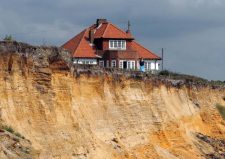
Erosion at Easton Bavents. Photo: Andy Darnell
An article by Anthony Carrol in the Lowestoft Journal of 20th January entitled 'Policy will help north Suffolk families threatened by erosion' tells that Waveney District Council is to set in stone a lands right move promised for people in Corton and Easton Bavents who face imminent loss of their housing to severe advancing coastal erosion.
It proposes that the threatened residents can move to safe land nearby and still keep residential land use so that they can build similar properties if they follow relevant planning law. The land rights transfer, one of the first nationally, is part of a new planning policy covering housing, tourism, employment, sustainable design and the environment.
It is hoped that a similar humane policy will be adopted by the Councils of Essex, Norfolk, Lincolnshire and Yorkshire too where similar situations exist. It is further hoped that the Councils come out and oppose the offshore aggregate dredging mainly responsible for the loss.
The full article can be read here.
Great Yarmouth Coastal System evolution report from Crown Estate
The Crown Estate have a new report on the sediment dynamics on the Great Yarmouth coastal system and its geomorphic evolution, composed by a Crown Estate-Caird Fellowship at the National Maritime Museum and Hannah Evans of the British Geological Survey. It covers the historic changes in the Great Yarmouth spit and the related coastal system and is intended to provide a better understanding of the past, current and future mobility trends. The findings are taken from map and aerial photograph evidence.
A few errors are present, one of which was "between 1800 and 2007 Winterton-on-Sea experienced accretion" when in fact, although accreting until the 1960's, the Winterton coastline began to rapidly erode within two years of the onset of mass offshore aggregate dredging in 1984, as can seen by the correlation graph and the time lapse photographs placed at the end of MARINET's briefing at www.marinet.org.uk/mad/madbrief.html where the rate of erosion is displayed. (The authors have been made aware of this).
The report may be read from Evans, H. (2010) 'Geomorphic evolution of the Great Yarmouth coastal system: spit sediment dynamics and forcing mechanisms'. The Crown Estate, 54 pages. ISBN: 978-1-906410-22-3 or downloaded by Internet from www.thecrownestate.co.uk/mrf_aggregates.
For further information or discussion contact: Prof Mike Cowling, Chief Scientist, The Crown Estate, 16 New Burlington Place, London, W1S 2HX, mike.cowling@thecrownestate.co.uk Tel. 020-7851 5032.
Why The Boom Times Ended
Memories of the East Anglian Fishing Industry is published by Countryside Books at £7.99
Legend has it that, during boom times, you could cross busy harbours without getting your feet wet — by stepping from boat to boat. It's not like that now. Steven Russell looks at a book about the rise and fall of the East Anglian fishing industry
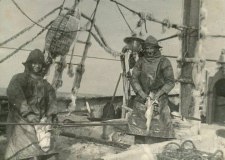
A TOUGH BREED: On board the steam trawler Grosbeak in February, 1947. Photograph courtesy Countryside Books
THERE was little doubt about Ian Robb's career choice when he left school, seeing as he came from a long-established fishing family. He joined the industry in 1962 as a 15-year-old tally boy with a fish merchant in Lowestoft and would have been forgiven for thinking he'd landed a job for life — so secure did the good times appear. But even as he wrote out his labels — the tallies that were fixed to the boxes in the packing station — he had a curious mind. "Following the 1964 season, I asked in my youthful zeal 'With such an abundance of herring being caught this year, what if next year they disappeared?' I was considered somewhat eccentric for this thought. Regretfully, however, 1965 did indeed see the demise of the herring, once hailed as the 'Silver Darling'."
Worse was to come in the final decades of the 20th Century — "the end of a way of life and the almost complete annihilation of an entire industry well over a thousand years old, caused firstly by over-fishing and later by governmental red tape and the high cost of fuel".
Fishing had made this corner of England prosperous, and given much of the coast its unique character, but it was astonishing how quickly the industry declined once the rot set in.
"Some communities managed to adapt and begin anew in other fields of industry — oil and gas, for instance, and more recently offshore wind farms; sadly, others never fully recovered," Ian reflects.
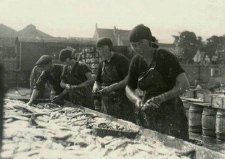
NORTHERN VISITORS: Gutting herring at Denmark Road, Lowestoft, in the 1920s. Photograph courtesy Countryside Books
He describes the long rise and rapid fall of the trade in his book Memories of the East Anglian Fishing Industry. It explains how ports such as Lowestoft and Great Yarmouth built their reputations, looks at what happened in smaller places such as Southwold and Aldeburgh, and paints a colourful picture of how fishing shaped communities — such as bringing to Suffolk the annual "friendly invasion" of hardy Scottish women who gutted, pickled and packed the herring and whose chatter and songs added to the atmosphere.
Woven into Ian's commentary are the first-hand recollections of folk who worked on the boats or on the wharfs.
Catching herring had been part of East Anglian life before the arrival of the Normans and at the time of Domesday the fish was still being used as currency. Kessingland, for instance, paid Hugh de Montfort a manorial rent of 22,000 herring.
At Southwold, where the town was held as a manor for the monks of St Edmund's, fishermen annually caught 25,000 to feed the monastery.

LAND-BASED: Lumpers sort and grade fish at Lowestoft Fish Market in the 1970s. Folk doing this job started early — often at the stroke of midnight. Photograph courtesy Countryside Books
Aldeburgh's fortunes were founded on herring, alongside mercantile trade and boatbuilding. Red sprats were caught, dried and exported to Holland. Fishermen also caught sole and lobsters.
Great Yarmouth was the premier East Anglian port for nearly 800 years, though, thanks to its grip on the herring industry.
The migratory fish would swim up to Scotland and, later, down the coast on the way to their breeding grounds off France. By the time they reached Smiths Knoll, a sandbank off East Anglia, they were in their prime.
Lowestoft was actually a relative Johnny Come Lately to the fishing scene and in the 13th Century wasn't considered a rival. Later, though, it began to benefit because of Yarmouth's problems with silting. And, explains Ian — who has written a number of books about Lowestoft's history — "Merchantmen wishing to evade the heavy duties they had to pay at Yarmouth began unloading their goods, including fish, off the coast at Lowestoft."
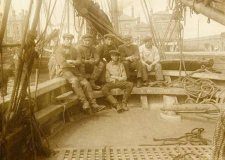
HARD, RISKY, BUT OFTEN REWARDING: The crew of the smack Welcome in Lowestoft trawl basin, in about 1905. Photograph courtesy Countryside Books
In 1372 Yarmouth successfully petitioned Edward III to, in essence, establish a protectionist zone to the detriment of the upstart snapping at its ankles.
Much hinged on the interpretation of a unit of measurement — a dispute that would not be resolved until the 17th Century. The pair "continued as rivals, if not enemies, until the 20th Century — when, by 1999, both towns had lost their fishing fleets and their livelihood, and both communities were in dire economic distress".
Before that, however, they enjoyed plenty of bright days.
In 1670, Great Yarmouth was home to about 220 fishing boats and Lowestoft 25. By the early 1790s, Yarmouth had 150 vessels fishing for herring alone. There was also mackerel and "north cod", along with a large mercantile trade.
Yarmouth's harbour allowed fishermen to use bigger vessels than at Lowestoft, where boats had to be beached on the shingle. Then, in the 1800s, the pretender made a push for the throne.
Lowestoft's first harbour was built in 1830, says Ian, and strengthened its reputation as a fishing port. "Even in the midst of the Napoleonic wars, Lowestoft boats were reputed to have earned as much as £10,000 in six weeks."
He credits entrepreneur and visionary Samuel Morton Peto, who persuaded Lowestoft fishermen to change a lifetime's habit of selling catches in the open, near the beach. When the railway arrived — as it would in 1847 — fish caught locally could reach the Manchester markets the following day, he promised.
The industry quickly took advantage of the links to the Midlands and London. Yarmouth was tardier in exploiting the possibilities.
The new Waveney Herring and Mackerel Market opened in 1883 to deal with growing numbers of drift-net boats arriving not just from East Anglia but destinations such as Ramsgate and Lerwick.
"Each year, between September and November, every nook and cranny in the two ports of Great Yarmouth and Lowestoft was given over to curing, pickling and packing herring. Each port in effect became what can only be described as huge fish-processing factories."
The 20th Century delivered a bonanza in 1913, when about 1,360,000 crans of herring were landed at the ports between September and December — a cran being 28 stones.
Change was in the wind, though. There had been concern the previous year about over-fishing, prompted by proposals to trawl for herring. The use of drift nets caught shoals only when they rose to the surface to feed. Trawling saw nets dragged along the seabed, scooping up virtually everything — mature or not.
That 1913 bonanza — the best year on record — was enough to lull anyone into a false sense of security. Great Yarmouth hosted 264 English boats and 742 Scottish vessels, landing more than 824,000 crans. Lowestoft had 350 English boats and 420 Scottish, bringing home almost 535,000 crans. Eighty-seven per cent of the catch went for export.
"The outbreak of the First World War meant there was no 1914 season; had there been, the herring would have disappeared a lot sooner than the 1960s," writes Ian.
Demand for that fish began to fall, affected by instability in Europe and the collapse of markets such as Russia and Germany. Coupled with the recession of the 1930s, it saw Yarmouth's fleet fall to 87 drifters and 17 drifter/trawlers.
In 1966, at Lowestoft, Small & Co phased out herring-catching. "The remnants of the drifter fleet made one final attempt in 1970, when only five Scots boats fished off the East Anglian coast. All they landed was sixty crans. King Herring was no more."
The town's remaining drifters were either sold or converted to trawling, "but the North Sea is not very deep and trawling did nothing to help the situation. In fact it made it worse. Lessons had not been learnt by the loss of the herring".
The changing fortunes of Yarmouth, which did not switch to trawling to the same extent as its rival, were not easily ignored. By 1971 its population had dropped to 50,000-odd from nearly 53,000 a decade earlier.
Lowestoft concentrated on whitefish, with plaice its main catch, and continued to expand. Its population overtook its neighbour's and Lowestoft became East Anglia's premier fishing port. But the fault-lines were widening…
"Following nearly two decades of intensive trawling, by the early 1980s it was clear that North Sea fish of all types were on borrowed time."
Ian argues: "From the 1970s, the EEC 'common pond' policy also meant that more vessels were fishing for an ever-decreasing stock. Despite later governmental dictates and restrictions, fish stocks continued to dwindle.
Although eventually there was some improvement, EU quotas effectively throttled not just the North Sea fisherman but even the longshoreman's livelihood. The situation was not helped with the introduction of continental boats vacuuming everything off the sea floor."
The decline was becoming quite personal for Ian. By the 1980s, Rossfish — with its processing and freezing plants, and sales office — was the largest employer on the Fish Market at Lowestoft. It was also the first major domino to tumble.
"Every day when I was taking back auction prices and noting the drop in quality of the fish coming into the factory, it was clear that one way or another, sooner or later, we'd be out of a job," he remembers.
No surprise, then, that one autumn day in 1981 saw him and his colleagues being told that the Ross sales office would be closing that October. "The factory itself followed, with the remaining 100 men and women being made redundant in March 1982… An era was about to end."
Over the last 20 years of the 20th Century, too, the decline of prime and whitefish stocks went hand in hand with changes in eating habits. "The high street fishmonger has been superseded by the supermarket." The popularity of traditional chip shops shifted, also. "Fish now has to compete with pies, sausages, mushy peas, drinks, chicken, spring rolls, beef cutlets and more."
Lowestoft struggled on in vain. In April, 1995, when the European plaice quota earmarked for the east coast went instead to the Dutch, 14 Lowestoft boats were decommissioned, he says.
"No longer did we hear the bell calling all to auction. No longer did we hear 'Let go the ropes' or 'Let go aft, let go for'rard.'"
The author laments: "Lowestoft, that final bastion of the North Sea fishery in East Anglia, still survives — but only just. The Fish Market built in the 1980s is now home to a handful of wholesale fish merchants and is a shadow of its former self."
Will the boom times ever return? He quotes Ernie Dewhurst, who has fished off the coast since 1975: You can catch as much herring as you want, but there's nowhere to sell it. "The boats won't come back like they were. You can't get the workforce, and the price doesn't warrant the effort put in and the expense — the price of diesel, the price of paint [and] gear."
The friendly invasion
EAST Anglian life was given extra colour by the annual arrival of Scottish fishergirls who followed the herring south — women with reputations as some of the hardiest workers in the industry. "Their nimble fingers were ideal for gutting, pickling and packing the herring into the thousands of barrels once seen stacked everywhere during the season," says Ian Robb.
"In the early years of the 20th Century some of these girls were as young as thirteen — in a number of cases even as young as twelve. Several of the married lassies would bring their bairns — their young children — with them."
Many came down by train, year after year, "working in the open in the bitterest weather with their hands wrapped in binding to protect them from the salt and brine throughout the cold winter nights, not to mention to protect themselves from their extremely sharp knives".
Landladies would go through an autumn ritual of stripping rooms virtually bare and covering walls with newspaper or brown paper to protect them from the fish oil and brine that got into the girls' clothes and skin.
"Box rooms — or small bedrooms capable of taking only one person during the summer — would now accommodate three girls in a single bed. Not quite as draconian as it sounds — the girls usually worked in shifts and took turns sleeping."
At the height of the season, fishergirls at Lowestoft and Great Yarmouth would gut 60 herring a minute, working in teams of three: two gutting the fish, a third packing them into barrels.
Ian adds: "What fascinated East Anglian folk was their language — mainly Gaelic — which has been described as a cross between singing and talking, and their hands, which were always on the move. During a break, to keep their hands nimble, the girls would be forever knitting."
Memories of the East Anglian Fishing Industry is published by Countryside Books at £7.99
Your information needed
On 20th January '11, David Carrington wrote in The Guardian "Where are the planned flood and coastal defences?" asking readers to help him track down the fate of flood and coastal defence projects now that the government cuts are biting in. He wants all people who live in an area at risk of flooding and coastal erosion where there is a proposal for new defences yet to be funded to let him know the details of any such project that they are aware of, so that he may ascertain and reveal the full impact the cuts will have on proposed new defences, because, as it currently stands, just weeks from the new financial year, no-one presently seems to know where these are and whether their protection is still to proceed.
David uses the recent example of Felixstowe where an essential part of the sea defences had zero-years life expectancy left. After 10 years of investigations, evidence of the cost-benefit ratio of 5-to-1 (or more) demanded and levied expectation the £10m scheme to rebuild was eventually granted, and than suddenly dropped from the EA's indicative list on the 23 December 2010. Then more recently, following a massive reaction and local outcry, the grant was suddenly restored.
A similar state of imbalance may exist in many a threatened coastal area, but no-one seems to know where, as no-one has been told. The EA has stated "Prior to publication of the draft allocations, we reviewed all schemes nationally". Felixstowe was one such case. But where are the others? The EA are not releasing them. There is also uncertainty over the level of cuts as whilst almost all authorities are saying the cuts are 27%, the government are claiming that they are only 8%.
The EA says it will complete all defences under construction, but that fewer new projects will start because of the government cuts. In the meantime, if you live in or know of an area at risk of flooding or of coastal erosion, and there is a proposal for new defences that has yet to be funded, David Carrington needs your help to compose a full listing to publish so all know just where they stand.
If you are able to assist please go here and complete his short questionnaire. the results of which we will post here following publication.
Siemens chooses Hull for wind turbine plant generating 700 jobs
German engineering conglomerate Siemens has selected Associated British Port's (ABP) Hull development to build what will be Britain's first major offshore wind turbine manufacturing plant.

ABP's new deep water berth in Hull will be capable of handling giant wind turbines built by Siemens. Photograph David McNew/Getty Images
The decision means that ABP is in line to receive about £20m for the development from the government's ports upgrade fund, which energy secretary Chris Huhne fought to save from the spending cuts in October's comprehensive spending review. Siemens' proposed plant will also create about 700 jobs and the news will be a boost for Hull, which has beaten off competition from ports in Teesside, Sunderland and the Humber which had also been shortlisted for the project.
Siemens will announce today that it has signed a memorandum of understanding with ABP over its Green Port Hull proposed development at Alexandria Dock. The two companies have yet to sign a formal binding contract.
Under the plan, ABP would build a £100m deep water berth at the port capable of handling the new generation of large offshore wind turbines. It would be one of the biggest single investments ABP has made in Britain. Siemens also wants to build a new £80m wind turbine plant on the site.
The two companies hope to sign definitive agreements this year. Siemens, together with General Electric and Mitsubishi, which also plans to build similar plants in Britain, had threatened to go elsewhere if the £60m ports funding had been withdrawn. It is understood that Siemens was looking at alternative sites in western Denmark to build a plant to make turbines for the North Sea.The two companies will work to develop the plans for the new Siemens plant and export facility at the Port.
The news from Siemens and ABP will also be a shot in the arm for the government's attempts to create new jobs from the "green economy", particularly from the manufacturing of wind turbines, which are being rapidly installed off the British coast.
Industry sources estimate that the proportion of UK-sourced components in onshore wind farms is as low as 6%, with companies bemoaning the missed opportunity for British manufacturers and the wider economy as vast sums are now being spent on renewable energy.
Some government advisers believe the state could do more to promote British turbine manufacturers, for example by introducing specifications for UK wind farms that would benefit domestic firms.
India plans Asian tidal power first
The Indian state of Gujarat is planning to host Asia's first commercial-scale tidal power station.
The company Atlantis Resources is to install a 50MW tidal farm in the Gulf of Kutch on India's west coast, with construction starting early in 2012. The facility could be expanded to deliver more than 200MW.
The biggest operating tidal station in the world, La Rance in France, generates 240MW, while South Korea is planning several large facilities.
British claims to Rockall to be examined by UN court in battle over oil and gas fields
British claims to ownership of Rockall — the isolated Atlantic outcrop jutting out of a potentially vast and lucrative oilfield around 240 miles west of Scotland — is to be examined within weeks by the UN.
A formal claim for thousands of square miles of the seabed surrounding the rock has been made by Denmark and the Faroe Islands, potentially overriding the claims of Britain, Ireland and Iceland. At stake could be licences and income worth billions of pounds.
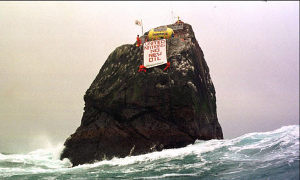
Ownership of Rockall is disputed by Britain, Ireland, Denmark and Iceland. Photograph: David Simms/AFP/Getty Images
The four competing applications are likely to be reviewed by the UN's Commission on the Limits of the Continental Shelf (CLCS) in March.
Diplomatic talks between the four countries have been rotating around European capitals for several years, in the hope of agreeing an amicable division of the seabed in the Hatton-Rockall basin. They have failed so far to map out a mutually acceptable settlement.
The hunt for offshore gas and oil at a time of increasing energy demand is driving enthusiasm among coastal states around the world to annex as much of the seabed as they are legally permitted.
In June, the UN Commission's panel of marine experts dismissed Britain's application to extend its prospecting rights over 200,000 square miles of the ocean floor around Ascension Island in the south Atlantic. The commission ruled that the island, an overseas British territory that is also a volcanic pinnacle, was too slender to generate rights to an extended zone of the submerged continental shelf.
The dispute over Rockall is historically complex. The Royal Navy formally annexed the rock in 1955 by hoisting the Union flag.
The 1972 Island of Rockall Act formally declared it as part of Invernesshire, even though the nearest permanently inhabited settlement is 228 miles away in the Outer Hebrides.
Imperial ambitions were set back, however, by international ratification of the UN Convention on the Law of the Sea, which states that: "Rocks which cannot sustain human habitation or economic life of their own shall have no exclusive economic zone or continental shelf."
All of the rival claims submitted to the commission over the past few years have focused on the surrounding Hatton-Rockall Basin, under which are believed to be extensive oil and gas deposits.
Rockall, nonetheless, sits on a plateau claimed by all four nations. Britain and Ireland have agreed a common marine border that leaves Rockall in the UK sector.
A Foreign Office spokeswoman said: "We note that Denmark has made its submission in respect of the Faroe-Hatton plateau. We are presently studying this and the attached note verbale, which Denmark presented to the UN secretary-general. The UK… re-affirms its own commitment to the quadrilateral talks between the UK, Denmark, Iceland and Ireland. The next round of talks is scheduled to be held in Reykjavik in May 2011."
Arctic warming at twice global average rate thought to be behind unprecedented Walrus migration
Scientists in the Arctic are reporting a rare mass migration of thousands of walrus from the ice floes to dry land along Alaska's coast.
Researchers from the US Geological Survey (USGS), who have been tracking walrus movements using satellite radio tags, say 10,000 to 20,000 of the animals, mainly mothers and calves, are now congregating in tightly packed herds on the Alaskan side of the Chukchi Sea, in the first such exodus of its kind.
"It's something that we have never seen before in this area," said Geoff York, of the WWF's global Arctic programme. "As the ice decreases, the walrus are abandoning it earlier and earlier. They are having to swim ashore, or to linger on less suitable drift ice for long periods of time."
The flight of the walrus, first reported by the Alaska Dispatch, has reinforced warnings from scientists that the lumbering animal may be headed for extinction because of climate change.
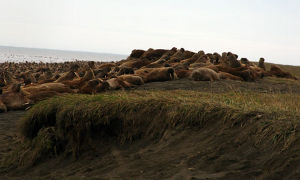
Walrus high on the barrier beaches near Pointt Lay, Alaska, 2010. Photograph: USGS
Arctic sea ice dropped to its third lowest level in recorded history this year. The USGS study noted that the entire Chukchi shelf could be completely ice-free during August, September and October by the end of the century.
The USGS, which has been tracking the walrus since June, put the chances of extinction or serious population decline among walrus at 40% by 2095 because of the rapid and widespread loss of summer sea ice due to warming temperatures.
Walrus are not the only animals facing depleted numbers or extinction because of climate change. The Arctic is warming at twice the rest of the world on average, and its seas are growing increasingly acidic because of increased concentrations of carbon dioxide. A new report today warned that 17 species — from tiny plankton to the weighty narwhal — were threatened by the disappearing sea ice and rising seas.
In addition to polar bear — whose plight is widely recognised — and walrus, the report from the Centre for Biological Diversity said several species of whale and seal, and land-based animals such as caribou and fox were facing declines.
Meanwhile, local residents in Point Lay told the Dispatch the numbers of walruses coming ashore could be much higher than government estimates. The rare onshore mass sightings have raised fears of a grisly repeat of last summer when some 130 of the beasts, mainly calves, were trampled to death as the herd foraged for food.
"Walrus mums and calves need the sea ice to rest," said Shaye Wold of the Centre for Biological Diversity. "When the sea ice disappears they are forced to come to shore and their calves are extremely vulnerable to being trampled in a stampede as you can imagine with 10,000 to 20,000 walruses on shore trying to forage in a limited area."
Because of their huge girth, walrus are relatively clumsy in water. During their annual migration, they rely on large floating patches of ice as resting stops or mobile fishing platforms as they make their voyage cross the shallow frigid waters between Alaska and Russia.
In 2007 and again last year "thousands of walruses hauled out along the coast of north-western Alaska and tens of thousands of walruses hauled out along the coast of northern Chukotka when ice disappeared," the USGS report said. "These events led to the trampling and death of hundreds of walruses in Alaska and thousands in Russia," the report said.
Increased concentrations of carbon dioxide in the ocean was also depleting the walruses' food supply, making the waters too corrosive for the clams and other shellfish that are their staple.
The USGS study went on to note that disappearing summer sea ice, due to climate change, was likely to spur an increase in shipping traffic through the Chukchi and Bering seas, putting the walruses in further jeopardy.
In a statement, Rebecca Noblin, the director of the Centre for Biological Diversity, argued that the forecast failed to take stock of the risks of oil spills in the pristine Arctic environment, because of the increase in shipping, or the potential for damage if the area is opened up for offshore oil and gas drilling.
"Unless we dramatically reduce our greenhouse emissions, the walrus is on a trajectory toward extinction," Noblin said.
The centre launched a law suit two years ago to place the Pacific walrus on the list of endangered species. The federal government must rule by January 2011 whether to grant endangered species protection to the Pacific walrus, which would put restrictions on offshore oil drilling and shipping routes through the Arctic.
New claims that the public is being "duped" by the Marine Stewardship Council
The body which certifies that fish have been caught sustainably has been accused of "duping" consumers by giving its eco-label to fisheries where stocks are tumbling.
The Marine Stewardship Council (MSC) manages the labelling system that tells consumers which species of fish they can buy safe in the knowledge they aren't destroying stocks.
It recently celebrated the 100th award of its eco-label — to the Barents Sea cod fishery — but a series of decisions allowing controversial fisheries to be granted the prized MSC label has prompted severe criticism of the organisation.
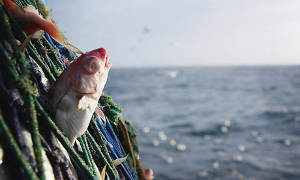
The Marine Stewardship Council has been accused of 'duping' customers. Photograph: Christopher Furlong/Getty Images
Richard Page, a Greenpeace oceans campaigner, said decisions to certify some fisheries "seriously undermine" the MSC's credibility. "I will go as far as to say consumers are being duped. They think they are buying fish that are sustainable and can eat them with a clean conscience."
Among the most controversial rulings is the award of an MSC label to the Ross Sea Antarctic toothfish fishery which is still regarded by scientists and the industry as an exploratory fishery. The species is so little understood that researchers still do not know even basics such as where the fish spawns.
Others include krill in the Antarctic, tuna and swordfish off the US coast, pollock in the Eastern Bering Sea where stock levels fell 64% between 2004 and 2009, and Pacific hake which suffered an 89% fall in biomass since 1989.
Chris Pincetich, a marine biologist with the Turtle Island Restoration Network, said: "The MSC has rushed to accept applications from hundreds of fisheries around the globe in order to grow their business and network. Many of those are actually viewed by scientists as unsustainable. They should really take a closer look before they even engage with those fisheries."
Richard Page, Greenpeace oceans campaigner, said of the toothfish decision: "It should never have been up for certification in the first place. There just isn't sufficient information to say whether it's sustainable or not."
James Simpson, of the MSC, insisted all assessments were "scientifically robust" and said they are designed to ensure the "biological and ecological" components of each fishery are not compromised. Moreover, it introduces better levels of protection to stock levels than might otherwise be found in fisheries.
He recognised, however, that "for some of our critics, the MSC test of sustainability is not high enough" and said: "Behind the controversies there is evidence of real environmental benefits occurring — many of them driven by fisheries' desire to attain and keep their MSC certificates.
Illegal fishing in EU seas can be eradicated, MARINET report explains
A key problem in the management of fisheries under the EU Common Fisheries Policy (CFP) is the practice of illegal fishing, allied to inadequate data about the amount and characteristics of the fish caught by the European fishing fleet. These shortcomings over the true nature of fishing activity mean that fisheries management is being pursued with inadequate data and is, all too often, effectively in the dark.
Vehicle monitoring systems (VMS) can monitor a fishing vessel's location and infer the nature of its activity from the speed at which it is travelling. However, VMS provides relatively little data to the managers of fisheries.
A new development, fishery electronic logbooks, now extends the monitoring possibilities considerably further, thus providing an important new tool.
A ship equipped with these logbooks is able to not only record its movements but is also able to activate the software when it starts a trawl-tow and, whilst the tow is in progress, the ship can log its exact route and then capture its location at the end of the trawl-tow. Then, when the nets are emptied and the fish are sorted and weighed, this data can be allocated to the tow track. All of this fishing data, along with data on the vessel name, vessel type, nets used, home port, crew numbers, etc, can be captured in the logbook and then emailed to the authorities.
World-wide quite a few fishery authorities have been using electronic logbooks for some time, and they are now becoming mandatory in the EU in 2011 for all commercial fishing vessels of over 15 metres fishing in EU waters, and in 2012 they will apply to all vessels over 12 metres. Thus with the information available from electronic logbooks EU fisheries management will be able to become far more precise, and illegal activity will be quickly apparent.
Electronic logbooks can also be linked to Geographical Information Systems (GIS). GIS is essentially a computerised mapping system. Thus, if any form of data is geo-referenced (has a grid reference or some other location reference such as a postcode) then it can be accurately mapped.
GIS has been extensively used for every imaginable human activity, but its use as an aid to mapping in fisheries has been more limited because, unlike on land where most mapped features are fixed, in the marine environment all the fish species constantly move, as does the marine environment itself.
However a wide range of fisheries-based uses for GIS have recently been developed. For example, it is now possible to map and record the complete profile of a catch — i.e. the species caught, the quantity caught, along with the time and location of where it was caught. As a result GIS is fast becoming an essential tool in both fisheries management and fisheries research, largely because it has both an analytical and mapping capability. The types of fishery related uses for GIS include:
- marine habitat mapping and analysis;
- establishing preferred habitats for individual species;
- resource analyses, including stock assessments;
- ecosystems modelling and management;
- monitoring of any management and enforcement policies;
- marine zoning and marine reserve allocation;
- where best to restock the seas;
- showing fishing fleet deployment and amount of effort per unit area.
CFP reform has given us the opportunity to start doing this essential work, and to employ these new tools — Fishery electronic logbooks and Geographical Information Systems. However although CFP reform has given us this opportunity, there is no guarantee that these tools will be adopted. The reality is that we are confronted by the legacy of history, and this means that we must not forget the damage that has already been done to the size and lost potential of our fisheries due to continuous over-fishing, and the serious obstacle of the antagonism that has grown up between fishermen and their managers.
It will take calm heads and clear thinking to install, and thus reap, the benefits of new scientific tools and capabilities. Let us hope that all parties, the fishermen and the EU government, will have the sense and courage to do so.
For full details of the MARINET Report, titled: Fisheries monitoring via the use of Fisheries Log Books and Geographical Information Systems click here.
UK Foreign Office accused of subterfuge in the designation of Chagos Islands marine reserve
The Foreign Office stands accused of misleading the public over the plight of thousands of islanders who were expelled from their Indian Ocean homeland to make way for a large US military base.
More than 2,000 islanders — described privately by the Foreign Office as "Man Fridays" — were evicted from the British colony of Diego Garcia (Chagos Islands, Indian Ocean) in the 1960s and 70s. The Foreign Office, backed by the US, has fought a long legal battle to prevent them returning home.
The islanders' quest to go back will be decided by a ruling, expected shortly, from the European court of human rights.
A secret US diplomatic cable released by WikiLeaks suggests the Foreign Office has privately admitted its latest plan to declare the islands the world's largest marine protection zone will end any chance of them being repatriated.
The admission is at odds with the public position of the Foreign Office that the proposed park does not prejudice or have any effect on the the islanders' right to return. The islanders have claimed the marine park was a ploy to block their return, saying it would make it impossible for them to live there as it would ban fishing, their main livelihood.
The disclosure follows years of criticism levelled at Whitehall over the harsh treatment of the islanders, many of whom have lived in poverty in other countries since their deportation. In the past, National Archive documents have revealed how the Foreign Office consistently lied about the eviction, maintaining the fiction that the islanders had not been permanent residents.
The latest leaked documents are US State Department cables recording private meetings between Foreign Office mandarins and their American counterparts.
In May 2009, Colin Roberts, the Foreign Office director of overseas territories, told the Americans Diego Garcia's value in "assuring the security of the US and UK" had been "much more than anyone foresaw" in the 1960s, when the plan to set up the base was hatched. "We do not regret the removal of the population since removal was necessary for [Diego Garcia] to fulfil its strategic purpose," he added under a passage that the Americans headed "Je ne regrette rien".
Roberts, admitting the government was "under pressure" from the islanders, told the US of the plan to set up the marine park on 55 islands around Diego Garcia, known as the British Indian Ocean Territory (BIOT). "Roberts stated that, according to [Her Majesty's government's] current thinking on a reserve, there would be 'no human footprints' or 'Man Fridays' on the BIOT uninhabited islands," according to the American account of the meeting. The language echoes that used in 1966 when Denis Greenhill — later the Foreign Office's most senior official — described the inhabitants as "a few Tarzans and Man Fridays".
The leaked cable says Roberts "asserted that establishing a marine park would, in effect, put paid to resettlement claims of the archipelago's former residents".
A US state department official commented: "Establishing a marine reserve might, indeed, as the FCO's Roberts stated, be the most effective long-term way to prevent any of the Chagos Islands' former inhabitants or their descendants from resettling in the BIOT."
The Foreign Office said it rejected any allegation that it had misled the public. A spokesman added : "We cannot go into specifics of any leaked documents because we condemn any unauthorised release of classified information."
Leading conservation groups have supported the marine park plan. Roberts is quoted as telling the Americans that Britain's "environmental lobby is far more powerful than the [islanders'] advocates"
Note: A hearing in the European Court of Justice is pending to see whether the continued exclusion of the previous residents of the Chagos islands (i.e. the indigenous islanders) is legal under Human Rights law.
MARINET observes:
There is absolutely nothing incompatible between the indigenous islanders returning to the Chagos islands and the creation of a no-take marine reserve centred on the islands. To assert otherwise is a falsehood.
All marine reserves need to be managed, and there are no better managers than those people who live there and know the nature of the seas. If this were a no-take marine reserve located in British waters with, for example, the purpose of rebuilding commercial fish stocks (as we hope the forthcoming reform of the EU's Common Fisheries Policy will establish on a widespread basis), then there is no better set of people to administer and superintend the marine reserve than the fishermen who formerly fished it. They not only have the knowledge of the area and its ecology, they also have a vested interest in seeing the fish stock rebuilt and, being in need of the income following the closure of the fishery, they have a logical first right of entitlement to the public funds allocated for the management of the reserve.
And so it is with the Chagos islanders. They are the people best placed to manage and superintend the reserve. They know that the preservation of its ecology and biodiversity, and the sustainable use of it in the future as a fishery limited solely to tourism and self-sufficiency of food for the islanders and its visitors, is the key to the long-term survival of the islands' economy.
Hence the Chagos islanders will be conservationists upon their return. There can be little doubt that they are the people who are best placed to deliver and implement the conservation principles upon which the marine reserve is founded, and any assertion that marine reserve status will, per se, permanently exclude the islanders is nonsense. To the contrary, the return of the islanders is an essential requirement of the reserve's long-term management. If the UK Foreign Office thinks otherwise, as reported by WikiLeaks, then it has failed to understand how conservation works and it needs to re-visit any decision on this subject which it may have mistakenly made.
Great Yarmouth coastal system is the subject of a Crown Estate report
As a direct result of a Crown Estate-Caird Fellowship at the National Maritime Museum, Hannah Evans of the British Geological Survey has produced a report on historic changes in the Great Yarmouth spit and the related coastal system.
Little is known of the volume of sediment held within the Great Yarmouth spit or its short-term fluctuations in sediment storage capacity. Such gaps in coastal sediment budgets mean that the effects of predicted future increases in relative sea level and storminess are difficult to forecast.
The current study addressed this by examining the late-Holocene geomorphic evolution of the Great Yarmouth spit, providing a value for the volume of sediment stored within the feature and placing current morphological changes within an historical context.
The specific aims of this research were to investigate:
- spit volume,
- spit morphological change
- potential forcings for this change, and
- likely future morphological trends.
Short-term fluctuations in the Great Yarmouth spit's sediment storage capacity were identified by investigating morphological changes within the feature's coastal zone from map and aerial photograph evidence.
These fluctuations appear to be site-specific across the Great Yarmouth spit and adjacent areas. Indeed, between 1800 and 2007 Winterton-on-Sea experienced accretion whilst coastline retreat followed by a period of relative stability typified trends at Caister-on-Sea. North Denes shows sea-ward advance of the coastline but this occurs after a phase of erosion prior to 1890. Great Yarmouth Pleasure Beach and Gorleston-on-Sea have remained relatively stable after a similar phase of pre-1890 erosion.
All sites investigated are currently (2008 data) displaying either maintenance of or an increase in sediment storage capacity within the stable spit area (that above normal tidal conditions) with the exception of Caister Point which is undergoing erosion.
Footnote:
MARINET will advise readers further on this Crown Estate report after we have entered into correspondence with the Crown Estate over the inaccurate dating of the commencement of the change from accretion to erosion in the Winterton area, which error could be accidental, or could be an attempt to suggest that the massive erosion experienced did not correlate with the timing, level and positioning of the dredging offshore there, this being a critical factor in our evidence on the issue.
Offshore windfarms could transform the UK's economy along the East coast
In an airless Westminster committee room recently a shirt-sleeved Energy Secretary came close to promising the earth.
Laying out government plans to make renewable electricity more profitable to produce than smokestack, greenhouse gas-producing power, Chris Huhne said the market reforms would mark "a seismic shift" towards cleaner energy, underlining David Cameron's vow to be "the greenest government ever".
Up on the windy north-east coast, recession-lashed ports such as Grimsby and Hull have been eyeing the prospect of building huge windfarms for the North Sea for many years now. But here at the sharp end they remain to be convinced that Huhne's long-term changes to the market are quite the kick-start that is needed to revolutionise the UK's industrial future.
Throughout the UK it is striking how unaware most people are of the enormous scale and ambition of Britain's planned "round 3" offshore windfarms.
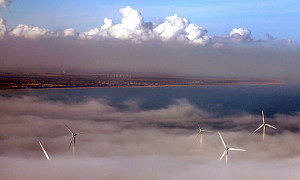
A wind farm at Scroby Sands off East Anglia. Photograph: Albanpix Ltd / Rex Features
Thanet, a "round 2" site with 100 turbines so far, located about seven miles off Foreness Point, Kent, opened two months ago and is now the largest offshore windfarm in the world. Yet it is a mere drop in the North Sea compared to the nine "round 3" sites set out on the coastal map produced by Crown Estates, which owns the rights to British waters.
The three sites to the east of Britain are on a staggering scale. Dogger Bank, off the Yorkshire coast, will fill close to 3,475 square miles, with 1,700 wind turbines. The Norfolk windfarm will cover an area larger than the county itself, while Hornsea, off Grimsby and the Humber, will be nearly as wide as England is from Hull to Liverpool.
"Looked at in their entirety," said the energy specialist Andrew Reid, of consultants Douglas Westwood, "these are certainly the largest construction projects ever undertaken in the world."
The mammoth windfarms are designed to generate sufficient electricity to meet the EU target for 30% of the UK's energy to come from renewables by 2020. More than that, for a country still figuring out how to rebuild a working economy from the wreckage of the banking crisis, renewables promise industrial reinvention.
Grimsby has held on to chemical manufacturing, steel production and food processing, but is still reeling from the collapse of fishing. The town views work on the windfarms as a natural extension of its marine tradition, and down on the docks, you find weathered industrial companies, former fishermen and the local council all hungry for it to start in earnest.
Kurt Christensen, who was born in Denmark and moved to Grimsby in 1955 with his fisherman father, left school at 15 and spent his life in the fishing industry, before the 1970s cod wars and, later, overfishing and quotas, meant the Grimsby boats dwindling from 450 to almost none. "In its heyday, Grimsby was a profitable town," he said. "Fishing was flourishing and people made a lot of money. The industry died by a thousand cuts, people lost their jobs, boats were decommissioned, and there was a lot of heartbreak."
Still involved in selling fish, he watched the "round 1" windfarms, Lynn and Inner Dowsing, take shape off Skegness, and dived in. He bought two boats, and secured a contract with the industrial company Siemens, supporting operation and maintenance work on the turbines as well as servicing the "floating hotel" ship for workers at sea. "Fishermen are resilient, incredibly hard-working. People always looked for new work. We never became a call-centre town," Christensen said, an assertion you hear everywhere in Grimsby. "Offshore wind offers a great opportunity for people to work again in a real industry, and we feel the town deserves it."
Green shoots are visible. Lincs, a large "round 2" site, is under construction, the energy company Centrica is planning an operation and maintenance plant on Grimsby docks, and at the Catch industrial college, three apprenticeships have been created to train electrical engineers for the turbines.
The area of vast opportunity, though, is "round 3". In the Grimsby and Humber area 25,000 precious jobs could be generated, according to North East Lincolnshire council.
Scratch a little, however, and you find impatience with the government. Many people feel the government should lead solidly, not just reshape the market. There is, too, fury with the banks, for withholding finance from small firms. Christensen, despite his years of marine experience and contract with Siemens, could not get a loan from any bank. So, at the age of 56, he remortgaged his house. "Don't count on anything from the banks," he said. "Companies from overseas, particularly Denmark and Germany, are queuing to get involved in our waters, and it would be tragic if we don't make the most of this."
The UK government has already promised £60m in grants to upgrade whichever port Siemens selects as the site for a huge turbine manufacturing plant. Both banks of the Humber are vying for it: Able UK has earmarked a site on the south bank near Immingham, while Associated British Ports plans a "green port" on Hull's Alexandra dock.
In his smart new offices on a Grimsby business park, Winston Phillips assessed the situation. He is managing director of renewables for Cosalt, the only plc based in Grimsby. It began life in 1873 as The Great Grimsby Coal, Salt and Tanning Company, and between the wars was the world's largest fishing equipment supplier. Now it specialises in marine again, employing 45 technicians to service windfarms for Siemens. Phillips says the government should be more active and co-ordinate the emerging industry; otherwise British firms, and towns like Grimsby, will not secure enough of the work generating electricity off the UK coast.
"I went to a renewables conference recently attended by manufacturers and consultants," he said. "All the manufacturers were overseas companies — German, Danish, where the governments have invested heavily in industry. But all the consultants were British."
One of those consultants, Reid, calculates that just one 10th of all the investment made in UK offshore windfarms has so far gone to British firms. "Continental companies have typically won around 90% of contracts," he said. Alongside Siemens, big manufacturers committing to the east coast include GE, a US company, and Gamesa, based in Spain. There are concerns that unless "round 3" moves more quickly, smaller British companies will find it difficult to be involved even in the supply chain. "The government here is leaving everything to private companies and the market. But we need certainty. There is too little vision or leadership," said Phillips.
Sam Pick, a consultant with the Renewables Network, which represents smaller firms in the Grimsby area, agrees. He is sceptical about the government's planned "green investment bank", which Huhne recently admitted would not open any time soon. "Companies need to gear up now. We have heard constantly about the green investment bank, but it does not exist, and mainstream banks are not lending, even to people doing everything they can to be part of this revolution."
Elsewhere, the cold and muddy yard of the steel fabricating company SC4, in the shadow of the old Corus plant at Scunthorpe — now owned by Indian company Tata — seems another world from the air of satisfaction in Huhne's Westminster.
Shay Eddie's father, Edwin, started the business in 1983; it has survived the decimation of the steel industry, but this recession, Eddie grimaces, is "the worst we've ever seen," because the banks, hit themselves, have withdrawn finance. "Three of our customers went bust last week," says Eddie, plain and factual. "It's like being in a forest fire, and it has accelerated since the government's cuts were announced in October."
Pointing with pride to men working on heavy equipment secured before the credit lines were cut, fabricating steel for customers including London's 2012 Olympic Stadium and Crossrail, Eddie reflects on the dilemma for companies like his. They can see great projects planned, at sea, but cannot do anything to touch them.
"There is work out there for generations," he says. "I'm banging the drum; we've been to every meeting and exhibition going. But the banks have cut off the lifeblood, and companies are going to the wall. The government talks about our industry, this area, being able to benefit, but it needs action fast. We're surviving by the skin of our teeth. It could be last man standing gets the work."
The sheer scale of the oil and gas industry shocked people when it arrived in Britain in the 1970s. Whole regions were transformed; remote places became sites of frantic industrial activity. In the rush, fortunes, and mistakes, were made. The offshore wind energy revolution may be just as shocking.
The giant wind farms expected to be built in the second and third rounds of commissioning from 2014 onwards will need a new generation of ports. Thousands of miles of cable will have to be laid. The industry expects to spend £2.4bn just on new service craft. So far, 25 British ports have registered to become "windports". Some are already beginning to feel the wind rush.
"In the next 10 years Britain will have to build around 50 times more offshore than it has so far to meet its 2020 target," said Nick Medic of the British Wind Energy Association. "People have no idea how big this project is. It will be colossal… as transforming as the building of the rail systems."
But he admits it comes at an environmental price. The long road from fossil fuels to a greener Britain will be rancorous and full of surprises.
Life of coastal nuclear power plants at Hartlepool and Heysham extended
Power firm British Energy has announced plans to extend the life of two of the UK's coastal nuclear power stations for a further five years.
The Hartlepool and Heysham 1 plants have been dogged by output issues in recent years but British Energy (BE), owned by French company EDF Energy, said the reactors had passed a technical and economic evaluation.
BE, which has eight nuclear power stations in the UK, said the move to extend the lives of the power stations had secured around 700 jobs on each site.
The announcement follows the Government's recently approved electricity market reforms which are expected to encourage investment in low-carbon power generation.
BE took four reactors at Heysham 1, near Morecambe, in Lancashire, and Hartlepool, in County Durham, out of service in October 2007. The move came after it discovered wire corrosion on one of the boiler closure units, which form part of each reactor during a maintenance inspection. The programme of repairs was completed last year but the reactors have since been running at reduced capacity.
The firm decided to extend the lives of the two power stations when a solution was found to boost output close to full load — but it will need to be implemented during outages over the next few years. Heysham 1 and Hartlepool are both capable of supplying more than 1.5 million homes each — enough electricity to keep three cities the size of Liverpool supplied during peak loading hours.
A spokeswoman for EDF Energy said: "Extending the lives of its nuclear plants has remained a strategic priority for EDF Energy since coming together with British Energy almost two years ago. So it's particularly good news to be able to announce the decision to extend the operating lives of these two stations which started generating in the early 80s. Life extension is an important way of bridging the generation gap in the UK without risking carbon reduction targets."
Alongside Heysham 1 and 2 and Hartlepool, its sites include Dungeness B in Kent, Hinkley Point B in Somerset, Hunterston B in Ayrshire, Sizewell B in Suffolk and Torness in East Lothian.
EU cuts CFP Atlantic cod quota, but is it enough?
The EU has cut the catch limit of endangered cod in Atlantic waters, but the cut has angered environmental activists by falling far short of the targets which scientists say are necessary to replace quickly diminishing fish stocks.
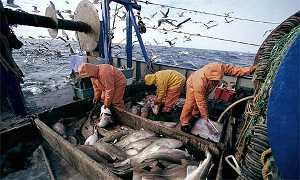
Cod fishing in the Atlantic. Photograph: Jeffrey L Rotman/Corbis
EU fisheries ministers have decided to cut catches of cod in Atlantic waters off Scotland and Ireland by a quarter, to the dismay of environmentalists — who argue that catches should be halved, and fishermen — who say the quotas will put more of them out of jobs.
Scientists have called for drastic cuts, but governments have rarely heeded their advice for fear of losing political support from fishing communities. The European Commission said last month that cod stocks have continued to decline over the past two years with no sign of recovery in key Atlantic grounds, and recommended 50% cuts.
Cod stocks off Scotland and Ireland now face "an almost certain scenario of collapse," said Greenpeace's Saskia Richartz. "What we are seeing is that the ministers are closing their eyes and sticking their heads into the sand," she said.
Britain and Ireland have a vocal fishing industry whose members say they feel battered by years of incremental cuts in quotas. The depletion of the species has caused the decline of hundreds of fishing villages on both sides of the Atlantic.
"I have been fighting hard to protect the livelihoods of our fishermen," said Britain's fisheries minister, Richard Benyon.
The vice-president of the EU Parliament's fisheries committee, Struan Stevenson, warned even the compromise cut would be devastating for fishermen. "The range of cuts imposed by Brussels again this year will make it another bleak Christmas for our beleaguered fishing communities," he said.
The EU has been under pressure to do more to conserve fish stocks. Last month, an international conservation conference in Paris failed to take radical measures to save the Atlantic bluefin tuna, which has been severely overfished to feed the demand for sushi in Japan, a decision that was rubber-stamped today.
Belgian fisheries minister, Kris Peeters, who led the ministerial negotiating sessions over three days, acknowledged some nations were under intense pressure to return from Brussels with more lenient catch quotas than scientists and the EU executive commission sought. "If there is a proposal of cutting quotas by 40%, it is not at all easy to go home with a message like that," he said.
Ministers also decided to take some action against discards, the practice of throwing good fish overboard because a catch quota has already been met, a reform that fishermen and several coastal nations have been calling for. "They have responded to our calls to find a better way to end the dreadful waste of discards, but much more can still be done," said Richard Benyon, UK Fisheries Minister.
Environmental groups like Greenpeace call for the creation of "marine reserves" where stocks could be protected from fishing and allowed to replenish.
MARINET observes:
The failure of EU politicians to heed and implement scientific advice, which strongly recommends the closure of the cod fishery in order to preserve and restore it to a sound condition, illustrates exactly why the Common Fisheries Policy is in such urgent need of fundamental reform.
It also suggests that unless public opinion is brought into the equation — i.e. a public who believes that our fish stocks need to be protected and restored — then nothing will actually happen (apart from the actual extinction of the fishery) because politicians seem to be incapable of making the right and necessary decisions.
The likely extinction of the cod fishery in the North Sea and in the Irish Sea and NW Scotland is not scaremongering. Stock levels according to the International Council for the Exploration of the Sea, which monitors the size of fish stocks worldwide (see ICES North East Atlantic fish stock data at www.ices.dk/advice/fishstocks.asp ), record that no fishing of cod should be taking place at the present time in the North Sea, Irish Sea and NW Scotland because the spawning stock is below its safe biological limit (i.e. so small that it is incapable of reproducing itself safely).
Due to the nature of contemporary fishing practices it is not only the actual size of the stock (total amount of fish) that it of concern. Also of fundamental concern is the age profile of the stock. A cod can live to 25 years, and becomes sexually mature at 6 years. As it doubles in length, a cod doubles in the amount of eggs it produces, and so the older the fish the greater its reproductive potential. Unfortunately, all cod above the age of 6 years are now fished out of the sea. Therefore not only is the spawning stock below a safe size in term of numbers, it is also made up of members who are largely sexually immature. Indeed, the whole North Sea, Irish Sea and NW Scotland cod stock is having to rely on the reproductive of barely sexually mature 6 year olds — which is like asking the human race to survive based just on the sexual capability of adolescents.
There is hope for the future. That hope is founded on a proper reform of the Common Fisheries Policy (CFP). Reform is scheduled for introduction by the beginning of 2012 (although present behaviour by EU politicians would not lead one to believe this) and, most importantly, there is now an EU law — the Marine Strategy Framework Directive (MSFD http://www.marinet.org.uk/marinebill/euframeworkdirective.pdf) which requires that by 2020 the "populations of all commercially exploited fish and shellfish are within safe biological limits, exhibiting a population age and size distribution that is indicative of a healthy stock". Therefore, the forthcoming reform of the CFP must implement EU Law (MSFD) which, in turn, means that the CFP must install management policies which will ensure that the cod fish stock for our seas, and other commercial species too, are in a sound and healthy condition by 2020.
MARINET is pursuing a campaign right now to secure a Reform of the CFP on this precise basis. This campaign involves the public — i.e. you and your colleagues and friends — lobbying your MEP and MP to ensure that the CFP Reform obeys EU law and implements the Marine Strategy Framework Directive's legal requirements on the size and health of commercial fish stocks. To play your part in this campaign, contact us .
As we have said above, the imminent extinction of the North East Atlantic cod stocks is not scaremongering.
Not only does the ICES data urge full and immediate protection (a cessation of fishing), but history also tells us clearly that extinction of the stock will occur if scientific advice is not heeded. This is exactly what has happened to the world's largest cod fishery in the North West Atlantic in the seas off Newfoundland, Canada. For several years intensive fishing practices relentlessly reduced the size of the cod stock off Newfoundland (a stock far larger than the North Sea, Irish Sea and NW Scotland cod stocks combined), and the scientists warned that a complete collapse in the stock would occur if fishing did not cease.
However the Canadian politicians refused to heed the advice, and in the late 1990s the stock totally collapsed — there were no cod left in the sea. Conservation measures were immediately introduced, but even today — a good 10 years since the collapse — the cod have still not returned. Rather, the old ecosystem that sustained the abundant cod stocks has collapsed, and cod is now commercially extinct. There is no sign that the ecosystem will restore itself — it has shifted fundamentally into another mode — and thus the Newfoundland cod fishery — once the premier cod fishery in the world — is no more.
The same will happen to the North Sea, Irish Sea and NW Scotland cod fishery. Indeed, it is already happening, and its future is on the brink of extinction.
This is why the EU politicians must be persuaded to act sensibly, and to display true courage in taking the decisions to protect this fishery. This is why MARINET's CFP Reform campaign is so important, and requires your support.
We must halt the current obsession to fish the stocks to extinction, and we must set up marine reserves centred on the spawning and nursery grounds of the cod stock (and other species also facing similar pressure). Put simply, we have to persuade the EU politicians to undertake a Reform of the CFP which implements and observes EU law.
We have to do this now. There is no time left for any other alternative. Please support the MARINET campaign.
Ecological Impact Assessment guidelines published for marine and coastal environments
The Institute of Ecology and Environmental Management (IEEM) has announced the e-publication of their Ecological Impact Assessment Guidelines for Marine and Coastal Environments (EcIA Guidelines: Marine and Coastal).
This is the first time that Guidelines have been available which set out a process for undertaking an EcIA in the marine environment.
The EcIA Guidelines: Marine and Coastal will be an essential tool for marine professionals, including: ecologists, engineers, surveyors, planners, researchers and teachers. The Guidelines set a new standard for the marine industry when undertaking the ecological component of Environmental Impact Assessment.
The Guidelines have been prepared in full consultation with the Statutory Nature Conservation and Environment Organisations (CCW, NE, NIEA, NPWS, SNH, EA, SEPA, EPA) and NGOs (MBA, RSPB and The Wildlife Trust) and The Crown Estate.
EU Commission publishes Decision guidance on MSFD Good Environmental Status criteria
In September the European Commission published a Decision on Criteria and Methodological Standards of Marine Waters.
This is a key document which includes detailed criteria and indicators for each of the Descriptors of GES, which Member States must use as they implement the Directive and develop their environmental targets and monitoring programmes.
This document is an important part in the process of setting out what achieving GES means in practice.
